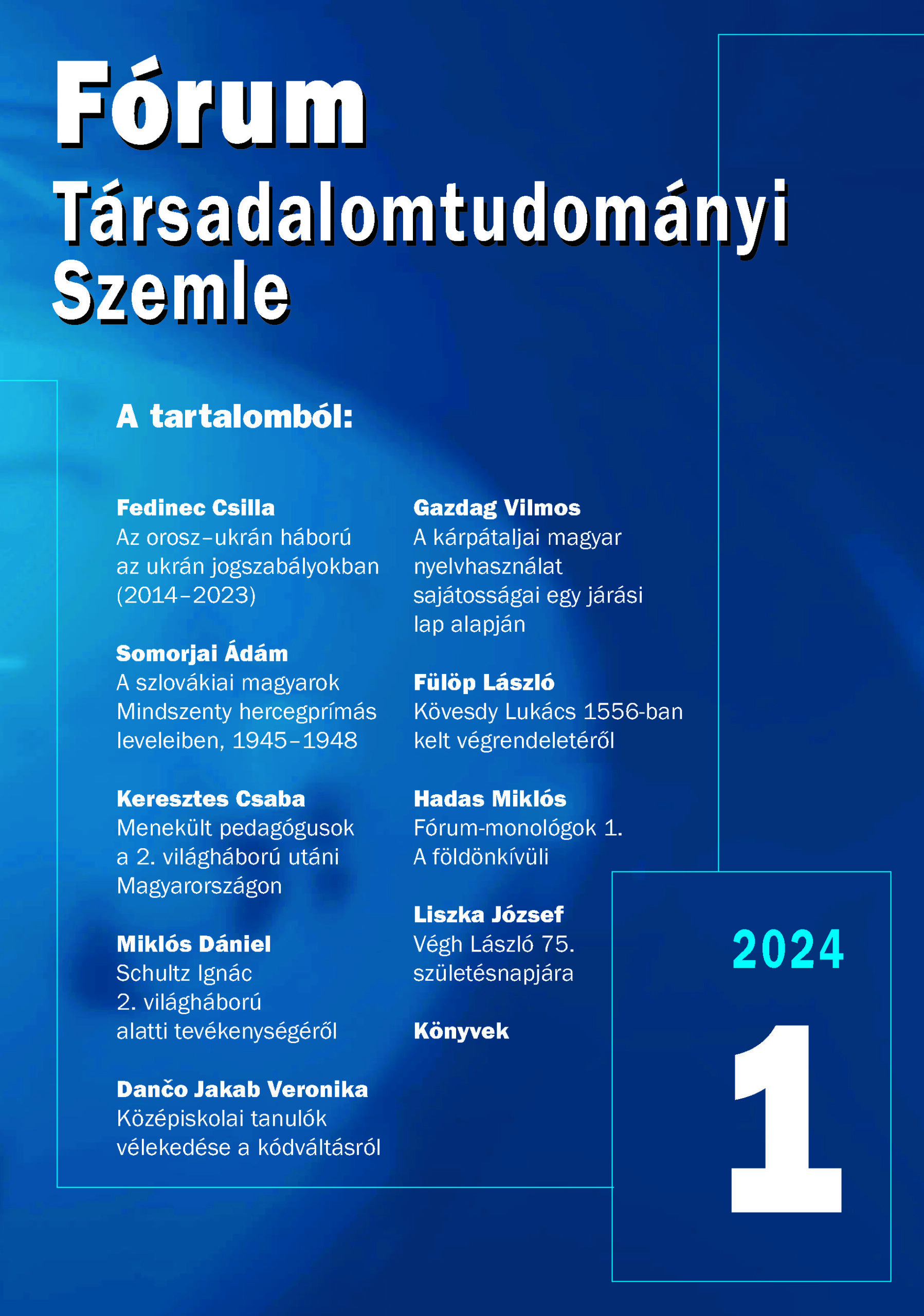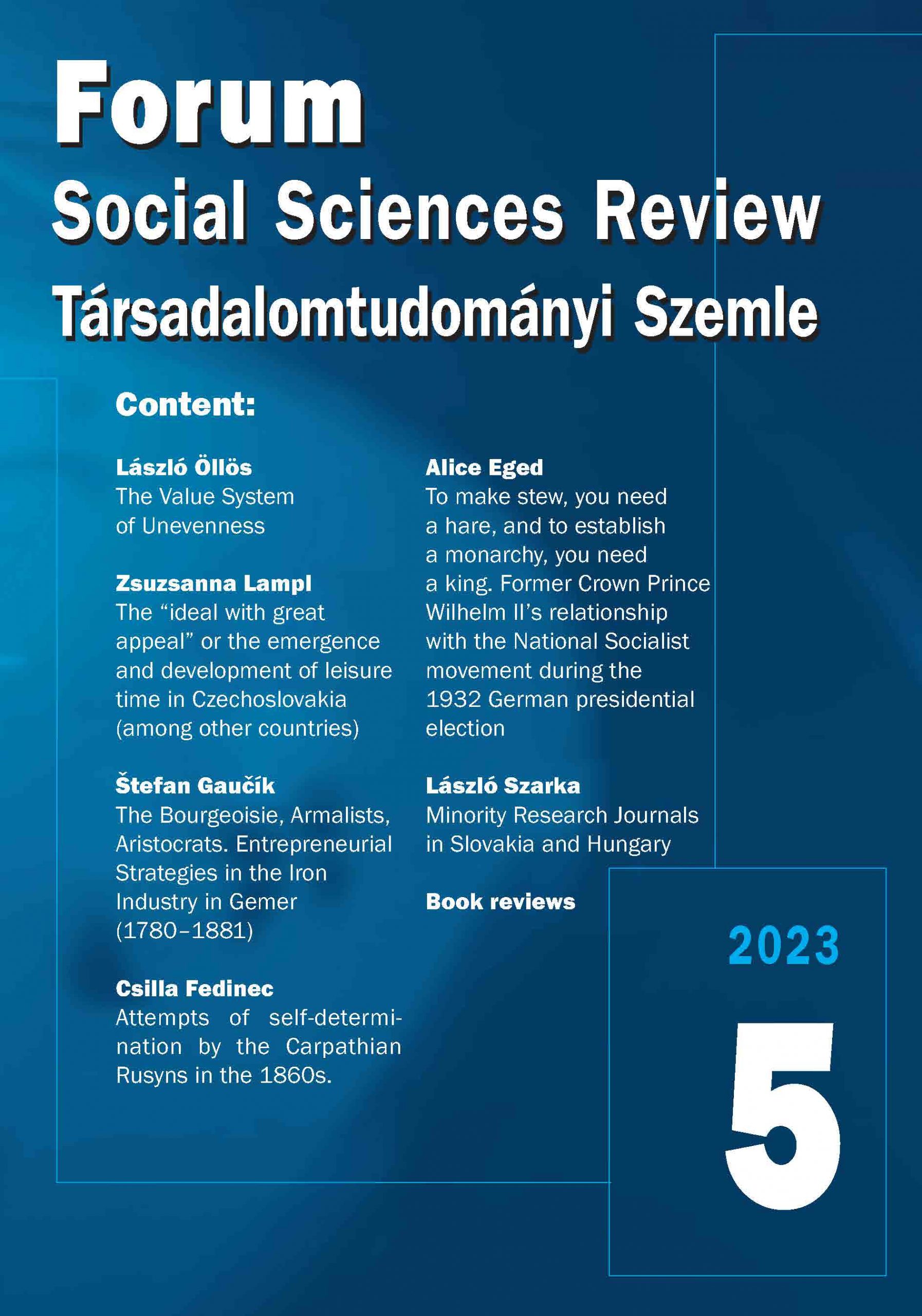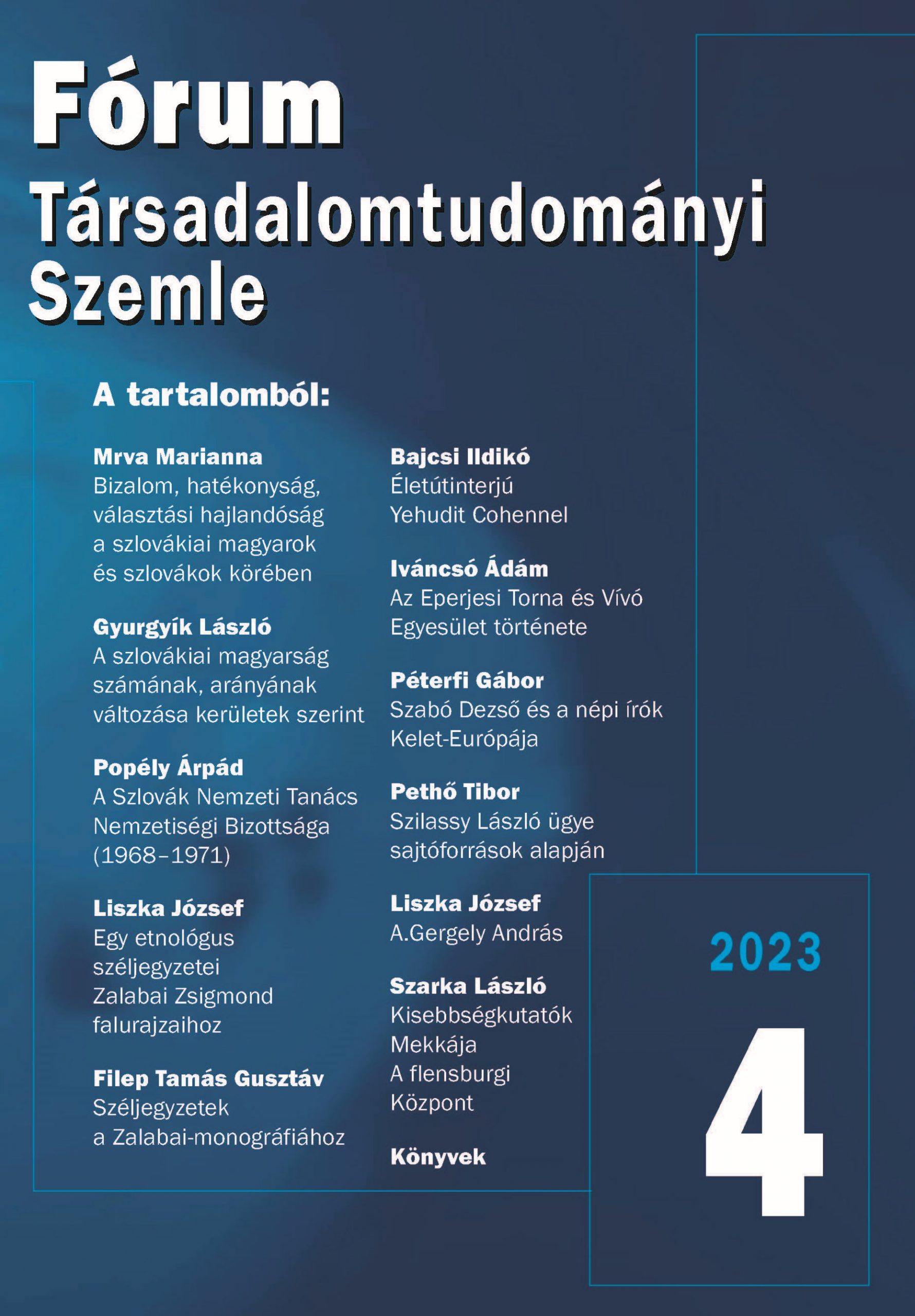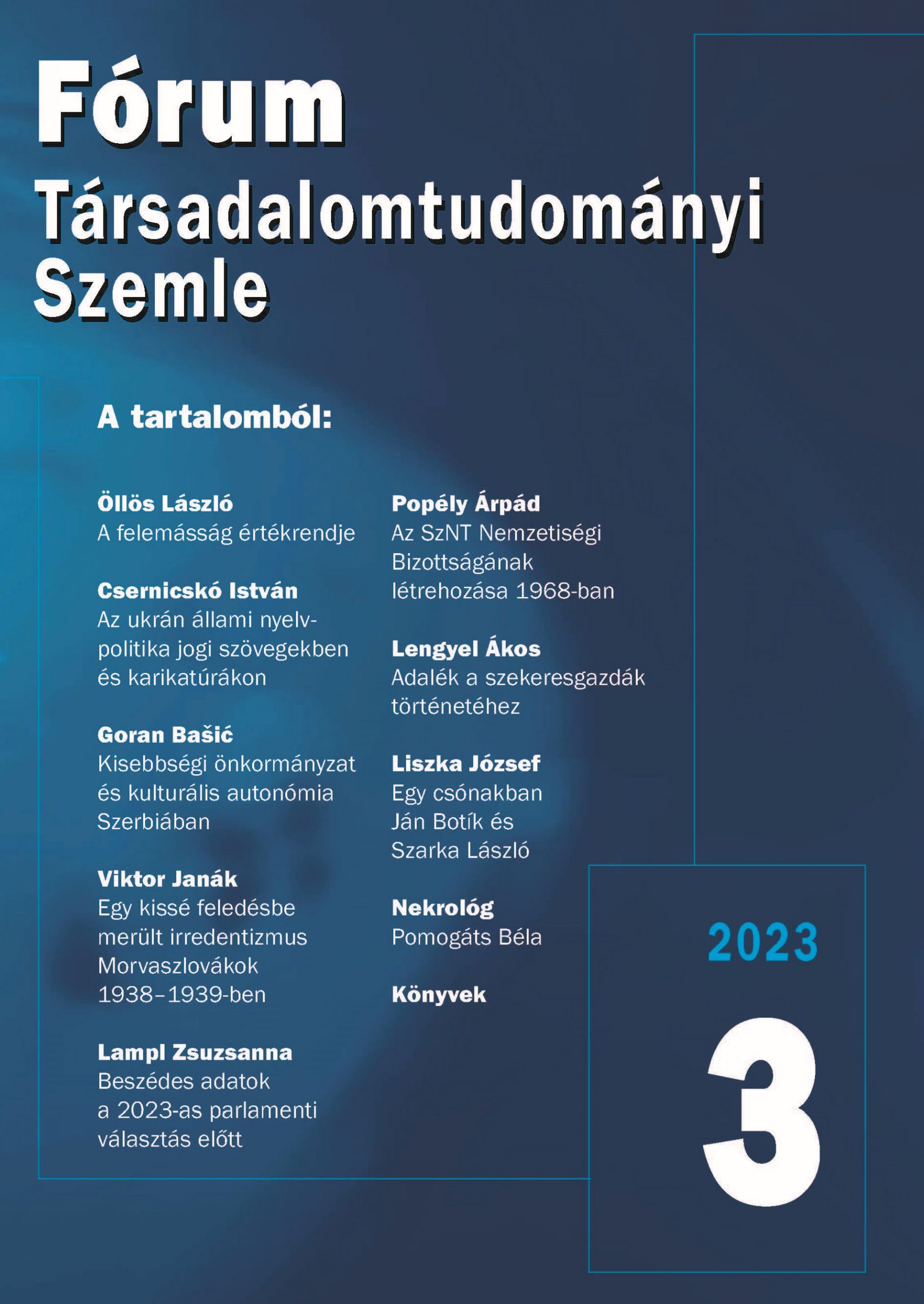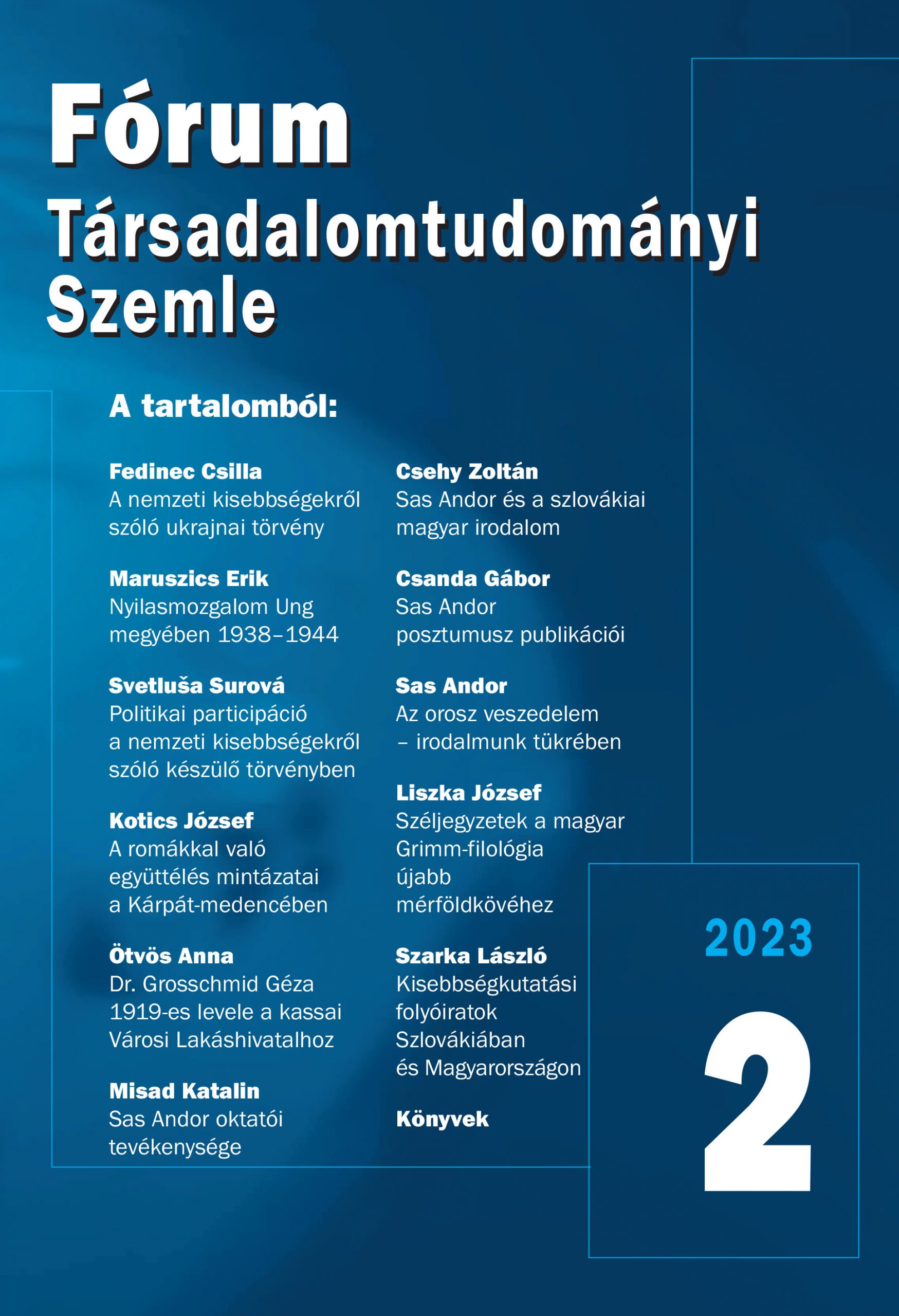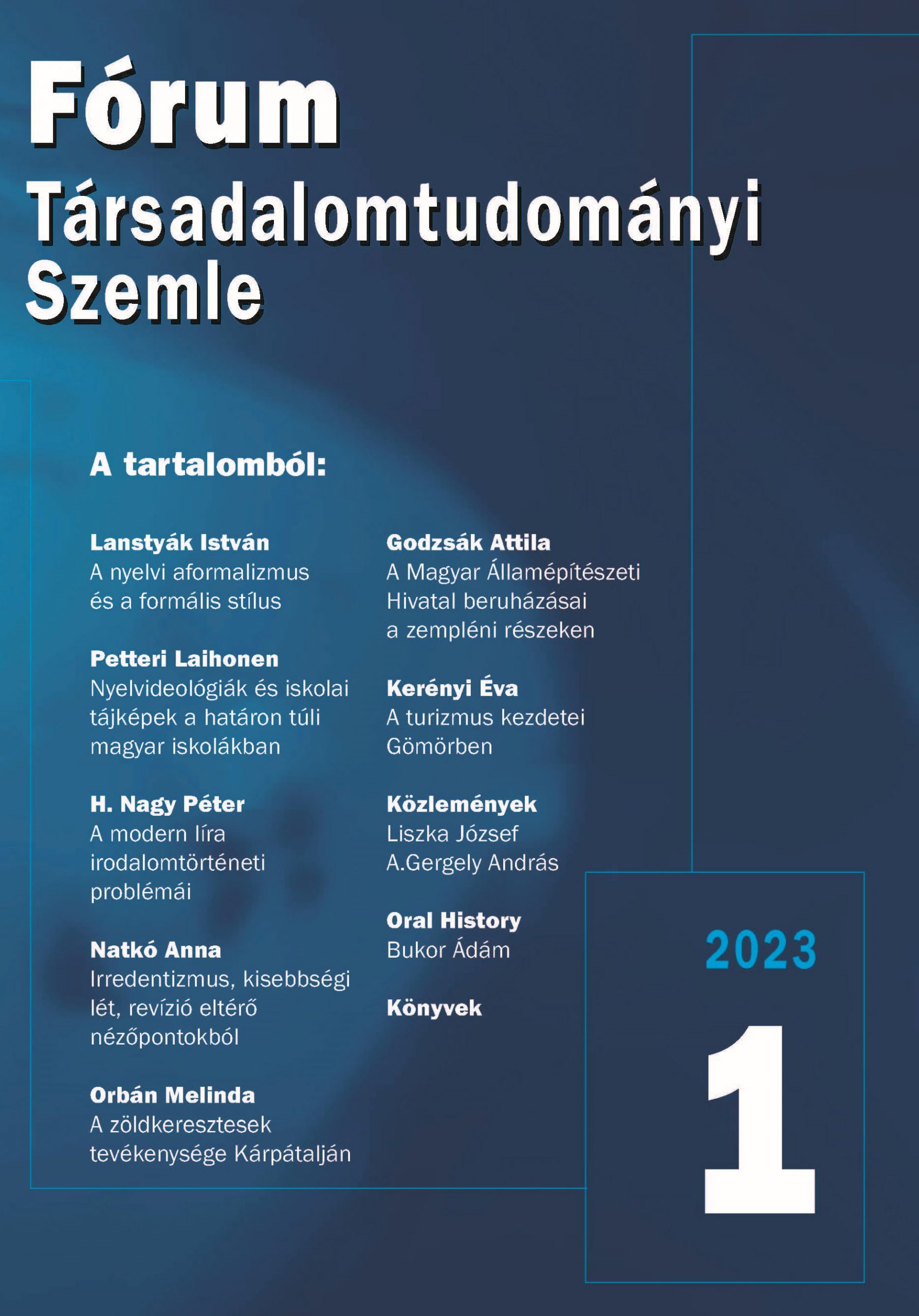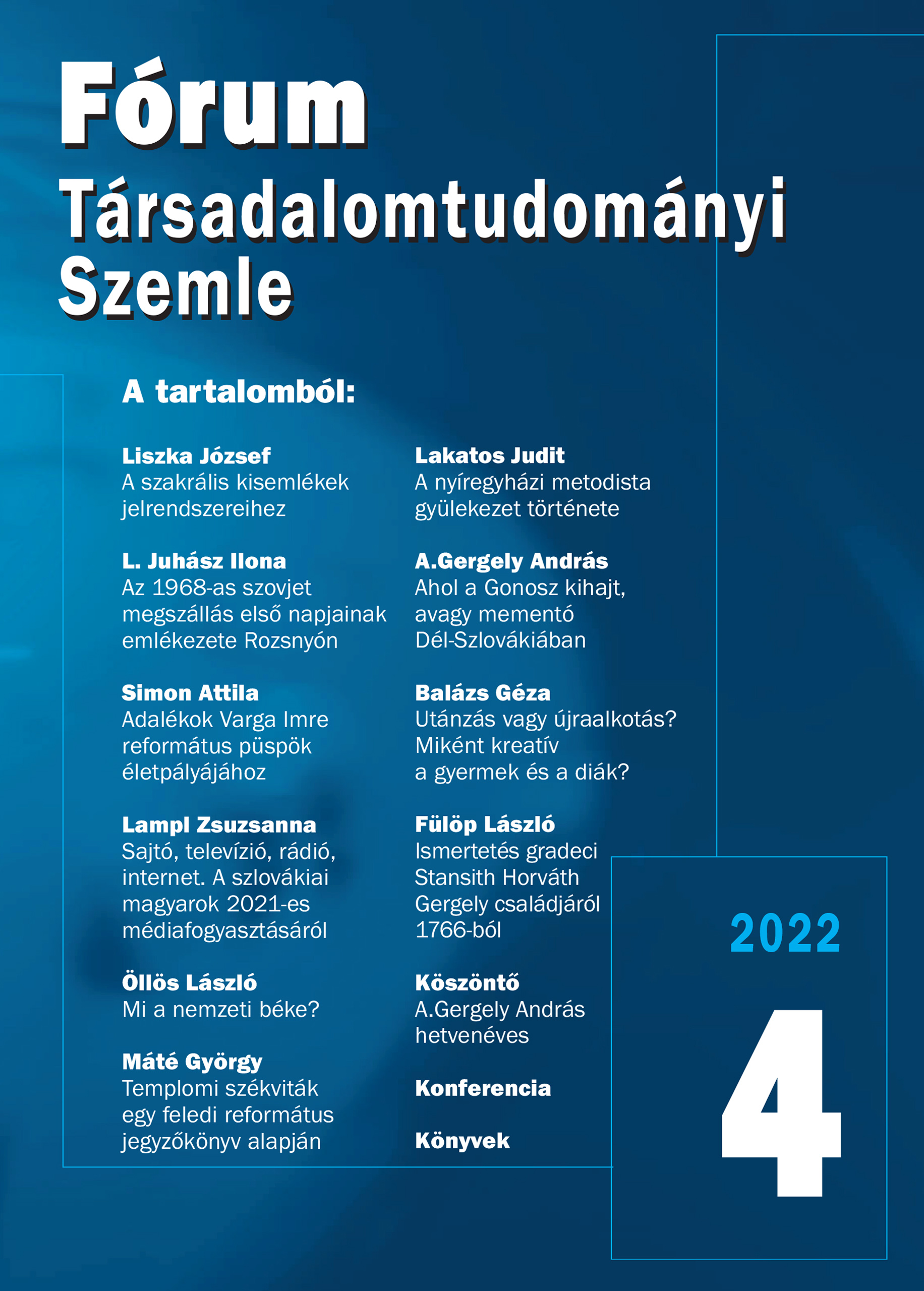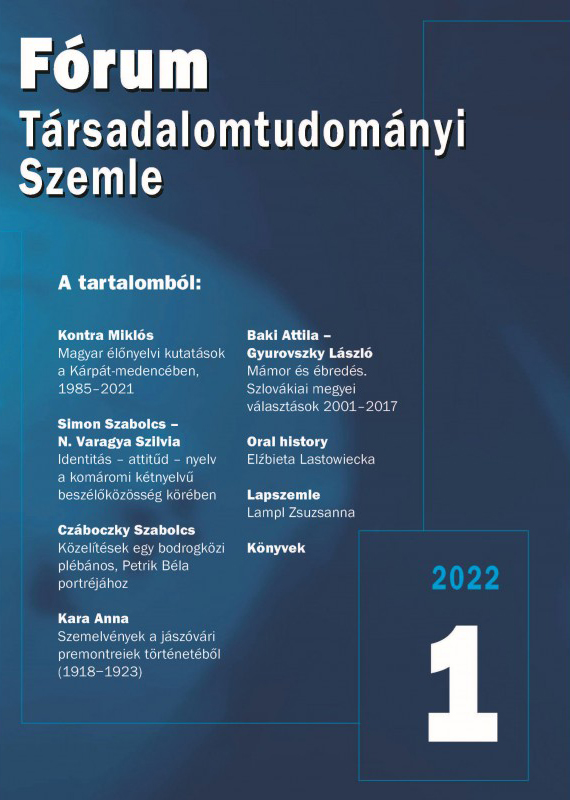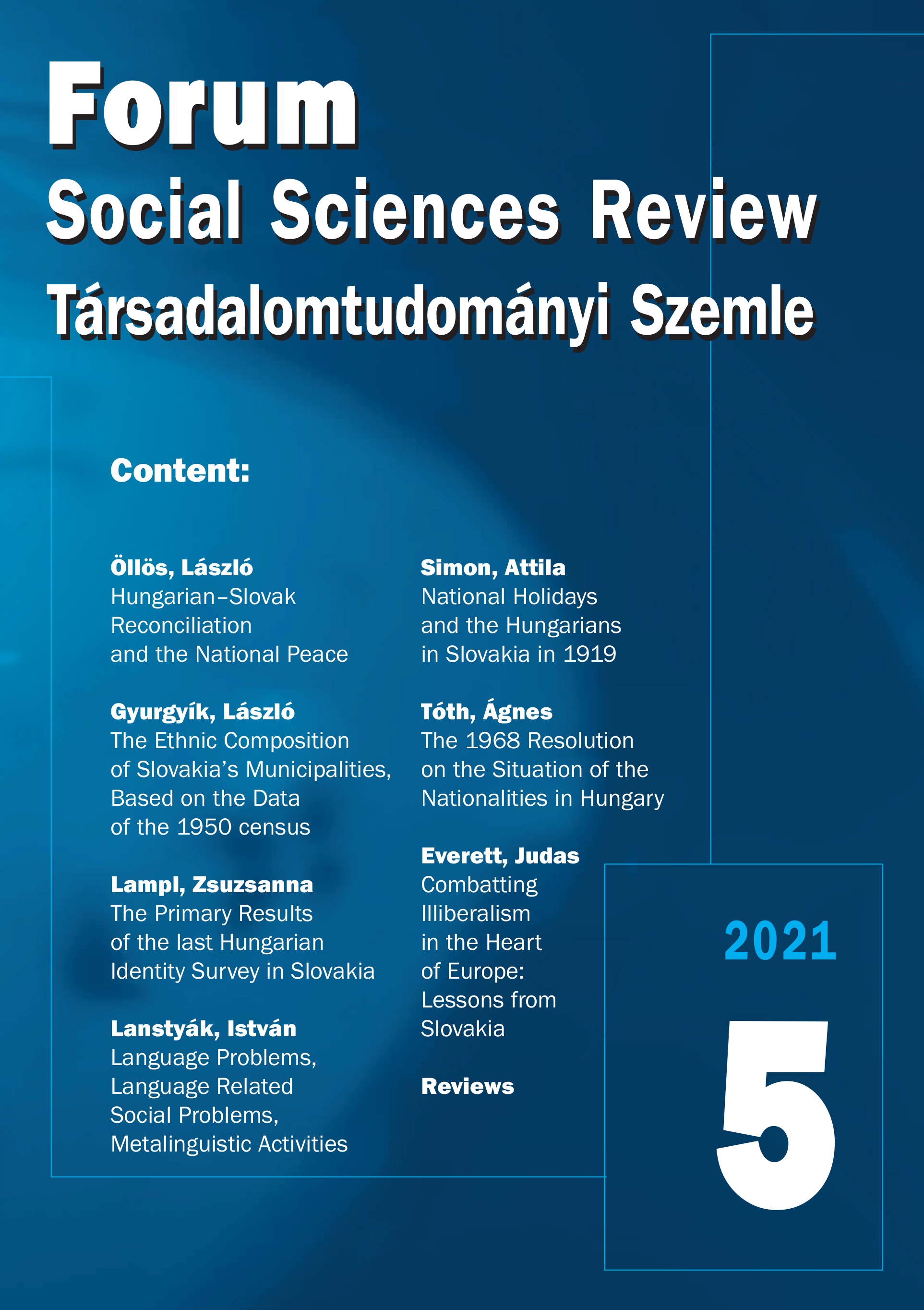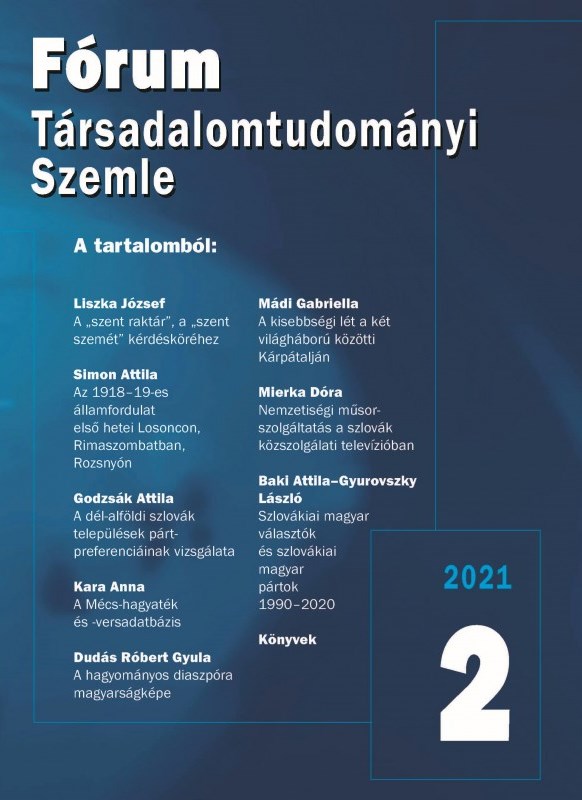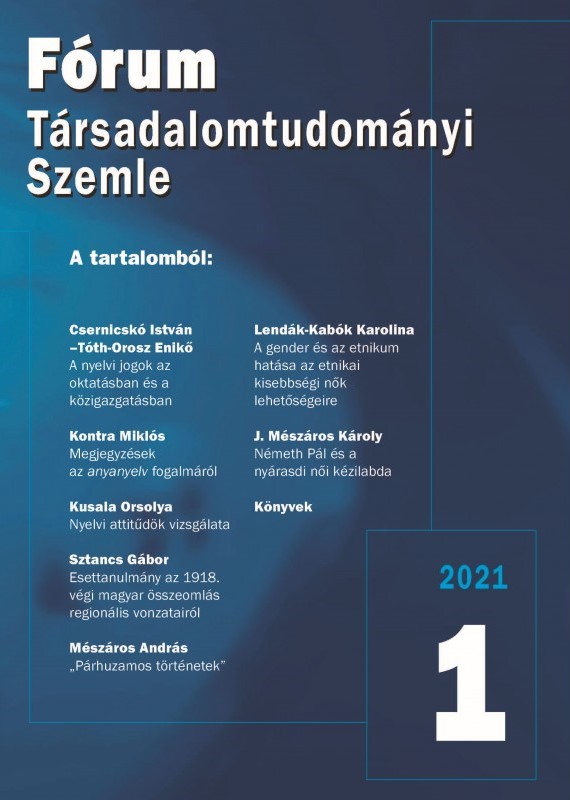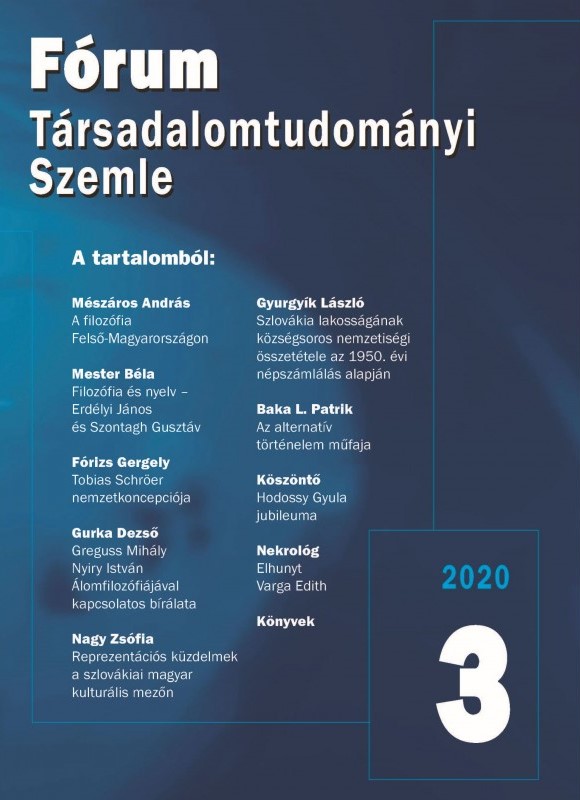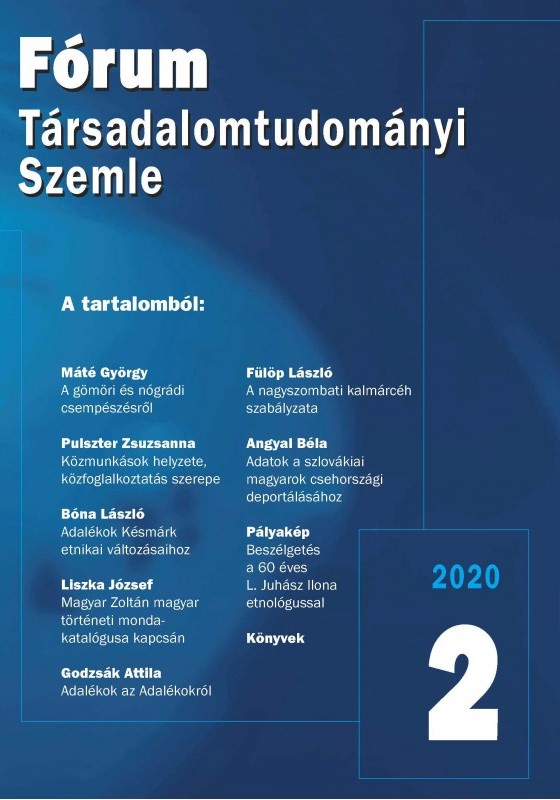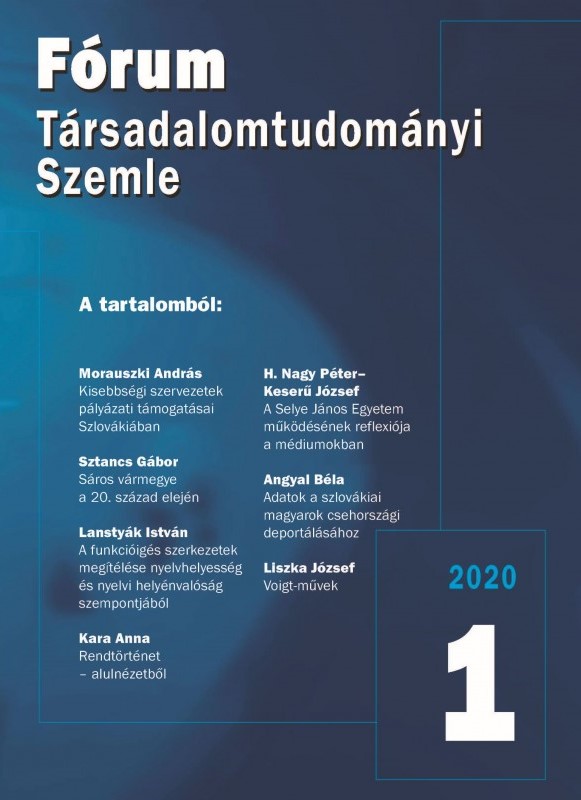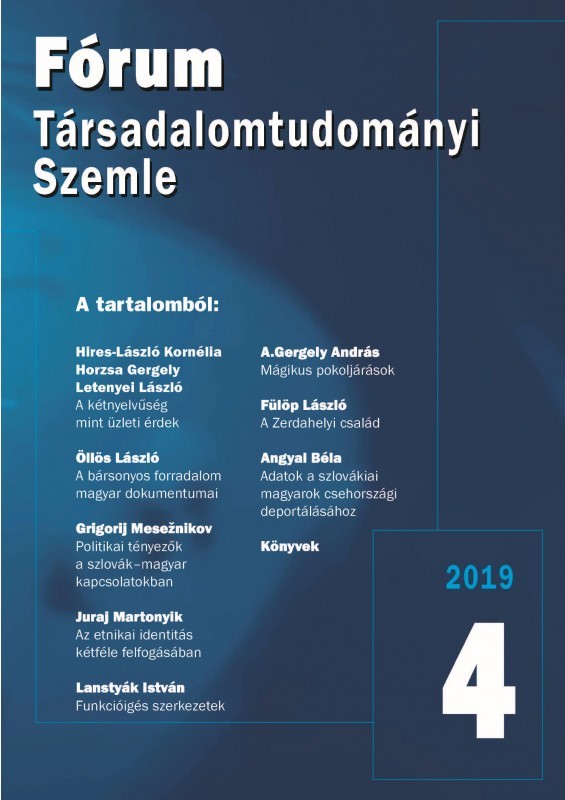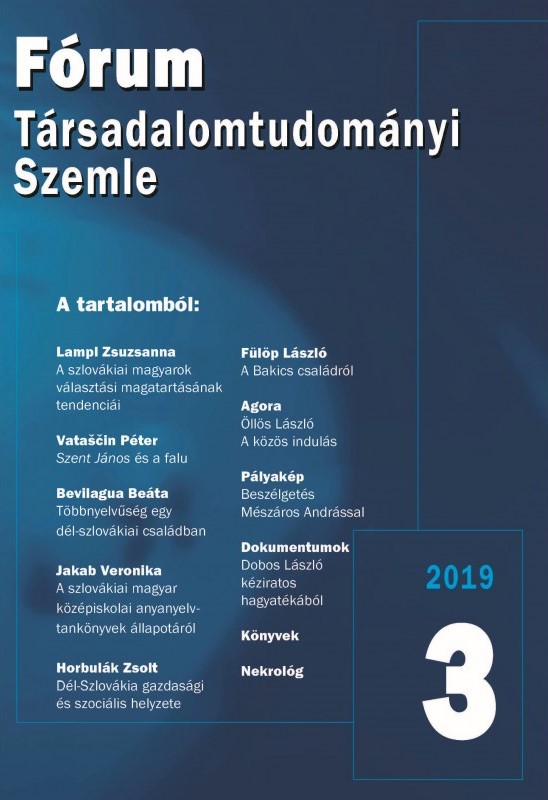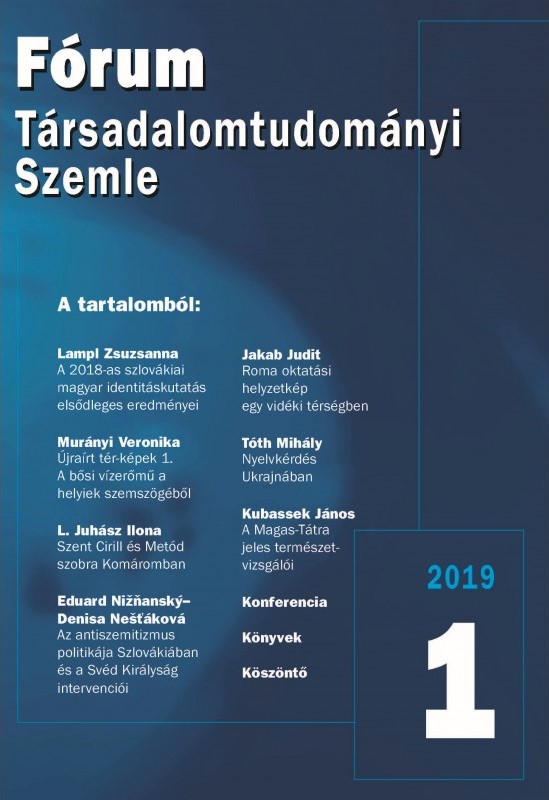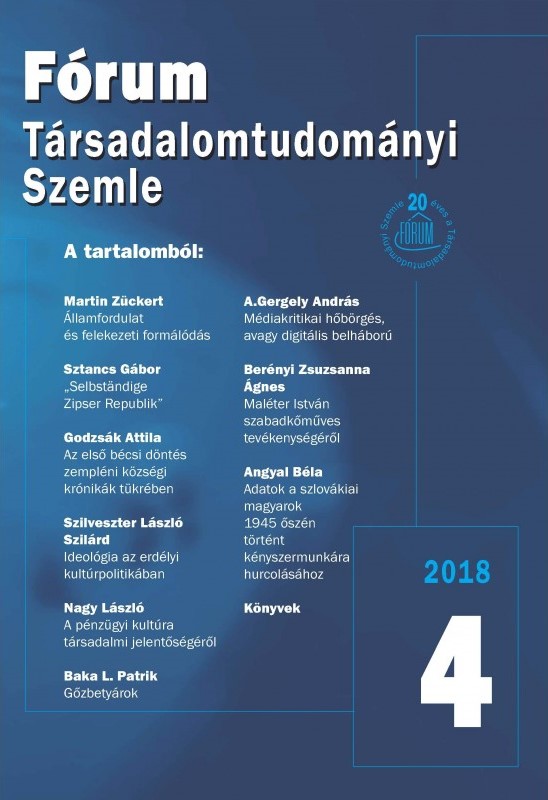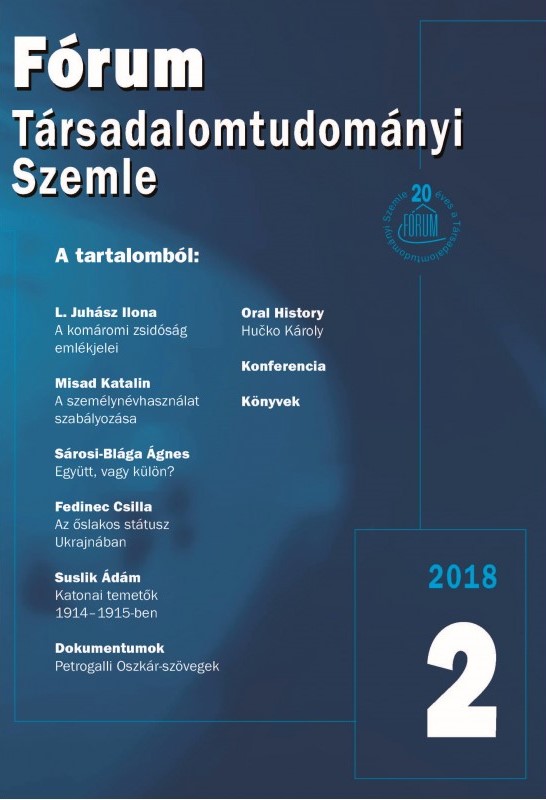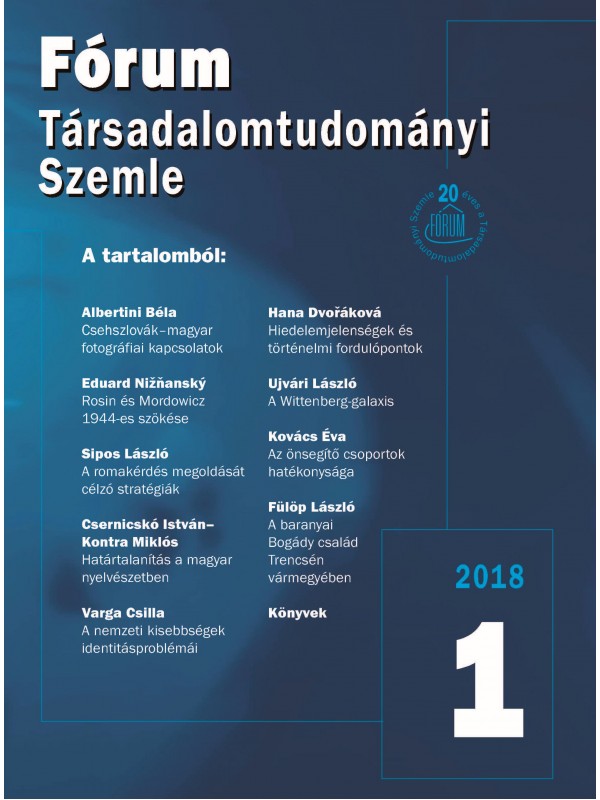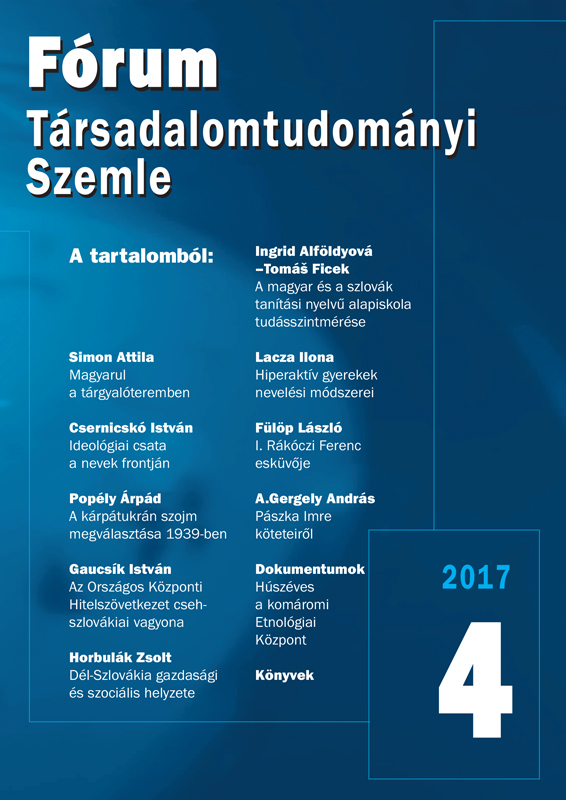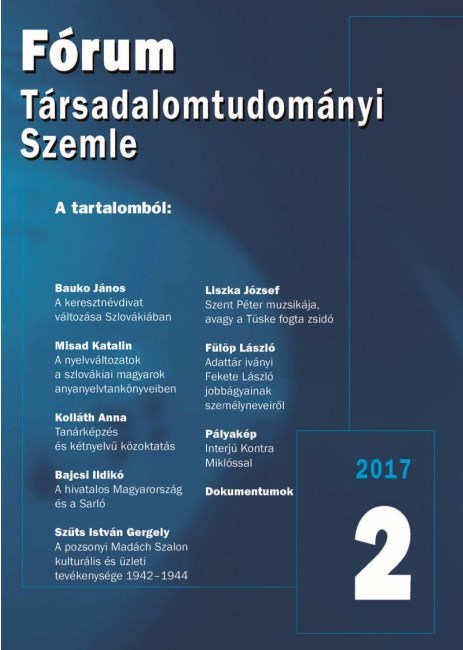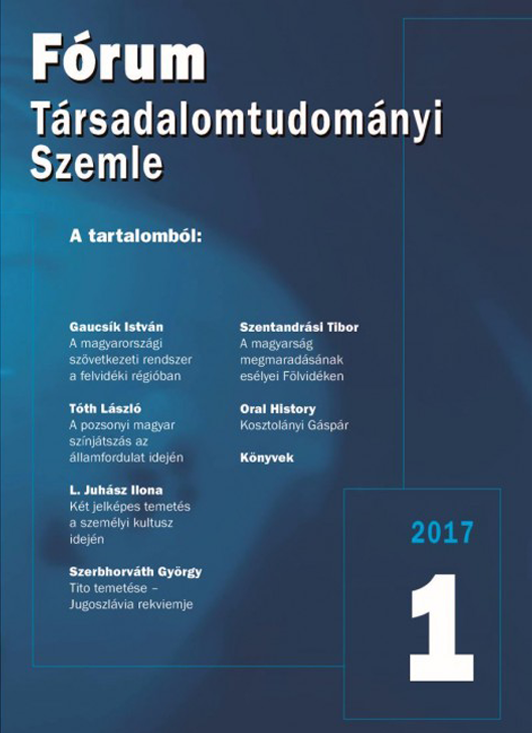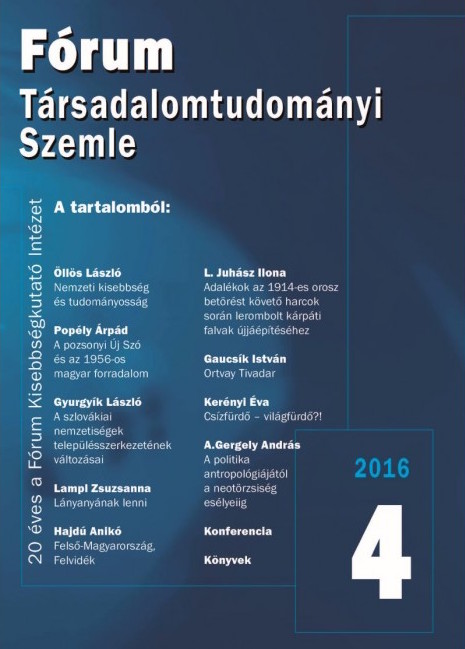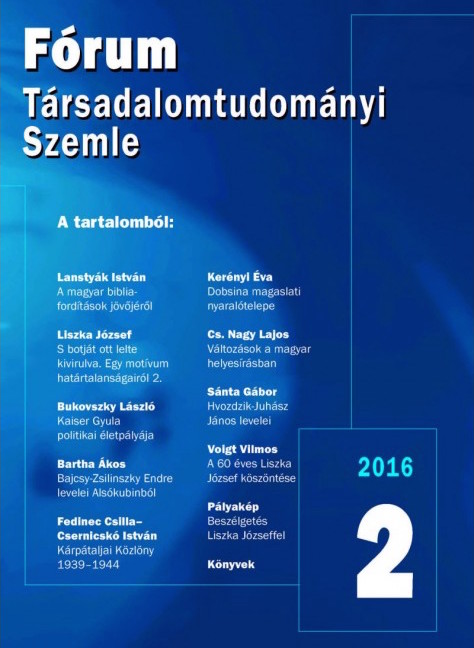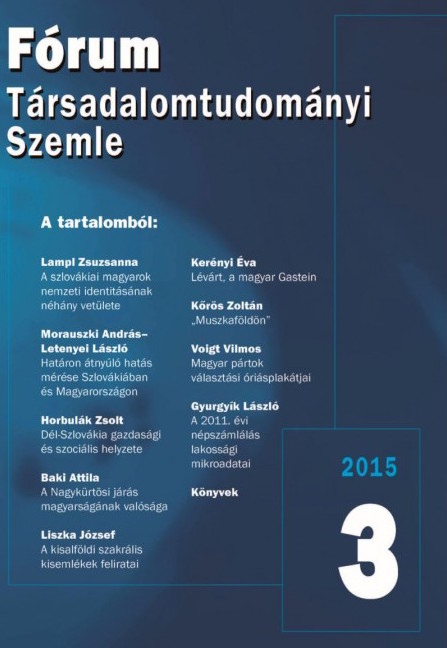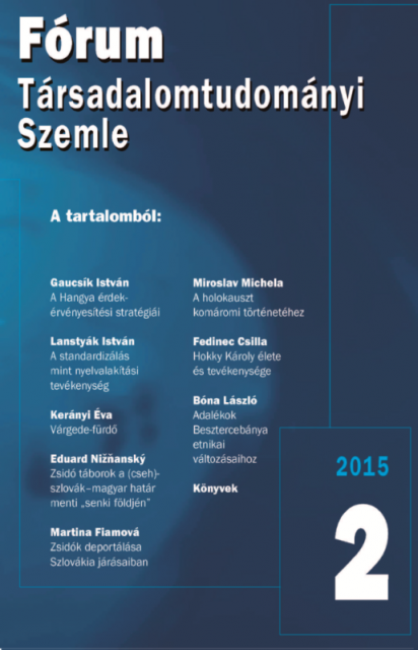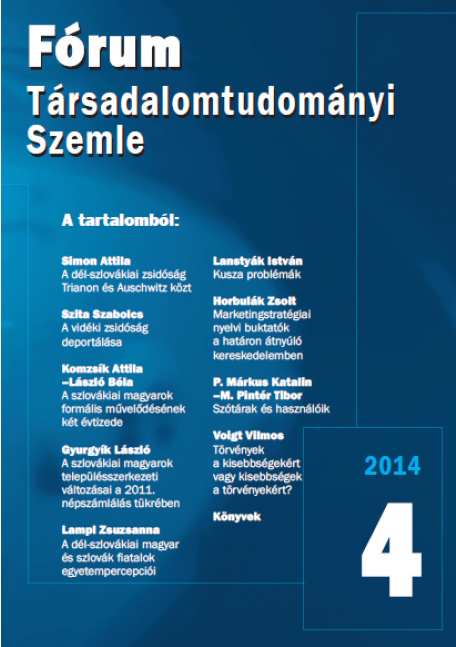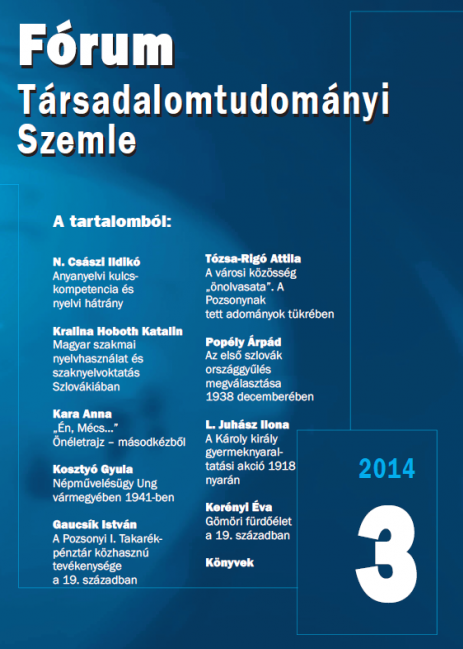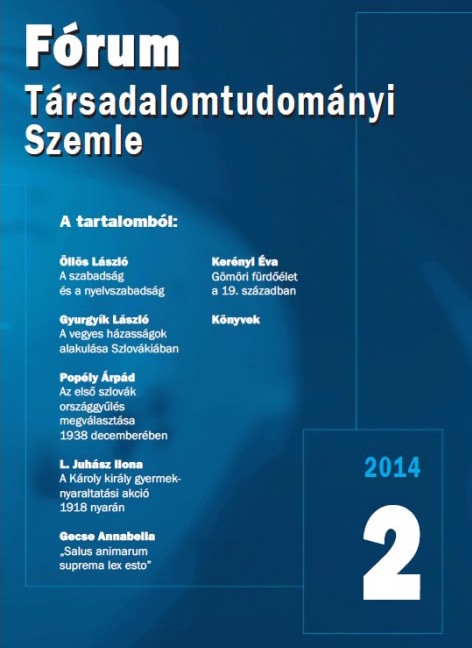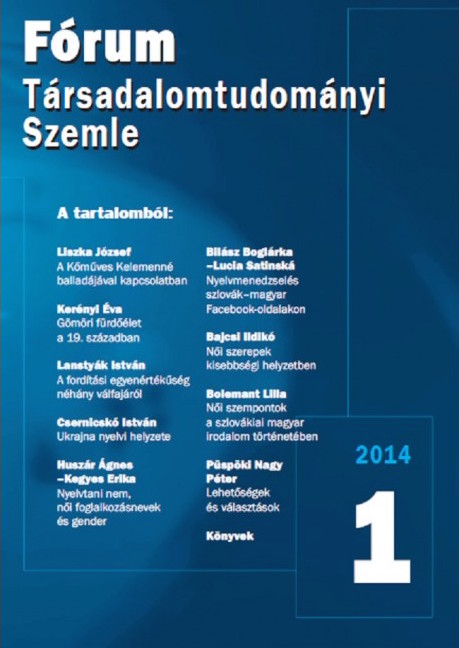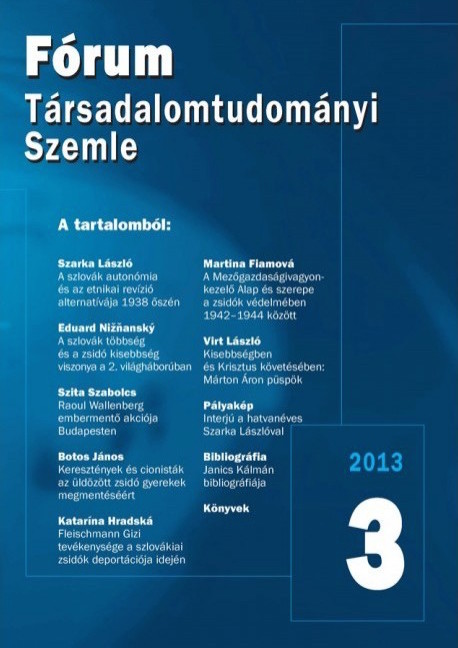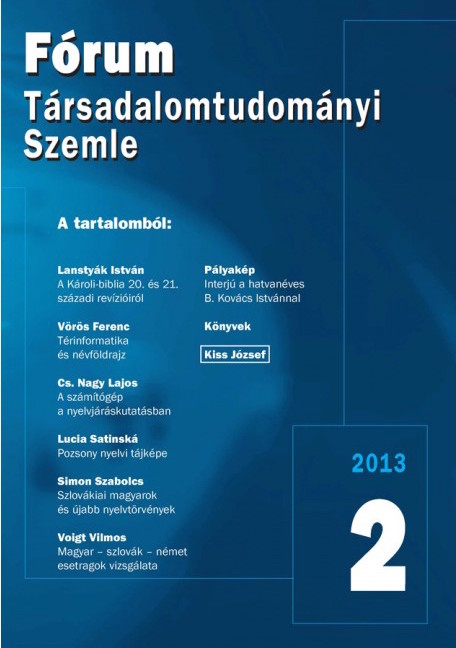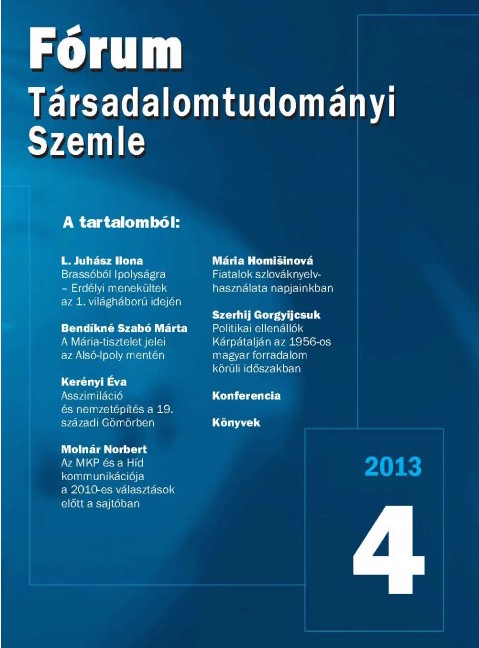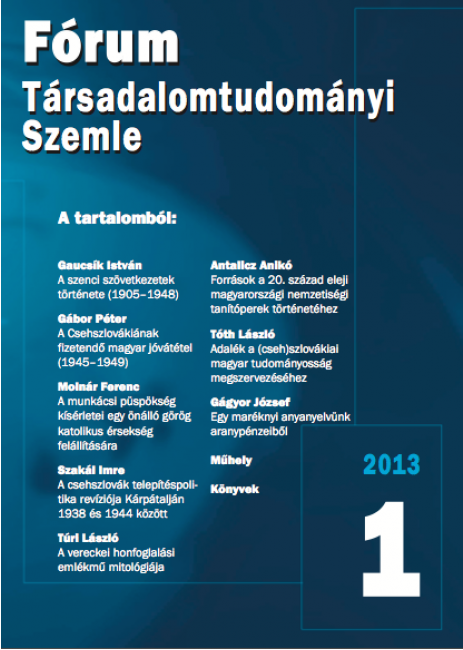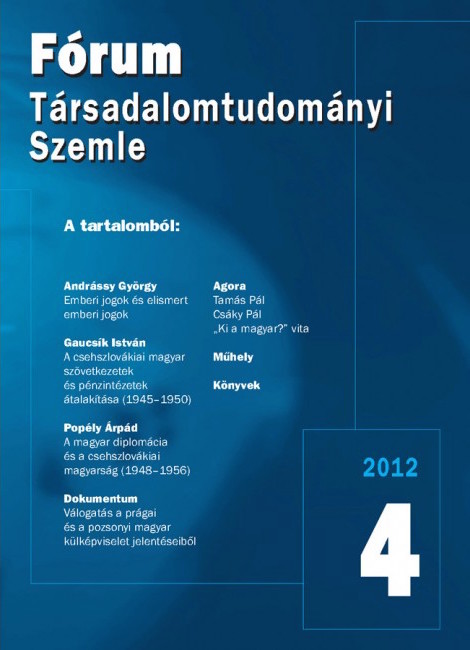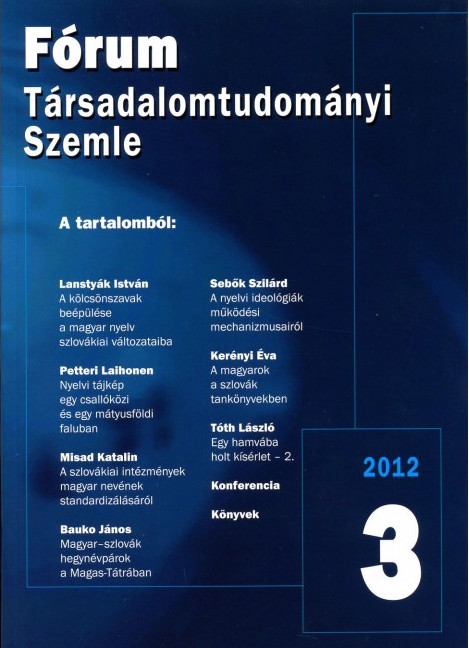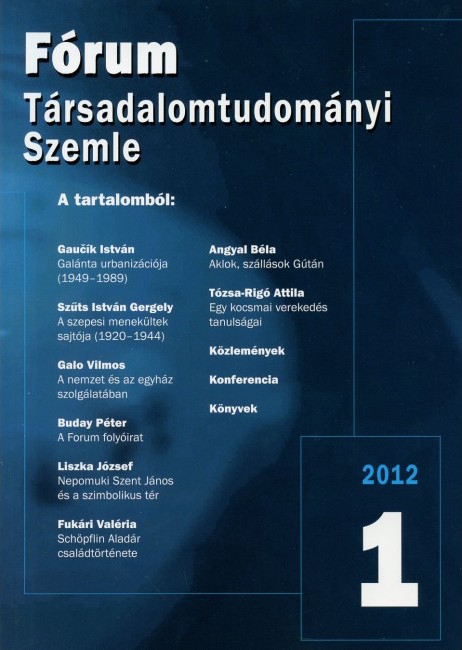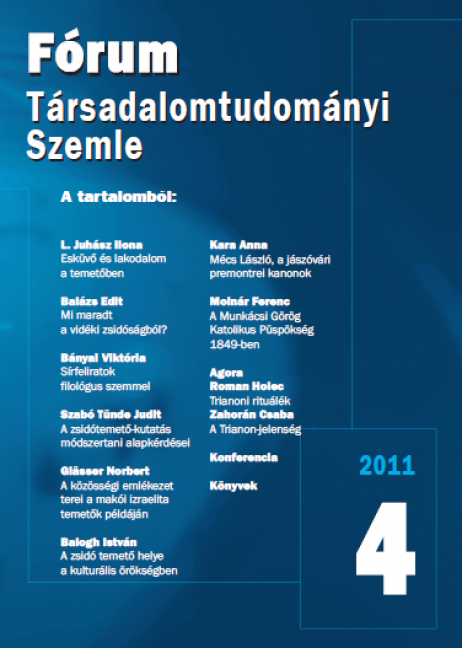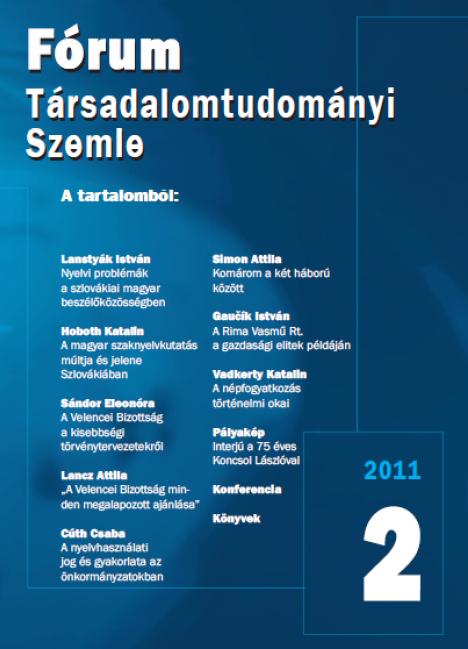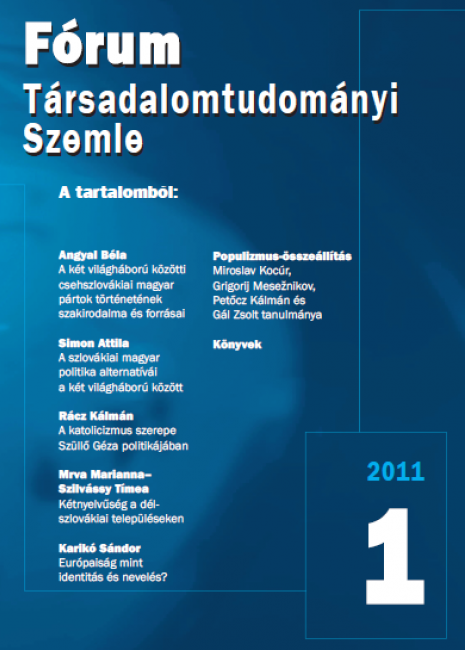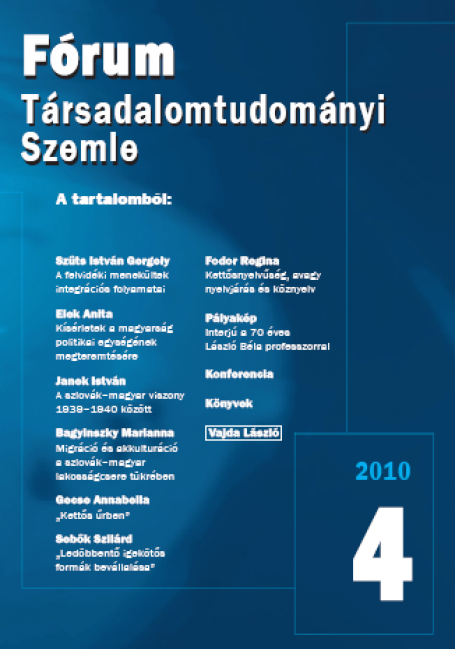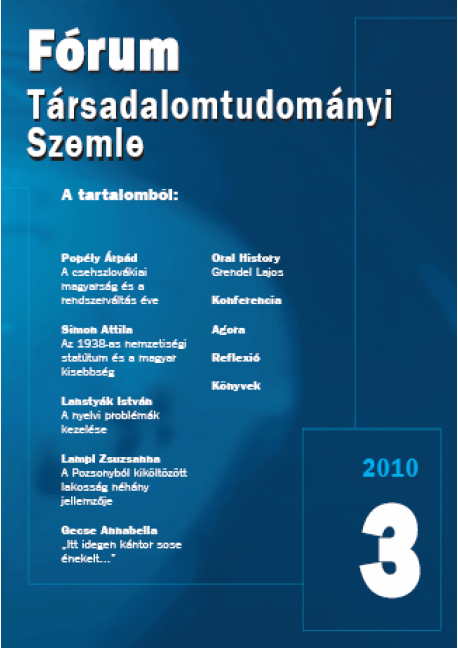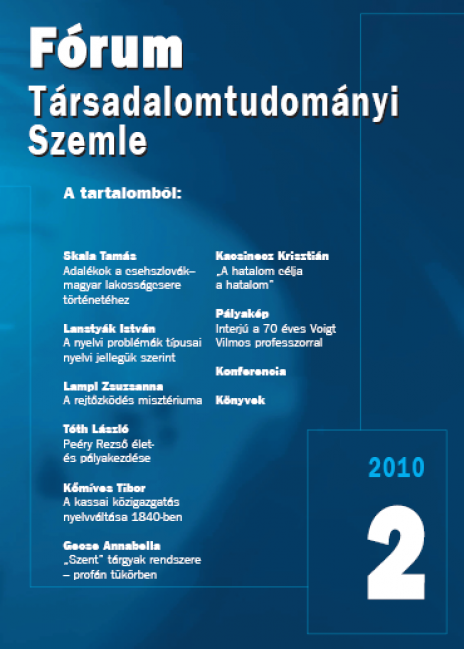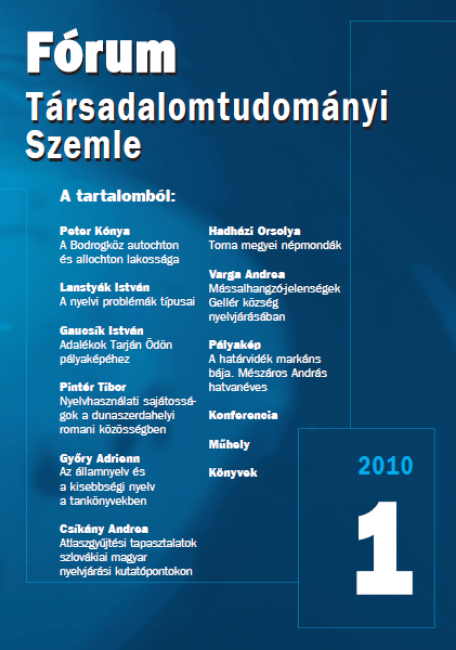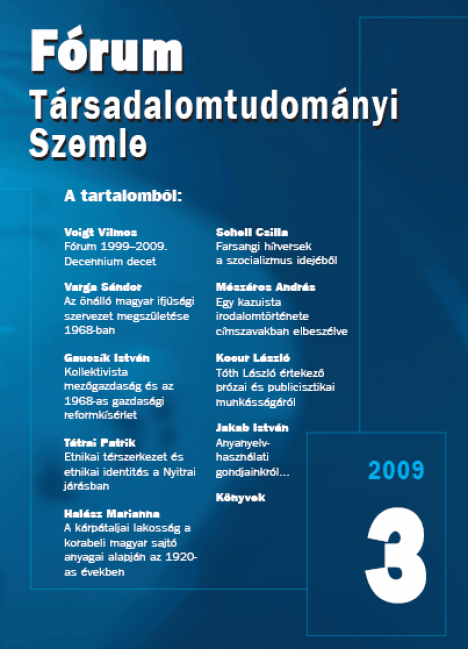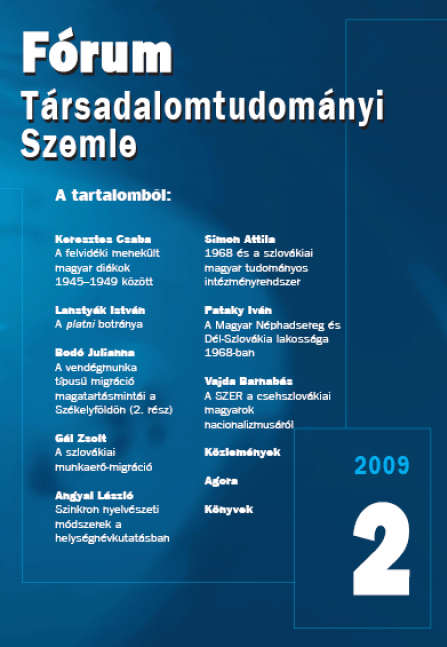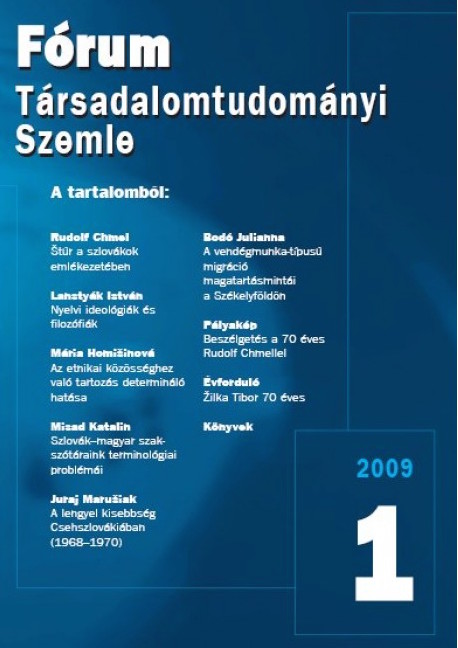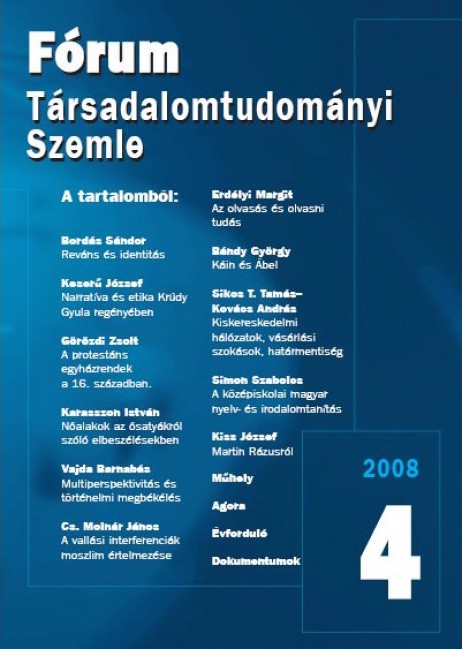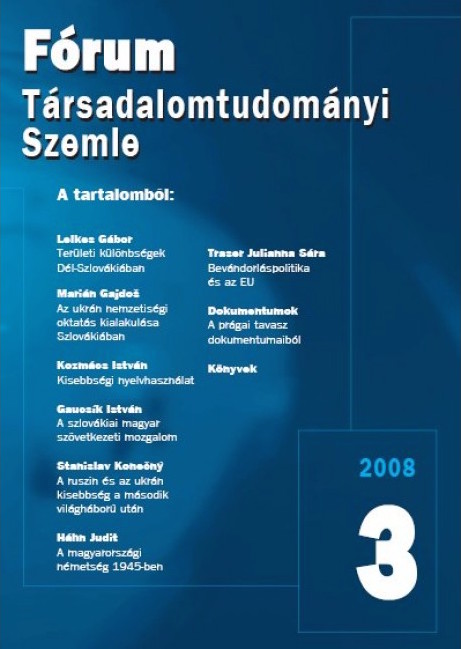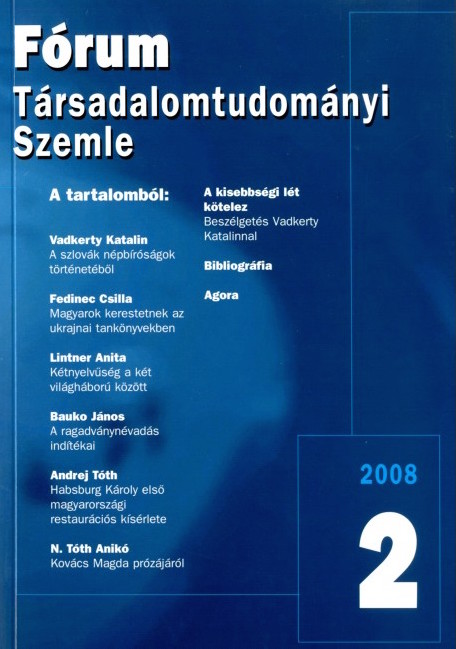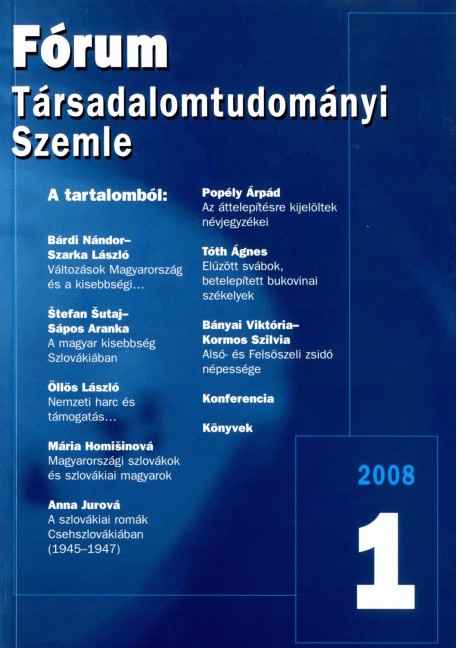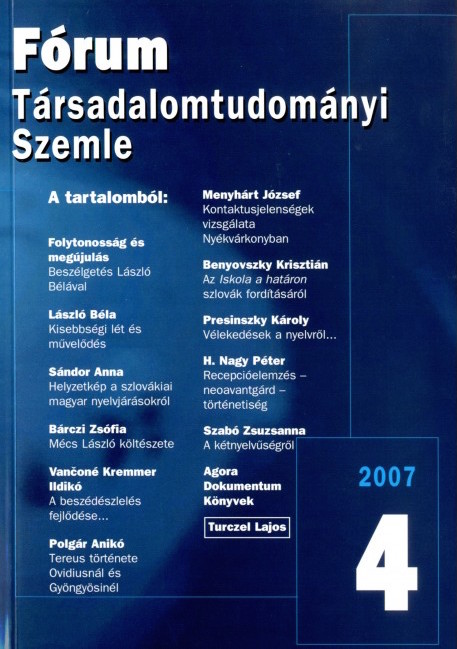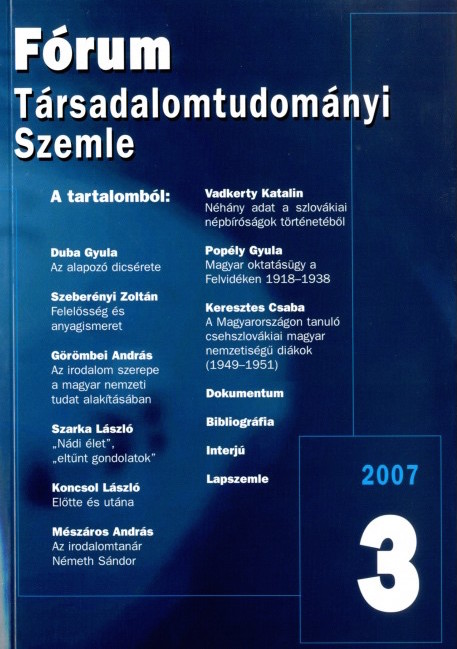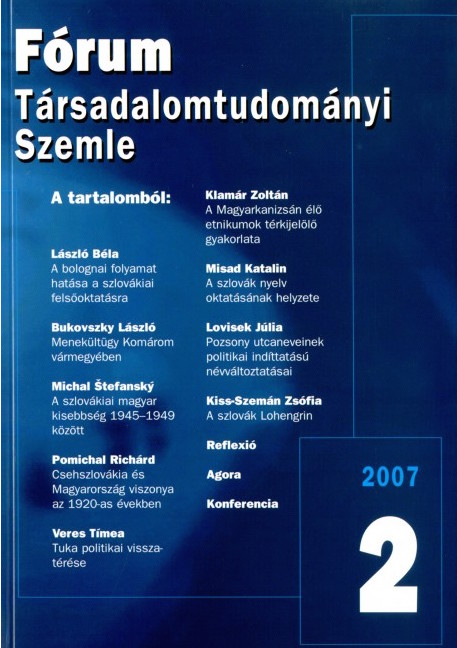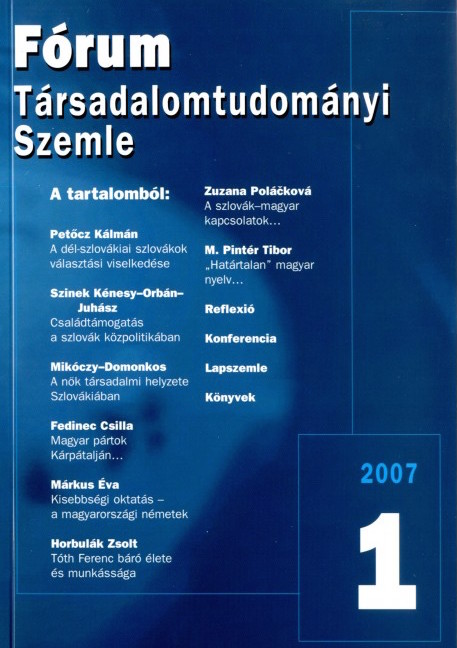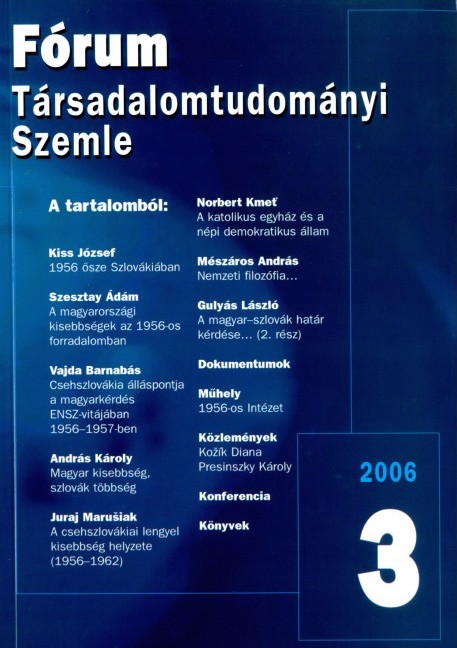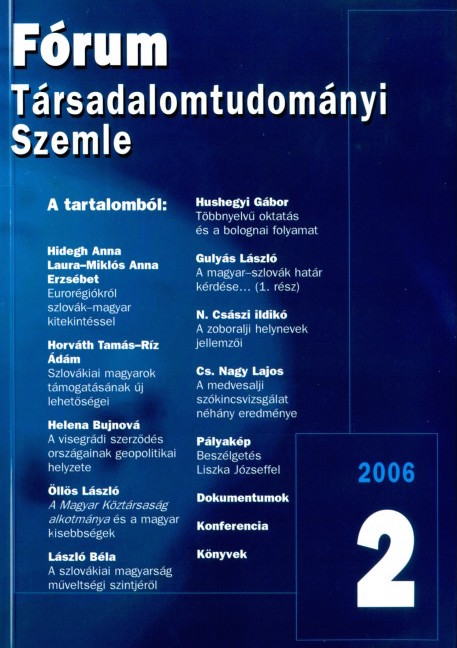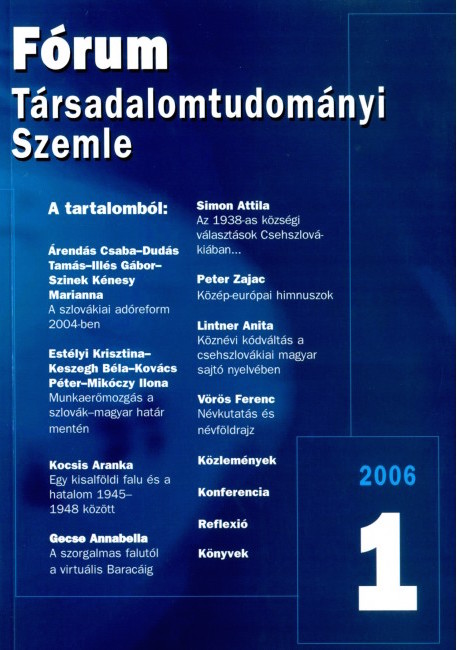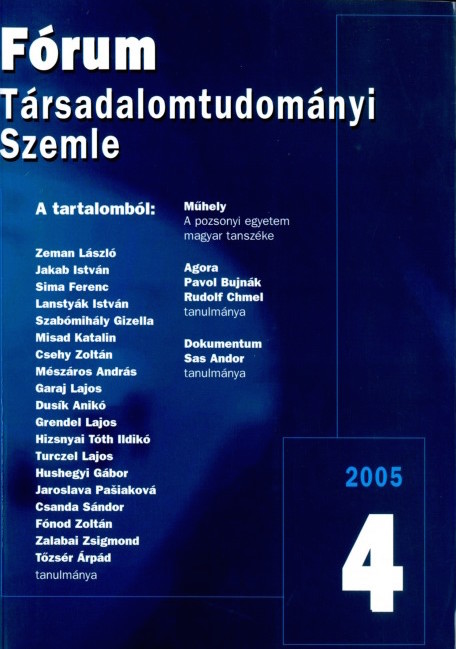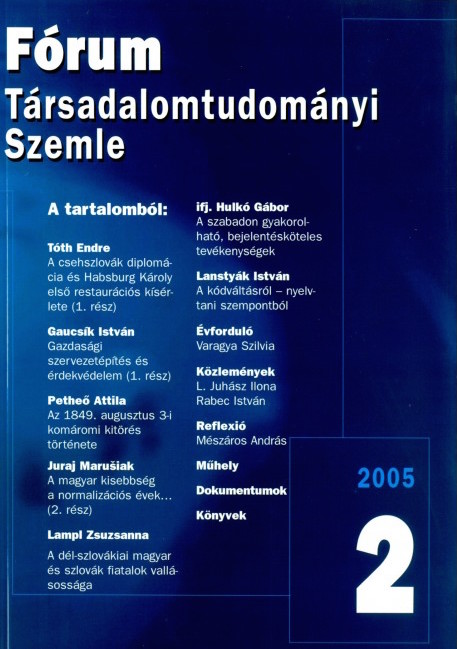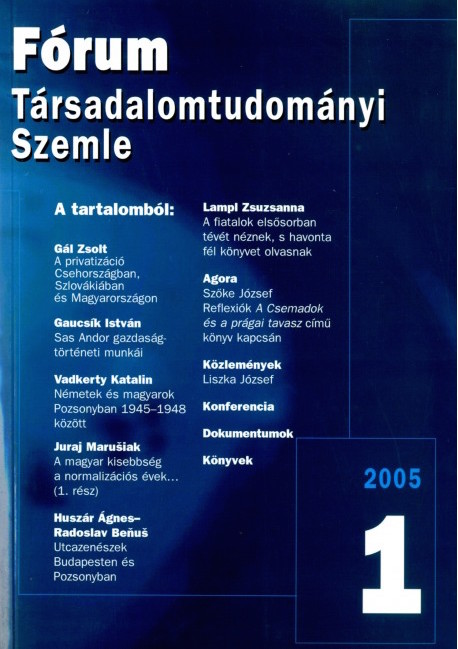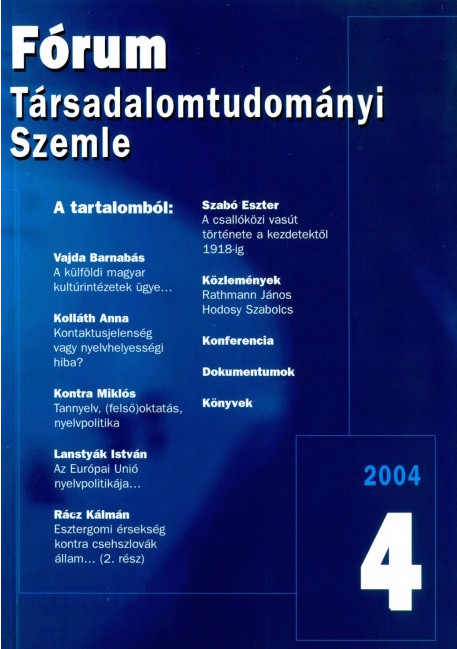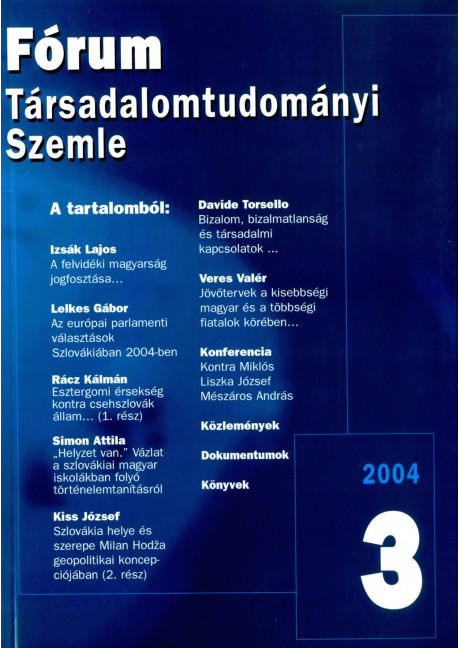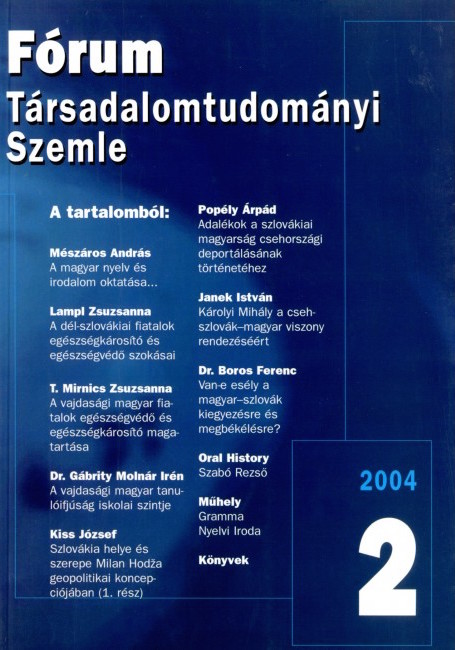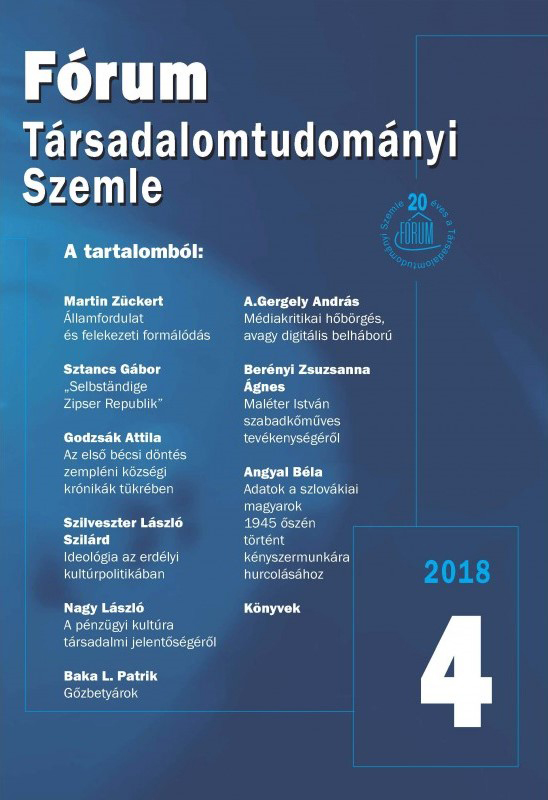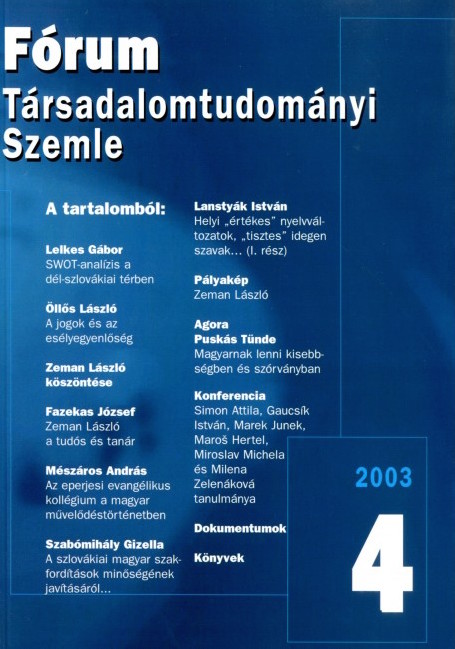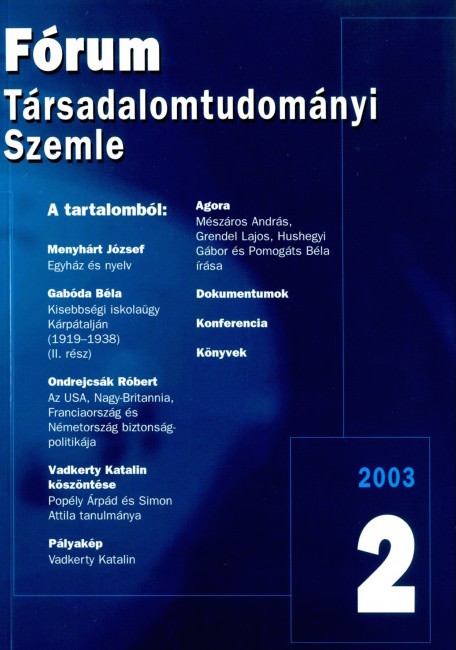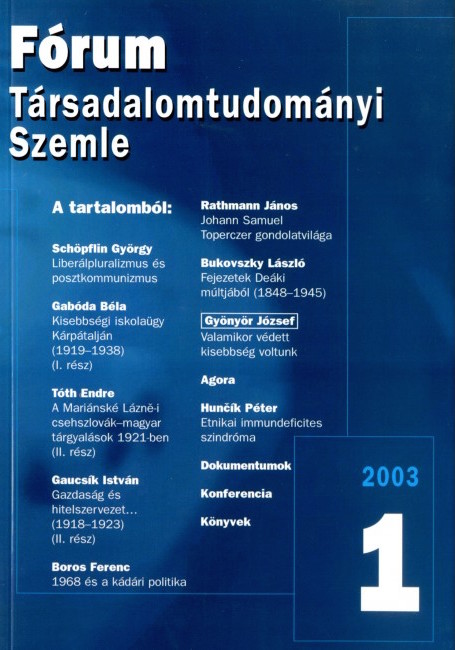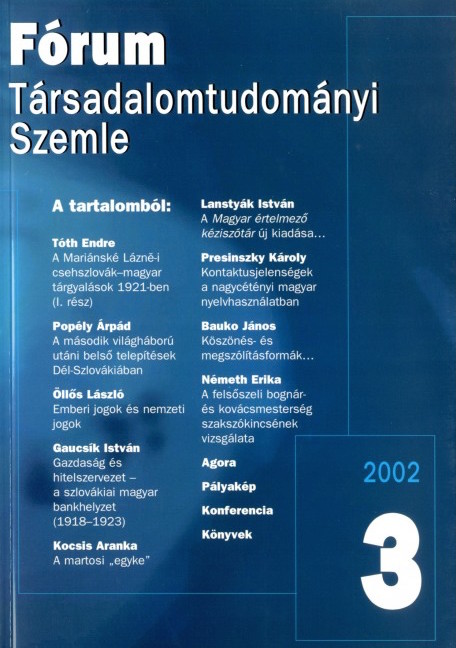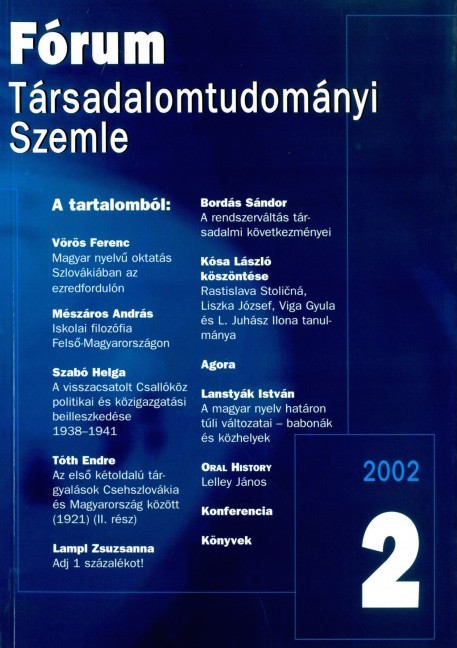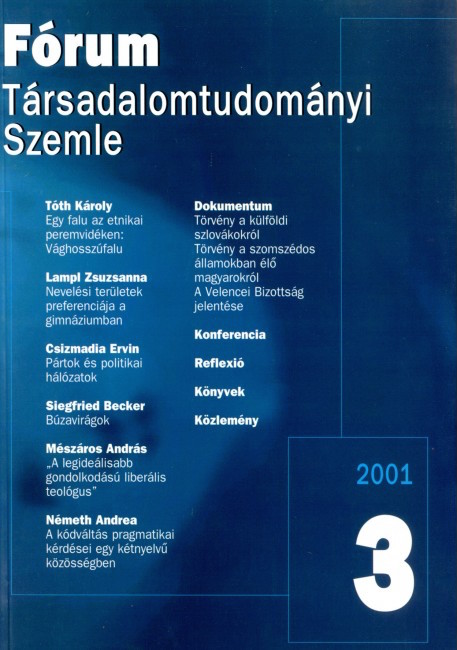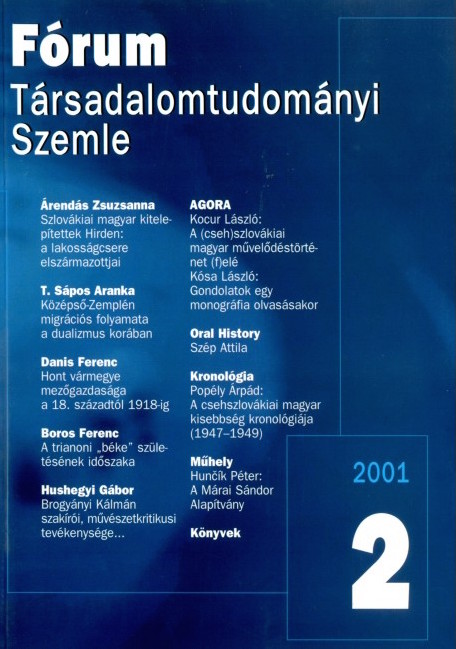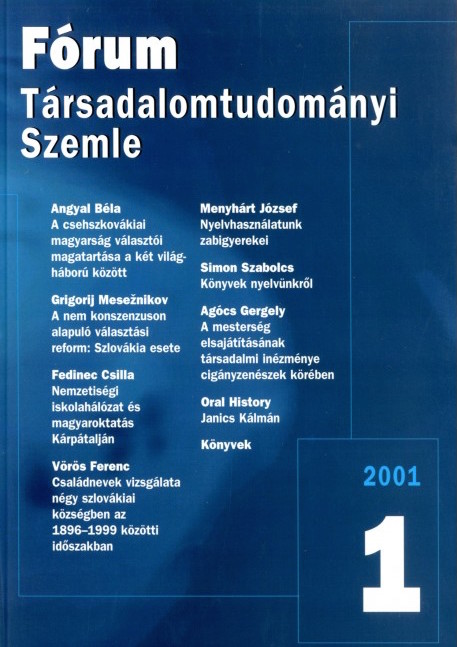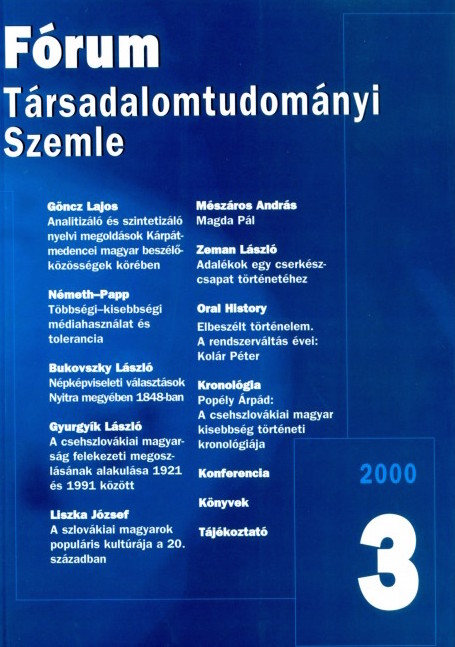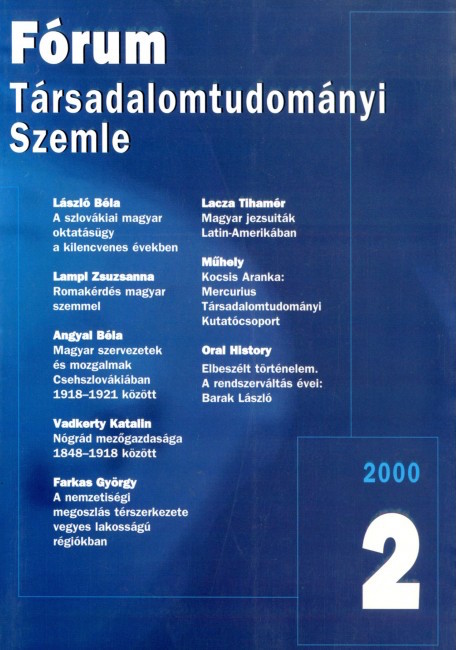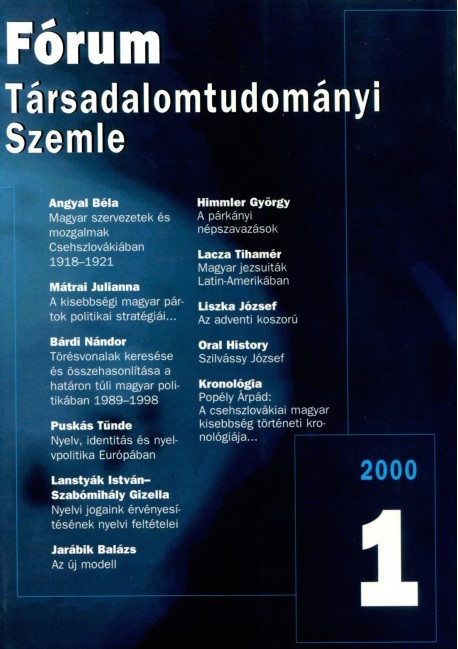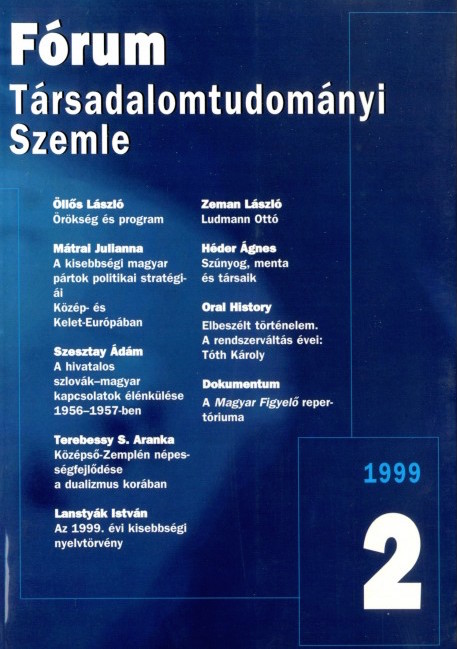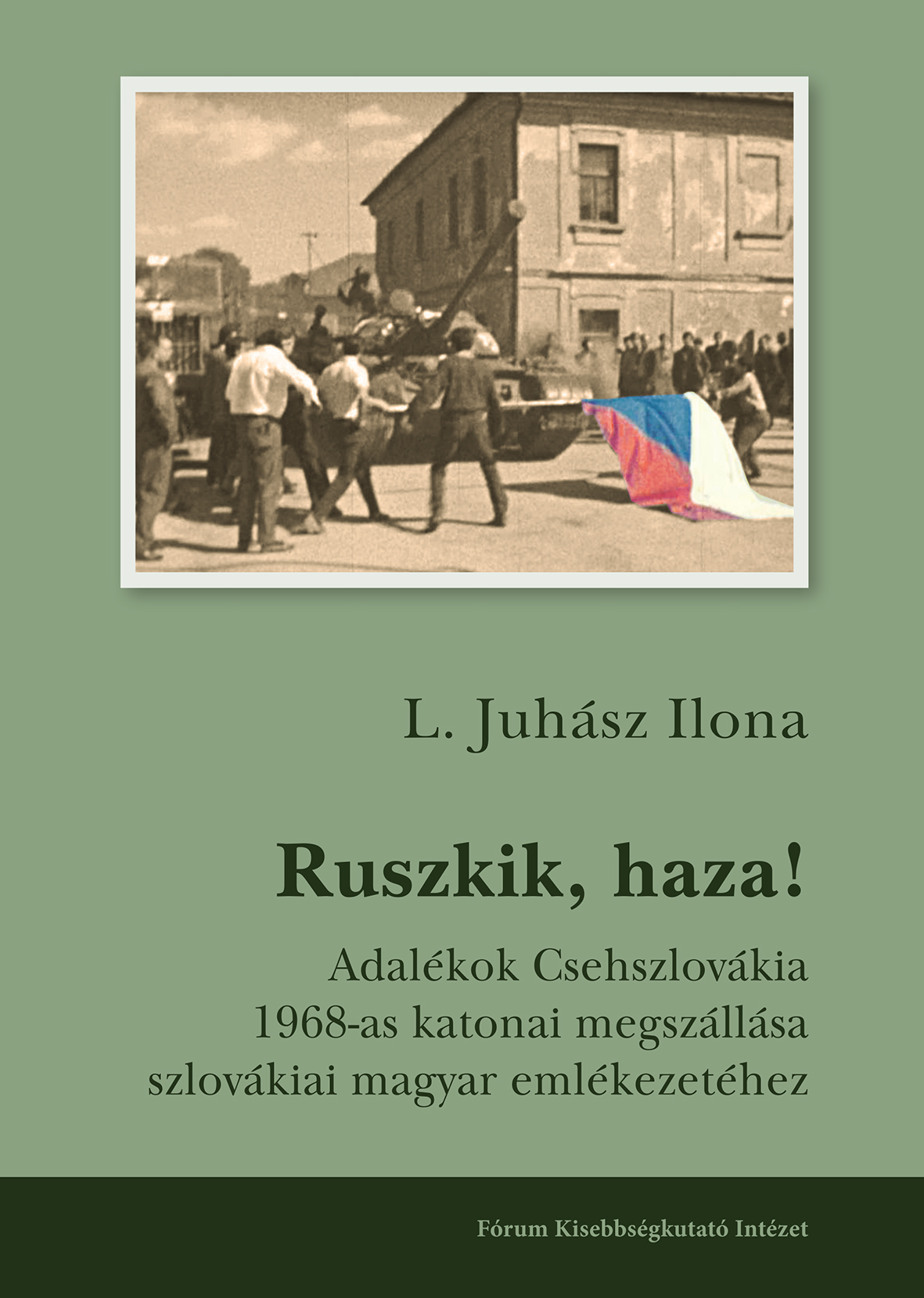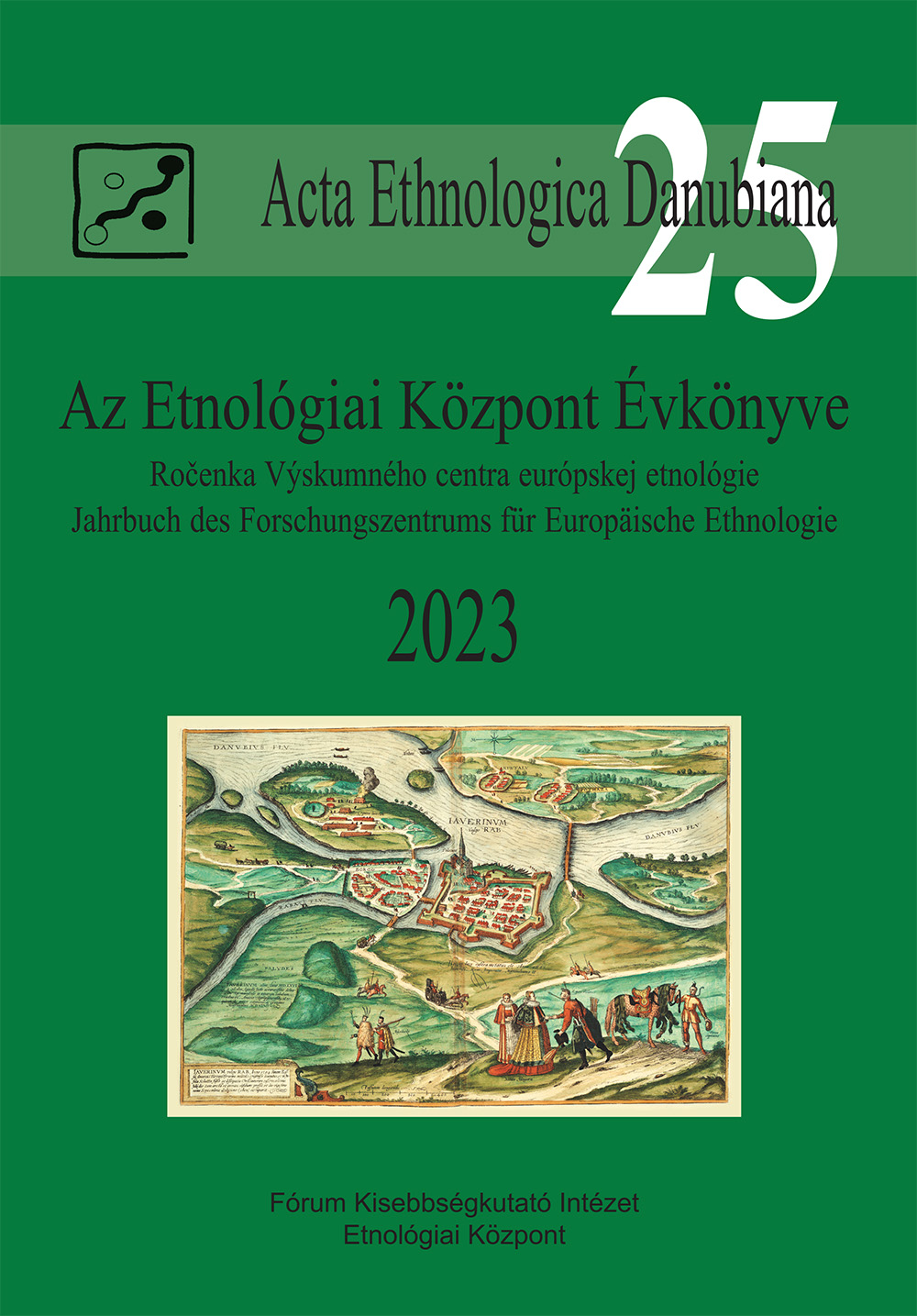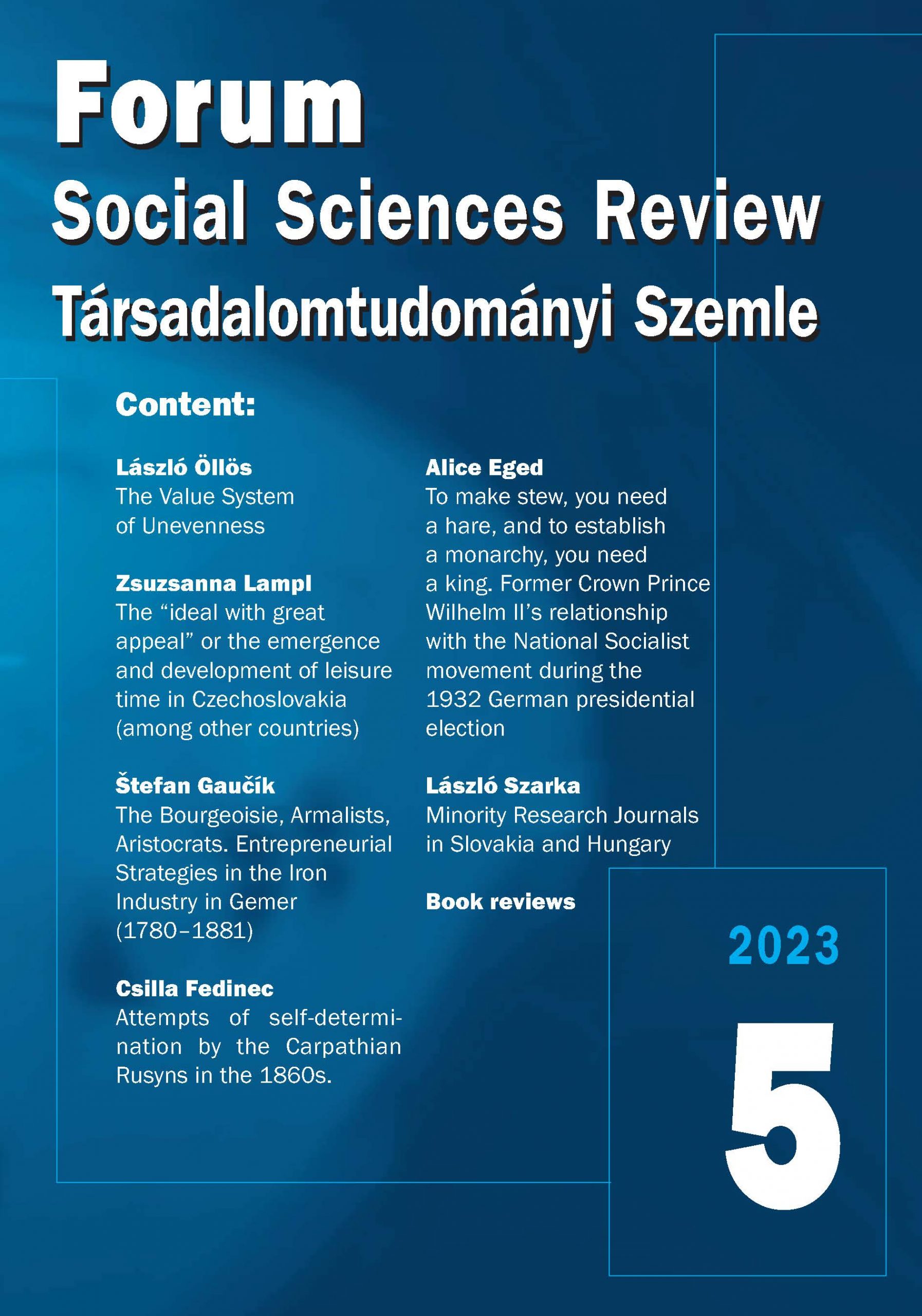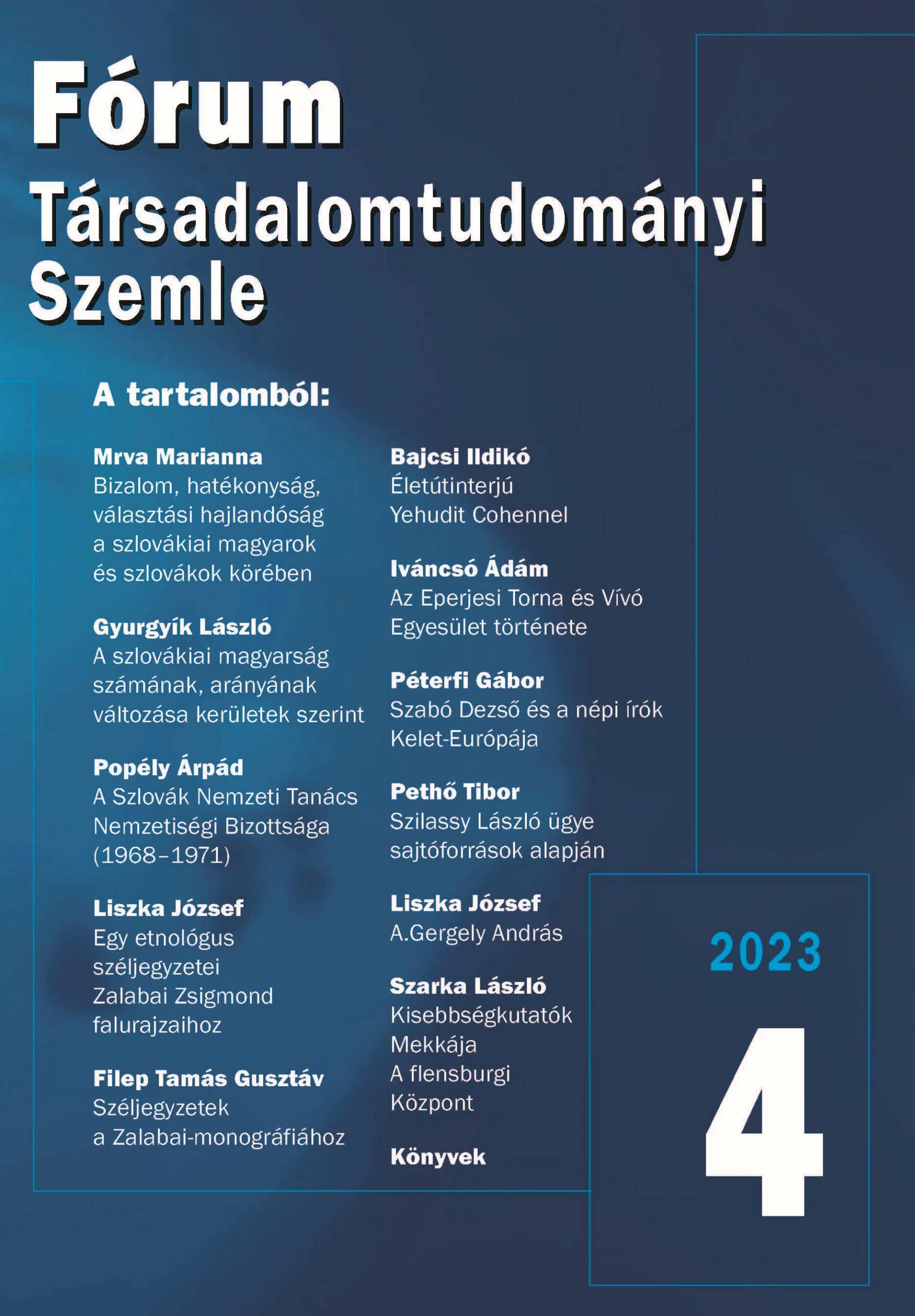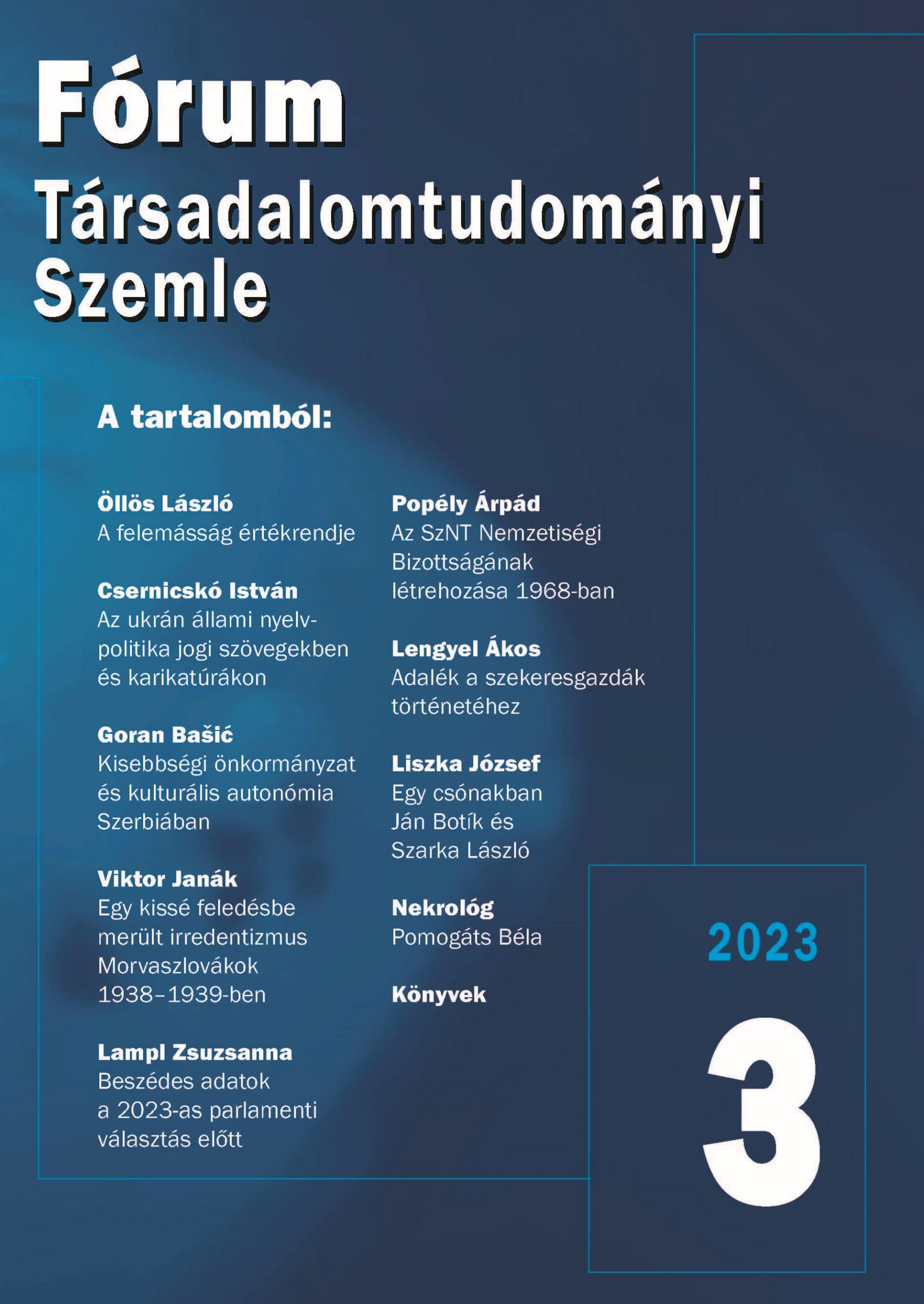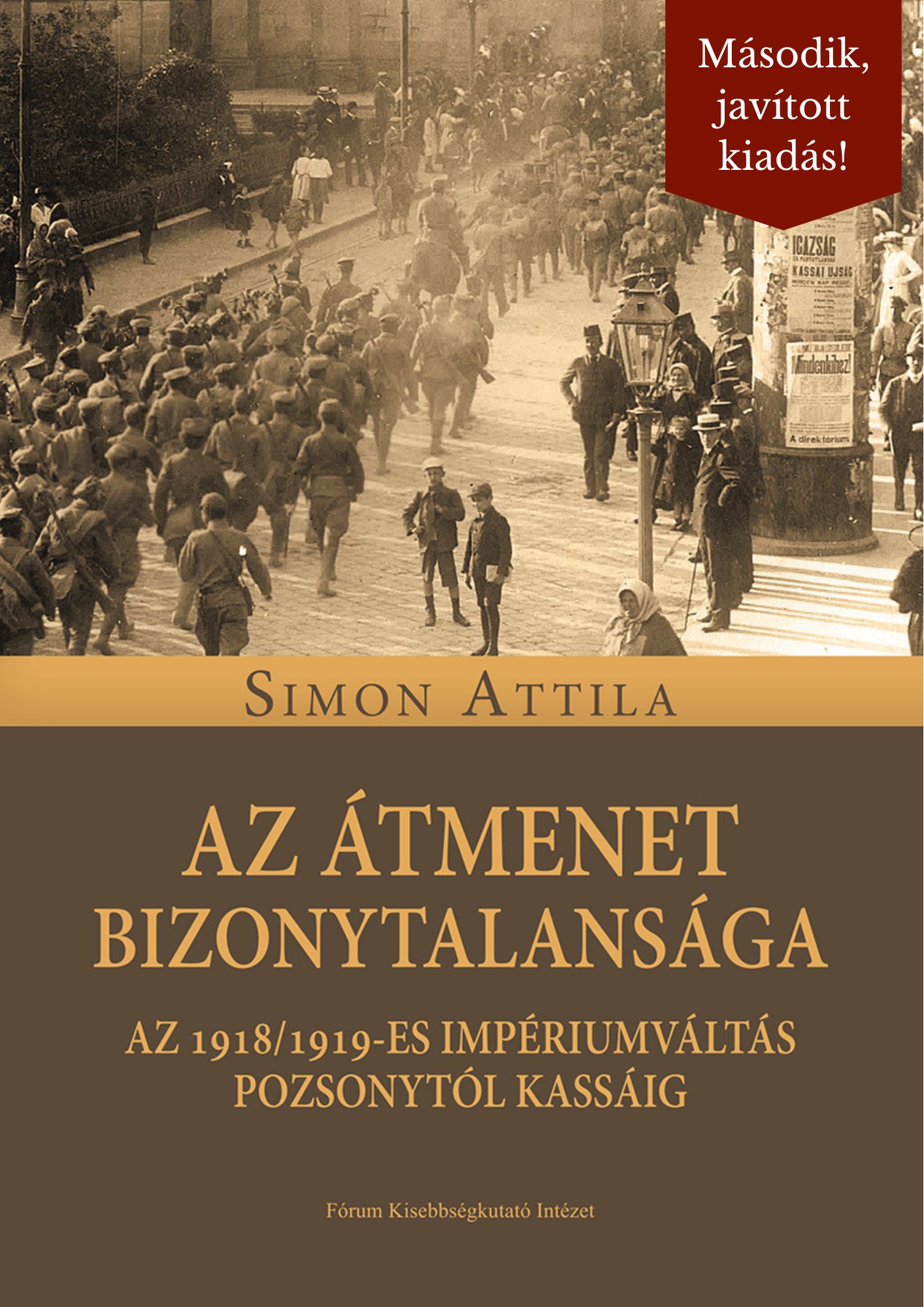Impresszum 2024/1
Fû°ôÙrum TûÀrôÙsaôÙdaôÙlomôÙtuôÙdoôÙmûÀôÙnyi SzemôÙle negyedûˋvenkûˋnt megjelené tuôÙdoôÙmûÀôÙnyos foôÙlyû°ôÙiraôÙt XXVII. ûˋvfolyam Fészerkeszté: Csanda GûÀbor A szerkesztébizottsûÀg elnûÑke: ûllûÑs LûÀszlû°TanulmûÀnyok
Fedinec Csilla: Az oroszãukrûÀn hûÀborû¤ az ukrûÀn jogszabûÀlyokban (2014ã2023). Somorjai ûdûÀm: A szlovûÀkiai magyarok Mindszenty hercegprûÙmûÀsnak a nyugati ûÀllamfékhûÑz ûÙrt leveleiben, 1945ã1948. Keresztes Csaba: Menekû¥lt pedagû°gusok a mûÀsodik vilûÀghûÀborû¤ utûÀni MagyarorszûÀgon, kû¥lûÑnûÑs tekintettel az û¤jjûÀalakult CsehszlovûÀkiûÀbû°l ûˋrkezékre. Miklû°s DûÀniel: Aktivizmus bûÀrmilyen irûÀnyba. VûÀzlat Schultz IgnûÀc mûÀsodik vilûÀghûÀborû¤ alatti tevûˋkenysûˋgûˋrél. Danáo Jakab Veronika: KûÑzûˋpiskolai tanulû°k vûˋlekedûˋse a kûˋtnyelvéÝ kûÑrnyezetben tûÑrtûˋné kû°dvûÀltûÀsrû°l. Gazdag Vilmos: A kûÀrpûÀtaljai magyar nyelvhasznûÀlat sajûÀtossûÀgai az 1980ã90-es ûˋvek fordulû°jûÀn a VûÑrûÑs ZûÀszlû° jûÀrûÀsi lap anyagai alapjûÀn.KûÑzlemûˋnyek
Fû¥lûÑp LûÀszlû°: KûÑvesdy LukûÀcs 1556-ban kelt vûˋgrendeletûˋrél.Fû°rum-monolû°gok
Hadas Miklû°s: A fûÑldûÑnkûÙvû¥li. Zsû°ka monolû°gja.KûÑszûÑnté
Liszka Jû°zsef: Az IntegrûÀtor. Vûˋgh LûÀszlû° 75. szû¥letûˋsnapjûÀra.KûÑnyvek
Nagy Zsû°fia: Durst JuditãNyûÙré ZsannaãBeremûˋnyi ûbel (szerk.): A tûÀrsadalmi mobilitûÀs ûÀra. Elsé generûÀciû°s diplomûÀsok ûˋs az osztûÀlyvûÀltûÀs kûÑvetkezmûˋnyei. Dudics Lakatos KatalinãBûÀrûÀny Erzsûˋbet: Kiss Anita: KûÀrpûÀtaljai magyar egyetemi ûˋs féiskolai hallgatû°k nyelvhasznûÀlathoz ûˋs nyelvi vûÀltozatossûÀghoz kapcsolû°dû° attitéÝdjei. PolgûÀr Anikû°: Pusztai-Varga Ildikû°: Mûˋzescsû°k, dûÑgcûˋdula, szauna. A finn kûÑltûˋszet fordûÙtûÀsûÀnak kulturûÀlis dimenziû°i . Csehy ZoltûÀn: LadûÀnyi IstvûÀn: Megû¤julû° befejezetlensûˋg. Az ûj Symposion folyû°irat arculata, szerkesztûˋsi gyakorlatai ûˋs méÝfajai.Az oroszãukrûÀn hûÀborû¤ az ukrûÀn jogszabûÀlyokban (2014ã2023)
DOI: https://doi.org/10.61795/fssr.v26y2024i1.01
A PûÀrizsi KartûÀtû°l az û¤j hideghûÀborû¤ig
A mûÀsodik vilûÀghûÀborû¤ utûÀn kialakult kûˋtpû°lusû¤ vilûÀgrendben a biztonsûÀgot kûˋt nagy katonai tûÑmb szolgûÀltatta ã a NATO ûˋs a Varsû°i Szerzédûˋs. A negyven ûˋven ûÀt hû¤zû°dû° hideghûÀborû¤ a berlini fal leomlûÀsûÀval, a kûˋt NûˋmetorszûÀg egyesû¥lûˋsûˋvel, a szocialista tûÀbor ûÑsszeomlûÀsûÀval, a kûÑzûˋp-eurû°pai rendszervûÀltûÀsokkal, vûˋgû¥l pedig a Szovjetuniû° felbomlûÀsûÀval ûˋs û¤j orszûÀgok lûˋtrejûÑttûˋvel ûˋrt vûˋget. FormûÀlisan a hideghûÀborû¤nak nem volt gyéztese. Zbigniew Brzeziéski lengyel szûÀrmazûÀsû¤ amerikai nemzetbiztonsûÀgi fétanûÀcsadû° û¤gy fogalmazott, hogy a hideghûÀborû¤ langyos bûˋkûˋvel ûˋrt vûˋget, ellentûˋtben aô ãhideg bûˋkûˋvelã, amely ûÀltalûÀban a forrû° hûÀborû¤t kûÑveti. Nem tûÑrtûˋnt kapitulûÀciû°, mint 1918-ban Compiû´gne-ben[2]ô vagy 1945-ben Reimsben.[3]ô MindazonûÀltal az 1990. novemberi pûÀrizsi konferencia, a kelet-nyugati megbûˋkûˋlûˋs szûÙnhelye, valû°jûÀban a Nyugat geopolitikai ûˋs ideolû°giai gyézelmûˋnek megerésûÙtûˋse volt.[4]
Az 1990. november 19ã21-ûˋn PûÀrizsban tartott Eurû°pai BiztonsûÀgi ûˋs Egyû¥ttméÝkûÑdûˋsi ûrtekezleten elfogadott PûÀrizsi Karta az ûj Eurû°pûÀûˋrt kinyilvûÀnûÙtotta a mûÀsodik vilûÀghûÀborû¤ û°ta fennûÀllû° eurû°pai megosztottsûÀg megszéÝnûˋsûˋt, meghatûÀrozta az egyû¥ttméÝkûÑdûˋs û¤j alapelveit. Ez azonban politikai dokumentum volt, nem pedig szerzédûˋs. Richard Sakwa ûˋrtelmezûˋse szerint a hideghûÀborû¤ utûÀni eurû°pai biztonsûÀgi rend felbomlûÀsa egyszerre volt oka ûˋs kûÑvetkezmûˋnye az ukrajnai vûÀlsûÀgnak, nem sikerû¥lt megvalû°sûÙtani a PûÀrizsi KartûÀban megfogalmazott, ãegûˋsz ûˋs szabad Eurû°paã megteremtûˋsûˋre irûÀnyulû° tûÑrekvûˋseket, a pûÀnkontinentûÀlis egysûˋg terve kudarcot vallott, OroszorszûÀg azzal a tudattal reagûÀlt, hogy kizûÀrtûÀk az û¤j eurû°pai rendbél ûˋs elmozdult a neorevizionizmus felûˋ.[5]
A hideghûÀborû¤ kûˋt katonai tûÑmbje kûÑzû¥l a Varsû°i Szerzédûˋs felbomlott, a hideghûÀborû¤ csû¤cspontjûÀn 16 tagorszûÀgot szûÀmlûÀlû° NATO viszont 2020-ra 30 tagû¤ra bévû¥lt. A hideghûÀborû¤ utûÀni NATO-tagsûÀgra tûÑrekvé orszûÀgok û¤gy vûˋltûˋk, hogy a szûÑvetsûˋghez valû° csatlakozûÀs dûÑnté fontossûÀgû¤ a Nyugathoz valû° integrûÀlû°dûÀsra ûˋs az OroszorszûÀgtû°l valû° vûˋdelemre irûÀnyulû° cûˋljaik megvalû°sûÙtûÀsûÀhoz, amellyel sokuknak problûˋmûÀs mû¤ltja volt. Akik a NATO bévûÙtûˋsûˋt szorgalmaztûÀk, û¤gy vûˋltûˋk tovûÀbbûÀ, hogy az elengedhetetlen a demokrûÀcia elémozdûÙtûÀsûÀhoz ûˋs megszilûÀrdûÙtûÀsûÀhoz a hideghûÀborû¤ utûÀni Eurû°pûÀban. A terjeszkedûˋs ellenzéi viszont arra figyelmeztettek, hogy az visszaûÀllûÙtja a hideghûÀborû¤ lûˋgkûÑrûˋt a kelet-nyugati kapcsolatokban.[6]
OroszorszûÀg fenntartotta hûÀborû¤k ûÀrûÀn is az 1990-es ûˋvek fordulû°jûÀn kialakult befagyott konfliktusokat (frozen conflicts). A kifejezûˋs ritkûÀn szerepel a nemzetkûÑzi dokumentumokban, de a politikusok ûˋs a szakûˋrték szûˋles kûÑrben hasznûÀljûÀk a MoldovûÀhoz tartozû° Transznyisztria, az AzerbajdzsûÀnhoz tartozû° Hegyi-Karabah,[7]ô valamint a Grû¤ziûÀhoz tartozû° Dûˋl-Oszûˋtia ûˋs AbhûÀzia esetûˋben. E szeparatista terû¥letek kûÑzûÑs jellemzéje, hogy de jure a nevezett orszûÀgokhoz tartoznak, de facto azonban nem azoknak alûÀrendelt helyi kûÑzigazgatûÀs irûÀnyûÙtûÀsûÀval, hanem idegen ûÀllam tûÀmogatûÀsûÀval méÝkûÑdnek.[8] Emellett mûÀr az 1990-es ûˋvektél egyre nagyobb teret nyertek Alekszandr Dugin, a putyini OroszorszûÀg nem hivatalos ideolû°gusa nûˋzetei, aki szerint a hazafisûÀg az, hogy az Egyesû¥lt ûllamok vezette atlantista vilûÀggal szemben fel kell ûˋpûÙteni egy û¤jô birodalmat, egy eurûÀzsiai szuperhatalmat, amely OroszorszûÀg vûˋdészûÀrnyai alatt a volt szovjet tagkûÑztûÀrsasûÀgokat integrûÀlja az û¤j szûÑvetsûˋgbe. Ennek az eurûÀzsiai birodalomnak feltûˋtlenû¥l kijûÀratot kell szereznie a ãmeleg tengerekhezã, akkor tud szembeszûÀllni az atlantizmus jelentette globûÀlis kihûÙvûÀssal. Ebben az akadûÀlyozû° tûˋnyezé Ukrajna, amely vagy Moszkva meghosszabbûÙtott keze lesz, vagy pedig ezt elutasûÙtva kûˋrdéjelessûˋ teszi OroszorszûÀg biztonsûÀgûÀt, ûˋs hûÀborû¤s tûˋnyezévûˋ vûÀlik.[9]
2007-ben, a negyvenharmadik mû¥ncheni biztonsûÀgi konferenciûÀn az ott elészûÑr rûˋszt vevé Vlagyimir Putyin orosz elnûÑk vûÀratlanul harcias beszûˋdet mondott: ûˋlesen tûÀmadta az Egyesû¥lt ûllamokat ûˋs a NATO-t, û¤j kû¥lpolitikai stratûˋgiûÀt, az addigi partnersûˋggel szemben az Egyesû¥lt ûllamokkal valû° nyûÙlt szembenûÀllûÀst hirdetett. Ezt û¤gy lehetett ûˋrtelmezni, hogy kezdetûˋt vette a mûÀsodik hideghûÀborû¤.[10]ô OroszorszûÀg 2012-tél hivatalosan is fé kû¥lpolitikai cûˋljûÀvûÀ tette az ãorosz vilûÀgã (Å îîſ ťšî / Russian world) ûˋs az EurûÀzsiai Uniû° hatû°sugarûÀnak ûˋs befolyûÀsûÀnak kiterjesztûˋsûˋt, az ãeurûÀzsiaiã eszmûˋkre hivatkozûÀssal, amelyek az orosz vilûÀghoz kûÑtik az orosz nyelv ûˋs kultû¤ra, a kûÑzûÑs tûÑrtûˋnelem ûˋs ûÑrûÑksûˋg (a Kijevi Rusztû°l kezdve), az ortodoxia, a konzervatûÙv ûˋrtûˋkek, a gazdasûÀgi integrûÀciû° szû¥ksûˋgessûˋge mentûˋn a posztszovjet tûˋrsûˋg jelentés rûˋszûˋt.[11]ô Andrej Kolesznyikov, a moszkvai Carnegie KûÑzpont igazgatû°ja a tûÙzûˋves ûˋvfordulû°n Putyin fultoni beszûˋdûˋnek nevezte el: ãszû°kimondûÀsûÀval meg akart ijeszteni a Nyugatot, abban a hitben, valû°szûÙnéÝleg, hogy a ô£nyugati partnerekô¨ talûÀn figyelembe veszik majd aggodalmait, ûˋs tesznek irûÀnyûÀba gesztusokat. [ãÎ] A hatûÀs az ellenkezéje volt, de mûˋg ezt a B lehetésûˋget is elére belekalkulûÀlta: nem akarjûÀtok, akkor OroszorszûÀg a Nyugat egy szeletûˋbél szuverûˋn szigettûˋ fog ûÀtalakulniã.[12]
A bûˋkefenntartûÀs fogalma
Az ENSZ AlapokmûÀnya (1945) szerint: ã[m]inden olyan viszûÀly esetûˋben, amelynek elhû¤zû°dûÀsa a nemzetkûÑzi bûˋke ûˋs biztonsûÀg fenntartûÀsûÀnak veszûˋlyeztetûˋsûˋre vezethet, a felek mindenekelétt kûÑzvetlen tûÀrgyalûÀs, kivizsgûÀlûÀs, kûÑzvetûÙtûˋs, bûˋkûˋltetûˋs, vûÀlasztott bûÙrû°sûÀgi vagy bûÙrû°sûÀgi eljûÀrûÀs, regionûÀlis szervek, vagy megûÀllapodûÀsok igûˋnybevûˋtele vagy ûÀltaluk vûÀlasztott egyûˋb bûˋkûˋs eszkûÑzûÑk û¤tjûÀn tartoznak megoldûÀst keresni.ã (VI. fejezet 33. cikk. 1. pont) Ha a nemzetkûÑzi bûˋke ûˋs biztonsûÀg fenntartûÀsa vagy helyreûÀllûÙtûÀsa ûˋrdekûˋben tett bûˋkûˋlteté javaslatok nem vezetnek eredmûˋnyre, a BiztonsûÀgi TanûÀcs ãlûˋgi, tengeri ûˋs szûÀrazfûÑldi fegyveres erék felhasznûÀlûÀsûÀval olyan méÝveleteket foganatosûÙthat, amelyeket a nemzetkûÑzi bûˋke ûˋs biztonsûÀg fenntartûÀsûÀhoz, vagy helyreûÀllûÙtûÀsûÀhoz szû¥ksûˋgeseknek ûÙtûˋl. Ezek a méÝveletek az Egyesû¥lt Nemzetek tagjainak lûˋgi, tengeri ûˋs szûÀrazfûÑldi hadereje ûÀltal foganatosûÙtott tû¥nteté felvonulûÀsbû°l, zûÀrlatbû°l (blokûÀd) vagy egyûˋb méÝveletekbél is ûÀllhatnak.ã (VII. fejezet 42. cikk)
A hideghûÀborû¤ idészakûÀban a bûˋkefenntartûÀs elsésorban a demilitarizûÀlt zû°nûÀk, a téÝzszû¥net fenntartûÀsûÀt jelentette, azû°ta pedig megnétt egy-egy zajlû° konfliktusba valû° beavatkozûÀs szerepe.
A bûˋkefenntartûÀs nemzetkûÑzi szinten az ENSZ hatûÀskûÑrûˋbe tartozik, emellett a fogalmat egyes orszûÀgok is ismerik, s eltûˋréen interpretûÀljûÀk. OroszorszûÀgban az AlkotmûÀny (1993) szerint a hadsereg kû¥lfûÑldi bevetûˋsûˋnek lehetésûˋgûˋrél az elnûÑk dûÑnt a parlament felséhûÀzûÀnak felhatalmazûÀsa alapjûÀn (102. cikk 1.d) pont). A Szovjetuniû° 1991-es felbomlûÀsa utûÀn OroszorszûÀg mint annak jogutû°dja lett az ENSZ BiztonsûÀgi TanûÀcsûÀnak ûÀllandû° tagja. Az ENSZ bûˋkefenntartûÀshoz valû° viszonyban Vlagyimir Putyin hatalomra kerû¥lûˋse hozott fordulatot, amikortû°l kezdve OroszorszûÀg annak hangsû¤lyozûÀsûÀt helyezte elétûˋrbe, hogy ezek a bûˋkemissziû°k a Nyugat ûˋrdekeit szolgûÀljûÀk. Az Orosz FûÑderûÀciû° az ENSZ keretûˋben visszafogta a rûˋszvûˋtelûˋt bûˋkefenntartû° méÝveletekben, illetve ezekbe csak speciûÀlis egysûˋgeket ûˋs nûˋha csak katonai szakûˋrtéket kû¥ldûÑtt.[13]
Az 1990-es ûˋvekben a Grû¤ziûÀhoz tartozû° AbhûÀziûÀban az ENSZ, Dûˋl-OszûˋtiûÀban az EBESZ kûÑzreméÝkûÑdûˋsûˋvel avatkozott be. Ezt a status quû°t a 2008-as oroszãgrû¤z hûÀborû¤ vûÀltoztatta meg, amit mûÀr nem lehetett bûˋkefenntartûÀskûˋnt interpretûÀlni, azt a nemzetkûÑzi kûÑzûÑssûˋg szûˋles kûÑréÝen elûÙtûˋlte, mikûÑzben Grû¤zia belûÀthatatlan idére elvesztette annak lehetésûˋgûˋt, hogy beleszû°lûÀsa legyen a kûˋt rûˋgiû° ûˋletûˋbe. MûÀs helyzet alakult ki TransznyisztriûÀban, ahol OroszorszûÀg nemcsak bûˋkekontingenst ûÀllomûÀsoztatott, hanem sokoldalû¤an tûÀmogatta a helyi szeparatistûÀkat, beleûˋrtve a katonai tûÀmogatûÀst is. A moldovai konfliktus egyfajta ãtesztpûÀlyaã lett az û¤j orosz koncepciû° szûÀmûÀra, amelynek cûˋlja, hogy megérizze befolyûÀsûÀt a posztszovjet tûˋrsûˋgben. Az Orosz FûÑderûÀciû° taktikûÀja a ãellenérzûÑtt kûÀoszã, amely a megoldatlan ûˋs ãbefagyasztottã fegyveres konfliktusokon alapul.[14] Moszkva ûˋrtelmezûˋsûˋben bûˋkefenntartûÀs volt a beavatkozûÀs TûÀdzsikisztûÀnban (1992) ûˋs KazahsztûÀnban (2022) is. Azt, amit Moszkva konfliktusûÑvezetekben vûˋgrehajtott nemzetkûÑzi méÝveletekkûˋnt tû¥ntetett fel, Alexander Nikitin talûÀlû°an ãszimulûÀlt bûˋkefenntartûÀsnakã ûÙrta le.[15]
MiutûÀn OroszorszûÀg 2014-ben beavatkozott UkrajnûÀban ã megszûÀllta a KrûÙmet, ûˋs burkolt tûÀmogatûÀssal kirobbantotta a fegyveres konfliktust a Donbaszban ã, viszonylag rûÑvid ideig tartû° vita folyt arrû°l, hogy lehetsûˋges-e ENSZ bûˋkefenntartû°kat kû¥ldeni KeletUkrajnûÀba. A kûˋrdûˋst nem lehetett elémozdûÙtani a BiztonsûÀgi TanûÀcsban, ûÙgy az EBESZ megfigyeléi[16] maradtak az egyetlen legitim bûˋkefenntartû°k UkrajnûÀban. NûˋhûÀny nappal azelétt, hogy Vlagyimir Putyin 2022. februûÀr 21-ûˋn bejelentette a Luhanszki ûˋs a Donecki kvûÀziûÀllamok elismerûˋsûˋt, Sztanyiszlav Zasz, a KollektûÙv BiztonsûÀgi Szerzédûˋs Szervezetûˋnek fétitkûÀra MoszkvûÀban exkluzûÙv interjû¤t adott a Reutersnek, amelyben kijelentette, hogy a KBSZSZ bûˋkefenntartû°kat (peacekeepers) kû¥ldhet a Donbaszba, ha nemzetkûÑzi konszenzus szû¥letik egy ilyen bevetûˋsrél. ãNem hiszem, hogy a helyzet most vissza fog tûˋrni ahhoz, ami korûÀbban volt, amikor a tankok a bûÀzisokon voltak, a katonûÀk pedig a laktanyûÀkban. Ez nem fog megtûÑrtûˋnni. Meg kell ûˋrteni, hogy le kell û¥lni a tûÀrgyalû°asztalhoz, ûˋs meg kell ûÀllapodni valamiben. Ez az û¤j valû°sûÀgã ã mondta. Zasz elutasûÙtotta, hogy a KBSZSZ az orosz befolyûÀs elémozdûÙtûÀsûÀnak eszkûÑze lenne, ugyanakkor kûˋtsûˋget sem hagyott afelél, hogy ã[k]olosszûÀlis potenciûÀl van a kezû¥nkbenã, ã[h]iggyûˋk el, annyi katonûÀt tudunk kû¥ldeni, amennyit csak szû¥ksûˋgesã.[17]
A KBSZSZ bevetûˋsûˋre nem kerû¥lt sor, hanem a regulûÀris orosz haderé rohanta le UkrajnûÀt 2022. februûÀr 24-ûˋn a KBSZSZ tagorszûÀgai kûÑzû¥l OroszorszûÀg ûˋs Belarusz terû¥letûˋrél.
Az oroszãukrûÀn hûÀborû¤: jogi stûÀtusz
MiutûÀn 2014 elejûˋn a mûÀsodik Majdan-tû¥ntetûˋshullûÀm nyomûÀn Viktor Janukovics ukrûÀn ûÀllamfé elmenekû¥lt az orszûÀgûÀbû°l, az oroszorszûÀgi Szocsiban megrendeztûˋk a tûˋli olimpiûÀt, ûˋs az ukrûÀn hatûÀr mentûˋn rendkûÙvû¥li hadgyakorlatot tartottak, februûÀr 27ûˋn a KrûÙm fûˋlszigeten azonosûÙtû° jel nûˋlkû¥li katonûÀk jelentek meg. Kijev orosz alakulatokkûˋnt azonosûÙtotta éket, Moszkva ezzel szemben azt ûÀllûÙtotta, hogy nem katonûÀk, hanem a helyi ãnûˋpi ûÑnvûˋdelemã tagjai. Az ukrûÀn ûˋs az orosz sajtû° is azonnal ãkis zûÑld embereknekã nevezte el a fegyvereseket (nûˋpi nevûˋn lûÀsd mûˋg ãdeszantos turistûÀkã), akik elfoglaltûÀk a kormûÀnyzati ûˋpû¥leteket, blokkoltûÀk a katonai lûˋtesûÙtmûˋnyeket ûˋs a flottûÀt. A legitimitûÀs nûˋlkû¥li û¤j miniszterelnûÑk, Szerhij Akszjonov Vlagyimir Putyinhoz fordult, hogy biztosûÙtsa a fûˋlsziget ãbûˋkûˋjûˋt ûˋs nyugalmûÀtã. Az orosz elnûÑk mûÀrcius 1-jûˋn kezdemûˋnyezte az orosz hadsereg bevetûˋsûˋt, amit a parlament felséhûÀza mûˋg aznap jû°vûÀhagyott. MûÀrcius 16-i kvûÀzinûˋpszavazûÀs utûÀn, mûÀrcius 20-ûÀn az orosz parlament ratifikûÀlta a KrûÙmnek OroszorszûÀghoz valû° csatlakozûÀsûÀrû°l szû°lû° szerzédûˋst.[18]
A KrûÙm elcsatolûÀsûÀt kûÑvetéen a kontinentûÀlis orszûÀgrûˋsz keleti ûˋs dûˋli megyûˋinek nagyvûÀrosaiban tû¥ntetûˋsek kezdédtek orosz zûÀszlû°k alatt, melyek sorûÀn a tû¥nteték elfoglaltûÀk a kûÑzigazgatûÀsi ûˋpû¥leteket, kifosztottûÀk a rendérsûˋgi fegyverraktûÀrakat, embereket vertek meg, sét, erészakos halûÀlestek is tûÑrtûˋntek, ûˋs û¤jabb ãKrûÙmetã, azaz terû¥letfoglalûÀst kûÑveteltek. AzonosûÙtatlan orosz fegyveres csoportok szivûÀrogtak be a KrûÙm felél egy volt KGB-s tiszt, Igor Girkin-Sztrelkov vezetûˋsûˋvel, aki maga nyilatkozta a kûÑvetkezéket mûÀr 2014 novemberûˋben: ãEz az ûÑtûÑdik hûÀborû¤m. Volt kûˋt csecsen hûÀborû¤, Transznyisztria ûˋs Bosznia.ã ãAmikor a krûÙmi esemûˋnyek bekûÑvetkeztek, vilûÀgossûÀ vûÀlt, hogy a KrûÙm ûÑnmagûÀban nem lesz a vûˋge. A KrûÙm mint Novorosszija rûˋsze koloszszûÀlis szerzemûˋny volt, gyûˋmûÀnt az Orosz Birodalom koronûÀjûÀn. De a KrûÙm egyedû¥l, egy ellensûˋges ûÀllam fûÑldszorosûÀval elvûÀgva, nem volt az igazi.ã A Donbaszban ã[e]leinte senki sem akart harcolni. Az elsé kûˋt hûˋt annak jegyûˋben telt el, hogy mindkûˋt fûˋl meg akarta gyézni a mûÀsikat. Az elsé nûˋhûÀny napban Szlovjanszkban mind mi, mind ék rendkûÙvû¥l û°vatosak voltunk a fegyverhasznûÀlattal kapcsolatban. [ãÎ] ûprilisban ûˋs mûÀjusban minden felfelûˋ haladt, vagyis a felkelûˋs terû¥lete egyre bévû¥lt, fokozatosan ûÀtvettû¥k az irûÀnyûÙtûÀst a Donyecki KûÑztûÀrsasûÀg lakott terû¥letein, ûˋs terjesztettû¥k a mozgalmat, de jû¤niusban elkezdtû¥nk visszavonulni. [ãÎ] Az ellensûˋg egyre motivûÀltabb lett a harcra.ã ãAbban a pillanatban tisztûÀban voltam vele, hogy Donyeck ûˋs Luganszk egyedû¥l nem lesz kûˋpes harcolni az ukrûÀnok ellen.ã[19] Jevgenyij Prigozsin, a magûÀnhadsereg tulajdonosa is nyilvûÀnosan elismerte, hogy a Wagner is rûˋszt vett a donbûÀszi harcokban.[20] Szergej Mironov, az IgazsûÀgos OroszorszûÀg PûÀrt elismerte, hogy 2014-tél kezdve nemcsak gyû°gyszereket ûˋs ûˋlelmiszereket szûÀllûÙtottak a Donbaszba. ãTisztûÀzzuk: kettés felhasznûÀlûÀsû¤ termûˋkeket szûÀllûÙtunk. Ma mûÀr nyûÙltan beszûˋlhetû¥nk errél.ã[21] A sor hoszszasan folytathatû°, mikûÑzben a hivatalos oroszorszûÀgi narratûÙva rendû¥letlenû¥l arrû°l szû°lt, hogy UkrajnûÀban polgûÀrhûÀborû¤ zajlik.
A szeparatistûÀk az ûÀltaluk ellenérzûÑtt terû¥leten lûÀgert hoztak lûˋtre, ahol nemcsak a foglyokat, hanem a helyi lakossûÀg megbûÙzhatatlannak ûÙtûˋlt tagjait is fogsûÀgban tartottûÀk, megkûÙnoztûÀk.[22] Az ãûÀtnevelûˋsã nyolc ûˋve sem vezetett azonban ahhoz, hogy a helyi lakosok az ãorosz vilûÀgã ã ûˋs ãNovorosszijaã ã maradûˋktalan hûÙveivûˋ vûÀljanak.
Ukrajna nyugati orszûÀgrûˋszûˋben is elfoglaltak kûÑzigazgatûÀsi ûˋs rendérsûˋgi ûˋpû¥leteket, de azzal a kû¥lûÑnbsûˋggel, hogy a hivatalok méÝkûÑdûˋsûˋt nem akadûÀlyoztûÀk, nem szû°lûÙtottak fel kû¥lfûÑldi eréket, pûˋldûÀul a NATO-t beavatkozûÀsra, vagy nem hûÙvtûÀk LengyelorszûÀgot, foglalja el az orszûÀgrûˋszt. A nyugati orszûÀgrûˋszben is vertek meg embereket a zavargûÀsok sorûÀn, de csak egy esetben voltak halottak. A 2014. mûÀjus 2-i odeszai eset[23] aztûÀn OroszorszûÀg legfébb hivatkozûÀsi alapjûÀvûÀ vûÀlt UkrajnûÀval szemben. A kijevi vûˋrengzûˋs utûÀn voltunk, ahol a karhatalom a forradalmûÀrok kûÑzûˋ létt, aminek kûÑvetkeztûˋben tûÑbb mint szûÀzan meghaltak, a KrûÙm elveszett, Luhanszk ûˋs Doneck megyûˋk nagy rûˋsze fûÑlûÑtt az ûÀllamhatalom elvesztette az ellenérzûˋst. Ez nem magyarûÀzat a kegyetlensûˋgre, de fontos eleme a fûˋlelemnek, ami tûÀplûÀlta a kegyetlensûˋget.
A DonbûÀsz szû°ûÑsszevonûÀssal keletkezett a Donec-medence szlûÀv nevûˋbél (ukrûÀnul: ÅŃŧÅçîſ ÅÝůîÅçſŧ / Doneckij bûÀszejn, oroszul: ÅŃŧÅçſ ÅÝůîîÅçſŧ / Donyeckij bûÀsszejn). Nevûˋt a Donec folyû°rû°l kapta, eredetileg fûÑlrajzi terû¥letet ûˋs iparvidûˋket jelûÑl, amely ûÀtlûˋpi az ûÀllamhatûÀrokat, nagyobb rûˋsze UkrajnûÀhoz, kisebb rûˋsze OroszorszûÀghoz tartozik. 2014 û°ta a kûÑzbeszûˋdben a hûÀborû¤s terû¥let, Luhanszk ûˋs Doneck megyûˋk ûÑsszevont neve. Az ukrûÀnban a kvûÀzi-ûÀllamalakulatok, a Luhanszki NûˋpkûÑztûÀrsasûÀg (ukrûÀn ûˋs orosz: ÅÅÅ , angol: LPR) ûˋs a Donecki NûˋpkûÑztûÀrsasûÀg (ukrûÀn ûˋs orosz: ÅÅÅ , angol: DPR) kezdébetéÝinek ûÑsszevonûÀsûÀbû°l keletkezett betéÝszû° mûˋg az LDNR (ÅÅÅÅ ). A fûÑldrajzi Donec-medence szûˋdûÙté gyorsasûÀgû¤ ipari felemelkedûˋse a 19. szûÀzad mûÀsodik felûˋben vette kezdetûˋt. A szûÀzad vûˋgûˋre az Orosz Birodalom szûˋnkitermelûˋsûˋnek mûÀr majdnem fele innen szûÀrmazott. A rohamos ipari fejlédûˋs a szovjet idészakban is folytatû°dott, a szovjet nehûˋzipar ûˋs azon belû¥l egyebek mellett a hadiipar egyik fellegvûÀra volt, s vûˋgû¥l a fû¥ggetlen UkrajnûÀnak is az egyik legfontosabb gazdasûÀgi rûˋgiû°ja, amely aztûÀn a hûÀborû¤ miatt kikerû¥lt az orszûÀg vûˋrkeringûˋsûˋbél, a hûÀborû¤s cselekmûˋnyek kûÑvetkeztûˋben pedig jelentés rûˋszben elpusztult.
Ukrajna a NemzetbiztonsûÀgi TanûÀcs ãA terrorista fenyegetûˋs lekû¥zdûˋsûˋre ûˋs Ukrajna terû¥leti integritûÀsûÀnak megérzûˋsûˋre irûÀnyulû° sû¥rgés intûˋzkedûˋsekrélã szû°lû° 2014. ûÀprilis 13-i hatûÀrozata alapjûÀn mûÀsnap, ûÀprilis 14-ûˋn a 405. szûÀmû¤ elnûÑki rendelettel[24] indûÙtotta meg a szakadûÀr kûÑztûÀrsasûÀgok ellen a ãterrorelhûÀrûÙtû° méÝveletetã ã az ukrûÀn ûˋs az angol megnevezûˋsûˋnek egyarûÀnt ATO a rûÑvidûÙtûˋse (ÅŧîÅ¡îÅçîŃîÅ¡îîÅ¡îŧů ŃŢÅçîůîîî / Anti-Terrorist Operation), amely betéÝszû° elsésorban a kûÀrpûÀtaljai magyar sajtû°nak kûÑszûÑnhetéen a magyar kûÑznyelvbe is bekerû¥lt. A NemzetbiztonsûÀgi TanûÀcs jelentûˋse az elnûÑki rendelet titkos zûÀradûˋkûÀt kûˋpezte, szûÑvege nem nyilvûÀnos. Az ATO speciûÀlis jogi rezsimet jelentett, hadiûÀllapot bevezetûˋse nûˋlkû¥l, az UkrûÀn BiztonsûÀgi SzolgûÀlat (ÅÀÅ£îÅÑÅÝů ÅÝÅçÅñÅ¢Å獚 ÅÈŤîůîŧš, ÅÀÅÅÈ / Security Service of Ukraine, SSU) irûÀnyûÙtûÀsûÀval.
A harmadik napon, 2014. ûÀprilis 15-ûˋn a parlament megszavazta a 1207-VII. sz. tûÑrvûˋnyt ãA polgûÀrok jogainak ûˋs szabadsûÀgainak biztosûÙtûÀsûÀrû°l ûˋs a jogrendrél Ukrajna ideiglenesen megszûÀllt terû¥letûˋnã.[25] A tûÑrvûˋnyt mûÀsodik olvasatban fogadtûÀk el, kûÑzel kûˋtszûÀz mû°dosûÙtûÀst kûÑvetéen, egyebek kûÑzûÑtt kikerû¥lt beléle a ãkollaborûÀciû°ã fogalma. A tûÑrvûˋny meghatûÀrozza az Orosz FûÑderûÀciû° fegyveres agressziû°ja kûÑvetkeztûˋben ideiglenesen megszûÀllt terû¥let stûÀtuszûÀt (ãAz Orosz FûÑderûÀciû° ûÀltal ideiglenesen megszûÀllt ukrûÀn terû¥let [a tovûÀbbiakban: ideiglenesen megszûÀllt terû¥let] Ukrajna terû¥letûˋnek szerves rûˋszûˋt kûˋpezi, amelyre Ukrajna alkotmûÀnya ûˋs tûÑrvûˋnyei, valamint az Ukrajna parlamentje ûÀltal ratifikûÀlt nemzetkûÑzi szerzédûˋsek vonatkoznak.ã 1. cikk 1. pont), az ideiglenes megszûÀllûÀs kezdetûˋnek 2014. februûÀr 19-ûˋt tartja (2. cikk. 1. bekezdûˋs), kû¥lûÑnleges jogrendet (ŃîŃÅÝţšÅýÅ¡Å¿ Å¢îůÅýŃÅýÅ¡Å¿ îÅçÅÑÅ¡Å¥) vezet be ezen a terû¥leten (4. cikk), meghatûÀrozza az ûÀllami szervek, helyi ûÑnkormûÀnyzatok, vûÀllalkozûÀsok, intûˋzmûˋnyek ûˋs szervezetek e jogrend szerinti tevûˋkenysûˋgûˋnek sajûÀtossûÀgait, valamint az emberi ûˋs polgûÀri jogok ûˋs szabadsûÀgok, tovûÀbbûÀ a jogi szemûˋlyek jogainak, szabadsûÀgainak ûˋs jogos ûˋrdekeinek betartûÀsûÀt ûˋs vûˋdelmûˋt. A tûÑrvûˋny kimondja, hogy Ukrajna ûÀllampolgûÀrainak joguk van az ideiglenesen megszûÀllt terû¥letre valû° szabad ûˋs akadûÀlytalan beûˋs kiutazûÀshoz az ukrûÀn ûÀllampolgûÀrsûÀgukat igazolû° okmûÀny bemutatûÀsûÀval. Kû¥lfûÑldiek ûˋs hontalan szemûˋlyek beûˋs kilûˋpûˋse az ideiglenesen megszûÀllt terû¥leteken kû¥lûÑn engedûˋlyhez kûÑtûÑtt az ilyen szemûˋlyek szûÀmûÀra lûˋtrehozott beûˋs kilûˋpûˋsi pontokon keresztû¥l. A tûÑrvûˋny azt is kimondja, hogy ûÀllampolgûÀrai ûÀltal mûÀs ûÀllam ûÀllampolgûÀrsûÀgûÀnak kûˋnyszeréÝ (ãkûÑtelezé automatikusã) felvûˋtelûˋt (Å¢îÅ¡Å¥îîŃÅýÅç ůÅýîŃťůîÅ¡îŧÅç ŧůÅÝîîîî) Ukrajna nem ismeri el (5. cikk 6. pont). 2022 decemberûˋvel bezûÀrû°lag a tûÑrvûˋnyt huszonûÑtszûÑr mû°dosûÙtottûÀk.
2018. mûÀrcius 16-ûÀn Petro Porosenko ûÀllamfé a donbûÀszi harctûˋren jelentette be, hogy az ATO-korszak vûˋget ûˋrt.[26] 2018. ûÀprilis 30-ûÀval a 2018. januûÀr 18-ûÀn kelt 2268-19. sz. ãUkrajna ûÀllami szuverenitûÀsûÀnak biztosûÙtûÀsûÀra vonatkozû° ûÀllami politika sajûÀtossûÀgairû°l az ideiglenesen megszûÀllt donecki ûˋs luhanszki terû¥letekenã c. tûÑrvûˋnnyel[27] az ATO-t felvûÀltotta az ãegyesûÙtett erék hadméÝveleteã (ÅÅ¢Åçîůîîî ÅÅÝãîÅÇŧůŧšî ÅÀÅ¡Å£, ÅÅÅÀ / Joint Forces Operation, JFO) immûÀr vezûˋrkari irûÀnyûÙtûÀssal (2022. februûÀr 24-ûˋvel bezûÀrû°lag[28]). Miûˋrt volt szû¥ksûˋg erre a vûÀltozûÀsra? A ãterrorelhûÀrûÙtû° méÝveletã alapja az volt, hogy az ukrûÀn parlament a szakadûÀr kûÑztûÀrsasûÀgokat terrorszervezeteknek minésûÙtette, s ezeket a terrorszervezeteket tekintettûˋk ellensûˋgnek. Az û¤j jogûÀllûÀs OroszorszûÀgot agresszornak minésûÙtette. Ukrajna nem terroristûÀkkal harcol, hanem az orosz agreszszorral, ami nem a szolgûÀlatokra tartozik, hanem katonai feladat. Az egyesûÙtett erék vezûˋrkara irûÀnyûÙtja a DonbûÀszban az ûÑsszes erészakszervezetet, tehûÀt nemcsak a katonasûÀgot. A fé cûˋl az ellensûˋg ãvisszatartûÀsaã. Az ideiglenesen megszûÀllt terû¥letek kimaradtak az azû°ta tartott parlamenti, helyhatû°sûÀgi ûˋs elnûÑkvûÀlasztûÀsokbû°l.
Egûˋszen 2022-ig mind a szakirodalom, mind a szûˋlesebb nyilvûÀnossûÀg az ãukrûÀn vûÀlsûÀgã (Ukraine crisis) vagy a ãhibridhûÀborû¤ã (hybrid warfar) fogalmakkal ûÙrtûÀk le a tûÑrtûˋnûˋseket. A Budapesti Memorandum (1994), amelynek Ukrajna szuverenitûÀsûÀt ûˋs integritûÀsûÀt kellett volna biztosûÙtania, tûÑbbek kûÑzûÑtt OroszorszûÀg ûÀltal, nem szolgûÀlt az agressziû° megakadûÀlyozûÀsûÀra. ûppen ellenkezéleg, pûˋldakûˋnt szolgûÀlt arra, hogy a nemzetkûÑzi szerzédûˋseket hogyan lehet figyelmen kûÙvû¥l hagyni. A hideghûÀborû¤t mint a globûÀlis konfliktusok egyik formûÀjûÀt felvûÀltja a hibridhûÀborû¤. A fogalomnak tûÑbb definûÙciû°ja lûˋtezik, lûˋnyege az, hogy az ilyen hûÀborû¤t folytatû° ûÀllam alkut kûÑt nem ûÀllami vûˋgrehajtû°kkal ã fegyveresekkel, a helyi lakossûÀg csoportjaival, szervezetekkel, melyekkel a formûÀlis kapcsolattartûÀs teljessûˋggel lehetetlen ã, s ezek olyasmiket tehetnek meg, amiket maga az ûÀllam nem. A kifejezûˋst UkrajnûÀra Frank van Kappen holland politikus, nyugalmazott tûÀbornok alkalmazta elészûÑr 2014 ûÀprilisûÀban. A korûÀbban CsecsenfûÑlddel, Irakkal ûˋs Libanonnal kapcsolatban hasznûÀlt fogalom Ukrajna esetûˋben a korûÀbbiaknûÀl szûˋlesebb jelentûˋssel telûÙtédûÑtt. OroszorszûÀg 2022-ig nyûÙltan fel nem vûÀllalt ukrajnai hibrid hadviselûˋse nem kizûÀrû°lag a harctûˋrre vagy a méÝveleti szûÙntûˋrre korlûÀtozû°dott, hanem magûÀban foglalta a politikai dûÑntûˋshozatal legmagasabb szintjeinek befolyûÀsolûÀsûÀt is.[29]
OroszorszûÀg 2022. februûÀr 24-i tûÀmadûÀsa utûÀn vûÀlt jelzé nûˋlkû¥li hûÀborû¤vûÀ 2014tél visszamenéleg. A konfliktus 2022-es kiterjesztûˋsûˋt tûÑbbnyire a ãszûˋles kûÑréÝ invûÀziû°ã-kûˋnt (ŢŃÅýŧŃťůîîîůÅÝŧÅç ÅýîŃîŰŧÅçŧŧî / full-scale invasion) ûÙrjûÀk le. 2023 januûÀrjûÀban az Emberi Jogok Eurû°pai BûÙrû°sûÀgûÀnak nagytanûÀcsa az Ukrajna ûˋs Hollandia kontra OroszorszûÀg û¥gyben hozott hatûÀrozatûÀban a kereseteket (8019/16., 43800/14. ûˋsô 28525/20. sz. û¥gyek) rûˋszben elfogadhatû°nak nyilvûÀnûÙtotta.[30] Ukrajna azt szeretnûˋ elûˋrni, hogy nemzetkûÑzi bûÙrû°sûÀg is kimondja: 2014 ûÀprilisa û°ta orosz katonasûÀg volt jelen a DonbûÀszban, orosz katonûÀk harcoltak a fegyveres csoportok tagjaikûˋnt, ûˋs az orosz hadsereg magas rangû¤ tagjai kezdettél fogva jelen voltak a szakadûÀr fegyveres csoportok ûˋs szervezetek parancsnoki pozûÙciû°iban. Legkûˋsébb 2014 augusztusûÀtû°l az ilovajszki csatûÀval ûÑsszefû¥ggûˋsben orosz csapatok nagyarûÀnyû¤ bevetûˋsûˋre kerû¥lt sor, tehûÀt nem az oroszorszûÀgi propaganda ûÀltal terjesztett ãpolgûÀrhûÀborû¤ã zajlott, hanem az oroszãukrûÀn hûÀborû¤ immûÀr 2014 û°ta tart.
A DonbûÀsz reintegrûÀciû°s tûÑrvûˋny
2014. jû¤nius 6-ûÀn a normandiai Bûˋnouville-be, a normandiai partraszûÀllûÀs hetvenedik ûˋvfordulû°ja alkalmûÀbû°l FranûÏois Hollande francia ûÀllamfé meghûÙvta mûÀsok mellett a nûˋmet kancellûÀrt, az orosz elnûÑkûÑt ûˋs az ukrûÀn ûÀllamfét is, ûˋs ekkor nûˋgyen megtûÀrgyaltûÀk a bûˋkûˋs rendezûˋs lehetésûˋgûˋt. A ãnormandiai nûˋgyekã javaslatûÀra felûÀllt hûÀromoldalû¤ ã az EBESZ, Ukrajna ûˋs OroszorszûÀg kûˋpviseléibél ûÀllû° ã kontaktcsoport keretûˋben mûÀr jû¤niusban megkezdédtek a tûÀrgyalûÀsok a rendezûˋsrél.
A tûÀrgyalûÀsok nyomûÀn 2014. szeptember 5-ûˋn Minszkben az EBESZ ûˋgisze alatt a normandiai nûˋgyek alûÀûÙrtûÀk a dokumentumot a kelet-ukrajnai hûÀborû¤ eszkalûÀlû°dûÀsûÀnak megakadûÀlyozûÀsûÀrû°l. Ez volt az elsé minszki megûÀllapodûÀs, amely tizenkûˋt pontban foglalta ûÑssze a rendezûˋsi tervet, kûÑztû¥k a legfontosabbak voltak az azonnali téÝzszû¥net, annak EBESZ ûÀltali ellenérzûˋsûˋnek biztosûÙtûÀsa, a foglyok azonnali feltûˋtel nûˋlkû¥li szabadon bocsûÀtûÀsa, amnesztia, tûÑrvûˋnyalkotûÀs ã beleûˋrtve az alkotmûÀnymû°dosûÙtûÀst is ã a keleti megyûˋk kû¥lûÑnleges stûÀtusûÀrû°l.
A Minszk-1. folyomûÀnyakûˋnt a hûÀromoldalû¤ kontaktcsoport, valamint a keleti megyûˋk kûˋpviseléi szeptember 19-ûˋn ugyancsak Minszkben jegyzékûÑnyvet ûÙrtak alûÀ a téÝzszû¥net kûÑrû¥lmûˋnyeirél. A teljes téÝzszû¥net azonban nem valû°sult meg. 2015. februûÀr 11ã12-ûˋn Minszkben û¤jabb nekifutûÀsra megszû¥letett az ãûtfogû° intûˋzkedûˋsek a minszki megûÀllapodûÀsok vûˋgrehajtûÀsûÀraã cûÙméÝ dokumentum, azaz a mûÀsodik minszki megûÀllapodûÀs. Ezû¤ttal Ukrajna, OroszorszûÀg, NûˋmetorszûÀg ûˋs FranciaorszûÀg vezetéinek kûÑzûÑs sajtû°tûÀjûˋkoztatû°ja elmaradt, csak a Kreml honlapjûÀn jelent meg rûÑvid nyilatkozatuk, amelyben rûÑgzûÙtettûˋk a megûÀllapodûÀs egyû¥ttes tûÀmogatûÀsûÀt. A dokumentumot nem a tûÀrgyalû° felek, hanem csak a kûÑzvetûÙték ûÙrtûÀk alûÀ. FebruûÀr 17-ûˋn az ENSZ BiztonsûÀgi TanûÀcsa OroszorszûÀg kezdemûˋnyezûˋsûˋre egyhangû¤ hatûÀrozatban û¥dvûÑzûÑlte az intûˋzkedûˋscsomagot ûˋs a nyilatkozatot is.
A Minszk-2. tizenhûÀrom pontban tovûÀbb rûˋszletezte a Minszk-1. ûÀltal megfogalmazott javaslatokat: fegyverszû¥net, helyi vûÀlasztûÀsok megtartûÀsa, amnesztia minden rûˋsztvevének, fogolycsere, a humanitûÀrius segûˋlyek cûˋlba juttatûÀsûÀnak biztosûÙtûÀsa, Ukrajna tûÑbbi terû¥letûˋvel valû° szociûÀlis-gazdasûÀgi kapcsolatok helyreûÀllûÙtûÀsa, a vûÀlasztûÀsok utûÀn a hatûÀrellenérzûˋs visszaadûÀsa UkrajnûÀnak, az idegen katonasûÀg ûˋs haditechnika kivonûÀsa a terû¥letrél, alkotmûÀnyos reform az ûˋrintett rûˋgiû°k sajûÀtos stûÀtusûÀrû°l, a hûÀromoldalû¤ kontaktcsoporton belû¥l kû¥lûÑn munkacsoportok megszervezûˋse.[31]
Az alûÀûÙrûÀsra a debalcevei katlanûˋrt folytatott vûˋres ûÑsszecsapûÀsok napjaiban kerû¥lt sor. Ez, illetve az Ilovajszkûˋrt ûˋs a donecki repû¥létûˋrûˋrt folytatott harcok a hûÀborû¤ legsû¤lyosabb ûÑsszecsapûÀsai voltak. A hû°nap vûˋgûˋre jelentésen mûˋrsûˋklédûÑtt a harcok intenzitûÀsa, stabilizûÀlû°dott a ãhatûÀrvonalã a kormûÀnyerék ûˋs a kûˋt megye terû¥letûˋnek mintegy egyharmadûÀt kitevé, a szeparatistûÀk ûÀltal ellenérzûÑtt terû¥letrûˋszek kûÑzûÑtt. A hûÀromoldalû¤ kontaktcsoport folyamatosan û¥lûˋsezett, 2015 mûÀjusûÀtû°l a kû¥lûÑn munkacsoportokat is lûˋtrehoztûÀk EBESZ-koordinûÀtorok vezetûˋsûˋvel, amelyek katonai, politikai, gazdasûÀgi ûˋs humanitûÀrius kûˋrdûˋsekkel foglalkoztak. Tevûˋkenysûˋge azonban idével kimerû¥lt az idészakos fogolycserûˋkben, majd azok is abbamaradtak. Egyetlen ûÀltalûÀnos fogolycserûˋre kerû¥lt sor 2019-ben Volodimir Zelenszkij elnûÑk beiktatûÀsa utûÀn, majd a folyamat ismûˋt megszakadt.
Az EBESZ ukrûÀn kûˋrûˋsre mûˋg 2014 mûÀrciusûÀban elindûÙtotta speciûÀlis megfigyelé missziû°jûÀt, megbûÙzottakat kû¥ldûÑtt Kijevbe, Lembergbe, Ivano-Frankivszkba, Csernyivcibe, OdeszûÀba, Herszonba, Dnyiproba, Doneckbe ûˋs Luhanszkba. A minszki megûÀllapodûÀsok nyomûÀn kiemelt feladattûÀ vûÀlt a téÝzszû¥neti megûÀllapodûÀsok betartûÀsûÀnak ellenérzûˋse, amihez ellenérzépontot alakûÙtottak ki az Orosz FûÑderûÀciû° terû¥letûˋn is. A rendszeres ûˋs rûˋszletes jelentûˋsek tanulsûÀga szerint a harcok intenzitûÀsa csak idélegesen csillapodott kû¥lûÑnbûÑzé idészakokban a kûÑzel nyolc ûˋv sorûÀn (2014 ûÀprilisûÀtû°l kezdve).[32]
A minszki folyamatban a rendezûˋs elfogadott elveit a felek eltûˋréen ûˋrtelmeztûˋk, ûÙgy esûˋly sem mutatkozott a megegyezûˋsre. Ekkor Frank-Walter Steinmeier nûˋmet kû¥lû¥gyminiszter (2017 û°ta ûÀllamfé) koncepciû°t dolgozott ki a minszki megûÀllapodûÀsok politikai zûÀradûˋkainak vûˋgrehajtûÀsûÀra. 2015. oktû°ber 2-ûÀn a normandiai nûˋgyek vezetéinek pûÀrizsi csû¤cstalûÀlkozû°jûÀn bemutatta az utû°bb rû°la elnevezett formula elsé vûÀltozatûÀt (amelyet az ezt kûÑveté ûˋvekben folyamatosan kiegûˋszûÙtettek a megegyezûˋs ûˋrdekûˋben). Ez a kûÑvetkezé lûˋpûˋseket irûÀnyozta elé: 1) alkotmûÀnyos rendelkezûˋs a luhanszkidonecki terû¥let kû¥lûÑnleges stûÀtuszûÀrû°l; 2) amnesztiatûÑrvûˋny a rûˋgiû° felelés tisztviselének bû¥ntetlensûˋgûˋrél ûˋs 3) kû¥lûÑn tûÑrvûˋny a vûÀlasztûÀsok megtartûÀsûÀrû°l az adott terû¥leten. Az elkûˋpzelûˋs szerint az ukrûÀn parlament ideiglenesen, a vûÀlasztûÀsok megtartûÀsûÀnak napjûÀn este hatûÀlyba lûˋptetnûˋ a kû¥lûÑnleges jogûÀllûÀsrû°l szû°lû° tûÑrvûˋnyt, amely azutûÀn vûÀlna vûˋglegessûˋ, hogy az EBESZ Demokratikus Intûˋzmûˋnyek ûˋs Emberi Jogok Hivatala igazolja a vûÀlasztûÀsok megfelelésûˋgûˋt.
Steinmeier û¤gy vûˋlte, meg kell tartani a vûÀlasztûÀsokat bûÀrmilyen ellenérzûˋs alatt ûÀll is a terû¥let, s az ûÙgy megvûÀlasztott vezetûˋssel ûˋs a minszki megûÀllapodûÀsok szerinti kû¥lûÑnleges stûÀtus megadûÀsûÀval integrûÀlhatû° a rûˋgiû°. Eredmûˋnyre azonban ez sem vezetett. Kijev û¤gy tudta volna legitimnek elismerni a vûÀlasztûÀsokat, ha azokat nem az oroszok katonai ellenérzûˋse ûˋs az ûÀltaluk lûˋtrehozott helyi kûÑzigazgatûÀs ûÀrnyûˋkûÀban tartjûÀk, OroszorszûÀg pedig azon az ûÀllûÀsponton volt, hogy a katonai erék kivonûÀsa ûˋs az ukrûÀn ellenérzûˋs helyreûÀllûÙtûÀsa azutûÀn lehetsûˋges, hogy ezeket a vûÀlasztûÀsokat helyben megrendeztûˋk, ûˋs nemzetkûÑzi szinten jû°vûÀhagytûÀk. NûˋmetorszûÀg ûˋs FranciaorszûÀg a vûÀlasztûÀsok megtartûÀsûÀt szorgalmazta, az Egyesû¥lt ûllamok pedig arra az ûÀllûÀspontra helyezkedett, hogy a vûÀlasztûÀsokkal ûÑsszefû¥ggé politikai ûˋs technikai eljûÀrûÀsok vûˋgrehajtûÀsa elétt biztonsûÀgos kûÑrnyezetet kell teremteni, aminek minimûÀlis eléfeltûˋtelekûˋnt az orosz hadseregnek ki kell vonulnia a terû¥letrél.[33]
A donbûÀszi terû¥let kû¥lûÑnleges stûÀtusûÀval kapcsolatban UkrajnûÀban egyetlen jogszabûÀly szû¥letett, amely ûˋppen a stûÀtust nem ûˋrintette. Ez volt a fent emlûÙtett 2018. januûÀr 18-ûÀn kelt 2268-19. sz. tûÑrvûˋny ã nûˋpi nevûˋn DonbûÀsz reintegrûÀciû°s tûÑrvûˋny ã, amely bevezeti az ãideiglenesen megszûÀllt terû¥letekã (îÅ¡Å¥îůîŃÅýŃ ŃŤîŢŃÅýůŧî îÅçîÅ¡îŃîîî / temporarily occupied territories) fogalmûÀt (1. cikk. 1. bekezdûˋs), OroszorszûÀgot ãagreszszornakã (ůŰîÅçîŃî) (preambulum) ûˋs ãmegszûÀllû°nakã (ŃŤîŢůŧî) (7. cikk, 2. bekezdûˋs) nevezi, valamint leszûÑgezi, hogy ãaz Orosz FûÑderûÀciû° fegyveres agressziû°ja azzal kezdédûÑtt, hogy az Orosz FûÑderûÀciû° fegyveres eréinek ûˋs mûÀs fegyveres szerveinek egysûˋgei bejelentûˋs nûˋlkû¥l ûˋs titokban behatoltak Ukrajna terû¥letûˋre, valamint terrorista tevûˋkenysûˋgeket szerveztek ûˋs tûÀmogattakã, a kûˋt kvûÀzi-nûˋpkûÑztûÀrsasûÀg illegûÀlis fegyveres csoportjai a megszûÀllû°k tûÀmogatûÀsûÀval (Åñů ÅÇŃŢŃťŃŰŃî ŃŤîŢůîîſŧŃî ůÅÇÅ¥îŧîîîîůîîî ŠŃîîÅ¿îîŤŃî ÅÊÅçÅÇÅçîůîîî) tartjûÀk kezû¥kben a hatalmat ûˋs irûÀnyûÙtjûÀk a rûˋgiû°t (preambulum). A hûÀromoldalû¤ kontaktcsoport mellett a normandiai nûˋgyek is folytattûÀk a talûÀlkozû°kat. Nem vûˋletlen tehûÀt, hogy az invûÀziû°t megelézéen ûˋppen Emmanuel Macron francia elnûÑk ûˋs Olaf Scholz nûˋmet kancellûÀr lûÀtogatott Kijevbe, majd MoszkvûÀba 2022 februûÀrjûÀban. Scholz lûÀtogatûÀsûÀnak napjûÀn, februûÀr 14-ûˋn Vadim Prisztajko, Ukrajna londoni nagykûÑvete, volt kû¥lû¥gyminiszter û¤jsûÀgûÙrû°i kûˋrdûˋsre azt talûÀlta mondani, hogy Ukrajna megfontolhatja a NATO-tagsûÀgrû°l valû° lemondûÀst, noha ez ellenkezik az orszûÀg alkotmûÀnyûÀval.[34] Azonban a Scholzcal kûÑzûÑs sajtû°tûÀjûˋkoztatû°n a Prisztajko kijelentûˋsûˋvel kapcsolatos kûˋrdûˋsre Zelenszkij elnûÑk mûÀr û¤gy vûÀlaszolt, hogy Ukrajna NATO-tagsûÀghoz valû° viszonya nem vûÀltozott, de ez a kûˋrdûˋs nem rajta, hanem a nyugati partnereken mû¤lik.[35]
2022. februûÀr 21-ûˋn Putyin orosz elnûÑk bejelentette a donbûÀszi szakadûÀr kûÑztûÀrsasûÀgok elismerûˋsûˋt,[36] mûÀsnap û¤jsûÀgûÙrû°knak adott vûÀlaszûÀban pedig, hogy ãa minszki megûÀllapodûÀsoknak ã most mûÀr vûˋgeã.[37] FebruûÀr 23-ûÀn û¥nneplik OroszorszûÀgban a Haza Vûˋdelmezéjûˋnek NapjûÀt. MûÀsnap megindult az invûÀziû° Ukrajna ellen. Olaf Scholz nûˋmet kancellûÀr mûÀr ezen a napon NûˋmetorszûÀg polgûÀraihoz intûˋzett beszûˋdûˋben û¤gy fogalmazott: ãTisztelt polgûÀrtûÀrsaim, a mai nap szûÑrnyéÝ nap Ukrajna szûÀmûÀra. ûs egy zord nap Eurû°pa szûÀmûÀra. Mindannyian aggû°dunk a bûˋke miatt. El tudom kûˋpzelni, milyen kûˋrdûˋseket tesznek fel maguknak ma este. A helyzet nagyon sû¤lyos. Egy olyan hûÀborû¤ kezdetûˋnek vagyunk tanû¤i, amilyet tûÑbb mint 75 ûˋve nem lûÀttunk Eurû°pûÀban. OroszorszûÀg elnûÑke, Putyin û¤gy dûÑntûÑtt, hogy katonai tûÀmadûÀst intûˋz Ukrajna ellen. Ez egy fû¥ggetlen, szuverûˋn orszûÀg lerohanûÀsa. Ezt nem lehet semmivel ûˋs senkivel sem igazolni.ã[38]
NemzetbiztonsûÀgi tûÑrvûˋny ûˋs stratûˋgia
UkrajnûÀnak eddig kûˋt nemzetbiztonsûÀgi tûÑrvûˋnye volt, mindkettét tûÑbbszûÑr mû°dosûÙtottûÀk. Ukrajna AlkotmûÀnya 92. cikk 17) pontjûÀval ûÑsszhangban a jogszabûÀly meghatûÀrozza az ûÀllami politika alapelveit, amelyek cûˋlja a nemzeti ûˋrdekek vûˋdelme, valamint az egyûˋnek, a tûÀrsadalom ûˋs az ûÀllam biztonsûÀgûÀnak garantûÀlûÀsa a kû¥lsé ûˋs belsé fenyegetûˋsekkel szemben az ûˋlet minden terû¥letûˋn.
Az elsé jogszabûÀly a 2003. jû¤nius 19-ûˋn kelt 964-IV. sz. tûÑrvûˋny[39] volt. Eszerint NemzetbiztonsûÀgi Stratûˋgia, KiberbiztonsûÀgi Stratûˋgia ûˋs Katonai DoktrûÙna kerû¥l kidolgozûÀsra. Ezek kûÑtelezé ûˋrvûˋnyéÝ dokumentumok, amelyek meghatûÀrozzûÀk a katonai fejlesztûˋsek irûÀnyait egy adott helyzetben az Ukrajna nemzeti ûˋrdekeit fenyegeté valû°s ûˋs potenciûÀlis veszûˋlyek idében tûÑrtûˋné azonosûÙtûÀsa, megelézûˋse ûˋs semlegesûÙtûˋse ûˋrdekûˋben (2. cikk).
A hatûÀlyos nemzetbiztonsûÀgi tûÑrvûˋny a 2018. jû¤nius 21-ûˋn kelt 2469-VIII. szûÀmû¤ jogszabûÀly,[40] amely elészûÑr definiûÀlja jogilag az ûÀllambiztonsûÀg fogalmûÀt. A tûÑrvûˋny szerint
ã a katonai biztonsûÀg ã az ûÀllami szuverenitûÀs, a terû¥leti integritûÀs, a demokratikus alkotmûÀnyos rend ûˋs mûÀs lûˋtfontossûÀgû¤ nemzeti ûˋrdekek vûˋdelme a katonai fenyegetûˋsekkel szemben (1. cikk 1. pont 2) bekezdûˋs),
ã az ûÀllambiztonsûÀg ã az ûÀllami szuverenitûÀs, a terû¥leti integritûÀs ûˋs a demokratikus alkotmûÀnyos rend, valamint mûÀs lûˋtfontossûÀgû¤ nemzeti ûˋrdekek valû°s ûˋs potenciûÀlis nem katonai fenyegetûˋsekkel szembeni vûˋdelem (1. cikk 1. pont 4) bekezdûˋs),
ã a nemzetbiztonsûÀg ã az ûÀllami szuverenitûÀs, a terû¥leti integritûÀs, a demokratikus alkotmûÀnyos rend ûˋs Ukrajna egyûˋb nemzeti ûˋrdekeinek vûˋdelme a valû°s ûˋs potenciûÀlis fenyegetûˋsekkel szemben. A tûÑrvûˋny ugyanakkor nem hatûÀrozza meg kûÑzelebbrél, mit jelent a katonai ûˋs a nem katonai fenyegetûˋs (1. cikk 1. pont 9) bekezdûˋs),
ã biztonsûÀgi erék ã béÝnû¥ldûÑzé ûˋs hûÙrszerzé szervek, béÝnû¥ldûÑzûˋsi feladatokat ellûÀtû° ûÀllami kû¥lûÑnleges rendeltetûˋséÝ szervek, polgûÀri vûˋdelmi erék ûˋs mûÀs szervek, amelyeket Ukrajna alkotmûÀnya ûˋs tûÑrvûˋnyei Ukrajna nemzetbiztonsûÀgûÀnak biztosûÙtûÀsûÀval kapcsolatos feladatokkal ruhûÀznak fel (1. cikk 1. pont 17) bekezdûˋs),
ã vûˋdelmi erék ã Ukrajna fegyveres eréi, valamint az Ukrajna tûÑrvûˋnyeivel ûÑsszhangban lûˋtrehozott mûÀs katonai alakulatai, béÝnû¥ldûÑzé ûˋs hûÙrszerzé szervek, rendvûˋdelmi feladatokkal rendelkezé kû¥lûÑnleges szervek, amelyeket Ukrajna alkotmûÀnya ûˋs tûÑrvûˋnyei Ukrajna ûÀllamvûˋdelmi feladatainak biztosûÙtûÀsûÀval ruhûÀznak fel (1. cikk 1. pont 18) bekezdûˋs),
ã 7. cikk 3. pont foglalkozik a civil kontrollal: a vûˋgrehajtû° hatalom kûÑzponti szervei, amelyeknek a hatûÀskûÑrûˋbe tartoznak az Ukrajna tûÑrvûˋnyeivel ûÑsszhangban lûˋtrehozott katonai alakulatok, hûÙrszerzé ûˋs béÝnû¥ldûÑzé szervek 1) hatûÀskûÑrû¥k keretein belû¥l biztosûÙtjûÀk a polgûÀri ellenérzûˋst; 2) megteremtik a szû¥ksûˋges feltûˋteleket ahhoz, hogy mûÀs polgûÀri ellenérzûˋsi alanyok a tûÑrvûˋnyben meghatûÀrozottak szerint gyakorolhassûÀk hatûÀskûÑrû¥ket; 3) biztosûÙtjûÀk Ukrajna elnûÑkûˋnek, parlamentjûˋnek, kormûÀnyûÀnak, NemzetbiztonsûÀgi ûˋs Vûˋdelmi TanûÀcsûÀnak objektûÙv ûˋs idében tûÑrtûˋné tûÀjûˋkoztatûÀsûÀt a biztonsûÀgi ûˋs vûˋdelmi ûÀgazat alûÀrendelt szerveinek helyzetûˋrél;
4) tûÀjûˋkoztatja a nyilvûÀnossûÀgot ezekrél a kûˋrdûˋsekrél az e tûÑrvûˋnyben ûˋs Ukrajna mûÀs jogszabûÀlyaiban meghatûÀrozott eljûÀrûÀsnak megfeleléen.
Az elsé NemzetbiztonsûÀgi StratûˋgiûÀt a 2007. februûÀr 12-ûˋn kelt 105. szûÀmû¤ elnûÑki rendelet,[41] a mûÀsodikat a 2020. szeptember 14-ûˋn kelt 392. szûÀmû¤ elnûÑki rendelet,[42] a KiberbiztonsûÀgi StratûˋgiûÀt a 2021. augusztus 26-ûÀn kelt 447. sz. elnûÑki rendelet,[43] az elsé Katonai DoktrûÙnûÀt a 2004. jû¤nius 15-ûˋn kelt 648. szûÀmû¤ elnûÑki rendelet,[44] a hatûÀlyost a 2021. mûÀrcius 25-ûˋn kelt 121. szûÀmû¤ elnûÑki rendelet lûˋptette ûˋletbe.[45]
A 2021-es Katonai DoktrûÙna kulcsszava a totûÀlis vûˋdelem (ÅýîÅçŃî
ŃŢţîîîů ŃÅÝŃîŃŧů / total defense). A hûˋt legfontosabb cûˋlkitéÝzûˋs:[46]
ã az ûÀllam megfelelé vûˋdelmi kûˋpessûˋgei, amelyek az Orosz FûÑderûÀciû°ra gyakorolt konszolidûÀlt nemzetkûÑzi nyomûÀssal egyû¥tt biztosûÙthatjûÀk az Ukrajna elleni fegyveres agressziû° tovûÀbbi eszkalûÀciû°jûÀtû°l valû° elrettentûˋst ûˋs az Ukrajna ûÀllamhatûÀrûÀn belû¥li terû¥leti integritûÀs helyreûÀllûÙtûÀsûÀt;
ã erés terû¥letvûˋdelem, amely az ellenûÀllûÀsi mozgalommal egyû¥ttméÝkûÑdve hozzûÀjûÀrul az ûÀllam vûˋdelmi kûˋpessûˋgûˋnek nûÑvelûˋsûˋhez, a tûÀrsadalom ûÑsszefogûÀsûÀhoz, a polgûÀrok hazafias nevelûˋsûˋhez, Ukrajna vûˋdelmûˋnek ûÑssznûˋpivûˋ tûˋtelûˋhez ûˋs ahhoz, hogy a lakossûÀg felkûˋszû¥lt legyen az ûÀllam vûˋdelmûˋre;
ã hatûˋkony vûˋdelmi irûÀnyûÙtûÀs a demokratikus polgûÀri ellenérzûˋs elveire, mûÀs euroatlanti elvekre ûˋs szabvûÀnyokra, innovatûÙv megoldûÀsokra ûˋs modern û¥zleti gyakorlatokra, a vûˋdelmi eréforrûÀsok programûˋs projektmenedzsmentjûˋre, a vûˋdelmi szû¥ksûˋgletek meghatûÀrozûÀsa ûˋs biztosûÙtûÀsa hatûˋkonysûÀgûÀnak javûÙtûÀsûÀra alapozva;
ã Ukrajna Fegyveres Eréinek ûˋs a vûˋdelmi erék egyûˋb ûÑsszetevéinek hivatûÀsos ûÀllomûÀnya, amely a szemûˋlyzeti igazgatûÀs, a katonai szolgûÀlatra valû° felkûˋszûÙtûˋs ûˋs a fiatalok katonai-hazafias nevelûˋs javûÙtûÀsa ûÀltal rûÑvid idén belû¥l kûˋpzett ûˋs motivûÀlt katonai tartalûˋkosokkal erésûÙtheté;
ã Ukrajna Fegyveres Eréinek ûˋs a vûˋdelmi erék mûÀs komponenseinek modern, csû¤cstechnolû°giûÀs fegyverzete, katonai ûˋs speciûÀlis felszerelûˋse, amely biztosûÙtja feladataik ellûÀtûÀsûÀt, egyebek kûÑzûÑtt a NATO-méÝveletekben;
ã fejlett katonai infrastruktû¤ra, egysûˋges logisztika ûˋs elegendé eszkûÑztartalûˋk, hatûˋkony egûˋszsûˋgû¥gyi ellûÀtû°rendszer, amely kielûˋgûÙti a vûˋdelmi erék igûˋnyeit;
ã nemzeti ûˋs euroatlanti ûˋrtûˋkeken alapulû° vûˋdelmi erék felûˋpûÙtûˋse, amelyek megfelelnek Ukrajna teljes jogû¤ NATO-tagsûÀgûÀhoz szû¥ksûˋges kritûˋriumoknak, kompatibilisek a NATO-tagûÀllamok ûˋrintett illetûˋkes hatû°sûÀgaival, ûˋs kûˋpesek mûˋltû° mû°don hozzûÀjûÀrulni a NATO-méÝveletekhez.
Ukrajna a katonai bûÙrû°sûÀg intûˋzmûˋnyûˋt a szovjet idészakbû°l ûÑrûÑkûÑlte. Az 1993. februûÀr 3-ûÀn kelt 2979-XII. szûÀmû¤ parlamenti hatûÀrozattal a hadbûÙrû°sûÀgot (ÅýîÅ¿îîŤŃÅýÅ¡Å¿ îîÅ¡ÅÝîŧůţ) katonai bûÙrû°sûÀggûÀ (ÅýîÅ¿îîŤŃÅýÅ¡Å¿ îîÅÇ) neveztûˋk ûÀt,[47] a 2010. jû¤lius 7-ûˋn kelt 2453-VI. szûÀmû¤ tûÑrvûˋnnyel pedig felszûÀmoltûÀk az intûˋzmûˋnyt.[48] A vonatkozû° eljûÀrûÀsokat egysûˋgesen a Bû¥nteté TûÑrvûˋnykûÑnyv szabûÀlyozza.[49]
NemzetbiztonsûÀgi ûˋs Vûˋdelmi TanûÀcs
UkrajnûÀban a NemzetbiztonsûÀgi ûˋs Vûˋdelmi TanûÀcs (ŠůÅÇů ŧůîîŃŧůţîŧŃî ÅÝÅçÅñÅ¢Å獚 î ŃÅÝŃîŃŧš, Å ÅÅÅ / National Security Defense Council, NSDC)[50] az AlkotmûÀny (1996)[51] 107. cikke szerint az elnûÑk mellett méÝkûÑdé testû¥let (1. bekezdûˋs), amely a nemzetbiztonsûÀg ûˋs a vûˋdelem kûˋrdûˋseiben koordinûÀlja ûˋs ellenérzi a vûˋgrehajtû° hatalom szerveinek tevûˋkenysûˋgûˋt (2. bekezdûˋs), elnûÑke az ûÀllamfé (3. bekezdûˋs), szemûˋlyi ûÑsszetûˋtelûˋrél az ûÀllamfé dûÑnt (4. bekezdûˋs), hivatalûÀnûÀl fogva a TanûÀcs tagja a miniszterelnûÑk, a vûˋdelmi miniszter, az UkrûÀn BiztonsûÀgi SzolgûÀlat vezetéje, a belû¥gyminiszter, a kû¥lû¥gyminiszter (5. bekezdûˋs), a TanûÀcs û¥lûˋsein rûˋszt vehet a parlament (Verhovna Rada) elnûÑke (6. bekezdûˋs), a TanûÀcs dûÑntûˋsei elnûÑki rendelettel lûˋpnek ûˋletbe (7. bekezdûˋs), a TanûÀcs hatûÀskûÑrûˋt ûˋs feladatkûÑrûˋt tûÑrvûˋny hatûÀrozza meg (8. bekezdûˋs).
A TanûÀcsnak kûˋt elédszervezete volt: Ukrajna Vûˋdelmi TanûÀcsa (1991ã1992) ûˋs Ukrajna NemzetbiztonsûÀgi TanûÀcsa (1992ã1996).
Ukrajna Vûˋdelmi TanûÀcsûÀt az 1991. oktû°ber 11-ûˋn kelt 1658-XII. szûÀmû¤ parlamenti hatûÀrozattal hoztûÀk lûˋtre.[52] A legfelsébb ûÀllamhatalmi szerv volt hivatott dûÑnteni vûˋdelmi ûˋs biztonsûÀgi kûˋrdûˋsekben, a szuverenitûÀs, az alkotmûÀnyos rend, a terû¥leti sûˋrthetetlensûˋg vûˋdelmûˋnek szervezûˋsûˋben, az ûÀllam vûˋdelmi kûˋpessûˋgeinek fenntartûÀsûÀban. Bûˋkeidében a TanûÀcs feladata tûÑbbek kûÑzûÑtt a hadsereg ûˋs a nûˋpgazdasûÀg ûÀllandû° kûˋszû¥ltsûˋgben tartûÀsa bûÀrhonnan jûÑvé fegyveres agressziû° elhûÀrûÙtûÀsûÀra, az el nem kûÑtelezettsûˋg ûˋs az atomfegyver-mentessûˋg kûÑvetkezetes biztosûÙtûÀsa. HûÀborû¤s fenyegetettsûˋg vagy hûÀborû¤ idejûˋn: ûÀltalûÀnos mozgû°sûÙtûÀs, a nûˋpgazdasûÀg ûÀtûÀllûÙtûÀsa a hadiûÀllapot szerinti méÝkûÑdûˋsre, a lakossûÀg lûˋtfeltûˋteleinek biztosûÙtûÀsa a hadiûÀllapot kûÑrû¥lmûˋnyei kûÑzepette. Az 1992. ûÀprilis 9-ûˋn kelt 2261-XII. sz. parlamenti hatûÀrozat[53] alapjûÀn a TanûÀcs elnûÑke az ûÀllamfé, tagjai a parlament elnûÑke, a miniszterelnûÑk, a parlament elnûÑkûˋnek elsé helyettese, a kû¥lû¥gyminiszter, a vûˋdelmi miniszter, a belû¥gyminiszter, a hadiipari komplexumot felû¥gyelé miniszter, az UkrûÀn BiztonsûÀgi SzolgûÀlat vezetéje, a Nemzeti GûÀrda parancsnoka, a HatûÀrérsûˋg parancsnoka.
Ukrajna NemzetbiztonsûÀgi TanûÀcsûÀnak lûˋtrehozûÀsûÀt az 1992. jû¤lius 3-ûÀn kelt 117/92-rp. szûÀmû¤ elnûÑki rendelet mondta ki.[54] Eszerint a TanûÀcs az ûÀllamfé tanûÀcsadû° testû¥lete a nemzeti ûˋrdekek vûˋdelmûˋt ûˋs a nemzetbiztonsûÀgot ûˋrinté kûˋrdûˋsekben, elékûˋszûÙti az erre vonatkozû° elnûÑki rendeletek tervezeteit, ezenkûÙvû¥l kockûÀzatelemzûˋst is vûˋgez mind elérejelzûˋsek, mind a vonatkozû° elnûÑki hatûÀrozatokkal, a nemzetbiztonsûÀgot ûˋrinté tûÑrvûˋnytervezetekkel kapcsolatban a vûÀrhatû° kûÑvetkezmûˋnyeket illetéen. Az ûÀllami szervezetek, intûˋzmûˋnyek, vûÀllalatok, valamint nem ûÀllami struktû¤rûÀk kûÑtelesek a nemzetbiztonsûÀggal kapcsolatos adatszolgûÀltatûÀst akadûÀlytalanul ûˋs ingyenesen biztosûÙtani, ezenkûÙvû¥l a TanûÀcs bevonhat ûÀllami ûˋs tûÀrsadalmi szervezeteket, elemzé mûˋrtûˋkadû° intûˋzeteket, egyes elemzéket, belûˋs kû¥lfûÑldi kiemelkedé szakûˋrtéket s kûÑthet velû¥k szerzédûˋst a nemzetbiztonsûÀgot illeté kûˋrdûˋsekkel ûÑsszefû¥ggé szakûˋrtéi munkûÀrû°l. Itt jelenik meg elészûÑr, hogy a TanûÀcs operatûÙv vezetéje a TanûÀcs titkûÀra. A TanûÀcs elnûÑke tovûÀbbra is az ûÀllamfé, ûÀllandû° tagjai a miniszterelnûÑk, a vûˋdelmi miniszter, a kû¥lû¥gyminiszter, az UkrûÀn BiztonsûÀgi SzolgûÀlat vezetéje.
Az AlkotmûÀny 1996-os elfogadûÀsa utûÀn 1998. mûÀrcius 5-ûˋn kelt 183/98-VR. szûÀmmal Ukrajna tûÑrvûˋnye a NemzetbiztonsûÀgi ûˋs Vûˋdelmi TanûÀcsrû°l.[55] A tûÑrvûˋnyt tûÑbbszûÑr mû°dosûÙtottûÀk (2014-ben, 2018-ban ûˋs 2021-ben), de mind a mai napig ûˋrvûˋnyben van. Ez az a tûÑrvûˋny, amelyre az AlkotmûÀny 107. cikkûˋnek 8. bekezdûˋse utal.
A tûÑrvûˋny szerint a TanûÀcs az AlkotmûÀnnyal, a vonatkozû° tûÑrvûˋnyekkel, a parlament ûÀltal ratifikûÀlt nemzetkûÑzi szerzédûˋsekkel ûÑsszhangban vûˋgzi tevûˋkenysûˋgûˋt (2. cikk). 2014-ben kerû¥lt be (a 2014. december 25-ûˋn kelt 43-VIII. tûÑrvûˋnnyel[56]) a jogszabûÀlyba, hogy a nemzetbiztonsûÀgi ûˋs vûˋdelmi kûˋrdûˋseket immûÀr nemcsak az AlkotmûÀnnyal ûˋs a vonatkozû° tûÑrvûˋnyekkel, hanem Ukrajna Nemzetvûˋdelmi StratûˋgiûÀjûÀval ûˋs Katonai DoktrûÙnûÀjûÀval ûÑsszhangban tûÀrgyalja ûˋs dolgozza ki a javaslatokat az ûÀllamfének (4. cikk, 1. bekezdûˋs). A tovûÀbbi, vûÀltozatlan szûÑveg szerint ezenkûÙvû¥l koordinûÀlja a TanûÀcs ûÀltal elfogadott ûˋs az ûÀllamfé rendeleteivel kihirdetett hatûÀrozatok vûˋgrehajtûÀsûÀt, ellenérzûˋst gyakorol a vûˋgrehajtû° szervek nemzetbiztonsûÀgi ûˋs vûˋdelmi terû¥leten vûˋgzett tevûˋkenysûˋge felett, az ûÀllamfé elûˋ terjeszti az erre vonatkozû° kûÑvetkeztetûˋseit ûˋs javaslatait (2. bekezdûˋs); bevonja az informûÀciû°elemzûˋsbe a vûˋgrehajtû° hatalom, az ûÀllami intûˋzmûˋnyek, a tudomûÀnyos intûˋzetek, tulajdonformûÀtû°l fû¥ggetlenû¥l a vûÀllalatok ûˋs szervezetek tisztsûˋgviseléit ûˋs szakembereit (3. bekezdûˋs); kezdemûˋnyezi a nemzetbiztonsûÀggal ûˋs a honvûˋdelemmel kapcsolatos dokumentumok ûˋs jogszabûÀlyok kidolgozûÀsûÀt (4. bekezdûˋs), koordinûÀlja a kûÑzponti ûˋs a helyi hatalmi szervek, az orszûÀg gazdasûÀgûÀnak méÝkûÑdûˋsûˋt, az ûˋletvûˋdelmet, az alkotmûÀnyos jogok ûˋs szabadsûÀgjogok betartûÀsûÀt stb. hadiûÀllapot fennûÀllûÀsa esetûˋn ûˋs rendkûÙvû¥li helyzetben (5ã7. bekezdûˋs).
Ugyancsak a fenti 2014-es mû°dosûÙtûÀssal iktattûÀk be a 8. bekezdûˋst, amely szerint tûÑbbek kûÑzûÑtt a TanûÀcs koordinûÀlja ûˋs ellenérzi a vûˋgrehajtû° hatalom korrupciû°ellenes tevûˋkenysûˋgûˋt. A cikk vûˋgûˋn ugyanezzel a mû°dosûÙtûÀssal kerû¥lt be megjegyzûˋskûˋnt a kûÑvetkezé definûÙciû°: ãVûÀlsûÀghelyzetnek kell tekinteni az ellentûˋtek szûˋlsésûˋges kiûˋlezédûˋsûˋt, a helyzet sû¤lyos destabilizûÀlû°dûÀsûÀt bûÀrmely tevûˋkenysûˋgi terû¥leten, rûˋgiû°ban, az orszûÀgban.ã
2021-ben kerû¥lt be (a 2021. szeptember 23-ûˋn kelt 1780-IX. sz. tûÑrvûˋnnyel[57]) a 4. cikkbe a 9) bekezdûˋs, amely szerint a TanûÀcs dûÑnt arrû°l, hogy ki minésû¥l ãa kûÑzûˋletben jelentés gazdasûÀgi ûˋs politikai sû¤llyal rendelkezé szemûˋlynek (oligarchûÀnak), valamint a kûÑzûˋletben jelentés gazdasûÀgi ûˋs politikai sû¤llyal rendelkezé szemûˋlyek (oligarchûÀk) nyilvûÀntartûÀsûÀbû°l valû° tûÑrlûˋsrélã.
A TanûÀcs elnûÑke az ûÀllamfé. Ha az ûÀllamfé (az AlkotmûÀny 108-111. cikkeiben foglalt okoknûÀl fogva) nem tudja ellûÀtni feladatûÀt, akkor a parlament elnûÑke tûÑlti be ezt a funkciû°t (az AlkotmûÀny szerint interregnum idejûˋn a parlament elnûÑke az ideiglenes ûÀllamfé). A TanûÀcs ûÑsszetûˋtelûˋrél az ûÀllamfé dûÑnt, ûÀllandû° tagok hivataluknûÀl fogva a miniszterelnûÑk, a vûˋdelmi miniszter, az UkrûÀn BiztonsûÀgi SzolgûÀlat vezetéje, a belû¥gyminiszter, a kû¥lû¥gyminiszter, de az ûÀllamfé rajtuk kûÙvû¥l mûÀsokat is bevonhat. ûrdemes itt megjegyezni azt is, hogy az AlkotmûÀny 114. cikkûˋbe foglaltak szerint a miniszterelnûÑk szemûˋlyûˋre a parlamenti tûÑbbsûˋg javaslatûÀra az ûÀllamfé tesz javaslatot, a vûˋdelmi minisztert ûˋs a kû¥lû¥gyminiszter a parlament az ûÀllamfé ã a parlamenttél fû¥ggetlen ã szemûˋlyes javaslatûÀra, a tûÑbbi minisztert a miniszterelnûÑk javaslatûÀra szavazza meg a parlament.
A TanûÀcs operatûÙv irûÀnyûÙtû°ja a titkûÀr, akit az ûÀllamfé nevez ki, ûˋs kûÑzvetlenû¥l az ûÀllamfének van alûÀrendelve. A titkûÀrhelyetteseket a titkûÀr javaslatûÀra az ûÀllamfé nevezi ki. A titkûÀr ûˋs a titkûÀrhelyettesek tisztûˋt civilek ûˋs katonûÀk is betûÑlthetik (7. cikk). A 2021-es fent emlûÙtett mû°dosûÙtûÀssal ugyanebbe a cikkbe bekerû¥lt, hogy a titkûÀr ûˋs a titkûÀrhelyettesek megkû¥lûÑnbûÑztetett feleléssûˋggel tartoznak az û¤n. oligarcha tûÑrvûˋny (2021. szeptember 23-ûÀn kelt 1780-IX. sz. tûÑrvûˋny) betartûÀsûÀûˋrt. Az emlûÙtett 2014-es mû°dosûÙtûÀssal a TanûÀcsnak szûˋles tevûˋkenysûˋgi kûÑrt lefedé apparûÀtusa van (8. cikk), a TanûÀcs dûÑntûˋseit elnûÑki rendelet lûˋpteti ûˋletbe, amelynek vûˋgrehajtûÀsa kûÑtelezé erejéÝ (10. cikk).
A TanûÀcs konzultûÀciû°kat folytathat szakûˋrtékkel, egyezteté ûˋs munkabizottsûÀgokat, tanûÀcsadû° testû¥leteket ûÀllûÙthat fel (14. cikk). A TanûÀcs ûÀllami kûÑltsûˋgvetûˋsbél finanszûÙrozott szervezet, a kûÑltsûˋgvetûˋsben kû¥lûÑn tûˋtelkûˋnt szerepel (15. cikk).
Az ûÀllamfé 2017. ûÀprilis 14-ûˋn kelt 109. sz. rendelete[58] radikûÀlisan ûÀtszervezte az apparûÀtust, megszû¥ntetve az ûÑnûÀllû° elemzé intûˋzetet ûˋs csûÑkkentve az apparûÀtuson belû¥li szolgûÀlatok szûÀmûÀt, melyek a rendelet ûˋrtelmûˋben a kûÑvetkezé terû¥leteket fedik le: belbiztonsûÀg, katonai biztonsûÀg, katonai mozgû°sûÙtûÀs, vûˋdelmi-ipari komplexum ûˋs katonai-méÝszaki egyû¥ttméÝkûÑdûˋs, gazdasûÀgi, szociûÀlis ûˋs energetikai biztonsûÀg, informûÀciû°biztonsûÀg, stratûˋgiai tervezûˋs ûˋs elemzûˋs, jogi szolgûÀlat, gyorsreagûÀlû° szolgûÀlat, fejlesztûˋs ûˋs informatikai szolgûÀltatûÀs, szervezûˋs ûˋs ellenérzûˋs, koordinûÀlûÀs ûˋs kûÑzigazgatûÀs, pûˋnzû¥gyi-gazdasûÀgi szolgûÀlat, HR-szolgûÀlat, titkosûÙtûÀsi szolgûÀlat, a nyûÙlt adatszolgûÀltatûÀs szolgûÀlata, dezinformûÀciû° elleni szolgûÀlat.
A tûÀbori lelkûˋszsûˋg bevezetûˋse
A tûÀbori lelkûˋszsûˋg kialakûÙtûÀsa meglehetésen hosszadalmas folyamat volt. Ukrajna fû¥ggetlensûˋgûˋnek kikiûÀltûÀsa utûÀn sokûÀig nem volt sû¥rgés a lelkipûÀsztorkodûÀs bevezetûˋsûˋnek kûˋrdûˋse az UkrûÀn Fegyveres Eréknûˋl tûÑbb okbû°l: hiûÀnyzott a vûˋgrehajtûÀsûÀhoz szû¥ksûˋges jogi keret, a szovjet idékbél eredé ateista hagyomûÀnyok, az egyhûÀzak kûÑzûÑtti konfrontûÀciû°k sû¤lyosbodûÀsa az 1990-es ûˋvek elejûˋn, ami azzal fenyegetett, hogy ûÀttevédik a katonai terû¥letre stb. A 1990-es ûˋvek vûˋgûˋtél kezdett jelentésen javulni a lelkipûÀsztori tolerancia, amit egyebek kûÑzûÑtt az ukrûÀn tûÑrvûˋnyi vûÀltozûÀsok tettek lehetévûˋ, ûÙgy az, hogy a katonûÀk bûÀrmilyen vallûÀst gyakorolhattak, bûÀrmilyen istentiszteleten ûˋs vallûÀsi szertartûÀsokon rûˋszt vehettek szabadidejû¥kben.[59]
A vûˋdelmi minisztûˋrium 2009. mûÀrcius 17-ûˋn kelt 115. sz. rendeletûˋvel lûˋtrehozta a Katonai LelkipûÀsztori TanûÀcsot azzal a cûˋllal, hogy bevezesse a katonai lelkipûÀsztorkodûÀs intûˋzmûˋnyûˋt Ukrajna Fegyveres Eréinûˋl ûˋs mûÀs katonai alakulatoknûÀl. Ugyancsak a vûˋdelmi minisztûˋrium 2011. ûÀprilis 22-i 220. sz. rendeletûˋvel jû°vûÀhagyta a fegyveres erék lelkipûÀsztori szolgûÀlatûÀnak koncepciû°jûÀt, amelyet az egyhûÀzak ûˋs vallûÀsi szervezetek kûˋpviseléinek rûˋszvûˋtelûˋvel dolgoztak ki.[60]
A tûÀbori lelkûˋszsûˋg intûˋzmûˋnyûˋnek megszû¥letûˋsûˋt a honvûˋdelmi miniszter 2016. december 14-ûˋn kelt 685. sz., a katonai lelkûˋszek szolgûÀlatûÀrû°l (kûÀplûÀni szolgûÀlat) szû°lû° rendelethez kûÑtik. A rendelet szerint minden vallûÀsi szervezet ûÑnûÀllû°an vûˋgzi a jelûÑltek ûÀltalûÀnos teolû°giai kûˋpzûˋsûˋt, ugyanakkor a katonai papok (lelkûˋszek) a vonatkozû° program szerinti tanfolyamon vesznek rûˋszt, amely magûÀban foglalja a katonai alapismeretek elsajûÀtûÙtûÀsûÀt, katonai humanitûÀrius ûˋs katonai pszicholû°giai kûˋpzûˋst. 2017ã2018-ban kûˋt alapkûˋpzûˋst tartottak, amelyeket 52 katonai lelkûˋsz (kûÀplûÀn) vûˋgzett el sikeresen. A lûˋtrehozott 105 pozûÙciû°bû°l azonban az idészakban csak 68-at tûÑltûÑttek be. Ugyanakkor 2014 ûˋs 2018 kûÑzûÑtt mintegy ûÑtezer ûÑnkûˋntes tûÀbori lelkûˋsz fordult meg a fronton.[61] A pû¥nkûÑsdi egyhûÀz volt az, amelyik elindûÙtotta a lelkûˋszi szolgûÀlatot a keleti fronton mûˋg 2014 mûÀrciusûÀban.[62]
A fegyveres erékben dolgozû° lelkûˋszek tevûˋkenysûˋgûˋt szabûÀlyozta a lelkûˋszi kûÑzpontok megszervezûˋsûˋrél szû°lû° 2018. november 20-i 417. szûÀmû¤ vezûˋrkari rendelet. Eszerint tilos beengedni a katonai egysûˋgek terû¥letûˋn lûˋvé lelki kûÑzpontokba olyan vallûÀsi szervezetek kûˋpviseléit, amelyek kûÑzpontjai agresszor orszûÀgok terû¥letûˋn talûÀlhatû°k, ûˋs amelyekô tevûˋkenysûˋge vallûÀskûÑzi konfliktusokat okozhat a katonai kûÑrnyezetben, valamint negatûÙvan befolyûÀsolhatja a katonasûÀg erkûÑlcsi ûˋs pszicholû°giai ûÀllapotûÀt.[63]
A Katonai Lelkûˋszi SzolgûÀlatrû°l tûÑrvûˋnyi szinten csak a 2021. november 30-ûÀn kelt 1915-IX. sz. jogszabûÀly rendelkezett,[64] amely kimondja, hogy a szolgûÀlatok ûÑnûÀllû° struktû¤rûÀt kûˋpeznek Ukrajna Fegyveres Eréin, Ukrajna Nemzeti GûÀrdûÀjûÀn, az Ukrajna tûÑrvûˋnyei szerint lûˋtrehozott egyûˋb katonai alakulatain ûˋs Ukrajna ûllami HatûÀrérszolgûÀlatûÀn belû¥l, e katonai testû¥letek vezetéinek kûÑzvetlenû¥l vannak alûÀrendelve, feladatuk a katonûÀk, alkalmazottak ûˋs csalûÀdtagjaik bûˋkeidében ûˋs hûÀborû¤ban felmerû¥lé lelki ûˋs vallûÀsi igûˋnyeinek kielûˋgûÙtûˋsûˋre irûÀnyulû° intûˋzkedûˋsek megszervezûˋse. A katonai lelkûˋszek lûˋtszûÀma nem lehet kevesebb, mint az Ukrajna tûÑrvûˋnyeivel ûÑsszhangban lûˋtrehozott katonai alakulatok maximûÀlis lûˋtszûÀmûÀnak 0,15%-a. Katonai lelkûˋsz lehet olyan ukrûÀn ûÀllampolgûÀr, aki UkrajnûÀban bejegyzett vallûÀsi szervezet lelkûˋsze, ûˋs az adott vallûÀsi szervezet vezetûˋsûˋtél felhatalmazûÀst kapott katonai lelkûˋszi tevûˋkenysûˋg vûˋgzûˋsûˋre. A tûÑrvûˋny 2022. jû¤lius 1-jûˋtél lûˋpett hatûÀlyba, azzal, hogy a katonai lelkûˋszi tisztsûˋg betûÑltûˋsûˋnek kûÑtelezé feltûˋtelûˋû¥l szabott felséfokû¤ teolû°giai vûˋgzettsûˋg megszerzûˋsûˋre a jogszabûÀly a tûÑrvûˋny hatûÀlyba lûˋpûˋsûˋtél kezdédéen ûÑt ûˋv haladûˋkot adott.
Hanna Maljar vûˋdelmi miniszter helyettes 2022. oktû°ber 4-ûˋn jelentette be, hogy ãaz UkrûÀn Fegyveres Eréknûˋl elindûÙtottuk a katonai lelkûˋszi szolgûÀlatotã.[65] A szolgûÀlat vezetéje, Olekszij Terescsuk 2023. mûÀrcius elejûˋn, amikor vûˋget ûˋrt az elsé csoport katonai lelkûˋsz kikûˋpzûˋse, egyebek kûÑzûÑtt a kûÑvetkezéket nyilatkozta: ãAlapvetéen megvûÀltoztattuk a katonai lelkipûÀsztorkodûÀshoz valû° hozzûÀûÀllûÀsunkat. Mostanra teljes mûˋrtûˋkben ûÀtvettû¥k a NATO-szabvûÀnyokat. Ez azt jelenti, hogy a katonai lelkûˋsz hivatûÀsos tiszt. AlûÀûÙr egy szerzédûˋst, ûˋs ugyanazt az egyenruhûÀt viseli, mint a hadsereg tûÑbbi tagja.ã Az egyhûÀz, a nemzetkûÑzi ûˋs az ukrûÀn jog hivatalosan tiltja szûÀmukra a fegyverviselûˋst, de a harctûˋren tû¤l kell tudni ûˋlniû¥k, ezeket a kûˋszsûˋgeket sajûÀtûÙtjûÀk el a kikûˋpzûˋs sorûÀn.[66]
HadiûÀllapot
Ukrajna AlkotmûÀnya I. fejezet 17. cikkûˋvel ûÑsszhangban Ukrajna szuverenitûÀsûÀnak ûˋs terû¥leti integritûÀsûÀnak vûˋdelme, gazdasûÀgi ûˋs informûÀciû°s biztonsûÀgûÀnak garantûÀlûÀsa az ûÀllam legfontosabb feladatai ûˋs az egûˋsz ukrûÀn nûˋp û¥gye (1. bekezdûˋs), Ukrajna vûˋdelme, szuverenitûÀsûÀnak, terû¥leti integritûÀsûÀnak ûˋs sûˋrthetetlensûˋgûˋnek vûˋdelme Ukrajna fegyveres eréire van bûÙzva (2. bekezdûˋs), az ûÀllam biztonsûÀgûÀnak ûˋs az ukrûÀn ûÀllamhatûÀr vûˋdelmûˋnek biztosûÙtûÀsa az ûˋrintett katonai alakulatokra ûˋs az ûÀllam rendvûˋdelmi szerveire van bûÙzva (3. bekezdûˋs), Ukrajna terû¥letûˋn nem lehetnek kû¥lfûÑldi katonai bûÀzisok (7. bekezdûˋs).
A hadiûÀllapot bevezetûˋsûˋnek jogi alapjûÀt az AlkotmûÀny, a hadiûÀllapotrû°l szû°lû° 2015. mûÀjus 12-ûˋn kelt 389-VIII. sz. tûÑrvûˋny[67] ûˋs a hadiûÀllapotot bevezeté elnûÑki rendelet kûˋpezi.
Az AlkotmûÀny tûÑbb cikke is foglalkozik a hadiûÀllapottal ûˋs a rendkûÙvû¥li helyzettel: magûÀntulajdon kisajûÀtûÙtûÀsa (41. cikk), kûÑzmunka elrendelûˋse (43. cikk), jogok ûˋs szabadsûÀgjogok korlûÀtozûÀsûÀnak lehetésûˋge (64. cikk), hadiûÀllapot vagy rendkûÙvû¥li ûÀllapot kihirdetûˋse utûÀn az ûÀllamfé ûÀltal a parlament kûˋt napon belû¥l kû¥lûÑn ûÑsszehûÙvûÀs nûˋlkû¥l ûÑsszeû¥l; ha ilyen helyzetben jûÀrna le a parlament mandûÀtuma, az automatikusan meghosszabbodik a hadiûÀllapot vagy rendkûÙvû¥li helyzet eltûÑrlûˋsûˋig (83. cikk), a parlament kûˋt napon belû¥l szavaz a teljes vagy rûˋszleges (az orszûÀg nem teljes terû¥letûˋt ûˋrinté) hadiûÀllapot ûˋs rendkûÙvû¥li helyzet bevezetûˋsûˋrél, az ûÀltalûÀnos vagy rûˋszleges mozgû°sûÙtûÀsrû°l szû°lû° rendeletûˋrél (85. cikk 31) bekezdûˋs), a parlament szavaz a hadiûÀllapottal ûˋs a rendkûÙvû¥li helyzetekkel kapcsolatos jogszabûÀlyokrû°l (92. cikk 19) bekezdûˋs).
A hadiûÀllapot jogrendjûˋrél szû°lû°, fent emlûÙtett 2015. ûˋvi 389-VIII. sz. tûÑrvûˋny 1. cikke a kûÑvetkezé definûÙciû°t tartalmazza: ãA hadiûÀllapot: rendkûÙvû¥li jogrend, amelyet UkrajnûÀban vagy annak egyes terû¥letein vezetnek be fegyveres agressziû° vagy tûÀmadûÀssal valû° fenyegetettsûˋg, Ukrajna ûÀllami fû¥ggetlensûˋgûˋnek, terû¥leti integritûÀsûÀnak veszûˋlyeztetûˋse esetûˋn, amely nyomûÀn az illetûˋkes ûÀllami hatû°sûÀgok, katonai parancsnoksûÀgok, katonai kûÑzigazgatûÀs ûˋs helyhatalmi szervek olyan jogkûÑrûÑket kapnak, amelyek lehetévûˋ teszik a fenyegetûˋs elhûÀrûÙtûÀsûÀt, a fegyveres agressziû° megûÀllûÙtûÀsûÀt ûˋs a nemzetbiztonsûÀg szavatolûÀsûÀt, Ukrajna ûÀllami fû¥ggetlensûˋgûˋt veszûˋlyezteté fenyegetûˋs elhûÀrûÙtûÀsûÀt, valamint a fenyegetûˋssel ûÑsszefû¥ggûˋsben az emberek alkotmûÀnyos ûˋs szabadsûÀgjogainak, a jogi szemûˋlyisûˋgek tûÑrvûˋnyes ûˋrdekeinek ideiglenes korlûÀtozûÀsûÀt a korlûÀtozûÀsok hatûÀridejûˋnek megjelûÑlûˋsûˋvel.ã Azaz a tûÑrvûˋny a rendkûÙvû¥li jogrend bevezetûˋsûˋt mûÀr a fenyegetûˋs megjelenûˋsûˋvel egyidejéÝleg lehetévûˋ teszi, ûˋs annak hatûÀlyûÀt idéhûÑz kûÑti.
ûgy tehûÀt a nemzetbiztonsûÀgot fenyegeté veszûˋly esetûˋn a hadiûÀllapot bevezetûˋsûˋnek rendje: Ukrajna NemzetbiztonsûÀgi ûˋs Vûˋdelmi TanûÀcsa a kialakult helyzetre valû° tekintettel megteszi a javaslatot az ûÀllamfének, aki azt a parlament elûˋ terjeszti elnûÑki rendelet formûÀjûÀban, amelyet a parlament tûÑrvûˋnybe foglal. HadiûÀllapotot az 1991 utûÀni UkrajnûÀban kûˋtszer vezettek be ã 2018-ban ûˋs 2022-ben.
Rûˋszleges hadiûÀllapot 2018-ban
2018. november 25-ûˋn kerû¥lt az û¤n. kercsi incidensre, amikor az orosz haditengerûˋszet feltartû°ztatta, illetve rûÀlétt az OdeszûÀbû°l Bergyanszkba tartû° Bergyanszk, Nyikopol ûˋs Jani Kapu ukrûÀn hadihajû°kra, a hajû°kat lefoglalta ûˋs foglyul ejtett 24 tengerûˋszt. Ukrajna haladûˋktalanul ûÑsszehûÙvta a NemzetbiztonsûÀgi ûˋs Vûˋdelmi TanûÀcsot, amely javaslatot tett az ûÀllamfének, Petro Porosenkonak a hadiûÀllapot bevezetûˋsûˋre 60 nap idétartamra. MûÀsnap, november 26-ûÀn Porosenko napkûÑzben alûÀûÙrta a rendeletet.[68] Kûˋsé dûˋlutûÀn viszont bejelentette, hogy parlamenttél a hadiûÀllapot elrendelûˋsûˋt 30 napra fogja kûˋrni, elkerû¥lve annak belecsû¤szûÀsûÀt a kûÑzelgé elnûÑkvûÀlasztûÀsi kampûÀnyba.[69]
Az AlkotmûÀny 85. cikk 31) pontja szerint a parlamentnek az elnûÑk kûˋrûˋsûˋtél szûÀmûÙtott kûˋt napon belû¥l jû°vûÀ kell hagynia a hadiûÀllapot vagy a szû¥ksûˋgûÀllapot bevezetûˋsûˋrél, az ûÀltalûÀnos vagy a rûˋszleges mozgû°sûÙtûÀsrû°l, egyes terû¥letek kûÑrnyezetvûˋdelmi vûˋszhelyzeti ûÑvezettûˋ nyilvûÀnûÙtûÀsûÀrû°l szû°lû° rendeletet. Ez esetben a parlament mûˋg aznap megszavazta a tûÑrvûˋnyt az elnûÑki rendelet ûˋletbe lûˋptetûˋsûˋrél, amivel hadiûÀllapotot vezettek be 30 napra tûÙz megyûˋre (a moldovai, az orosz hatûÀr menti, a Fekete-tenger partvidûˋki ûˋs a keleti hadszûÙntûˋrrel szomszûˋdos megyûˋkre: Vinnica, Doneck, Mikolajiv, Odesza, Szumi, Harkiv, Csernyihiv, Herszon, Zaporizzsja) ûˋs az Azovi-tenger belsé vizeire kiterjedéen.[70] UkrajnûÀban kûˋszû¥ltsûˋgbe helyeztûˋk a hadsereget, a KrûÙmtél elvûÀlasztû° adminisztratûÙv hatûÀron csak ukrûÀn ûÀllampolgûÀrok kûÑzlekedhettek,[71] a teljes ukrûÀnãorosz hatûÀron megtiltottûÀk a katonakûÑteles korû¤ orosz ûÀllampolgûÀrok hatûÀrûÀtlûˋpûˋsûˋt, kivûˋve humanitûÀrius cûˋlbû°l (pl. temetûˋs), szabadon kûÑzlekedhettek a diplomatûÀk ûˋs a teherûÀru-szûÀllûÙtû° jûÀrméÝvek szemûˋlyzete. Az ukrûÀn ûÀllampolgûÀrok kûÑzlekedûˋsûˋt itt sem korlûÀtoztûÀk.[72] A kritikusok az idézûÙtûˋst a 2014 mûÀjusa û°ta hivatalban levé Porosenko politikai ambûÙciû°ival hoztûÀk ûÑsszefû¥ggûˋsbe ã û¤jrûÀzni szûÀndûˋkozott a kûÑzelgéô elnûÑkvûÀlasztûÀson, mikûÑzben a nûˋpszeréÝsûˋge lejtmenetben volt ã, a 2014-es ukrajnai orosz katonai beavatkozûÀs û°ta tûÑbb, a kercsi vûÀlsûÀgnûÀl lûˋnyegesen sû¤lyosabb katonai incidens is tûÑrtûˋnt.[73]
A 2022. februûÀr 24. utûÀni hadiûÀllapot ûˋs mozgû°sûÙtûÀs
MiutûÀn OroszorszûÀg lerohanta UkrajnûÀt, mûˋg aznap, 2022. februûÀr 24-ûˋn kijevi idé szerint 5 û°ra 30 perctél UkrajnûÀban hadiûÀllapotot ûˋs ûÀltalûÀnos mozgû°sûÙtûÀst vezettek be.[74] Az UkrajnûÀban vagy Ukrajna egyes terû¥letein a hadiûÀllapot bevezetûˋsûˋre vonatkozû° javaslatot Ukrajna NemzetbiztonsûÀgi ûˋs Vûˋdelmi TanûÀcsa nyû¤jtja be Ukrajna elnûÑkûˋnek. A hadiûÀllapotrû°l szû°lû° dûÑntûˋs meghozatala ûˋrdekûˋben Ukrajna elnûÑke rendeletet ad ki a hadiûÀllapot bevezetûˋsûˋrél, ûˋs azonnal a Legfelsébb TanûÀcshoz (a parlamenthez) fordul jû°vûÀhagyûÀsûˋrt, ûˋs ezzel egyidejéÝleg benyû¤jtja a vonatkozû° tûÑrvûˋnytervezetet. Az elnûÑki rendeletet kûÑvetéen a parlament kûˋt napon belû¥l ûÑsszehûÙvûÀs nûˋlkû¥l ûÑsszeû¥l, ûˋs mûˋrlegeli a rendelet jû°vûÀhagyûÀsûÀt. A hadiûÀllapot bevezetûˋse 90 nap idétartamra tûÑrtûˋnik, az eljûÀrûÀsrend szerint a 90 nap lejûÀrta elétt a parlament meghosszabbûÙtja a terminust û¤jabb 90 nappal. Mindaddig ûÙgy tûÑrtûˋnik, amûÙg a hadiûÀllapot meg nem széÝnik. A hadiûÀllapot Ukrajna elnûÑke rendeletûˋvel széÝnik meg, miutûÀn elhûÀrul a veszûˋly, ami a bevezetûˋsûˋt indokolta. A hadiûÀllapot legfontosabb korlûÀtozûÀsai, hogy nem lehet mû°dosûÙtani az AlkotmûÀnyt, nem lehet nûˋpszavazûÀst tartani, sztrûÀjkolni, tûÑmeggyéÝlûˋst szervezni stb. A parlament azonban tovûÀbbra is méÝkûÑdik, nincs rendeleti kormûÀnyzûÀs. VûÀlasztûÀsokat nem tartanak, ekûÑzben azonban a mandûÀtum lejûÀrta nem eredmûˋnyez illegitim helyzetet, mivel az alkotmûÀny szerint rendkûÙvû¥li helyzetben vagy hûÀborû¤ban automatikusan meghosszabbodik a mandûÀtum e helyzetek megszéÝnûˋse utûÀni vûÀlasztûÀsokig.
2022. februûÀr 24-ûˋn az Orosz FûÑderûÀciû° Ukrajna elleni katonai agressziû°jûÀval ûÑsszefû¥ggûˋsben ûˋs az ûÀllam vûˋdelmûˋnek biztosûÙtûÀsa ûˋrdekûˋben Ukrajna 2105-IX. szûÀmû¤ tûÑrvûˋnye[75] jû°vûÀhagyta Ukrajna elnûÑkûˋnek 2022. februûÀr 24-i 69. szûÀmû¤ ãAz ûÀltalûÀnos mozgû°sûÙtûÀsrû°lã szû°lû° rendeletûˋt, amellyel ûÀltalûÀnos mozgû°sûÙtûÀst rendeltek el. Ez ugyanû¤gy 90 napra szû°l ûˋs ugyanû¤gy meghosszabbodik, mint a hadiûÀllapot esetûˋben. Minden 18 ûˋs 60 ûˋv kûÑzûÑtti, katonai szolgûÀlatra kûˋpes ûÀllampolgûÀr (tûÑbbnyire fûˋrfiak)ô mozgû°sûÙthatû°. Az elsésorban behûÙvandû°k ûˋs a felmentûˋsre jogosultak kûÑrûˋvel kapcsolatban dinamikus vûÀltozûÀsok tûÑrtûˋntek. A legnagyobb û¤jûÙtûÀs 2023 vûˋgûˋn a munkaerétoborzû° (fejvadûÀsz) cûˋgek bevonûÀsa a mozgû°sûÙtûÀsba.[76]
Az orszûÀg fû¥ggetlensûˋgûˋnek ûˋs terû¥leti integritûÀsûÀnak vûˋdelme minden ukrûÀn ûÀllampolgûÀr alkotmûÀnyos kûÑtelessûˋge, fû¥ggetlenû¥l attû°l, hogy né vagy fûˋrfi. Az 1992. ûˋvi 2232-XII. sz. a hadkûÑtelezettsûˋgrél ûˋs a katonai szolgûÀlatrû°l szû°lû° tûÑrvûˋnybe[77]ô bekerû¥lt:
- 2010-es mû°dosûÙtûÀssal: A hadseregben nyilvûÀntartott néket katonai szolgûÀlatra hûÙvhatjûÀk be, ûˋs hûÀborû¤s idékben az ûÀllam vûˋdelmûˋt biztosûÙtû° munkûÀba vonhatjûÀk Bûˋkeidében a néket csak ûÑnkûˋntes alapon (szerzédûˋs alapjûÀn) lehet katonai szolgûÀlatra ûˋs tartalûˋkos katonai szolgûÀlatra besorozni. (1. cikk 12. pont 1. bekezdûˋs)
- 2018-as mû°dosûÙtûÀssal: A nék a fûˋrfiakkal azonos alapon teljesûÙtenek katonai szolgûÀlatot (kivûˋve az anyasûÀg ûˋs a gyermekkor vûˋdelmûˋrél, valamint a nemi alapon tûÑrtûˋné megkû¥lûÑnbûÑztetûˋs tilalmûÀrû°l szû°lû° jogszabûÀlyokban meghatûÀrozott eseteket), amely magûÀban foglalja az ûÑnkûˋntes (szerzédûˋses) ûˋs sorkatonai szolgûÀlatra tûÑrtûˋné behûÙvûÀst, a katonai szolgûÀlatot, a tartalûˋkos katonai szolgûÀlatot, a tartalûˋkos katonai szolgûÀlat teljesûÙtûˋsûˋt ûˋs a katonai nyilvûÀntartûÀs szabûÀlyainak betartûÀsûÀt. (1. cikk pont 2. bekezdûˋs)
- 2021-es mû°dosûÙtûÀssal: Azok a nék, akik egûˋszsûˋgû¥gyi ûˋs ûˋletkori okokbû°l alkalmasak a katonai szolgûÀlatra, ûˋs akik szakkûˋpzé (szakkûÑzûˋpiskolai), felséfokû¤ szakkûˋpzé vagy felséoktatûÀsi intûˋzmûˋnyben orvosi vagy gyû°gyszerûˋszeti szakkûˋpesûÙtûˋst szereztek, katonai szolgûÀlatra Az Ukrajna Vûˋdelmi Minisztûˋriuma ûÀltal jû°vûÀhagyott jegyzûˋkben meghatûÀrozott katonai szakterû¥lethez kapcsolû°dû° szakterû¥lettel ûˋs/vagy szakmûÀval rendelkezé, egûˋszsûˋgû¥gyi ûˋs ûˋletkori okokbû°l katonai szolgûÀlatra alkalmas néket ã kivûˋtelekkel ã kûˋrelmû¥kre katonai szolgûÀlatra nyilvûÀntartûÀsba veszik. (1. cikk 11. pont 1. ûˋs 2. bekezdûˋs).
A parlament 2021. jû¤lius 26-ûÀn elfogadta a 1702-IX. szûÀmû¤ tûÑrvûˋnyt ãA nemzeti ellenûÀllûÀs alapjairû°lã, amely 2022. januûÀr 1-jûˋvel lûˋpett hatûÀlyba.[78] A nemzeti ellenûÀllûÀs olyan intûˋzkedûˋsek ûÑsszessûˋge, amelyeket Ukrajna vûˋdelmûˋnek elémozdûÙtûÀsa ûˋrdekûˋben szerveznek ûˋs hajtanak vûˋgre azûÀltal, hogy az ukrûÀn ûÀllampolgûÀrokat a leheté legszûˋlesebb kûÑrben bevonjûÀk az olyan akciû°kba, amelyek cûˋlja az ûÀllam katonai biztonsûÀgûÀnak, szuverenitûÀsûÀnak ûˋs terû¥leti integritûÀsûÀnak biztosûÙtûÀsa, az agressziû° elrettentûˋseô ûˋs visszaverûˋse, valamint az ellensûˋgnek olyan elfogadhatatlan vesztesûˋgek okozûÀsa, amelyek arra kûˋnyszerûÙtik, hogy felhagyjon az Ukrajna elleni fegyveres agressziû°val (1. cikk 1. rûˋsz 8) bekezdûˋs). Ukrajna Fegyveres Eréi Terû¥letvûˋdelmi Eréinek ûÑnkûˋntese az az ukrûÀn ûÀllampolgûÀr, kû¥lfûÑldi vagy hontalan szemûˋly, aki az elmû¤lt ûÑt ûˋvben jogszeréÝen tartû°zkodott UkrajnûÀban, ûˋs ûÑnkûˋntes szolgûÀlatra jelentkezik Ukrajna Fegyveres Eréi Terû¥letvûˋdelmi Eréinek ûÑnkûˋntes alakulatûÀba.
A tûÑrvûˋny legfontosabb mû°dosûÙtûÀsûÀra 2022. mûÀjus 3-ûÀn a 2237-IX. szûÀmû¤ tûÑrvûˋnnyel kerû¥lt sor. A mû°dosûÙtûÀs lûˋnyege, hogy lehetévûˋ tette a terû¥letvûˋdelmi egysûˋgeknek az aktûÙv katonai méÝveletek terû¥letein tûÑrtûˋné feladatellûÀtûÀsûÀt, azaz bevetûˋsûˋt a harcokba.
A katonai kûÑzigazgatûÀs
UkrajnûÀban eddig az AlkotmûÀny (1996) XI. fejezete, kûˋt ûÑnkormûÀnyzati tûÑrvûˋny (1990, 1997) ûˋs a 2015ã2020 kûÑzûÑtt vûˋgrehajtott, decentralizûÀciû°nak nevezett kûÑzigazgatûÀsi reform hatûÀrozta meg az ûÑnkormûÀnyzatisûÀgot. Ebben regionûÀlis eltûˋrûˋsek nincsenek. 2015 û°ta lûˋtezik kûˋt ideiglenes ûÀllami szerv a kûÑzigazgatûÀsban ã a polgûÀri-katonai kûÑzigazgatûÀs Ukrajna 2015. ûˋvi 141-VIII. sz., a polgûÀri-katonai kûÑzigazgatûÀsrû°l szû°lû° tûÑrvûˋnye,[79] ûˋs a katonai kûÑzigazgatûÀs: a fent emlûÙtett 2015. ûˋvi 389-VIII. sz., a hadiûÀllapot jogi szabûÀlyozûÀsûÀrû°l szû°lû° tûÑrvûˋny alapjûÀn.
2015-ben 19 polgûÀri-katonai kûÑzigazgatûÀsi egysûˋget hoztak lûˋtre Ukrajna luhanszki ûˋs donecki rûˋgiû°iban. Ezek kûÑzû¥l ketté megyei szintéÝ, tizenhûˋt pedig telepû¥lûˋsi szintéÝ volt, melyek az UkrûÀn BiztonsûÀgi SzolgûÀlat Terrorellenes KûÑzpontjûÀnak vagy az UkrûÀn Fegyveres Erék KûÑzûÑs MéÝveleti ParancsnoksûÀgûÀnak rûˋszekûˋnt méÝkûÑdtek. Fé feladatuk a helyi vûˋgrehajtû° hatû°sûÀgok ûˋs helyi ûÑnkormûÀnyzati szervek hatûÀskûÑrûˋnek gyakorlûÀsa volt. A polgûÀri-katonai kûÑzigazgatûÀs fennûÀllûÀsa alatt a polgûÀri kûÑzigazgatûÀs ã a helyi tanûÀcsok ã szû¥neteltetik tevûˋkenysûˋgû¥ket.
A 2015. ûˋvi 389-VIII. sz. tûÑrvûˋny 10. cikk 2. pontja szerint a helyi szinteken lûˋtrehozott katonai kûÑzigazgatûÀsnak alûÀrendelédnek az ûÑnkormûÀnyzatok ûˋs az ûÑnkormûÀnyzati tulajdonû¤ cûˋgek is, ugyanakkor az 1. pont szerint: nem lehet felfû¥ggeszteni az ûÀllamfé, a parlament, a kormûÀny, a nemzeti bank, az emberi jogi ombudsman, a bûÙrû°sûÀgok, az û¥gyûˋszsûˋgek, a nyomozû°hatû°sûÀgok, a titkosszolgûÀlatok tevûˋkenysûˋgûˋt. A katonai kûÑzigazgatûÀsi egysûˋgek olyan ideiglenes ûÀllami szervek, amelyeknek a hadiûÀllapot ideje alatt feladata Ukrajna alkotmûÀnya ûˋs tûÑrvûˋnyei méÝkûÑdûˋsûˋnek biztosûÙtûÀsa, a katonai parancsnoksûÀggal egyû¥tt a hadiûÀllapot jogi rendszere intûˋzkedûˋseinek vûˋgrehajtûÀsa, a honvûˋdelem, a polgûÀri vûˋdelem, a kûÑzbiztonsûÀg ûˋs a kûÑzrend, valamint azô ûÀllampolgûÀrok jogainak, szabadsûÀgainak ûˋs jogos ûˋrdekeinek vûˋdelme ûˋrdekûˋben méÝkûÑdnek.
A katonai kûÑzigazgatûÀs lûˋtrehozûÀsûÀrû°l Ukrajna elnûÑke dûÑnt a regionûÀlis ûÀllami kûÑzigazgatûÀs vagy a katonai parancsnoksûÀg javaslatûÀra. A telepû¥lûˋsek katonai kûÑzigazgatûÀsûÀt olyan terû¥leti kûÑzûÑssûˋgek terû¥letûˋn hozzûÀk lûˋtre, ahol a falusi, vûÀrosi tanûÀcsok ûˋs/vagy azok vûˋgrehajtû° szervei ûˋs/vagy a falusi, vûÀrosi polgûÀrmesterek nem gyakoroljûÀk az Ukrajna AlkotmûÀnya ûˋs tûÑrvûˋnyei ûÀltal rûÀjuk ruhûÀzott hatûÀskûÑrûÑket, valamint a 2015. ûˋvi 389-VIII. szûÀmû¤ tûÑrvûˋnyben meghatûÀrozott egyûˋb esetekben. A telepû¥lûˋs (telepû¥lûˋsek) katonai kûÑzigazgatûÀsûÀnak vezetéjûˋt Ukrajna elnûÑke nevez ki ûˋs menti fel Ukrajna Fegyveres Eréinek Vezûˋrkara vagy az illetûˋkes regionûÀlis ûÀllamigazgatûÀs javaslata alapjûÀn. A regionûÀlis ûˋs jûÀrûÀsi katonai kûÑzigazgatûÀsokat a helyi ûÀllami kûÑzigazgatûÀsok, valamint a luhanszki ûˋs a donecki terû¥leten meglûˋvé katonai-polgûÀri kûÑzigazgatûÀsok alapjûÀn alakûÙtjûÀk ki, a telepû¥lûˋsek katonai kûÑzigazgatûÀsûÀt pedig akkor, amikor a helyi ûÑnkormûÀnyzati szervek nem gyakoroljûÀk vagy nem tudjûÀk gyakorolni hatûÀskûÑrû¥ket a 389-VIII. sz. tûÑrvûˋny ûˋrtelmûˋben. A katonai kûÑzigazgatûÀsok lûˋtrehozûÀsûÀval a katonaipolgûÀri kûÑzigazgatûÀsok hatûÀskûÑre megszéÝnik. A katonai kûÑzigazgatûÀsnak a kûÑvetkezé tûÙpusai: regionûÀlis (azaz megyei) katonai kûÑzigazgatûÀs; jûÀrûÀsi katonai kûÑzigazgatûÀs; telepû¥lûˋsek (vûÀros, kûÑzsûˋg, falu) katonai kûÑzigazgatûÀsa.
2022.februûÀr 24-ûˋn a 68/2022. sz. elnûÑki rendelet[80] 25 regionûÀlis katonai kûÑzigazgatûÀst hozott lûˋtre Ukrajna-szerte. Ukrajna-szerte 25 regionûÀlis katonai kûÑzigazgatûÀst szerveztek. A regionûÀlis (a 24 megye) ûˋs a kijevi févûÀrosi ûÀllami kûÑzigazgatûÀsok vezetéit (a kormûÀnyzû°kat ûˋs a fépolgûÀrmestert) a katonai kûÑzigazgatûÀs vezetéivûˋ neveztûˋk ki. Ezzel egyidejéÝleg a meglûˋvé jûÀrûÀsi ûÀllami kûÑzigazgatûÀsokra alapozva lûˋtrehoztûÀk a megfelelé jûÀrûÀsi katonai kûÑzigazgatûÀsokat, ûˋs azok vezetéi a korûÀbbi civil kûÑzigazgatûÀsok vezetéi lettek. Bûˋkeidében telepû¥lûˋsi vezeték ûˋs jûÀrûÀsi kûÑzigazgatûÀsi egysûˋgek vezetéi vûÀlasztott tisztsûˋgviselék, ugyanakkor a kormûÀnyzû°k a vûÀlasztott kûˋpviselétestû¥let mellett felû¥lrél, az ûÀllamfé ûÀltal kinevezett kûÑzigazgatûÀsi vezeték.[81]
A katonai kûÑzigazgatûÀsok a hadiûÀllapot fennûÀllûÀsa alatt ûˋs megszéÝnûˋse vagy megszû¥ntetûˋse utûÀn mûˋg 30 napig méÝkûÑdnek. A katonai kûÑzigazgatûÀsok hatûÀskûÑre fennmarad az ideiglenesen megszûÀllt terû¥leteken is. Abban az esetben pedig, ha a rûˋgiû°ban megszéÝnik a biztonsûÀgot ûˋs a kûÑzrendet fenyegeté veszûˋly, az elnûÑk javaslatûÀra a parlament a 30 napos idészak lejûÀrta elétt, de legkorûÀbban a hadiûÀllapot megszéÝnûˋsûˋnek vagy megszû¥ntetûˋsûˋnek napjûÀn dûÑnthet û¤gy, hogy az ûˋrintett rûˋgiû° û¤jra a polgûÀri kûÑzigazgatûÀs kûÑrûˋbe kerû¥l.
ûsszegzûˋs
Az ENSZ KûÑzgyéÝlûˋsûˋnek 1974. december 14-i 3314 (XXIX) hatûÀrozata szerint agressziû°nak minésû¥l, ha egy ûÀllam fegyveres erét alkalmaz egy mûÀsik ûÀllam szuverenitûÀsa, terû¥leti integritûÀsa vagy politikai fû¥ggetlensûˋge ellen, vagy bûÀrmely mûÀs, az Egyesû¥lt Nemzetek AlapokmûÀnyûÀval ûÑsszeegyeztethetetlen mû°don. A fegyveres eré alkalmazûÀsa az elsé ûÀllam rûˋszûˋrél elegendé bizonyûÙtûˋk az agressziû°ra.
OroszorszûÀg elére megfontolt fegyveres agressziû°ja Ukrajna ellen 2014 februûÀrjûÀban kezdédûÑtt az Orosz Fegyveres Erék katonai méÝveletûˋvel, amelynek cûˋlja Ukrajna terû¥lete egy rûˋszûˋnek ã a KrûÙm fûˋlsziget ã elfoglalûÀsa, majd a donbûÀszi hûÀborû¤ kirobbantûÀsa volt. 2022. februûÀr 24-ûˋn pedig OroszorszûÀg teljes kûÑréÝ hûÀborû¤t indûÙtott Ukrajna ellen, miutûÀn az orosz elnûÑk bejelentette egy û¤gynevezett ãkû¥lûÑnleges katonai méÝveletã elindûÙtûÀsûÀt ãUkrajna demilitarizûÀlûÀsa ûˋs nûÀcitlanûÙtûÀsaã û¥rû¥gyûˋn. Az ukrûÀn fegyveres erék, a terû¥letvûˋdelmi erék ûˋs a lakossûÀg meghiû¤sûÙtottûÀk a Kreml ãvillûÀmhûÀborû¤sã terveit Ukrajna terû¥leteinek elfoglalûÀsûÀra ûˋs az ukrajnai kormûÀnyvûÀltûÀsra irûÀnyulû° terveit. Az invûÀziû°ig terjedé szakasz a hibridhûÀborû¤ terminolû°giûÀval ûÙrhatû° le, utûÀna pedig a teljes kûÑréÝ hadviselûˋs a mûÀsodik vilûÀghûÀborû¤ û°ta a legsû¤lyosabb eurû°pai konfliktus, amivel egyû¥tt pûˋldûÀtlan humanitûÀrius katasztrû°fa is kibontakozik. A tanulmûÀny bemutatja egy kevûˋsbûˋ ismert aspektus, az Ukrajna elleni hûÀborû¤val kapcsolatos ukrûÀn jogszabûÀlyok nûˋhûÀny aspektusûÀt a 2014-tél 2023-ig terjedé idészakban, elésegûÙtve ezzel az ûÀllami politikûÀk mûˋlyebb megûˋrtûˋsûˋt is.
[1] A tanulmûÀny a Nemzeti KutatûÀsi, Fejlesztûˋsi ûˋs InnovûÀciû°s Hivatal (NKFIH) K 129243 szûÀmû¤,
ãHagyomûÀny ûˋs rugalmassûÀg OroszorszûÀg biztonsûÀgûˋs vûˋdelempolitikûÀjûÀbanã c. projektje keretûˋben kûˋszû¥lt.
[2] Az 1918. november 11-i compiû´gne-i fegyverszû¥neti egyezmûˋny vûˋget vetett a harcoknak az antant ûˋs utolsû° ellenfele, NûˋmetorszûÀg kûÑzûÑtt.
[3] NûˋmetorszûÀg feltûˋtel nûˋlkû¥l megadta magûÀt 1945. mûÀjus 7-ûˋn a nyugati szûÑvetsûˋgeseknek Reimsnûˋl, mûÀjus 9-ûˋn pedig a szovjeteknek Berlinben.
[4] Zbigniew Brzezinski: The consequences of the end of the cold war for international security.
The Adelphi Papers, 32 (1991) 265, 3. p.
[5] Richard Sakwa: The death of Europe? Continental fates after Ukraine. International Affairs, 91 (2005) 3, 557. p.
[6] Rajan MenonãWilliam Ruger: NATO enlargement and US grand strategy: a net assessment.
International Politics, 57 (2020), 371. p.
[7] 2023 szeptemberûˋvel de facto, 2024. januûÀr 1-jûˋvel pedig de jure megszéÝnik lûˋtezni, HegyiKarabah KûÑztûÀrsasûÀg vezetûˋse megadta magûÀt ûˋs elfogadta a reintegrûÀciû°t AzerbajdzsûÀnba.
[8] Thomas D. Grant: Frozen Conflicts and International Law. Cornell International Law Journal, 50 (2017) 3, 376. p.; Adriana Cuppuleri: Russia and Frozen Conflicts in the Post-Soviet Space. In Oliver RichmondãGû¨zim Visoka (eds.): The Palgrave Encyclopedia of Peace and Conflict Studies. Palgrave Macmillan Cham, 2020, 1ã9. p.
[9] Anton Shekhovtsov: Putinãs brain? Eurozine, 12 September 2014, https://www.eurozine. com/putins-brain/
[10] Simon Dalby: Creating the Second Cold War: The Discourse of Politics. Bloomsbury, 2016.
[11] Tatiana Zhurzhenko: From Borderlands to Bloodlands. Eurozine, 19 September 2014, https://www.eurozine.com/from-borderlands-to-bloodlands/
[12] ÅŧÅÇîÅçÅ¿ ÅŃţÅçîŧšŤŃÅý: ÅŰŃ ÅÊîÅ£îŃŧ: Ť ÅÇÅçîîîÅ¡Å£ÅçîÅ¡î Åîŧî
ÅçŧîŤŃſ îÅçîÅ¡ ÅţůÅÇšťšîů Åîîšŧů, 10 îÅçÅýîůţî 2017, https://www.rbc.ru/opinions/politics/10/02/2017/589d716d9a79476fb 72a221a
[13] Michaé Romaéczuk: The Russian Federationãs involvement in peace missions after the dissolution of the USSR. Acta Politica Polonica, vol. 44 (2018) 2, 43ã44. p.
[14] Romaéczuk 2018, 47ã49. p.
[15] ãsimulative peacekeepingã ã military ãoperations with various legal underpinnings but not United Nations mandatesã Alexander NikitIn The Russian Federation. In Alex J. BellamyãPaul
D. Williams (eds.): Providing Peacekeepers. The Politics, Challenges, and Future of United Nations Peacekeeping Contributions. Oxford University Press, 2013, 158ã180. p. VûÑ. Paul D. Williams: Putinãs ãPeacekeepersã. IPI Global Observatory, 23 February 2022. https://theglobalobservatory.org/2022/02/putins-peacekeepers/
[16] OSCE Special Monitoring Mission to Ukraine, https://www.osce.org/special-monitoring-mission-to-ukraine-closed
[17] Andrew Osborn: Exclusive: Post-Soviet military bloc says it could send peacekeepers to Donbass if needed. Reuters, 19 February 2022, https://www.reuters.com/world/europe/ exclusive-post-soviet-military-bloc-says-it-could-send-peacekeepers-donbass-if-2022-02-19/ VûÑ. Williams 2022.
[18] Hall Gardner: The Russian annexation of Crimea: regional and global ramifications. European Politics and Society, vol. 17. (2016), 490ã505. p.; Jure Vidmar: The Annexation of Crimea and the Boundaries of the Will of the People. German Law Journal, vol. 16 (2015) 3, 365ã383. p.
[19] ÅÅ£ÅçŤîůŧÅÇî ÅîŃî
ůŧŃÅý: ÅîŃ îî, ãÅÀîîÅçţŃŤã? ÅůÅýîîů [ÅŃîŤÅýů], (2014) 47 [2014. november 20.].
[20] ÅŰţůî ÅÏůſŤŃÅýîŤůî: ÅîšŰŃÅÑšŧ: ÅÏÅÅ ô¨ÅůŰŧÅçîô£ ÅÇÅç-îůŤîŃ ÅýîÅ¡Å°îůţů îÅ¡îÅ¡Å¿îŤîî ÅýŃſŧî. ÅŃţšîŠŃîîÅ¡î, 2023. januûÀr 26. https://politros.com/23865076-prigozhin_chvk_vagner_ de_fakto_viigrala_siriiskuyu_voinu
[21] ÅÀÅçîÅ°ÅçÅ¿ ÅÅ¡îŃŧŃÅý, 2022. december 5. https://twitter.com/mironov_ru/status/159971550 4880771072
[22] Stanislav Aseyev: ãIsolationã: Donetskãs Torture Prison. Harvard International Review, 4 December 2020, https://hir.harvard.edu/donetsks-isolation-torture-prison/
[23] Roman Goncharenko: The Odessa file. Deutsche Welle, 5 February 2015, https://www. dw.com/en/the-odessa-file-what-happened-on-may-2-2014/a-18425200
[24] ÅÈŤůÅñ ÅîÅçÅñÅ¡ÅÇÅçŧîů ÅÈŤîůîŧš ÅîŃ îîîÅçŧŧî ŠůÅÇÅ¡ ŧůîîŃŧůţîŧŃî ÅÝÅçÅñÅ¢Å獚 î ŃÅÝŃîŃŧš ÅÈŤîůîŧš ÅýîÅÇ 13 ŤÅýîîŧî 2014 îŃŤî ÅîŃ ŧÅçÅýîÅÇŤţůÅÇŧî Åñůî
ŃÅÇÅ¡ îŃÅÇŃ ŢŃÅÇŃţůŧŧî îÅçîŃîÅ¡îîÅ¡îŧŃî ÅñůŰîŃÅñÅ¡ î ÅñÅÝÅçîÅçÅÑÅçŧŧî îÅçîÅ¡îŃîîůţîŧŃî îîÅ£îîŧŃîîî ÅÈŤîůîŧš, 14 ŤÅýîîŧî 2014 îŃŤî, ã 405/2014, https://zakon.rada.gov.ua/laws/show/405/2014#Text
[25] ÅůŤŃŧ ÅÈŤîůîŧš ÅîŃ ÅñůÅÝÅçÅñÅ¢ÅçîÅçŧŧî Å¢îůÅý î îÅýŃÅÝŃÅÇ Å°îŃťůÅÇîŧ îů Å¢îůÅýŃÅýÅ¡Å¿ îÅçÅÑÅ¡Å¥ ŧů îÅ¡Å¥îůîŃÅýŃ ŃŤîŢŃÅýůŧîÅ¿ îÅçîÅ¡îŃîîî ÅÈŤîůîŧš, 15 ŤÅýîîŧî 2014 îŃŤî, ã 1207-VII, https://zakon.rada.gov.ua/laws/show/1207-18
[26] ÅŃîŃîÅçŧŤŃ ŃŰŃţŃîÅ¡Åý Å¢îŃ ÅñůÅýÅçîîÅçŧŧî ÅÅÂÅ. Å ÅÅ-ÅÈŤîůšŧů, 2018. mûÀrcius 16. https://www.rbc.ua/ukr/news/poroshenko-obyavil-zavershenii-ato-1521212346.html
[27] ÅůŤŃŧ ÅÈŤîůîŧš ÅîŃ ŃîŃÅÝţšÅýŃîîî ÅÇÅçîÅÑůÅýŧŃî ŢŃţîš îÅñ ÅñůÅÝÅçÅñÅ¢ÅçîÅçŧŧî ÅÇÅçîÅÑůÅýŧŃŰŃ îîÅýÅçîÅçŧîîÅçîî ÅÈŤîůîŧš ŧůÅÇ îÅ¡Å¥îůîŃÅýŃ ŃŤîŢŃÅýůŧšťš îÅçîÅ¡îŃîîîťš Åý ÅŃŧÅçîîŤîÅ¿ îů ÅîŰůŧîîŤîÅ¿ ŃÅÝţůîîîî
, 18 îîîŧî 2018 îŃŤî, ã 2268-19, https://zakon.rada.gov.ua/laws/show/2268-19
[28] ÅůŤŃŧ ÅÈŤîůîŧš ÅîŃ ÅýŧÅçîÅçŧŧî ÅñÅ¥îŧ ÅÇŃ ÅÇÅçî
ÅñůŤŃŧîÅý ÅÈŤîůîŧš îŃÅÇŃ îÅçÅ°îÅ£îÅýůŧŧî Å¢îůÅýŃÅýŃŰŃ îÅçÅÑÅ¡Å¥î ŧů îÅ¡Å¥îůîŃÅýŃ ŃŤîŢŃÅýůŧîÅ¿ îÅçîÅ¡îŃîîî ÅÈŤîůîŧš, 21 ŤÅýîîŧî 2022 îŃŤî, ã 2217-IX, https://zakon.rada.gov.ua/laws/show/2217-20#n173
[29] AndrûÀs RûÀcz: Russiaãs Hybrid War in Ukraine Breaking the Enemyãs Ability to Resist. FIIA Report, (2015) 43, 41ã43. p.
[30] European Court of Human Rights, Grand Chamber: Case of Ukraine and the Netherlands v. Russia (Applications nos. 8019/16, 43800/14 and 28525/20). Decision. Strasbourg, January 25, 2023. https://www.courthousenews.com/wp-content/uploads/2023/01/ Ukraine-and-the-Netherlands-V.-Russia.pdf
[31] Anatol Lieven: Ending the Threat of War in Ukraine: A Negotiated Solution to the Donbas Conflict and the Crimean Dispute. Quincy Paper 6. (2022) https://quincyinst.org/ report/ending-the-threat-of-war-in-ukraine/; Duncan Allan: The Minsk Conundrum: Western Policy and Russiaãs War in Eastern Ukraine. Chatham Hause Research Paper, May 22, 2020. https://www.chathamhouse.org/2020/05/minsk-conundrum-western-policy-andrussias-war-eastern-ukraine-0/minsk-2-agreement
[32] OSCE Special Monitoring Mission to Ukraine, https://www.osce.org/special-monitoring-mission-to-ukraine-closed
[33] Christopher Miller: Explainer: What is the Steinmeier Formula ã and did Zelenskiy just Capitulate to Moscow? Radio Free Europe, October 2, 2019. https://www.rferl.org/a/whatis-the-steinmeier-formula-and-did-zelenskiy-just-capitulate-to-moscow-/30195593.html
[34] ÅÈŤîůîŧů ťŃÅÑÅç ÅýîÅÇťŃÅýÅ¡îÅ¡îî ÅýîÅÇ ÅýîîîÅ¢î Åý ÅÅÅŠŢŃîŃţ ÅîÅ¡îîůſŤŃ. BBC News Ukraine, February 14, 2022, https://www.bbc.com/ukrainian/news-60373189
[35] ÅÅçÅ£Åçŧîſ: ÅÅÅÂÅ î Űůîůŧîîîî ÅÝÅçÅñÅ¢Å獚 ÅÈŤîůîŧš, îŧîŃŰŃ îÅ£îî
î ŧÅçťůî. BBC News Ukraine, February 17, 2022, https://www.bbc.com/ukrainian/news-60417961
[36] Ukraine: Putin announces Donetsk and Luhansk recognition. BBC, February 21, 2022, https://www.bbc.com/news/av/world-europe-60470900
[37] Åîîšŧ ÅñůîÅýÅ¡Å£, îîŃ ťšŧî
îŃŰţůîÅçŧšſ ÅÝŃţîîÅç ŧÅç îîîÅçîîÅýîÅçî. ÅÂÅÅÀÅÀ, 22 îÅçÅýîůţî 2022, https://tass.ru/politika/13811259
[38] Ansprache von Bundeskanzler Olaf Scholz zum russischen ûberfall auf die Ukraine am 24. Februar 2022 in Berlin, https://www.bundesregierung.de/breg-de/service/bulletin/ansprache-von-bundeskanzler-olaf-scholz-2007936
[39] ÅůŤŃŧ ÅÈŤîůîŧš ÅîŃ ŃîŧŃÅýÅ¡ ŧůîîŃŧůţîŧŃî ÅÝÅçÅñÅ¢Å獚 ÅÈŤîůîŧš, 19 îÅçîÅýŧî 2003, ã 964-IV, https://zakon.rada.gov.ua/laws/show/964-15#Text
[40] ÅůŤŃŧ ÅÈŤîůîŧš ÅîŃ ŧůîîŃŧůţîŧî ÅÝÅçÅñÅ¢ÅçŤî ÅÈŤîůîŧš, 21 îÅçîÅýŧî 2018, ã 2469-VIII, https://zakon.rada.gov.ua/laws/show/2469-19#n355
[41] ÅÈŤůÅñ ÅîÅçÅñÅ¡ÅÇÅçŧîů ÅÈŤîůîŧš ÅîŃ ÅÀîîůîÅçÅ°îî ŧůîîŃŧůţîŧŃî ÅÝÅçÅñÅ¢Å獚 ÅÈŤîůîŧš, 12 Å£îîŃŰŃ 2007, ã 105/2007, https://zakon.rada.gov.ua/laws/show/105/2007#Text
[42] ÅÈŤůÅñ ÅîÅçÅñÅ¡ÅÇÅçŧîů ÅÈŤîůîŧš ÅîŃ îîîÅçŧŧî ŠůÅÇÅ¡ ŧůîîŃŧůţîŧŃî ÅÝÅçÅñÅ¢Å獚 î ŃÅÝŃîŃŧš ÅÈŤîůîŧš ÅýîÅÇ 14 ÅýÅçîÅçîŧî 2020 îŃŤî ãÅîŃ ÅÀîîůîÅçÅ°îî ŧůîîŃŧůţîŧŃî ÅÝÅçÅñÅ¢Å獚 ÅÈŤîůîŧšã, 14 ÅýÅçîÅçîŧî 2020, ã 392/2020, https://zakon.rada.gov.ua/laws/show/392/2020#n12
[43] ÅÈŤůÅñ ÅîÅçÅñÅ¡ÅÇÅçŧîů ÅÈŤîůîŧš ÅîŃ îîîÅçŧŧî ŠůÅÇÅ¡ ŧůîîŃŧůţîŧŃî ÅÝÅçÅñÅ¢Å獚 î ŃÅÝŃîŃŧš ÅÈŤîůîŧš ÅýîÅÇ 14 îîůÅýŧî 2021 îŃŤî ãÅîŃ ÅÀîîůîÅçÅ°îî ŤîÅÝÅçîÅÝÅçÅñÅ¢Å獚 ÅÈŤîůîŧšã 26 îÅçîŢŧî 2021, ã 447/2021, https://zakon.rada.gov.ua/laws/show/447/2021#n12
[44] ÅÈŤůÅñ ÅîÅçÅñÅ¡ÅÇÅçŧîů ÅÈŤîůîŧš ÅîŃ ÅŃîŧŧî ÅÇŃŤîîšŧî ÅÈŤîůîŧš, 15 îÅçîÅýŧî 2004, ã 648/2004, https://zakon.rada.gov.ua/laws/show/648/2004#Text
[45] ÅÈŤůÅñ ÅîÅçÅñÅ¡ÅÇÅçŧîů ÅÈŤîůîŧš ÅîŃ îîîÅçŧŧî ŠůÅÇÅ¡ ŧůîîŃŧůţîŧŃî ÅÝÅçÅñÅ¢Å獚 î ŃÅÝŃîŃŧš ÅÈŤîůîŧš ÅýîÅÇ 25 ÅÝÅçîÅçÅñŧî 2021 îŃŤî ãÅîŃ ÅÀîîůîÅçÅ°îî ÅýŃîŧŧŃî ÅÝÅçÅñÅ¢Å獚 ÅÈŤîůîŧšã, 25 ÅÝÅçîÅçÅñŧî 2021, ã 121/2021, https://zakon.rada.gov.ua/laws/show/121/2021#n8
[46] ÅŧÅÇîîÅ¿ ÅůÅÇîÅÝîŧŧšſ: ÅÀîîůîÅçÅ°îî ÅýŃîŧŧŃî ÅÝÅçÅñÅ¢Å獚 ÅÈŤîůîŧš: îîÅ£î, Å¢îšŧîšŢš, ůîÅ¢ÅçŤîÅ¡. ÅîÅ¥îîInform, 1 îîůÅýŧî 2021, https://armyinform.com.ua/2021/05/01/strategiya-voyennoyi-bezpeky-ukrayiny-czili-prynczypy-aspekty/
[47] ÅŃîîůŧŃÅýů ÅÅçîî
ŃÅýŧŃî ŠůÅÇÅ¡ ÅÈŤîůîŧš ÅîŃ Å¢ÅçîÅçÅ¿Å¥ÅçŧîÅýůŧŧî ÅýîÅ¿îîŤŃÅýÅ¡î
îîÅ¡ÅÝîŧůţîÅý ÅÈŤîůîŧš î ÅýîÅ¿îîŤŃÅýî îîÅÇÅ¡ ÅÈŤîůîŧš î Å¢îŃÅÇŃÅýÅÑÅçŧŧî ŢŃÅýŧŃÅýůÅÑÅçŧî îî
îîÅÇÅÇîÅý, 3 Å£îîŃŰŃ 1993, ã 2979XII, https://zakon.rada.gov.ua/laws/show/2979-12#Text
[48] ÅůŤŃŧ ÅÈŤîůîŧš ÅîŃ îîÅÇŃîîîîîÅ¿ î îîůîîî îîÅÇÅÇîÅý, 7 ţšŢŧî 2010, ã 2453-VI, https://zakon.rada.gov.ua/laws/show/2453-17#Text
[49] ÅŃţŃÅÇšťšî Åůî
ŃťŃÅýãÅ îîţůŧů ÅÅçÅ°îîî: ÅîÅ¿îîŤŃÅýî îîÅÇÅ¡. ÅîůÅýŃÅýî ŰŃîÅ¡ÅñŃŧîÅ¡, 2016, 183. p.
[50] ŠůÅÇů ŧůîîŃŧůţîŧŃî ÅÝÅçÅñÅ¢Å獚 î ŃÅÝŃîŃŧš ÅÈŤîůîŧš, https://www.rnbo.gov.ua/
[51] Itt ûˋs a tovûÀbbiakban lûÀsd Ukrajna AlkotmûÀnya, https://zakon.rada.gov.ua/laws/ show/254%D0%BA/96-%D0%B2%D1%80#Text
[52] ÅŃîîůŧŃÅýů ÅÅçîî
ŃÅýŧŃî ŠůÅÇÅ¡ ÅÈŤîůîŧš ÅîŃ îîÅýŃîÅçŧŧî ŠůÅÇÅ¡ ŃÅÝŃîŃŧš ÅÈŤîůîŧš, 11 ÅÑŃÅýîŧî 1991, ã 1658-XII, https://zakon.rada.gov.ua/laws/show/1658-12#Text
[53] ÅŃîîůŧŃÅýů ÅÅçîî
ŃÅýŧŃî ŠůÅÇÅ¡ ÅÈŤîůîŧš ÅîŃ ÅýŧÅçîÅçŧŧî ÅñÅ¥îŧ ÅÇŃ ÅŃîîůŧŃÅýÅ¡ ÅÅçîî
ŃÅýŧŃî ŠůÅÇÅ¡ ÅÈŤîůîŧš ãÅîŃ îîÅýŃîÅçŧŧî ŠůÅÇÅ¡ ŃÅÝŃîŃŧš ÅÈŤîůîŧšã, 9 ŤÅýîîŧî 1992, ã 2261-XII, https://zakon.rada.gov.ua/laws/show/2261-12#Text
[54] ÅÈŤůÅñ ÅîÅçÅñÅ¡ÅÇÅçŧîů ÅÈŤîůîŧš ÅîŃ ŠůÅÇî ŧůîîŃŧůţîŧŃî ÅÝÅçÅñÅ¢Å獚 ÅÈŤîůîŧš, 3 ţšŢŧî 1992, ã 117/92-îÅ¢, https://zakon.rada.gov.ua/laws/show/117/92-%D1%80%D0%BF#Text
[55] ÅůŤŃŧ ÅÈŤîůîŧš ÅîŃ ŠůÅÇî ŧůîîŃŧůţîŧŃî ÅÝÅçÅñÅ¢Å獚 î ŃÅÝŃîŃŧš ÅÈŤîůîŧš, 5 ÅÝÅçîÅçÅñŧî 1998, ã 183/98-ÅÅ , https://zakon.rada.gov.ua/laws/show/183/98-%D0%B2%D1%80#Text
[56] ÅůŤŃŧ ÅÈŤîůîŧš ÅîŃ ÅýŧÅçîÅçŧŧî ÅñÅ¥îŧ ÅÇŃ ÅůŤŃŧî ÅÈŤîůîŧš ãÅîŃ ŠůÅÇî ŧůîîŃŧůţîŧŃî ÅÝÅçÅñÅ¢Å獚 î ŃÅÝŃîŃŧš ÅÈŤîůîŧšã îŃÅÇŃ ÅýÅÇŃîŤŃŧůţÅçŧŧî ŤŃŃîÅÇšŧůîîî î ŤŃŧîîŃţî î îîÅçîî ŧůîîŃŧůţîŧŃî ÅÝÅçÅñÅ¢Å獚 î ŃÅÝŃîŃŧš, 25 Å°îîÅÇŧî 2014, ã 43-VIII, https://zakon.rada.gov.ua/laws/show/43-19#n10
[57] ÅůŤŃŧ ÅÈŤîůîŧš ÅîŃ ÅñůŢŃÅÝîŰůŧŧî ÅñůŰîŃÅñůť ŧůîîŃŧůţîŧîÅ¿ ÅÝÅçÅñÅ¢Åçîî, ŢŃÅýãîÅñůŧšť îÅñ ŧůÅÇÅ¥îîŧšť ÅýŢţšÅýŃť ŃîîÅÝ, îŤî ťůîîî Åñŧůîŧî ÅçŤŃŧŃťîîŧî îů ŢŃţîîÅ¡îŧî ÅýůŰî Åý îîîÅ¢îÅ£îŧŃťî ÅÑÅ¡îîî (ŃţîŰůîî
îÅý), 23 ÅýÅçîÅçîŧî 2021, ã 1780-IX, https://zakon.rada.gov.ua/laws/show/178020#n125
[58] ÅÈŤůÅñ ÅîÅçÅñÅ¡ÅÇÅçŧîů ÅÈŤîůîŧš ÅîŃ ÅÇÅçîŤî Ţšîůŧŧî ÅŢůîůîî ŠůÅÇÅ¡ ŧůîîŃŧůţîŧŃî ÅÝÅçÅñÅ¢Å獚 î ŃÅÝŃîŃŧš ÅÈŤîůîŧš, 14 ŤÅýîîŧî 2017, ã 109/2017, https://zakon.rada.gov.ua/laws/show/ 109/2017#Text
[59] Nataliia IshchukãOleksandr Sagan: Development of Chaplaincy in Independent Ukraine: Current State and Trends of Development. Occasional Papers on Religion in Eastern Europe, 40 (2020) 7, 70ã71. p.
[60] ÅÀÅýîîÅçŧšŤš ÅñťŃÅÑîîî îîůîÅ¡ îîůîŧšťš ŤůŢÅçţůŧůťš î ÅýîÅ¿îîŤŃÅýÅ¡î
îîîîŤîîîůî
ÅÈŤîůîŧš. Å ÅçÅ£îÅ°îſŧŃ-îŧîŃîťůîîſŧů îÅ£îÅÑÅÝů ÅÈŤîůîŧš, 31 ţšŢŧî 2014. https://risu.ua/svyashchenikizmozhut-stati-shtatnimi-kapelanami-u-viyskovih-strukturah-ukrajini_n70012
[61] ŠůîÅ¥îî ŧů ÅýŃţŃŧîÅçîîî
ÅñůîůÅÇůî
Å¢îŃſîţš îŃîůîîî ťůſÅÑÅç 5 îÅ¡îîî ŤůŢÅçţůŧîÅý ã ÅÅçŧîîůÅÝ ÅÅÀÅÈ. ÅÎÅçŧÅñŃî.ÅÅÅÂ, 27 Å°îîÅÇŧî 2018. https://censor.net/ua/n3104375
[62] ÅîîůţîÅ¿ ÅšŧŃŰîůÅÇŃÅý: ÅîŃîÅçîîůŧîÅ¡ ŧůÅÇÅÝůŧŧî ÅÈŤîůîŧš (ŤŃîŃſ ŃŰţîÅÇ). ÅÅ¡îÅý, ÅîŃîîůîîî ÅŃŤţšŤ, 2017, 16. p.
[63] ŠůîÅ¥îî Å¢îŃſîţš îŃîůîîî ťůſÅÑÅç Å¢ãîîî îÅ¡îîî ŤůŢÅçţůŧîÅý ã ÅÅçŧîîůÅÝ. ÅÈŤîîŧîŃîÅ¥, 27 Å°îîÅÇŧî 2018. https://www.ukrinform.ua/rubric-ato/2609554-v-armii-projsli-rotaciu-majze-pattisac-kapelaniv-genstab.html
[64] ÅůŤŃŧ ÅÈŤîůîŧš ÅîŃ ÅÀÅ£îÅÑÅÝî ÅýîÅ¿îîŤŃÅýŃŰŃ ŤůŢÅçţůŧîîÅýů, 30 ţšîîŃŢůÅÇů 2021, ã 1915-IX, https://zakon.rada.gov.ua/laws/show/1915-20#Text
[65] Åůŧŧů Åůţîî, 2022. oktû°ber 4. https://t.me/annamaliar/408
[66] Åů ÅÅ¡îÅýîšŧî ÅýÅ¢ÅçîîÅç ŧůÅýîůţš Å¢îÅÇîŃÅñÅÇîÅ£, ſ ÅÇŃÅÝîŃÅýîÅ£îŧŃ Å¿ÅÇÅç ŧů îîŃŧî ÅÝÅçÅñ ÅñÅÝîŃî. ÅÂÅÀÅ, 6 ÅÝÅçîÅçÅñŧî 2023. https://tsn.ua/exclusive/na-kiyivschini-vpershe-navchali-pidrozdil-yakiy-dobrovilno-yde-na-front-bez-zbroyi-2278387.html
[67] ÅůŤŃŧ ÅÈŤîůîŧš ÅîŃ Å¢îůÅýŃÅýÅ¡Å¿ îÅçÅÑÅ¡Å¥ ÅýŃîŧŧŃŰŃ îîůŧî, 12 îîůÅýŧî 2015, ã 389-VIII, https://zakon.rada.gov.ua/laws/show/389-19#Text
[68] ÅÈŤůÅñ ÅŃîŃîÅçŧŤů îŃÅÇŃ Å¢îÅÇŰŃîŃÅýŤš ÅÇŃ ÅýŃîŧŧŃŰŃ îîůŧî ã ŢŃÅýŧšſ îÅçŤîî. ŠůÅÇîŃ ÅÀÅýŃÅÝŃÅÇů, 26 ţšîîŃŢůÅÇů 2018. https://www.radiosvoboda.org/a/news-rnbo-vojennyi-stan/29621708. html
[69] ÅŃîŃîÅçŧŤŃ ÅñůŢîŃŢŃŧîî ŠůÅÇî ÅýÅýÅçîîÅ¡ ÅýŃîŧŧšſ îîůŧ ŧů 30 ÅÇŧîÅý. ŠůÅÇîŃ ÅÀÅýŃÅÝŃÅÇů, 26 ţšîîŃŢůÅÇů 2018. https://www.radiosvoboda.org/a/news-poroshenko-viyskovyi-stan/2962 1996.html
[70] ÅůŤŃŧ ÅÈŤîůîŧš ÅîŃ ÅñůîÅýÅçîÅÇÅÑÅçŧŧî ÅÈŤůÅñî ÅîÅçÅñÅ¡ÅÇÅçŧîů ÅÈŤîůîŧš ÅîŃ ÅýÅýÅçÅÇÅçŧŧî ÅýŃîŧŧŃŰŃ îîůŧî Åý ÅÈŤîůîŧî, 26 ţšîîŃŢůÅÇů 2018, ã 2630-VIII. https://zakon.rada.gov.ua/laws/show/ 2630-VIII#Text
[71] Å₤ŧů ÅîţůŧŃÅýů: ÅŃîŧŧšſ îîůŧ: ÅÈŤîůîŧů ÅñůŤîšţů ÅýãîÅñÅÇ ÅÇŃ ŃŤîŢŃÅýůŧŃŰŃ ÅîÅ¡Å¥î ÅÇÅ£î îŧŃÅñÅçÅ¥îîÅý. ÅÈŤîůîŧîîŤů ÅîůÅýÅÇů, 29 ţšîîŃŢůÅÇů 2018. https://www.pravda.com.ua/news/2018/11/ 29/7199717/
[72] Åůîîî ÅÅçŃŧŃÅýů: ÅÈŤîůîŧů ÅñůÅÝŃîŃŧšţů ÅýãîÅñÅÇ îŃţŃÅýîŤůť-îŃîîîŧůť ÅýîŤŃť ÅýîÅÇ 16 ÅÇŃ 60 îŃŤîÅý. Hromadske, 30 ţšîîŃŢůÅÇů 2018. https://hromadske.ua/posts/ukrayina-obmezhila-vyizdcholovikam-rosiyanam-vikom-vid-16-do-60-rokiv
[73] Mansur Mirovalev: Ukraine imposes martial law as tensions with Russia flare. Aljazeera, 26 November 2018. https://www.aljazeera.com/news/2018/11/26/ukraine-imposes-martiallaw-as-tensions-with-russia-flare/
[74] ÅůŤŃŧ ÅÈŤîůîŧš ÅîŃ ÅñůîÅýÅçîÅÇÅÑÅçŧŧî ÅÈŤůÅñî ÅîÅçÅñÅ¡ÅÇÅçŧîů ÅÈŤîůîŧš ãÅîŃ ÅýÅýÅçÅÇÅçŧŧî ÅýŃîŧŧŃŰŃ îîůŧî Åý ÅÈŤîůîŧîã, 24 Å£îîŃŰŃ 2022, ã 2102-IX, https://zakon.rada.gov.ua/laws/show/210220#Text
[75] ÅůŤŃŧ ÅÈŤîůîŧš ÅîŃ ÅñůîÅýÅçîÅÇÅÑÅçŧŧî ÅÈŤůÅñî ÅîÅçÅñÅ¡ÅÇÅçŧîů ÅÈŤîůîŧš ãÅîŃ ÅñůŰůţîŧî ťŃÅÝîÅ£îÅñůîîîã, 3 ÅÝÅçîÅçÅñŧî 2022, ã 2105-IX, https://zakon.rada.gov.ua/laws/show/2105-20#n2
[76] Åîšŧů ÅŃŰŃîîţů: ÅůŧîţŃÅý ůŧŃŧîîÅýůÅý ÅñÅ¥îŧš Åý ťŃÅÝîÅ£îÅñůîîî ÅýÅÑÅç ŧůſÅÝţšÅÑîÅ¡Å¥ îůîŃť, UNIAN, 12 December 2023, https://www.unian.ua/society/novini-ukrajini-danilov-anonsuvav-zmini-vmobilizaciji-vzhe-nayblizhchim-chasom-12481809.html
[77] ÅůŤŃŧî ÅÈŤîůîŧš ÅîŃ ÅýîÅ¿îîŤŃÅýÅ¡Å¿ ŃÅÝŃÅýãîÅñŃŤ î ÅýîÅ¿îîŤŃÅýî îÅ£îÅÑÅÝî, 25 ÅÝÅçîÅçÅñŧî 1992, ã 2232XII, https://zakon.rada.gov.ua/laws/show/2232-12#Text
[78] ÅůŤŃŧ ÅÈŤîůîŧš ÅîŃ ŃîŧŃÅýÅ¡ ŧůîîŃŧůţîŧŃŰŃ îÅ¢îŃîÅ¡Åýî, 16 ţšŢŧî 2021 îŃŤî, ã 1702-IX, https://zakon.rada.gov.ua/laws/show/1702-20#Text
[79] ÅůŤŃŧ ÅÈŤîůîŧš ÅîŃ ÅýîÅ¿îîŤŃÅýŃ-îÅ¡ÅýîÅ£îŧî ůÅÇÅ¥îŧîîîîůîîî, 3 Å£îîŃŰŃ 2015, ã 141-VIII, https://zakon.rada.gov.ua/laws/show/141-19#Text
[80] ÅÈŤůÅñ ÅîÅçÅñÅ¡ÅÇÅçŧîů ÅÈŤîůîŧš, 24 Å£îîŃŰŃ 2022, ã 68/2022, https://www.president.gov.ua/ documents/682022-41405
[81] Fedinec CsillaãHalûÀsz IvûÀnãTû°th MihûÀly: A fû¥ggetlen Ukrajna. ûllamûˋpûÙtûˋs, alkotmûÀnyozûÀs ûˋs elsû¥llyesztett kincsek. Budapest, Kalligram, 2016, 145ã159. p. (ûnkormûÀnyzatok, helyi kûÑzigazgatûÀs c. fejezet.)
A szlovûÀkiai magyarok Mindszenty hercegprûÙmûÀsnak a nyugati ûÀllamfékhûÑz ûÙrt leveleiben, 1945ã1948
DOI: https://doi.org/10.61795/fssr.v26y2024i1.02
Bevezetûˋs
A VatikûÀni ûllamtitkûÀrsûÀg munkatûÀrsakûˋnt, kû¥lûÑnûÑsen pedig az ûllamkûÑzi Szekciû° TûÑrtûˋneti LevûˋltûÀrûÀnak munkatûÀrsakûˋnt figyeltem fel arra, hogy Mindszenty bûÙboros rendkûÙvû¥l sok levelet ûÙrt XII. Piusz pûÀpûÀhoz ûˋs kûÑzvetlen munkatûÀrsaihoz, a VatikûÀni ûllamtitkûÀrsûÀg vezetéihez. (VûÑ. Somorjai 2020)[1]ô IdûÀig 78 olyan levelûˋt ûˋs tûÀviratûÀt szûÀmoltam ûÑssze, amelyek tûˋmûÀja kûÑztûÑrtûˋneti ûˋrdeklédûˋsre tarthat szûÀmot. A hercegprûÙmûÀs boldoggûÀ avatûÀsûÀn dolgozva pedig arra figyeltem fûÑl, hogy rendkûÙvû¥l sok levelet ûˋs tûÀviratot ûÙrt az amerikai politikai vezetékhûÑz, s az egyes levûˋltûÀrakban meg is talûÀltam eredeti pûˋldûÀnyaikat. (Somorjai 2011, 592ã611. p.) E kutatûÀsi eredmûˋnyeken felbûÀtorodva utûÀnanûˋztem a londoni Brit Nemzeti LevûˋltûÀrban érzûÑtt Mindszenty-iratoknak, ûˋs hasonlû° mennyisûˋgéÝ anyagot talûÀltunk,[2]ô melyek csak rûˋszben jelentek meg a hazai levûˋltûÀrak gyéÝjtemûˋnyei alapjûÀn.
A kûÑvetkezékben e kutatûÀsi eredmûˋnyekbél adunk beszûÀmolû°t, jelezve, hogy az anyag terjedelme meghaladnûÀ egy rûÑvid kûÑzlûˋs lehetésûˋgeit, ûÙgy csak a lûˋnyegesebb momentumokra szorûÙtkozom, utalva a mûÀr megjelent kûÑzlûˋsekre. Ezzel prû°bûÀlom tûÀgûÙtani a horizontot ûˋs kiegûˋszûÙteni a magyar kormûÀnyzati tûˋnyezékhûÑz intûˋzett bésûˋges levelezûˋse alapjûÀn kialakûÙtott kûˋpet.[3]
1. Mindszenty ûˋs a szlovenszkû°i magyarok a XII. Piusz pûÀpûÀhoz ûÙrt levelekben
Az elsé kûˋrdûˋs szûÀmunkra az, hogyan is kerû¥l Mindszenty SzlovûÀkiûÀba? é MagyarorszûÀg hercegprûÙmûÀsa volt, sajûÀt ûˋrtelmezûˋse szerint NagymagyarorszûÀgûˋ, amelyre van egy szlovûÀk szû°: ãUhorskoã (csehû¥l ãUherskoã), bûÀr ezt a szû°t é valû°szûÙnéÝleg nem is ismerte.[4]ô Itt van feszû¥ltsûˋgre ok: az Apostoli Szentszûˋk, a VatikûÀn a hercegprûÙmûÀs illetûˋkessûˋgûˋt a mindenkori orszûÀgterû¥letre ûˋrtette, ezûˋrt nem osztotta az esztergomi ûˋrsek ûÀllûÀspontjûÀt. Azt mondhatjuk, nem Mindszenty kerû¥lt SzlovûÀkiûÀba, hanem Dûˋl-SzlovûÀkia tartozott az esztergomi ûˋrsek joghatû°sûÀga alûÀ. Az Esztergomi ûrseksûˋg ugyanis megelézte SzlovûÀkia mint ûÀllam kialakulûÀsûÀt. Esztergom, mint ismeretes, 1001 û°ta pûÀpai bullûÀval lett ûˋrseksûˋg, mely bulla a Ravennai szinû°duson kelt, s amelyen jelen voltak a korszak keresztûˋny hatalmassûÀgai, ûÙgy II. Szilveszter pûÀpa ûˋs III. Ottû° csûÀszûÀr egyarûÀnt. A magyar kirûÀlyt itt Asztrik kalocsai ûˋrsek kûˋpviselte.
1.tûˋrkûˋp. Az Esztergomi FéegyhûÀzmegye tûˋrkûˋpe 1939ã1945 oktû°bere kûÑzûÑtt

A dûˋl-szlovûÀkiai terû¥letek egyhûÀzi elcsatolûÀsa ûˋs Mindszenty kû¥zdelme visszacsatolûÀsukûˋrt
A szovjet csapatok bevonultûÀval ã ûÙgy pl. KomûÀromba (ha tetszik, KomûÀrnû°ba, ha tetszik, RûˋvkomûÀromba) 1945. januûÀr 20-a tûÀjûÀn ã ezek a terû¥letek ismûˋt csehszlovûÀk ûÀllamterû¥letre estek. Egyelére mûˋg nem volt bûˋkeszerzédûˋs, amely a hatûÀrokat megvonta volna, de a csehszlovûÀk hatû°sûÀgok, csakû¤gy, mint 1919ã1920-ban, mûÀr ûÀtvettûˋk a kûÑzigazgatûÀst ûˋs intûˋzkedtek is, ezûˋrt az ûÙgy keletkezett ûÀllamalakulatra veszûˋlyes magyarokat, ûÙgy a papok kûÑzû¥l sokakat kiutasûÙtottak ûÀllamterû¥letû¥krél.
Ez idé tûÀjt Esztergomban nem volt fépûÀsztor, mert Serûˋdi JusztiniûÀn, aki a mûÀtyusfûÑldi DeûÀkiban (Diakovce), ési bencûˋs helyen szû¥letett ûˋs csalûÀdilag is kûÑtédûÑtt tûÀrgyalt terû¥leteinkhez, 1945. mûÀrcius 29-ûˋn elhunyt. Helyette Drahos JûÀnos[13]ô kormûÀnyzott, ezt azonban a csehszlovûÀk hatû°sûÀgok nem téÝrtûˋk el sajûÀt ûÀllamterû¥letû¥kûÑn. Ezûˋrt kûÙvûÀnsûÀgukra az Apostoli Szentszûˋk e terû¥letek igazgatûÀsûÀt elvette az esztergomi ûˋrsektél, nevezetesen az é helynûÑkûˋtél, a szlovûÀk JûÀn HanzlûÙk (Hanzlik JûÀnos) vûÀgtornû°ci plûˋbûÀnostû°l ã aki magyarul is kivûÀlû°an beszûˋlt ã, amint errél Hanzlik beszûÀmolt 1945. oktû°ber 22-ûˋn a fépûÀsztorhoz ûÙrt levelûˋben. Az tûÑrtûˋnt ugyanis, hogy ã apostoli nuncius mûˋg nem lûˋvûˋn ã a VatikûÀni ûllamtitkûÀrsûÀg felhatalmazûÀsûÀra a prûÀgai nunciatû¤ra û¥gyvivéje ûˋrtesûÙtette Pavol Jantausch c. pû¥spûÑkûÑt, nagyszombati apostoli kormûÀnyzû°t, ô hogy 1945. oktû°ber 19-vel visszakapja a joghatû°sûÀgot e terû¥leteken.
Mindszenty, akinek hivatalos beiktatûÀsa oktû°ber 7-ûˋn tûÑrtûˋnt Esztergomban, elsé feladatai kûÑzûÑtt ûÑrûÑkûÑlte ezt a kûˋrdûˋst. Oktû°ber 23-ûÀn kelt levelûˋben arra kûˋrte észentsûˋge XII. Piusz pûÀpûÀt, legalûÀbb a bûˋkekûÑtûˋsig ne tûÑrtûˋnjûˋk vûÀltozûÀs. Nem tett mûÀst, mint visszafordûÙtotta azt a vatikûÀni ûˋrvelûˋst, amellyel elutasûÙtottûÀk nûˋhûÀny ûˋvvel korûÀbbi kûˋrûˋsûˋt, miszerint MurakûÑzt csatoljûÀk vissza a szombathelyi egyhûÀzmegyûˋhez. Itt a bûˋkekûÑtûˋst szabtûÀk feltûˋtelû¥l. (Esetû¥nkben erre 1947. februûÀr 10-ig kellett vûÀlni, akkor vûÀlt hatûÀlyossûÀ a pûÀrizsi bûˋkeszerzédûˋs, amely de iure is kijelûÑlte az orszûÀghatûÀrokat. Addig azonban de facto a csehszlovûÀk hatû°sûÀgok voltak birtokon belû¥l.)
A hivatalos vûÀlaszt csak azt kûÑvetéen kapta meg, hogy szemûˋlyesen is eljûÀrt a VatikûÀni ûllamtitkûÀrsûÀgon, mûˋgpedig december 10-ûˋn ûˋs itt rûˋszletesen kifejtette ûÀllûÀspontjûÀt. Ekkor a RendkûÙvû¥li EgyhûÀzi ûgyek KongregûÀciû°jûÀnak titkûÀra, Domenico Tardini[14]ô a feleléssûˋget beosztottjûÀra hûÀrûÙtotta, mert nem ûˋrtesûÙtette kellé mû°don az illetûˋkes fépûÀsztort errél a lûˋnyeges vûÀltozûÀsrû°l, de mentsûˋgûˋre felhozta, hogy Budapesten nem volt nuncius, ûˋs a kapcsolattartûÀs Rû°ma ûˋs Esztergom kûÑzûÑtt igencsak akadozott. Vûˋgû¥l 1946. januûÀr 27-ûˋn kelt az ûÙrûÀsos vûÀlasz, amely ãaz idé sû¥rgetûˋsûˋreã hivatkozva indokolja az intûˋzkedûˋst, ugyanakkor azzal nyugtatja az esztergomi fépûÀsztort, hogy ãaz egyhûÀzmegyehatûÀrok semmikûˋppen sem vûÀltoznak. Ezûˋrt nem tûÑrtûˋnt sem diszmembrûÀciû°, sem aggregûÀciû°, amely a korûÀbbi egyhûÀzmegyei hatûÀrokat csûÑkkentenûˋ vagy nûÑvelnûˋã.
Ezt kûÑvetéen Mindszenty mûˋg tûÑbbszûÑr XII. Piusz pûÀpûÀhoz fordult. 1946. ûÀprilis 11ûˋn kelt levelûˋben amellett ûˋrvelt, hogy ne szakûÙtsûÀk szûˋt az egyhûÀzmegyûˋket, ûˋs sajûÀt nyelvû¥kûÑn gondozzûÀk a szomszûˋd ûÀllamokban ûˋlé magyar hûÙveket. 1947. ûÀprilis 24-ûˋn kelt levelûˋben azt kûˋrte, hogy az Esztergomi FéegyhûÀzmegye dûˋl-szlovûÀkiai rûˋsze ne legyen ûÑnûÀllû° egyhûÀzmegye. Ezt kûÑvetéen, 1947. jû¤nius 12-ûˋn ûÙrt levelûˋben rûˋszesedûˋst kûˋr a csehszlovûÀkiai birtokok jûÑvedelmûˋbél.
EgyhûÀzmegyûˋje û¥gyûˋben mûˋg tovûÀbbi leveleket ûÙrt, melyek magyar fordûÙtûÀsûÀt mûÀr korûÀbban kûÑzûÑltû¥k. (Somorjai 2019.) Ebbél a legfontosabb talûÀn az, amelyben, 1947. augusztus 27-ûˋn, lemond ûˋrseki cûÙmûˋrél, hiszen nem tudott eredmûˋnyt elûˋrni. A lemondûÀs feltûˋtelhez van kûÑtve,[15]ô ûÙgy az 1947. november 5-ûˋn kelt hivatalos vûÀlasz csak tovûÀbbi helytûÀllûÀsra buzdûÙtotta.
Tû¤lmutat a cûÙmadûÀsban jelzett idébeli kereteken, de jelezzû¥k, hogy mind az amerikai kûÑvetsûˋgrél, mind a bûˋcsi tartû°zkodûÀs idejûˋn kû¥ldûÑtt e tûˋmûÀban tovûÀbbi leveleket.
2.tûˋrkûˋp. A nagyszombati apostoli kormûÀnyzû°sûÀg 1948-ban

ForrûÀs: A Trnavai ûrseki LevûˋltûÀr pûˋldûÀnya; Stanislav é§lnay szûÙvessûˋgûˋbél
A szlovenszkû°i magyarok kûÀlvûÀriûÀja Mindszenty vonatkozû° leveleiben
A szlovenszkû°i magyarokat a CsehszlovûÀk KûÑztûÀrsasûÀg ki akarta utasûÙtani az orszûÀg terû¥letûˋrél. Erre kûˋt irûÀny adû°dott. Az egyik a dûˋli volt, lakossûÀgcserûˋnek neveztûˋk, ûˋs a DunûÀtû°l dûˋlre esé terû¥letekre telepûÙtettûˋk ki az éslakos magyarsûÀgot. Ez ellen Mindszenty mint illetûˋkes fépûÀsztor ûˋs mint MagyarorszûÀg hercegprûÙmûÀsa ismûˋtelten fûÑlemelte szavûÀt. Errél bésûˋgesen szû°l a hazai szakirodalom, ezûˋrt inkûÀbb azokkal a leveleivel foglalkozunk, amelyeket a CsehorszûÀgba deportûÀlt dûˋl-szlovûÀkiai magyarsûÀg ûˋrdekûˋben ûÙrt XII. Piusz pûÀpûÀnak. A magyarok helyzetûˋvel kapcsolatban mûÀr 1945. november 8-ûÀn, majd latin nyelvéÝ nyomtatott kûÑrlevûˋlben, november 15-ûˋn tûÀjûˋkoztatta a VatikûÀni ûllamtitkûÀrsûÀgot ûˋs a szûÑvetsûˋges hatalmak vezetéit. Tardini december 15-ûˋn Mindszentyhez ûÙrt vûÀlaszlevelûˋben tiltakozûÀsûÀrû°l azt ûÙrta, hogy csak a bûÙboros hercegprûÙmûÀs e levelûˋbél ûˋrtesû¥lt arrû°l, milyen embertelenû¥l jûÀrnak el a csehszlovûÀk hatû°sûÀgok a dûˋl-szlovûÀkiai magyarokkal.
1946ã1948 kûÑzûÑtt tovûÀbbi leveleivel ûˋs kû¥ldemûˋnyeivel ostromolta a pûÀpûÀt, amibél itt csak ûÙzelûÙtét tudunk nyû¤jtani. 1946-ban hûÀrom levûˋlben, 1947-ben nyolc levûˋlben, 1948-ban hûˋt levûˋlben. 1947. januûÀr 9-ûˋn a zsidû°k deportûÀlûÀsûÀhoz hasonlûÙtotta a magyarok erészakos elhurcolûÀsûÀt ãési ezerûˋves fûÑldjû¥krél az û¤n. Szudûˋta-vidûˋkreã, 1948-ban ûÙrt leveleiben ismûˋt vûˋdelmûˋbe vette a szlovûÀkiai magyarsûÀgot. ûsszesen 21 e tûˋmûÀban ûÙrt ûˋs XII. Piusz pûÀpûÀhoz cûÙmzett levelûˋt tûÀrta fel idûÀig a kutatûÀs.[16]
Exkurzus: 1977: Trnava (Nagyszombat) metropû°lia-ûˋrseksûˋg ûˋs Mindszenty
A nagyszombati apostoli kormûÀnyzû°sûÀgot VI. PûÀl pûÀpa 1977. december 30-ûÀn Qui divino consilio kezdetéÝ bullûÀjûÀval emelte ûˋrseksûˋgi rangra.[17]ô Kûˋrdûˋs, hogy a VatikûÀn miûˋrt vûÀrt olyan sokûÀig. Feltûˋtelezheté, hogy azûˋrt (is), mert figyelemmel volt a korûÀbbi fépûÀsztor, Mindszenty ûˋrzûˋkenysûˋgûˋre ûˋs ezzel kapcsolatos tovûÀbbi hat levelûˋre, amelyeket a budapesti amerikai nagykûÑvetsûˋgrél kû¥ldûÑtt, valamint a Bûˋcsbél kû¥ldûÑtt tovûÀbbi kûˋt levelûˋre, melyekben mind azt kûˋrte, hogy ne vûÀltoztassanak.
MiutûÀn Mindszenty 1975-ben elhalûÀlozott, szemûˋlye immûÀr nem jelenthetett akadûÀlyt a nagyszombati szûˋkhely rangemelûˋsûˋnek. Megjegyezzû¥k, hogy e dûÑntûˋst kûÑvetéen a tûÑbbi szlovûÀkiai egyhûÀzmegyûˋt a Szentszûˋk e metropû°lia alûÀ rendelte, ãszuffragûÀneusã-kûˋnt.
2. Mindszenty ûˋs a szlovenszkû°i magyarok a brit kormûÀnyzati tûˋnyezékhûÑz ûÙrt levelekben
A brit kormûÀnyzati tûˋnyezékhûÑz ûÙrt Mindszenty-levelekkel tûÑbb kûÑzlûˋsû¥nkben foglalkoztunk. Figyelmû¥nket a brit diplomûÀcia jelentûˋsei keltettûˋk fel, amennyiben ott Mindszenty nevûˋre talûÀltunk. KûÑzlûˋseinkben eljutottunk 1946 jû¤niusûÀig.[18] E kûÑzlûˋseink ûÑsszefoglalû° ûˋs ûˋrtûˋkelé vûÀltozatûÀban kiemeltû¥k azt a gondolatot, hogy a britek mûÀr korûÀn megfogalmaztûÀk, hogy Mindszenty politikai megnyilvûÀnulûÀsai nem fognak cûˋlhoz vezetni.[19] ûsszessûˋgûˋben arra az eredmûˋnyre juthatunk, hogy Mindszenty Jû°zsef esztergomi bûÙboros ûˋrsek, MagyarorszûÀg hercegprûÙmûÀsa 1945ã1948 kûÑzûÑtt rendszeresen jelentkezett leveleivel a brit diplomûÀcia tûˋnyezéinûˋl, beleûˋrtve a vele egyû¥tt kreûÀlt amerikai, brit ûˋs û¤j-zûˋlandi bûÙborosokat is. E levelei kûÑzûÑtt kiemelt helyet foglalnak el azok a levelei ûˋs tûÀviratai, amelyekben a csehszlovûÀkiai magyarsûÀg sanyarû¤ helyzete, deportûÀlûÀsa ellen tiltakozott. Erre indûÙtotta megyûˋs fépûÀsztori kûÑtelessûˋge, mint a DunûÀtû°l ûˋszakra esé esztergomi féegyhûÀzmegyûˋs terû¥letek egyhûÀzi elûÑljûÀrû°ja, ûˋrsek-metropolitai ûˋs hercegprûÙmûÀsi mivolta.
ûjabban kûÙsûˋrletet tettû¥nk az 1945ã1948 kûÑzti idészak vonatkozû° anyagûÀnak ûÑsszefoglalûÀsûÀra.[20]ô Az ûÀltalunk talûÀlt negyven levûˋlbél 14 foglalkozik a csehszlovûÀkiai magyarsûÀg ûˋrdekûˋben tett eréfeszûÙtûˋseirél.
A kûÑvetkezékben felsoroljuk a csehszlovûÀkiai magyarok ûˋrdekûˋben ûÙrt kû¥ldemûˋnyeket ûˋs idûˋzû¥nk belélû¥k. Ezen tû¤l mûˋg van tûÑbb Mindszenty-levûˋl a kûÀrpûÀtaljai, az erdûˋlyi, valamint jugoszlûÀviai magyarokkal kapcsolatban, tovûÀbbûÀ szûÀmos mûÀs tûˋtel, amely a hazai politikai helyzetet ismerteti.
1945
1945.november 7-ûˋn kelt elsé vonatkozû° levele, amelyet Gascoigne[21]budapesti brit kûÑvethez intûˋzett. Ebben a hercegprûÙmûÀs kûˋrte, vessûˋk latba befolyûÀsukat a csehszlovûÀkiai magyarellenes intûˋzkedûˋsek ûˋs a magyarû¥ldûÑzûˋs megszû¥ntetûˋsûˋûˋrt.
1946
1946.ûÀprilis 29-ûˋn a hercegprûÙmûÀs Bevin[22]kû¥lû¥gyminiszterhez fordult. Arra kûˋrte ét, hasson oda, hogy ãhatûÀlytalanûÙtsûÀk az 1946. februûÀr 27-ûˋn kûÑtûÑtt magyarãcsehszlovûÀk megegyezûˋst, mivel annak hatûÀrozatai ellentûˋtben ûÀllnak az emberi jogokkalã. KifogûÀsolta, hogy ãa megegyezûˋs nem biztosûÙtja a magyaroknak a kisebbsûˋgi jogokatã. Levele vûˋgûˋn lesû¤jtû° ûÙtûˋletet mond BeneéÀ politikûÀjûÀrû°l, s hozzûÀféÝzi: ãa beneéÀi ûÀlomnakô ã a magyar ûˋs szlovûÀk elem szûˋtvûÀlasztûÀsûÀnak ã ez a legembertelenebb mû°dszere.ã Mindszenty a felvidûˋki magyarok sorsûÀnak megoldûÀsûÀt a hatûÀrkiigazûÙtûÀsban lûÀtta: ãa kûˋrdûˋs csak akkor jut nyugvû°pontra ã ûÙrta ã, ha a tûÑbbsûˋgi magyar terû¥leteket MagyarorszûÀghoz csatoljûÀk.ã Ha ezt a nagyhatalmak nem teszik lehetévûˋ, akkor a felvidûˋki magyarsûÀgra a biztos pusztulûÀs vûÀr, akkor ãugyanaz tûÑrtûˋnik a magyarokkal, amit a szlovûÀkok 1944-ben a zsidû°kkal tettekã. MagûÀt a lakossûÀgcsere-egyezmûˋnyt sem ismerte el ûˋrvûˋnyesnek: szerinte az abban foglaltak ellentûˋtben ûÀllnak az erkûÑlcsi ûˋs a termûˋszeti tûÑrvûˋnyekkel, s ellenkeznek az alapveté emberi jogokkal is.[23]
1946.jû¤nius 25-ûˋn az û¤j brit missziû°vezetéhûÑz, Knox Helmhez[24]ûÙrt levelûˋben rûˋszletezte a szlovûÀkiai hatû°sûÀgok ûÑt nappal korûÀbbi intûˋzkedûˋseit: falvankûˋnt kidoboltûÀk, hogy akik 1938-ig nem szereztûˋk meg a csehszlovûÀk ûÀllampolgûÀrsûÀgot, jû¤nius 25-ig pû°tolhatjûÀk. Ez esetben rendelkezhetnek minden csehszlovûÀk ûÀllampolgûÀri joggal. MûÀsnap, jû¤nius 21-ûˋn azt doboltûÀk ki, hogy minden fûÑldméÝvesnek fel kell mutatnia birtoklevelûˋt a polgûÀrmesteri hivatalban. Egyenkûˋnt megkûˋrdeztûˋk éket, hogy CsehszlovûÀkiûÀban akarnak-e maradni. MiutûÀn erre igenléen vûÀlaszoltak, hiszen szû¥leik, nagyszû¥leik mind itt ûˋltek, alûÀ kellett ûÙrniuk egy papûÙrlapot. Amikor lûÀttûÀk, hogy ez a csehszlovûÀk ûÀllampolgûÀrsûÀggal kapcsolatos, nûˋhûÀny szorult helyzetben lûˋvé kivûˋtelûˋvel alûÀûÙrûÀs nûˋlkû¥l eltûÀvoztak. A tûÑbbsûˋg azt mondta, hogy nem tagadja meg magyarsûÀgûÀt. Erre a hatû°sûÀgok tulajdonuk elkobzûÀsûÀval fenyegettûˋk meg éket, tovûÀbbûÀ a lisztûˋs cukoradagok megvonûÀsûÀval, valamint 50 csehszlovûÀk korona bû¥ntetûˋst szabtak ki rûÀjuk. Ezt kûÑvetéen a nagyûÑlvedi û¤jmise meghiû¤sûÙtûÀsûÀrû°l, a magyar nyelv templomi hasznûÀlatûÀnak tiltûÀsûÀrû°l ûˋs a kûÑrnyûˋkbeli szégyûˋni (jû¤nius 22.), muzslai ûˋs kûˋmûˋndi (jû¤nius 24.) magyar polgûÀrok internûÀlûÀsûÀrû°l ûÙrt,[25] vûˋgû¥l a HidegvûÑlgyi pusztûÀn (NagyûÑlved), az esztergomi ûˋrsek birtokûÀn tûÑrtûˋnt atrocitûÀsokat ismertette.[26]
1946.jû¤lius 22-ûˋn a pû¥spûÑki kar nevûˋben ismûˋt Helmhez fordult, adatai szerint a CsehszlovûÀkiûÀban ûˋlé 750 000 magyarbû°l ã szûÀméÝzûˋssel, vagyonelkobzûÀssal ûˋs internûÀlûÀssal fenyegetve ã kûˋtszûÀzezret kûˋnyszerûÙtenek a szlovûÀk nemzetisûˋgre, tovûÀbbi nûˋgyszûÀzezret pedig ki akarnak utasûÙtani. A magyar pû¥spûÑkûÑk egyben, mint ûÙrja, kiûÀllnak a korûÀbbi MagyarorszûÀg lakû°inak emberi jogaiûˋrt is.[27]
1946.augusztus 4-ûˋn az amerikai ûˋs az angol kûÑvetekhez fordult a romûÀniai ûˋs a csehszlovûÀkiai magyarsûÀg helyzetûˋvel kapcsolatban. Mint ûÙrja: ãCsehszlovûÀkia hamarosan a fegyverszû¥net utûÀn kijelentette, hogy nem akar egyû¥tt ûˋlni a terû¥letûˋn ûˋlé magyarokkal (750 000). Az elindûÙtott embertelen kiû¥ldûÑzûˋs miatt a magyar kormûÀny a f. ûˋv februûÀrjûÀban megegyezûˋst kûÑtûÑtt a csehszlovûÀk kormûÀnnyal, hogy ahûÀny szlovûÀk CsonkaMagyarorszûÀgbû°l ûÀttelepû¥l, annyi magyart eltûÀvolûÙthatnak ék; ezenfelû¥l 1000 û¤gynevezett hûÀborû¤s kisbéÝnûÑst ûÀtvesz télû¥k, majd ã lûˋtszûÀm megnevezûˋse nûˋlkû¥l ã nagyobb hûÀborû¤s béÝnûÑst. A csehszlovûÀk kormûÀny nem tartotta meg az egyezsûˋget, nem fizette a magyar tisztviseléket, folytatta az ô û¥ldûÑzûˋst ô templomban, ô iskolûÀban, ô gazdasûÀgi ô ûˋletben. ô Erészakolta, hogy a magyarok legyenek szlovûÀk ûÀllampolgûÀrok. Most pedig mindazokat, akik nem vûÀllaltak szlovûÀk ûÀllampolgûÀrsûÀgot, û°rûÀrû°l-û°rûÀra rûˋmûÙtgetik, hogy kiéÝzik éket.ã[28]
1946.szeptember 2-ûÀn ismûˋt az amerikai ûˋs az angol kûÑvetekhez fordult, a csehszlovûÀkiai magyarsûÀg kitelepûÙtûˋse ellen tiltakozva. Ennek a levûˋlnek sem kerû¥lt elé pûˋldûÀnya a brit levûˋltûÀrban. Az ûBTL-ben[29]érzûÑtt fogalmazvûÀny szûÑvege a kûÑvetkezé: ãA kiutasûÙtottak listûÀjûÀnak megûÀllapûÙtûÀsûÀnûÀl hûÀborû¤s béÝnnek minésûÙtettûˋk, ha valaki 1938-ban, a magyar csapatok bevonulûÀsakor magyar zûÀszlû°t téÝzûÑtt ki. Nem a fascisztûÀkat utasûÙtjûÀk ki hanem csak a vagyonos kisgazda-elemet. Ennek elei tûÑbb, mint ezer ûˋve ott laktak ûˋs béÝnû¥k nincs. Ennyi hûÀborû¤s nagybéÝnûÑst nem talûÀlt a nû¥rnbergi per sem NûˋmetorszûÀgban. Amit a csehszlovûÀk kormûÀny itt a kûÑzeljûÑvében tervez, az beleû¥tkûÑzik az emberi jogokba. Ezûˋrt a méÝvelt nemzetek a feleléssûˋget nem vûÀllalhatjûÀk, hisz az akkor meghirdetett emberi jogok û¥res propagandaeszkûÑzûÑknek bizonyulhatnûÀnak. Az ûˋhezé ûˋs gazdasûÀgilag ûˋvtizedekre elnyomorodott MagyarorszûÀg û¤jabb 300 000 embert ellûÀtni kûˋptelen. Hasonlû° lûˋpûˋsre kûˋszû¥l RomûÀnia ûˋs JugoszlûÀvia kû¥lûÑn-kû¥lûÑn ugyanannyi magyar ellen. Kûˋrek szûÙves kûÑzbelûˋpûˋst az embertelen ûˋs béÝnûÑs kitelepûÙtûˋs letiltûÀsa ûˋrdekûˋben.ã[30]
1946.szeptember 17-ûˋn az angol ûˋs amerikai kû¥lû¥gyminiszternûˋl, (Balogh 2015, 611. p.) oktû°ber 23-ûÀn a magyar, angol ûˋs amerikai kû¥lû¥gyminiszternûˋl tiltakozott. A magyar pû¥spûÑkûÑk, mint ûÙrja, az észi pû¥spûÑkkari konferenciûÀn arra kûˋrik Bevin kû¥lû¥gyminisztert, hogy ûˋrvûˋnytelenûÙtsûˋk a prûÀgai egyezmûˋnyt, mert ellentûˋtben ûÀll az emberi jogokkal ûˋs a pûÀrizsi dûÑntûˋsekkel, hogy megtiltsûÀk a kûˋnyszeréÝ lakossûÀgcserûˋt, vûˋgezetû¥l, hogy ûÙrjûÀk elé ûˋs biztosûÙtsûÀk a kisebbsûˋgek jogait a templomokban, iskolûÀkban, hivatalokban stb.[31]
1946.oktû°ber 26-ûÀn Bevin kû¥lû¥gyminiszterhez ûÙrt rûÑvid ajûÀnlû°levelet a szlovûÀkiai magyar asszonyok francia nyelvéÝ memorandumûÀhoz, amelyet a mellûˋkletben megkû¥ldûÑtt. Ebben az alûÀûÙrûÀs nûˋlkû¥li levûˋlben a szlovûÀkiai magyar asszonyok leûÙrtûÀk szenvedûˋseiket. Az oktû°ber 23-i ûˋs 26-i kû¥ldemûˋnyeket London 1947. januûÀr 22-i dûÀtummal megkû¥ldte a budapesti brit missziû°hoz. A hivatali fûÑljegyzûˋs szerint nem szûÀndûˋkoztak a tovûÀbbiakban lûˋpûˋseket tenni az û¥gyben.[32]
A magyarok SzlovûÀkiûÀbû°l CsehorszûÀgba deportûÀlûÀsa 1946. november 15-ûˋn kezdédûÑtt. A hercegprûÙmûÀs kûˋt nappal kûˋsébb mûÀr ûˋrtesû¥lt errél ûˋs egy hûˋttel kûˋsébb, 1946. november 22-ûˋn Attlee[33]ô brit miniszterelnûÑkhûÑz fordult. Muzsla ûˋs Ebed kûÑzsûˋgekrél konkrûˋt hûÙreket kûÑzûÑlt: ãMuzslûÀrû°l 120 csalûÀdot utasûÙtottak ki, de mûˋg tovûÀbb folyik a ô£kiûÙrûÀsô¨.ã Orvosi vizsgûÀlat van mindenû¥tt, az egûˋszsûˋgeseket viszik. MuzslûÀt annyira kûÑrû¥lvettûˋk katonasûÀggal, hogy senki sem szûÑkhetik meg onnan. Ebedrél november 21-ûˋn, mintegy 27 csalûÀd szûÑkûÑtt el. TûÀtnûÀl jûÑttek ûÀt a hatûÀron. Nov. 21-ûˋn Ebeden lû°sorozûÀs van, a lû°passzusokat elveszik; akit elvisznek, annak az ûÀllatait is elviszik, de mûÀs irûÀnyban. KidoboltûÀk, hogy a kukoricakû°rû°t le kell takarûÙtani, hogy ne legyen bû¤vû°helyû¥k. ô£Kûˋtsûˋgbe vagyunk esve.ô¨ã[34]ô Az ENSZ nagygyéÝlûˋs november 19-i hatûÀrozataira is hivatkozva kûˋrte: ãmûˋltû°ztassûˋk a nyomorultul kiszolgûÀltatott magyar szûÀzezreknek kormûÀnyûÀn keresztû¥l a legsû¥rgésebben igazsûÀgot szolgûÀltatni ûˋs a mûÀr elhurcoltakat lakhelyû¥kre ûˋs tulajdonukba visszahelyeztetni.ã[35]
MûÀsnap, november 23-ûÀn pedig tûÀviratilag tiltakozott Spellman[36] ûˋs Griffin bûÙborosoknûÀl.[37] Elébbi New York, utû°bbi London ûˋrseke volt, mindkettét Rû°mûÀban ismerte meg, amikor velû¥k egyû¥tt kapta meg a bûÙborosi kalapot. Ugyanennek a tûÀviratnak egy pûˋldûÀnyûÀt a rû°mai magyar kûÑvetsûˋg rûˋvûˋn megkû¥ldte a VatikûÀnnak is.[38]ô A Griffin bûÙboroshoz intûˋzett pûˋldûÀnyt érzi a Foreign Office, amelyet eredetileg Griffin kûˋt nappal kûˋsébb, 1946. november 25-i dûÀtummal Christopher Paget Mayhew[39]ô kû¥lû¥gyminisztûˋriumi ûÀllamtitkûÀrnak kû¥ldûÑtt meg.[40]ô A Catholic Herald 1949. november 29-i szûÀma bésûˋgesen idûˋz a Mindszentynek Griffinhez intûˋzett levelûˋbél.[41]
1947
Az esztendé folyamûÀn a hercegprûÙmûÀs a briteknûˋl hatszor emelte fel hangjûÀt a csehszlovûÀkiai magyarsûÀg vûˋdelmûˋben.
Idérendben elsé az 1947. februûÀr 5-re datûÀlt[42]ô tûÀvirata, amelyet VI. GyûÑrgy angol kirûÀlyhoz,[43]ô Harry S. Truman[44]ô amerikai elnûÑkhûÑz ûˋs a VatikûÀni ûllamtitkûÀrsûÀg ûÀltalûÀnos û¥gyek Szekciû°jûÀt vezeté Mons. Montinihoz[45]ô intûˋzett. A CsehszlovûÀkiûÀban folyû° barbûÀr deportûÀlûÀsok miatt emelte fel hangjûÀt, mert magyarok ezreit telepûÙtik ûÀt a SzudûˋtafûÑldre. SegûÙtsûˋget kûˋrt: ãAz emberiessûˋg nevûˋben kûˋrem, hogy amint az EgyhûÀz a kûˋt ûˋvvel ezelétt lezajlott zsidû°deportûÀlûÀs megakadûÀlyozûÀsûÀnûÀl kûÑzreméÝkûÑdûÑtt, mûˋltû°ztassûˋk az Isten ûÑrûÑk tûÑrvûˋnyeibe ûˋs az emberiessûˋgbe û¥tkûÑzé deportûÀlûÀs ellen tiltakozû° szavûÀt felemelni ûˋs szûÀzezrek ûˋgbekiûÀltû° gyûÑtrelmeit megszû¥ntetni.ã[46]
1947.februûÀrjûÀban (15-ûˋn) kelt Bevin kû¥lû¥gyminiszterhez ûÙrt tiltakozû° levele a jogfosztûÀsok, tûÑmeges kûˋnyszerkûÑltûÑztetûˋsek tûˋmûÀjûÀban. Utolsû° bekezdûˋsûˋben ezt olvassuk: ãAmikor tehûÀt ezen az û¤ton is igazsûÀgûˋrt kiûÀltok ûˋs esdeklek a szlovûÀkiai magyarsûÀg szûÀmûÀra, ugyanakkor a magyarokra egyûˋbkûˋnt igen sû¤lyos ûˋs terhes bûˋkeméÝvet is szolgûÀlom. Ezt azonban elsésorban azoknak a hatalmas nemzeteknek ûˋs vezetéiknek kell elémozdûÙtani, akiknek ehhez a mû°d ûˋs hatalom van. Ez irûÀnyban emelem fel e soraimban is kûˋré szavamat.ã[47]
1947.oktû°ber 20-i dûÀtummal kûˋt levelet is kû¥ldûÑtt a britekhez. Alighanem az volt a szûÀndûˋka, hogy az egyiket magûÀhoz a kû¥lû¥gyminiszterhez kûˋri tovûÀbbûÙtani. A kûˋt levûˋl szûÑvege eltûˋr egymûÀstû°l.[48]
1947.oktû°ber 28-ûÀn a pozsonyi hûÙdfé hûÀrom ûÀtcsatolt falvûÀnak ûˋrdekûˋben hatûÀrozott hangû¤ levûˋlben fordult Helm brit kûÑvethez.[40]FordûÙtûÀsunkban:
1947.november vûˋge: A brit levûˋltûÀri iratok érzik mûˋg Mindszenty angol nyelvéÝ û¥zenetûˋt Norman Gilroy bûÙboroshoz, Sydney ûˋrsekûˋhez, aki vele egyû¥tt kapta meg a bûÙborosi kalapot. Ezt az û¥zenetet hivatalos kormûÀnyzati forrûÀsok kû¥ldtûˋk meg a Foreign Officenek, ezûˋrt talûÀltuk meg a Brit Nemzeti LevûˋltûÀrban.[50]FordûÙtûÀsunkban:
1948
Az ûˋv folyamûÀn Helm brit ûˋs Chapin amerikai kûÑvetekhez cûÙmzett levelûˋben szû°lalt fel a csehszlovûÀkiai magyar kisebbsûˋg nevûˋben, 1948. augusztus 10-i dûÀtummal.[52]ô A fogalmazvûÀny szûÑvege:
Nagymûˋltû°sûÀgû¤ Miniszter, KûÑvet ûr!
Arrû°l ûˋrtesû¥lûÑk, hogy CsehszlovûÀkia a neki ûÙtûˋlt magyar terû¥letekrél 1946. vûˋgûˋn ûˋs 1947. elejûˋn a SzudûˋtûÀkba erészakkal elhurcolt magyarok ottani ãmunkaidejûˋtã û¤jbû°l 1/2 ûˋvvel meghosszabbûÙtotta.
Az emberi jogoknak sokkal sû¤lyosabb sûˋrelmûˋrél van szû° gyûÑkerûˋben ûˋs folytatûÀsûÀban, hogysem arrû°l hallgatni lehetne.
Kûˋt okbû°l tûÑrtûˋnt ez az elhurcolûÀs.
1.) Az egy tûÑmbben ûˋlé 650.000 magyarnak szûˋttûˋpûˋse. A nemzetisûˋgi kûˋrdûˋsnek ilyetûˋn megoldûÀsa nem egyezik a nyugati hatalmak hûÀborû¤s jelszavaival, a chartûÀkkal (emberi jogok, fûˋlelemûˋs nyomormentes bûˋke, stb.), de CsehszlovûÀkia lûˋtûˋnek a nyugati hatalmak ûÀltal 1919-ben megszabott alapfeltûˋteleivel sem. A saint-germaini bûˋke
1.fejezet 1. cikkûˋben CsehszlovûÀkiûÀt mint nemzetisûˋgi ûÀllamot lûˋtesûÙtettûˋk ûˋspedig azzal az eléfeltûˋtellel, hogy az odacsatolt nemzetisûˋgek nemzetisûˋgi ûˋs anyanyelvi jogait biztosûÙtja ûˋs azokkal szemben sem tûÑrvûˋnyt, sem rendeletet sohasem hoz. Hogy CsehszlovûÀkia 1919ã1938 kûÑzt nem tudta nemzetisûˋgeivel CsehszlovûÀkiûÀt megkedveltetni, ez nem hatalmazza fel az emberi jogokkal szemben valû° fellûˋpûˋsre, deportûÀlûÀsra, anyanyelv elvûˋtelûˋre, sem az ési magyar tûÑmb erészakos szûˋttûˋpûˋsûˋre stb. Az ûÀllamegysûˋg ellen vûˋtéket legfeljebb jogosult volt egyûˋnileg feleléssûˋgre venni, arûÀnyosan meg is bû¥ntetni, de semmi esetre sem ûÀllt jogûÀban kollektûÙve bû¥ntetni, mindenki emberi jogûÀt elvenni, anyanyelvûˋtél, ési vagyonûÀtû°l bûÙrû°i ûÙtûˋlet nûˋlkû¥l megfosztani. AnnûÀl kevûˋsbûˋ, mert maga az ûÀllam is hibûÀs lehetett ûÀllampolgûÀri elidegenedûˋsûˋben; sét hibûÀs lehetett a bûˋke-diktûÀlû°k elgondolûÀsa is, amikor Istentél ûˋs termûˋszettél nem egy ûÀllamba rendelt nûˋpeket termûˋszetellenesen ûÑsszeeréltettek.
2.) A SzudûˋtûÀkbû°l a csehek kiéÝztûˋk a nûˋmet lakossûÀgot. Az a vidûˋk lakatlannûÀ, fûÑldjei gondozatlanokkûÀ vûÀltak. Egyûˋbkûˋnt is CsehorszûÀg annyira egykûˋs, hogy a mezégazdasûÀga nûˋlkû¥lûÑzi a munkûÀs kezeket, hisz vilûÀgszerte ûÀltalûÀnos tapasztalat, hogy a szû¥letûˋsszabûÀlyozû° nûˋpek kûÑrûˋben a falu, a vidûˋk elhagyûÀsûÀval a nûˋp a vûÀrosokba kûÑltûÑzik. A cseh nûˋpnek az emberi jogokba û¥tkûÑzé ez a kûˋt béÝne (a lakû°k eléÝzûˋse kollektûÙv feleléssûˋg hitleri elve alapjûÀn ûˋs magzatirtûÀs) nem ad jogot arra, hogy û¤jabb béÝnt kûÑvessen el az emberi jogok ellen: a magyarok deportûÀlûÀsûÀt.
A magyarok lakû°helyû¥kûÑn éslakok a IX. szûÀzad û°ta. Templomuk, iskolûÀjuk, temetéjû¥k, hûÀzuk, fûÑldjû¥k, tisztessûˋges kenyerû¥k volt, amellyel csalûÀdjukat ellûÀthattûÀk. Ezt mind elvettûˋk a csehek ûˋs vittûˋk éket 20-30 fokos hidegben 5-6 napos utazûÀssal idegen helyekre. Az û¤ton betegek, csecsemék megfagytak, halûÀlos betegekkûˋ lettek. MûÀsok a fegyveres erészak ûÀldozataivûÀ vûÀltak.
A szudûˋtûÀkbeli ûÀllomûÀsokon valû°sûÀgos rabszolgavûÀsûÀrt rendeztek a cseh birtokosok ûˋs hivatalnokok a deportûÀltak kûÑzûÑtt. A munkahelyeken munkûÀval tû¤lterheltûˋk éket. ûldott ûÀllapotban levé asszonyoknak 30-40 db szarvasmarhûÀt kellett gondozniok. Nem volt vasûÀrnapi pihenûˋs, templomi lehetésûˋg; a gyermeknek nem volt magyar iskola. Nem egy helyt vûˋkony volt az ellûÀtûÀs, hiûÀnyzott a féÝtéanyag, az elhagyatott lakûÀsok tele voltak patkûÀnnyal, egûˋrrel, amelyek a deportûÀltak hazulrû°l hozott elesûˋgûˋt, ruhûÀjûÀt,
lûÀbbelijûˋt is felérûÑltûˋk. Durva volt a bûÀnûÀsmû°d. Emiatt sokan megszûÑktek. Otthon ezek nem talûÀltak holmijukbû°l semmit, a partizûÀnok szûˋtlopkodtak mindent.
A magyaroknak az elszûÀllûÙtûÀsa a 82/946. sz. û¤n. kûÑzmunkarendelet alapjûÀn tûÑrtûˋnt. Ez csak û¥rû¥gy volt a fenti kûˋt cûˋl takarûÀsûÀra. KûÑzben az ûÀllamfûˋrfiak is elismertûˋk ezt a kezdeti tagadûÀssal szemben. Fierlinger miniszterelnûÑk beismerte, hogy nemzetisûˋgi cûˋlja van az elnûÑki kormûÀnyrendeletnek. Ez kûÑrû¥lbelû¥l abbû°l is kiderû¥l, hogy 1946ban hivatalosan hirdettûˋk, hogy a kûÑzmunkûÀban a csehek ûˋs szlovûÀkok is rûˋszt vesznek, tehûÀt a magyarok sem mentesû¥lhetnek. ûme, a magyarok most mûÀr kûˋt ûˋvet szolgûÀlnak, mûÙg a csehek, szlovûÀkok a maguk orszûÀgûÀûˋrt, amelyben jogok ûˋlvezéi is, a nûˋmetek kiéÝzûˋsûˋtél 1946. vûˋgûˋig, ha ugyan kûÑzmunkûÀn voltak, az szûÀmukra rûÑvidebb idét jelentett.
Mivel a deportûÀlûÀs a chartûÀkba ûˋs az I. ûˋs II. bûˋkekûÑtûˋsbe û¥tkûÑzik ûˋs a hatalmak presztige-t erésen ûˋrinti, mûˋly tisztelettel kûˋrem ExcellenciûÀdat, mûˋltû°ztassûˋk kormûÀnya û¤tjûÀn lûˋpûˋst tenni, hogy CsehszlovûÀkia tartsa meg az elsé bûˋkekûÑtûˋs alapfeltûˋtelûˋt kûˋpezé nemzetisûˋgi rendelkezûˋst, szerezzen ûˋrvûˋnyt az emberi jogoknak; a deportûÀlt magyarokat szûÀllûÙtsa vissza lakû°helyû¥kre, ûˋs helyezze éket ési javaikba, emberi jogaikba vissza.
Fogadja ExcellenciûÀd észinte tiszteletem nyilvûÀnûÙtûÀsûÀt.
Esztergom 1948. augusztus 10.
(alûÀûÙrûÀs hiûÀnyzik)
bûÙboros, hercegprûÙmûÀs,
esztergomi ûˋrsek
[To: His Excellency
Alexander Know Helm,
Minister of the British Empire,
Budapest, XIV. StefûÀnia û¤t 22.]
3. ûjabban terjedé nûˋzetek cûÀfolata
ûjabban terjedé nûˋzetek szerint Mindszenty nem ismerte volna el SzlovûÀkia hatûÀrait.[53] é azonban az egyhûÀzmegye-hatûÀrokûˋrt kû¥zdûÑtt, sajûÀt tisztsûˋgûˋt: ãMagyarorszûÀg prûÙmûÀsaã NagymagyarorszûÀg terû¥letûˋre ûˋrtette, lelki hatû°sûÀgkûˋnt. Ugyanezen szerzé szerint Mindszenty vissza akarta volna ûÀllûÙtani a lengyelãmagyar hatûÀrt, ezzel fûÑl akarta volna szûÀmolni SzlovûÀkia ûÀllamisûÀgûÀt. E nûˋzetek terjesztéje nem alapos: 1939-ben, KûÀrpûÀtalja visszafoglalûÀsakor a kor û¤gy û¥nnepelte ezt a tûˋnyt, mint az ezerûˋves lengyelã magyar hatûÀr visszaûÀllûÙtûÀsûÀt. Mindszenty erre utalhatott, annak nincs jele, hogy bûÀrmikor is a lengyelãmagyar hatûÀr teljes vonalûÀra utalt volna. E vûˋlemûˋny rûˋszletes cûÀfolata meghaladja cûÙmadûÀsunkban jelzett tûˋma kereteit.
Mindenesetre a bûÙboros hercegprûÙmûÀs ûˋrvelûˋse logikus, tiszta, tûÀmadhatatlan, a nemzetkûÑzi szerzédûˋsek betartûÀsûÀt kûˋrte, nem ûÀllam-, hanem egyhûÀzmegyehatûÀrokban gondolkodott. Amikor az egyhûÀzmegyehatûÀrokat a megvûÀltozott lelkipûÀsztori igûˋnyekre alapozva tervezetet kû¥ldûÑtt a VatikûÀnba, csak az 1947. februûÀr 10-e utûÀni, tehûÀt a mai orszûÀgterû¥leten javasolt vûÀltoztatûÀsokat, de nem tett javaslatot az aktuûÀlis orszûÀgterû¥letre ûÀtnyû¤lû° szlovûÀkiai ûˋs mûÀs szomszûˋdos orszûÀg egyhûÀzmegyûˋnek terû¥leteire. Ez csak, mint tudjuk, hazûÀnk esetûˋben 1993-ban tûÑrtûˋnt meg. ûllûÀspontja az volt: mûÙg a kommunizmus tart: nihil innovetur, azaz egyhûÀzi tûˋren semmi û¤j dolgot ne vezessenek be. ûj dolog ne tûÑrtûˋnjûˋk, ûˋrtsd: egyhûÀzmegyehatûÀrok ne vûÀltozzanak meg.
4. TovûÀbbvezeté ô gondolatok
A tovûÀbbiakban szû¥ksûˋgesnek mutatkozik mûÀs brit levûˋltûÀrak bevonûÀsa is a kutatûÀsba annak ûˋrdekûˋben, hogy vilûÀgosan lûÀssunk abban a kûˋrdûˋsben, hogyan viszonyultak a britek a tûˋmûÀval kapcsolatos levelekhez. UgyanûÙgy a prûÀgai kû¥lû¥gyminisztûˋrium ûˋs a csehszlovûÀk kûÑvetsûˋgek, nagykûÑvetsûˋgek levûˋltûÀri anyagai is tartalmaznak tûˋmûÀnkba vûÀgû° levûˋltûÀri anyagot.
Mindszenty gyakorta folyamodott az amerikai tûˋnyezékhûÑz is, sokszor ugyanazt a levelûˋt, azonos vagy hasonlû° dûÀtummal kû¥ldte el az amerikai diplomûÀciai tûˋnyezékhûÑz is. BenyomûÀsunk az, hogy a csehszlovûÀkiai magyarsûÀg û¥gyûˋben Mindszentynek nagyobb bizalma lehetett a britekhez, lûˋvûˋn legitimista ûˋs jobban bûÙzott a kirûÀlysûÀgokban, mint a kûÑztûÀrsasûÀgokban. Mindenesetre az Egyesû¥lt ûllamok diplomûÀciai tûˋnyezéihez ûÙrt leveleinek tûˋteles felsorolûÀsûÀt mûˋg el kell vûˋgeznû¥nk.[54]
Irodalom
LevûˋltûÀri forrûÀsok
ûllambiztonsûÀgi SzolgûÀlatok TûÑrtûˋneti LevûˋltûÀra (ûBTL), Budapest Archivio Segreteria [di Stato] Rapporti con gli Stati (ASRS), VatikûÀn Commonwealth of Australia, Department of External Affairs, Canberra PrûÙmûÀsi LevûˋltûÀr (EPL), Esztergom
The National Archives (TNA), Foreign Office (FO), Kew, London
Szakirodalom
Acta Apostolicae Sedis. Commentarium Officiale, Vol. 70 (1978).
Balogh Margit 2015. Mindszenty Jû°zsef 1892ã1975. Budapest, MTA BûÑlcsûˋszettudomûÀnyi KûÑzpont, IãII. 800+760 lap. Irodalom: 1427ã1478. p.
Janek IstvûÀn 2008. Mindszenty Jû°zsef tevûˋkenysûˋge a felvidûˋki magyarok megmentûˋsûˋûˋrt 1945ã1947 kûÑzûÑtt. SzûÀzadok, 142. ûˋvf. 1. sz. 153ã181. p.
MûˋszûÀros IstvûÀn 1997. Mindszenty-leveleskûÑnyv. Gondolatok a bûÙboros leveleibél, 1938ã1975. Budapest.
Mindszenty Jû°zsef 1974. Emlûˋkirataim. 1. kiadûÀs, Toronto. (4. kiadûÀs: Budapest, 1989) ô Somorjai ûdûÀm ô 2000. ô Kelet-KûÑzûˋp-Eurû°pa ô Szentje: ô Adalbert ô (Vojtech=Wojciech, ô Bûˋla). ô In
HegedéÝs ô AndrûÀsãBûÀrdos ô IstvûÀn ô (szerk.): ô Ezer ô ûˋv ô Szent ô Adalbert ô oltalma ô alatt. Esztergom, /Strigonium antiquum, IV./ 13ã19. p.
Somorjai ûdûÀm 2011. Az amerikai Mindszenty-dokumentûÀciû° hazai kutatûÀstûÑrtûˋnetûˋhez. In Heggyel az ûˋg egybemosû°dik. ûnnepi kûÑtet Korzenszky RichûÀrd 70. szû¥letûˋsnapjûÀra. Tihany, Bencûˋs ApûÀtsûÀg, 592ã611. p.
Somorjai ûdûÀm 2014. Mindszenty Jû°zsef ûˋs a brit diplomûÀcia jelentûˋsei, II. rûˋsz. ûjabb iratok 1945 oktû°berãdecemberûˋbél. Magyar EgyhûÀztûÑrtûˋneti VûÀzlatok (MEV), 26. ûˋvf. 1ã4. 317. 297ã317. p.
Somorjai ûdûÀm 2016. Mindszenty Jû°zsef ûˋs a brit diplomûÀcia. 1945. szeptember 13. ûˋs 18. In SzakûÀly SûÀndor (sorozatszerk.): VERITAS ûvkûÑnyv 2015. Budapest, Magyar Naplû°, 209ã226. p.
Somorjai ûdûÀm 2018. Mindszenty Jû°zsef ûˋs a brit diplomûÀcia jelentûˋsei, III. rûˋsz. ûjabb iratok 1946 januûÀrãjû¤niusûÀbû°l. MEV, 30. ûˋvf. 1ã2. sz. 84ã112. p.
Somorjai ûdûÀm 2019. Az egyhûÀzi joghatû°sûÀg vûÀltozûÀsa a DunûÀtû°l ûˋszakra fekvé, ismûˋt csehszlovûÀk ûÀllamterû¥leten, 1945ã1949. VatikûÀni iratok alapjûÀn. LevûˋltûÀri KûÑzlemûˋnyek, 90, 213ã239. p.
Somorjai ûdûÀm 2020.ô Aô VatikûÀniô ûllamtitkûÀrsûÀgô ûllamkûÑzi Kapcsolatok Szekciû°ja TûÑrtûˋneti LevûˋltûÀrûÀban érzûÑtt dokumentumok olasz nyelvéÝ inventûÀriumûÀnak hungarika anyagai, 1939. februûÀr 10. ã 1948. december 31. Budapest, METEM.
Somorjai ûdûÀm 2021a. Mindszenty hercegprûÙmûÀs a csehszlovûÀkiai magyarsûÀg vûˋdelmûˋben, 1945ã1948. VatikûÀni iratok alapjûÀn. LevûˋltûÀri KûÑzlemûˋnyek, 92, 125ã160. p.
Somorjai, ûdûÀm 2021b. British diplomats about Jû°zsef Mindszenty September 1945 ã June 1946. In AndrûÀs FejûˋrdyãBernadett Wirthnûˋ Diera (eds.): The Trial of Cardinal Jû°zsef Mindszenty from the Perspective of Seventy years. The Fate of Church Leaders in Central and Eastern Europe. Pontificio Comitato di Scienze Storiche. /Atti e Documenti, 59./ Libreria Editrice Vaticana, 53ã65. p.
Somorjai ûdûÀm 2022a. Miûˋrt nem Szombathelyen alapult meg Szent MûÀrton monostora? Vigilia, 87.ûˋvf. 12. sz. 1048ã1051. p.
Somorjai ûdûÀm 2022b. Pannû°nia hûÀrom missziû°ja. Budapest, Szent IstvûÀn TûÀrsulat.
Somorjai ûdûÀm 2023. Helyzetkûˋp a trianoni bûˋkeszerzédûˋs ûÀltal szelt rû°mai ûˋs gûÑrûÑgkatolikus egyhûÀzmegyûˋkrél. Sasi Attila ûÑt tûˋrkûˋpûˋvel. MEV, 35. ûˋvf. 3ã4. sz. 101ã116. p.
Somorjai ûdûÀm: Mindszenty hercegprûÙmûÀs a csehszlovûÀkiai magyarsûÀg vûˋdelmûˋben, II. rûˋsz. A brit kû¥lû¥gyminisztûˋrium levûˋltûÀri anyaga alapjûÀn. 1945ã1948. Sajtû° alatt.
Somorjai ûdûÀmãZinner Tibor (szerk.) 2008. Majdã halûÀlra ûÙtûˋlve. Dokumentumok Mindszenty Jû°zsef ûˋlettûÑrtûˋnetûˋhez. Budapest, Magyar KûÑzlûÑny Lapûˋs KûÑnyvkiadû°.
Somorjai ûdûÀm (szerk.) 1994. Kelet-KûÑzûˋp-Eurû°pa Szentje: Adalbert (Vojtech-Wojciech-Bûˋla), Budapest, METEM. /METEM KûÑnyvek, 5./
UngvûÀry KrisztiûÀn 2023. A Mindszenty-mûÙtosz. Budapest, Open Books.
Vadkerty Katalin 2007. A kitelepûÙtûˋstél a reszlovakizûÀciû°ig 1945ã1948. Trilû°gia a csehszlovûÀkiai magyarsûÀg 1945ã1948 kûÑzûÑtti tûÑrtûˋnetûˋrél. Pozsony, Kalligram.
Vecsey Jû°zsef 1957 Mindszenty OkmûÀnytûÀr. I. PûÀsztorlevelek, beszûˋdek, nyilatkozatok, levelek., II. Mindszenty harca., III. Mindszenty ûÀldozata. Mû¥nchen, Ledermû¥ller Oliver.
Vecsey, Jû°zsefãSchwendemann, Johann 1956, 1957, 1959. Mindszenty-Dokumentation. I-II-III. kûÑtet. Sankt PûÑlten.
[1] LûÀsd mûˋg a Magyar Nemzeti LevûˋltûÀr OrszûÀgos LevûˋltûÀr honlapjûÀn, ahonnan letûÑltheték a VatikûÀni ûllamtitkûÀrsûÀg TûÑrtûˋneti LevûˋltûÀra magyar vonatkozûÀsû¤ levûˋltûÀri anyagûÀnak inventûÀriumai: https://mnl.gov.hu/mnl/ol/hirek/vatikani_allamtitkarsag_torteneti_leveltaranak_ inventariumai
[2] TalûÀltunk, mert a kutatûÀs oroszlûÀnrûˋszûˋt Peres Szilvia vûˋgezte.
[3] Ebben az elsé revelatûÙv ûÑsszeûÀllûÙtûÀs Vecsey Jû°zsef tollûÀbû°l magyarul ûˋs nûˋmetû¥l jelent meg, lûÀsd Vecsey, Jû°zsef: Mindszenty OkmûÀnytûÀr. I. PûÀsztorlevelek, beszûˋdek, nyilatkozatok, levelek., II. Mindszenty harca., III. Mindszenty ûÀldozata. Mû¥nchen, Ledermû¥ller Oliver, 1957; Vecsey, Jû°zsefãSchwendemann, Johann: Mindszenty-Dokumentation. I-II-III. kûÑtet. Sankt PûÑlten, 1956, 1957, 1959. ã TûˋmûÀnkban alapveté a béven dokumentûÀlt monumentûÀlis monogrûÀfia, amely a legû¤jabb levûˋltûÀri kutatûÀsokra tûÀmaszkodik, lûÀsd Balogh 2015.
[4] A magyar tûÑrtûˋnelmi MagyarorszûÀgnak megfelelé fogalom ûˋrtelmezûˋse lehetévûˋ teszi azt a magyar fû¥l szûÀmûÀra abszurdkûˋnt hangzû° szlovûÀk tûÑrtûˋnûˋszi ûÀllûÙtûÀst, mely szerint KûÀrpûÀtalja sohasem tartozott volna MagyarorszûÀghoz. Ha szlovûÀkul mondom MagyarorszûÀgot, ãMaáarskoã-t mondok, KûÀrpûÀtalja pedig ãUhorskoã-hoz tartozott, tovûÀbbûÀ ã engedjû¥k meg ã a tisû°i elsé SzlovûÀkia idejûˋn, 1939-tél ãMaáarskoã-hoz tartozott. A nyelvhasznûÀlat ily mû°don behatûÀrolja gondolatainkat is ûˋs anakronisztikus kûÑvetkeztetûˋsekhez vezethet. Arra sem gondol a szlovûÀk fûˋl, hogy a Magyar KirûÀlysûÀgban szûÀmos autonû°m terû¥let volt, ily mû°don a Szepessûˋgrél, a kunokrû°l, mûˋg a jûÀszokrû°l is elmondhatû°, hogy nem tartoztak volna ãUhorskoã-hoz. Erdûˋlynek ãUhorskoã-hoz valû° tartozûÀsa kû¥lûÑn tûˋma lenne.
[5] Szent Adalbert szemûˋlyûˋre lûÀsd Somorjai ûdûÀm (szerk.): Kelet-KûÑzûˋp-Eurû°pa Szentje: Adalbert (Vojtech-Wojciech-Bûˋla), Budapest, METEM, 1994. /METEM KûÑnyvek, 5./; Somorjai ûdûÀm: Kelet-KûÑzûˋp-Eurû°pa Szentje: Adalbert (Vojtech=Wojciech, Bûˋla). In HegedéÝs AndrûÀsã BûÀrdos IstvûÀn (szerk.): Ezer ûˋv Szent Adalbert oltalma alatt. Esztergom, 2000, /Strigonium antiquum IV./ 13ã19. p.; Nûˋmetû¥l: Somorjai, ûdûÀm: Sankt Adalbert (Vojtech-Wojciech-Bûˋla), gemeinsamer Heiliger der VûÑlker Ostmitteleuropas. In Hans Hermann Henrix (Hrsg.): Adalbert von Prag. Brû¥ckenbauer zwischen dem Osten und Westen Europas. Baden-Baden, 1997, /Schriften der Adalbert-Stiftung, Krefeld, 4./ 209ã213. p.; Olaszul: Somorjai, ûdûÀm: SantãAdalberto e il Cristianesimo ungherese nel contesto centroeuropeo. In La civiltû ungherese e il cristianesimo. Atti del IVù Congresso Internazionale di Studi Ungheresi. Romaã Napoli 9ã14 settembre 1996. I. BudapestãSzeged 1998, 36ã43. p.
[6] Slavnik a fehûˋr horvûÀtok fejedelme volt, csalûÀdjûÀnak sarja Szent Adalbert ã Sv. Vojtech. A premyslidûÀk irtottûÀk ki a rivûÀlis csalûÀdot 995 szeptember vûˋgûˋn.
[7] LûÀsd mûˋg tovûÀbbvezeté gondolatainkat: Somorjai ûdûÀm: Miûˋrt nem Szombathelyen alapult meg Szent MûÀrton monostora? Vigilia, 87 (2022) 12. sz. 1048ã1051. p.
[8] VûÑ. Somorjai ûdûÀm: Pannû°nia hûÀrom missziû°ja. Budapest, Szent IstvûÀn TûÀrsulat, 2022.
[9] Az 1918ã20-ban CsehszlovûÀkiûÀhoz kerû¥lt terû¥leteknek az esztergomi egyhûÀzmegyûˋrél valû° levûÀlasztûÀsûÀval kapcsolatban lûÀsd RûÀcz KûÀlmûÀn: Az Esztergomi ûˋrseksûˋg diszmembrûÀciû°ja (1919ã 1938). PhD-ûˋrtekezûˋs. Budapest, ELTE BTK, 2009, 235 p., valamint: RûÀcz KûÀlmûÀn: Esztergomi ûˋrseksûˋg kontra csehszlovûÀk ûÀllam ã egyhûÀzi birtokperek a hûÀgai bûÙrû°sûÀg elétt. Fû°rum TûÀrsadalomtudomûÀnyi Szemle, 6. ûˋvf. 3. sz. 35ã51., 4. sz. 67ã95. p. https://forumszemle. eu/2004/06/15/racz-kalman-esztergomi-ersekseg-kontra-csehszlovak-allam-egyhazi-birtokperek-a-hagai-birosag-elott-1-resz/; https://forumszemle.eu/2004/06/16/racz-kalman-esztergomi-ersekseg-kontra-csehszlovak-allam-egyhazi-birtokperek-a-hagai-birosag-elott-2-resz/
[10] Somorjai ûdûÀm: Helyzetkûˋp a trianoni bûˋkeszerzédûˋs ûÀltal szelt rû°mai ûˋs gûÑrûÑgkatolikus egyhûÀzmegyûˋkrél. Sasi Attila ûÑt tûˋrkûˋpûˋvel. Magyar EgyhûÀztûÑrtûˋneti VûÀzlatok, (MEV) 35 (2023) 3ã4. sz. 101ã116. p.
[11] SzlovûÀkul nem mondjuk, hogy elsé, mert szlovûÀk szempontbû°l nem volt mûÀsodik.
[12] Nagyszombat ûˋs Pozsony az esztergomi ûˋrsek szûˋkhelye lett azt kûÑvetéen, hogy a tûÑrûÑk 1543-ban elfoglalta Esztergom vûÀrosûÀt.
[13] Drahos JûÀnos (1884ã1950) berezû°i (BrezovûÀ pod Bradlom) szû¥letûˋséÝ, kûÑzûˋpiskolûÀit Nagyszombatban ûˋs Pozsonyban vûˋgezte, elébb SelmecbûÀnyûÀn kûÀplûÀnkodott, 1912-tél Esztergomban teljesûÙtett szolgûÀlatot. 1937ã1950 kûÑzûÑtt esztergomi ûÀltalûÀnos ûˋrsekhelynûÑk, ez idé tûÀjt pedig kûÀptalani helynûÑk. Mindszenty letartû°ztatûÀsûÀt kûÑvetéen 1948-tû°l helynûÑkkûˋnt kormûÀnyozta a féegyhûÀzmegyûˋt.
[14] Domenico Tardini (1888ã1961) vatikûÀni diplomata, 1937-tél 1952-ig a RendkûÙvû¥li EgyhûÀzi ûgyek KongregûÀciû°jûÀnak titkûÀra, 1958-tû°l (XXIII. JûÀnos pûÀpa idejûˋben) ûÀllamtitkûÀra ûˋs prefektusa, bûÙboros.
[15] ããÎEz okbû°l, hacsak nem jûÑn kûÑzbe az utolsû° pillanatban valami kedvezé dolog, helyemrél ûˋs tisztsûˋgembél tûÀvoznom kell.ã A levûˋltûÀri jelzetet: Somorjai 2019 (234. p.) 77. jegyzetûˋben. A kûˋrdûˋs rûˋszletes elemzûˋsûˋre lûÀsd Balogh 2015. (Az ãEgy elhamarkodott lemondûÀsã c. alfejezet, I. kûÑtet 614. pp., kû¥lûÑnûÑsen 621. p., amely idûˋzi Drahos JûÀnos 1947. augusztus 22-ûˋn rûÑgzûÙtett rûˋszletes okfejtûˋsûˋt.)
[16] Ezek rûˋszletezûˋsûˋre lûÀsd Somorjai 2021a.
[17] Pontosabban pû¥spûÑksûˋgi rangra, amelyet metropolita-ûˋrseki cûÙmmel lûÀtott el: ãAdministrationem Apostolicam Tyrnaviensem ad dioecesis gradum evehimus eamque statim ad dignitatem Sedis Metropolitanae attollimus,ãÎã ã A hivatalos vatikûÀni kûÑzlûÑnyben, az Acta Apostolicae Sedisben lûÀsd 70 (1978) 275. p.
[18] Somorjai ûdûÀm: Mindszenty Jû°zsef ûˋs a brit diplomûÀcia. 1945. szeptember 13. ûˋs 18. VERITAS ûvkûÑnyv 2015, 209ã226. p.; Somorjai ûdûÀm: Mindszenty Jû°zsef ûˋs a brit diplomûÀcia jelentûˋsei, II. rûˋsz. ûjabb iratok 1945 oktû°berãdecemberûˋbél. MEV, 26 (2014) 1ã4. sz. 297ã317. p.; Somorjai ûdûÀm: Mindszenty Jû°zsef ûˋs a brit diplomûÀcia jelentûˋsei, III. rûˋsz. ûjabb iratok 1946 januûÀrãjû¤niusûÀbû°l. MEV, 30 (2018) 1ã2. sz. 84ã112. p.
[19] Angolul lûÀsd Somorjai, ûdûÀm: British diplomats about Jû°zsef Mindszenty September 1945 ã June 1946. In AndrûÀs FejûˋrdyãBernadett Wirthnûˋ Diera (eds.): The Trial of Cardinal Jû°zsef Mindszenty from the Perspective of Seventy years. The Fate of Church Leaders in Central and Eastern Europe. Pontificio Comitato di Scienze Storiche. /Atti e Documenti, 59./ Libreria Editrice Vaticana, 2021, 53ã65. p. Ugyanez magyarul Somorjai ûdûÀm: Brit diplomatûÀk Mindszenty Jû°zsefrél, 1945. szeptemberã1946. jû¤nius. In Fejûˋrdy AndrûÀsãWirthnûˋ Diera Bernadett (szerk.): Cûˋlkeresztben. Mindszenty Jû°zsef pere ûˋs a szovjet blokk fépûÀsztorainak meghurcolûÀsa. Budapest, Nemzeti Emlûˋkezet BizottsûÀgaãBûÑlcsûˋszettudomûÀnyi Kutatû°kûÑzpont, 2022, 61ã77. p.
[20] Somorjai ûdûÀm: Mindszenty hercegprûÙmûÀs a csehszlovûÀkiai magyarsûÀg vûˋdelmûˋben, II. rûˋsz. A brit kû¥lû¥gyminisztûˋrium levûˋltûÀri anyaga alapjûÀn. 1945ã1948. Sajtû° alatt.
[21] Alvary Douglas Frederick Trench-Gascoigne (1893ã1970) brit diplomata, 1936ã1938 kûÑzûÑtt budapesti û¥gyvivé, 1945ã1946-ban a SzûÑvetsûˋges Ellenérzé BizottsûÀg (SZEB) brit tagja.
[22] Ernest Bevin (1881ã1951) brit munkûÀspûÀrti politikus, kû¥lû¥gyminiszter 1945-tél 1951-ig.
[23] Idûˋzetek innen: Janek IstvûÀn: Mindszenty Jû°zsef tevûˋkenysûˋge a felvidûˋki magyarok megmentûˋsûˋûˋrt 1945ã1947 kûÑzûÑtt. SzûÀzadok, 142 (2008) 1. sz. 166. p.
[24] Sir Alexander Knox Helm (1893ã1964) brit diplomata, a SZEB brit tagja 1946-ban, majd kûÑvet 1947ã1949 kûÑzûÑtt.
[25] Veáƒkûˋ Ludince, SvodûÙn, KamenûÙn Esztergom vûÀrmegye PûÀrkûÀnyi jûÀrûÀsa, ma a Nyitrai kerû¥let Lûˋvai (NagyûÑlved) ûˋs ûrsekû¤jvûÀri (Szégyûˋn ûˋs Kûˋmûˋnd) jûÀrûÀsûÀban.
[26] Mindszenty Helmhez 1946. jû¤nius 25. Jelzete: The National Archives (Kew, London) (TNA), Foreign Office (FO) 371/58998 Southern 1946 Hungary File No 249, Pp. 6148-11667, fû°liû°szûÀm nûˋlkû¥l. Gûˋpelt mûÀsolat.
[27] Mindszenty Helmhez 1946. jû¤lius 22. Jelzete: TNA FO 371/58998 Southern 1946 Hungary File No 249, Pp. 6148-11667, fû°liû°szûÀm nûˋlkû¥l. Gûˋpelt mûÀsolat.
[28] Jelzete: ûBTL 3.1.9. V-700/19. 107ã108. fû°liû°k. KûÑszûÑnûÑm Balogh Margitnak, hogy gyéÝjtûˋsûˋt rendelkezûˋsemre bocsûÀtotta.
[29] ûBTL: ûllambiztonsûÀgi SzolgûÀlatok TûÑrtûˋneti LevûˋltûÀra, Budapest.
[30] Jelzete: ûBTL 3.1.9. V-700/19. 139. fû°liû°. KûÑszûÑnûÑm Balogh Margitnak, hogy gyéÝjtûˋsûˋt rendelkezûˋsemre bocsûÀtotta.
[31] Mindszenty Bevinhez, 1946. oktû°ber 23. CûÙmeres papûÙron, ikt. sz. nûˋlkû¥l, gûˋpelt, kûˋt lap, sajûÀt kezéÝ alûÀûÙrûÀssal. Jelzete: TNA FO 371/67192 Southern 1947 Hungary File No. 83 to pp. 1299, fû°liû° szûÀm nûˋlkû¥l. A beûˋrkezûˋs jelzete R653, dûÀtuma 1947. januûÀr 16. (bûˋlyegzé). Eredeti, alûÀûÙrt. Angol fogalmazvûÀnyûÀt lûÀsd ûBTL V-700/13, 422-423. fû°liû°kon. ã A magyar kû¥lû¥gyminiszterhez ûÙrt szûÑveget, amely ezzel azonos, az ûBTL pûˋldûÀnya alapjûÀn kûÑzûÑlte SomorjaiãZinner 2008, 330ã331. p. Ikt. sz. PrûÙmûÀsi LevûˋltûÀr, Esztergom (EPL) 5459/1946.
ã A ãpûÀrizsi dûÑntûˋsekenã kifejezûˋssel az 1946. oktû°ber 2-i elézetes pûÀrizsi nagyhatalmi megbeszûˋlûˋsre utal, lûÀsd uo. 330. p., 313. jegyzet.
[32] Mindszenty Bevinhez, 1946. oktû°ber 26. CûÙmeres papûÙron, Ikt. sz. nûˋlkû¥l, gûˋpelt, sajûÀt kezéÝ alûÀûÙrûÀssal. Jelzete: TNA FO 371/67192 Southern 1947 Hungary File No. 83 to pp. 1299, fû°liû° szûÀm nûˋlkû¥l.
[33] Attlee, Clement Richard (1883ã1956), brit politikus, 1935ã1955 kûÑzûÑtt a MunkûÀspûÀrt vezetéje, 1945ã1951 kûÑzûÑtt miniszterelnûÑk.
[34] FogalmazvûÀny szûÑvege, ûBTL V-700/19 fol. 171. Angolbû°l kûˋszû¥lt korabeli visszafordûÙtûÀs, jelzete: ûBTL V-700/19 fol. 168ã169.
[35] Mindszenty 1946. november 22-ûˋn levele Bevin kû¥lû¥gyminiszterhez, gûˋpelt mûÀsolati pûˋldûÀny, jelzete: TNA FO 371/58999 Southern 1946 Hungary File No. 249 pp. 12103 to end. ã A budapesti brit missziû° aznapi dûÀtummal tovûÀbbûÙtotta Attlee miniszterelnûÑknek No. 436, No 194/34/46. Beûˋrkezûˋs 1946. november 25-ûˋn, R17234 szûÀm alatt (bûˋlyegzé). ã Iktatû°szûÀmmal ellûÀtott magyar fogalmazvûÀny: EPL 6304/1947, ûBTL V-700/19 fol. 171ã172. 180ã181. Elsé fogalmazvûÀny: 182. p. ã Ugyanaznap Schoenfeldhez is ûÙrt, aki a levûˋl vûˋtelûˋt 1946. december 27-ûˋn igazolta vissza, lûÀsd: Balogh 2015, 611. ûˋs 615. p. 507. jegyzet.
[36] Francis Joseph Spellman (1889ã1967) New York ûˋrseke 1939-tû°l, bûÙboros 1946-tû°l.
[37] Magyar szûÑvegûˋt hozza a Magyar KurûÙr 1946. november 29-ûˋn, a Magyar Nemzet 1946. november 30-ûÀn a cûÙmoldalon, nûˋmileg szerkesztett formûÀban. UtûÀnakûÑzûÑlte: Vecsey Jû°zsef (szerk.): Mindszenty harca. Mû¥nchen, 1957, 92 p. TovûÀbbûÀ Vadkerty Katalin: A kitelepûÙtûˋstél a reszlovakizûÀciû°ig 1945ã1948. Trilû°gia a csehszlovûÀkiai magyarsûÀg 1945ã1948 kûÑzûÑtti tûÑrtûˋnetûˋrél. Pozsony, Kalligram, 2007, 12. sz. dokumentum, 558. p. A Spellman bûÙboroshoz ûÙrt tûÀvirat angol nyelvéÝ szûÑvegûˋt 1946. december 11-ûˋn megkû¥ldte Amleto Giovanni Cicognani washingtoni apostoli delegûÀtus; a vatikûÀni ûÀllamtitkûÀrsûÀgi levûˋltûÀr jelzete: ASRS (Archivio Segreteria [di Stato] Rapporti con gli Stati), AA.EE.SS. Cecoslovacchia, pos. 200, fol. 1052 (Cicognani jelentûˋse). ill. 1033 p. (a tûÀvirat szûÑvege).
[38] A tûÀvirat ikt. szûÀmûÀt (EPL 6304/1947) ûˋs dûÀtumûÀt a PrûÙmûÀsi LevûˋltûÀr adatai alapjûÀn Balogh Margit rekonstruûÀlta, itt megadta a levûˋltûÀri jelzeteket is. LûÀsd jegyzetû¥nket: Somorjai 2021a, 143. p. 74. jegyzet. Az 1946. november 27. utûÀnra dûÀtumozûÀsa tûˋves, lûÀsd: SomorjaiãZinner 2008, 258. p. 150. jegyzet. Olaszra fordûÙtott pûˋldûÀny a VatikûÀni ûllamtitkûÀrsûÀg TûÑrtûˋneti LevûˋltûÀrûÀban: ASRS, AA.EE.SS. Cecosl. Pos. 200, ff. 771rv. (AES ikt. sz. 9076/46)
[39] Major Christopher Paget Mayhew (1915ã1997) brit munkûÀspûÀrti politikus, 1974-ben a liberûÀlisokhoz csatlakozott. 1945ã1950 kûÑzûÑtt Dûˋl-Norfolk parlamenti kûˋpviseléje. 1945-tél a Foreign Office helyettes ûÀllamtitkûÀra.
[40] Jelzete: TNA FO 371/58999 Southern 1946 Hungary File No 249 pp. 12103 to end. Ugyanitt a tûÀvirat teljes szûÑvege.
[41] Catholic Herald, 1946. november 29. ûjsûÀgkivûÀgûÀs a VatikûÀni ûllamtitkûÀrsûÀg TûÑrtûˋneti LevûˋltûÀrûÀban: ASRS, AA.EE.SS. Cecosl. Pos. 200, fol. 768 (AES ikt. sz. 9182/46).
[42] A Magyar KurûÙr 1947. februûÀr 5-i szûÀmûÀnak kûÑzlûˋse alapjûÀn emlûˋkirataiban, lûÀsd Mindszenty Jû°zsef: Emlûˋkirataim. 1. kiadûÀs, Toronto, 1974, (4. kiadûÀs: Budapest 1989.) 147. p.
[43] Albert Frederick Arthur George of Windsor, VI. GyûÑrgy (1895ã1952) az Egyesû¥lt KirûÀlysûÀg ûˋs a Brit NemzetkûÑzûÑssûˋg domûÙniumainak kirûÀlya 1936-tû°l halûÀlûÀig. India utolsû° csûÀszûÀra ûˋs a NemzetkûÑzûÑssûˋg elsé feje. ã A brit uralkodû°hoz cûÙmzett pûˋldûÀny jelzete: TNA FO 371/67193 Southern 1947 Hungary File No. 83 pp. 1463-2411, 1947. januûÀr 31. (gûˋpelt dûÀtum szûÀmokkal), beûˋrkezûˋse februûÀr 6. (regisztrûÀciû°: R1636/83/21). Itt megtalûÀlhatû° teljes angol nyelvéÝ szûÑvege.
[44] Harry S. Truman (1884ã1972) az Amerikai Egyesû¥lt ûllamok alelnûÑke 1945-ben, majd 33. elnûÑke 1945ã1953 kûÑzûÑtt.
[45] Giovanni Battista Montini (1897ã1978) helyettes vatikûÀni ûÀllamtitkûÀr 1937-tél. 1938-ban
XII. Piusz pûÀpa kûÙsûˋretûˋben rûˋszt vett a budapesti eucharisztikus vilûÀgkongresszuson. 1954tél MilûÀnû° ûˋrseke. 1958-ban XXIII. JûÀnos pûÀpa emelte bûÙborosi rangra. 1963-ban pûÀpûÀnak vûÀlasztottûÀk (VI. PûÀl pûÀpa).
[46] A tûÀvirat szûÑvegûˋt lûÀsd: Vecsey Jû°zsef (szerk.): Mindszenty harca. Mindszenty OkmûÀnytûÀr II. Mû¥nchen, 1957, 105 p., tovûÀbbûÀ Mindszenty 1974, 148. p. ã A Montininak kû¥ldûÑtt rûÑvidebb tûÀvirat tartalmi kivonatûÀt lûÀsd: MûˋszûÀros IstvûÀn: Mindszenty-leveleskûÑnyv. Gondolatok a bûÙboros leveleibél, 1938ã1975. Budapest, 1997, 34. p. A hazai levûˋltûÀrak jelzeteit lûÀsd: Balogh 2015, 615. p. 505. jegyzet.
[47] A fogalmazvûÀny szûÑvege, melynek jelzete: ûBTL 3.1.9. V-700/19. 268. MûÀs szûÑveggel: Balogh 2015, 127. p. ã A beûˋrkezett angol fordûÙtûÀs jelzete: TNA FO 371/67194 Southern 1947 Hungary File No 83 pp. 2468 to end. Reg. nr. R2690/83/21 TûÀvirat szûÀma: Budapest, No. 47. (65/9/47) Angol fordûÙtûÀs, dûÀtum: 1947 februûÀr (hiûÀnyzik a nap, helye kihagyva), alûÀûÙrûÀs hiûÀnyzik. ã A hazai pûˋldûÀnyok aktuûÀlis jelzeteit lûÀsd: Balogh 2015, 615. p., 506. jegyzet.
[48] Gûˋpelt mûÀsodpûˋldûÀny, EPL ikt. szûÀma 7079/1947, jelzete: TNA FO 371/67194 SOUTHERN 1947 Hungary File No. 83 pp. 2468 to end. Reg. Nr. R16649/83/21 (beûˋrk. 1947. november 4.). A budapesti brit kûÑvetsûˋg 1947. oktû°ber 28-i dûÀtummal tovûÀbbûÙtotta. MûÀsolatot kû¥ldtek a prûÀgai brit nagykûÑvetsûˋgre. SzûÑvegûˋt kûÑzûÑljû¥k: Somorjai ûdûÀm: Mindszenty hercegprûÙmûÀs a csehszlovûÀkiai magyarsûÀg vûˋdelmûˋben, II. rûˋsz. A brit kû¥lû¥gyminisztûˋrium levûˋltûÀri anyaga alapjûÀn. 1945ã1948. Sajtû° alatt.
[49] Jelzete: TNA FO 371/67188 Hungary 1947. R 15338/11/21 No. 11/59/47. Beûˋrkezûˋs: 1947. november 10-ûˋn. Gûˋpelt mûÀsolat.
[50] Commonwealth of Australia, Department of External Affairs, Canberra, R. Hay titkûÀr ûÀltal kû¥ldûÑtt memorandum, ãThe External Affairs Officerã-hez, Londonba, 1947. [december 3.]-ûÀn kelt gûˋpelt mûÀsolat Jelzete: FO 371/67194. Department of External Affairs, Canberra No. 939 (R 43/83/21), E 47/17/3/1.
[51] ûrtsd: az elsé bûˋcsi dûÑntûˋs kûÑvetkeztûˋben bevonulû° magyar csapatok.
[52] Mindszenty Jû°zsef angol nyelvéÝ levele Knox Helm brit kûÑvethez. Esztergom, 1948. augusztus
10. EPL 3559/1948. sz. Gûˋpelt mûÀsolati pûˋldûÀny fogalmazvûÀny: ûBTL V-700/19. 358ã360. fol; angol beûˋrkezett pûˋldûÀnya: FO 371/72387 (91/12/48), (91/13/48); 3559/1948. ikt. sz. alatt Selden Chapin amerikai kûÑvethez. Eredeti, alûÀûÙrt. A levûˋl magyar nyelvéÝ fogalmazvûÀnya EPL Processus, 6. doboz, Vã700/19. 358ã360. fol. Idûˋz beléle Balogh 2015, 535. p.
[53] UngvûÀry KrisztiûÀn: A Mindszenty-mûÙtosz. Budapest, Open Books, 2023.
[54] Legjobb ûÑsszefoglalûÀs magyarul: Balogh 2015. Angolul lûÀsd Balogh, Margit: ãVictim of Historyã: Cardinal Mindszenty. A Biography. Washington D. C., The Catholic University of America Press, 2021, 723 p.; Nûˋmetû¥l Balogh, Margit: Kardinal Jû°zsef Mindszenty. Ein Leben zwischen kommunistischer Diktatur und Kaltem Krieg. /Ungarische Geschichte. Monographien, 1./, Osteuropa-Zentrum Berlin, 2014, 672 p.
Menekû¥lt pedagû°gusok a mûÀsodik vilûÀghûÀborû¤ utûÀni MagyarorszûÀgon, kû¥lûÑnûÑs tekintettel az û¤jjûÀalakult CsehszlovûÀkiûÀbû°l ûˋrkezékre
DOI: https://doi.org/10.61795/fssr.v26y2024i1.03
A mûÀsodik vilûÀghûÀborû¤ idészakûÀnak vûˋgûˋn jelentés szûÀmû¤ polgûÀri szemûˋly ã kûÑztû¥k szûÀmos kûÑzszolgûÀlati alkalmazott ã hagyta el otthonûÀt vagy szolgûÀlati helyûˋt a kûÑzeledé ellensûˋges haderé elél menekû¥lve. A front borzalmai eléli szûÑkûˋs azonban csak a menekû¥lthullûÀm elsé szakaszûÀt jelentette, melyet az û¤jra idegen fennhatû°sûÀg alûÀ kerû¥lt terû¥letekrél eléÝzûÑtt szemûˋlyek megindulûÀsa kûÑvetett a magyar ûÀllam uralma alatt maradt terû¥letre.
A menekû¥ltû¥gy kezelûˋse, kûˋsébb pedig a csehszlovûÀkãmagyar nûˋpcsereegyezmûˋny vûˋgrehajtûÀsa nagyfokû¤ ûˋs egyben sokûÀig elhû¤zû°dû° problematikûÀt jelentett a sok gonddal kû¥szkûÑdé, megkisebbedett orszûÀg szûÀmûÀra.
Jelen tanulmûÀnyban csak az emlûÙtett kûÑzszolgûÀlati alkalmazottak[1]ô fogalmi tûÀrgykûÑrûˋbe tartozû° tanû¥gyi beosztottak (aktûÙv vagy nyugalmazott tanûÙtû°k, tanûÀrok, egyetemi oktatû°k, tanû¥gyi titkûÀrok, tanfelû¥gyelék, tanûÙrû°k ûˋs mindezek ûÑzvegyei), ûÑsszefoglalû°an pedagû°gusoknak nevezett alkalmazottak sorsûÀt kûÑvetem nyomon, tekintet nûˋlkû¥l arra, hogy a korszakban keletkezett iratok szinte kivûˋtel nûˋlkû¥l ãtanûÙtû°katã vagy ãtanûÀrokatã emlûÙtenek. E kiszolgûÀltatott helyzetbe kerû¥lt alkalmazotti rûˋteg gondjainak megoldûÀsa kû¥lûÑnleges elbûÀnûÀst igûˋnyelt, rûÀadûÀsul jelentés szûÀmban voltak kûÑztû¥k megtalûÀlhatû°ak az û¤jjûÀalakult CsehszlovûÀkiûÀbû°l kiû¥ldûÑzûÑtt nevelék, akiknek helyzete ûˋs ûˋletkûÑrû¥lmûˋnyei mûˋg kû¥lûÑnlegesebbnek szûÀmûÙtottak.
A pedagû°gusok elvi ûˋs szemûˋlyi û¥gyeinek intûˋzûˋse a VallûÀsûˋs KûÑzoktatûÀsû¥gyi Minisztûˋrium (tovûÀbbiakban: VKM)[2]ô feladatai kûÑzûˋ tartozott, ûˋs e szerv iratanyaga alapjûÀn a kûˋrdûˋskûÑrt szinte teljesen meg lehet ismerni. A minisztûˋriumi iratanyag szûÀmos egyûˋni, terû¥leti ûˋs telepû¥lûˋsi û¥gy aktûÀjûÀt tartalmazza, a korabeli nyilvûÀntartûÀsoknak ûˋs ûÑsszesûÙté kimutatûÀsoknak azonban csak a kisebbik rûˋsze talûÀlhatû° meg benne, ezûˋrt a menekû¥lt pedagû°gusok pontos szûÀmûÀnak ûˋs azon belû¥l a felvidûˋkiek arûÀnyûÀnak megûÀllapûÙtûÀsûÀra nem tettem kûÙsûˋrletet.
A kiutasûÙtott ã ûÙgy a CsehszlovûÀkiûÀbû°l kiutasûÙtott, tûÀvozûÀsra bûÙrt ã taneréket a menekû¥ltekkel egy csoportba vettem, ûˋs vûˋgig ez utû°bbi fogalom alatt szerepeltetem. Nem tekintettem viszont menekû¥ltnek a csehszlovûÀkãmagyar nûˋpcsereegyezmûˋny keretûˋben ûÀttelepûÙtett ûˋs korûÀbban kûÑzalkalmazûÀsban ûÀllt pedagû°gusokat,[3]ô akiket ezt kûÑvetéen a VKM minden tovûÀbbi nûˋlkû¥l szolgûÀlatba vett. Szintûˋn nem tekintendék menekû¥ltnek a hadifogsûÀgba esett (ûÀllomûÀshelyû¥kre visszatûˋré) vagy a deportûÀlt (ûÀllomûÀshelyû¥kre visszatûˋré) tanûÙtû°k.
Menekû¥lthullûÀm a hûÀborû¤ vûˋgûˋn
A korabeli orszûÀgterû¥let 1944 augusztusûÀnak vûˋgûˋtél egûˋszen 1945. ûÀprilis kûÑzepûˋig fokozatosan hûÀborû¤s hadszûÙntûˋrrûˋ vûÀlt. MûÙg a Lakatos-, majd a SzûÀlasi-kormûÀny fennhatû°sûÀgi terû¥lete a frontvonal nyugatra tolû°dûÀsûÀval folyamatosan csûÑkkent, addig az û¤j, 1944. december vûˋgûˋtél tevûˋkenykedé Ideiglenes Nemzeti KormûÀnyûˋ nûÑvekedett, azonban kizûÀrû°lag a szovjet csapatok ûÀltal elfoglalt terû¥letre, illetve a korûÀbbi trianoni hatûÀrok kûÑzûˋ terjedt ki. (A szovjetekkel kûÑtûÑtt fegyverszû¥net rendelkezûˋseinek ûˋrtelmûˋben ismûˋt visszaûÀlltak az 1937. december 31-i orszûÀghatûÀrok.)
Az 1944. ûˋv mûÀsodik felûˋben a hadméÝveleti terû¥letekkûˋ nyilvûÀnûÙtott zû°nûÀkban tûÑbb kiû¥rûÙtûˋsi parancs is ûˋletbe lûˋpett. Ezek alapjûÀn, valamint a rendelkezûˋsekben foglaltaktû°l fû¥ggetlenû¥l is megindult nyugati irûÀnyba a menekû¥ltek mind nagyobb ûÀradata, kûÑztû¥k a ãhadméÝveletek kûÑvetkeztûˋben szolgûÀlati helyû¥krél eltûÀvozni kûˋnyszerû¥lt kûÑzszolgûÀlati alkalmazottakkalã.[4] Szempontunkbû°l lûˋnyeges, hogy a katonai arcvonal beûˋrkezûˋsûˋvel a harcok kûÑrnyezetûˋben szinte mindenhol megszéÝnt a tanûÙtûÀs, rûÀadûÀsul az iskolaûˋpû¥letek jelentés rûˋszûˋt mûÀs, féleg katonai cûˋlra vettûˋk igûˋnybe. Mindez fokozta a pedagû°gusok tûÀvozûÀsra valû° kûˋsztetettsûˋgûˋt, ûˋs a mûÀr emlûÙtett û¤j impûˋriumok magyarellenes fellûˋpûˋse tovûÀbb rontotta a lakû°helyûˋn maradû° magyar lakossûÀg taneréellûÀtottsûÀgûÀt. Az 1944 észûˋn a fejûˋt menekû¥lûˋsre adû° pedagû°gusok tûÑbbsûˋge a kûÑzponti terû¥letek felûˋ igyekezett, egy rûˋszû¥k pedig kûÑvette a NûˋmetorszûÀgba kûÑltûÑzé kormûÀnyt is. Utû°bbiak visszatûˋrûˋsûˋre a hûÀborû¤ befejezédûˋse utûÀn nyûÙlott lehetésûˋg.
1944 észûˋn a VKM a gyorsulû° ûˋs mind jobban fenyegeté esemûˋnyek hatûÀsûÀra szabûÀlyozta a felû¥gyelete alûÀ tartozû° beosztottak û¤j helyzetûˋt. ûgynevezett ãfelvevéã kûÑzsûˋgeket jelûÑltek ki, ahol a menekû¥lt pedagû°gusoknak jelentkezniû¥k kellett. A Belû¥gyminisztûˋrium ûˋs a Pûˋnzû¥gyminisztûˋrium a jelentkezûˋsi kûÑtelezettsûˋg szabûÀlyairû°l adott ki rûˋszletes rendelkezûˋst.[5]
A szovjet hadsereg ûÀltal elfoglalt terû¥leteken a menekû¥ltkûˋrdûˋs mûˋg nagyobb horderével bûÙrt, sét, mûˋg a kûÑzigazgatûÀsi viszonyok rendezûˋsûˋnek feladatûÀt is megelézte. Az ehhez kapcsolû°dû° ûÀltalûÀnos ûˋrvûˋnyéÝ rendelkezûˋsek kibocsûÀtûÀsûÀt rûÀadûÀsul az alsû°bb fokû¤ hivatalok folyamatosan sû¥rgettûˋk. Elsékûˋnt Teleki Gûˋza, az Ideiglenes Nemzeti KormûÀny VallûÀsûˋs KûÑzoktatûÀsû¥gyi MinisztûˋriumûÀnak vezetéje vetette fel a minisztertanûÀcs februûÀr eleji û¥lûˋsûˋn egy menekû¥ltû¥gyi kormûÀnybiztos kinevezûˋsûˋt.[6]ô Ez azonnal nem valû°sult meg, viszont a belû¥gyminiszter a dûˋlvidûˋki terû¥letekrél ãvisszatûˋré magyarokã felvevé terû¥letekre irûÀnyûÙtûÀsûÀra miniszteri biztost nevezett ki.[7]ô Vûˋgû¥l 1945 mûÀjusûÀban alakult meg az egyebek kûÑzûÑtt a menekû¥ltekrél valû° gondoskodûÀs feladatûÀval megbûÙzott kûÑzponti kormûÀnyszerv, a Nûˋpgondozû° Hivatal.[8]
Az elsé hû°napokban mûˋg a fronthelyzet hatûÀrozta meg a menekû¥ltkûˋrdûˋst, de kûÑrû¥lbelû¥l mûÀjus hû°naptû°l kezdve a menekû¥ltek kûÑzûÑtt mûÀr nem a front elél tûÀvozû°k dominûÀltak, hanem az 1938 ûˋs 1941 kûÑzûÑtt az orszûÀghoz visszacsatolt, majd 1945-re ismûˋt elvesztett orszûÀgrûˋszekben szolgûÀlû°k ûˋrkeztek tûÑmeges mûˋretekben. Az utû°dûÀllamokbû°l, mûÀs ûÀllami alkalmazottakhoz ûˋs az 1919ã1920. ûˋvi helyzethez hasonlû°an, ék is kûˋnyszer hatûÀsûÀra vagy az ellehetetlenû¥lûˋs okûÀn hagytûÀk el otthonukat, szolgûÀlati helyû¥ket. Kezdetben elsésorban erdûˋlyiek, kûÀrpûÀtaljaiak ûˋs dûˋlvidûˋkiek ûˋrkeztek (ideûˋrtve a bukovinai szûˋkelyeket is), majd az ûˋv kûÑzepûˋtél a felvidûˋki pedagû°gusok tûÑmeges menekû¥lûˋsûˋt ûˋszleltûˋk a hatû°sûÀgok.
A menekû¥lteket kezdettél fogva igyekeztek nyilvûÀntartûÀsba venni. Minden szemûˋly, aki ãmûÀs terû¥letrél jûÑtt az ideiglenes nemzeti kormûÀny joghatû°sûÀga alûÀ tartozû° terû¥letreã ûˋs mûÀr szolgûÀlatot teljesûÙtett vagy szolgûÀlatra ajûÀnlkozott, jelentkezni volt kûÑteles az ûÀllûÀsûÀnak megfelelé hatû°sûÀgi fellebbvalû°nûÀl, ennek hûÙjûÀn tartû°zkodûÀsi helyûˋnek hatû°sûÀgûÀnûÀl.[9]ô A nyûÀr folyamûÀn pontosûÙtottûÀk, mit ûˋrtenek ãmûÀs terû¥letenã, ûˋs az 1937. december 31-i hatûÀrokon kûÙvû¥l esé terû¥letekrél visszatûˋrt kûÑzszolgûÀlati alkalmazott rûˋszûˋre ûÙrtûÀk elé a jelentkezûˋsi (ûˋs egyben igazolûÀsi) kûÑtelezettsûˋget, tekintet nûˋlkû¥l arra, hogy a ãszolgûÀlati helyûˋt magyar vagy kû¥lfûÑldi, katonai vagy polgûÀri hatû°sûÀg intûˋzkedûˋse folytûÀn, ûÑnkûˋnt vagy kûˋnyszeréÝsûˋgbél hagyta-e elã.[10]
A jelentkezûˋsi nyilatkozatokat az ûˋv kûÑzepûˋtél mûÀr a Nûˋpgondozû° Hivatalnak kellett bekû¥ldeni. Emellett e hivatalnûÀl ãûÙrûÀsban ûˋs szû°banã is tûÑmegesen jelentkeztek pedagû°gusok az illetmûˋnyeik kifizetûˋsûˋnek elintûˋzûˋse vûˋgett. Kûˋsébb ez annyiban mû°dosult, hogy a vidûˋken tartû°zkodû° menekû¥lt tanûÙtû°k a juttatûÀsaik û¥gyûˋben a lakû°helyû¥k szerint illetûˋkes tanfelû¥gyeléhûÑz, a kûÑzûˋpûˋs kûÑzûˋpfokû¤ iskolûÀk tanûÀrainak pedig a tankerû¥leti féigazgatû°hoz kellett fordulniuk. A hivatalnûÀl jelentkezett ûˋs a VKM tûÀrcûÀt ûˋrinté, tehûÀt e minisztûˋrium szolgûÀlati viszonyûÀban ûÀllû° pedagû°gusok havonkûˋnti nyilvûÀntartûÀsait kû¥ldtûˋk meg a VKM-nek.[11]ô A ãjelentkezûˋsek alapjûÀn kûˋszûÙtett jegyzûˋkekã a hivatalnûÀl sem voltak teljesek, illetve az emlûÙtett rendeletben ûˋrdekeltek sem minden esetben tettek eleget a jelentkezûˋsi kûÑtelezettsûˋgnek. 1946 mûÀrciusûÀban felszû°lûÙtottûÀk az ûÑsszes pedagû°giai intûˋzmûˋnyt, hogy a kûÑvetkezé illetmûˋny kifizetûˋsekor (!) hûÙvjûÀk fel az ûˋrdekelteket a jelentkezûˋs megtûÑrtûˋntûˋnek igazolûÀsûÀra. A jelentkezûˋsnek eleget nem tett szemûˋlyekrél az adott intûˋzmûˋnynek kellett nûˋvjegyzûˋket kûˋszûÙtenie ûˋs a Nûˋpgondozû° Hivatal szûÀmûÀra megkû¥ldeni. Mindez azûˋrt szûÀmûÙtott lûˋnyegbe vûÀgû°nak, mert a bûˋketûÀrgyalûÀsok elékûˋszûÙtûˋsi munkûÀlataiban pontos adatokat akartak szerepeltetni a menekû¥lt vagy kiutasûÙtott kûÑzalkalmazottakrû°l.[12]ô Pl. a CsehszlovûÀkiûÀbû°l menekû¥lt kûÑzalkalmazottak szûÀma 1945. szeptember 18-ûÀn 8387 fére rû¤gott (nem ismeretes azonban, kûÑzû¥lû¥k hûÀny volt pedagû°gus).[13]
A VKM is vezetett a hatûÀskûÑrûˋbe tartozû° ûÀllami alkalmazottakra vonatkozû°an nyilvûÀntartûÀst, melyet ã 1945 nyarûÀn legalûÀbbis ã tûÙznaponta kiegûˋszûÙtettek, ûÀm sajnos ennek korabeli lûˋtezûˋse tûˋnyûˋn kûÙvû¥l sem magûÀra a nyilvûÀntartûÀsra, sem pedig esetleges ûÑsszesûÙtett adataira nem bukkantam rûÀ.[14]
Termûˋszetesen a pedagû°gusok minden tovûÀbbi û¥gyeinek intûˋzûˋse a VKM-re hûÀrult, mely kûˋt fé feladatot jelentett: a kinevezûˋst (beosztûÀst), valamint az illetmûˋnyek folyû°sûÙtûÀsûÀt. Ez utû°bbi intûˋzûˋse sorûÀn a ãszociûÀlis szempontokatã (vagyis a menekû¥ltek kû¥lûÑnlegesen nehûˋz helyzetûˋt) messzemenéen figyelembe vettûˋk: esetû¥kben a minisztûˋrium û¥gyosztûÀlyainak soron kûÙvû¥l kellett intûˋzniû¥k. A VKM Kû¥lfûÑldi KulturûÀlis Kapcsolatok ûgyosztûÀlyûÀn (X. û¥o.) belû¥l kû¥lûÑn menekû¥ltû¥gyi csoportot szerveztek, ahol a hivatalos fogadûÀsi idén kûÙvû¥l is fogadtûÀk a jelentkezéket. Ha û¥gyû¥k egy mûÀsik û¥gyosztûÀly û¥gykûÑrûˋbe tartozott volna, igazolvûÀnyt ûÀllûÙtottak ki, melynek felmutatûÀsûÀval a tûÑbbi szervezeti egysûˋg is hivatali idén kûÙvû¥l intûˋzkedett.[15]ô Az 1946 kûÑzepûˋtél a csehszlovûÀkã magyar lakossûÀgcsere-egyezmûˋnnyel kapcsolatosan, valamint a ãmûÀs kûˋnyszerûÙté kûÑrû¥lmûˋnyek kûÑvetkeztûˋben a CsehszlovûÀkia terû¥letûˋn ûˋlé magyar nemzetisûˋgéÝ lakossûÀg kûÑzû¥lã mind tûÑbben jûÑttek û¥gyei intûˋzûˋsûˋre szintûˋn kû¥lûÑn û¥gykûÑrt lûˋtesûÙtettek. Ezt kûÑvetéen minden olyan û¥gyiratot, amely menekû¥ltekkel vagy kitelepûÙtettekkel volt kapcsolatos, kiadmûÀnyozûÀs elétt meg kellett kû¥ldeni az emlûÙtett a csoportnak.[16]
A pedagû°gusok helyzete a hûÀborû¤ utûÀn
Az 1945 januûÀrjûÀban megkûÑtûÑtt fegyverszû¥neti egyezmûˋny ûˋrtelmûˋben a menekû¥lteket ãlegalûÀbb olyan fokû¤ã vûˋdelemben ûˋs biztonsûÀgban kellett rûˋszesûÙteni, mint az ûÀllam sajûÀt polgûÀrait. (Ebben az esetben meg kell jegyezni, hogy a kezdeti idészakban mûˋg ideûˋrtettûˋk a deportûÀlt zsidû°kat ûˋs a hontalanokat is). Ez a magyar jogrendnek is rûˋsze lett, ûˋs a magyar ûÀllampolgûÀrokkal egyenlé vûˋdelem illette meg az ûÀttelepûÙtett vagy a hûÀborû¤s pusztûÙtûÀsok kûÑvetkeztûˋben ide menekû¥lt szemûˋlyeket. A fentebb mûÀr emlûÙtett igazolûÀsi eljûÀrûÀs lefolytatûÀsa utûÀn szabad mozgûÀst biztosûÙtottak rûˋszû¥kre.[17]
Az igazolûÀsi eljûÀrûÀs voltakûˋppen egy szemûˋlyi tevûˋkenysûˋget vizsgûÀlû° intûˋzkedûˋst jelentett. Ezen a menekû¥lt pedagû°gusoknak szintûˋn ûÀt kellett esniû¥k, ûˋs szûÀmot kellett adniuk nemcsak korûÀbbi tetteikrél, hanem vûˋlemûˋnyû¥krél is, ekkûˋppen: ãaz 1939. ûˋvi szeptember hû° 1. napjûÀt kûÑvetéleg tanû¤sûÙtott magatartûÀsa sûˋrtette-e a magyar nûˋp ûˋrdekeitã.[18] Az igazolûÀsi eljûÀrûÀsban, amennyire egy menekû¥lt esetûˋben lehetett, megvizsgûÀltûÀk, hogy rûˋszt vett-e ãnûˋpellenesã tevûˋkenysûˋgekben, vûˋgzett-e hûÀborû¤s propagandûÀt, belûˋpett-e ãfasisztaã pûÀrtba, mozgalomba, vagy ûˋppen û¤gymond izgatott-e gyéÝlûÑletre stb. Az igazolûÀsi eljûÀrûÀs rûˋszletes procedû¤rûÀjûÀt kezdetben egy, a szûÀmukra alakûÙtott kû¥lûÑn testû¥let vûˋgezte, a ãVKM Menekû¥lt Pedagû°gusait Igazolû° BizottsûÀgaã. 1945 nyarûÀn kezdte meg tevûˋkenysûˋgûˋt (mint ûÙrtûÀk: ãméÝkûÑdûˋsûˋnek megkezdûˋse minden menekû¥lt tanûÀr ûˋs tanûÙtû° szempontjûÀbû°l lûˋtkûˋrdûˋsã), mûˋgpedig a Magyar Pedagû°gusok Szabad Szakszervezete helyisûˋgeiben, ûˋs az eljûÀrûÀsokat deklarûÀltan gyorsan kûÙvûÀnta lefolytatni, hogy a tanûÙtû°k û¤jra elkezdhessûˋk munkûÀjukat; kezdetben kb. 200 menekû¥lt pedagû°gus igazolûÀsûÀt terveztûˋk.[19]ô E bizottsûÀg tevûˋkenysûˋgûˋnek rûˋszleteirél, lûˋtezûˋsûˋnek idészakûÀrû°l sajnos tovûÀbbi informûÀciû° nem ûÀll rendelkezûˋsre, ûÀm valû°szûÙnéÝ, hogy az csak rûÑvid ideig tartott. Oka, hogy a vidûˋken ûˋlé pedagû°gusok igazolûÀsa egyszeréÝbbnek bizonyult a lakû°helyû¥kûÑn. 1945 észûˋtél az olvashatû° az iratokban, hogy a lakhely szerint illetûˋkes igazolû° bizottsûÀgokhoz kerû¥lt minden kûÑzalkalmazotti igazolûÀsi û¥gy. A pedagû°gusok az adott tankerû¥leti féigazgatû° felhûÙvûÀsûÀra kûÑtelesek voltak az illetûˋkes igazolû° bizottsûÀg elnûÑkûˋnûˋl jelentkezni, a féigazgatû° pedig az igazolû° eljûÀrûÀs eredmûˋnyûˋrél volt kûÑteles jelentûˋst tenni a VKM-nek. Az adott pedagû°gus beosztûÀsûÀrû°l ezt kûÑvetéen intûˋzkedtek.[20]
A pedagû°gusok az emlûÙtett beosztûÀs, vagyis a kûÑzszolgûÀlati ûÀllûÀsba tûÑrtûˋné kinevezûˋs elétt is igûˋnyeltûˋk a mindennapi megûˋlhetûˋsû¥ket jelenté illetmûˋnyeik felvûˋtelûˋt.
1944 augusztusûÀban ûˋs szeptemberûˋben a VKM a ãhatû°sûÀgi kiû¥rûÙtûˋs folytûÀn jûÀrû° egyes jûÀrandû°sûÀgokã megadûÀsûÀnak feltûˋteleit is szabûÀlyozta,[21]ô tehûÀt a pedagû°gusi fizetûˋsek ûˋs a pû°tlûˋkok felvûˋtelûˋnek mû°djûÀt, valamint az egyûˋb segûˋlyezûˋsi, tûÀmogatûÀsi lehetésûˋgeket.[22]
BûÀr mûÀr 1945. januûÀr elejûˋn megalkottûÀk az erre vonatkozû° ûÀltalûÀnos jogszabûÀlyt,[23]ô az az orszûÀghatûÀrokon tû¤lrû°l ûˋrkezé menekû¥ltekre vonatkozû°an nem tartalmazott semmifûˋle û¤tmutatûÀst. Pedig a VKM-ben ekkor mûÀr naponta tûÑmegesen jelentkeztek az illetmûˋnyeik kifizetûˋsûˋt szorgalmazû° menekû¥lt pedagû°gusok, akik kûÑzû¥l tûÑbben mûÀr hû°napok û°ta egyûÀltalûÀn nem kaptak fizetûˋst. Nekik a rendelkezûˋsek hiûÀnyûÀban semmifûˋle megfelelé felvilûÀgosûÙtûÀst nem tudtak adni, ûˋs ezûˋrt ãa tanûÀrsûÀg ûˋs tanûÙtû°sûÀg ez igen nagy lûˋtszûÀmû¤ csoportjûÀnak hangulata mind kûˋtsûˋgbe esettebbûˋ vûÀlikã.[24]
A menekû¥lt tisztviselék illetmûˋnyeinek û¥gye ã nem ûˋppen gyorsan, ûÀprilis 18-ûÀn ã a MinisztertanûÀcs elûˋ is eljutott. Itt mûÀr az ellûÀtûÀsukat egyûˋrtelméÝen segûˋlyezûˋsi kûˋrdûˋsnek tekintettûˋk. (Teleki Gûˋza VKM miniszter egyenesen û¤gy fogalmazott: ãne csak a tisztviselékrél, hanem egyûÀltalûÀn minden menekû¥ltrél gondoskodni kell. KûÀrpûÀtalja kû¥lûÑnûÑsen veszûˋlyes.ã) NûˋhûÀny nap mû¤lva, ûÀprilis 25-ûˋn e testû¥let ismûˋt tûÀrgyalt menekû¥ltû¥ggyel kapcsolatos feladatokat. A VKM kû¥lûÑn a pedagû°gusokrû°l szû°lû° beadvûÀnyûÀt is elfogadtûÀk, ûˋs ebben mûÀr egyûˋrtelméÝen az szerepelt, hogy a ãmenekû¥lt tanûÙtû°k ûˋs tanûÀrok tovûÀbbi alkalmazûÀsuk, illetve elbocsûÀtûÀsuk idépontjûÀig csak segûˋlyben lennûˋnek rûˋszesûÙtheték. A segûˋly ûÑsszegûˋnek megûÀllapûÙtûÀsa a csalûÀdi ûÀllapot figyelembevûˋtelûˋvel tûÑrtûˋnnûˋk.ã Emellett a VKM azt is kijelentette, hogy valamennyi egyûˋb menekû¥lt tanûÙtû° ûˋs tanûÀr tovûÀbbi alkalmazûÀs irûÀnti kûˋrelmûˋt egyûˋnileg kell elbûÙrûÀlni. Nemzetisûˋgi politikai szempontbû°l ugyanis az a cûˋl, hogy ezeknek a tanûÙtû°knak ûˋs tanûÀroknak nagy rûˋsze visszakerû¥ljûÑn rûˋgi ûÀllomûÀshelyûˋre.[25]
Ezt kûÑvetéen a menekû¥lt pedagû°gusok ellûÀtûÀsûÀt valû°ban segûˋlyek kiosztûÀsûÀval oldottûÀk meg. Kezdetben erre a VKM semmifûˋle kûÑltsûˋgvetûˋsi forrûÀssal nem rendelkezett, az ilyen irûÀnyû¤ kûˋrelmeket mûˋg el is kellett utasûÙtania. A Pûˋnzû¥gyminisztûˋriumtû°l vûˋgû¥l a szûÀzmilliû° pengét kaptak a cûˋlra, ûˋs ezzel a pûˋnzû¥gyi helyzet valamelyest konszolidûÀlû°dott. Az ûÑsszeget tankerû¥letek szerint osztottûÀk szûˋt, ûˋs az adott pedagû°gus jelentkezûˋse havûÀnak vûˋgûˋig esedûˋkes illetmûˋnye felvûˋtelûˋre is felhasznûÀlhatû° volt. (Megjegyzendé, hogy segûˋlyt kûˋsébb is kiosztottak, ûˋs akkoriban mûÀr ûÀltalûÀban egyhavi illetmûˋnynek megfelelé segûˋlyt tudtak folyû°sûÙtani a rûÀszorultaknak.)[26]
ûllûÀsba kerû¥lûˋssel a segûˋlykûˋnt kiutalt illetmûˋny helyett, termûˋszetesen, a rendes illetmûˋnyû¥ket kaptûÀk. Ez utû°bbi szabûÀlyait, a fizetûˋsi fokozatokat 1945 jû¤niusûÀban rendezte egy jogszabûÀly.[27]
Megjegyzendé, hogy az 1938ã1941 kûÑzûÑtti terû¥leti visszacsatolûÀsok utûÀn a korûÀbbi szolgûÀlati idét csak akkor szûÀmûÙtottûÀk be fizetûˋsemelûˋssel a teljes szolgûÀlati idébe, ha ahhoz az 1945. ûˋv elétt a minisztertanûÀcs hozzûÀjûÀrult (ezt neveztûˋk ãkû¥lûÑnleges kûÑrû¥lmûˋnyek kûÑzûÑtt teljesûÙtett magyar kûÑzszolgûÀlatnakã). Az ilyen szolgûÀlati idével rendelkezé tanûÙtû°kat 1946 elejûˋn ûÑssze kellett ûÙrni.[28]
A kûˋrdûˋskûÑrhûÑz tartozik, hogy 1946 oktû°berûˋben a visszatûˋrt kûÑzszolgûÀlati alkalmazott (hadifogoly, menekû¥lt, deportûÀlt) beosztûÀsûÀt ûˋs illetmûˋnyei folyû°sûÙtûÀsûÀt û¤jraszabûÀlyoztûÀk. Valamennyi alûÀrendelt hatû°sûÀg, hivatal, intûˋzet ûˋs intûˋzmûˋny vezetéje kûÑteles volt a nûÀla szolgûÀlattûˋtelre jelentkezé visszatûˋrt kûÑzszolgûÀlati alkalmazott jelentkezûˋsi ûÙvûˋt, tûÑrzslapjûÀt (kûˋt pûˋldûÀnyban), szûÀmfejtélapjûÀt ûˋs az igazolûÀsi nyilatkozatot pontosan kitûÑltve, a bejegyzett adatok valû°disûÀgûÀt alûÀûÙrûÀsûÀval ûˋs hivatali pecsûˋtjûˋvel igazolva, a minisztûˋriumhoz haladûˋktalanul felterjeszteni. EgyidejéÝleg javaslatot kellett tenni a visszatûˋrt kûÑzszolgûÀlati alkalmazott beosztûÀsa tûÀrgyûÀban, a visszatûˋrt kûÑzszolgûÀlati alkalmazottak beosztûÀsûÀra azonban csak a miniszter maradt jogosult, s a beosztûÀs tûÀrgyûÀban kiadott miniszteri rendelkezûˋs megûˋrkeztûˋig az ilyen alkalmazottak szolgûÀlatba nem lettek ûÀllûÙthatû°k. A dûÑntûˋst a beosztûÀsrû°l a minisztûˋrium magûÀhoz vonta. Az elsé ûÙzben esedûˋkes illetmûˋnyeinek kifizetûˋsûˋhez szû¥ksûˋges fizetûˋsi jegyzûˋket a KûÑzponti Illetmûˋnyhivatalnak a beosztû° rendelkezûˋs mûÀsolatûÀval egyû¥tt a miniszter hivatalbû°l kû¥ldte meg. A folytatû°lagosan esedûˋkes illetmûˋnyeket a hatû°sûÀg, hivatal, intûˋzet, intûˋzmûˋny alkalmazottairû°l kûˋszûÙtendé fizetûˋsi jegyzûˋkekbe a KûÑzponti Illetmûˋnyhivatal ûÀltal elsé ûÙzben megkû¥ldûÑtt fizetûˋsi jegyzûˋk adatai alapjûÀn kellett beûÀllûÙtani.[29]
A menekû¥ltek esetûˋben a hûÀborû¤ okozta szenvedûˋs nem ûˋrt vûˋget a front elvonulûÀsûÀval, a fegyvernyugvûÀs beûÀlltûÀval vagy ûˋppen a gazdasûÀgi viszonyok normalizûÀlû°dûÀsûÀval. Az ûˋveken tartû° szegûˋnysûˋget ûˋs lûˋtbizonytalansûÀgot szemlûˋlteti Szabû° KûÀroly tanûÙtû° panasza Debrecenbél: ããÎaz a helyzet, hogy az ilyen [ûˋrtsd: menekû¥lt] tanûÙtû°csalûÀdok jû°formûÀn egyetlen darabot sem tudtak pû°tolni elvesztett ingû°sûÀgaikbû°l. Valû°sûÀggal ék a falu vagy tanya rongyos koldusai! Az iparosok, a kereskedék mûÀr rûˋgen û¤jjûÀûˋpûÙtettûˋk méÝhelyeiket, û¥zleteiket, jû° ruhûÀban jûÀrnak, jû°l ûˋlnek, szû°rakoznak. A parasztok is nagyrûˋszt kihevertûˋk mûÀr vesztesûˋgeiket, sét, a fûÑldhûÑzjuttatottak is ûˋpûÙtik egyre-mûÀsra û¤j hajlûˋkaikat, berendezkednek, vûÀsûÀrolnak. Az ipari munkûÀssûÀg nagyobb fizetûˋse, û¥zemeiknek sok mûÀs juttatûÀsai is magasabb szûÙnvonalû¤ ûˋletet biztosûÙtanak szûÀmukra a mienknûˋl.ã BeszûÀmolû°jûÀhoz ûˋrzûˋkletesen hozzûÀféÝzte, hogy egy mindenûˋt elvesztett tanûÙtû°nak csak a napi fekete kenyerûˋt biztosûÙtja a tanûÙtû°i fizetûˋs, ûˋs minden szû¥ksûˋges dologûˋrt ãkoldulniaã kell.[30]
A pedagû°gusok beosztûÀsa az iskolûÀkhoz
A front elél tûÀvozû° tanûÀrokat mûÀr 1944 észûˋn igyekezett a VKM beosztûÀsokkal ellûÀtni, a tanûÙtûÀsba ismûˋt bevonni, ûˋs egy rûˋszû¥ket a folyû° hadméÝveletektél tûÀvolabb esé terû¥letekre (pl. a miskolci tankerû¥letbe) irûÀnyûÙtotta. Az û¤j helyeken ûÀllûÀsokba helyeztûˋk éket, de beosztûÀsuk a romlû° katonai helyzettel egyenes arûÀnyban egyre rendszertelenebbû¥l tûÑrtûˋnt, pl. nem vettûˋk tekintetbe a tûˋnyleges tanûÙtû°szû¥ksûˋgletet sem, vagy ûˋppen gyakran nem û¥res ûÀllûÀsokba kerû¥ltek. Ez utû°bbi azt jelentette, hogy a tûÀvollûˋvé, katonai szolgûÀlatot teljesûÙté vagy elmenekû¥lt tanûÙtû° ûÀllûÀshelyûˋre ideiglenes jelleggel neveztûˋk ki a menekû¥lt tanûÀrokat. Az elébbiek visszatûˋrte utûÀn az ûÀtmenetileg beosztott menekû¥lt tanûÙtû°t szolgûÀlata alû°l felmentettûˋk ã mûÀst a hatû°sûÀg nem is tehetett. Viszont ûÀltalûÀnos jellemzé volt, hogy szûÀmukra azonnal nem lehetett û¤j ûÀllomûÀshelyet kijelûÑlni. Az elhelyezkedûˋs, a kûÑltûÑzkûÑdûˋs annak is nehûˋz feladatnak bizonyult, akinek volt pûˋnze, a menekû¥lt ûˋs csaknem mindenû¥kbél kifosztottakat az ûÀtosztûÀs ãszinte megoldhatatlanã nehûˋzsûˋg elûˋ ûÀllûÙtja. Sét, az is eléfordult, hogy megûˋrkezûˋs utûÀn mûˋgsem volt û¥res a szolgûÀlati helyãÎ[31]
A megkisebbedett MagyarorszûÀg terû¥letûˋn kettés helyzet alakult ki: bizonyos tûˋrsûˋgekben jelentés szûÀmû¤ taneréfelesleg jelentkezett (az emlûÙtett Borsodban, emellett Budapesten ûˋs kûÑrnyûˋkûˋn[32]ô vagy ûˋppen az ûszak-DunûÀntû¤lon). Az ûˋrintett tankerû¥leti féigazgatû°k, sét, a helyi nemzeti bizottsûÀgok is sajûÀt hatûÀskûÑrû¥kben is elkezdtûˋk rendezni a tanûÙtû°k helyzetûˋt (visszarendeltûˋk éket a korûÀbbi ûÀllomûÀshelyû¥kre, vagy a kûÑzelben osztottûÀk be éket stb., a nem okleveles tanûÙtû°kat akûÀr el is bocsûÀtottûÀk). A beosztûÀsoknûÀl a szociûÀlis szempontokon belû¥l figyelembe vettûˋk azt is, hogy csalûÀdos emberrél van-e szû°. Pedagû°giai szempontbû°l viszont elényt is jelentett a taneréfelesleg: 2530 fés osztûÀlylûˋtszûÀmok alakultak ki,[33]ô ûˋs egyes jelentûˋsek szerint a tanulû°k ãarûÀnylag nagyon rûÑvid idé ellenûˋre is kitéÝné eredmûˋnyt mutattak felã.[34]
A kormûÀny folyamatosan azt propagûÀlta, hogy az ûÀllam minden alkalmazottjûÀt a leheté legrûÑvidebb idén belû¥l el kûÙvûÀnja helyezni. Ezt kiegûˋszûÙtettûˋk azzal, hogy tûÑbbnyire az eredeti ûÀllomûÀshelyekre valû° visszahelyezûˋst priorizûÀljûÀk (ez a rendelkezûˋs is ûÑsszekapcsolû°dott a budapesti lakossûÀg szûÀmûÀnak csûÑkkentûˋsi szûÀndûˋkûÀval). Igyekeztek a trianoni orszûÀghatûÀron belû¥lrél ûˋrkezett menekû¥lteket az eredeti ûÀllomûÀsvagy lakû°helyû¥kre visszarendelni. Viszont azoknak, akiknek az ûÀllomûÀshelye a trianoni hatûÀrokon kûÙvû¥l esett, az elsé idészakban semmifûˋle kielûˋgûÙté felvilûÀgosûÙtûÀst nem tudtak nyû¤jtani.[35]
A helyzet rendezûˋsûˋnek szûÀndûˋkûÀval Teleki Gûˋza kultuszminiszter januûÀr kûÑzepûˋn kiadott egy rendeletet a kûÑzoktatûÀsû¥gyi igazgatûÀs megszervezûˋsûˋrél. Ennek 4. ôÏ-a a menekû¥ltek beosztûÀsûÀrû°l szû°lt: ãA tankerû¥leti féigazgatû° ideiglenesen beoszthat a hatûÀlya alûÀ tartozû° tankerû¥letekhez olyan tanûÙtû°kat ûˋs tanûÀrokat, akik az 1937. ûˋvi december hû° 31-ûˋn fennûÀllott orszûÀghatûÀron tû¤lrû°l, de a visszacsatolûÀs folytûÀn magyar kûÑzigazgatûÀs alûÀ tartozû° terû¥letekrél jelentkeznek szolgûÀlattûˋtelre, amennyiben azt szû¥ksûˋgessûˋ teszi a tanulû°k lûˋtszûÀma ûˋs a szakszeréÝsûˋg szempontja. [ãÎ] A foganatosûÙtott beosztûÀsokrû°l a tankerû¥leti féigazgatû° a VKM-hez jelentûˋst tesz.ã[36]ô A rendeletet tudomûÀsulvûˋtel ûˋs ãhasonlû° ûˋrtelméÝ intûˋzkedûˋs vûˋgettã megkû¥ldtûˋk az egyhûÀzi féhatû°sûÀgok szûÀmûÀra is.
E rendelet hatûÀsûÀra az illetûˋkes tankerû¥leti féigazgatû°k mûÀr jogszeréÝen intûˋzkedhettek a menekû¥ltek beûˋs ûÀtosztûÀsûÀrû°l.[37]ô Itt is leszûÑgezendé, hogy jelentûˋseikben mindig hangsû¤lyoztûÀk, hogy a ãtrianoni hatûÀron tû¤lrû°l ûˋrkezettã, ûÀllami ûˋs nem ûÀllami tanerék esetûˋben a szociûÀlis szempontokat messzemenéen figyelembe vettûˋk.[38]ô A tankerû¥leti féigazgatû°k ã az emlûÙtett rendeletben foglaltaknak megfeleléen ã egy ideig hivatalos felterjesztûˋsben jelentettûˋk a VKM-nek a beosztûÀsok adatait (gyakran a tanûÙtû°k ûÀltal megadott igazolû° nyilatkozatokkal egyetemben). A VKM ezeket az intûˋzkedûˋseket utû°lagosan tudomûÀsul vette, ûˋs errél vûÀlaszlevûˋlben ûˋrtesûÙtette is a beadû°t. Ezt az eljûÀrûÀst decemberben vûÀltoztatta meg, amikor a beosztûÀsi tûÀjûˋkoztatûÀsokat a ãmunka kûÑnnyûÙtûˋse ûˋs takarûˋkossûÀg cûˋljûÀbû°lã mûÀr nem vûÀlaszoltûÀk meg. Ha a VKM 30 napon belû¥l nem adott ki ellenkezé ûˋrtelméÝ leiratot, a beosztûÀs jû°vûÀhagyottnak volt tekintheté.[39]ô Mivel ezek utûÀn is lehetsûˋges volt, hogy valahol tanûÀrhiûÀny vagy tanûÀrfelesleg alakul ki, a féigazgatû° akûÀr korûÀbbi dûÑntûˋsûˋt is felû¥lbûÙrûÀlva oda sajûÀt hatûÀskûÑrben kinevezhetett vagy elmozdûÙthatott tanerét ã az ideiglenessûˋg ezt is jelentette.
A legtûÑbb ekkûˋppen beosztott pedagû°gus ãhelyettesûÙtûˋssel ideiglenesen megbûÙzottã alkalmazottnak minésû¥lt (nûˋpiskolûÀkhoz kisegûÙtûˋskûˋppen beosztottak, iskolaûˋv kûÑzben megû¥resedett ûÀllami ûÀllûÀsra beosztottak, szabadsûÀgon lûˋvé tanerék vûˋgleges helyettesûÙtûˋsûˋvel megbûÙzottak, egyhûÀzi hatû°sûÀgok alatti iskolûÀnûÀl szervezûˋsben lûˋvé ûÀllûÀsra alkalmazottak, Erdûˋly-rûˋszen méÝkûÑdûÑtt, kû¥lûÑn rendelkezûˋssel beosztott tanûÙtû°k).[40]
1945 mûÀsodik felûˋben mûÀs jellegéÝ problûˋma keletkezett, mûˋgpedig az, hogy egyegy menekû¥lt tanûÙtû° az ûÀllomûÀshelyûˋt tûÑbbszûÑr is vûÀltoztatni volt kûˋnytelen, ugyanis a helyettesûÙtett tanûÙtû° ã tûÑbbnyire a hadifogsûÀgbû°l ã visszatûˋrt, ûˋs szeretett volna visszakerû¥lni az ûÀllûÀsûÀba. Termûˋszetesen az ilyesmi feszû¥ltsûˋget eredmûˋnyezett. Az elvûÀndor lûÀsi hullûÀmot erésûÙtette az is, hogy az ûÀllami tanûÙtû°k ãjû° rûˋszeã felekezeti nûˋpiskolûÀhoz nem kûÙvûÀnt tartû°san elhelyezkedni, valamint az is eléfordult, hogy û¥resedûˋs esetûˋn oda korûÀbbi ûÀllami tanûÙtû°t az egyhûÀzkûÑzsûˋg nem vûÀlasztott meg. A tankerû¥leti féigazgatû°knak nûˋha szinte erével kellett fellûˋpniû¥k, hogy a beosztûÀsok megtûÑrtûˋnjenek, ûˋs a tankerû¥letben ne legyen taneréhiûÀny vagy ûˋppen taneréfelesleg. E jelensûˋg elindûÙtott egy folyamatot: a helyettesûÙtûˋs helyett a jogilag megû¥resedett ûÀllûÀsokba kezdtûˋk kinevezni a menekû¥lt tanûÙtû°kat.[41]
1945 ûÀprilisûÀban komolyan fûˋltek attû°l, hogy az orszûÀg keleti felûˋbél ãezerszûÀmraã a févûÀrosba ûˋs a DunûÀntû¤lra menekû¥lt pedagû°gus ãmindent el fog kûÑvetniã, hogy ne kelljen rûˋgi, kedvezétlen beosztûÀsi helyûˋre visszatûˋrnie. Viszont azok, akik szûÙvesen foglalnûÀk el û¤jra ûÀllomûÀshelyeiket a trianoni hatûÀron tû¤l is, minden segûÙtsûˋget megûˋrdemelnûˋnek, ûˋs elmaradt illetmûˋnyek kifizetûˋsûˋvel indulhatnûÀnak û¤tnak. TûÀmogatûÀsukat nemcsak nemzeti ûˋrdekbél, hanem megûˋlhetûˋsû¥k biztosûÙtûÀsa miatt is fontosnak tartottûÀk.[42]
A visszacsatolt terû¥letekrél kitelepûÙtett vagy elmenekû¥lt ûÀllami tanûÙtok ûˋs tanûÀrok helyzete azonos volt a tûÑbbi ûÀllami alkalmazottûˋval. Volt viszont nûˋhûÀny jellegzetessûˋg, amelyet figyelembe kellett venni. Az Erdûˋly dûˋlkeleti rûˋszûˋbél, vagyis CsûÙk vûÀrmegyûˋbél kitelepûÙtett tanûÙtû°k ûˋs tanûÀrok foglalkoztathatû°k lennûˋnek az ugyanezen terû¥letrél tûÀvozni kûˋnyszerû¥lt ûˋs mûÀsutt, pûˋldûÀul a TiszûÀntû¤lon ideiglenes elhelyezûˋst nyert lakossûÀg gyermekeinek nevelûˋsnûˋl. TovûÀbbi alkalmazûÀsuk a csoport sorsûÀtû°l fû¥ggéen alakulna. Azok a nevelék, akik az 1940. ûˋvtél kezdédéen romûÀn tanûÙtûÀsi nyelvéÝ nûˋpiskolûÀban nyertek kinevezûˋst, tovûÀbbi alkalmazûÀsra igûˋnyt nem tûÀmaszthatnak volna. Az akkor mutatkozû° nagyfokû¤ tanûÙtû°hiûÀny kûÑvetkeztûˋben ugyanis olyan tanûÙtû°k is alkalmazûÀshoz jutottak, akik csak nûˋgy ûˋv kûÑzûˋpiskolûÀt vûˋgeztek ûˋs nyûÀri tanfolyamon szereztek pedagû°giai tudûÀst. Mindemellett valamennyi egyûˋb menekû¥lt tanûÙtû° ûˋs tanûÀr tovûÀbbi alkalmazûÀs irûÀnti kûˋrelmûˋt egyûˋnileg kûÙvûÀntûÀk elbûÙrûÀlni. Nemzetisûˋgi politikai szempontbû°l ugyanis arra akartak tûÑrekedni, hogy ezeknek a tanûÙtû°knak ûˋs tanûÀroknak nagy rûˋsze visszakerû¥ljûÑn rûˋgi ûÀllomûÀshelyûˋre. Az idegen kûÑzigazgatûÀsi terû¥leten elhelyezkedni nem tudû° tanûÙtû°k ûˋs tanûÀrok pedagû°giai szempontbû°l kivûÀlû°nak minésû¥lé rûˋsze csak a magyar kûÑzigazgatûÀs terû¥letûˋn mutatkozû° szû¥ksûˋgletnek megfeleléen nyerhetne alkalmazûÀst.[43]
1946 kûÑzepûˋtél a VKM megprû°bûÀlta rendezni a tanûÙtû°k iskolûÀnkûˋnti elhelyezûˋsûˋt. Az ideiglenesen beosztott tanerék szemûˋlyi adatait 1946. augusztus 10-ig jelenteni kellett, valamint, ha az iskola fenntartû°ja nem tudta vagy kûÙvûÀnta tovûÀbb alkalmazni éket, szintûˋn bejelentûˋst kellett tenni. E taneréket a tanfelû¥gyelé û¤tjûÀn felszû°lûÙtottûÀk az ûÀtosztûÀsuk irûÀnti kûˋrvûˋnyezûˋsre.[44]ô Termûˋszetesen arra is volt lehetésûˋg, hogy az ideiglenes beosztûÀsi helyû¥kûÑn vûˋglegesûÙtsûˋk éket.[45]
Az elényben rûˋszesûÙtûˋsre pûˋldûÀt a hirdetûˋsek is adtak, pl. VasvûÀr r. katolikus egyhûÀzkûÑzsûˋge pûÀlyûÀzatot hirdetett a nyugdûÙjazûÀs folytûÀn megû¥resedett V. szûÀmû¤ tanûÙtû°i ûÀllûÀsra, ûˋs ennek sorûÀn a menekû¥lt tanûÙtû°k elényt ûˋlveztek.[46]
A legjellemzébb eseteknek a fordûÙtottja is megtûÑrtûˋnt: tanûÙtû°i kûˋpesûÙtûˋs nûˋlkû¥l, a menekû¥lt helyzetûˋre valû° tekintettel lehetett, hangsû¤lyozottan kivûˋtelesen, tanûÙtû°i ûÀllûÀshoz jutni. Viszont a tanûÙtû°i oklevûˋl ãzûÀros hatûÀridén belû¥liã megszerzûˋsûˋt feltûˋtelkûˋnt kikûÑtûÑttûˋk.[47]
- szeptember elejûˋn a menekû¥lt pedagû°gusok û¥gyûˋt (ãszociûÀlis viszonyok mûˋrlegelûˋsûˋvelã), ûÑsszekapcsolva a tanûÀri ûÀllûÀshelyek szervezûˋsûˋnek feladatûÀval egysûˋgesen rendeztûˋk. A VKM mindegyik tankerû¥leti féigazgatû°t kiûˋrtesûÙtette az 1945ã 1946. ûˋvi û¤j beosztûÀsokrû°l. A menekû¥lt ûˋs az ûÀthelyezûˋsû¥ket kûˋré pedagû°gusok nûˋvlistûÀjûÀnak megkû¥ldûˋsûˋvel a féigazgatû°knak csak kiûˋrtesûÙtûˋsi kûÑtelezettsûˋgû¥k maradt. Ezzel minden korûÀbbi intûˋzkedûˋs a hatûÀlyûÀt vesztette. (Az esetleg mûˋg le nem igazolt tanerék annak befejeztûˋig korûÀbbi ûÀllomûÀshelyû¥kûÑn maradtak.)[48]
A beosztûÀsok a fentebb leûÙrt mû°don rendben megtûÑrtûˋntek, az iratok ûÀtvizsgûÀlûÀsa sorûÀn jelentésebb problûˋmûÀval nem talûÀlkoztam ã egy kivûˋtelûˋvel: gondot csak az okozott, hogy ilyen mû°don menekû¥lt taneréket nem ûÀllami, tehûÀt felekezeti iskolûÀkhoz is beosztottak (egyûˋbkûˋnt mûÀr 1944 novembere û°ta, leginkûÀbb ideiglenes jelleggel).
A felekezeti iskolûÀkhoz beosztott pedagû°gusok
Lûˋvûˋn az orszûÀg nûˋpiskolûÀinak tûÑbbsûˋge egyhûÀzi fenntartûÀsû¤, az adott egyhûÀz joggal vûÀrta el, hogy tanûÙtû°ja azonos vallûÀsû¤ legyen a kenyûˋradû° gazdûÀjûÀûˋval. Viszont az 1945. ûˋvi rendkûÙvû¥li helyzetben, a sû¥rgés intûˋzkedûˋsek szû¥ksûˋgessûˋge okûÀn erre tekintettel lenni nem lehetett. A legtûÑbb egyhûÀzmegye nem emelt kifogûÀst a beosztûÀsok mû°dja ellen, ûˋs az ûÀllami tanû¥gyi szervekkel egyetûˋrtûˋsben a leheté legtûÑbb menekû¥lûˋsre kûˋnyszerûÙtett tanûÙtû°t juttattak ûÀllûÀsba.
Volt azonban kivûˋtel is: 1945 mûÀjusûÀban Grész Jû°zsef kalocsai ûˋrsek tiltakozott a mûÀs felekezethez tartozû°, tûÑbbnyire korûÀbban ûÀllami tanûÙtû°k beosztûÀsi mû°dja ellen. KifogûÀsolta, hogy a rendelet nem tesz kû¥lûÑnbsûˋget az iskolûÀk jellege tekintetûˋben, ûˋs a tankerû¥leti féigazgatû°k dûÑntûˋsûˋre bûÙzza a beosztûÀsokat. ãNem lehet kûˋtsûˋges ugyanis, hogy a hitfelekezeti iskolûÀk, nevezetesen a katolikus iskolûÀk illetûˋkes egyhûÀzi hatû°sûÀgainak ûˋs rendtartûÀsainak megvannak a sajûÀt kû¥lûÑnleges szempontjai, melyeket a menekû¥lt, nagyrûˋszt ûÀllami taneréknek a katolikus iskolûÀkhoz valû° esetleges ideiglenes beosztûÀsûÀnûÀl figyelembe kell venni.ã E szempontot, vagyis hogy a katolikus iskolûÀba csak katolikus vallûÀsû¤ tanûÙtû° kerû¥ljûÑn, mûÀr alkalmazni kûÙvûÀnta. Az iskolûÀk megnyitûÀsa alkalmûÀval ã a tavaszi rendkûÙvû¥li kûÑrû¥lmûˋnyek miatt ã az ûÀllami ûˋs egyhûÀzi hatû°sûÀgok sajûÀt hatûÀskûÑrû¥kben intûˋzkedtek a beosztûÀsokrû°l (az orosz katonai parancsnoksûÀg kezdettél fogva sû¥rgette az iskolûÀk û¤jbû°li megnyitûÀsûÀt). Maga Grész is elismerte, hogy korûÀbban osztott be katolikus iskolûÀihoz ãa trianoni hatûÀron tû¤lrû°l menekû¥lt taneréket, mûˋgpedig tû¤lnyomû°rûˋszt ûÀllamiakat, a tûÀvollûˋvé tanûÀrok, tanûÙtû°k helyettesûÙtûˋsûˋreã. Azonban a rendkûÙvû¥li ûÀllapotok a kûÑzigazgatûÀs normalizûÀlû°dûÀsûÀval rendezédni lûÀtszanak (pûˋldûÀnak a postaforgalom megindulûÀsûÀt hozta fel). Az ûˋrsek kûˋrte tehûÀt a vonatkozû° rendelet olyan mû°dosûÙtûÀsûÀt, hogy az csak az ûÀllami, kûÑzsûˋgi ûˋs izraelita tanûÙtû°k beosztûÀsûÀra vonatkozzon. A hitfelekezeti, nevezeten a katolikus iskolûÀk esetûˋben a beosztûÀs a rûˋgi jogszabûÀlyok alapjûÀn tûÑrtûˋnjen: vagyis a tankerû¥leti féigazgatû° csak az egyhûÀzi féhatû°sûÀg kûˋrelme, vagy elézetes hozzûÀjûÀrulûÀsa alapjûÀn oszthasson be mûÀs felekezetéÝ tanerét katolikus intûˋzmûˋnybe. A mûÀr beosztott tanerék sorsa pedig kûÑzûÑsen, mûˋltûÀnyosan dûÑntessûˋk el.[49]
Az ûˋrsek kûˋrûˋse azonban ekkor nem talûÀlt pozitûÙv fogadtatûÀsra, a minisztûˋrium a vûÀltoztatûÀst nem tartotta idészeréÝnek. ûllûÀspontjuk azon nyugodott, hogy a rendkûÙvû¥li ûÀllapotok nem mû¤ltak el, ezûˋrt a rendkûÙvû¥li intûˋzkedûˋsek megtartûÀsa tovûÀbbra is szû¥ksûˋges. ãLûˋnyegbe nem vûÀgû° adminisztrûÀciû°s méÝveletekkel megnehezûÙteni az ûÀllûÀstalan, menekû¥lt tanûÀrok elhelyezkedûˋsûˋt, nem volna mûˋltûÀnyos.ã[50]
Az eljûÀrûÀs megfelelének bizonyult, az ûÀllami tanûÙtû°kat tovûÀbbra is beosztottûÀk a folyamatosan tanûÀrhiûÀnnyal kû¥szkûÑdé felekezeti nûˋpiskolûÀkhoz ã amelyeknûˋl enûˋlkû¥l talûÀn mûˋg a tanûÙtûÀs is szû¥netelt volna. (A pûˋcsi tankerû¥leti féigazgatû° ezt ekkûˋppen jellemezte: a hosszû¤ idejéÝ iskolaszû¥net miatt mûˋg az ãanalfabetizmus szomorû¤ tûˋnyeã is û¤jra felrûˋmlett.[51]) A felekezeti iskolûÀkba tûÑrtûˋné beosztûÀsok szû¥ksûˋgessûˋgûˋre a Vas vûÀrmegyei a legjellemzébb pûˋlda. Itt, 1945 jû¤niusûÀban nagyjûÀbû°l 200 olyan menekû¥lt tanûÙtû° ûˋlt, aki a trianoni hatûÀron kûÙvû¥lrél ûˋrkezett, ûˋs korûÀbban szinte mindegyikû¥k ûÀllami alkalmazûÀsû¤ volt korûÀbban. Viszont a megyûˋben csak 18 ûÀllami iskola volt, mûÙg taneré hiûÀny a felekezeti iskolûÀkat sû¤jtotta. A bizonytalankodû° tanfelû¥gyelét hatûÀrozottan utasûÙtani kellett, hogy a tanulû°k ûˋrdekûˋben e ãlehetetlen helyzetetã szû¥ntesse meg, ûˋs minden lehetsûˋges ûÀllûÀsba, akûÀr ûÀllami, akûÀr felekezeti iskolûÀrû°l van szû°, helyezzen el menekû¥lt pedagû°gust.[52]
A szû°ban forgû° eljûÀrûÀson kisebb mû°dosûÙtûÀst azonban mûˋgiscsak vûˋgrehajtottak: jû¤lius folyamûÀn a tanfelû¥gyelék kûˋrûˋsûˋre kûÑrlevûˋlben pontosûÙtottûÀk a tennivalû°kat. A kivûÀltû° ok banûÀlis volt: nûˋhûÀny tanfelû¥gyelé ûˋs tankerû¥leti féigazgatû° bizonytalankodûÀsa a jogszabûÀlyi hely vûˋgrehajtûÀsûÀban. ék, attû°l fûˋlve, hogy a belsé orszûÀgrûˋszekben fennmarad a tanûÙtû°hiûÀny, a hatûÀrszûˋli megyûˋkben pedig a ãtanûÙtû°i tû¤lzsû¤foltsûÀgã, teljes felhatalmazûÀst kûˋrtek arra, hogy oda irûÀnyûÙthassûÀk a menekû¥lt tanûÙtû°kat, ahol ãfoglalkoztathatû°k ûˋs a legszû¥ksûˋgesebb lûˋtfenntartûÀsukhoz a lehetésûˋg megvanã. A minisztûˋriumnak megint fel kellett hûÙvnia a figyelmet, hogy minderre a hatûÀlyban lûˋvé rendelet lehetésûˋget ad. Ekkor azonban minden féigazgatû° figyelmûˋt felhûÙvtûÀk, hogy a tanûÙtû° vallûÀsa lehetéleg egyezzen meg a hitfelekezeti iskola azonos vallûÀsfelekezeti jellegûˋvel.[53]
E kûÑrlevûˋl eljutott Grész ûˋrsekhez is, aki ã bûÀr kifogûÀsolta, hogy elézé levelûˋre vûÀlaszt nem kapott ã ûÑrûÑmûˋt fejezte az abban foglaltakkal. Ellenben tovûÀbbi feltûˋtelt is megfogalmazott: minden û¤j beosztûÀs az illetûˋkes egyhûÀzi hatû°sûÀg kûˋrelmûˋre, vagy elézetes hozzûÀjûÀrulûÀsûÀval tûÑrtûˋnjûˋk. ûllûÙtûÀsa szerint van olyan tankerû¥leti féigazgatû°, aki mûÀr elejûˋtél a kûˋrt szellemben tevûˋkenykedett, viszont van olyan is, aki ãsokszor lûˋtszûÀmfeletti beosztûÀsokat eszkûÑzûÑl s a beosztûÀsrû°l mûˋg csak nem is ûˋrtesûÙti az illetûˋkes egyhûÀzi féhatû°sûÀgotã. A VKM ezû¤ttal sem fogadta el az ûˋrsek kûˋrûˋsûˋt, ûˋs tovûÀbbra is az addigi gyakorlat mellett foglaltak ûÀllûÀst: ãnem csak azûˋrt, mert a hitfelekezeti tanûÙtû°k illetmûˋnyeit teljes egûˋszûˋben az ûÀllam fizeti, hanem azûˋrt is, mert a menekû¥lt tanûÙtû°k beosztûÀsûÀnak gyorsan, egysûˋgesen kell tûÑrtûˋnnie, amit nem tehetû¥nk fû¥ggévûˋ az egyhûÀzi féhatû°sûÀgok elézetes hozzûÀjûÀrulûÀsûÀtû°l.ã Ezen ûÀllûÀspont a tapasztalatokon alapult: a minden esetben megteendé elézetes hozzûÀjûÀrulûÀs kikûˋrûˋse tetemes idévesztesûˋget okozott volna. Gyakran hozzûÀféÝztûˋk, hogy amennyire lehetett, a felekezeti iskola ûˋs a beosztott taneré vallûÀsûÀnak egyezûˋsûˋre û¥gyeltek.[54]ô Ezû¤ttal ûÙrtak ûˋs szeptemberben tovûÀbbûÙtottak az ûˋrsekhez vûÀlaszlevelet: a beosztûÀsok ãûÀltalûÀbanã a vallûÀs figyelembe vûˋtelûˋve tûÑrtûˋntek, nûˋhûÀny esetben azonban ettél el kellett tekinteni. Az ûˋrsek szûÀmûÀra is ûˋrezheté kellett, hogy legyen: sû¥rgés esetben nem fogjûÀk az egyhûÀzi hatû°sûÀgokat sem elézetesen megkûˋrdezni, sem pedig a beosztûÀsoknûÀl elsérendéÝ szempontul venni a vallûÀsi hovatartozûÀst.[55]
Az û¤j tanûÙtûÀsi ûˋv kûÑzeledtûˋvel az ideiglenes beosztûÀs folytatûÀsûÀnak problûˋmûÀjûÀt kellett megoldani. A nyûÀr vûˋgûˋn, mint ûÙrtûÀk, ãorszûÀgszerte nyilvûÀnul meg az az û°haj, hogy a ô£menekû¥ltô¨ tanûÙtû°k a lehetésûˋghez kûˋpest megmaradhassanak az 1945/46. iskolai ûˋvben is eddig nyert beosztûÀsukban. Ezt a kûˋrelmet alûÀtûÀmasztja a menekû¥ltek szociûÀlis ûˋrdeke.ã Ezûˋrt az a dûÑntûˋs szû¥letett, hogy az û¤j iskolai ûˋvben is tovûÀbb szolgûÀlhatnak az eddigi beosztûÀsi helyû¥kûÑn ãamûÙg azok a tanûÙtû°k, akiknek helyûˋn a menekû¥lt tanûÙtû° méÝkûÑdik, ûÀllomûÀshelyû¥ket û¤jbû°l el nem foglaljûÀk. Ezûˋrt kûˋri az egyhûÀzi féhatû°sûÀgokat, hogy az ez û¥gyben vûˋgrehajtott intûˋzkedûˋseket ãmeghosszabbûÙtottnak szûÙveskedjûˋk tekinteniã. TanûÙtû°i ûÀllûÀs û¥resedûˋse esetûˋn az ûÀllûÀs feltûˋtlenû¥l betûÑltendé, ûˋs tanûÙtû°i vûÀlasztûÀsi eljûÀrûÀs (pûÀlyûÀzat) mellézheté lett, de az iskolafenntartû° vûÀlasztûÀsi joga tovûÀbbra is ûˋrvûˋnyben maradt. Az alûÀbbi mondattal zûÀrult a kûÑrlevûˋl: ãMeg vagyok gyézédve, hogy az EgyhûÀzi Féhatû°sûÀg is ûÀtûˋrzi velem egyû¥tt az 1937. december 31-ike elétti hatûÀrokon tû¤lrû°l jûÑtt tanûÙtû°k elhelyezûˋsûˋnek sû¤lyos gondjûÀt ûˋs kûˋrem, hogy az iskolai helyi hatû°sûÀgokat ebben az iratomban foglaltakkal kapcsolatban megfelelé utasûÙtûÀsokkal ellûÀtni mûˋltû°ztassûˋk.ã A féigazgatû°k is megkaptûÀk ezt a levelet azzal a kiegûˋszûÙtûˋssel, hogy a nem ûÀllami iskolûÀknûÀl a tanûÙtû°vûÀlasztûÀsokat ellenérizzûˋk ûˋs javaslatokat is tegyenek. Megfelelé vûÀlasztûÀsi eljûÀrûÀs esetûˋn a jû°vûÀhagyûÀst a féigazgatû° nem tagadhatja meg, ãazonban, ha a menekû¥lt tanûÙtû° a vûÀlasztûÀsnûÀl melléztetett, az ûÀllamsegûˋly kiutalûÀsûÀra eléterjesztûˋst nem tehet, hanem az ûÀllamsegûˋly megszéÝntetûˋse irûÀnt kell intûˋzkednieã. Az emlûÙtett rendelet joghatûÀlyûÀt meghosszabbûÙtottûÀk, de az eddigi beosztûÀsokat felû¥l kellett vizsgûÀlni, ûˋs az esetleges felesleges tanûÙtû°kat û¤j beosztûÀsban kellett elhelyezni. Viszont az elézé ûˋvben alkalmazott (okleveles) kezdé tanûÙtû°kat fel kellett menteni, ûˋs csak ãkû¥lûÑnûÑs mûˋltûÀnylûÀsû¤ kûÑrû¥lmûˋnyek fennforgûÀsa esetûˋnã nyerhetnek û¤j beosztûÀst.[56]
A felekezeti iskolûÀkhoz beosztott tanûÀrok nem kerû¥ltek rosszabb anyagi helyzetbe ûÀllami tûÀrsaiknûÀl. BûÀr az egyhûÀz szûÀmûÀra szintûˋn problûˋmûÀt okozott, hogy az egyhûÀzi fûÑldbirtokok felosztûÀsa miatt nem tudtûÀk vûÀllalni az ily mû°don beosztott tanûÙtû°k illetmûˋnyeit, az ûÀthelyezûˋsekre (ãûÀtosztûÀsã) vonatkozû° javaslatokat a VKM lesûÑpûÑrte a napirendrél: a felekezeti nûˋpiskolûÀhoz beosztott ûÀllami tanûÙtû°k illetmûˋnyeinek kifizetûˋsûˋrél ãaz ûÀllami nûˋpiskolûÀhoz beosztott ûÀllami tanûÙtû°khoz hasonlû°an kell gondoskodniã. Ezzel a kûˋrdûˋs lekerû¥lt a napirendrél.
Az illetmûˋnyeket teljes egûˋszûˋben folyû°sûÙtottûÀk, kivûˋve az esetleges û¤n. helyi javadalmakat ûˋs a lakbûˋrt. RûÀadûÀsul a szervezett ûÀllûÀson felû¥l beosztott pedagû°gusok illetmûˋnyeit a VKM teljes egûˋszûˋben vûÀllalta. ék a megvûÀlasztottaktû°l eltûˋréen az ûÀthelyezûˋsû¥ket is kûˋrhettûˋk..ô Mindezek ellenûˋre a jogi helyzetû¥k mûˋg 1947-ben is csak ideiglenesen rendezettnek minésû¥lt.[57]
Az ûÀllami ûˋs nem ûÀllami iskolûÀk ideiglenes helyettesûÙtéinek megbûÙzatûÀsa 1946. augusztus 31-ig szû°lt, ezt kûÑvetéen a helyettesûÙtûˋseket nem hosszabbûÙtottûÀk meg.[58]
A hosszû¤ tûÀvû¤ elhelyezkedûˋs kûˋrdûˋse mûÀskûˋpp oldû°dott meg.
A menekû¥lt pedagû°gusok kûˋrdûˋsûˋnek rendezédûˋse
Mint a fentiekbél lûÀthatû°, a pedagû°gusok dûÑnté tûÑbbsûˋgûˋnek nem kellett fûˋlnie az ûÀllûÀsnûˋlkû¥lisûˋgtél ûˋs az ûÀllûÀsvesztûˋstél ã az ûÀllami alkalmazotti rûˋteg mûÀs csoportjaitû°l eltûˋréen, akik a kezdetektél kinevezûˋsi nehûˋzsûˋgekbe û¥tkûÑztek. Ezt tetûˋzte az 1946ã 1947. ûˋvekben lefolytatott kûÑzalkalmazotti lûˋtszûÀmcsûÑkkentûˋs (kûÑzismert nevûˋn: B-listûÀzûÀs).
Az ûÀllami ãfogyû°kû¤raã csak igen kis mûˋrtûˋkben zavarta meg a pedagû°gusi beosztûÀsba helyezûˋseket. BûÀr ez a helyû¥krél eltûÀvozott (vagyis a nyugatra kerû¥lt vagy menekû¥ltnek szûÀmûÙtû°) pedagû°gusokra kiterjedt, a menekû¥ltek esetûˋben azonban csak azokra, akik tûˋnyleges szolgûÀlatot nem teljesûÙtettek. RûÀadûÀsul az elbocsûÀtûÀsokbû°l teljesen kimaradtak a vallûÀsfelekezeti iskolûÀk tanûÙtû°i. Az elbocsûÀtûÀsok miatt egy idére viszont megnehezû¥lt egy û¤j, mûÀsik ûÀllûÀsba tûÑrtûˋné elhelyezkedûˋs lehetésûˋge.[59]
E kedvezébb helyzet oka meglehetésen egyszeréÝ: a nyolcosztûÀlyos iskola kialakûÙtûÀsûÀnak kûÑtelessûˋge tanûÀrhiûÀnyt indukûÀlt. A 14. ûˋletûˋvig tartû° iskolûÀztatûÀs ûˋs a nyolcosztûÀlyos ûÀltalûÀnos iskolûÀk megszervezûˋsûˋnek kûÑtelezettsûˋge szemûˋlyi feltûˋteleket is maga utûÀn vont. TûÑbbnyire a mûÀr sokszor emlûÙtett nem ûÀllami, vagyis a felekezeti iskolûÀk kû¥szkûÑdtek a legnagyobb nehûˋzsûˋgekkel annak ûˋrdekûˋben, hogy az ûÀltalûÀnos iskola cûˋlkitéÝzûˋsûˋt megvalû°sûÙtsûÀk. A legtûÑbb egyhûÀzkûÑzsûˋg szegûˋny volt ûˋs anyagi erejûˋnek hiûÀnyûÀban kûˋptelen volt a legû¤jabb fejlesztûˋsi kûÑvetelmûˋnyeknek eleget tenni, ûˋs igen sok esetben a szemûˋlyi ûˋs anyagi feltûˋtelek hiûÀnyûÀban ûˋpûÙtettûˋk ki az ûÀltalûÀnos iskolûÀt û¤gy, hogy a nevelék munkaidejûˋt nûÑveltûˋk meg. Ez utû°bbit igazûÙtotta helyre az û¤jabb kinevezûˋsek gyakorlata.
A VKM mûÀr 1945 vûˋgûˋn elkezdte annak felmûˋrûˋsûˋt, hogy mennyi tanûÙtû°i ûÀllûÀst kell szervezni. A tanûÙtû°i ûÀllûÀsok ãszaporûÙtûÀsûÀnakã megoldûÀsûÀig ezt a kûˋrdûˋst a menekû¥lttanûÙtû°k tervszeréÝ elhelyezûˋsûˋvel kellett, ûÀtmenetileg, megoldani.[60]
A fé cûˋl az û¥res ûÀllûÀsok betûÑltûˋse maradt, az elûˋgtelen ellûÀtottsûÀgû¤ telepû¥lûˋsek igûˋnyeinek kielûˋgûÙtûˋse. A tanûÙtû°i kinevezûˋsi û¥gyekben menekû¥lt tanûÙtû°t mellézni nemhogy nem lehetett, sét, elényt is ûˋlveztek abban az esetben, hogy megvûÀlasztûÀsûÀnûÀl egy eddig ûÀllûÀsban nem volt tanerével versenyeztek. RûÀadûÀsul tûÑbb okbû°l kifolyû°lag taneréhiûÀny lûˋpett fel: a B-listûÀzûÀsok ûˋs az 1-2-3 tanerés iskolûÀk 2-3-4 taneréssûˋ fejlesztûˋse okûÀn û¤j tanûÙtû°i ûÀllûÀsokat kellett szervezni. Emiatt a menekû¥lt tanûÙtû°k helyben maradûÀsa elûˋ kevûˋs akadûÀly gûÑrdû¥lt.[61]ô Az is eléfordult, hogy mûˋg csak tervbe vett û¤j ûÀltalûÀnos iskolûÀhoz kûˋrtûˋk a helyi tanûÙtû°k meghagyûÀsûÀt. Ilyet azonban a VKM nem engedûˋlyezett: ãoly nagy a tanûÙtû°hiûÀnyã (1946 kûÑzepûˋn vagyunk!), hogy a meglûˋvé iskolûÀkhoz kellett a lehetsûˋges tanûÙtû°kat beosztani.[62]
A nyolcosztûÀlyos iskolûÀk szervezûˋse 1946 kûÑzepûˋtél lett a leggyakoribb, ûˋs ezt kûÑvetéen vûÀltak elterjedttûˋ. RûÑviden, szû° szerint kimondva: minden tanûÙtû°ra szû¥ksûˋg volt. Sét, a menekû¥lt pedagû°gusoknak ãkûÑszûÑnhetéã, hogy az û¤jonnan szervezett, valamint a lûˋtrejûÑtt nyolcosztûÀlyos iskolûÀk tanerészû¥ksûˋgletûˋt biztosûÙtani lehetett.[63]ô (Az arûÀnyos tanûÀrelosztûÀsrû°l ismeretes egy adatbekûˋré felhûÙvûÀs 1948-bû°l. A rûˋszletes bekûˋré adatlapbû°l csak az az ûˋrdekes, hogy azon fel kellett tû¥ntetni, hogy mennyi menekû¥lt ûÀllami nûˋpiskolai nevelét [tanûÙtû°t, tanûÀrt stb.] osztottak be az adott iskolûÀba, ûˋs a nem ûÀllami nûˋpiskolai tanûÙtû°k, sét a nem menekû¥lt tanûÙtû°k szûÀmûÀt is meg kellett adni.[64])
Noha nem magas szûÀmban, de 1947-ben tovûÀbbra is folyamatosan ûˋrkeztek a hatûÀron tû¤lrû°l pedagû°gusok. A nûˋpcsereegyezmûˋny alapjûÀn ûˋrkezé tanûÙtû°kon tû¤lmenéen RomûÀnia terû¥letûˋt hagyta el a legtûÑbb pedagû°gus. Az é tûÀvozûÀsuk okait a kûÑvetkezékkel magyarûÀztûÀk: gyakrabban a kiutasûÙtûÀssal valû° fenyegetûˋs, ritkûÀbban a kiutasûÙtûÀs, ûÀllûÀsbû°l valû° elhelyezûˋs vagy annak kilûÀtûÀsba helyezûˋse. éket is igyekeztek ûÀllûÀsba helyezni, de kevûˋsbûˋ magûÀtû°l ûˋrtetédé, mû°don, nem automatikusan kaptûÀk meg beosztûÀsukat. Oka, hogy a ãmagyar nyelvéÝ oktatûÀsnak Erdûˋlyben valû° tovûÀbbi biztosûÙtûÀsa szempontjûÀbû°l rendkûÙvû¥l veszûˋlyesnek tartottûÀkã az ûÀtjûÑvetelt. (Sét, a Bolyai TudomûÀnyegyetem tanûÀrainak itteni alkalmazûÀsa esetûˋben az lesz a kûÑvetkezmûˋnye, hogy az erdûˋlyi magyar egyetemen tûÑbbsûˋgben romûÀn nemzetisûˋgéÝ tanûÀrok fognak eléadni.[65]) Ekkor mûÀr bevett eljûÀrûÀs volt, hogy ûÀllami tanûÙtû°kat ûˋs tanûÀrokat csak ûÀllami, felekezeti iskolai pedagû°gusokat pedig csak felekezeti iskolûÀkhoz osztottak be. Abban viszont nem tûÑrtûˋnt vûÀltozûÀs, hogy inkûÀbb a vidûˋki szolgûÀlati helyekre igyekeztek éket terelni. A nevelék arûÀnyosabb elosztûÀsa, az ûÀllami iskolûÀk tanerével valû° egyenlé elosztûÀsa ûˋrdekûˋben kûˋsébb is tûÑrtûˋntek intûˋzkedûˋsek, ekkor mûÀr azonban a menekû¥ltek ûÀthelyezûˋse nem lett hangsû¤lyos cselekedet, csupûÀn a csalûÀdi vagy szociûÀlis kûÑrû¥lmûˋnyek befolyûÀsoltûÀk az eljûÀrûÀsokat.[66]
Vûˋgeredmûˋnyben sem a hadifogsûÀgbû°l visszatûˋré tanûÙtû°k ûÀllûÀsaikba valû° visszahelyezûˋse, sem pedig a B-listûÀzûÀs nem eredmûˋnyezett jelentés fennakadûÀst a menekû¥lt pedagû°gusok munkahelyi vûˋglegesûÙtûˋsûˋnûˋl, ûˋs ûÀllûÀshelyû¥kre az 1948 jû¤niusûÀban tûÑrtûˋnt egyhûÀzi iskolûÀk ûÀllamosûÙtûÀsa sem jelentett veszûˋlyt.
A menekû¥ltkûˋrdûˋshez tartozik mûˋg a kû¥lfûÑldûÑn szerzett oklevelek, bizonyûÙtvûÀnyok elismerûˋsûˋnek û¥gye ã amely ûˋppen a nûˋpessûˋgmozgûÀs kûÑvetkeztûˋben vûÀlt napi problûˋmûÀvûÀ.
Termûˋszetes, hogy a kûÑzszolgûÀlatban valû° alkalmazûÀshoz kû¥lfûÑldûÑn szerzett bizonyûÙtvûÀny is elfogadhatû°, ha azt belfûÑldûÑn honosûÙtottûÀk. Ezt viszont nem volt kûÑnnyéÝ beszerezni, ezûˋrt azokkal szemben, akik ãmûˋltûÀnylûÀst ûˋrdemlé kûˋnyszerûÙté kûÑrû¥lmûˋnyek hatûÀsûÀra MagyarorszûÀg jelenlegi terû¥letûˋre kûÑltûÑztekã, kûÑnnyûÙtûˋseket vezettek be. A csehszlovûÀk, romûÀn vagy jugoszlûÀv tanintûˋzetekben szerzett okleveleket ûˋs iskolai bizonyûÙtvûÀnyokat, mind a kûˋpesûÙtûˋs, mind pedig a tanulmûÀnyoknak belfûÑldûÑn valû° folytatûÀsa szempontjûÀbû°l honosûÙtûÀsi eljûÀrûÀs nûˋlkû¥l is egyenlé hatûÀlyû¤ak minésûÙtettûˋk. (Mûˋg 1950-ben is volt kûˋrvûˋny kû¥lfûÑldi tanûÙtû°i kûˋpesûÙté bizonyûÙtvûÀny ûˋrvûˋnyesûÙtûˋsûˋre. Ezeket a vonatkozû° kormûÀnyrendelet alapjûÀn a nûˋpiskolai tanûÙtû°i oklevûˋllel egyenûˋrtûˋkéÝnek fogadtûÀk el.[67]) Egy komoly aggûÀly merû¥lt fel, mûˋgpedig hogy ãtûÑmegesen fognak ûÀtjûÑnni olyanok, akik bizonyûÙtvûÀnyainak elfogadûÀsa nem kûÙvûÀnatos nûÀlunkã. Ezûˋrt hatûÀrt szabtak, 1951. szeptember 1-jûˋt. Ezt kûÑvetéen mûÀr csak az orszûÀgok kûÑzûÑtti kûˋtoldalû¤ egyezmûˋnyek szabûÀlyozhattûÀk az oktatûÀsi okiratok elfogadûÀsûÀnak rendjûˋt.[68]
A felvidûˋki menekû¥lt pedagû°gusok kû¥lûÑnleges helyzete
A csehszlovûÀkiai magyarû¥ldûÑzûˋs okozta tûÑmeges menekû¥lthullûÀmban szûÀmos tûÀrsadalmi rûˋteg ûˋs foglalkozûÀs volt megtalûÀlhatû°,[69]ô az egyik legjellegzetesebb rûˋszû¥krél, a pedagû°gusokrû°l azonban mûÀig keveset tudunk.
A menekû¥lûˋs idészaka is alapos feldolgozûÀsra, sok tanûÙtû°i sors pedig feltûÀrûÀsra vûÀr. E fejezet elejûˋn csak nûˋhûÀny, ûÀm jellemzé pûˋldûÀt mutatok be, a berendezkedé û¤j csehszlovûÀk ûÀllam a magyarsûÀgot az ûˋrtelmisûˋgûˋtél megfosztani kûÙvûÀnû° tûÑrekvûˋsek, kegyetlen û¥ldûÑzûˋsek ûÀldozatainak beszûÀmolû°ibû°l.
Egy polgûÀri iskolai tanûÀrné fûˋrjûˋt katonai szolgûÀlatra hûÙvtûÀk, é pedig, mint ûÙrta, a
ãhadméÝveleti kiû¥rûÙtûˋs folytûÀn hagytam el ûÀllomûÀshelyemet, hova mûÀr vissza nem tûˋrhetek, minden holmim az utolsû° darabig ottveszett ã keserves munkûÀm keresmûˋnye. KislûÀnyommal ã hûˋt ûˋves volt ã menekû¥ltû¥nk el, fûˋrjem kûÑzben 1944. december 11-ûˋn eltéÝnt.ã Készegen kapott egy tûÀvollûˋvé tanûÙtû° ûÀllûÀshelyûˋre ideiglenes kinevezûˋst, ûˋs e vûÀrosba kûˋrte ûˋs kapta meg û¤j kinevezûˋsûˋt is.[70]
A VKM miniszterûˋtél û¤j ûÀllûÀst kûˋré fûˋrfi tanûÙtû° beszûÀmolû°ja szerint ãmagyarsûÀgom miatt a csehszlovûÀk hatû°sûÀgok a korponai munkatûÀborba hurcoltak, s 1945. jû¤nius 29tél 1946. februûÀr 13-ig ott fogva tartottakã. UtûÀna bûÙrû°sûÀg û¤tjûÀn minden ingû° ûˋs ingatlan vagyonûÀt elkoboztûÀk. ãA vûˋgsékig kitartottam a Felvidûˋken ã ûÙrja ã, tovûÀbb mûÀr sem anyagilag, sem idegileg nem bûÙrom.ã Szintûˋn tanûÀri kinevezûˋst kûˋrt.[71]
Egy gimnûÀziumi tanûÀr 1945. jû¤liusi levele szerint egy szem gyermekûˋt mûˋg 1944 jû¤niusûÀban KûˋsmûÀrkra, a nagyszû¥lék oltalma alûÀ kû¥ldte. A hûÀborû¤s kûÑrû¥lmûˋnyek miatt minden hazahozatalra irûÀnyulû° prû°bûÀlkozûÀs kudarcot vallott, a hûÀborû¤ befejezédûˋse utûÀn pedig ãsem levûˋl, sem telefon, sem tûÀvirat ûÑsszekûÑttetûˋst KûˋsmûÀrkkal nem lehet kapni ûˋs felesûˋgem ûÀllandû° fia utûÀni kesergûˋse kibûÙrhatatlan, a gyermekûˋrt ûÀt kûÙvûÀnnûÀk utazni, hogy hazahozzamã ã ûÙrja. Ennek elûˋrûˋsûˋre û¤tlevelet igûˋnyelt.[72]
KassûÀrû°l menekû¥lt kûˋt nétestvûˋr egyik tagja ûÙgy ûÙrt: ãMindketténknek egy ûˋlet munkûÀjûÀval szerzett minden ingû°sûÀga ott maradott, nûˋhûÀny darab ruhûÀval jûÑttû¥nk ki. A legnagyobb nincstelensûˋgben, otthon nûˋlkû¥l kû¥lûÑn-kû¥lûÑn kû¥szkûÑdû¥nk.ã Egy helyre kûˋrtûˋk kinevezûˋsû¥ket, s miutûÀn SûÀtoraljaû¤jhelyen ûˋppen û¥resedûˋs tûÑrtûˋnt kûˋt polgûÀri iskolûÀban a rajztanûÀri ûÀllûÀsokban, az ãanyagilag tûÑnkre mentã testvûˋrek oda kûˋrtûˋk kinevezûˋsû¥ket.[73]
A hûÀrom, Pozsonnyal szemben fekvé kûÑzsûˋg CsehszlovûÀkiûÀhoz csatolûÀsûÀnak is van menekû¥ltû¥gyi vonatkozûÀsa. A kûÑzsûˋgek csehszlovûÀk hatû°sûÀgoknak valû° ûÀtadûÀskor (szû° szerint: ãa megszûÀllûÀs napjûÀnã) a dunacsû¤ni iskolûÀban bevezettûˋk a szlovûÀk tanûÙtûÀsi nyelvet. Az addig ott tanûÙtû° magyar tanûÙtû°nének, mivel sem szû°ban, sem ûÙrûÀsban nem bûÙrta ezt a nyelvet, ãhelyzete lehetetlennûˋ vûÀltã, sét CsehszlovûÀkiûÀt is el kellett hagynia
- az é esetûˋben is az ingû°sûÀgok hûÀtrahagyûÀsûÀval. A VKM rendkûÙvû¥li segûˋlyt adott magyarorszûÀgi beilleszkedûˋse elésegûÙtûˋsûˋre.[74]
A Felvidûˋkrél ûÀtmenekû¥lt pedagû°gusok sorsûÀt kezdetben a tanfelû¥gyelék igyekeztek nyomon kûÑvetni. A leginkûÀbb ûˋrintett KomûÀrom vûÀrmegye tanfelû¥gyeléje ûÙgy jellemezte a helyzetet: ã[a menekû¥ltek] nagy tûÑmege ott vesztegel tûˋtlensûˋgre ûˋs bizonytalansûÀgra kûˋnyszerûÙtve, ahol ûˋppen a hatûÀron ûÀttettûˋk, ûˋs nem tudja, merre menjen. KomûÀrom vûÀrosûÀba a kiutasûÙtott tanûÙtû°k naprû°l-napra jûÑnnek, a legtûÑbb csak kûˋzi csomagokkal. A fûÑlûÑsleges tantermek, pincûˋk zsû¤folva vannak. Ez utû°bbiakban a gyermekes csalûÀdok tovûÀbb szenvedik a hûÀborû¤ra emlûˋkezteté szenvedûˋst.ã Mivel KomûÀrom tûÑbb menekû¥ltet befogadni ûˋs ellûÀtni nem tud, kûˋrte, hogy a menekû¥lteket olyan helyre irûÀnyûÙtsûÀk, ahol rûÀjuk szû¥ksûˋg van, ûˋs ahol ãa legszû¥ksûˋgesebb lûˋtfenntartûÀsukhoz lehetésûˋg vanã.[75]
A CsehszlovûÀkiûÀbû°l kiutasûÙtott felekezeti ûˋs kûÑzsûˋgi tanerék elhelyezûˋse kizûÀrû°lag nem ûÀllami (vagyis felekezeti) iskolûÀkhoz tûÑrtûˋnt, az illetmûˋnyek ã az ûÀllamsegûˋly ã 100%-os biztosûÙtûÀsûÀval.[76]
Az ûÀtosztûÀsok sorûÀn a korûÀbban mûÀr emlûÙtett belsé terû¥letek jûÑhettek szû°ba ã kivûˋve Budapestet ûˋs az azt kûÑrû¥lvevé telepû¥lûˋseket. Budapest ûˋs kûÑrnyûˋkûˋnek tû¤lzsû¤foltsûÀga ûˋrtheté: a pedagû°gusok nagyobb rûˋsze mûÀr akkor itt û°hajtott egzisztenciûÀt alapûÙtani. Ez azonban racionûÀlis okokbû°l nem volt lehetsûˋges, legalûÀbbis nem mindenkinek. Az ilyen irûÀnyû¤ kûˋrûˋsek nagyon sok esetben elutasûÙtûÀsra kerû¥ltek. TanulsûÀgos pûˋldûÀja ennek a kispesti eset. 1945 jû¤liusûÀban Kispest vûÀros Nemzeti BizottsûÀga panaszt tett az illetûˋkes tanfelû¥gyelé ellen, a tanfelû¥gyelé ugyanis tûÑbb kispesti szû¥letûˋséÝ, ûÀm az ã1937-esã hatûÀron tû¤li ûÀllomûÀshelyeiket elvesztett, majd szû¥lévûÀrosûÀba visszatûˋrt pedagû°gust nem volt hajlandû° Kispestre kinevezni. A tanfelû¥gyelé egy irodalmias tartalmû¤ vûÀlaszlevûˋlben magyarûÀzta meg dûÑntûˋsûˋnek okûÀt. Hitet tett amellett, hogy az é feladata is az ãorszûÀgot û¤jbû°l felûˋpûÙteni, nûˋpû¥nket felemelni ûˋs egy û¤j szebb vilûÀgba bevezetniã, ûˋs e munkûÀban senkire ûˋs semmire tekintettel nem lesz, egyedû¥l ûˋs kizûÀrû°lag a ãnemzet ûˋs nûˋp ûˋrdekeitã fogja szem elétt tartani. Hivatala ûÀtvûˋtele utûÀn tûÀjûˋkozû°dott a Pest kûÑrnyûˋki tanûÙtû°k helyzetûˋrél. Mint megûÀllapûÙtotta, Budapest kûÑzvetlen kûÑrnyûˋkûˋn a tanûÙtû°k 80ã90%-a né, ûˋs ezek is fiatal hajadonok. Ezûˋrt hatûÀrozta el, hogy Pest kûÑrnyûˋkûˋrél az ideiglenesen beosztott fiatal, hajadon tanûÀrnéket egy tûÀvolabbi ûÀllomûÀshelyûˋre helyezi ûÀt, azûˋrt, hogy a helyû¥kre tûÑbb csalûÀdos, gyerekekkel bûÙrû° tanerét hozhasson. Ez lehetévûˋ tennûˋ a csalûÀdos tanûÙtû°k gyerekeinek felneveltetûˋsûˋt ûˋs megfelelé tanûÙttatûÀsûÀt. Mint kijelentette: é maga is vûˋgigjûÀrta a tanûÙtû°k ãgûÑrûÑngyûÑsã orszûÀgû¤tjûÀt, ezûˋrt tudja, mit jelent tanyûÀn vagy falun ãfelejtettã tanûÙtû°nak lenni (ãtragikus, szomorû¤, ûÑrûÑmtelen, ûÀllandû°an gyûÑtrédéã ûˋlet ez, sorolta szenvedûˋlyesen). A tanûÙtû°k ûÀthelyezûˋsûˋt a menekû¥lt ûˋs a tûÑbbgyermekes tanûÙtû°csalûÀdok irûÀnt ûˋrzett rûˋszvûˋte is indokolta. Az ûÀthelyezett tanerék ãa Felvidûˋkrél, Erdûˋlybél ûˋs a Dûˋlvidûˋkrél kerû¥ltek Kispestre, mint a vûÀros szû¥lûÑttei, hogy ott vûÀrjûÀk meg a felszabadulûÀs idépontjûÀt. A tanerék mûˋg rûÑvid idével ezelétt boldogok voltak, a KûÀrpûÀtalja vagy Erdûˋly gyûÑnyûÑréÝ, de a legelhagyatottabb helyûˋre is kineveztetettek ûÀllami tanûÙtû°nékkûˋ; ma viszont ragaszkodnak szû¥léotthonukhoz, ahovûÀ ûÀllomûÀshelyû¥krél menekû¥lve minden ingû°sûÀgukkal visszatûˋrtek. [ãÎ] MûˋltûÀnyos tehûÀt az, hogy ezek a tanûÙtû°nék adjûÀk ûÀt helyû¥ket [a] menekû¥lt tûÑbb csalûÀdos tanûÙtû°knak.ã Mindezek okûÀn kûˋrte dûÑntûˋsûˋnek helybenhagyûÀsûÀt. A minisztûˋrium vûˋgû¥l kompromisszumos megoldûÀst igyekezett elûˋrni: elismerte a tanfelû¥gyelé dûÑntûˋseinek jogossûÀgûÀt, nûˋhûÀny esetben azonban kûˋrte a felû¥lvizsgûÀlatot. Azok rûˋszûˋre, akik Kispesthez û¤gymond ãszorosabban kûÑtédnekã, az ûÀthelyezûˋs hatûÀlytalanûÙtûÀsûÀra adtak utasûÙtûÀst.[77]
A VKM ûÀtvette azokat a pedagû°gusokat is, akiknek megûˋlhetûˋsi okoknûÀl fogva kell vagy kellett elhagyniuk CsehszlovûÀkiûÀt, de csak akkor, ha elétte megszereztûˋk a Belû¥gyminisztûˋrium beutazûÀsi engedûˋlyûˋt.[78]ô A mûÀr beosztott neveléknek ã akûÀr ûÀllami, akûÀr felekezeti iskolûÀnûÀl méÝkûÑdtek ã a MinisztertanûÀcs engedûˋlyezte a bekûÑltûÑzûˋst,[79]ô ûˋs minden megmaradt ingû°sûÀguk ûÀthozatalûÀt. A Belû¥gyminisztûˋrium azonban vonakodott az engedûˋlyeket kiadni, ezûˋrt a VKM-nek meg kellett sû¥rgetni az eljûÀrûÀs lefolytatûÀsûÀt. Ezen tû¤lmenéen a sû¥rgetûˋs sorûÀn alkalmazott kifejezûˋsek az ûˋrdekesek ûˋs sokatmondû°ak: ãtragikus helyzetéÝã ûˋs ãsebzett lelkéÝ emberekã, akik ãnem tudjûÀk csalûÀdjukat ûˋs ingû°sûÀgaikat ûÀthozni, hogy elsodort, nyugtalan ûˋletû¥ket valamilyen mû°don rendezzûˋkã.[80]
A felvidûˋki tanûÙtû°k esetûˋben szintûˋn jellegzetessûˋg, hogy 1945-ben egy rendeletmû°dosûÙtûÀs ûˋrtelmûˋben[81]ô beszûÀmûÙtottûÀk az 1938 ûˋs 1944 kûÑzûÑtti szolgûÀlati idejû¥ket, nem vûˋve figyelembe, hogy megvolt-e a tanûÙtû°i okiratuk, vagy csak tanûÙtû°i ûˋrettsûˋgi birtokûÀban voltak. Ez viszont hûÀtrûÀnyos helyzetbe hozta a tûÑbbi tanûÙtû°t, ûˋs egy ûˋv plusz elémenetelre jogosûÙtotta fel a felvidûˋki neveléket. Ennek ellensû¤lyozûÀsûÀra a minisztûˋrium elrendelte, hogy a felvidûˋki tanûÙtû°k fizetûˋsi besorolûÀsûÀnak szûÀmûÙtûÀsûÀbû°l egy ûˋvet le kell szûÀmûÙtani. Ezzel egyenrangû¤vûÀ vûÀlt minden MagyarorszûÀgon tevûˋkenykedé tanûÙtû°, fû¥ggetlenû¥l attû°l, hogy hol szolgûÀlt korûÀbban.[82]
Az ûÀttelepûÙtûˋsi listûÀra felvett felvidûˋki tanûÙtû°k esetûˋben vûÀratlan ã ûˋs egyben negatûÙv ã fejlemûˋny is akadt. Egy idé utûÀn az illetûˋkesek felfigyeltek arra, hogy sok esetben visszaûˋlnek e rendelet meglehetésen tûÀg ûˋrtelmûˋvel. A nevelék bejelentkeznek, megvûÀrjûÀk, mûÙg az Illetmûˋnyhivatal rûˋszû¥kre 1946. augusztus 1-tél kiutalt illetmûˋnyeiket folyû°sûÙtja, ûˋs legtûÑbbszûÑr engedûˋly nûˋlkû¥l, utû°lagos bejelentûˋssel visszamennek eredeti ûÀllomûÀshelyû¥kre. Van olyan is, aki beosztûÀsi helyûˋn mûˋg nem méÝkûÑdûÑtt, de 1946. mûÀrcius 1-je û°ta felveszi a fizetûˋsûˋt, mûÙg ugyanakkor SzlovûÀkiûÀban is ûÀllûÀsban volt. Az intûˋzmûˋnyes ûÀttelepûÙtûˋs elétt ûˋrkezé menekû¥ltek vagy szûÑkve, vagy 2-3 napi gazdasûÀgi hatûÀrûÀtlûˋpével jûÑnnek ûÀt. ék biztosûÙtani kûÙvûÀnjûÀk szolgûÀlatba ûÀllûÙtûÀsukat, sét a jû° helyeket, s mire ãa magyarsûÀguk mellett vûˋgsékig kitartû° jû° magyar nevelék ûÀtjûÑnnek, a szemfû¥lesek mûÀr elhalûÀsztûÀk elélû¥k [a] munkûÀssûÀguknak megfelelé helyetã. 1946 mûÀsodik felûˋben nagyon sok ilyen, ãhelybiztosûÙtû°ã jellegéÝ ûÀttelepû¥lûˋssel talûÀlkoztak, pûˋldûÀul az ûÀtjûÑvetel ûˋs a beosztûÀs utûÀn rûÑvid szabadsûÀg cûÙmûˋn û¤jra visszatûˋrnek CsehszlovûÀkiûÀba ûˋs vagy szabûÀlyos beutazûÀsi engedûˋlyt szereznek, vagy felvûˋtettûˋk magukat az ûÀttelepûÙtendék listûÀjûÀra. EkûÑzben hosszabb idé telik el, ûˋs a beosztûÀsi helyûˋn az elhû¤zû°dû° tûÀvollûˋte nyilvûÀnvalû°an zavarokat okozott. Jellemzé maradt, hogy csalûÀdjuk ûˋs ingû°sûÀgaik odaûÀt maradtak addig, amûÙg beosztûÀst nem kapnak, valamint a csehszlovûÀk hatû°sûÀgok ez utûÀn kiengedik a hozzûÀtartozû°ikat. ãA hûÀborû¤s ûˋs az azt kûÑveté inflûÀciû°s mûˋlypontot vûˋgigszenvedett hazai tanûÙtû°sûÀgunk[nak] ûˋs tanûÀrsûÀgunknak ugyanakkor nem tudunk 1-200 forintos segûˋlyt kiutalni, kûˋnytelenek vagyunk sûÙrû°, jogos kûˋrûˋseiket ô£fedezet hiûÀnyûÀbanô¨ visszautasûÙtani. Termûˋszetes, hogy nem hagyjûÀk szû° nûˋlkû¥l azt, hogy amikor az ingyen vasû¤ti jeggyel odautazû° felvidûˋki kartûÀrsaik felveszik az 1500-1800 forintokat ûˋs mûˋg meg sem kezdtûˋk munkûÀjukat.ã A visszaûˋlûˋsek megszû¥ntetûˋsûˋre a VKM az egy adott taneré beosztûÀsa utûÀn szemûˋlyes jelentûˋstûˋtelt kûˋrt az ûÀllûÀshely elfoglalûÀsûÀrû°l.[83]
Az oklevelek elfogadûÀsa û¥gyûˋnek is van felvidûˋki vonzata: az onnan menekû¥ltek esetûˋben elfogadtûÀk ûˋs minden alûÀrendelt intûˋzmûˋnnyel elfogadtattûÀk a hivatalos dokumentumaik egyszeréÝsûÙtett fordûÙtûÀsûÀt is. (ûrdemes az indokolûÀst idûˋzni: ãRûˋszben a csehszlovûÀk magyar lakossûÀgcsere egyezmûˋny, rûˋszben pedig az û¤jra CsehszlovûÀkiûÀhoz kerû¥lt magyarsûÀg embertelen szenvedûˋsei kûÑvetkeztûˋben igen sok tanûÙtû°, tanûÀr, tanû¥gyi alkalmazott, nûˋpûˋs kûÑzûˋpiskolai tanulû°, valamint egyetemi ûˋs féiskolai hallgatû° kerû¥l ûÀt a hatûÀron. TalûÀn mondanunk sem kell, hogy ezeknek a szociûÀlis viszonyai igen kedvezétlenek, ûˋppen ezûˋrt mindent lehetévûˋ kellene tenni, hogy itteni boldogulûÀsukat s elhelyezkedûˋsû¥ket elésegûÙtsû¥k, fûÑlûÑsleges kiadûÀsoktû°l pedig megkûÙmûˋljû¥k.ã[84])
Az ûÀttelepûÙtett felvidûˋki magyarok iskolûÀztatûÀstûÑrtûˋnete egy mûÀsik, pedagû°giatûÑrtûˋnelmi tanulmûÀnyba illene. Ide csak az kûÙvûÀnkozik, hogy az oktatûÀsi hatû°sûÀgok igyekeztek elésegûÙteni az ûÀttelepûÙtettek iskolûÀztatûÀsûÀnak megindûÙtûÀsûÀt a beosztott menekû¥lttanûÙtû°k (tanûÀrok) vezetûˋsûˋvel indûÙtott tanfolyamok szervezûˋsûˋvel. Ha a szû¥lék zûÀrt tûÑmbben telepû¥ltek ûÀt vagy ugyanabban a kûÑzsûˋgben (û¤n. vendûˋglûÀtû° szû¥léknûˋl) gyermekeket nagyobb szûÀmban helyeztek el, ilyen tanfolyamokkal kellett ûÀthidalni a tanulmûÀnyainak folyamossûÀgûÀt.[85]
A leggyakoribb elhelyezûˋsi tûÙpusnak mûˋgis az bizonyult, amikor a Felvidûˋkrél menekû¥lteket ã a nyelvtudûÀs okûÀn ã a lakossûÀgcsere folytûÀn eltûÀvozott szlovûÀk nemzetisûˋgéÝ tanûÙtû°k helyûˋre neveztûˋk ki. Féleg a legnehezebb, 1946/47. iskolai ûˋvben sikerû¥lt a szlovûÀk nyelvéÝ iskolûÀk ãûˋgeténekã ûˋs ãijeszté mûˋretéÝnekã nevezett taneréhiûÀnyûÀt[86]ô kinevezûˋsekkel ûˋs û°raadû°i megbûÙzûÀsokkal valamennyire enyhûÙteni. Nagy gondot jelentett, hogy ãazoknak a kinevezett ûÀllami tanûÙtû°knak a szûÀma, akik a szlovûÀk nyelvet annyira bûÙrjûÀk, hogy azon tanûÙtani is kûˋpesek ûˋs a szlovûÀk tanûÙtûÀsi iskolûÀkban valû° tanûÙtûÀst el is vûÀllaljûÀk, igen kevûˋsã. Mivel az ûÀttelepûÙtûˋs 1947 észûˋn mûˋg nem fejezédûÑtt be, az egyelére itt maradt szlovûÀk ajkû¤ gyerekek szlovûÀkul tudû° tanerével valû° ellûÀtûÀsa menekû¥lt tanûÀrokkal tûÑrtûˋnt. Ezt, vagyis a szlovûÀk gyerekek folyamatos tanûÙtûÀsûÀt biztosûÙtani kellett, a magyar szervek pedig ennek ãnemzetisûˋgûˋs kû¥lpolitikai jelentésûˋgûˋtã ki is hangsû¤lyoztûÀk.[87]ô A Magyar ûttelepûÙtûˋsi KormûÀnybiztossûÀg kimondottan felvidûˋki tanerék kikû¥ldûˋsûˋt kûˋrte Bûˋkûˋs vûÀrmegyûˋbe, a megû¥rû¥lt neveléi helyekre (kûˋt helyre romûÀnul tudû° szemûˋlyt kûˋrtekãÎ).[88]ô Megjegyzûˋsre ûˋrdemes, hogy az iskolûÀkban akkoriban mûˋg kûÑtelezé hittanoktatûÀshoz a hittanoktatû° kijelûÑlûˋsûˋre is a fentiekhez hasonlû° megoldûÀst kellett talûÀlniuk, kiutasûÙtott, szlovûÀkul tudû° lelkûˋszek beosztûÀsûÀval.[89]
(ûrdekessûˋg, hogy a Magyar Nemzeti Mû¤zeumban szervezett Nûˋprajzi TûÀr ã egy nûˋprajzi gyéÝjtéhûÀlû°zat kiûˋpûÙtûˋse okûÀn ã kikûˋrte a ãSzlovûÀkia terû¥letûˋrélã kiéÝzûÑtt, ûÀttelepûÙtett stb. tanûÀrok ûˋs tanûÙtû°k cûÙmûˋs nûˋvjegyzûˋkûˋt, ugyanis a ãvolt felvidûˋki tanûÙtû°k ûˋs tanûÀrok jû° rûˋsze nûˋprajzi ûˋrdeklédûˋséÝ ûˋs a nûˋprajzi gyéÝjtûˋsekben eredmûˋnyesen felhasznûÀlhatû°ã. A kimutatûÀst megkaptûÀk.)[90]
ûsszegzûˋs
A menekû¥lt pedagû°gusok û¥gye egyszerre volt tragikus ûˋs ugyanakkor szerencsûˋs is. Tragikus, mert szinte mindent hûÀtrahagyva kellett û¤j lakû°helyet keresniû¥k, û¤j ûˋletet kezdeniû¥k a hûÀborû¤ utûÀni bizonytalansûÀgban. Szerencsûˋs amiatt, hogy a nyugatra kerû¥lt vagy a hadifogsûÀgban szenvedé kollûˋgûÀik ûÀllûÀshelyûˋn ideiglenesen beosztûÀst nyerhettek, majd pedig az û¤j iskolaszervezûˋs idészakûÀban vûˋgleges kinevezûˋsben rûˋszesû¥ltek.
LevûˋltûÀri forrûÀsok
Magyar Nemzeti LevûˋltûÀr OrszûÀgos LevûˋltûÀra
MNL OL K 755 KûÑrrendelet-gyéÝjtemûˋny MNL OL XIX-A-83-a
MNL OL XIX-I
Irodalom
L. Balogh Bûˋni 2015. ImpûˋriumvûÀltûÀsok Erdûˋlyben ûˋs az 1944ã1945-ûÑs fordulat. Korunk, 26. ûˋvf. 5. sz. 72ã79.
Bimba Brigitta 2020. KûÀrpûÀtaljai menekû¥ltek ûˋs repatriûÀnsok. Szabolcs-SzatmûÀr-Beregi Szemle, 55.ô ûˋvf. 3. sz. 22ã31. p.
Bukovszky LûÀszlû° 2007. Menekû¥ltû¥gy KomûÀrom vûÀrmegyûˋben a mûÀsodik vilûÀghûÀborû¤ vûˋgûˋn. Fû°rum TûÀrsadalomtudomûÀnyi Szemle, 9. ûˋvf. 2. sz. 37ã51. p.
Gutai IstvûÀn 2016. FûÑldûÑnfutû°k, hontalanok: menekû¥lûˋs BûÀcskûÀbû°l 1944ã45. Budapest, Keskenyû¤ton Dûˋlvidûˋki TragûˋdiûÀnk 1944ã45 AlapûÙtvûÀny.
Keresztes Csaba 2009. A felvidûˋki menekû¥lt magyar diûÀkok magyarorszûÀgi tanulmûÀnyai 1945ã 1949 kûÑzûÑtt. Fû°rum TûÀrsadalomtudomûÀnyi Szemle, 11. ûˋvf. 2. sz. 3ã23. p.
SzéÝcs LûÀszlû° (szerk.) 1997. DûÀlnoki Miklû°s Bûˋla kormûÀnyûÀnak (Ideiglenes Nemzeti KormûÀny) minisztertanûÀcsi jegyzékûÑnyvei, 1944. december 23. ã 1945. november 15. ãAã kûÑtet. Budapest, Magyar OrszûÀgos LevûˋltûÀr.
Tû°th ûgnes 1993. TelepûÙtûˋsek MagyarorszûÀgon 1945-1948 kûÑzûÑtt. A nûˋmetek kitelepûÙtûˋse, a belsé nûˋpmozgûÀsok ûˋs a szlovûÀk-magyar lakossûÀgcsere ûÑsszefû¥ggûˋsei. Kecskemûˋt, BûÀcs-Kiskun Megyei ûnkormûÀnyzat LevûˋltûÀra.
G. Vass IstvûÀn 2007. A menekû¥ltû¥gy kezelûˋse MagyarorszûÀgon 1945ã1946-ban. In MolnûÀr Imreã Szarka LûÀszlû° (szerk.): Otthontalan emlûˋkezet. EmlûˋkkûÑnyv a csehszlovûÀkãmagyar lakossûÀgcsere 60. ûˋvfordulû°jûÀra. Kecskûˋs LûÀszlû° TûÀrsasûÀgãMTA Kisebbsûˋgkutatû° Intûˋzet, KomûÀrom.
[1] A kûÑzigazgatûÀsban dolgozû° tisztviselékûÑn kûÙvû¥l a kûÑzszolgûÀlati alkalmazottak kûÑrûˋbe tartoztak az ûÀllami vûÀllalatok, ûÙgy a vasû¤ti ûˋs postai dolgozû°k, a rendûˋszeti szervek tagjai, a bûÙrû°sûÀgok alkalmazottai ûˋs termûˋszetesen az ûÀllami fenntartûÀsû¤ iskolûÀk tanûÙtû°i, tanûÀrai, felséoktatûÀsi intûˋzmûˋnyek oktatû°i, ûÀllami méÝvelédûˋsi intûˋzmûˋnyek dolgozû°i.
[2] NûˋhûÀny hû°napig kûˋt VKM lûˋtezett egymûÀssal pûÀrhuzamosan: a hûÀborû¤ folyamûÀn nyugatra szorulû° û¤n. nyilas VKM, valamint az 1944 decemberûˋben Debrecenben megalakulû°, ûˋrdemi tevûˋkenysûˋget 1945. januûÀrtû°l kifejté Ideiglenes Nemzeti KormûÀnyhoz tartozû° VKM. 1945 tavaszûÀtû°l mûÀr csak ez utû°bbi tevûˋkenykedett, 1951. ûˋvi megszû¥ntetûˋsûˋig. Az 1945. ûˋvi esemûˋnyek bemutatûÀsûÀnûÀl a VKM alatt ez utû°bbi szervet ûˋrtjû¥k.
[3] A kûˋt kategû°ria kûÑzûÑtt van ûÀtfedûˋs: az ûÀttelepûÙtûˋsre kijelûÑltek egy rûˋsze korûÀbban menekû¥ltnek vagy kiutasûÙtottnak szûÀmûÙtott.
[4] A menekû¥ltekrél szû°lû° tanulmûÀnyok kûÑzû¥l nûˋhûÀnyra lûÀsd: Bimba 2020; Bukovszky 2007; L. Balogh 2015; Gutai 2016.
[5] Magyar Nemzeti LevûˋltûÀr OrszûÀgos LevûˋltûÀra (MNL OL) K 755 KûÑrrendelet-gyéÝjtemûˋny (2. csomû°) Valamint: A m. kir. belû¥gyminiszter ûˋs a m. kir. pûˋnzû¥gyminiszter 1944. ûˋvi 47500. B. M. szûÀmû¤ rendelete, a hadméÝveletek kûÑvetkeztûˋben ûÀllomûÀshelyû¥krél tûÀvozni kûˋnyszerû¥lt kûÑzszolgûÀlati alkalmazottak szolgûÀlati beosztûÀsûÀrû°l; illetmûˋnyeik folyû°sûÙtûÀsûÀrû°l ûˋs segûˋlyezûˋseikrél. (https://library.hungaricana.hu/hu/view/OGYK_RT_1944/?pg=1816&layout= s&query=47.500 LetûÑltûˋs ideje: 2023. december 14.)
6] MNL OL XIX-A-83-a, 1945. februûÀr 1. 3. napirendi pont, 7. jegyzékûÑnyv.
[7] MNL OL XIX-I-1-s-3143-1945.
[8] G. Vass 2007, 101. p.
[9] 77/1945. ME sz. r. (Magyar KûÑzlûÑny, 1945. januûÀr 27. 2. sz.)
[10] 5080/1945. ME rendelet (Magyar KûÑzlûÑny, 1945. jû¤lius 22. 83. sz.)
[11] MNL OL XIX-I-1-s-9-1. tûˋtel-11441-1945. Valamint pl. MNL OL XIX-I-1-f-51-3. tûˋtel-59817-1946.
[12] MNL OL XIX-I-1-s-11. tûˋtel-1789-1946. ûˋs MNL OL XIX-I-1-j-41-3. tûˋtelã40470-1946.
Figyelmeztettûˋk az ûˋrdekelteket, hogy a jelentkezûˋs elmulasztûÀsa kihûÀgûÀsnak minésû¥l. TûÑbben a minisztûˋriumnak kû¥ldtûˋk be a jelentûˋst ûˋs a nûˋvjegyzûˋkeket.
[13] Tû°th 1993, 156. p.
[14] MNL OL XIX-I-1-f-3. tûˋtel-Menekû¥lt kûÑzalkalmazottak nyilvûÀntartûÀsa-1945. PûˋldûÀnak okûÀûˋrt 1945. jû¤nius 21. ûˋs jû¤lius 20. kûÑzûÑtt kb. 200 tanû¥gyi alkalmazott jelentkezett be, s rajtuk kûÙvû¥l kisebb szûÀmban mûÀs jellegéÝ kulturûÀlis kûÑzalkalmazott. Ezek nagyjûÀbû°l negyede az û¤jonnan megalakult CsehszlovûÀkiûÀbû°l ûˋrkezett. (Ui.)
[15] MNL OL XIX-I-1-s-11. tûˋtel-7202-1946.
[16] MNL OL XIX-I-1-s-11. tûˋtel-5818-1946.
[17] 5319/1945. BM sz. r. (Magyar KûÑzlûÑny, 1945. mûÀrcius 17. 9. sz.). Magyar KûÑzlûÑny, 1. szûÀm (1945. januûÀr 4.) ûˋs 2. szûÀm (1945. januûÀr 27.)
[18] Az igazolûÀsi eljûÀrûÀsra vonatkozû° rendeletek: 15/1945. ME sz. r. (Magyar KûÑzlûÑny, 1945. januûÀr 4. 1. sz.), 77/1945. ME sz. r. (Magyar KûÑzlûÑny, 1945. januûÀr 27. 2. sz.), 1080/1945. ME sz. r. (Magyar KûÑzlûÑny, 1945. mûÀjus 2. 20. sz.)
[19] MNL OL XIX-I-1-f-3. tûˋtel-24200-1945.
[20] MNL OL XIX-I-1-f-3. tûˋtel-7516-1945., valamint: uo. 8074-1945, -559, 1-1945., -83115-
1945., 26518-1945. A VKM minderrél a tankerû¥leti féigazgatû°kat nûˋvsorokkal kiegûˋszûÙtett felszû°lûÙtûÀsban ûˋrtesûÙtette.
[21] MNL OL K 755 KûÑrrendelet-gyéÝjtemûˋny (2. csomû°) A Pûˋnzû¥gyminisztûˋrium szintûˋn kibocsûÀtott rendelkezûˋst a kûÑzszolgûÀlati alkalmazottak jûÀrandû°sûÀgai felvûˋtelûˋnek felvûˋteleirél. (Uo.)
[22] Egy ûˋrdekes, ûˋs egyben a viszonyokat jû°l jellemzé kûÑrrendelet tûÀjûˋkoztat az eltûÀvozû° tanûÙtû°k helyzetûˋrél: a VKM minisztere a tûÀrca dolgozû°inak kûÑrlevelet bocsûÀtott ki, melyben a hadméÝveletek miatt elmenekû¥lt kûÑzalkalmazottak megsegûÙtûˋsûˋre hûÙvott fel ekkûˋppen:
ãValamennyiû¥nk hazafias kûÑtelessûˋge, hogy ezeken a bajbajutott tisztviselétûÀrsainkon erénkhûÑz kûˋpest segûÙtsû¥nk. Kûˋrem ezûˋrt a vezetûˋsem alatt ûÀllû° minisztûˋrium minden tisztviseléjûˋt ûˋs alkalmazottjûÀt, hogy azokat a ruhadarabjaikat (kabûÀt, felséûˋs alsû°ruha, harisnya, cipé, kalap, nyakkendé stb.), amelyeket nûˋlkû¥lûÑzhetnek, ã mûˋg ha azok nagyon hasznûÀlt ûÀllapotban vannak is ã adjûÀk ûÀt ajûÀndûˋkkûˋppen az ûÑnhibûÀjukon kûÙvû¥l bajbajutott tisztviselétûÀrsainknak.ã (MNL OL K 755 KûÑrrendelet-gyéÝjtemûˋny [2. csomû°])
[23] 18/1945 ME rendelet az Ideiglenes Nemzeti KormûÀny rendelete az alûÀbb rûˋszletezett kûÑzalkalmazottak illetmûˋnyeinek folyû°sûÙtûÀsûÀrû°l. (Magyar KûÑzlûÑny, 1945. januûÀr 4. 1. sz.)
[24] MNL OL XIX-I-1-f-3. tûˋtel-1731-1945.
[25] MNL OL XIX-A-83-a-21. jegyzékûÑnyv, 1945. ûÀprilis 18. ûˋs MNL OL XIX-A-83-a-24. jegyzékûÑnyv, 1945. ûÀprilis 25.
[26] MNL OL XIX-I-1-f-3. tûˋtel-31404-1945. ûˋs MNL OL XIX-I-1-s-5332-1945., valamint: MNL OL XIX-I-1-s-9-1. tûˋtel-1945. Kûˋsébb mûˋg egy milliûÀrd (inflûÀciû°s) pengét igûˋnyeltek erre a cûˋlra.
[27] Ugyanezen ûˋv jû¤niusûÀban, e tûÀrgyban û¤jabb rendeletet adtak ki (2500/1945. ME sz. rendelet [Magyar KûÑzlûÑny, 1945. jû¤nius 17. 54. sz.])
[28] MNL OL XIX-I-1-f-54-3. tûˋtel-129396-1946. A vonatkozû° jegyzûˋk sajnos nem talûÀlhatû°. (Hasonlû° intûˋzkedûˋs tûÑrtûˋnt 1948-ban is.)
[29] KûÑznevelûˋs, 1946. november 1., 2. ûˋvf., 21. sz., 26. p.
[30] KûÑznevelûˋs, 1947. mûÀrcius 15., 3. ûˋvf. 6. sz., 122. p. SegûÙtsenek hosszû¤ lejûÀratû¤ kûÑlcsûÑnnel a menekû¥lt pedagû°gusokon.
[31] MNL OL XIX-I-1-f-3. tûˋtel-7000-1945.
[32] A Budapesten ûˋs kûÑrnyûˋkûˋn ûˋlé pedagû°gusok paradox mû°don nehezebb helyzetbe jutottak
ãvidûˋkreã kerû¥lt tûÀrsaiknûÀl, ugyanis a hûÀborû¤s esemûˋnyek ã az ostrom elhû¤zû°dûÀsa ã folytûÀn nagy rûˋszû¥k nem kapta meg a mûÀrciusi, sét sokan a januûÀri ûˋs februûÀri illetmûˋnyû¥ket sem. SzéÝcs 1997, 316. p.
[33] KorûÀbban nem volt ritka az 50 feletti osztûÀlylûˋtszûÀm.
[34] MNL OL XIX-I-1-f-3. tûˋtel-55315-1945., valamint: uo. -30366-1945. ûˋs uo. XIX-I-1-f-3. tûˋtel87093-1945.A tanfelû¥gyelék û¤n. ãBenûˋpesûÙtûˋsi kimutatûÀsã nevéÝ nyomtatvûÀnyokon kûÑtelesek voltak jelezni az ûÀllami ûˋs nem ûÀllami iskolûÀknûÀl rendesen méÝkûÑdé tanûÙtû°kon kûÙvû¥l a szabadsûÀgon lûˋvé stb. tanûÙtû°kon kûÙvû¥l a fogoly, az elmenekû¥lt ûˋs a beosztott menekû¥lt tanûÙtû°kat is.
[35] MNL OL XIX-I-1-f-3. tûˋtel-1731-1945.
[36] A vallûÀsûˋs kûÑzoktatûÀsû¥gyi miniszter 1945. ûˋvi 56000 VKM szûÀmû¤ kûÑzoktatûÀsû¥gyi igazgatûÀs megszervezûˋse tûÀrgyûÀban. (MagyarorszûÀgi Rendeletek TûÀra, 1945. 79. ûˋvfolyam, I. kûÑtet.)
[37] Pl. MNL OL XIX-I-1-f-51-3. tûˋtel-33733-1946.
[38] MNL OL XIX-I-1-f-3. tûˋtel-39569-1945.
[39] Pl. MNL OL XIX-I-1-f-3. tûˋtel-28600-1945., valamint: uo. -83115-1945.
[40] MNL OL XIX-I-1-f-3. tûˋtel-64151-1945.
[41] MNL OL XIX-I-1-f-3. tûˋtel-82185-1945. ûˋs MNL OL XIX-I-1-f-3. tûˋtel-7000-1945.
[42] MNL OL XIX-I-1-s-1752-1949.
[43] MNL OL XIX-I-1-f-3. tûˋtel-1731-1945. Ez a javaslat kerû¥lt a fentebb minisztertanûÀcsi û¥lûˋs elûˋ, lûÀsd: MNL OL XIX-A-83-a-24. jegyzékûÑnyv, 1945. ûÀprilis 25.
[44] MNL OL XIX-I-1-f-53-3. tûˋtel-86735-1946. ûj hely igûˋnye esetûˋn csak vûÀrmegyûˋt jelûÑlhettek meg!
[45] MNL OL XIX-I-1-f-53-3. tûˋtel-85480-1946.
[46] KûÑznevelûˋs, 1945. augusztus 15., 1. ûˋvf. 4. sz., 36. p. A folyû°irat tûÑbbi szûÀma hasonlû° hirdetûˋseket tartalmazott.
[47] MNL OL XIX-I-1-v-1821-1948. Egyûˋbkûˋnt a szû°ban forgû° balassagyarmati illetét, franciaã szlovûÀk nyelvtudûÀsa miatt, a pitvarosi szlovûÀk tannyelvéÝ iskolûÀhoz neveztûˋk ki.
[48] MNL OL XIX-I-1-f-3. tûˋtel-44668-1945. Az orszûÀghatûÀron belû¥l szolgûÀlatot teljesûÙté taneréket is ekkor helyeztûˋk ûÀt.
[49] MNL OL XIX-I-1-s-5593-1945.
[50] Uo.
[51] MNL OL XIX-I-1-f-3. tûˋtel-25401-1945. ûˋs MNL OL XIX-I-1-f-3. tûˋtel-49411-1945.
[52] MNL OL XIX-I-1-f-3. tûˋtel-21401-1945
[53] MNL OL XIX-I-1-f-20568-1945.
[54] MNL OL XIX-I-1-f-3. tûˋtel-25401-1945. Ehhez hasonlû°, ûÀm kisebb gondot okozott az ûÀllami szolgûÀlatban lûˋvé szerzetestanûÀrok û¥gye, akik a trianoni hatûÀrok kûÑzûˋ ûˋrkezve û¤jbû°l ûÀllami iskolûÀban kûÙvûÀntak tanûÙtani. éket, nûˋmi hezitûÀlûÀs utûÀn, alkalmaztûÀk. (MNL OL XIX-I-1-f-3. tûˋtel-78374-1945.)
[55] MNL OL XIX-I-1-f-3. tûˋtel-35532-1945.
[56] MNL OL XIX-I-1-f-3. tûˋtel-27821-1945.
[57] MNL OL XIX-I-1-f-3. tûˋtel-8727-1945., MNL OL XIX-I-1-f-3. tûˋtel36004-1947. Valamint: MNL OL XIX-I-1-v-i. sz. n. -231-1947.
[58] MNL OL XIX-I-1-f-533. tûˋtel-93118-1946.
[59] MNL OL XIX-I-1-f-51-3. tûˋtel-LûˋtszûÀmcsûÑkkentûˋs-1946-1947. Valamint: MNL OL XIX-I-1-g-513. tûˋtel-64498-1946.
[60] KûÑznevelûˋs, 1946. januûÀr 1., 2. ûˋvf. 1. sz., 16. p.
[61] MNL OL XIX-I-1-f-53-3. tûˋtel-1945-1946. ûˋs MNL OL XIX-I-1-f-53-3. tûˋtel-93164-1946. TûÑbb
helyrél jelentettûˋk, hogy a mûˋg ideigleneskûˋnt kinevezett tanûÙtû°k ãmegtelepû¥ltekã, gazdûÀlkodûÀsba fogtak.
[62] MNL OL XIX-I-1-f-53-3. tûˋtel-91012-1946.
[63] KûÑznevelûˋs, 1947. ûÀprilis 15., 3. ûˋvf. 8. sz. ûgy ûˋpû¥lt û¤jjûÀ egy nûˋpoktatûÀsi kerû¥let. 166ã167.
p. A cikk a Fejûˋr vûÀrmegyei iskolaviszonyokat elemezte.
[64] MNL OL XIX-I-1-f-53-3. tûˋtel-56850-1948. Sajnos a beûˋrkezett adatlapok sorsa nem ismert.
[65] MNL OL XIX-I-1-e-RomûÀniûÀbû°l ûÀtjûÑvéãÎ-101702-1947.
[66] MNL OL XIX-I-1-f-51-3. tûˋtel-12827-1947. Valamint: KûÑznevelûˋs, 1947. februûÀr 1., 3. ûˋvf. 3. sz. Menekû¥lt nevelék beosztûÀsa. 40. p.
[67] MNL OL XIX-I-1-j-E 1200-3S-1950.
[68] XIX-A-83-a-266. jegyzékûÑnyv, 1948. december 10. (A 12 570/1948. Korm. rendelet a Magyar KûÑzlûÑny ã Rendeletek TûÀra, 1948. december 15-i 275. szûÀmûÀban jelent meg. Valamint lûÀsd mûˋg: XIX-I-1-s-3-3. tûˋtel-14544-1948.
[69] Pl. a felséoktatûÀsi hallgatû°k. LûÀsd erre: Keresztes 2009.
[70] MNL OL XIX-I-1-f-3. tûˋtel-34482-1945.
[71] MNL OL XIX-I-1-e-52-1. tûˋtel-102968-1946.
[72] MNL OL XIX-I-1-e-10-1. tûˋtel-30 970-1945.
[73] MNL OL XIX-I-1-f-3. tûˋtel-39872-1945.
[74] MNL OL XIX-I-1-f-53-1. tûˋtel-161 518-1947.
[75] MNL OL XIX-I-1-f-51-3. tûˋtel-110002-1947.
[76] MNL OL XIX-I-1-f-53-3. tûˋtel-37206-1947. A nem ûÀllami iskolûÀhoz beosztott tanûÙtû°kat egyûˋbkûˋnt a nem ûÀllami tanûÙtû°k illetmûˋnyhivatali tûÑrzslapjûÀra kellett felvenni, de az ilyen esetben szokûÀsos helyi javadalom rovatait û¥resen kellett hagyni. (MNL OL XIX-I-1-f-3. tûˋtel-360041945.)
[77] MNL OL XIX-I-1-g-51-3. tûˋtelã54677-1945.
[78] MNL OL XIX-I-1-e-39-1. tûˋtel-95916-1947.
[79] 1947. mûÀrcius 19-i minisztertanûÀcsi û¥lûˋs.
[80] MNL OL XIX-I-1-e-52-2. tûˋtel-76513-1947.
[81] LûÀsd a mûÀr emlûÙtett 2500/1945. M. E. szûÀmû¤ rendelet. [82] MNL OL XIX-I-1-f-3. tûˋtel-20568-1945.
[83] MNL OL XIX-I-1-s-5-1. tûˋtel-824-1945.
[84] MNL OL XIX-I-1-e-39-3. tûˋtel-108013-1946.
[85] KûÑznevelûˋs, 1946. december 15., 2. ûˋvf. 24. sz., KûÑzlemûˋnyek. 21. p. Valamint: MNL OL XIXI-1-e-178-1. tûˋtel-CsehszlovûÀkia-100488-1947.
[86] A leûÙrûÀsok szerint voltak olyan helyek, ahol 4-500 tanulû°ra 5-6 tanûÙtû° jutott.
[87] MNL OL XIX-I-1-e-39-1. tûˋtel-135 751-1947., valamint uo. -187 547-1947.
[88] MNL OL XIX-I-1-e-51-3. tûˋtel-23888-1947.
[89] MNL OL XIX-I-1-e-39-1. tûˋtel-158 913-1947.
[90] MNL OL XIX-I-1-e-52-3. tûˋtel-90128-1947. A lista mûÀsodlatûÀt az aktûÀnûÀl nem tartottûÀk meg.
Aktivizmus bûÀrmilyen irûÀnyba (VûÀzlat Schultz IgnûÀc mûÀsodik vilûÀghûÀborû¤ alatti tevûˋkenysûˋgûˋrél)
DOI: https://doi.org/10.61795/fssr.v26y2024i1.04
MûÀra gyakorlatilag a feledûˋsbe merû¥lt Schultz IgnûÀc[1] neve, noha az elsé CsehszlovûÀk KûÑztûÀrsasûÀgban ûˋs a mûÀsodik vilûÀghûÀborû¤ alatt is kifejezetten aktûÙvan volt jelen a kûÑzûˋletben. Igaz, a keretek mindkûˋt esetben eltûˋréek voltak: 1920ã1938 kûÑzûÑtt a CsehszlovûÀk SzociûÀldemokrata PûÀrt magyar szekciû°jûÀnak vezetéjekûˋnt, û¤jsûÀgûÙrû°kûˋnt, kûˋsébb orszûÀggyéÝlûˋsi kûˋpviselékûˋnt méÝkûÑdûÑtt, majd az elsé bûˋcsi dûÑntûˋst kûÑvetéen emigrûÀlt. A mûÀsodik vilûÀghûÀborû¤ alatt a csehszlovûÀk emigrûÀciû°hoz ûÀllt kûÑzel, ûˋs dolgozott û¤jsûÀgûÙrû°kûˋnt az Amerikai Egyesû¥lt ûllamokban.
Jelen ûÙrûÀs Schultz ûˋletûˋnek 1938ã1940 utûÀni idészakûÀra vonatkozû°an kûÙvûÀn adalûˋkokkal szolgûÀlni: Simon Attila ugyanis 2013-ban megjelent kûÑnyvûˋben (Az elfeledett aktivistûÀk. KormûÀnypûÀrti magyar politika az elsé CsehszlovûÀk KûÑztûÀrsasûÀgban) rûˋszletesen ûÙrt az elsé kûÑztûÀrsasûÀg alatti, kû¥lûÑnûÑsen a Csomor IstvûÀn ûˋs a Schultz ûÀltal kûˋpviselt ûÑnfeladû° aktivizmusrû°l. KutatûÀsûÀnak idéhatûÀra a csehszlovûÀk ûÀllam szûˋtesûˋsûˋnek az idészaka. A kûÑtetet lezûÀrû° kitekintûˋsben Schultz tovûÀbbi sorsûÀrû°l rûÑviden szû°l, meglûÀtûÀsunk szerint azonban a korûÀbbi nyomdûÀsz-û¤jsûÀgûÙrû°-politikus tovûÀbbi fordulatokat tartogatû° munkûÀssûÀga is megûˋrdemel nûˋhûÀny sort.[2]
Schultz aktivizûÀlû°dûÀsa az Egyesû¥lt ûllamokban 1941 folyamûÀn
Az 1938 észûˋn CsehszlovûÀkiûÀt ûˋrinté esemûˋnyek Schultzot arra kûˋsztettûˋk, hogy tûÑbbedmagûÀval elhagyja az orszûÀgot, amire 1938. november 2-ûÀn kerû¥lt sor. (Simon 2013,
176. p.)[3] A kûÑrû¥lmûˋnyek ugyanakkor tisztûÀzatlanok, mivel van olyan lap, amely oktû°ber vûˋgûˋre teszi a tûÀvozûÀsûÀt.[4] Abban azonban gyakorlatilag mindegyik sajtû°termûˋk, megnyilvûÀnulûÀs egyetûˋrt, hogy Schultz olyan pûˋnzzel hagyta el az orszûÀgot, amelynek felvûˋtelûˋhez nem volt joga (szû° esik szakszervezeti ûˋs pûÀrtkasszûÀrû°l, valamint 150 ezer ûˋs egymilliû° csehszlovûÀk korona kûÑzti ûÑsszegrél). A korabeli hûÙradûÀsok egyûÑntetéÝen arrû°l szû°lnak, hogy Schultz PûÀrizsba emigrûÀlt, majd Oslû°ban telepedett le ideiglenesen.
A norvûˋg févûÀrosban tûÑltûÑtt ideje alatt mûÀr bizonyûÙthatû°an aktûÙv volt: ãegyû¥vûˋ szervezte a magyar menekû¥lteket, lapot adott ki ûˋs sok veszûˋlyben lûˋvé bajtûÀrsat segûÙtett ûÀt a Hitler-pokolbû°lã ã ûÙrta Schultz norvûˋgiai idészakûÀrû°l Az Ember.[5] A kûˋrdûˋses cikkbél vett idûˋzetre rûÀerésûÙt Schultz BûÑhm Vilmosnak ûÙrt levele 1939 szeptemberûˋbél, amelyben tevûˋkenysûˋgûˋnek szûÀmos rûˋszletûˋre tûˋr ki: kapcsolattartûÀs emigrûÀns szociûÀldemokratûÀkkal (pûˋldûÀul: SurûÀnyi Gûˋza, sét: Wenzel Jaksch szudûˋtanûˋmet politikus), egyben ûÑnmaguk megszervezûˋse, valamint cikkek ûÙrûÀsa. (Szabû°ãSzéÝcs [szerk.] 1997, 165ã166. p.) Oslû°i tartû°zkodûÀsûÀnak vûˋgû¥l Norvûˋgia nûˋmet megszûÀllûÀsa vetett vûˋget: amerikai vûÙzumhoz folyamodott, amelyet mûÀr Helsinkiben kapott kûˋzhez.[2]
Schultz ûˋs felesûˋge 1940 novemberûˋben ûˋrkezett meg FinnorszûÀg, a Szovjetuniû° ûˋs JapûÀn ûˋrintûˋsûˋvel az Egyesû¥lt ûllamokba, egûˋszen pontosan San Franciscû°ba. Nem tervezett KaliforniûÀban maradni, hanem hamarosan lûÀnyûÀhoz utazott Clevelandbe a felesûˋgûˋvel, majd mindhûÀrman New Yorkba kûÑltûÑztek. Schultz mûˋg Ohiû°ban adta be[7] 1941 ûÀprilisûÀban az amerikai ûÀllampolgûÀrsûÀg igûˋnylûˋsûˋhez szû¥ksûˋges szûÀndûˋknyilatkozatot, majd szeptember folyamûÀn mûÀr New Yorkban magûÀt a kûˋrelmet nyû¤jtotta be[8] a hatû°sûÀgok felûˋ. ûllampolgûÀrsûÀgot vûˋgû¥l 1946. februûÀr 11-ûˋn kapott.[9]
SajûÀt honosûÙtûÀsûÀnak intûˋzûˋse mellett Schultz aktûÙv maradt az emigrûÀciû°ban is. Teljes bizonyossûÀggal jelenleg nem ûÀllûÙthatjuk, hogy Eckhardt Tibor amerikai missziû°ja volt ennek az egyedû¥li kivûÀltû° oka. Lehetsûˋges, hogy az Amerikai Magyar SzûÑvetsûˋg ûÀltal lûˋtrehozott magyar fû¥ggetlensûˋgi mozgalom lûˋtrejûÑtte is szerepet jûÀtszott ebben, amely 1941. februûÀr 8-ûÀn jûÑtt lûˋtre Washingtonban.[10]ô Ebben Eckhardt mûˋg nem kapott szerepet, tekintve, hogy mûˋg el sem indult az Egyesû¥lt ûllamok felûˋ mint a Teleki-kormûÀny fûˋlhivatalos megbûÙzottja.
A kisgazda pûÀrtvezûˋr mindenesetre nem sajûÀt szakûÀllûÀra dûÑntûÑtt az utazûÀs mellett, hanem Pelûˋnyi JûÀnos washingtoni magyar kûÑvet tervûˋnek rûˋszekûˋnt vûÀllalta a missziû°t. A diplomata 1939 ûÀprilisûÀban Teleki PûÀl miniszterelnûÑknek kifejtette memorandumûÀban, hogy amennyiben nûˋmet megszûÀllûÀs alûÀ kerû¥lne MagyarorszûÀg, szû¥ksûˋg volna egy bizalmi emberre kû¥lfûÑldûÑn, aki kûˋpviseli a fû¥ggetlen magyar ûÀllamot. A kûÑvet azt is hozzûÀtette, hogy ha megtûÑrtûˋnne a megszûÀllûÀs, a magyar kûÑveteknek a szolgûÀlati helyû¥kûÑn kell maradniuk, hogy ne vesszen kûÀrba a kapcsolati hûÀlû°juk, ûˋs lemondûÀsuk utûÀn magûÀnemberkûˋnt tudjûÀk segûÙteni a kû¥ldûÑttet. Pelûˋnyi pûˋldakûˋnt megemlûÙtette ûÙrûÀsûÀban a csehszlovûÀk emigrûÀciû°t, amely ûˋppen hasonlû° mû°don jûÀrt el. Ennek a szervezûˋsi folyamatnak egy rûˋszûˋt akûÀr sajûÀt szemûˋvel is lûÀthatta Washingtonban: a cseh terû¥letek 1939. mûÀrcius 19-ûˋn tûÑrtûˋnt nûˋmet megszûÀllûÀsûÀt kûÑvetéen ugyanis Cseh-SzlovûÀkia washingtoni kûÑvete, VladimûÙr Hurban nem hagyta el posztjûÀt, a missziû° ûˋpû¥letûˋt pedig nem adta ûÀt a nûˋmeteknek. (Námeáek 2008, 381ã385. p.)
Pelûˋnyi ugyanakkor Budapestet figyelmeztette: ãegy cseh emigrûÀciû°s diplomûÀcia is felvonult mûÀr pozûÙciû°kba, amelyekbél tûÀmadûÀsait vûÀrhatjuk.ã[11]ô Eckhardt ennek tudatûÀban indulhatott a tengerentû¤lra. Hosszû¤, kerû¥lével (nem utazhatott ûÀt sajûÀt bevallûÀsa szerint nyugat felûˋ ûÀt Eurû°pûÀn, hogy û¤gy keljen ûÀt az Atlanti-û°ceûÀnon) megtett û¤tja 1941. mûÀrcius 8-ûÀn kezdédûÑtt meg, majd GûÑrûÑgorszûÀg, Egyiptom ûˋs Dûˋl-Afrika ûˋrintûˋsûˋvel jutott el New Yorkba augusztus 8-ûÀn. (Eckhardt 2005, 113., 147. p.) ûrkezûˋsûˋre jû° elére felkûˋszû¥ltek az Egyesû¥lt ûllamokban a magyar progresszûÙv, valamint a csehszlovûÀk emigrûÀciû° rûˋszûˋrél ã ebbél Schultz is kivette a maga rûˋszûˋt.
1941 tavaszûÀn a CsehszlovûÀk InformûÀciû°s Iroda (áeskoslovenskû§ informaánûÙ kancelûÀé) vezetéjûˋnek, Jan PapûÀneknek beszûˋlt arrû°l, hogy egy magyar szervezetet hozna lûˋtre az Egyesû¥lt ûllamokban, ûˋs hogy emiatt a csehszlovûÀk emigrûÀciû° vezetéjûˋt, Edvard BeneéÀt is keresni fogja. (Námeáek et al. [ed.] 2009, 6. p.) PapûÀnek a BeneéÀnek ûÙrt jelentûˋsûˋben megemlûÙtette, hogy e tûˋmûÀrû°l VûÀmbûˋry Rusztemmel szintûˋn egyeztetett, aki egyû¥ttméÝkûÑdûˋsi szûÀndûˋkûÀrû°l biztosûÙtotta. Utû°bbit KûÀrolyi MihûÀly is a fellûˋpûˋsre buzdûÙtotta, hogy ilyen mû°don ellensû¤lyozza majd Eckhardt méÝkûÑdûˋsûˋt a tengerentû¤lon. Az
1941. mûÀjus 5-ûˋn keltezett jelentûˋsûˋben PapûÀnek egyben kifejezte remûˋnyûˋt Schultz vûÀllalkozûÀsûÀnak majdani sikere kapcsûÀn, majd megjegyezte a csehszlovûÀk emigrûÀciû° vezetéjûˋnek, hogy a szociûÀldemokrata mozgalmûÀr-û¤jsûÀgûÙrû° jû°l mozog az amerikai kûÑrû¥lmûˋnyek kûÑzûÑtt. Schultz szavait hamarosan tettek kûÑvettûˋk: Terebessy JûÀnossal 1941. mûÀjus 16-ûÀn megalapûÙtotta New Yorkban a CsehszlovûÀkiai Magyarok Amerikai Szervezetûˋt.[12]
Eckhardt ekkor mûˋg mindig û¤ton volt, nem sokkal AmerikûÀba ûˋrkezûˋsûˋt kûÑvetéen, 1941 szeptemberûˋben azonban nekilûÀtott, hogy sajûÀtô szervezetet hozzon lûˋtre. A Fû¥ggetlen MagyarorszûÀgûˋrt Mozgalom vûˋgû¥l 1941. szeptember 27-ûˋn bontott zûÀszlû°t. Az Amerikai Magyar SzûÑvetsûˋg tûÀmogatta ét mint az ûÀltaluk februûÀrban lûˋtrehozott vezetéjûˋt is. (KûÀdûÀr Lynn 2006, 67. p.)
Az Eckhardt-ellenes szervezkedûˋs a mozgalom lûˋtrejûÑtte elétt megkezdédûÑtt: 1941 jû¤liusûÀban a New York Post hasûÀbjain jelent meg egy Eckhardtot dehonesztûÀlû° cikk, (VûÀrdy 1999, 69. p.) amelynek megjelentetûˋse mûÑgûÑtt Terebessy ûÀllt. Szeptember 27ûˋn pedig Schultz ûÙrûÀsa jelent meg a The Nation cûÙméÝ hetilapban, amelyben Eckhardtrû°l szû°l negatûÙv hangnemben. (KûÀdûÀr Lynn 2006, 70ã71. p.) A megjelenûˋs dûÀtumûÀbû°l lûÀthatû°, hogy Schultz fellûˋpûˋse nem a vûˋletlen méÝve, hanem tervezett volt. Errél é maga ûÙrt a Chicagû°ban ûˋlé û¤jsûÀgûÙrû°nak, Vince SûÀndornak a hû°nap elsé felûˋben. Levelûˋben rûˋszletesen fejtette ki, hogy Eckhardtot dehonesztûÀlni kell az angol ûˋs amerikai vezeték elétt, mert csupûÀn ãjû°l kiszûÀmûÙtott osztûÀlyûˋrdekeketã kûˋpviselve ãantinaziã. Schultz megjegyezte, hogy a volt pûÀrtvezûˋr ãsok botrûÀnya, panamûÀja, sibermivolta [sic!]ã û¥gyûˋben kutakodnak, majd azt is hozzûÀtette, hogy ûÑnmagûÀban Eckhardt lejûÀratûÀsa mûÑgûÑtt mûÀs ûˋrdek is meghû¤zû°dik: ãmindez azûˋrt fontos elsésorban, mert ma legelsé akadûÀlya KûÀrolyi idejûÑvetelûˋnek ûˋs elismertetûˋsûˋnek, hogy Eckhardt vanãÎã (Varga 2000, 206ã207.p.)
A kûˋsébbiekben Schultz szûÀmos esetben hozta fel a nyilvûÀnossûÀg elétt, hogy Eckhardt fajvûˋdé mû¤ltja ûˋs GûÑmbûÑs GyulûÀval valû° munkakapcsolata miatt csak megjûÀtssza a nûÀciellenes, demokrata politikus szerepûˋt, ûˋs valû°jûÀban fasiszta nûˋzeteket vall. Egyben azt is csak megjûÀtssza, hogy a Horthy-rendszer ellenzûˋkûˋhez tartozott, mivel az a terve, hogy a Horthy-rendszert ûÀtmentse a hûÀborû¤ utûÀnra. (VûÀrdy 1999, 69ã 70. p.; KûÀdûÀr Lynn 2006, 72. p.; Eckhardt 2008, 152. p.)[13]
Schultz mûÀs tervûˋt is megemlûÙti a Vincûˋnek ûÙrt levelûˋben. Ez pedig a Fû¥ggetlen MagyarorszûÀgûˋrt Mozgalommal szemben indûÙtandû° szervezédûˋs lûˋtrehozûÀsa. A levûˋlben leûÙrtaknak megfeleléen 1941. szeptember 20ã21-ûˋn Clevelandben jûÑtt lûˋtre a Demokratikus Magyarok Amerikai Szervezete, amely elfogadta KûÀrolyi MihûÀlyt a szabadsûÀgmozgalom vezûˋrûˋnek. (Varga 2000, 207. p.)[14]ô A szervezet vezetéje VûÀmbûˋry Rusztem, û¥gyvezetéi Schultz ûˋs Terebessy JûÀnos lettek. Hogy Schultz egy û¤jabb szervezet vezetésûˋgûˋben bukkant fel, az feltéÝnt pûˋldûÀul GûÑndûÑr Ferencnek, aki ezt sajûÀt lapjûÀban, Az Emberben szû°vûÀ is tette.[15] Ezt a problûˋmûÀt valamelyest ugyanakkor ûÀt tudta hidalni a Demokratikus Magyarok Amerikai Szervezete: deklarûÀltûÀk ugyanis, hogy egyû¥tt kûÙvûÀnnak méÝkûÑdni az emigrûÀns csehszlovûÀkiai magyarok, valamint a mûˋg lûˋtrehozandû° jugoszlûÀviai ûˋs romûÀniai magyarok szervezeteivel. (Varga 2000, 207. p.)[16]
A szervezet tehûÀt idézûÙtve jûÑtt lûˋtre, elézmûˋnyei azonban mûˋg 1941 nyarûÀra nyû¤lnak vissza: Schultz mûÀr ekkor arrû°l egyeztetett JûÀszival ûˋs VûÀmbûˋryvel, hogy a majdani tûÑmûÑrû¥lûˋsbe az utû°dûÀllamok magyar szûÀrmazûÀsû¤ emigrûÀnsai is felvûˋtelt nyerhetnek. (Varga 2000, 204. p. 2. sz. lûÀbjegyzet) Vûˋgû¥l 1941 szeptemberûˋben vûÀlt sû¥rgéssûˋ, hogy az aktivizûÀlû°dû° Eckhardtot megelézzûˋk a progresszûÙv emigrûÀciû° tagjai. A VûÀmbûˋry vezette tûÑmûÑrû¥lûˋs ugyanakkor nem maradt egysûˋges: ennek az oka pedig KûÀrolyi vezetésûˋgûˋnek a kûˋrdûˋse volt. BûÀr maga Schultz is KûÀrolyi vezetésûˋge mellett szûÀllt sûÙkra, ezt a szervezet tagjakûˋnt JûÀszi OszkûÀr nem tûÀmogatta. BûÀr az 1918 oktû°beri esemûˋnyek kûˋt prominens szerepléje jû° viszonyt ûÀpolt egymûÀssal az emigrûÀciû°ban is, JûÀszi problûˋmûÀja KûÀrolyi vezetésûˋgûˋvel az volt, hogy lehetetlen lesz ét beutaztatni az Amerikai Egyesû¥lt ûllamokba, mivel egy korûÀbbi, 1930-as û¤tja sorûÀn kommunistabarûÀt szemûˋlyekkel talûÀlkozott, ûÙgy a hatû°sûÀgok nem fognak neki beutazûÀsi engedûˋlyt kiadni. (LitvûÀn 2003, 395. p.)
A Demokratikus Magyarok Amerikai Szervezetûˋbél ûÙgy kivûÀlt egy radikûÀlisabb tûÑmûÑrû¥lûˋs az iparméÝvûˋsz Moholy-Nagy LûÀszlû° vezetûˋsûˋvel. A ãchicagû°iã csoport kitartott KûÀrolyi vezetésûˋg mellett, egyben kûÀrhoztattûÀk VûÀmbûˋryt ûˋs Schultzot, amiûˋrt befolyûÀsukat nem ûˋrvûˋnyesûÙtettûˋk a csehszlovûÀk emigrûÀciû°nûÀl, hogy tûÀmogatûÀst szerezzenek KûÀrolyi beutazûÀsûÀhoz. Moholy-Nagy LûÀszlû° tovûÀbbûÀ azt is a Demokratikus Magyarok Amerikai Szervezetûˋnek ãbéÝneiã kûÑzûˋ sorolta, hogy meglûÀtûÀsa szerint a csehszlovûÀk-barûÀtsûÀg mûÀr-mûÀr szervilizmust jelent a grûˋmium esetûˋben. (Varga 2000, 232ã234. p.)
A Demokratikus Magyarok Amerikai Szervezetûˋnek prominensei (pûˋldûÀul az emlûÙtett VûÀmbûˋry, JûÀszi, Schultz) kiûÀlltak az oktû°brista ã progresszûÙv demokratikus ûˋs szociûÀlis ã elvek mellett, ûˋs elleneztûˋk a MagyarorszûÀgon fennûÀllû° Horthy-rendszert, amelynek kûˋpviseléje, Eckhardt ûˋppen az Egyesû¥lt ûllamokban kezdett méÝkûÑdni. S bûÀr 1918 oktû°berûˋnek emigrûÀnsai ã mint az fentebb emlûÙtûˋsre kerû¥lt ã jû° viszonyt ûÀpoltak a csehszlovûÀk vezetékkel, ûˋs maga a csehszlovûÀk emigrûÀciû° is ellensûˋgesen ûÀllt a HorthyMagyarorszûÀghoz, ebbél azonban mûˋg nem feltûˋtlenû¥l kûÑvetkezik, hogy ã Moholy-Nagy ûÀllûÙtûÀsa szerint ã a csehszlovûÀk emigrûÀciû° pûˋnzbeli tûÀmogatûÀsa nyomûÀn alûÀrendelt csoportkûˋnt méÝkûÑdjûÑn a Demokratikus Magyarok Amerikai Szervezete.
Elûˋg valû°szûÙnéÝ, hogy ûÀllûÙtûÀsûÀt Moholy-Nagy sajûÀt tapasztalatai nyomûÀn fogalmazta meg. A kulcsszereplé ezû¤ttal is Eckhardt. Mielétt utû°bbi a tengerentû¤lra ûˋrkezett volna, VûÀmbûˋry Rusztem az emigrûÀns csehszlovûÀk kormûÀny kû¥lû¥gyminiszterûˋnek, Jan Masaryknak ûÙrt egy levelet, amelyben kifejtette, hogy szû¥ksûˋg van egy lapra,[17]ô amely
ãdemokratikus, liberûÀlis ûˋs progresszûÙvã nûˋzeteket terjeszt, ûˋs propagandaeszkûÑzkûˋnt szolgûÀlna Eckhardttal szemben, aki mellûˋ szûÀmûÙtûÀsai szerint az egyesû¥lt ûÀllamokbeli magyar lapok fel fognak sorakozni.[18]ô VûÀmbûˋry a lap méÝkûÑdtetûˋsûˋre havi ezer dollûÀrt kûˋrt levele vûˋgûˋn.[19]ô VûÀmbûˋry szemmel lûÀthatû°an sikerrel jûÀrt, mivel 1941 decemberûˋben jelent meg a Harc cûÙméÝ periodika, amelynek fészerkesztéje VûÀmbûˋry, tûˋnyleges szerkesztéje pedig Faludy GyûÑrgy volt, egûˋszen addig, amûÙg be nem vonult az amerikai hadseregbe. (Fejés 1988, 286. p.)
Masaryk ûˋs Schultz ismeretsûˋge kapcsûÀn elmondhatû°, hogy egymûÀssal bizalmas viszonyt ûÀpoltak. Az Embernek adott interjû¤jûÀban a csehszlovûÀk emigrûÀns kormûÀny kû¥lû¥gyminisztere Schultzot nevesûÙti mint ãészintûˋn demokratikusã magyar ismerésûˋt, akivel gyakran beszûˋlget a Duna-medence problûˋmûÀirû°l ûˋs MagyarorszûÀg jûÑvéjûˋrél.[20]ô Schultz pedig a miniszterrél 1948-ban ûÙrt nekrolû°gjûÀban emlûˋkezett meg arrû°l, hogy Masaryk mindig teljesûÙtette a kûˋrûˋseit, tovûÀbbûÀ megosztotta vele azon nûˋzetûˋt is, mely szerint ãnem lehet ellensûˋge a magyaroknak az, aki minden reggel paprikûÀs szalonnûÀt frû¥stûÑkûÑlã. Schultz ûÙrûÀsûÀban felidûˋzte, hogy a New Yorkba lûÀtogatû° Masaryknak mindig paprikûÀs szalonnûÀt kellett hozatni, egy ûÙzben pedig ûˋjszaka telefonûÀlt neki, hogy szerezzen neki egy adaggal, mert esti vendûˋgei megettûˋk a reggelre fûˋlretett szalonnûÀt.[21]
Moholy-Nagy kijelentûˋse a szervilizmus kapcsûÀn azûˋrt eshettek rosszul JûÀszinak ã ûˋs ûÙgy a Szervezet vezetéinek ã, mivel egy hozzûÀ kûÑzel ûÀllû° harcostûÀrs fogalmazta. Az ugyanis nem lehetett meglepé szûÀmukra, hogy ellenfeleik sajûÀt lapjaikban, ûÙgy pûˋldûÀul az Amerikai Magyar NûˋpszavûÀban û¤gy ûÙrnak a szerintû¥k vezetûˋshez nem ûˋrté JûÀszirû°l ûˋs VûÀmbûˋryrél, hogy csak BeneéÀ ûÑrûÑmûˋt szolgûÀlnûÀ, ha ék ketten rûˋszt vennûˋnek a kûˋsébbi bûˋketûÀrgyalûÀsokon.[22]ô GûÑndûÑr Ferenc pedig Az Ember hasûÀbjain jegyezte meg egy ûÑsszejûÑvetelû¥k utûÀn, hogy ãa vasûÀrnapi nûˋpgyéÝlûˋs teljesen Benesûˋk szellemûˋben [kiemelûˋs az eredetiben] zajlott leã.[23]
Schultz aktivizmusa a mûÀsodik vilûÀghûÀborû¤ban
A Harc biztosûÙtotta Schultz szûÀmûÀra a legnagyobb felû¥letet a mûÀsodik vilûÀghûÀborû¤ folyamûÀn a publikûÀlûÀsra, de nemcsak mint szerzé volt jelen a szerkesztésûˋg ûˋletûˋben. A lap utolsû°, bû¤csû¤szûÀmûÀban Ignotus Schultz szerepûˋt ûˋs munkûÀjûÀt mûˋltatta. Mint a Nyugat korûÀbbi fészerkesztéje fogalmazott: ãsoha a nevûˋt rûÀ nem ûÙrta a Harcra, ki sem igen ûÙrta cikk vagy kûÑzlemûˋny alûÀ, de nûˋlkû¥le ez a lap elkûˋpzelhetetlen volna.ã[24]ô Ignotus kissûˋ tû¤lzû° szavakat hasznûÀlt (Schultz alûÀûÙrta a Harcban szûˋp szûÀmmal megjelent cikkeit), Schultz azonban valû°ban nûˋlkû¥lûÑzhetetlen volt a lap méÝkûÑdûˋsûˋnek szempontjûÀbû°l. NyomdûÀszkûˋnt é szedte az aktuûÀlis szûÀmokat, majd miutûÀn egy orosz emigrûÀns csalûÀd nyomdûÀjûÀban elkûˋszû¥ltek a friss pûˋldûÀnyok minden csû¥tûÑrtûÑkûÑn, azokat é vitte ûÀt Faludy lakûÀsûÀra ã a csomagolûÀs ûˋs a kikû¥ldûˋs mûÀr a kûÑlté ûˋs felesûˋge, ûcs Valûˋria feladata volt. Faludy kivûÀlûÀsa utûÀn Schultz ûˋs Terebessy ûÀllûÙtottûÀk ûÑssze a lapszûÀmokat 1944 oktû°berûˋig. Schultz emellett kapcsolatait kihasznûÀlva szerzett ûˋrtesû¥lûˋseket a lap szûÀmûÀra: a New York-i csehszlovûÀk fékonzulûÀtustû°l jutott informûÀciû°khoz, a missziû° ugyanis kapott magyarorszûÀgi sajtû°anyagot is. (Fejés 1988, 285ã286. p.)
A Harc méÝkûÑd(tet)ûˋse sorûÀn Schultz kikerû¥lhetetlen szereplé volt. A hûÀttûˋr mellett a ãfrontonã, vagyis a megjelent oldalakon is gyakran lehetett talûÀlkozni a nevûˋvel. Cikkeinek jelentés rûˋsze eleinte Eckhardt dehonesztûÀlûÀsûÀt cûˋlozta. Az egyre erésebb sajtû°tûÀmadûÀsok miatt ã amelyek mûÑgûÑtt Eckhardt a csehszlovûÀk emigrûÀns kormûÀnyt lûÀtta ã a volt kisgazda pûÀrtelnûÑk lemondott mozgalmûÀnak vezeté tisztsûˋgûˋrél, (Eckhardt 2005, 221. p.) maga a szervezet pedig gyakorlatilag ezt kûÑvetéen meg is széÝnt. UtûÀna pedig mûÀr nem szolgûÀlt cûˋltûÀblakûˋnt Schultz cikkeihez. Eckhardt mellett Schultz gyakran ostorozta ûÙrûÀsaiban a fennûÀllû° magyarorszûÀgi politikai rendszert, amely a tengelyhatalmak kûÑzûˋ szegédûÑtt ã az errél szû°lû° ûÙrûÀsaiban is fel lehet mûÀr ugyanakkor figyelni ô arra, ô hogy ô a ô Horthy-MagyarorszûÀgot ô szembeûÀllûÙtja ô ûÑsszehasonlûÙtûÀskûˋnt ô a
ãcsehszlovûÀk respublikûÀvalã. MûÀr ezekben is tetten ûˋrheté az aktivista szemlûˋlet, neve azonban olyan ûÙrûÀsokban is felbukkan, amelyek leginkûÀbb CsehszlovûÀkiûÀval, valamint a csehszlovûÀkiai magyarsûÀggal foglalkoznak.
Ezek a gondolatok kûÑvetkeznek Schultz aktivista mû¤ltjûÀbû°l, nûˋzeteit pedig mûÀr a tengerentû¤li aktivizûÀlû°dûÀsûÀnak a kezdetûˋn is nyûÙltan vûÀllalta. A CsehszlovûÀkiai Magyarok Amerikai Egyesû¥lete megalakulûÀsakor egy hûÀrompontos kiûÀltvûÀnyt adott kûÑzre, amelynek tartalma szerint nem ismerik el CsehszlovûÀkia feldarabolûÀsûÀt, ûˋs azt az ûÀllûÀspontot kûˋpviseltûˋk, hogy a ãcsehszlovûÀk nûˋpnekã is joga van az ûÀllamisûÀghoz. Kiemeltûˋk tovûÀbbûÀ a deklarûÀciû°ban, hogy a csehszlovûÀk ûÀllam kûÑvetendé pûˋlda volt, demokratikus berendezkedûˋse ûˋs a ãkisebbsûˋgi kûˋrdûˋs alkotmûÀnyos rendezûˋseã miatt. ElûÙtûˋltûˋk a budapesti kormûÀnyt ûˋs a magyarorszûÀgi uralkodû° kûÑrûÑket, mert a nûˋmet imperializmus kiszolgûÀlû°ivûÀ vûÀltak, valamint a csehszlovûÀkiai magyarok hûÙdszerepûˋt is megemlûÙtettûˋk a demokratikus CsehszlovûÀkia ûˋs MagyarorszûÀg kûÑzti kapcsolatteremtûˋs terûˋn.[25]ô Mint lûÀtni fogjuk, Schultz a mûÀsodik vilûÀghûÀborû¤ alatt tartotta magûÀt ezekhez a gondolatokhoz.
Kûˋt csoportra lehet osztani Schultz aktivistakûˋnt valû° megjelenûˋsûˋt a Harc hasûÀbjain. Elsé esetben az ûÀltala ûÙrt cikkekrél, tûÀrcûÀkrû°l van szû°, mûÙg a mûÀsikban szû° szerintiô ãaktivitûÀsrû°lã. A periodika ugyanis gyakran tudû°sûÙtott a CsehszlovûÀkiai Magyarok Amerikai Egyesû¥letûˋnek rendezvûˋnyeirél, valamint Schultz mûÀs esemûˋnyeken tûÑrtûˋnt felszû°lalûÀsairû°l. A Schultz ûˋs Terebessy ûÀltal alapûÙtott ûˋs irûÀnyûÙtott szervezet leggyakrabban a csehszlovûÀk ûÀllamisûÀghoz kûÑtédé alkalmakkor szervezett programokat.
Ezek kûÑzû¥l az egyik TomûÀéÀ Garrigue Masaryk nûˋhai ûÀllamfé szû¥letûˋsnapjûÀnak (mûÀrcius 7.), a mûÀsik pedig a csehszlovûÀk ûÀllam lûˋtrejûÑtte emlûˋknapjûÀnak (oktû°ber 28.) megû¥nneplûˋse volt, amelyek apropû°jûÀn kultû¤resteket szerveztek. Termûˋszetesen mûÀskor is rendeztek ilyen esemûˋnyeket: az 1943. ûÀprilis 3-i estjû¥kûÑn KûÀrpûÀtalja volt a tûˋma. BûÀlint Miklû°s, a CsehszlovûÀkiai Magyarok Amerikai Egyesû¥letûˋnek titkûÀra, Ruszinszkû°, a pû°pûÀk ûˋs csodarabbik orszûÀga cûÙmmel tartott eléadûÀst, amelyet Schultz IgnûÀc vezetett fel beszûˋdûˋvel.[26]ô Schultz szûÀmos alkalommal szû°lalt meg a szervezet esemûˋnyein kûÙvû¥l is. Kû¥lûÑnbûÑzé eléadûÀsokat tartott vagy ûˋppen kerekasztal-beszûˋlgetûˋseken vett rûˋszt, amelyek szervezéi kûÑzûÑtt voltak magyar emigrûÀns egyesû¥letek vagy ûˋppen zsidû° segûˋlyegyletek is.
Megszû°lalûÀsaiban Schultz leggyakrabban az elsé csehszlovûÀk ûÀllam erûˋnyeit ecsetelte. 1943. oktû°ber 30-ûÀn elhangzott felszû°lalûÀsûÀban û¤gy fogalmazott, hogy ãaz ezeresztendés magyar tûÑrtûˋnelem sorûÀn elészûÑr tûÑrtûˋnt, hogy munkûÀsok ûˋs parasztok, mint mindenkivel egyenlé jogû¤ak ûˋs egyenléen szabadok ûˋlhettek. Ez oly erés ûˋs elhatûÀrozû° ûˋlmûˋny volt a szegûˋny ûˋs jogtalan magyarsûÀgra, amit soha elfelejteni nem lehetã. Beszûˋdûˋt, a tudû°sûÙtûÀs szerint, azzal a felvezetûˋssel kezdte, hogy a kûÑzelmû¤ltban egy ãcsehszlovûÀk kûÑzûˋleti tûˋnyezéã arrû°l ûˋrdeklédûÑtt téle, hogy ãmiûˋrt szereti maga ûˋs a tûÑbbi csehszlovûÀkiai magyar a csehszlovûÀk kûÑztûÀrsasûÀgot?ã[27]
A Masaryk-kultû¤restek alkalmûÀval leginkûÀbb a nûˋhai ûÀllamférél adott elé. Kiemelve, hogy TomûÀéÀ Garrigue Masaryk ûˋletûˋben mindvûˋgig demokratikus, humanista elveket vallott, amelyeket igyekezett a gyakorlatban is megvalû°sûÙtani[28]ô ã ezeket alûÀtûÀmasztandû° idûˋzett a politikus méÝveibél, hogy ûˋrveljen a megvalû°sûÙtott demokratikus ûÀllameszmûˋny mellett.[29]ô A Masaryk-kultû¤resteken ûˋs mûÀs alkalmakkor is gyakran felemlegette, hogy a demokratikus berendezkedûˋséÝ ûÀllam keretei adtak lehetésûˋget arra, hogy a kisebbsûˋgi stûÀtuszû¤ magyarsûÀg ãû¤jarcû¤vûÀã vûÀljon.
Masaryk kapcsûÀn nem felejtette el hangsû¤lyozni, hogy é maga a volt ûÀllamfé eszmûˋinek héÝsûˋges kûÑvetéje.[30]ô Nemcsak ezt nyomatûˋkosûÙtotta tûÑbbszûÑr nyilvûÀnos szereplûˋsei sorûÀn. Az eléadûÀsairû°l szû°lû° tudû°sûÙtûÀsok, valamint sajûÀt ûÙrûÀsai gyakran emlûÙtûˋst tettek arrû°l, hogy Schultz a prûÀgai nemzetgyéÝlûˋs alsû°hûÀzûÀban a magyar kisebbsûˋg kûˋpviseléje volt.[31]ô Tekintve, hogy az ûÙrûÀsok nem emlûÙtenek mûÀs magyart, aki ott mandûÀtummal rendelkezett, az olvasû°ban az a kûˋp alakulhat ki, hogy Schultz IgnûÀc volt az elsé csehszlovûÀk ûÀllamban az egyetlen politikus, aki a nemzetgyéÝlûˋsben kûˋpviselte a teljes, az ûÀllam terû¥letûˋn ûˋlé, kisebbsûˋgi sorba kerû¥lt magyarsûÀgot.
Ezt az ûÀllûÙtûÀst nem e sorok szerzéje kûÙvûÀnja belemagyarûÀzni Schultz ûÑnmagûÀrû°l mondott szavaiba. é maga is ûÙgy fogalmazott 1944 novemberûˋben, amikor JûÀszi OszkûÀrnak ûÙrt levelûˋt a Harc kûÑzûÑlte. ûrûÀsûÀban kifejtette, hogy kûˋnytelen lemondani a Demokratikus Magyarok Amerikai Szervezetûˋben betûÑltûÑtt eléadû°i posztjûÀrû°l ûˋs tagsûÀgûÀrû°l. Ezt az alûÀbbi okokkal indokolta: ãCsehszlovûÀkia fûÑlszabadûÙtûÀsa kû¥szûÑbûÑn ûÀll ûˋs CsehszlovûÀkiûÀnak a bûˋcsi dûÑntûˋs ûÀltal elcsatolt terû¥letei ismûˋt a KûÑztûÀrsasûÀg fûÑn[n]hatû°sûÀga alûÀ fognak kerû¥lni. Engem az e terû¥leten ûˋlé magyar lakossûÀg azzal bûÙzott meg, hogy ûˋrdekeit kûˋpviseljem ûˋs ezt a megbûÙzatûÀst vûÀlasztû°im mûˋg nem vontûÀk vissza. KûÑtelessûˋgem szû°lni tehûÀt ma, mikor a nûˋp kûˋpviseletûˋre û¤jbû°l alkalom nyûÙlik, hogy engedjek a felhûÙvûÀsnak ûˋs segûÙtsek a Csallû°kûÑz magyar nûˋpûˋnek megkûÑnnyûÙteni az û¤j ûÀtmenetet s ûˋletûˋnek û¤j elrendezûˋsûˋt.ã[32]
Schultz emellett mûÀr a Demokratikus Magyarok Amerikai Szervezetûˋnek alapûÙtûÀsûÀrû°l szû°lû° hûÙradûÀsban is û¤gy jelenik meg, mint az a politikus, aki szocialista programjûÀval ãa Csallû°kûÑz 80.000 magyarjûÀt[33]ô kûˋpviselte a prûÀgai parlamentben.ã[34]ô Egy hûÀborû¤ utûÀni visszaemlûˋkezûˋs pedig arrû°l szûÀmol be, hogy Schultz bû¥szkûˋn hirdette magûÀrû°l, hogy é a ãCsallû°kûÑz nûˋpûˋnek tûÑrvûˋnyesen megvûÀlasztott kûˋpviseléjeã.[35]
ûllûÙtûÀsa kapcsûÀn ûˋrdemes megjegyezni, hogy csehszlovûÀkiai politikai tevûˋkenysûˋge ét magûÀt leginkûÀbb Pozsonyhoz kûÑtûÑtte, amely vûÀros 1935-ben a XVI. szûÀmû¤, ûrsekû¤jvûÀr kûÑzpontû¤ vûÀlasztû°kerû¥lethez tartozott. A CsehszlovûÀk SzociûÀldemokrata PûÀrt az 1935. ûˋvi alsû°hûÀzi vûÀlasztûÀson ûÑsszesen 37 630 szavazatot gyéÝjtûÑtt be itt (a legtûÑbb voksot az OrszûÀgos Keresztûˋnyszocialista PûÀrt ûˋs Magyar Nemzeti PûÀrt szûÑvetsûˋge kapta, szûÀm szerint 134 362-t).[36]ô A szociûÀldemokratûÀk ûÙgy a XVI. kerû¥letben ketté mandûÀtumhoz jutottak (a magyar pûÀrtok ûÑsszesen nûˋgyhez): az egyiket Ivan Dûˋrer, a mûÀsikat Schultz kapta meg.
Schultz emigrûÀciû°beli megnyilvûÀnulûÀsaihoz visszatûˋrve: azok minésûˋge az aktivizmus szempontjûÀbû°l nem tûˋrtek el az 1938 eléttiektél ã erre egy pûˋlda a mûÀr idûˋzett, 1943. oktû°ber 30-ûÀn elmondott beszûˋde, amelyben a demokratikus berendezkedûˋséÝ CsehszlovûÀkia elényeit ecsetelgette a Horthy-fûˋle MagyarorszûÀggal szemben. Nemcsak az elmû¤lt idészak kapcsûÀn beszûˋlt ugyanakkor ilyen szellemisûˋggel. 1943 mûÀjusûÀbanã jû¤niusûÀban a csehszlovûÀk politikai emigrûÀciû° vezetéje, Edvard BeneéÀ KanadûÀban ûˋs az Egyesû¥lt ûllamokban tett egy nagyobb kûÑrutat, amely sorûÀn a kûˋt ûÀllam vezetéivel, valamint mûÀs emigrûÀnsokkal ã ûÙgy tûÑbbek kûÑzûÑtt JûÀszi OszkûÀrral, VûÀmbûˋry Rusztemmel, valamint Schultz IgnûÀccal[37]ô ã talûÀlkozott.
A csehszlovûÀk emigrûÀns kormûÀny 1943 elsé felûˋben tovûÀbbra is igyekezett a szûÑvetsûˋges nagyhatalmakat meggyézni a csehszlovûÀkiai magyar ûˋs nûˋmet kisebbsûˋg kitelepûÙtûˋsûˋnek szû¥ksûˋgessûˋgûˋrél (a magyarok kitelepûÙtûˋsûˋt csak a Szovjetuniû° tûÀmogatta),[38]ô s mûˋg zajlottak az egyeztetûˋsek a leendé csehszlovûÀkãlengyel fûÑderûÀciû°rû°l. A Szovjetuniû° 1942-ben mûˋg nem utasûÙtotta el a szomszûˋdsûÀgûÀban esetlegesen lûˋtrejûÑvé ûÀllamszûÑvetsûˋgeket, Moszkva vûˋlemûˋnye azonban rûÑvid idé alatt megvûÀltozott (Námeáek et al. [ed.] 2010, 336ã338., 434ã435. p.; Námeáek et al. [ed.] 2015, 178. p.) ã ebbél pedig a csehszlovûÀk emigrûÀciû° vezetéje azt széÝrte le, hogy a magyar ûˋs nûˋmet kisebbsûˋg kitelepûÙtûˋsûˋnek û¥gyûˋben is tûÀmogatû°an nyilatkozû° MoszkvûÀval bilaterûÀlis alapon kell majd egyeztetnie. Ez meg is tûÑrtûˋnt BeneéÀ 1943 decemberi moszkvai egyeztetûˋsei sorûÀn. A bilaterûÀlis alapon lûˋtrejûÑvé csehszlovûÀkãszovjet szerzédûˋs pedig megpecsûˋtelte a csehszlovûÀkãlengyel fûÑderûÀciû° tervûˋnek tovûÀbbi sorsûÀt: az egyezsûˋg utat mutatott a lengyel emigrûÀns kormûÀnynak is a jûÑvére nûˋzve.
BeneéÀ ûˋs a csehszlovûÀk emigrûÀciû° kûˋpviselt politikûÀja tehûÀt 1943 folyamûÀn vûÀltozûÀson ment keresztû¥l. Ennek a folyamatnak a lenyomata Schultz nûˋmely megnyilvûÀnulûÀsa az ûˋvbél. 1943. mûÀjus 22-ûˋn a CsehszlovûÀkiai Magyarok Amerikai Egyesû¥letûˋnek[39]ô kultû¤restjûˋn tartott eléadûÀst CsehszlovûÀkia majdani, bûˋkeidés politikûÀjûÀrû°l. Schultz a masaryki humanizmus kûÑvetûˋsûˋnek fontossûÀga mellett arrû°l beszûˋlt, hogy az elkûÑvetkezé bûˋkeidészak az angolszûÀsz szûÑvetsûˋgesek ûˋs a Szovjetuniû° egyû¥ttméÝkûÑdûˋsûˋnek kûÑszûÑnhetéen jûÑn lûˋtre. Kiemelte: ãCsehszlovûÀkia testvûˋri barûÀtsûÀgban akar ûˋlni a szovjettel, ugyanakkor azonban nem felejti el, hogy tagja a dunai nûˋpcsalûÀdnak.ã ûllûÙtûÀsûÀt alûÀtûÀmasztandû° idûˋzte fel BeneéÀ ugyanezen a napon, Chicagû°ban mondott beszûˋdûˋt, amelyben a csehszlovûÀk emigrûÀciû° vezetéje a dunai konfûÑderûÀciû° mellett tett hitet. Schultz megjegyezte, hogy BeneéÀ csak akkor ûÀllna a ãnûˋpcsereã mellûˋ, ha az ûÀllamszûÑvetsûˋget nem sikerû¥lne lûˋtrehozni.[40]
EléadûÀsûÀban Schultz arrû°l is szû°t ejtett, hogy a konfûÑderûÀciû°nak egy demokratikus berendezkedûˋséÝ MagyarorszûÀg lehet a tagja. BûÀr a korûÀbbiakban szû° esett rû°la, hogy Schultz tûÑbbre tartotta a demokratikus berendezkedûˋséÝ CsehszlovûÀkiûÀt, mint az autoriter MagyarorszûÀgot, de nem csak é kûˋpviselte azt a nûˋzetet, mely szerint a jûÑvében csak egy demokratikus MagyarorszûÀg lehet partnere CsehszlovûÀkiûÀnak. Ezt sokszor maguk a csehszlovûÀk emigrûÀciû° vezetéi hangoztattûÀk megnyilvûÀnulûÀsaikban.[41]
A kultû¤rest utûÀn nem sokkal Schultz ismûˋt nyilatkozott a csehszlovûÀk emigrûÀciû° kûˋpviselt ûÀllûÀspontja kapcsûÀn. Amerikai kûÑrû¤tja sorûÀn Edvard BeneéÀ New Yorkbanô fogadta a kû¥lûÑnbûÑzé nemzeti emigrûÀciû°k kûˋpviseléit: Schultzcal mint csehszlovûÀkiai magyar kûˋpviselével talûÀlkozott. A Harcnak nyilatkozva utû°bbi elmondta, hogy BeneéÀ az Egyesû¥lt ûllamokban is a konfûÑderûÀciû°ûˋrt dolgozott, ãûˋs szûÙvûˋn viseli azoknak a kûˋrdûˋseknek megoldûÀsûÀt, melyek CsehszlovûÀkia ûˋs az û¤j MagyarorszûÀg jûÑvébeni viszonyûÀt alkothatjûÀkã.[42]ô Nemcsak Schultzot, hanem tûÑbbek kûÑzûÑtt JûÀszi OszkûÀrt is fogadta BeneéÀ (mint a Demokratikus Magyarok Amerikai SzûÑvetsûˋgûˋnek elnûÑkûˋt), aki a Harcnak pozitûÙvan nyilatkozott a talûÀlkozû°rû°l, sajûÀt magûÀnak ûÙrt naplû°jûÀban azonban mûÀr nem volt ennyire deréÝlûÀtû° ã mutatott rûÀ JûÀszi ûˋletrajzûÙrû°ja, LitvûÀn GyûÑrgy. (LitvûÀn 2003, 403. p.)
Az emlûÙtett, 1943. mûÀjus 22-i eléadûÀsûÀban Schultz zûÀrûÀskûˋnt beszûˋlt arrû°l ã tûÑbbes szûÀm elsé szemûˋlyben ã, hogy a csehszlovûÀkiai magyarsûÀgnak hûÙdszerepet kell betûÑltenie CsehszlovûÀkia ûˋs MagyarorszûÀg kûÑzûÑtt. A hûÙdszerep ûˋs az ãû¤jarcû¤sûÀgã gyakran megjelentek Schultz amerikai megnyilatkozûÀsaiban. 1942-ben a VûÀmbûˋry ûˋs Terebessy szerkesztette Magyar Fû°rum hasûÀbjain fejtette ki gondolatait a csehszlovûÀkiai magyarsûÀg hûÙdszerepûˋrél. Feladatuk egyfelél: ãtanûÙtû°ja ûˋs szû°vivéje lehet majd a magyarorszûÀgi magyarsûÀgnak abban, hogy visszatalûÀljon magûÀhoz ûˋs odatalûÀljon szomszûˋdaihozã. (Schultz 1942, 118. p.) MûÀsrûˋszt a csehszlovûÀkiai magyarsûÀg ãsû¤llyal vetheti latba a szavûÀt, ahol csak a jûÑvé rendrél s elhelyezkedûˋsrél dûÑntenek. Nekû¥nk el fogjûÀk hinni, ha mi mondjuk, hogy a jû°ravalû° ûˋs szûÙves magyar nûˋpnek semmi kûÑze nem volt a szûÙvtelen û¤ri betyûÀrsûÀghoz, amelyik uralma fejûˋben a magyar nûˋpet uszûÙtotta hazafisûÀg cûÙmûˋn szomszûˋdjai ellen s a vûˋgûˋn ûÀgyutûÑltelûˋkû¥l adta el a nûˋmetnekã. (Schultz 1942, 119. p.) A szavahihetésûˋg okûÀt abban lûÀtta Schultz, hogy a csehszlovûÀkiai magyarsûÀg tudott ûˋlni az ûÀllam demokratikus vûÙvmûÀnyaival, ûˋs erre a magyarorszûÀgi magyarsûÀgot is meg tudjûÀk tanûÙtani. Azazhogy ã mutat rûÀ Schultz ã tanûÙtanûÀk, ha ebben nem akadûÀlyoznûÀ a budapesti vezetûˋs az elsé bûˋcsi dûÑntûˋs utûÀn visszacsatolt terû¥letek magyarsûÀgûÀt. ãMihelyt magyar lakosû¤ terû¥letek Hitler kegyelmûˋbél visszakerû¥ltek igazgatûÀsuk alûÀ, nyomban szinte vesztegzûÀrral vettûˋk kûÑrû¥l a visszakerû¥lt nûˋpet ûˋs ûˋrtelmisûˋget s ennek kivûÀlt fiataljûÀt, nehogy az otthoni munkûÀs ûˋs paraszt a visszakerû¥lt munkûÀstû°l ûˋs paraszttû°l, az otthoni fiatal intellektuûÀlis a visszakerû¥lt fiatal intellektuûÀlistû°l eltanulja, hogy lehet magyarnak is emberi, szabad ûˋs méÝvelt ûˋleteã (Schultz 1942, 118. p.) ã fogalmaz cikkûˋben Schultz.
Egy mûÀsik 1942-es, a Harcban publikûÀlt cikkûˋben is megemlûÙti ezt az ãû¤jarcû¤sûÀgot.ã Ebben fékûˋnt az Egyesû¥lt ûllamokban ûˋs CsehszlovûÀkiûÀban ûˋlé magyarsûÀgot hasonlûÙtja ûÑssze, megûÀllapûÙtva, hogy mindkûˋt csoport demokratikus ûÀllamban ûˋlt, fejlédûÑtt. Elébbiek szemûˋre veti ugyanakkor: ãalig tudnak arrû°l itt valamit, hogy a vilûÀghûÀborû¤ utûÀn nûˋhûÀny milliû° magyar û¤j ûˋletkûÑrû¥lmûˋnyek kûÑzûÑtt û¤jarca magyarrûÀ formûÀlû°dott ûˋs mûˋrfûÑldekkel kerû¥lt kûÑzelebb a nyugati demokrûÀciûÀk ûˋletformûÀihoz.ã[43]ô A Magyar Fû°rumban megjelent ûÙrûÀshoz hasonlû°an Schultz itt is felhûÙvja a figyelmet arra, hogy a magyar nûˋp nem azonos a magyarorszûÀgi vezetûˋssel ã igaz, hogy ez kitéÝnjûÑn, az amerikai ûˋs az utû°dûÀllamok magyarsûÀgûÀnak kell buzdûÙtania a szû¥léhaza nûˋpûˋt a szabotûÀzsakciû°k megkezdûˋsûˋre.
Kûˋt ûˋvvel kûˋsébb a Harc hasûÀbjain Schultz mûÀs hangnemet û¥tûÑtt meg cikkûˋben ã igaz, itt Sztû°jay DûÑme egyik rûÀdiû°beszûˋdûˋre reflektûÀlt, amelyben MagyarorszûÀg miniszterelnûÑke az amerikai magyarsûÀgot felkûˋrte arra, hogy kû¥zdjenek a ãBenes szolgûÀlatûÀban ûÀllû° ûÀl-magyar propaganda ellenã.[44]ô Schultz ebben a cikkûˋben is leszûÑgezi, hogy a magyarsûÀg nem azonos a magyarorszûÀgi rendszer vezetéivel, egyben kijelenti, hogy ãigenis tûÀmadni fogjuk a kormûÀnyzû°t, aki vûˋgromlûÀsba vitte az orszûÀgot, a kormûÀnyt, ûˋs a kûÑzûÀllapotokat ûˋs ezen keresztû¥l vûˋdeni ûˋs segûÙteni fogjuk a magyar nûˋpet, ha ezûˋrt Benes-szolgûÀk, ûÀl-magyarok vagyunk a magyarorszûÀgi Hitler-szolgûÀk ûˋs amerikai kiszolgûÀlû°ik szemûˋben, ûÀm legyen!ã[45]
Ebben a kirohanûÀsûÀban is utal arra Schultz, hogy a magyar nûˋpet mint ãBenesszolgûÀkã fogjûÀk vûˋdeni, amely kû¥lûÑnbûÑzik a Horthy-rendszer vezetéitél. Egyben lûÀthatû°, hogy hûÀrom rûˋteget kû¥lûÑnbûÑztet meg ûÙrûÀsaiban. Elsékûˋnt a Horthy-rendszer vezetûˋse hatûÀrolhatû° el, valamint az Eckhardt Tiborhoz kûÑtheté egyesû¥lt ûÀllamokbeli csoportok, amelyeknek igazûÀbû°l a rendszer ûÀtmentûˋse a fé cûˋljuk. A mûÀsodik a magyarorszûÀgi magyarsûÀg, amely meglûÀtûÀsa szerint a fûˋlfeudûÀlis û¤ri vilûÀg rabja. A harmadik pedig a demokratikus CsehszlovûÀkiûÀban ûˋlt ãû¤jarcû¤vûÀ vûÀltã magyarsûÀg; a megnevezûˋs nem Schultz IgnûÀctû°l szûÀrmazik, hanem Gyéry Dezsé 1927-ben megjelent ûjarcû¤ magyarok verseskûÑtetûˋnek cûÙmûˋbél.
Az ãû¤jarcû¤ magyarsûÀgã alatt a mûÀsodik vilûÀghûÀborû¤ elétti ûˋvtizedben leginkûÀbb azokat a csehszlovûÀkiai magyar fiatalokat ûˋrtettûˋk, akik szûÀmûÀra a demokratikus berendezkedûˋséÝ orszûÀg volt a termûˋszetes: 1920 utûÀn ugyanis ebben a kûÑrnyezetben szocializûÀlû°dtak. Ennek a csoportnak volt a legfébb kûˋpviseléje a Sarlû° mozgalom, amelynek tûÑbbek kûÑzûÑtt Terebessy JûÀnos is a tagja volt. BûÀr a Balogh EdgûÀr vezette csoport az 1930-as ûˋvekben egyre inkûÀbb a kommunista mozgalom felûˋ hû¤zott, az ûˋvtized kûÑzepûˋre kifulladt (ebben kûÑzrejûÀtszhatott Balogh kiutasûÙtûÀsa CsehszlovûÀkiûÀbû°l is), szellemi hagyatûˋkuk nem téÝnt el nyomtalanul.[46]
A Sarlû° kapcsûÀn elsésorban tehûÀt a CsehszlovûÀkiûÀban szocializûÀlû°dott magyarok generûÀciû°jûÀt neveztûˋk ãû¤jarcû¤nakã, mûÙg Schultz a teljes csehszlovûÀkiai magyarsûÀgot vonta be a fogalom alûÀ. Fontos ugyanakkor azt is kiemelni, hogy maga az aktivizmus nem volt idegen az elsé csehszlovûÀk ûÀllam magyar kûÑzûˋleti vezetéitél, politikusaitû°l, ûÀm Schultz szervilis, ûÑnfeladû° aktivizmusûÀval[47]ô a fiatalabb generûÀciû°hoz tartozû° Sarlû° sem ûˋrtett egyet.[48] Az egyre inkûÀbb balra tolû°dû° sarlû°sok kritikûÀjûÀnak lenyomata tûÑbb gû¤nyvers is, amelyek kûÑzû¥l az egyikhez szerzékûˋnt ûˋppen Terebessy JûÀnos is kûÑtédik.[49]
A mûÀsodik vilûÀghûÀborû¤ elérehaladtûÀval mûÀr az elkûÑvetkezé bûˋkeidészak feladataival kapcsolatban is kifejtette vûˋlemûˋnyûˋt Schultz. 1944. januûÀr 31-ûˋn arrû°l adott elé a Jewish Refugee Aid kultû¤restjûˋn,[50]ô hogy az elsé vilûÀghûÀborû¤ lezûÀrûÀsûÀval ellentûˋtben a mostani konfliktus vûˋgûˋnûˋl OroszorszûÀg/Szovjetuniû° mûÀr megkerû¥lhetetlen tûˋnyezé lesz. ãOroszorszûÀg szomszûˋdhatalom lesz s ennûˋlfogva sû¤lyos ûˋrdeke fog féÝzédni ahhoz, hogy milyen kormûÀnyzat kerekedik felû¥l KûÑzûˋpeurû°pûÀbanã ã jelentette ki, majd ismûˋt kifejtette, hogy a jûÑvében csakis demokratikus berendezkedûˋséÝ ûÀllamok lûˋtezhetnek a rûˋgiû°ban. Ez az ûÀllûÀspont is igazodik a csehszlovûÀk emigrûÀciû° ûÀltal kûˋpviselthez: Edvard BeneéÀ egy hû°nappal korûÀbbi moszkvai tûÀrgyalûÀsûÀnak eredmûˋnye lett a csehszlovûÀkãszovjet egyû¥ttméÝkûÑdûˋsi megûÀllapodûÀs. Ezû¤ttal is elismûˋtelte, hogy a csehszlovûÀkiai magyarsûÀgra a hûÙdszerep vûÀrhat a jûÑvében, amely a ãmindenneméÝ sovinizmus elleni harcot isã jelenti. Arrû°l pedig kûˋsz tûˋnykûˋnt beszûˋlt, hogy a hûÀborû¤ utûÀn ãvisszaûÀllûÙtjûÀk a Hitler agressziû°ja elétti ûÀllapotot, mielétt û¤jabb rendezûˋsekre ûˋs ûÀtalakulûÀsokra kerû¥lne sorã. Ezzel alûÀhû¤zva, hogy a mû¥ncheni dûÑntûˋst (ûÙgy kûÑvetkezmûˋnyeit is) a szûÑvetsûˋges nagyhatalmak idékûÑzben nullifikûÀltûÀk.[51]
A szovjetekre ûˋs a demokratikus rezsimekre vonatkozû° nûˋzeteit 1944. mûÀrcius 17ûˋn is eléadta, amikor GûÑndûÑr Ferenccel vitûÀzott a Pûˋnteki TûÀrsasûÀg vitaestjûˋn. Itt azzal egûˋszûÙtette ki gondolatait, hogy a Szovjetuniû° nem kûÙvûÀnja szovjetizûÀlni a rûˋgiû°t, de csak demokratikus rendszereket fog megtéÝrni a szomszûˋdsûÀgûÀban. A magyar nûˋp pedig a hûÀborû¤ vûˋgûˋn vûˋlemûˋnye szerint szembefordulhat mind a Horthy-rendszerrel, mind Hitlerrel. GûÑndûÑr Ferenc inkûÀbb az ãamerikai demokrûÀciûÀbanã, mint a bûˋkûˋt rendezé elvben bûÙzott. ûrdekessûˋge a kûˋt felszû°lalûÀsnak, hogy Schultz kûˋsz tûˋnykûˋnt ûÀllûÙtotta, hogy MagyarorszûÀg a vesztesek, mûÙg szomszûˋdai a gyéztesek oldalûÀn fognak helyet foglalni a bûˋkekonferencia tûÀrgyalû°asztalûÀnûÀl, GûÑndûÑr azonban felhûÙvta a figyelmet arra, hogy a Harmadik Birodalmat SzlovûÀkia, RomûÀnia ûˋs HorvûÀtorszûÀg sokkal szervilisebb mû°don szolgûÀlta ki a konfliktus sorûÀn. ãNehûˋz ennûˋlfogva elfogadni, hogy a szomszûˋdok, mint gûÀncs nûˋlkû¥li lovagok ûˋs gyéztesek MagyarorszûÀgot feleléssûˋgre vonjûÀkã ã ûÀllapûÙtotta meg GûÑndûÑr.[52]ô A kûˋt vûˋlemûˋny kûÑzûÑtti eltûˋrûˋs ûˋrdekessûˋge, hogy a beszûˋlgetûˋs nemcsak MagyarorszûÀg megszûÀllûÀsa elétt (mindûÑssze kûˋt nappal), hanem az augusztus 23-i romûÀniai fordulat elétt kerû¥lt megrendezûˋsre.
Schultz a vitaestrél szû°lû° beszûÀmolû° szerint nem nevesûÙtette, mely szomszûˋdos ûÀllamok lesznek a gyéztesek oldalûÀn a hûÀborû¤ vûˋgûˋn. Ha a GûÑndûÑr ûÀltal emlûÙtett hûÀrom ûÀllamot vesszû¥k alapul[53]ô (ûˋs az é szavai alapjûÀn kûÑvetkeztethetû¥nk arra, hogy Schultz is ezekrél beszûˋlt), akkor RomûÀnia esetûˋben felmerû¥l a kûˋrdûˋs: Schultz mibél gondolta azt, hogy az emlûÙtett ûÀllam a szûÑvetsûˋgesek oldalûÀn fejezi be a hûÀborû¤t? (JugoszlûÀviûÀt illetéen méÝkûÑdûÑtt Londonban a kirûÀlyi emigrûÀciû° II. Pûˋter vezetûˋsûˋvel, ûˋs Tito vezetûˋsûˋvel a BalkûÀnon nagyszabûÀsû¤ felszabadûÙtûÀsi harc zajlott. A csehszlovûÀk emigrûÀciû° szemûˋben pedig alapveté tûˋny volt, hogy a Mû¥nchen elétti ûÀllapotok visszaûÀllûÙtûÀsa az ûÑnûÀllû° szlovûÀk ûÀllamisûÀg vûˋgûˋt is jelentenûˋ ã ûÙgy a szûÑvetsûˋgesek gyézelme HorvûÀtorszûÀgot ûˋs SzlovûÀkiûÀt mint egy nagyobb ûÀllamalakulat rûˋszûˋt is pozitûÙvan ûˋrintette volna; ide nem ûˋrtve a tengelybarûÀt pozsonyi ûˋs zûÀgrûÀbi vezetûˋst.) RomûÀnia esetûˋben ekkor azonban nem lûˋtezett emigrûÀns kormûÀny, sem pedig nyûÙlt nûˋmetellenes ellenûÀllûÀs.
Nem lehet kizûÀrni azonban, hogy csehszlovûÀk forrûÀsbû°l lehettek ismeretei arrû°l, hogy Edvard BeneéÀ ûˋs a romûÀn ellenzûˋki vezûˋr, Iuliu Maniu kûÑzûÑtt zajlott mûÀr 1943 folyamûÀn egy levûˋlvûÀltûÀs RomûÀnia esetleges ûÀtûÀllûÀsûÀrû°l. (Joû° 2014, 121ã123. p.) Maga BeneéÀ pedig 1943 decemberûˋben a szovjet vezetékkel kûÑzûÑlte is, hogy Maniuval kapcsolatban ûÀll, ûˋs igyekezett kûÑzvetûÙteni a romûÀn ûˋrdekeket Moszkva felûˋ. (GulyûÀs 1993, 33. p.) Ha Schultz ûˋrtesû¥lt a BeneéÀãManiu-levûˋlvûÀltûÀsrû°l, ûˋs volt ismerete egy majdani romûÀn ûÀtûÀllûÀsrû°l, akkor a vitaest idejûˋn mûˋg a tengelyhatalmakat erésûÙté ûÀllamot sorolhatta a majdani gyéztesek kûÑzûˋ.
Schultz IgnûÀc az 1944-es, fékûˋnt MagyarorszûÀg szempontjûÀbû°l egyre inkûÀbb turbulenssûˋ vûÀlû° hûÀborû¤s ûˋv tovûÀbbi rûˋszûˋben is megnyilvûÀnult kû¥lûÑnbûÑzé New York-i fû°rumokon. Oktû°ber 13-ûÀn a Pûˋnteki TûÀrsasûÀg ûj MagyarorszûÀg felûˋ cûÙméÝ kerekasztal-
beszûˋlgetûˋsûˋn gyakorlatilag megismûˋtelte a hûÀborû¤ alatt vallott nûˋzeteit: egy demokratikus MagyarorszûÀgnak segûÙté kezet fog nyû¤jtani CsehszlovûÀkia. HozzûÀtette azonban azt is, hogy remûˋnyei szerint az ãuralkodû° klikkã nem fog majd visszatûˋrni a hatalomba, mint az tûÑrtûˋnt 1918 utûÀn.[54]ô Hasonlû°an nyilatkozott a kûˋt ûÀllam majdani kooperûÀciû°jûÀrû°l a CsehszlovûÀkiai Magyarok Amerikai Egyesû¥letûˋnek oktû°ber 28-ai û¥nnepûˋlyûˋn.[55]
1944 novemberûˋben Schultz lett volna az egyik felszû°lalû°ja a Demokratikus Magyarok Amerikai Szervezete ûˋs a Victory Council ûÀltal szervezett ãkerekasztal konferenciûÀnak,ã amely azonban csupûÀn 1945. februûÀr 4-ûˋn kerû¥lt megrendezûˋsre. A rendezvûˋnyen Schultz kijelentette: ãhogy a magyar paraszt, ha demokratikus intûˋzmûˋnyek kûÑzûÑtt né fel, ûˋlûˋre ûÀllhat a nemzetnek.ã Kifejtette tovûÀbbûÀ, hogy a magyar paraszt ûÙgy a szociûÀlis ûÀtalakulûÀsban a munkûÀssûÀg egyenrangû¤ harcostûÀrsûÀvûÀ vûÀlt. Arrû°l is beszûˋlt, hogy ha a ãhazafias jelszavakã helyett a ãszociûÀlis igazsûÀgã kerû¥l elétûˋrbe MagyarorszûÀgon, akkor hasonlû° fejlédûˋs fog vûˋgbemenni, mint CsehszlovûÀkiûÀban. Az esemûˋnyen a ãkûˋsébbã lûˋtrejûÑvé kûÑzûˋp-eurû°pai ûÀllamszûÑvetsûˋg fontossûÀgûÀt is szû°vûÀ tette, amely csûÑkkenteni fogja a hatûÀrok jelentésûˋgûˋt.[56]ô A kiemelûˋs nem vûˋletlen: 1945 februûÀrjûÀra mûÀr eldélt, hogy a KûÑzûˋp-Eurû°pûÀra vonatkozû° fûÑderûÀciû°s tervek kûÑzû¥l egyik sem fog megvalû°sulni a Szovjetuniû° rûˋgiû°s jelenlûˋte miatt.
A Harc mellett egy mûÀsik lap is beszûÀmolt a rendezvûˋnyrél. A legitimista Krû°nika[57]ô Schultz mondandû°jûÀbû°l mûÀst emelt ki. A leûÙrûÀsbû°l kiderû¥l, hogy az aktivista û¤jsûÀgûÙrû° kûˋnytelen volt elismerni, hogy ãminden csehszlovûÀk ûˋdesgetûˋs dacûÀra is, a csallû°kûÑzi magyarsûÀg héÝsûˋges maradt magyar nemzetisûˋgûˋhez ûˋs egyenlé darab kenyûˋr esetûˋn, mindig inkûÀbb a magyar uralmat vûÀlasztanûÀã. Az esetlegesen lûˋtrejûÑvé fûÑderûÀciû°ra vonatkozû° gondolatok kapcsûÀn a Krû°nika beszûÀmolû°ja rûÀmutat: Schultz arrû°l beszûˋlt, hogy ez az ûÀllamszûÑvetsûˋg csak akkor jûÑhet lûˋtre, ha mûÀr nem a ãtû¤lzû° sovinizmusã az û¤r. A lap azonban megjegyzi, hogy Schultz arrû°l ugyanakkor nem beszûˋlt, hogy a kûˋrdûˋses ãsovinizmusã egy ãrûˋgi kûÑzûÑssûˋg visszaûÀllûÙtûÀsûÀraã, nem pedig ãegyeduralmi hegemû°niûÀraã tûÑrekszik.[58]ô A kûˋt beszûÀmolû° mûÀs-mûÀs fû°kusszal bûÙr, amely a Harc ûˋs a Krû°nika egymûÀstû°l eltûˋré beûÀllûÙtottsûÀgûÀval magyarûÀzhatû°. HozzûÀ kell tenni, Schultz ezû¤ttal sem tûˋrt el tû¤lzottanô a korûÀbban kûˋpviselt ûÀllûÀspontjûÀtû°l: û¤jdonsûÀgkûˋnt a Krû°nika ûÀltal kiemelt, ûˋs a Harcban nem szereplé kitûˋtel hathat a csallû°kûÑzi magyarsûÀg nemzethéÝsûˋgûˋre vonatkozû°an.
VûÀltozûÀs az aktivizmusban: Schultz a mûÀsodik vilûÀghûÀborû¤ utûÀn
Schultz IgnûÀc az 1945 kûˋsé észûˋn, valamint az 1945 februûÀrjûÀban megrendezett esemûˋnyeken mûÀr nem szerepelhetett a Demokratikus Magyarok Amerikai SzûÑvetsûˋgûˋnek tisztviseléjekûˋnt, mivel tagsûÀgûÀrû°l ûˋs betûÑltûÑtt eléadû°i tisztsûˋgûˋrél 1944. szeptember 15-ûˋn lemondott. Errél levûˋlben tûÀjûˋkoztatta JûÀszi OszkûÀrt, a szervezet elnûÑkûˋt. DûÑntûˋsûˋt azzal indokolta, hogy CsehszlovûÀkia felszabadulûÀsûÀt kûÑvetéen a Csallû°kûÑz ismûˋt az ûÀllamhoz fog tartozni, az ott lakû°k pedig nem vontûÀk vissza az é kûˋpviseléi megbûÙzatûÀsûÀt.[59]ô Schultz lûˋpûˋse a Harc szerkesztésûˋgûˋben is nagy vûÀltozûÀst hozott: a szerkesztébizottsûÀg elnûÑke VûÀmbûˋry Rusztem, helyettese Faludy GyûÑrgy lett, a lapot pedig mûÀr nem a Demokratikus Magyarok Amerikai Szervezete, hanem az ûj Demokratikus MagyarorszûÀgûˋrt Mozgalom Amerikai BizottsûÀga[60]ô adta ki.[61]
A Harc 1945. szeptember 1-ûˋn megjelent szûÀmûÀban Schultz A csehszlovûÀkiai demokratikus magyarsûÀg û¤tja cûÙmmel jegyzett egy teljes oldalas cikket.[62]ô ûrûÀsûÀban a csehszlovûÀkiai magyarok helyzetûˋre reflektûÀl, akiket szûÀmos atrocitûÀs ûˋrt nemzetisûˋgû¥k miatt a korûÀbban kihirdetett kassai kormûÀnyprogram miatt. Schultz maga is û¤gy ûˋrvel, ahogy a kormûÀnyprogram: ãSenki nem kûÑveteli hangosabban a szlovûÀkiai magyar fasisztûÀk megbû¥ntetûˋsûˋt, mint mi, demokratikus szlovûÀkiai magyarok.ã A kormûÀnyprogram û¤gy fogalmaz, hogy csupûÀn azok a magyarok ûˋs nûˋmetek tarthatjûÀk meg ûÀllampolgûÀrsûÀgukat, akik ãa legsû¤lyosabb idékben isã kitartottak CsehszlovûÀkia mellett. (Bencsik 2016, 214ã218. p.)
Schultz a szlovûÀkiaiô hangulatot ã amely meglûÀtûÀsaô szerint nemcsakô magyar, hanem orosz-, zsidû°ûˋs csehellenes ã annak tudja be, hogy ãa fasiszta Tiso-rezsim maradvûÀnyai mûˋg mindig eleven hatû°erék SzlovûÀkiûÀbanã. A PrûÀgûÀba visszakûÑltûÑzé, berendezkedé kormûÀnyzatot a kialakult helyzetûˋrt nem hibûÀztatja[63]ô (a SzlovûÀk Nemzeti TanûÀcs belsé gyengesûˋgûˋt azonban felveti), annak pedig a ãfasiszta magyarokatã illeté cûˋljaival egyetûˋrt, mûˋgis kiolvashatû° egyfajta csalû°dottsûÀg a soraibû°l. Szemûˋlyes fûÀjdalmûÀnak ad hangot pûˋldûÀul, amikor arrû°l ûÙr, hogy rûˋgi pûÀrttûÀrsa, Ivan Dûˋrer nem tûˋrt haza, hanem ãvoltakûˋppen szûÀméÝzetûˋsben ûˋlã.[64]
MegemlûÙti tovûÀbbûÀ, hogy az elsé kûÑztûÀrsasûÀg idejûˋn SzlovûÀkiûÀban a kûÑzponti kormûÀnyzat fontos tûÀmogatû°ja volt a ãdemokratikus magyar tûÑmeg,ã amely ellensû¤lyozta a magyar ûˋs szlovûÀk reakciû°s eréket ã ûÑnmagûÀt kûÑzûˋjû¥k, a ãcsehszlovakistaã aktivistûÀk kûÑzûˋ sorolja. A megnevezûˋs alatt nem a csehszlovakizmus kûÑvetéit ûˋrti, hanem azokat, akik a demokratikus berendezkedûˋs vûÙvmûÀnyait felismerve tûÀmogattûÀk CsehszlovûÀkia bûˋkûˋs fejlédûˋsûˋt. Cikkûˋnek zûÀrû° megûÀllapûÙtûÀsa mûˋgis pozitûÙv kicsengûˋséÝ. BûÙzott benne, hogy ãa demokrata ûˋs konstruktûÙv magyar erék û¤jbû°l bekapcsolû°dnak a demokratikus CsehszlovûÀk KûÑztûÀrsasûÀg û¤jraûˋpûÙtûˋsûˋnek munkûÀjûÀbaã.
Schultz tehûÀt û¤gy lûÀtta 1945 nyarûÀn, hogy nincs szû¥ksûˋge a prûÀgai kormûÀnyzatnak az aktivista magyar nûˋpessûˋgre, amelyre korûÀbban tûÀmaszkodott SzlovûÀkiûÀban ã a gondolatmenetet tovûÀbbfonva ûÙgy az aktivista Schultzra sincs mûÀr szû¥ksûˋgû¥k. A szociûÀldemokrata mozgalmûÀr-û¤jsûÀgûÙrû° a cikkûˋben nem emlûÙti, a kassai kormûÀnyprogram VIII. pontja azonban szû°l arrû°l, hogy a csehszlovûÀk ûÀllam ãtartû°s megoldûÀsraã kûˋszû¥l az orszûÀg ellen irûÀnyult hû°dûÙtû° politika eszkûÑzeivûˋ vûÀlt magyar ûˋs nûˋmet kisebbsûˋggel szemben. (Bencsik 2016, 214ã218. p.) Nem lehet vûˋletlen tehûÀt, hogy az erételjesen nemzetûÀllamosûÙtû° 1945 utûÀni prûÀgai vezetûˋs mûÀr nem hasznûÀlta fel (a szlovûÀkokkal szemben) az aktivista magyarokat a ãmûˋrleg nyelvûˋnekã, mint tette azt korûÀbban, mivel mûÀr nem volt rûÀjuk szû¥ksûˋg.
Schultz a Harc hasûÀbjain a lap 1945. decemberi megszéÝnûˋse elétt tûÑbbûˋ mûÀr nem nyilvûÀnult meg, ûˋs CsehszlovûÀkiûÀba sem tûˋrt vissza. Egyet kell ûˋrtenû¥nk Simon Attila megûÀllapûÙtûÀsûÀval, aki szerint ãmindaz, ami ezekben az ûˋvekben [ti. az 1945 utûÀni ûˋvek] CsehszlovûÀkiûÀban tûÑrtûˋnt, egyet jelentett nem csupûÀn Schulcz, hanem az ûÀltala kûˋpviselt aktivizmus teljes kudarcûÀvalã. (Simon 2013, 176. p.) Jelenleg Schultz esetleges
csalû°dottsûÀgûÀra, addigi munkûÀssûÀgûÀnak kudarcûÀra csupûÀn ez a Harcban megjelent cikk utal. Simon Attila mûˋg arrû°l ûÙrt, hogy Schultz 1948-ban a csehszlovûÀk ENSZ-delegûÀciû° tanûÀcsadû°ja volt (Simon 2013, 176. p.) ã hogy itt volt beosztûÀsban, az kevûˋsbûˋ lehet meglepé, tekintve, hogy a kûˋrdûˋses kû¥ldûÑttsûˋg vezetéje Jan PapûÀnek volt, akivel az Egyesû¥lt ûllamokban Schultz (munka)kapcsolatban ûÀllt.
Nagyobb fordulat tûÑrtûˋnt Schultz ûˋletûˋben. Egy ã fentebb mûÀr emlûÙtett ã visszaemlûˋkezûˋs szerint Schultz CsehszlovûÀkiûÀba valû° visszatûˋrûˋse egyre inkûÀbb bizonytalannûÀ vûÀlt. A volt kûˋpviselé ezûˋrt ãannûÀl inkûÀbb ellene fordult az û¤j rendszernek, ûˋs amikor CsehszlovûÀkia is ûÀtalakult Nûˋpi DemokrûÀciûÀvûÀ, ûˋs ûˋpûÙteni kezdte a szocializmust, a szocialista Schultz IgnûÀc [ãÎ] teljes nyûÙltsûÀggal ûˋs mûÀr az Amerika Hangja, a Free Eurû°pa rûÀdiû°in hangoztatta, hogy a ô£Csallû°kûÑz magyar nûˋpûˋnek tûÑrvûˋnyes kûˋpviseléjeô¨ ûˋs lûÀzadûÀsra szû°lûÙtotta fel a nûˋpet a Nûˋpi DemokrûÀciûÀk ellenã.[65]ô A visszaemlûˋkezûˋsbél kivilûÀglik: az 1948 februûÀrjûÀban lezajlott csehszlovûÀkiai kommunista hatalomûÀtvûˋtelt kûÑvetéen Schultz szûÀmûÀra vûˋgleg elveszett a lehetésûˋg, hogy folytassa korûÀbbi munkûÀjûÀt CsehszlovûÀkiûÀban. A csehszlovûÀk ENSZ-kûˋpviseletnûˋl betûÑltûÑtt posztjûÀrû°l Jan Masaryk kû¥lû¥gyminiszter rejtûˋlyes halûÀlesetûˋt kûÑvetéen lemondott,[66]ô tervei azonban tovûÀbbra is voltak.
VûÀmbûˋry Rusztem egyik BûÑhm Vilmosnak ûÙrt levelûˋbél kiderû¥l: Schultzcal arrû°l egyeztettek, hogy valamilyen emigrûÀns csoportot kellene lûˋtrehozniuk, hogy ellensû¤lyozzûÀk az Eckhardthoz hû¤zû° Nagy Ferenc, Pfeiffer ZoltûÀn ûˋs Sulyok Dezsé méÝkûÑdûˋsûˋt. A jogtudû°s egyben ãjavûÙthatatlanul optimistûÀnakã nevezte Schultzot, mivel utû°bbi abban bûÙzott, hogy az amerikai szakszervezetek (American Federation of Labor ûˋs a Jewish Labor Committee) tûÀmogatni fogjûÀk a mozgalmukat, ezek azonban politikamentes mivoltuk miatt nem tehettek ûÙgy. (Szabû°ãSzéÝcs 1997, 429. p.) HozzûÀ kell tenni: VûÀmbûˋry ûˋs BûÑhm a levûˋl keletkezûˋsekor (1948 észe) mûÀr lemondtak nagykûÑveti posztjukrû°l Washingtonban ûˋs Stockholmban, amely lûˋpûˋsû¥kkel tiltakozni kûÙvûÀntak a magyarorszûÀgi politikai esemûˋnyek ellen. A szervezkedûˋsbél sem lett semmi, mivel VûÀmbûˋry nem sokkal az emlûÙtett levûˋl megûÙrta utûÀn, BûÑhm pedig 1949-ben hunyt el.
MagyarorszûÀgra valû°szûÙnéÝleg a mûÀsodik vilûÀghûÀborû¤ utûÀn sem kûÙvûÀnt visszatûˋrni. A jelenleg rendelkezûˋsû¥nkre ûÀllû° forrûÀsanyag alapjûÀn csupûÀn az ûÀllapûÙthatû° meg, hogy jûÀrt MagyarorszûÀgon is 1947 mûÀjusûÀban egy lûÀtogatûÀs erejûˋig.[67] Feltûˋtelezhetéen nem tervezett hosszabb tûÀvon maradni, mivel BûÑhm Vilmos ã mûˋg stockholmi kûÑvetkûˋnt ã az SZDP tisztviseléinek ûÙrva elébb pûÀr hetes tartû°zkodûÀst emlûÙtett,[68] majd azzal a kûˋrûˋssel fordult hozzûÀjuk, hogy a pûÀrt helyzetûˋrél ûÀllûÙtsanak ûÑssze egy angol nyelvéÝ ûÑsszefoglalû°t, amit Schultz majd elvisz magûÀval a tengerentû¤lra.[69]
Schultz ûˋletûˋben az utolsû° nagy fordulatot ekkor az jelentette, hogy elkûÑtelezte magûÀt a cionista mozgalom mellett. A szociûÀldemokrata û¤jsûÀgûÙrû°-kûˋpviselé eddigi megnyilvûÀnulûÀsai alapjûÀn meglepének téÝnhet a fordulat, zsidû° szûÀrmazûÀsa miatt azonban megvoltak ehhez az alapjai. Schultz egy galûÀntai zsidû° szabû° fiakûˋnt lûÀtta meg a napvilûÀgot,[70]ô Garbai SûÀndor, az MSZDP korabeli vezetésûˋgûˋnek a tagja pedig û¤gy emlûˋkezett vissza az 1910-es ûˋvekben a budapesti VilûÀgossûÀg nyomdûÀban dolgozû° Schultzra, mint ortodox zsidû°ra, aki csak kû°ser ûˋteleket fogyaszt, ûˋs eleget tesz a jom kippur eléûÙrûÀsainak, ami nem volt jellemzé a szociûÀldemokrata pûÀrthoz csatlakozû° hitsorosaira. (Fogarassy 1988, 7. p.) Az elsé bûˋcsi dûÑntûˋst kûÑvetéen a magyarorszûÀgi kûÑzbeszûˋdben ûˋs sajtû°ban pedig tûÑbbszûÑr bûˋlyegeztûˋk meg aktivista tevûˋkenysûˋgûˋt szûÀrmazûÀsa miatt.[71]ô Kûˋsébb amerikai zsidû° szakszervezetekkel is kapcsolatban ûÀllt, Terebessy JûÀnos pedig arrû°l ûÙrt Vince SûÀndornak, hogy Schultz egy New York-i magyar zsidû° kûÑzûÑssûˋgnek a zsidû°kûˋrdûˋsrél adott elé. (Varga 2000, 211. p.)
Hogy Schultz szûÀmûÀra mi hozta el a cionista fordulatot, arra csak visszaemlûˋkezûˋsek alapjûÀn kûÑvetkeztethetû¥nk. Feltûˋtelezheté, hogy alapvetéen maradni akart a csehszlovûÀkiai aktivista mivolta mellett: erre erésen utalnak a mûÀsodik vilûÀghûÀborû¤ alatti megnyilvûÀnulûÀsai. A politikai helyzet vûÀltozûÀsa azonban ezt egyre inkûÀbb megnehezûÙtette. Az 1948-as csehszlovûÀkiai kommunista hatalomûÀtvûˋtellel nem tudott egyetûˋrteni: erre utal, hogy az ûÀllamba tûÑbbûˋ nem tûˋrt vissza. MagyarorszûÀgon is jûÀrt 1945 utûÀn, de nem telepedett meg: az itteni kommunista hatalomûÀtvûˋtellel sem valû°szûÙnéÝ, hogy egyetûˋrtett ã erre utal VûÀmbûˋry BûÑhmhûÑz ûÙrt levele. A BûˋrmunkûÀsban megjelent visszaemlûˋkezûˋs szerint ugyanakkor nem rûÑgtûÑn vûÀlt cionistûÀvûÀ s a Magyar Zsidû°k VilûÀgszûÑvetsûˋge (kûˋsébb: Magyar SzûÀrmazûÀsû¤ Zsidû°k VilûÀgszûÑvetsûˋge) egyik tûÀrsalapûÙtû°jûÀvûÀ.
VûÀratlan halûÀla azonban mûÀr ebben a minésûˋgûˋben ûˋrte: mint a szervezet û¥gyvezeté igazgatû°ja utazott Izraelbe 1954 szeptemberûˋben, hogy az ott ûˋlé magyar nyelvéÝ zsidû°sûÀgot tûÀjûˋkoztassa az elmû¤lt hûÀrom ûˋvben vûˋgzett munkûÀjukrû°l.[72]ô A kûÑrû¤t szûÀmos ûÀllomûÀst, megbeszûˋlûˋst, rendezvûˋnyt jelentett szûÀmûÀra, a terhelûˋst pedig valû°szûÙnéÝleg nem bûÙrta a szervezete: 1954. oktû°ber 6-ûÀn dûˋlelétt kapott vûˋgzetes szûÙvinfarktust a haifai kikûÑtében.[73]ô Temetûˋsûˋre kûˋt nappal kûˋsébb kerû¥lt sor a tel-avivi KirjûÀt-Saul Temetében, ahol nagy tûÑmeg kûÙsûˋrte el utolsû° û¤tjûÀra.[74]
ûnkûˋntes aktivista, vagy fizetett kollaborûÀns? Schultz mûÀsodik vilûÀghûÀborû¤ alatti tevûˋkenysûˋgûˋnek a mûˋrlegeô Schultz halûÀla utûÀn bé fûˋl ûˋvvel az Amerikai Egyesû¥lt ûllamokban megjelené, a ãnemzeti emigrûÀciû° cûˋljait szolgûÀlû° politikai ûˋs tûÀrsadalmi folyû°iratã, a Magyar VûˋgvûÀr az orszûÀg legfébb û¥gyûˋszûˋnek egy korûÀbbi jelentûˋsûˋt idûˋzte, amely a kû¥lfûÑldi û¥gynûÑkûÑket listûÀzta. KûÑztû¥k szerepel Schultz neve is, mivel informûÀciû°s munkûÀjûÀûˋrt a csehszlovûÀk ûÀllamkincstûÀrtû°l kapott fizetûˋst, amelyet a CsehszlovûÀk InformûÀciû°s Iroda folyû°sûÙtott szûÀmûÀra.[75]ô A kutatûÀs jelenlegi ûÀllûÀsa szerint nem ûÀllapûÙthatû° meg, hogy a jelentûˋs hiteles-e (ûˋs ha igen, akkor mikûˋnt jutott hozzûÀ a szerkesztésûˋg), ûˋrdemes azonban megvizsgûÀlni a Magyar VûˋgvûÀrban szereplé ûÀllûÙtûÀsokat: szenzûÀciû°s leleplezûˋsnek szûÀmûÙtottak, vagy esetleg mûÀr ismertek voltak ezek az informûÀciû°k?
Schultz csehszlovûÀkiai aktivista mû¤ltja ismert volt, amikor a tengerentû¤lra helyezte ûÀt szûˋkhelyûˋt, ûˋs kezdett el û¤jra û¤jsûÀgûÙrû°kûˋnt méÝkûÑdni. Munkatapasztalata ã mint lûÀthattuk ã a Harc beindûÙtûÀsûÀnûÀl kifejezetten jû°l jûÑtt, szervezékûˋnt pedig maradt a korûÀbban kûˋpviselt aktivizmusa mellett. E tûˋren egyes ã mûÀr a korszakban felbukkant ã vûÀdak szerint Schultz a csehszlovûÀk emigrûÀciû° esetûˋben nemcsak kapcsolati, hanem anyagi tékûˋre is tûÀmaszkodhatott. Ezen vûÀdakat Moholy-Nagy LûÀszlû° fogalmazta meg pûˋldûÀul a mûÀr emlûÙtett, JûÀszinak ûÙrt levelûˋben, amelynek gyakorlati eredmûˋnye lett, hogy a progresszûÙv magyar csoport kûˋt rûˋszre szakadt az Egyesû¥lt ûllamokban.
Olyan hûÙresztelûˋs is napvilûÀgot lûÀtott a korszakban, hogy Schultz szervezetileg is kûÑtédik a csehszlovûÀk emigrûÀciû°hoz mint a Londonban a parlamentet helyettesûÙté ûllamtanûÀcs tagja. (VûÀjlok 1943, 474. p.) A fûÑldrajzi tûÀvolsûÀg ezt nem tette volna lehetetlennûˋ, tekintve, hogy a szintûˋn az Egyesû¥lt ûllamokba tûÀvozû° Milan Hodéƒa is maradt a testû¥let alelnûÑke, a VûÀjlok SûÀndortû°l szûÀrmazû° ûÀllûÙtûÀst azonban forrûÀs nem tûÀmasztja alûÀ ã erre mûÀr Simon Attila is rûÀmutatott korûÀbban. (Simon 2013, 176. p. 726. sz. lûÀbjegyzet) Utû°lag valû°szûÙnéÝsûÙtheté, hogy VûÀjlok Schultz ûÀllamtanûÀcsbeli tagsûÀgûÀt ûÑsszekeverhette az ûÀltala gyakran hangoztatott alsû°hûÀzi kûˋpviselésûˋgûˋvel.
Schultz szemûˋlyi ûˋs anyagi kûÑtédûˋsei kapcsûÀn JûÀszi OszkûÀr ûÑntûÑtt tiszta vizet a pohûÀrba, amikor Moholy-Nagy LûÀszlû°nak reagûÀlt ûÙrûÀsban: ãSchultz sohasem csinûÀlt titkot abbû°l, hogy mint a CsehszlovûÀk KûÑztûÀrsasûÀg parlamentjûˋnek a magyar kisebbsûˋg ûÀltal megvûÀlasztott kûˋpviseléje, héÝsûˋges embere fogadalmûÀnak. Nem titkolja, hogy (ugyanû¤gy, mint a francia, belga, norvûˋg, holland, jugoszlûÀv, vagy egyûˋb emigrûÀlt kormûÀnyok parlamenti tagjai) ûÑ is fizetûˋsûˋt a csehszlovûÀk kormûÀnytû°l kapja.ã (LitvûÀnãVarga 1991, 454ã455. p.)
A fentebb bemutatott esemûˋnysor utûÀn vûÀllalkozhatunk annak megûÀllapûÙtûÀsûÀra, hogy Schultz a tengerentû¤lon csupûÀn ott folytatta aktivista méÝkûÑdûˋsûˋt a sajtû°ban, ahol 1938 észûˋn abbahagyta, ûˋs valû°szûÙnéÝsûÙthetjû¥k, hogy a kûˋnyszeréÝ ãszû¥netetã kûÑvetéen CsehszlovûÀkiûÀban is maradt volna a korûÀbbi kaptafûÀnûÀl: folytatta volna méÝkûÑdûˋsûˋt a csehszlovûÀk szociûÀldemokrata pûÀrtban, a nyomdûÀszszakszervezetben, valamint a magyar nyelvéÝ aktivista sajtû°ban. Az 1945 utûÀni politikai fordulat(ok) azonban nem kedveztek szûÀmûÀra: a csehszlovûÀkiai kommunista hatalomûÀtvûˋtel utûÀn kapcsolati hûÀlû°ja elûˋrtûˋktelenedett, anyagi forrûÀsai pedig elapadtak. Jelenlegi ismereteink alapjûÀn feltûˋtelezhetjû¥k, hogy az 1948 februûÀrjûÀban lezajlott politikai esemûˋnysor hozta kûÑzelebb hozzûÀ a cionizmust, amely eszme szûÀmûÀra ã az addigi megnyilvûÀnulûÀsai alapjûÀn ã idegen terû¥letet jelentett.
Irodalom
LevûˋltûÀri forrûÀsok
Cseh Kû¥lû¥gyminisztûˋrium LevûˋltûÀra
Londû§nskû§ archiv (LA-1939-1945)
Magyar Nemzeti LevûˋltûÀr OrszûÀgos LevûˋltûÀra Kû¥lû¥gyminisztûˋrium ûÀltalûÀnos iratai (K 63) SzociûÀldemokrata PûÀrt irata (M-KS 283)
Magyar Nemzeti LevûˋltûÀr Zala VûÀrmegyei LevûˋltûÀra
Megyei tûÑrvûˋnyhatû°sûÀgok, egyedi iratok gyéÝjtemûˋnye (IV 433.)
Korabeli sajtû°
Amerikai Magyar HûÙrlap (Youngstown), 1941
Az Ember (New York), 1940, 1941, 1948, 1953
BûˋrmunkûÀs (Cleveland), 1941, 1953 Budapesti HûÙrlap (Budapest), 1939 Esti UjsûÀg (Budapest), 1939
Felvidûˋki Magyar HûÙrlap (Budapest), 1939
Felvidûˋki UjsûÀg (Kassa), 1939
Harc (New York), 1941ã1945
Kanadai Magyar MunkûÀs (Toronto), 1941 KûÀrpûÀti Magyar HûÙrlap (UngvûÀr), 1938 Krû°nika (New York), 1945
Magyar VûˋgvûÀr (Throop), 1955 Nemzeti UjsûÀg (Budapest), 1939 MTI Napi HûÙrek (Budapest), 1944
Reggeli MagyarorszûÀg (Budapest), 1944
Szegedi Uj Nemzedûˋk (Szeged), 1939
ûj Kelet (Tel-Aviv), 1954
Szakirodalom
Bajcsi Ildikû° 2021. Kisebbsûˋgi magyar kû¥ldetûˋs CsehszlovûÀkiûÀban. A sarlû°s nemzedûˋk kûÑzûÑssûˋgi szerepvûÀllalûÀsa Trianon utûÀn. Budapest, LãHarmattanãImpulzus.
Bencsik Pûˋter 2016. CsehszlovûÀkia tûÑrtûˋnete dokumentumokban. Budapest, NapvilûÀg Kiadû°. BeneéÀ, Edvard 1948. Památi. Od Mnichova k novûˋ vûÀlce a k novûˋmu vûÙtázstvûÙ. Praha, Orbis. BorbûÀndi ô Gyula ô 1966. ô A ô Teleki-Pelûˋnyi ô terv ô nyugati ô magyar ô ellenkormûÀny ô lûˋtesûÙtûˋsûˋre. ô ûj LûÀtû°hatûÀr, 9. ûˋvf. 2. sz. 155ã170. p.
Dejmek Jindéich 2006. FinûÀlnûÙ jednûÀnûÙ Edvarda BeneéÀe o diplomatickou likvidaci Mnichovskûˋ dohody roku 1942. In: FerenáuchovûÀ, Bohumila et al.: Slovensko a svet v 20. storoáûÙ. Kapitoly k 70. narodeninûÀm ValeriûÀna Bystrickûˋho. Bratislava, Historickû§ û¤stav SAV, 131ã146. p.
Eckhardt Tibor 2008. Visszaemlûˋkezûˋsek 1941ã1943. Budapest, LãHarmattan Kiadû°. Faludy GyûÑrgy 1998. Pokolbûˋli vûÙg napjaim. Budapest, Magyar VilûÀg Kiadû°.
Fejés ZoltûÀn 1988. Harc a hûÀborû¤ ellen ûˋs az û¤j demokratikus MagyarorszûÀgûˋrt. MedvetûÀnc, [8. ûˋvf.] 1. sz. 281ã289. p.
Filep TamûÀs GusztûÀv 2003. A (cseh)szlovûÀkiai magyar kisebbsûˋg tûÀrsadalmi ûˋs kulturûÀlis ûˋletûˋrél 1919ã1945. In: Ué. A hagyomûÀny felemelt tére. Budapest, Ister, 299ã392. p.
Fogarassy LûÀszlû° 1988. Garbai SûÀndor emigrûÀciû°s ûˋvei Pozsonyban (1934ã1938). ForrûÀs, 20. ûˋvf. 3. sz. 1ã15. p.
GulyûÀs LûÀszlû° 1993. Az 1943 decemberi BeneéÀãSztûÀlinãMolotov megbeszûˋlûˋsek dokumentumai. Ford. ûˋs sajtû° alûÀ rendezte: GulyûÀs LûÀszlû°. Documenta Historica 11. Szeged, JATE TûÑrtûˋnûˋsz DiûÀkkûÑr.
Joû° AndrûÀs 2014. BûÀnffy Miklû°s 1943-as kû¥ldetûˋse tûÀgabb kontextusban. Pro Minoritate, 23. ûˋvf. 3. sz. 110ã132. p.
KûÀdûÀr Lynn Katalin 2006. Eckhardt Tibor amerikai ûˋvei 1941ã1972. BudapestLãHarmattan Kiadû°.
KûˋpviseléhûÀzi naplû° 1939. Az 1935. ûˋvi ûÀprilis hû° 27-ûˋre hirdetett OrszûÀggyéÝlûˋs kûˋpviseléhûÀzûÀnak naplû°ja. XXII. kûÑtet. BudapestAthenaeum.
KuklûÙk, JanãNámeáek, Janãé ebek, Jaroslav 2011. Dlouhûˋ stûÙny MnûÙchova. PrahaAuditorium. LitvûÀn GyûÑrgy 2003. JûÀszi OszkûÀr. BudapestOsiris Kiadû°.
LitvûÀn GyûÑrgyãVarga F. JûÀnos 1991. JûÀszi OszkûÀr vûÀlogatott levelei. A kûÑtetet ûÑsszeûÀllûÙtotta, jegyzetekkel ellûÀtta: LitvûÀn GyûÑrgyãVarga F. JûÀnos. Budapest, Magveté KûÑnyvkiadû°.
Námeáek, Jan 2008. Soumrak a û¤svit áeskoslovenskûˋ diplomacie: 15. béezen 1939 a áeskoslovenskûˋ zastupitelskûˋ û¤éady. Praha, Academia.
Námeáek, Jan et al. (ed.) 2009. Dokumenty áeskoslovenskûˋ zahraniánûÙ politiky, Od uznûÀnûÙ áeskoslovenskûˋ prozatûÙmnûÙ vlûÀdy do vyhlûÀéÀenûÙ vûÀleánûˋho stavu Námecku 1940ã1941. B/2/2. Praha, ûstav mezinûÀrodnûÙ vztahé₤ãHistorickû§ û¤stav Akademie vád áR.
Námeáek, Jan et al. (ed.) 2010. Dokumenty áeskoslovenskûˋ zahraniánûÙ politika v roce 1942, B/3/1. Praha, ûstav mezinûÀrodnûÙch vztahé₤ãHistorickû§ û¤stav Akademie vád áR.
Námeáek, Jan et al. (ed.) 2015. Dokumenty áeskoslovenskûˋ zahraniánûÙ politika v roce 1942, B/3/2. Praha, Historickû§ û¤stav Akademie vád áR.
SbûÙrka zûÀkoné₤ a naéûÙzenûÙ stûÀtu áeskoslovenskûˋho 1938. Praha, StûÀtnûÙ tiskûÀrna. Schultz IgnûÀc 1942. HûÙdûˋpûÙté magyarok. Magyar Fû°rum, 1. ûˋvf. 5. sz. 117ã119. p.
Simon Attila 2013. Az elfeledett aktivistûÀk. KormûÀnypûÀrti magyar politika az elsé CsehszlovûÀk KûÑztûÀrsasûÀgban. SomorjaãKomûÀrom, Fû°rum Kisebbsûˋgkutatû° Intûˋzet.
Szabû° ûvaãSzéÝcs LûÀszlû° (szerk.) 1997. BûÑhm Vilmos vûÀlogatott politikai levelei 1914ã1949. Budapest, NapvilûÀg Kiadû°.
Turczel Lajos 1986a. Ifjû¤munkûÀsok ûˋs sarlû°sok VûÑrûÑs BarûÀtsûÀgûÀnak tûÑrtûˋnete. Irodalmi Szemle, 29. ûˋvf. 4. sz. 341ã361.
Turczel Lajos 1986b. Az ût szerepe a VûÑrûÑs BarûÀtsûÀg fellendûÙtûˋsûˋben. Irodalmi Szemle, 29. ûˋvf. 7. sz. 632ã635.
G. Vass IstvûÀn Magyarãcseh hivatalos tûÀrgyalûÀsok Bernben 1944ã1945-ben. Kû¥lpolitika, 3. ûˋvf. 3. sz. 101ã129. p.
Varga Lajos 2000. Amerikai magyarok a mûÀsodik vilûÀghûÀborû¤ elsé ûˋveiben. Rûˋszletek Vince SûÀndor levelezûˋsûˋbél. KûÑzli: Varga Lajos. Mû¤ltunk, 45. ûˋvf. 3. sz. 201ã238. p.
VûÀjlok SûÀndor 1943. Benes kû¥lpolitikûÀja. Hitel, 8. ûˋvf. 8. sz. 473ã482. p.
VûÀrdy Bûˋla 1999. Az amerikai magyarsûÀg a mûÀsodik vilûÀghûÀborû¤ politikai viharaiban. Valû°sûÀg, 42. ûˋvf. 1. sz. 63ã74. p.
Vida IstvûÀn 1985. Az amerikai diplomûÀcia ûˋs a csehszlovûÀkiai magyar kisebbsûˋg (1945ã1947). Jelenkor, 28. ûˋvf. 12. sz. 1114ã1125. p.
[1] Vezetûˋknevûˋt tûÑbbfûˋle formûÀban hasznûÀltûÀk (Schultz, Schulcz, Schulz) az ûˋvek folyamûÀn. Jelen ûÙrûÀsban a ãSchultzã ûÙrûÀsmû°dot kûÑvetjû¥k.
[2] A kutatû°munkûÀt nagyban segûÙtette ã egy korûÀbban vizsgûÀlt tûˋma kibévûÙtûˋsûˋt tette lehetévûˋ ã, hogy az Arcanum DigitûÀlis TudomûÀnytûÀron ûˋs a Hungaricana KûÑzgyéÝjtemûˋnyi portûÀlon szûÀmos, a magyar diaszpû°ra ûˋs emigrûÀnsok ûÀltal megjelentetett periodika vûÀlt elûˋrhetévûˋ. Az emlûÙtett sajtû°termûˋkek eddig mûˋg jû°formûÀn kiaknûÀzatlan forrûÀsanyagot jelentenek nemcsak a diaszpû°ra, hanem a magyarorszûÀgi ûˋs csehszlovûÀkiai magyar emigrûÀciû° tûÑrtûˋnetûˋnek kutatûÀsûÀhoz.
[3] Valamint: Felvidûˋki UjsûÀg, 1939. februûÀr 18. 4. p.
[4] KûÀrpûÀti Magyar HûÙrlap, 1938. oktû°ber 27. 4. p.
[5] Az Ember, 1940. december 7. 6. p.
[6] Az Ember, 1940. december 28. 5. p.
[7] New York, U.S. District and Circuit Court Naturalization Records, 1824-1991 (DaCCNR), FamilySearch (https://www.familysearch.org/ark:/61903/1:1:HGNH-MSMM: Mon Nov 06 12:47:03 UTC 2023), Entry for Ignac Schultz and Olga, 1941. (utolsû° hozzûÀfûˋrûˋs: 2023. december 5.)
[8] DaCCNR, FamilySearch (https://www.familysearch.org/ark:/61903/1:1:HGNH-MSW2: Mon Nov 06 15:33:43 UTC 2023), Entry for Ignac Schultz and Olga, 1941. (utolsû° hozzûÀfûˋrûˋs: 2023. december 5.)
[9] DaCCNR, FamilySearch (https://www.familysearch.org/ark:/61903/1:1:HGNH-MS6Z: Mon Nov 06 15:27:51 UTC 2023), Entry for Ignac Schultz, 1946. (utolsû° hozzûÀfûˋrûˋs: 2023. december 5.)
[10] Az Ember, 1941. februûÀr 8. 1ã2. p.
[11] A dokumentumot lûÀsd: Magyar Nemzeti LevûˋltûÀr OrszûÀgos LevûˋltûÀra (MNL OL) K 63 597. d. Pelûˋnyi JûÀnos emlûˋkirata. IktatûÀs, keltezûˋs nûˋlkû¥l. A memorandumot bemutatta: BorbûÀndi 1966.
[12] MNL OL M KS 283. 97. é. e. 54ã55. l.
[13] A The Nationben megjelent cikket ûÀtvettûˋk emigrûÀns magyar lapok is: Kanadai Magyar MunkûÀs, 1941. oktû°ber 8. 1., 5. p.; BûˋrmunkûÀs, 1941. oktû°ber 18. 6. p.
[14] Valamint: Kanadai Magyar MunkûÀs, 1941. oktû°ber 8. 13. p.
[15] Az Ember, 1941. oktû°ber 25. 2. p.
[16] LûÀsd mûˋg: MNL OL M KS 283 97. é. e. 55. l., Amerikai Magyar HûÙrlap, 1941. november 6. 1. p.
[17] Egy, az amerikai magyarsûÀgrû°l ûˋs szervezeteikrél kûˋszû¥lt datûÀlatlan jelentûˋs (a benne szereplé adatok alapjûÀn 1941 észûˋn vethettûˋk papûÙrra) arrû°l szûÀmol be, hogy a nemrûˋg megalakult szervezet nem rendelkezik sajûÀt lappal. Ez pedig hûÀtrûÀnyt jelent szûÀmukra, mivel az egyesû¥lt ûÀllamokbeli magyar sajtû° dûÑnté tûÑbbsûˋge az Amerikai Magyar SzûÑvetsûˋg ûˋs Eckhardt tûÀmogatû°ja. A kutatûÀs jelen ûÀllûÀsa szerint nincs informûÀciû° arra nûˋzve, hogy a jelentûˋs eredetije hol ûˋs milyen kûÑrû¥lmûˋnyek kûÑzûÑtt keletkezett, tovûÀbbûÀ az sem ûÀllapûÙthatû° meg, hogy a mûÀsolata hogyan kerû¥lt a magyarorszûÀgi SzociûÀldemokrata PûÀrt birtokûÀba. LûÀsd: MNL OL M KS 283. 97. é. e. 54. l.
[18] A progresszûÙv magyar emigrûÀciû° lesû¤jtû° vûˋlemûˋnnyel volt az egyesû¥lt ûÀllamokbeli magyarsûÀg nûˋzeteirél. JûÀszi OszkûÀr ãelmaradott crowdã-nak titulûÀlta éket, akik fogûˋkonynak a revizionista ûˋs kommunista szlogenekre, de Faludy GyûÑrgy is elmarasztalû°an ûÙrt felfogûÀsukrû°l, ûˋletvitelû¥krél. Velû¥k ellentûˋtben ugyanakkor Eckhardt Tibor egy 1943-as levelûˋben kûÑszûÑnetet mondott azûˋrt a Magyar RevûÙziû°s LigûÀnak, hogy a ãmagyar nemzeti cûˋlokatã nûˋpszeréÝsûÙtve tettûˋk kûÑnnyebbûˋ az é tengerentû¤li munkûÀjûÀt. LûÀsd: Varga 2000, 204. p.; Faludy 1998, 159. p., vûÑ. Magyar Nemzeti LevûˋltûÀr Zala VûÀrmegyei LevûˋltûÀra (MNL ZVL) IV. 433. No. 5183. Eckhardt Tibor levele [mûÀsolat]. 1943. jû¤lius 1.
[19] A levelet Eckhardt ûˋletrajzûÙrû°ja, KûÀdûÀr Lynn Katalin idûˋzi. (KûÀdûÀr Lynn 2005, 71. p.)
[20] Az Ember, 1943. november 13. 1ã2. p.
[21] Az Ember, 1948. mûÀrcius 30. 5. p.
[22] MNL OL M KS 283 97. é. e. 54. l.
[23] GûÑndûÑr ebben a vezûˋrcikkûˋben szû°vûÀ teszi tovûÀbbûÀ, hogy csak MagyarorszûÀggal szemben fogalmaztak meg a felszû°lalû°k kritikûÀt, mûÙg ãRomûÀnia korrupt jograblû° kûÑzûÀllapotai, se a jugoszlûÀv diktatû¤rûÀk rûˋmtettei ellen nem hangzott el a vasûÀrnapi nûˋpgyéÝlûˋsen egyetlen vûÀdlû° szû° sem, [ãÎ] BeneéÀt ûˋs CsehszlovûÀkia tû¥ndûˋrvilûÀgûÀt egekig magasztaltûÀkã. Az Ember, 1941. oktû°ber 25. 1ã2. p.
[24] Harc, 1945. december 15. 5. p.
[25] MNL OL M KS 283 97. é. e. 54ã55. l.
[26] Harc, 1943. mûÀrcius 20. 3. p.
[27] Harc, 1943. november 6. 3. p.
[28] Harc, 1943. mûÀrcius 20. 2. p.
[29] Harc, 1945. mûÀrcius 24. 7. p.
[30] Harc, 1943. mûÀrcius 20. 2. p.
[31] Uo., 1943. mûÀjus 29. 3. p.; 1944. januûÀr 29. 4. p.; 1944. szeptember 30, 2. p. Fontos ugyanakkor megemlûÙteni: egyes cikkekben Schultz ãcsakã mint csehszlovûÀkiai magyar kisebbsûˋgi kûˋpviselé van megemlûÙtve. Elébbi felsorolûÀsban ezek az emlûÙtûˋsek nem szerepelnek.
[32] Harc, 1944. szeptember 30. 2. p.
[33] Egy cikkûˋben Schultz 63 ezres szûÀmot ad meg. LûÀsd: Schultz 1942, 117. p.
[34] Kanadai Magyar MunkûÀs, 1941. oktû°ber 8. 13. p.
[35] BûˋrmunkûÀs, 1953. februûÀr 7. 5. p.
[36] Volby do NûÀrodnûÙho shromûÀéƒdánûÙ ã 1920 aéƒ 1935. Tab 1.17. ZûÙskanûˋ hlasy podle volebnûÙch krajé₤. zemûÙ a politickû§ch stran Volby v r. 1935. https://www.czso.cz/documents/10180/ 20536230/4219rr17.pdf/3eb777db-5310-4acd-890b-6a70474a6107?version=1.0 (utolsû° letûÑltûˋs: 2023. november 29.)
[37] Harc, 1943. jû¤nius 5. 3. p.
[38] A tûˋmûÀra vonatkozû°an lûÀsd: Dejmek 2006, 142. p.; BeneéÀ 1948, 283. p.; Vida 1985, 1114. p.
[39] Simon Attila 2013-as kûÑnyvûˋben rûÀmutat, hogy ãszinte egyedû¥likûˋntã a Schultz ûˋs Terebessy vezette szervezet ûÀllt ki a magyar emigrûÀns szervezetek kûÑzû¥l a Mû¥nchen elétti ûÀllamhatûÀrok mellett. BûÀr nem tûˋrt ki rûÀ, de egy mûÀsik csoport, amely ezen az alapon ûÀllt, ûˋppen a Demokratikus Magyarok Amerikai Szervezete volt. LûÀsd: Simon 2013, 176. p., valamint MNL OL M KS 283 97. é. e. 54. l.
[40] Harc, 1943. mûÀjus 29. 3. p.
[41] Kanadai Magyar MunkûÀs, 1941.oktû°ber 29. 16. p.; Az Ember, 1943. november 13. 1ã2. p.; Harc, 1944. januûÀr 29. 2. p.; Harc, 1944. ûÀprilis 22. 3. p. Az 1944 sorûÀn Genfben BakûÀchBessenyey GyûÑrgy magyar kûÑvettel egyezteté JaromûÙr Kopeckû§ csehszlovûÀk megbûÙzott szintûˋn ilyen szellemben nyilvûÀnult meg. LûÀsd: G. Vass 1997, 113ã116. p.
[42] Harc, 1943. jû¤nius 5. 3. p.
[43] Harc, 1942. mûÀrcius 10. 7. p.
[44] MTI Napi HûÙrek, 1944. mûÀjus 23. 20. kiadûÀs.; Reggeli MagyarorszûÀg, 1944. mûÀjus 24. 1. p.
[45] Harc, 1944. augusztus 5. 1. p.
[46] LûÀsd bévebben: Bajcsi 2021.
[47] MûÀr a csehszlovûÀkiai aktivista megnyilvûÀnulûÀsainak is tûˋmûÀja volt a demokratikus CsehszlovûÀkia ûˋs az elmaradott MagyarorszûÀg egymûÀssal valû° szembeûÀllûÙtûÀsa. LûÀsd: Simon 2013, 118ã119. p.
[48] A Sarlû°ban az oktû°brista emigrûÀciû° (fékûˋnt JûÀszi OszkûÀr) a majdani ãutûÀnpû°tlûÀsûÀtã lûÀtta, de Balogh EdgûÀr a kûÑzeledûˋsû¥ket visszautasûÙtotta: az eszmûˋikkel ugyan egyetûˋrtett, a kûˋpviseléikkel azonban nem kûÙvûÀnt kûÑzûÑskûÑdni, mivel û¤gy lûÀtta, hogy a csehszlovûÀk ûÀllami vezetûˋs felhasznûÀlta éket, a magyar kisebbsûˋg problûˋmûÀi pedig hidegen hagyjûÀk éket. LûÀsd: Filep 2003, 318. p.; Simon 2013, 181. p.; Bajcsi 2021, 159ã160. p.
[49] Turczel Lajos rûÀmutat Botka Lajos korûÀbbi ûÑsszeûÀllûÙtûÀsa utûÀn: a Schultzrû°l ûÙrt gû¤nyvers esetûˋben Terebessy mint a ãkollektûÙv munka vûˋgsé formûÀba ûÑntéjeã jelenik meg szerzékûˋnt. LûÀsd: Turczel 1986b, 635. p. 3. sz. jegyzet. A verset lûÀsd: Turczel 1986a, 351. p.
[50] Harc, 1944. februûÀr 12. 4. p.
[51] Nagy-Britannia ûˋs a De Gaulle-fûˋle Szabad Francia Mozgalom 1942-ben jelezte hivatalosan, hogy nem ismerik el a mû¥ncheni egyezmûˋnyt ûˋs kûÑvetkezmûˋnyeit (a kirûÀlyi OlaszorszûÀg 1944-ben tett hasonlû°an). A Szovjetuniû° ûˋs az Egyesû¥lt ûllamok pedig hivatalosan sosem ismertûˋk el. A tûˋmûÀrû°l bévebben lûÀsd: KuklûÙkãNámeáekãé ebek 2011, 135ã201. p.
[52] Harc, 1944. ûÀprilis 1. 4. p.
[53] Schultz vûˋlemûˋnyûˋnek rûˋszletezûˋsûˋnûˋl csupûÀn a Harc beszûÀmolû°jûÀra alapozhatunk, mivel vitapartnerûˋnek lapja, Az Ember ugyan hirdette a kûˋrdûˋses vitaestet, annak ûÑsszefoglalû°ja azonban mûÀr nem fûˋrt bele a mûÀrcius 18-ûÀn megjelent szûÀmba. Az egy hûˋttel kûˋsébbi, mûÀrcius 25-ûˋn megjelent lapszûÀmban pedig a MagyarorszûÀg nûˋmet megszûÀllûÀsûÀrû°l szû°lû° hûÙrek, ûÙrûÀsok sodorhattûÀk el az esemûˋnyrél szû°lû° beszûÀmolû° megjelenûˋsûˋt.
[54] Harc, 1944. oktû°ber 28. 2. p.
[55] Harc, 1944. november 11. 2. p.
[56] Harc, 1945. februûÀr 10. 6. p.
[57] A lap megjelenûˋsûˋrél a Harc is beszûÀmolt: Harc, 1944. 6. sz. 3. p.
[58] Krû°nika, 1945. februûÀr 15. 8. p.
[59] Harc, 1944. szeptember 30. 2. p. HozzûÀ kell tenni: Schultz szû°hasznûÀlata egyûÀltalûÀn nem vûˋletlen: kûˋpviseléi mandûÀtuma a prûÀgai alsû°hûÀzban 1938. oktû°ber 30-ûÀn megszéÝnt a 253/1938. tc. ûˋrtelmûˋben, ûÙgy valû°ban csak arra hivatkozhatott, hogy a vûÀlasztû°i nem vontûÀk mûˋg vissza téle a megbûÙzatûÀst. Mindemellett magûÀûˋvûÀ tehette azt az elgondolûÀst is, amely a csehszlovûÀk politikai emigrûÀciû° egyik vezûˋrfonala volt: nem ismerik el a mû¥ncheni egyezmûˋnyt, ûˋs annak kûÑvetkezmûˋnyeit. Ilyen ûˋrtelemben Schultz valû°ban hivatkozhatott arra, hogy é tovûÀbbra is kûˋpviselé, mivel mandûÀtumûÀnak megszéÝnte egy hû°nappal a mû¥ncheni dûÑntûˋs utûÀn tûÑrtûˋnt. LûÀsd: IgnûÀc Schulcz. PoslaneckûÀ snámovna parlamentu áeskûˋ republiky. https://www.psp.cz/sqw/detail.sqw?org=289&id=3710 (utolsû° hozzûÀfûˋrûˋs: 2023. november 28.); SbûÙrka zûÀkoné₤ a naéûÙzenûÙ stûÀtu áeskoslovenskûˋho. RoánûÙk 1938, áûÀstka 87. 144. p.
[60] Az ûj Demokratikus MagyarorszûÀgûˋrt Mozgalom volt KûÀrolyi MihûÀly angliai tûÑmûÑrû¥lûˋsûˋnek a neve.
[61] Harc, 1944. szeptember 30. 1. p. Az amerikai magyar emigrûÀciû° helyzetûˋrél kûˋszû¥lt csehszlovûÀk jelentûˋs is feltû¥nteti ezt a vûÀltozûÀst, igaz, a beszûÀmolû° szemûˋly 1944 oktû°berûˋre datûÀlta a vûÀltozûÀst. Archiv ministerstva zahraniánûÙch vácûÙ [Cseh Kû¥lû¥gyminisztûˋrium LevûˋltûÀra] (AMZV) LA 1939ã1945 27274/44. Magyar szervezetek az Amerikai Egyesû¥lt ûllamokban. 1944. november 16.
[62] Harc, 1945. szeptember 1. 5. p.
[63] A Harc hasûÀbjain VûÀmbûˋry maga is helyeselte 1945 nyarûÀn a Kaffognak a Kilkenny-i kutyûÀk cûÙméÝ vezûˋrcikkûˋben a csehszlovûÀk kormûÀny magyarokra vonatkozû° politikûÀjûÀt. Amint ugyanakkor tudomûÀsûÀra jutott, hogy a retorziû°k nemcsak azokat ûˋrik, akik az elsé bûˋcsi dûÑntûˋs utûÀn telepedtek le az 1945 utûÀn ismûˋt CsehszlovûÀkiûÀhoz jutott terû¥leten, JûÀszi OszkûÀrral kûÑzûÑs levûˋlben kûˋrte Edvard BeneéÀt, hogy vizsgûÀlja felû¥l a kollektûÙv feleléssûˋg politikûÀjûÀt. LûÀsd: Harc, 1945. jû¤lius 15. 1. p.; LitvûÀnãVarga 1991, 471ã473. p.
[64] Dûˋrer 1946 folyamûÀn visszatûˋrt CsehszlovûÀkiûÀba, de û¤j pûÀrtot alapûÙtott, mivel nem ûˋrtett egyet a szociûÀldemokratûÀk ûˋs a kommunistûÀk egyû¥ttméÝkûÑdûˋsûˋvel.
[65] BûˋrmunkûÀs, 1953. februûÀr 7. 5. p.
[66] Az Ember, 1954. oktû°ber 16. 10. p.
[67] MNL OL M KS 283 90. é. e. 155. l.
[68] Uo.
[69] MNL OL M KS 283 90. é. e. 156. l.
[70] Schulz MihûÀly ûˋs Markstein Sarolta gyermekekûˋnt 1894. mûÀrcius 21-ûˋn lûÀtta meg a napvilûÀgot. Szû¥letûˋsi anyakûÑnyvi bejegyzûˋse a galûÀntai izraelita anyakûÑnyvben 27/1894 folyû°szûÀm alatt talûÀlhatû°. Egyes helyeken tûˋvesen, 1894. mûÀrcius 25-t jelûÑlik meg szû¥letûˋsi dûÀtumakûˋnt. Slovakia Church and Synagogue Books, 1592ã1935, FamilySearch (https://www.familysearch.org/ark:/61903/1:1:6NMX-N3XM: Wed Nov 29 20:52:09 UTC 2023), Entry for IgnûÀcz Schuler [Schultz] and MihûÀly Schuler [Schultz], 16 May 1894. (utolsû° hozzûÀfûˋrûˋs: 2023. december 5.)
[71] Schultz zsidû°sûÀgûÀt az orszûÀggyéÝlûˋs alsû°hûÀzûÀban tûÑbbszûÑr is megemlûÙtettûˋk, amelyet ûÀtvett a sajtû°. LûÀsd: KûˋpviseléhûÀzi naplû° 1939, 252. p., 279. p.; Budapesti HûÙrlap, 1939. mûÀrcius
10. 3. p.; Felvidûˋki Magyar HûÙrlap, 1939. mûÀrcius 10. 2. p.; Esti UjsûÀg, 1939. mûÀrcius 10. 7. p.; Nemzeti UjsûÀg, 1939. mûÀrcius 10. 4. p.; Szegedi Uj Nemzedûˋk, 1939. mûÀrcius 10. 3. p.
[72] ûj Kelet, 1954. oktû°ber 3. 2. p.
[73] ûj Kelet, 1954. oktû°ber 8. 2. p.
[74] ûj Kelet, 1954. oktû°ber 10. 1. p.
[75] Magyar VûˋgvûÀr, 1955. jû¤nius 1. 22.
KûÑzûˋpiskolai tanulû°k vûˋlekedûˋse a kûˋtnyelvéÝ kûÑrnyezetben tûÑrtûˋné kû°dvûÀltûÀsrû°l1
DOI: https://doi.org/10.61795/fssr.v26y2024i1.05
Bevezetûˋs
A dolgozatban a magyar mint kisebbsûˋgi nyelv ûˋs a szlovûÀk mint ûÀllamnyelv kûÑzûÑtt[2]ô vûˋgbemené kû°dvûÀltûÀsokrû°l alkotott vûˋlekedûˋseket vizsgûÀlom szlovûÀkiai magyar tannyelvéÝ kûÑzûˋpiskolûÀsok kûÑrûˋben. A tanulmûÀny elsé, elmûˋleti rûˋszûˋben a kû°dvûÀltûÀs meghatûÀrozûÀsûÀval ûˋs funkciû°ival foglalkozom, valamint hazai ûˋs nemzetkûÑzi kutatûÀsok kûÑvetkeztetûˋsein keresztû¥l azt is bemutatom, hogyan ûÙtûˋlik meg a jelensûˋget a KûÀrpûÀt-medence peremorszûÀgaiban ûˋlé kûˋtnyelvéÝ magyarok. Az ûÙrûÀs mûÀsodik, ûˋrdemi rûˋszûˋben egy szûˋlesebb kûÑréÝ empirikus vizsgûÀlat eredmûˋnyeit ismertetem ûˋs elemzem azzal a cûˋllal, hogy a szlovûÀkiai magyar fiatalok kû°dvûÀltûÀsrû°l alkotott vûˋlemûˋnyûˋrél aktuûÀlis kûˋpet adjak kûÑzre.
1.ô A kû°dvûÀltûÀs meghatûÀrozûÀsa
A nyelvek kûÑzûÑtti vûÀltûÀs a kûˋtnyelvéÝsûˋgi ûˋs kontaktolû°giai kutatûÀsok talûÀn legtûÑbbet vizsgûÀlt jelensûˋge, melynek az ûˋvek sorûÀn szûÀmos definûÙciû°ja alakult ki. Az egyik legelterjedtebb meghatûÀrozûÀs szerint a kû°dvûÀltûÀs kûˋt vagy tûÑbb nyelv vûÀltakozû° hasznûÀlata egyazon megnyilatkozûÀson belû¥l. (Grosjean 1982, 145. p., 2010, 51ã52. p.) TanulmûÀnyomban a vonatkozû° fogalomnak egy tûÀgabb ûˋrtelmezûˋsûˋbél indulok ki, mely szerint a kû°dvûÀltûÀst a kûˋtnyelvéÝ kommunikûÀciû° olyan vûÀlfajainak megnevezûˋsûˋre alkalmazzuk, melyekben a beszûˋlék egyetlen diskurzuson belû¥l kûˋt eltûˋré nyelvet vagy kûˋt eltûˋré nyelvhez tartozû° elemeket hasznûÀlnak û¤gy, hogy tartalmilag a kû¥lûÑnbûÑzé nyelvekhez tartozû° szekvenciûÀk nem felelnek meg egymûÀsnak. (LanstyûÀk 2006, 147. p.) Azt a nyelvet, mely kû°dvûÀltûÀs sorûÀn az adott megnyilatkozûÀs szerkezetûˋt grammatikailag ûˋs/vagy mennyisûˋgileg meghatûÀrozza, bûÀzisnyelvnek nevezzû¥k, mûÙg arra a nyelvre, melybél a bûÀzisnyelvbe egy vagy tûÑbb elem ûÀtkerû¥l, vendûˋgnyelvkûˋnt hivatkozunk. (Myers-Scotton 1993, 3ã5. p.; LanstyûÀk 2005, 122. p.) A kû°dvûÀltûÀs nem tûˋvesztendé ûÑssze a (kûÑzvetlen) kûÑlcsûÑnzûˋssel. Nyelvi szempontbû°l a kûÑzûÑttû¥k lûˋvé legfontosabb eltûˋrûˋs, hogy kû°dvûÀltûÀs esetûˋn a bûÀzisnyelvbe beûÀgyazû°dû° vendûˋgnyelvi elemek kûˋtnyelvéÝ kûÑzeget eredmûˋnyeznek, a kûÑlcsûÑnszavak megjelenûˋse azonban nem hoz lûˋtre kûˋtnyelvéÝ kûÑzeget. (LanstyûÀk 2014, 104. p.) Ez alapjûÀn a kû°dvûÀltûÀst a fonolû°giai ûˋs a morfolû°giai integrûÀltsûÀg foka kû¥lûÑnbûÑzteti meg a kûÑlcsûÑnzûˋstél. (vûÑ. Haugen 1950, 210ã231. p.; PoplackãSankoff 1984, 99ã135. p.)
A kûˋtnyelvéÝsûˋgi szakirodalom tûÑbb funkciû°t tulajdonûÙt a kû°dvûÀltûÀsnak. Ezek alapjûÀn a szû°ban forgû° jelensûˋg kûˋpes kifejezni a kûˋtnyelvéÝ beszûˋlé csoportidentitûÀsûÀt, az egyik vagy mûÀsik nyelvvel s hasznûÀlû°ival szembeni szolidaritûÀsûÀt, jelzi a beszûˋdhelyzet ûˋs a beszûˋlgetépartnerek megvûÀltozûÀsûÀt, de utal a beszûˋlé nyelvtudûÀsûÀnak hiûÀnyossûÀgaira is. (Gumperz 1982, 70. p.; vûÑ. mûˋg Borbûˋly 2001, 191ã193. p., 2014, 66ã67. p.; MûÀrku 2013, 48. p.)
2. A kû°dvûÀltûÀs megûÙtûˋlûˋse
KûÑztudott, hogy a kû°dvûÀltûÀshoz tûÑbb, fékûˋpp egynyelvéÝek ûÀltal terjesztett, negatûÙv ûˋrtûˋkûÙtûˋletet hordozû° nyelvi mûÙtosz kûÑtédik. A szakirodalom nyelvi mûÙtosznak azokat a nyelvre ûˋs nyelvhasznûÀlatra vonatkozû° rûˋszben vagy teljesen tûˋves vûˋlekedûˋseket nevezi, melyeket a beszûˋlék jû°l ismernek ûˋs hisznek bennû¥k, mivel azok az adott beszûˋlékûÑzûÑssûˋg kultû¤rûÀjûÀnak rûˋszûˋt kûˋpezik. (BauerãTrudgill 1998, 16. p.) Azok a nyelvi mûÙtoszok, melyek a kû°dvûÀltûÀst kritikusan ûˋrtelmezik, azt feltûˋtelezik, hogy a kû°dvûÀltû° beszûˋlé a kûˋt nyelv elemeit ûÑnkûˋnyesen kapcsolja ûÑssze, hanyag ûˋs/vagy tudatlan, valamint egyik ûÀltala ismert nyelvet sem becsû¥li. (Wardaugh 1995, 94. p.; LanstyûÀk 2007, 159ã161. p.) Ezek a bûÙrûÀlû° jellegéÝ megjegyzûˋsek rendszerint ahhoz vezetnek, hogy a kûˋtnyelvéÝek is gyakran meglehetésen ambivalensen vûˋlekednek sajûÀtos nyelvi kompetenciûÀjukrû°l. Napjainkra a kûˋtnyelvéÝsûˋgi kutatûÀsok egyûˋrtelméÝen bebizonyûÙtottûÀk, hogy a kû°dvûÀltûÀs a kûˋtûˋs tûÑbbnyelvéÝ kûÑzûÑssûˋgekben teljesen szokvûÀnyos jelensûˋg, melyet jû°l kûÑrû¥lhatûÀrolhatû° nyelvtani ûˋs pragmatikai szabûÀlyok vezûˋrelnek, s alkalmazûÀsa nemcsak a nyelvhasznûÀlû°k magas szintéÝ nyelvi kompetenciûÀjûÀrû°l tanû¤skodik, hanem arrû°l is, hogy az ûÀltaluk beszûˋlt nyelvekhez pozitûÙvan viszonyulnak. (LanstyûÀk 2009, 116ã117. p.)
A szlovûÀkiai magyarok kû°dvûÀltûÀsi szokûÀsait ûˋs a jelensûˋghez féÝzédé vûˋlekedûˋsûˋt legelészûÑr LanstyûÀk ûˋs Szabû°mihûÀly vizsgûÀlta az ûÀltaluk megvalû°sûÙtott szociolingvisztikai szemlûˋletéÝ kutatûÀsok keretûˋben a kilencvenes ûˋvekben. Ezek a kutatûÀsok egyûˋrtelméÝvûˋ tettûˋk, hogy az erésebb magyar identitûÀsû¤ szlovûÀkiai magyarok ã tehûÀt azok, akik magyar iskolûÀt lûÀtogattak ûˋs/vagy homogûˋn hûÀzassûÀgban ûˋlnek ã ûˋlébeszûˋdben leggyakrabban a beszûˋdhelyzet kû¥lûÑnbûÑzé tûˋnyezéinek megvûÀltozûÀsa miatt, valamint nyelvi hiûÀny vagy lapszus[3] esetûˋn folyamodnak kû°dvûÀltûÀshoz; mûÙg ûÙrûÀsban a hitelesûÙtûˋs ûˋs az elhatûÀrolû°dûÀs eszkûÑzekûˋnt tekintenek rûÀ. (LanstyûÀk 2000a, 161. p.) LanstyûÀk ûˋs Szabû°mihûÀly vizsgûÀlatûÀnak tovûÀbbi lûˋnyeges kûÑvetkeztetûˋse, hogy a szlovûÀkiai magyar fiatalok dûÑnté hûÀnyada ideûÀlis ûÀllapotnak azt tartja, ha a magyar nyelvet ãtisztûÀnã, a szlovûÀk nyelvtél kû¥lûÑntartva hasznûÀljuk, mely vûˋlemûˋny mûÑgûÑtt a purista tendenciûÀk tovûÀbbûˋlûˋsûˋt figyelhetjû¥k meg. (LanstyûÀkãSzabû°mihûÀly 1996, 163ã174. p., 2005, 65ã71. p., 2008, 91ã102. p.; LanstyûÀk 1993, 69. p., 1996, 11. p., 2000a, 159ã168. p., 2000b, 1ã17. p.) A szlovûÀkiai magyarok kû°dvûÀltûÀshoz féÝzédé vûˋlemûˋnyûˋt tovûÀbb ûÀrnyalja egy mûÀsik, Presinszky ûÀltal vûˋgzett felmûˋrûˋs, melynek eredmûˋnyei arrû°l tanû¤skodnak, hogy a megkûˋrdezett nyitrai egyetemistûÀk kûÑzel kûˋtharmada kûÑzûÑmbûÑsen, egyharmada pedig negatûÙvan ûˋrtûˋkeli a jelensûˋget. (Presinszky 2009, 211. p.)
A KûÀrpûÀt-medenceô mûÀs, magyarok lakta orszûÀgaiban is kûˋszû¥ltek felmûˋrûˋsek, melyek a kû°dvûÀltûÀs kûˋrdûˋsûˋt kûÑzvetlenû¥l vagy kûÑzvetve ûˋrintik. Csernicskû° ûˋs BeregszûÀszi pûˋldûÀul a KûÀrpûÀtaljûÀn ûˋlé magyar kisebbsûˋgrél megûÀllapûÙtja, hogy erre a beszûˋlékûÑzûÑssûˋgre nem jellemzé a kû°dvûÀltûÀs, s ha tagjai mûˋgis ûˋlnek vele, akkor annak leggyakoribb oka az idûˋzûˋs. (Csernicskû° 1998, BeregszûÀszi 2004, 36. p.) Emellett a MûÀrku ûÀltal vûˋgzett kutatûÀsokbû°l az is nyilvûÀnvalû°vûÀ vûÀlik, hogy a kûÀrpûÀtaljaiak meglehetésen ambivalensen vûˋlekednek a kû°dvûÀltûÀsrû°l: egy rûˋszû¥k szûˋgyelli, helytelennek ûˋs csû¤nyûÀnak tartja; mûÙg mûÀs rûˋszû¥k a kisebbsûˋgi lûˋt ûˋs nyelvhasznûÀlat termûˋszetes kûÑvetkezmûˋnyekûˋnt tekint rûÀ. (vûÑ. MûÀrku 2013, 193ã195. p.) Azonos kûÑvetkeztetûˋsre jut Rajsli, aki a vajdasûÀgi magyarok kû°dvûÀltûÀs irûÀnti viszonyûÀt vizsgûÀlja. (Rajsli 2013, 30ã31. p.) Egy erdûˋlyi magyar adatkûÑzlék rûˋszvûˋtelûˋvel vûˋgzett kutatûÀsbû°l ugyanakkor az derû¥l ki, hogy azok a beszûˋlék, akik az erdûˋlyi regionûÀlis nyelvhasznûÀlat szûˋpsûˋgûˋt nagyra ûˋrtûˋkelik, ûÑnûˋrtûˋkelûˋsû¥k szerint csak ritkûÀn vagy soha nem vûÀltanak kû°dot a magyar nyelvéÝ beszûˋlgetépartnerrel folytatott tûÀrsalgûÀs sorûÀn. (PûˋntekãBené 2020, 257. p.)
3. A dolgozat cûˋlja ûˋs mû°dszertana
A dolgozat cûˋlja, hogy a korûÀbbi vizsgûÀlatokhoz kapcsolû°dva szlovûÀkiai magyar kûÑzûˋpiskolûÀs tanulû°k kû°dvûÀltûÀshoz féÝzédé viszonyûÀrû°l aktuûÀlis informûÀciû°kat adjon kûÑzre, illetve megûÀllapûÙtsa, milyen indokok befolyûÀsoljûÀk a vûˋlemûˋnyû¥ket.
A vizsgûÀlatba hûÀrom szlovûÀkiai magyar oktatûÀsi intûˋzmûˋnyt vontam be. Az egyes kûÑzûˋpiskolûÀk fûÑldrajzi elhelyezkedûˋsû¥k ûˋs szûˋkhelyû¥k nyelvkûÑrnyezettani adatait illetéen kû¥lûÑnbûÑztek egymûÀstû°l. Az elsé kutatûÀsi helyszûÙn egy nyugat-szlovûÀkiai (a tovûÀbbiakban NySz), szlovûÀkdominûÀns[4]ô vûÀros kûÑzûˋppontjûÀban méÝkûÑdé oktatûÀsi intûˋzmûˋny, ahovûÀ a tanulû°k legnagyobb rûˋsze valamely kûÑrnyezé, magyar tûÑbbsûˋgéÝ csallû°kûÑzi telepû¥lûˋsrél utazik be. A mûÀsodik iskola egy kûÑzûˋp-szlovûÀkiai (a tovûÀbbiakban: KûÑSz), magyardominûÀns[5]ô kisvûÀrosban helyezkedik el. MûÙg a harmadik, kelet-szlovûÀkiai (a tovûÀbbiakban: KeSz) oktatûÀsi intûˋzmûˋny egy olyan vûÀrosban talûÀlhatû°, ahol a magyar ûˋs a szlovûÀk nemzetisûˋgéÝ lakosok arûÀnya megkûÑzelûÙtéleg azonos;[6]ô az iskola tovûÀbbi jellegzetessûˋge, hogy kûÑzûÑs igazgatûÀs alatt ûˋs egy ûˋpû¥letben oktatjûÀk a magyar ûˋs a szlovûÀk tanûÙtûÀsi nyelvéÝ osztûÀlyokat. Az elmondottak alapjûÀn ûˋrtelemszeréÝen az egyes kûÑzûˋpiskolûÀk tanulû°inak eltûˋré a szlovûÀk nyelvvel kapcsolatos tapasztalata: a NySz kûÑzûˋpiskola diûÀkjai az iskola ûˋpû¥letûˋt elhagyva szinte csak szlovûÀk szû°t hallanak; a KeSz oktatûÀsi intûˋzmûˋny tanulû°i, akik kûÑzûÑs ûˋpû¥letben tanulnak a szlovûÀk tannyelvéÝ osztûÀlyt lûÀtogatû°, tûÑbbsûˋgi anyanyelvéÝ tanulû°kkal, az iskola folyosû°jûÀn is szlovûÀk nyelvéÝ pûÀrbeszûˋdek fû¥ltanû¤i ûˋs rûˋsztvevéi lehetnek; ezzel szemben a KûÑSz kûÑzûˋpiskola diûÀkjai dûÑntéen magyar nyelvéÝ kûÑzegben tûÑltik mindennapjaikat.
A dolgozatban egy szûˋlesebb kûÑréÝ kutatûÀs kû°dvûÀltûÀsra vonatkozû° eredmûˋnyeit mutatom be, mikûÑzben az alûÀbbi hipotûˋzisek bizonyûÙtûÀsûÀra/elvetûˋsûˋre vûÀllalkozom:
H1: A tanulû°k inkûÀbb negatûÙvan vûˋlekednek a kû°dvûÀltûÀsrû°l.
H2: A kû°dvûÀltûÀst azok a tanulû°k ûˋrtûˋkelik kedvezébben, akik a szlovûÀk nyelvvel napi szintéÝ, intenzûÙv(ebb) kapcsolatban ûÀllnak.
A kûˋrdéûÙves felmûˋrûˋsben ûÑsszesen kûˋtszûÀz tanulû° vett rûˋszt. Az adatkûÑzlék oktatûÀsi intûˋzmûˋny, osztûÀly ûˋs nem szerinti megoszlûÀsûÀt a 1. tûÀblûÀzat ismerteti, mely alapjûÀn a) a legtûÑbb tanulû° a KûÑSz kûÑzûˋpiskolûÀbû°l kerû¥lt ki; b) a kitûÑlték kûÑrûˋben a legnagyobb arûÀnyban az elsé ûˋvfolyamot lûÀtogatû° diûÀkok kûˋpviseltettûˋk magukat; c) tûÑbb lûÀny, mint fiû¤ vûˋlemûˋnyûˋt tû¥krûÑzi a vizsgûÀlat; d) a kutatûÀsban magasabb volt a vidûˋki telepû¥lûˋsekrél szûÀrmazû° tanulû°k szûÀma, mint a vûÀrosiakûˋ.
1.tûÀblûÀzat. A kutatûÀsban rûˋszt vevé tanulû°k osztûÀly, nem ûˋs lakû°hely szerinti megoszlûÀsa oktatûÀsi intûˋzmûˋnyek szerint

A vizsgûÀlatra 2020 ûÀprilisa ûˋs 2022 oktû°bere kûÑzûÑtt kerû¥lt sor. Az adatgyéÝjtûˋst, mely a koronavûÙrus-jûÀrvûÀny miatt a tervezettnûˋl tûÑbb idét vett igûˋnybe, minden esetben szemûˋlyesen felû¥gyeltem. A felhasznûÀlt kûˋrdéûÙv ûÑsszesen 15 kûˋrdûˋst tartalmazott. Ezek kûÑzû¥l jelen ûÙrûÀsban az alûÀbbi, kû°dvûÀltûÀsra vonatkozû° kûˋrdûˋsre ûˋrkezett vûÀlaszokat mutatom be rûˋszletesen:
Mi a vûˋlemûˋnyed arrû°l, ha a beszûˋlé egy magyar nyelven folytatott beszûˋlgetûˋs kûÑzben szlovûÀk szavakat is hasznûÀl? PûˋldûÀul:[7] MagûÀtû°l is az û¤rad prûÀcûˋra kûˋrtûˋk a papûÙrt?[8]; áo, Martina tam pûÇjde, ja nepûÇjdem, szabadsûÀgon leszek.[9]
A tanulû°k ûÀllûÀspontjukat az (1) elfogadom, a (2) kûÑzûÑmbûÑs ûˋs a (3) nem fogadom el lehetésûˋgek egyikûˋnek megjelûÑlûˋsûˋvel fejezhettûˋk ki, majd egy alkûˋrdûˋs keretûˋben arra is megkûˋrtem éket, hogy vûˋlemûˋnyû¥ket indokoljûÀk meg.
4. A felmûˋrûˋs eredmûˋnyei
A beûˋrkezett adatok alapjûÀn a kûˋtszûÀz megkûˋrdezett tanulû° 53,4%-a elfogadja, 29,6%-a elutasûÙtja, 17%-a pedig kûÑzûÑmbûÑsen vûˋlekedik a kû°dvûÀltûÀsrû°l.
A kedvezé ûÀllûÀsponton lûˋvé diûÀkok szerint a kû°dvûÀltûÀs a szlovûÀkiai magyarok kûˋtnyelvéÝ szociokulturûÀlis kûÑrnyezetûˋnek termûˋszetes velejûÀrû°ja, mely az é, a csalûÀdtagjaik ûˋs a barûÀtaik nyelvhasznûÀlatûÀban is gyakran eléfordul. PûˋldûÀul: (1) CsalûÀdi kûÑrben gyakran beszûˋlû¥nk ûÙgy, nincs vele problûˋmûÀm (NySz)., (2) Ez szerintem teljesen megszokott, pûˋldûÀul ûˋn is sok magyar szû° szlovûÀk megfeleléjûˋt hasznûÀlom, illetve hasznûÀltam, mivel a csalûÀdban, barûÀtoknûÀl sokan ûÙgy beszûˋlnek (KûÑSz)., (3) Szerintem ez elke
rû¥lhetetlen, mivel a kûÑrnyezetû¥nk miatt gyermekkorunktû°l ragadnak rûÀnk ezek a szavak (KeSz)., (4) Itt, Felvidûˋken, ez nem meglepé. Meg bûÀrhol mûÀshol se, ahol nemzetisûˋgek keverednek (KeSz)., (5) Hisz szlovûÀkiai magyarok vagyunk, nem MagyarorszûÀgon lakunk, mûÀs szavakat is szlovûÀkul hasznûÀlunk (KeSz). Az idûˋzett vûÀlaszokban a tanulû°k megûÀllapûÙtjûÀk, hogy ã amennyiben a fennûÀllû° beszûˋdhelyzet formalitûÀsa ûˋs beszûˋdpartnerû¥k tûÀrsas jegyei, valamint nyelvi kompetenciûÀja megengedi ã interakciû°ik sorûÀn kûˋt nyelvet is felhasznûÀlhatnak, mellyel kûÑzvetetten arra mutatnak rûÀ, hogy kûˋtnyelvéÝ kûÑzegben nem az egynyelvéÝ beszûˋdmû°d a norma. (vûÑ. Borbûˋly 2016, 105. p.)
A pozitûÙv vûˋlemûˋnyen lûˋvé tanulû°k tovûÀbbi rûˋsze a kû°dvûÀltûÀst olyan kommunikûÀciû°s stratûˋgiakûˋnt ûˋrtelmezi, melyet akkor alkalmaz, amikor nem ismer, vagy nem jut eszûˋbe egy-egy szû°, kifejezûˋs, vagyis az ide tartozû° adatkûÑzlék azûˋrt ûˋrtenek egyet a kû°dvûÀltûÀssal, mert a jelensûˋget nyelvi hiûÀny vagy lapszus indokolja. (vûÑ. LanstyûÀk 2000a, 161. p., 2009, 63. p., 2018, 253ã283 p.) PûˋldûÀul: (6) Nincs ezzel semmi baj, velem is eléfordult mûÀr ilyen. Van, amikor nem jutnak eszembe egyes magyar szavak (NySz)., (7) Vannak olyan szavak, amiknek nem ismerjû¥k a magyar kifejezûˋsûˋt, ûˋs mivel hasonlû° beszûˋdéÝ emberek ûˋlnek itt, nem zavar (KeSz).
Tizennyolc tanulû° a kû°dvûÀltûÀs kapcsûÀn felkûÙnûÀlt vûÀlaszlehetésûˋgek kûÑzû¥l szintûˋn az elfogadom opciû°t jelûÑli be, majd magyarûÀzatûÀban mûˋgis mennyisûˋgi vagy nyelvi regiszterre vonatkozû° megszorûÙtûÀst tesz. Egyrûˋszt vannak adatkûÑzlék, akik azt feltûˋtelezik, hogy a magyar bûÀzisnyelvéÝ diskurzusban kû°dvûÀltûÀs kûÑvetkeztûˋben megjelené szlovûÀk szavak csupûÀn egy bizonyos ã ûÀltaluk kûÑzelebbrél meg nem hatûÀrozott ã mennyisûˋgig fogadhatû°k el. PûˋldûÀul: (8) Csak akkor kezd zavarni, ha tû¤l sok szlovûÀk szû°t hasznûÀl az illeté (NySz). MûÀsrûˋszt vannak diûÀkok, akik a kû°dvûÀltûÀsra û¤gy tekintenek, mint a nyelvi hiûÀny, azon belû¥l a hivatalos stûÙlusrûˋteghez tartozû° szavak megnevezûˋsekor fellûˋpé lexikûÀlis rûˋsz ûÀthidalûÀsûÀnak egyik lehetsûˋges mû°djûÀra. PûˋldûÀul: (9) A hivatalos szavaknûÀl ez ûˋrtheté, mivel itt a legtûÑbb ember nem is tudnûÀ, mi azoknak a magyar megfeleléje (KeSz). Ez alapjûÀn az adatkûÑzlé diûÀkok egy rûˋsze tudatûÀban van, hogy szlovûÀkiai magyar kûÑrnyezetben a hivatali û¥gyintûˋzûˋs sorûÀn gyakran sem a hivatalnok, sem az û¥gyfûˋl nem ismeri a megfelelé magyar nyelvéÝ jogi-kûÑzigazgatûÀsi szakterminolû°giûÀt. Ehhez kapcsolû°dû°an ûˋrdemes megjegyeznû¥nk, hogy napjainkban tûÑbb empirikus vizsgûÀlat szerint a szlovûÀkiai magyarok egyebek mellett ûˋpp nyelvi felkûˋszû¥letlensûˋgû¥k miatt nem ûˋrvûˋnyesûÙtik a kisebbsûˋgi nyelvhasznûÀlati tûÑrvûˋny[10] ûÀltal garantûÀlt jogaikat. (vûÑ. LanstyûÀkãSzabû°mihûÀly 2002, 117.p.; Szabû°mihûÀly 2002, 182ã183. p., 2010, 257ã184. p.; Misad 2012, 71ã84. p., 2014, 252.p., 2017, 33ã52. p.; LanstyûÀk 2018, 123ã137. p.; Nûˋmeth TakûÀcs 2021, 83. p.) Ennek legalûÀbb rûˋszbeni, pozitûÙv irûÀnyû¤ mû°dosûÙtûÀsa ûˋrdekûˋben a szakemberek azt javasoljûÀk, hogy nagyobb figyelmet kelleneô fordûÙtani a szaknyelvek magyar nyelven folyû° méÝvelûˋsûˋre, s a magyar jogi-kûÑzigazgatûÀsi terminolû°giûÀval szû¥ksûˋges lenne mûÀr az ûÀltalûÀnos iskola felsé tagozatûÀn, majd a kûÑzûˋpiskolûÀban is foglalkozni. (vûÑ. Misad 2009, 14. p.; Szabû°mihûÀly 2015, 22. p.)
A tanulû°knak az a csoportja, mely a kû°dvûÀltûÀst elûÙtûˋli, vûˋlekedûˋsûˋt legtûÑbbszûÑr az idegesûÙté, a csû¤nya ûˋs a helytelen (NySz, KûÑSz, KeSz) jelzék feltû¥ntetûˋsûˋvel magyarûÀzza. A diûÀkok ugyanakkor meg vannak gyézédve arrû°l, hogy kû°dvûÀltûÀs sorûÀn a beszûˋlé ûÑnkûˋnyesen cselekszik, s hogy a kûˋt nyelvbél szûÀrmazû° elemek ûÑsszekapcsolûÀsa nyelvileg rendezetlen diskurzust hoz lûˋtre. PûˋldûÀul: (10) Az emberek ne beszûˋljenek ûÑsszevissza (NySz)., (11) A beszûˋlének el kell dûÑntenie, hogy magyarul vagy szlovûÀkul beszûˋl-e, a kûˋt nyelv vegyûÙtûˋse nagyon rossz ûˋs helytelen (KûÑSz). A kû°dvûÀltûÀst negatûÙvan ûˋrtûˋkelé diûÀkok mûÀs csoportja azt feltûˋtelezi, hogy a vonatkozû° beszûˋdmû°d alkalmazûÀsa az adott beszûˋlékûÑzûÑssûˋg tagjainak nemtûÑrédûÑmsûˋgûˋrél tanû¤skodik, ezûˋrt a beszûˋdhelyzet figyelembevûˋtele nûˋlkû¥l helytelennek nevezi: (12) Jobban û¥gyelhetne a nyelv helyes hasznûÀlatûÀra (NySz)., (13) Szerintem nagyon hanyag, mindig prû°bûÀlok figyelni arra, hogy ne keverjek szlovûÀk szavakat a magyar nyelvbe (KûÑSz). NûˋhûÀny tanulû° szerint aô ãnyelvkeverûˋsã arra utal, hogy a beszûˋlé méÝveletlen, s nem ismeri elûˋg jû°l az egyik vagy a mûÀsik nyelvûˋt: (14) TûÑbbet kellene olvasnia ûˋs bévûÙtenie a szû°kincsûˋt (KeSz)., (15) MéÝveletlennek téÝnik (NySz). Egy adatkûÑzlé pûÀrhuzamot von a kû°dvûÀltûÀs eléfordulûÀsa ûˋs a kû°dvûÀltû° beszûˋlé nemzeti ûÑntudatûÀnak meggyengû¥lûˋse kûÑzûÑtt: (16) Nem helyeslem, identitûÀszavar, nem ismeri, nem becsû¥li a magyar gyûÑkereit (KûÑSz); egy tovûÀbbi pedig azt vallja, hogy a jelensûˋg a szlovûÀk nyelv vonatkozûÀsûÀban kerû¥lendé, az angol vonatkozûÀsûÀban viszont nem: (17) Mondjuk szlovûÀkul ez kicsit ãparasztosã, de mûÀs nyelvvel, pûˋldûÀul az angollal, nagyon rendben van (KûÑSz). A legutû°bbi idûˋzet szerzéjûˋnek vûˋlekedûˋse feltehetéleg az angol globûÀlis vilûÀgnyelvkûˋnt betûÑltûÑtt szerepûˋre ûˋs presztûÙzsûˋre vezetheté vissza. (vûÑ. Cseresnyûˋsi 2004, 144ã145. p.)
A kû°dvûÀltûÀst elutasûÙtû° tanulû°k magyarûÀzatûÀban kû¥lûÑnbûÑzé nyelvi mûÙtoszok kûÑrvonalazû°dnak, melyek tovûÀbbûˋlûˋsûˋt LanstyûÀk szerint a nyelvi ideolû°giûÀk is nagyban elésegûÙtik. (LanstyûÀk 2007, 185. p.) A nyelvi ideolû°giûÀk olyan nyelvhez ûˋs nyelvhasznûÀlathoz kapcsolû°dû° gondolatok ûˋs gondolatrendszerek, melyeket gyakran alkalmaznak legitimûÀlû°, igazolû° vagy magyarûÀzû° cûˋlzattal. A tanulû°k fentebb idûˋzett vûÀlaszaiban a nyelvi konzervativizmus, nacionalizmus ûˋs purizmus ideolû°giûÀja jelenik meg; ezek kûÑzûÑs sajûÀtossûÀga, hogy a mûÀsik nemzet, etnikum ûˋs nyelv hatûÀsûÀt rosszkûˋnt, romlûÀskûˋnt, veszûˋlykûˋnt interpretûÀljûÀk. (vûÑ. LanstyûÀk, 2017; Szabû° 2015, 335. p.) Mivel a nyelvi mûÙtoszok ûˋs ideolû°giûÀk ûÀtadûÀsûÀban a magyar szakos pedagû°gusoknak van kiemelkedé szerepû¥k, ezûˋrt a felnûÑvekvé generûÀciû°k nyelvszemlûˋletûˋt elsésorban ék kûˋpesek alakûÙtani. (Kiss 1998, 269. p.; Presinszky 2011, 184. p.) Egy ûÀltalam vûˋgzett empirikus kutatûÀs eredmûˋnyei viszont azt mutatjûÀk, hogy az anyanyelvû°rûÀkon a szlovûÀkiai magyar kûÑzûˋpiskolai pedagû°gusok rendszerint azt a nyelvszemlûˋletet kûÑzvetûÙtik, melyet az ûˋpp hatûÀlyban lûˋvé szlovûÀkiai magyar tannyelvéÝ kûÑzûˋpiskolûÀk magyarnyelv-tankûÑnyvei is.
(Danáo Jakab 2023, 102ã127. p.) Ezek kûÑzû¥l a mûÀsodik[11]ô ûˋs a harmadik[12]ô osztûÀly szûÀmûÀra kûˋszû¥lt segûˋdletek szûÀmos olyan nyelvi mûÙtoszt ûˋs ideolû°giûÀt terjesztenek, melyek a MagyarorszûÀg hatûÀrain kûÙvû¥li magyar nyelvhasznûÀlat jellemzéit negatûÙvan ûˋrtûˋkelik. (Lérincz 2020, 225ã242. p.; Misad 2020, 251ã260. p.) Mindezek alapjûÀn nem meglepé, hogy a kutatûÀsban rûˋszt vevé kûÑzûˋpiskolûÀsok valamivel tûÑbb mint egyharmada kritikai megjegyzûˋsekkel illeti a kû°dvûÀltû° beszûˋlét, s vûˋlekedûˋsûˋt kû¥lûÑnfûˋle nyelvi mûÙtoszokkal prû°bûÀlja alûÀtûÀmasztani.
Azok a tanulû°k, akik a kû°dvûÀltûÀssal kapcsolatos ûÀllûÀspontjuk leûÙrûÀsûÀra a kûÑzûÑmbûÑs opciû°t vûÀlasztjûÀk, vagy mindûÑssze kijelentik, hogy (18) Ha valakinek ûÙgy jutnak eszûˋbe a dolgok, akkor mondja ûÙgy, nekem mindegy (KûÑSz)., (19) Nincs rû°la vûˋlemûˋnyem, ûˋn is szoktam ûÙgy beszûˋlni (KeSz).; vagy bévebben is kifejtik, hogy a vonatkozû° jelensûˋghez féÝzédé attitéÝdjû¥k minésûˋgûˋt az aktuûÀlis beszûˋdhelyzet ûˋs beszûˋdpartnerû¥k tûÀrsas jegyei befolyûÀsoljûÀk. PûˋldûÀul: (20) Elfogadhatû°sûÀga attû°l fû¥gg, hogy kik a hallgatû°k ûˋs hol vagyunk (NySz)., (21) BarûÀti kûÑrben nem zavar, de ha nagyobb kûÑzûÑnsûˋghez intûˋzzû¥k szavainkat, vagy igûˋnyesebb tûˋmûÀt dolgozunk fel, akkor nem tartom helyûˋnvalû°nak (NySz)., (22) AmûÙg nem hivatalos dokumentumokban hasznûÀljûÀk, addig abszolû¤t nem zavar (NySz)., (23) Hivatalos szûÑvegben elfogadhatatlan (NySz).
A 20. ûˋs 21. szûÀmû¤ vûÀlaszok szerzéi rûÀmutatnak, hogy a beszûˋlé ûÀltal vûÀlasztott nyelvi regiszternek az ûˋpp fennûÀllû° kommunikûÀciû°s szituûÀciû°hoz kellene igazodnia, tehûÀt mûÙg egy barûÀtokkal folytatott beszûˋlgetûˋs az informûÀlisabb stûÙlusvûÀltozat hasznûÀlatûÀt is lehetévûˋ teszi, addig egy szûˋlesebb hallgatû°sûÀgnak szûÀnt beszûˋd megûÙrûÀsa vagy eléadûÀsa sorûÀn mûÀr a formûÀlis ûˋs a vûÀlasztûˋkos stûÙlus alkalmazûÀsûÀra kellene tûÑrekedni. A 22. ûˋs 23. szûÀmû¤ visszajelzûˋst megfogalmazû° diûÀkok ugyanakkor azt is felismerik, hogy az ûÙrott ûˋs a beszûˋlt nyelv eltûˋré normarendszerrel rendelkezik, ezûˋrt a hivatali, azaz formûÀlis helyzetben keletkezett magyar nyelvéÝ ûÙrûÀsos szûÑvegek egyûÀltalûÀn nem kellene, hogy beszûˋlt nyelvi sajûÀtossûÀgokat is tartalmazzanak. (vûÑ. LanstyûÀk 2009, 13ã14. p.)
A kûˋrdéûÙvben ûÑsszegyéÝjtûÑtt vûÀlaszok szûÀzalûˋkos megoszlûÀsûÀn kûÙvû¥l a tanulû°k kû°dvûÀltûÀshoz kapcsolû°dû° ûÀtlagos viszonyulûÀsûÀt is megûÀllapûÙthatjuk. Ehhez az (1) egyes szûÀmot az elfogadom, a (2) kettest a kûÑzûÑmbûÑs, a (3) hûÀrmast pedig a nem fogadom el opciû°hoz rendeltem hozzûÀ. SzûÀmûÙtûÀsaim eredmûˋnyeit a 2. tûÀblûÀzat tartalmazza. Ebbél kiindulva az ûÑsszes megkûˋrdezett tanulû° kû°dvûÀltûÀssal kapcsolatos viszonyûÀnak ûÀtlaga 1,75, mely az elfogadom ûˋs a kûÑzûÑmbûÑs lehetésûˋgek kûÑzûÑtt helyezkedik el. Ha a tanulû°k kû°dvûÀltûÀshoz féÝzédé viszonyûÀnak ûÀtlagûÀt iskolûÀk szerinti tekintjû¥k ûÀt, megûÀllapûÙthatjuk, hogy a szû°ban forgû° jelensûˋget leginkûÀbb a KeSz oktatûÀsi intûˋzmûˋny diûÀkjai, s legkevûˋsbûˋ a KûÑSz kûÑzûˋpiskola adatkûÑzléi fogadjûÀk el, tehûÀt elsésorban azok a tanulû°k ellenzik a kû°dvûÀltûÀst, akik egy olyan telepû¥lûˋsen lûÀtogatnak magyar tannyelvéÝ oktatûÀsi intûˋzmûˋnyt, ahol az ûÑsszlakossûÀg tûÑbb mint hûÀromnegyede magyar nemzetisûˋgéÝnek vallja magûÀt.
2. tûÀblûÀzat. A kû°dvûÀltûÀshoz féÝzédé viszonyulûÀs ûÀtlaga ûˋs szû°rûÀsa oktatûÀsi intûˋzmûˋnyek szerint

ûsszegzûˋs
A dolgozatban szlovûÀkiai magyar tannyelvéÝ kûÑzûˋpiskolûÀt lûÀtogatû° tanulû°k nyelvkûÑzi kû°dvûÀltûÀssal kapcsolatos vûˋlemûˋnyûˋt mutattam be. A vizsgûÀlat tervezûˋsi szakaszûÀban felûÀllûÙtott hipotûˋziseket figyelembe vûˋve az alûÀbbi kûÑvetkeztetûˋseket fogalmazhatjuk meg. A kûˋrdéûÙvben felkûÙnûÀlt opciû°kra (elfogadom/kûÑzûÑmbûÑs/nem fogadom el) ûˋrkezett vûÀlaszok szûÀzalûˋkos megoszlûÀsa alapjûÀn a megkûˋrdezett tanulû°k 29,6%-ûÀt negatûÙv, 53,4%-ûÀt pozitûÙv, mûÙg 17%-ûÀt kûÑzûÑmbûÑs viszony féÝzi a kû°dvûÀltûÀshoz. A diûÀkok kû°dvûÀltûÀsrû°l alkotott kûˋpûˋt azonban az egyûˋnileg megfogalmazott magyarûÀzatok tovûÀbb ûÀrnyaljûÀk, kiderû¥l ugyanis belélû¥k, hogy az elfogadom vûÀlaszlehetésûˋg mellett dûÑnté tanulû°k csoportjûÀn belû¥l tizennyolc tanulû° (16,9%) csak addig ûˋrtûˋkeli kedvezéen a kû°dvûÀltûÀst, mûÙg annak funkciû°ja a nyelvi hiûÀny/lapszus kikû¥szûÑbûÑlûˋse (pûˋldûÀul hivatali szfûˋrûÀban), vagy mûÙg megjelenûˋse nem lûˋp ûÀt egy ûÀltaluk kûÑzelebbrél meg nem hatûÀrozott gyakorisûÀgi szintet.
A fentieken kûÙvû¥l az is bebizonyosodott, hogy azok a diûÀkok, akiknek a mindennapokban tûÑbb ã akûÀr kûÑzvetett, akûÀr kûÑzvetlen ã tapasztalata van a szlovûÀk nyelvvel, elfogadû°bbak a kû°dvûÀltûÀs irûÀnt, mint azok a tanulû°k, akiknek az ûÀllamnyelvvel valû° kapcsolata korlûÀtozottabb.
A vizsgûÀlat tovûÀbbi tanulsûÀga szerint az elutasûÙtû°an vûˋlekedé adatkûÑzlék a kû°dvûÀltûÀsrû°l nem rendelkeznek elegendé, illetve megfelelé ismeretekkel, melynek kedvezé irûÀnyû¤ befolyûÀsolûÀsa ûˋrdekûˋben mind az egy-, mind pedig a kûˋtnyelvéÝ tanulû°k szûÀmûÀra kûˋszûÙtett anyanyelvtankûÑnyvekben nagyobb figyelmet kellene fordûÙtani a kûˋtnyelvéÝsûˋgre, a kûˋtnyelvéÝ beszûˋlékûÑzûÑssûˋgekre s nyelvhasznûÀlatukra. ûgy vûˋlem, hogy ennek kûÑszûÑnhetéen jû° esûˋllyel vûÀlna ûÀltalûÀnossûÀ a Borbûˋly ûÀltal javasolt pozitûÙv nyelvûˋszeti szemlûˋlet, mely a kû°dvûÀltûÀst nem û¤gy ûˋrtelmezi, mint nyelvi hibûÀt, hanem mint a kûˋtûˋs tûÑbbnyelvéÝ beszûˋlékûÑzûÑssûˋgek tagjainak ãnyelvi repertoûÀrjûÀban fellelheté eszkûÑzûÑk nyû¤jtotta kreatûÙv felhasznûÀlûÀs alternatûÙv lehetésûˋgûˋtã. (vûÑ. Borbûˋly 2016, 81. p.)
Irodalom
Bauer, ô LaurieãTrudgill, ô Peter ô 1998. ô Introduction. ô In ô Bauer, ô LaurieãTrudgill, ô Peter (szerk.): Language Myths. London, Penguin Books, 15ã18. p.
BeregszûÀszi Anikû° 2004. A kûÀrpûÀtaljai magyarok kû°dvûÀltûÀsi szokûÀsairû°l. In BeregszûÀszi Anikû°ã Csernicskû° IstvûÀn (szerk.): TanulmûÀnyok a kûÀrpûÀtaljai magyar nyelvhasznûÀlatrû°l. UngvûÀr, Poliprint, 36ã44. p.
Borbûˋly Anna 2001. Nyelvcsere. Szociolingvisztikai kutatûÀsok a magyarorszûÀgi romûÀnok kûÑzûÑssûˋgûˋben. Budapest, MTA NyelvtudomûÀnyi Intûˋzete ûlényelvi OsztûÀlya.
Borbûˋly Anna 2014. KûˋtnyelvéÝsûˋg. Budapest, LãHarmattan.
Borbûˋly Anna 2016. KûÑzûÑssûˋgi kûˋtnyelvéÝsûˋg MagyarorszûÀgon: anyanyelv ûˋs kû°dvûÀltûÀs. In Bartha Csilla (szerk.): ûltalûÀnos Nyelvûˋszeti TanulmûÀnyok XXVIII. A tûÑbbnyelvéÝsûˋg dimenziû°i: terek, kontextusok, kutatûÀsi tûÀvlatok. Budapest, Akadûˋmiai Kiadû°, 91ã108. p.
Cseresnyûˋsi LûÀszlû° 2004. Nyelvek ûˋs stratûˋgiûÀk avagy a nyelv antropolû°giûÀja. Budapest, Tinta KûÑnyvkiadû°.
Csernicskû° IstvûÀn 1998. A magyar nyelv UkrajnûÀban (KûÀrpûÀtaljûÀn). Budapest, OsirisãMTA Kisebbsûˋgkutatû° MéÝhely.
Danáo Jakab Veronika 2023. Pedagû°gusok a szlovûÀkiai magyar nyelvtanoktatûÀsrû°l. Rûˋszletek magyar szakos pedagû°gusokkal kûˋszû¥lt interjû¤kbû°l. In Misad KatalinãCsehy ZoltûÀn (szerk.): KulturûÀlis emlûˋkezet, méÝfordûÙtûÀs, tûÑbbnyelvéÝsûˋg. Bratislava, Univerzita Komenskûˋho v Bratislave, 102ã127. p.
Grosjean, FranûÏois 1982. Life with Two Languages: An Introduction to Bilingualism. Cambridge, Harvard University Press.
Grosjean, FranûÏois 2010. Bilingual: Life and Reality. CambridgeãMassachusettsãLondon, Harvard University Press, 51ã62. p.
Gumperz, John 1982. Discourse Strategies. Cambridge, Cambridge University Press, 59ã99. p. Haugen, Einar 1950. The analysis of linguistic borrowing. Language, 26. ûˋvf. 2. sz. 210ã231. p.
Kiss Jené 1998. Helyes ûˋs helytelen (nyelvjûÀrûÀsi kûÑrnyezetéÝ ûÀltalûÀnos iskolûÀsok nyelvi adatainak a tû¥krûˋben). Magyar Nyelv, 94. ûˋvf. 3. sz. 257ã269. p.
LanstyûÀk IstvûÀn 1993. NyelvméÝvelûˋsû¥nk kûˋtsûˋgei ûˋs vûˋtsûˋgei. Irodalmi Szemle, 36. ûˋvf. 3. sz. 58ã69. p.
LanstyûÀk IstvûÀn 1996. Anyanyelvi nevelûˋs a hatûÀron innen ûˋs tû¤l. In Csernicskû° IstvûÀnãVûÀradi TamûÀs (szerk.): Kisebbsûˋgi magyar iskolai nyelvhasznûÀlat. A 8. ûlényelvi Konferencia eléadûÀsai. Budapest, Tinta KûÑnyvkiadû°, 11ã15. p.
LanstyûÀk IstvûÀn 2000a. A magyar nyelv SzlovûÀkiûÀban. BudapestãBratislava, OsirisãKalligramã MTA Kisebbsûˋgkutatû° MéÝhely.
LanstyûÀk IstvûÀn 2000b. K otûÀzke striedania kû°dov (maáarskûˋho a slovenskûˋho jazyka) v komunite Maáarov na Slovensku. Slovo a slovesnoséË, 61. ûˋvf. 1 sz. 1ã17. p.
LanstyûÀk IstvûÀn 2005. A kû°dvûÀltûÀsrû°l ã nyelvtani szempontbû°l. Fû°rum TûÀrsadalomtudomûÀnyi Szemle, 7. ûˋvf. 2. sz. 121ã130. p. (https://forumszemle.eu/szemle-archiv/?szemle=2005-2#tab-2005-2)
LanstyûÀk IstvûÀn 2006. Nyelvbél nyelvbe. TanulmûÀnyok a szû°kûÑlcsûÑnzûˋsrél, kû°dvûÀltûÀsrû°l ûˋs fordûÙtûÀsrû°l. Pozsony, Kalligram.
LanstyûÀk IstvûÀn 2007. A nyelvi tûˋvhitekrél. In Domonkosi Ildikû°ãLanstyûÀk IstvûÀnãPosgay Ildikû° (szerk.): MéÝhelytanulmûÀnyok a nyelvméÝvelûˋsrél. DunaszerdahelyãBudapest, Gramma Nyelvi IrodaãTinta KûÑnyvkiadû°, 154ã173. p.
LanstyûÀk IstvûÀn 2009. A magyar beszûˋlt nyelv sajûÀtossûÀgai. Bratislava, Stimul.
LanstyûÀk IstvûÀn 2014. NyelvalakûÙtûÀs ûˋs nyelvi ideolû°giûÀk. Pozsony, Comenius Egyetem. (http://web.unideb.hu/~tkis/lanstyak_istvan-nyelvalak_es_nyelvi_ideol_2014.pdf)
LanstyûÀk IstvûÀn 2017. Nyelvi ideolû°giûÀk (ûÀltalûÀnos tudnivalû°k ûˋs fogalomtûÀr). (https://dragon. unideb.hu/~tkis/li_nyelvideologiai_fogalomtar2.pdf)
LanstyûÀk IstvûÀn 2018. NyelvalakûÙtûÀs ûˋs nyelvi problûˋmûÀk. Somorja, Fû°rum Kisebbsûˋgkutatû° IntûˋzetãGramma Nyelvi Iroda.
LanstyûÀk IstvûÀnãSzabû°mihûÀly Gizella 1996. Kû°dvûÀltûÀs ûˋs nemzeti azonossûÀgtudat. In GadûÀnyi KûÀrolyãBokor Jû°zsefãGuttmann Miklû°s (szerk.): Nyelvi tudat, identitûÀstudat, nyelvhasznûÀlat. Szombathely, Berzsenyi DûÀniel TanûÀrkûˋpzé Féiskola, 163ã174. p.
LanstyûÀk IstvûÀnãSzabû°mihûÀly Gizella 2002. Nyelvi jogaink ûˋrvûˋnyesûÙtûˋsûˋnek nyelvi feltûˋtelei. In LanstyûÀk IstvûÀnãSzabû°mihûÀly Gizella: Magyar nyelvtervezûˋs SzlovûÀkiûÀban. TanulmûÀnyok ûˋs dokumentumok. Pozsony, Kalligram KûÑnyvkiadû°, 117ã126. p.
LanstyûÀk IstvûÀnãSzabû°mihûÀly Gizella 2005. Hungarian in Slovakia. In Fenyvesi Anna (szerk.): Hungarian Language Contact Outside Hungary: Studies on Hungarian as minority language. AmsterdamãPhiladelphia, John Benjamins, 47ã88. p.
LanstyûÀk IstvûÀnãSzabû°mihûÀly Gizella 2008. Postoje k striedaniu kû°dov vo vybranû§ch skupinûÀch bilingvistov. In Sibyla MisloviáovûÀ (szerk.): Jazyk a jazykoveda v pohybe. Bratislava, VEDA vydavateáƒstvo SAV, 91ã102. p.
Lérincz GûÀbor 2020. A nyelvi tûˋvhitek megjelenûˋse kû¥lûÑnbûÑzé tankûÑnyvvariûÀnsokban. In LudûÀnyi Zsû°fiaãJûÀnk IstvûÀnãDomonkosi ûgnes (szerk.): A nyelv perspektûÙvûÀja az oktatûÀsban. VûÀlogatûÀs a PeLiKon2018 oktatûÀsnyelvûˋszeti konferencia eléadûÀsaibû°l. Eger, LûÙceum Kiadû°, 225ã242. p.
MûÀrku Anita 2013. ãPo zûÀkûÀrpûÀtszki.ã KûˋtnyelvéÝsûˋg, kûˋtnyelvéÝsûˋgi hatûÀsok ûˋs kûˋtnyelvéÝ kommuni- kûÀciû°s stratûˋgiûÀk a kûÀrpûÀtaljai magyar kûÑzûÑssûˋgben. UngvûÀr, ãLûÙraã PoligrûÀfcentrum.
Misad Katalin 2009. Nyelvi kontaktusok. Dunaszerdahely, Lilium Aurum.
Misad Katalin 2012. Magyar nyelvéÝ jogi-kûÑzigazgatûÀsi szaknyelvhasznûÀlat SzlovûÀkiûÀban. In GuldûÀnovûÀ, Zuzana (szerk.): Kontexty sû¤dneho prekladu a tlmoáenia I. Bratislava, Univerzita Komenskûˋho, 71ã84. p.
Misad Katalin 2014. MutatvûÀny Dunaszerdahely intûˋzmûˋnyeinek vizuûÀlis nyelvhasznûÀlatûÀbû°l. In Grû°f AnnamûÀriaãN. CsûÀszi Ildikû°ãSzotûÀk Szilvia (szerk.): SokszûÙnéÝ nyelvûˋszet ã nyelvi sokszûÙnéÝsûˋg a 21. szûÀzad elejûˋn. ûrûÀsok KollûÀth Anna tiszteletûˋre. BudapestãAlsû°ér, Tinta KûÑnyvkiadû°ãUMIZãImre Samu Nyelvi Intûˋzet, 243ã253. p.
Misad Katalin 2017. A szlovûÀkiai kisebbsûˋgek anyanyelvhasznûÀlatûÀnak lehetésûˋgei a hivatalos ûˋrintkezûˋs sorûÀn. In Misad KatalinãCsehy ZoltûÀn (szerk.): Nova Posoniensia VII. A pozsonyi magyar tanszûˋk tanulmûÀnykûÑtete. Pozsony, Szenczi MolnûÀr Albert Egyesû¥let, 33ã52. p.
Misad Katalin 2020. A nyelvvûÀltozatok szemlûˋltetûˋse a szlovûÀkiai magyar tannyelvéÝ iskolûÀk anyanyelvtankûÑnyveiben. In LudûÀnyi Zsû°fiaãJûÀnk IstvûÀnãDomonkosi ûgnes (szerk.):ô A nyelv perspektûÙvûÀja az oktatûÀsban. VûÀlogatûÀs a PeLiKon2018 oktatûÀsnyelvûˋszeti konferencia eléadûÀsaibû°l. Eger, LûÙceum Kiadû°, 251ã260. p.
Myers-Scotton, ô Carol ô 1993. ô Duelling ô Languages: ô Grammatical ô Structure ô in Codewsitching. Oxford, Claredon Press.
Nûˋmeth ô TakûÀcs ô Henrietta ô 2021. ô A ô kûÑzûˋleti ô kûˋtnyelvéÝsûˋg ô nyelvi ô vetû¥letei ô Dûˋl-SzlovûÀkiûÀban. Bratislava, Univerzita Komenskûˋho v Bratislave.
Pûˋntek JûÀnosãBené Attila 2020. A magyar nyelv RomûÀniûÀban (Erdûˋlyben). KolozsvûÀrãBudapest. Erdûˋlyi Mû¤zeum-Egyesû¥letãGondolat Kiadû°.
Poplack, ShanaãSankoff, David 1984. Borrowing: the synchrony of integration. Linguistics, 22. ûˋvf. 1. sz. 99ã135. p.
Presinszky KûÀroly 2009. Nyelvi attitéÝdûÑk vizsgûÀlata nyitrai magyar egyetemistûÀk kûÑrûˋben. In Borbûˋly AnnaãVanáonûˋ Kremmer Ildikû°ãHattyûÀr Helga (szerk.): Nyelvideolû°giûÀk, attitéÝdûÑk ûˋs sztereotûÙpiûÀk 15. ûlényelvi Konferencia. Tinta KûÑnyvkiadû°, Budapest, 241ã 248.
Presinszky KûÀroly 2011. Nyelvi mûÙtoszok vizsgûÀlata szlovûÀkiai magyartanûÀrok ûˋs egyetemi hallgatû°k kûÑrûˋben. In Hires-LûÀszlû° KornûˋliaãKarmacsi ZoltûÀnãMûÀrku Anita (szerk.): Nyelvi mûÙtoszok, ideolû°giûÀk, nyelvpolitika ûˋs nyelvi emberi jogok, KûÑzûˋp-Eurû°pûÀban emlûˋletben ûˋs gyakorlatban. A 16. ûlényelvi Konferencia eléadûÀsai. BudapestãBeregszûÀsz, Tinta KûÑnyvkiadû°ãII. RûÀkû°czi Ferenc KûÀrpûÀtaljai Magyar Féiskola Hodinka Antal Intûˋzete, 184ã192. p.
Rajsli ô Ilona ô 2013. ô A ô kû°dvûÀltûÀs ô irûÀnti ô viszonyulûÀs ô vizsgûÀlata ô a ô vajdasûÀgi ô fiatalok kûÑrûˋben. Hungarolû°giai KûÑzlemûˋnyek, 14. ûˋvf. 3. sz. 13ã32. p.
SûÀndor KlûÀra 2014. HatûÀrtalan nyelv. Budapest, SZAK Kiadû°.
SODB 2021. SáûÙtanie obyvateáƒov domov a bytov (https://www.scitanie.sk/)
Szabû° Gergely 2015. ãHogy fejezzem ki magam szûˋpen?ã ã Nyelvi ideolû°giûÀk az obszcenitûÀsok mûÑgûÑtt. Magyar Nyelvér, 139. ûˋvf. 3. sz. 334ã346. p.
Szabû°mihûÀly Gizella 2002. A hivatali kûˋtnyelvéÝsûˋg megteremtûˋsûˋnek nyelvi vetû¥letei. In LanstyûÀk IstvûÀnãSzabû°mihûÀly Gizella: Magyar nyelvtervezûˋs SzlovûÀkiûÀban. TanulmûÀnyok ûˋs dokumentumok. Pozsony, Kalligram KûÑnyvkiadû°, 182ã199. p.
Szabû°mihûÀly Gizella 2010. Magyar szaknyelv ûˋs szakstûÙlus MagyarorszûÀg hatûÀrain tû¤l. In Dobos Csilla (szerk.): Szaknyelvi kommunikûÀciû°. SegûˋdkûÑnyvek a nyelvûˋszet tanulmûÀnyozûÀsûÀhoz 110. MiskolcãBudapest, Miskolci EgyetemãTinta KûÑnyvkiadû°, 257ã184. p.
Szabû°mihûÀly Gizella 2015. Az anyanyelv oktatûÀsa kûˋtnyelvéÝ kûÑrnyezetben. A magyar mint anyanyelv oktatûÀsa SzlovûÀkiûÀban a kûˋtezres ûˋvek elejûˋn ã helyzetkûˋp ûˋs innovûÀciû°s lehetésûˋgek. OktatûÀsi segûˋdlet. Nyitra, Nyitrai Konstantin Filozû°fus Egyetem KûÑzûˋp-eurû°pai TanulmûÀnyok Kara.
Uzonyi Kiss JuditãCsicsay KûÀroly 2012a. Magyar nyelv. TankûÑnyv a gimnûÀziumok ûˋs a szakkûÑzûˋpiskolûÀk 2. osztûÀlya szûÀmûÀra. Pozsony, Terra Kiadû°.
Uzonyi Kiss JuditãCsicsay KûÀroly 2012b. Magyar nyelv. TankûÑnyv a gimnûÀziumok ûˋs a szakkûÑzûˋpiskolûÀk 3. osztûÀlya szûÀmûÀra. Pozsony, Terra Kiadû°.
Wardhaugh, Ronald 1995. Szociolingvisztika. Budapest, OsirisãSzûÀzadvûˋg.
ZûÀkon á. 184/1999 Z. z. ZûÀkon NûÀrodnej rady Slovenskej republiky z 10. jû¤la 1999 o pouéƒûÙvanûÙ jazykov nûÀrodnostnû§ch menéÀûÙn. (https://www.slov-lex.sk/pravne-predpisy/SK/ZZ/ 1999/184/vyhlasene_znenie.html)
[1] A tûˋmûÀval kapcsolatos vizsgûÀlatok a Fû°rum Kisebbsûˋgkutatû° Intûˋzet keretûˋben méÝkûÑdé Gramma Nyelvi Iroda kutatûÀsi terve alapjûÀn folytak a pozsonyi Comenius Egyetem BûÑlcsûˋszettudomûÀnyi KarûÀnak Magyar Nyelv ûˋs Irodalom Tanszûˋkûˋn.
[2] A kû°dvûÀltûÀsnak kûˋt tûÙpusûÀt kû¥lûÑnbûÑztetjû¥k meg: nyelvkûÑzi (interlingvûÀlis) ûˋs nyelven belû¥li (intralingvûÀlis) kû°dvûÀltûÀst. A kû°dvûÀltûÀs kezdeti, klasszikus leûÙrûÀsa a nyelven belû¥li, azaz a nyelvvûÀltozatok kûÑzûÑtti vûÀltûÀsra irûÀnyult. (SûÀndor 2014, 222. p.)
[3] Nyelvi hiûÀny esetûˋn a beszûˋlé a szûÀmûÀra szû¥ksûˋges nyelvi formûÀt nem ismeri vagy rosszul ismeri, mûÙg nyelvi lapszus esetûˋn a beszûˋlének nem jut eszûˋbe az ûÀltala egyûˋbkûˋnt ismert nyelvi forma. (LanstyûÀk 2000a, 159ã161. p.)
[4] A 2021. ûˋvi nûˋpszûÀmlûÀlûÀsi adatok alapjûÀn a telepû¥lûˋs ûÑsszlakossûÀgûÀnak 2,3%-a vallotta magûÀt magyar nemzetisûˋgéÝnek (SODB, 2021).
[5] A 2021. ûˋvi nûˋpszûÀmlûÀlûÀsi adatok alapjûÀn az ûÑsszlakossûÀgnak 77,2%-a vallotta magûÀt magyar nemzetisûˋgéÝnek (SODB, 2021).
[6] A 2021. ûˋvi nûˋpszûÀmlûÀlûÀsi adatok alapjûÀn az ûÑsszlakossûÀgnak 52,9%-a vallotta magûÀt magyar nemzetisûˋgéÝnek (SODB, 2021).
[7] A feltû¥ntetett pûˋldûÀk forrûÀsa: LanstyûÀk 2000b, 5ã6. p.
[8] MagûÀtû°l is a munkaû¥gyi hivatalba kûˋrtûˋk a papûÙrt?
[9] Mi, Martina fog jûÑnni, ûˋn nem megyek, szabadsûÀgon leszek.
[10] ZûÀkon á. 184/1999 Z. z. ZûÀkon NûÀrodnej rady Slovenskej republiky z 10. jû¤la 1999 o pouéƒûÙvanûÙ jazykov nûÀrodnostnû§ch menéÀûÙn. (Magyarul: https://torvenytar.sk/zakon-66)
[11] Uzonyi KissãCsicsay 2012a.
[12] Uzonyi KissãCsicsay 2012b.
A kûÀrpûÀtaljai magyar nyelvhasznûÀlat sajûÀtossûÀgai az 1980ã90-es ûˋvek fordulû°jûÀn a VûÑrûÑs ZûÀszlû° jûÀrûÀsi lap anyagai alapjûÀn
DOI: https://doi.org/10.61795/fssr.v26y2024i1.06
1.ô ô Bevezetûˋs
Az 1980ã90-as ûˋvek fordulû°ja az egûˋsz szovjet vilûÀg s ûÙgy a kûÀrpûÀtaljai magyar kûÑzûÑssûˋg szempontjûÀbû°l is szûÀmos vûÀltozûÀst hozott, melyek nyilvûÀn hatûÀst gyakoroltak az esemûˋnyekrél aktuûÀlisan informûÀlû° sajtû° nyelvûˋre is, hiszen ãa politikai vagy gazdasûÀgi szaknyelv elemei ûˋppen û¤gy eléfordulnak a napi sajtû°ban, mint a sportnyelv vagy az argû° fordulataiã. (GaûÀl 2016, 268. p.) A szakemberek tûÑbbsûˋge egyetûˋrt abban, hogy a sajtû°nyelv a nyelvhasznûÀlat olyan tû¥kre, amelyben ãa nyelvi vûÀltozûÀsok szinte azon nyomban tetten ûˋrheték ûˋs figyelemmel kûÙsûˋrhetékã. (Kemûˋny 2007, 55. p.)
BûÀr mûÀr az 1970-es ûˋvekben megindultak a kûÀrpûÀtaljai magyar nyelvhasznûÀlat vizsgûÀlatûÀra irûÀnyulû° kutatûÀsok, de azok csak a 2000-es ûˋvek elejûˋn teljesedtek ki (errél lûÀsd Csernicskû° 1998, 19ã20. p.). ûgy az 1980-as ûˋvek vûˋge ûˋs az 1990-es ûˋvek fordulû°jûÀnak kûÀrpûÀtaljai magyar nyelvhasznûÀlatûÀrû°l ûˋs a korszakban megjelent nyomtatott sajtû°termûˋkek ûÙrott szûÑvegeiben jelentkezé nyelvi sajûÀtossûÀgokrû°l is meglehetésen kevûˋs informûÀciû°val rendelkezû¥nk. ûgy kûˋtsûˋgtelen tûˋny, hogy a helyi sajtû°termûˋkek anyagainak az ûÀttekintûˋse fontos informûÀciû°kkal szolgûÀlhat a kûÀrpûÀtaljai magyar nyelvhasznûÀlat 1980-as ûˋs 1990-es ûˋvek fordulû°jûÀn tûÑrtûˋné alakulûÀsa ûˋs sajûÀtossûÀgai kapcsûÀn.
Jelen munka keretei kûÑzûÑtt BeregszûÀszi JûÀrûÀsi TanûÀcs lapja, a VûÑrûÑs ZûÀszlû° 1989ã 1990. ûˋvi lapszûÀmai[1] ûÀttekintûˋsûˋvel, az idészak jelentésebb esemûˋnyeivel, megoldûÀsra vûÀrû° problûˋmûÀival, valamint az ezekhez kapcsolû°dû° nyelvûˋszeti informûÀciû°k, elsésorban a kûˋtnyelvéÝsûˋgi hatûÀsok nyomûÀn megjelené ûÀllamnyelvi kûÑlcsûÑnszavak bemutatûÀsûÀra teszû¥nk kûÙsûˋrletet. A munka sorûÀn nem kûÙvûÀnunk a szovjetrendszer azon produktumaival ismûˋtelten foglalkozni, melyek a korûÀbbi ûˋvtizedekben, elsésorban az 1950ã 60-as ûˋvekben jelentek meg, s melyekrél a korûÀbbi kutatûÀsunk sorûÀn mûÀr szûÀmot adtunk.
2.ô A szovjet fordulat ã a Gorbacsov-ûˋra
A Szovjetuniû° lakossûÀgûÀnak a lûˋtszûÀma az 1980-as ûˋvek vûˋgûˋre 286 milliû°ra nûÑvekedett, melyben ã120 eltûˋré nyelvvel ûˋs etnikai ûÑntudattal rendelkezé nûˋpet kû¥lûÑnbûÑztettek megã. (Krausz 2006, 379. p.) Az ã1980-as ûˋvek kûÑzepûˋre a fegyverkezûˋsi hajszûÀval sikerû¥lt a Szovjetuniû°t a gazdasûÀgi kimerû¥lûˋs ûÀllapotûÀba juttatniã, ezzel ãnyilvûÀnvalû°vûÀ vûÀlt, hogy a Kreml elaggott vezetéi elszûÀmûÙtottûÀk magukatã, s ez sû¤lyos belpolitikai ûˋs gazdasûÀgi vûÀlsûÀgot okozott. (Salamon 2006, 1183. p.) ãA mezégazdasûÀg tovûÀbbra is a tartû°s vûÀlsûÀg ûÀllapotûÀban volt, a fogyasztûÀsi javak hiûÀnya megszokott jelensûˋg volt.ã (Castells 2007, 20. p.) Ehhez tûÀrsult a kû¥lûÑnbûÑzé tagkûÑztûÀrsasûÀgok nûˋpeinek a nemzeti ûÑntudatra ûˋbredûˋse, ami elsésorban nyelvi, etnikai, kulturûÀlis ûˋs vallûÀsi formûÀban tûÑrt felszûÙnre. (Krausz 2006, 379. p.) Ugyanakkor a nemzetisûˋgi konfliktusok eszkalûÀciû°ja meglepetûˋskûˋnt ûˋrte a szovjet vezetûˋst. (JuhûÀsz 2010, 78. p.) Ebben a helyzetben vûÀlasztjûÀk meg 1985 mûÀrciusûÀban Mihail Gorbacsovot az SZKP KB fétitkûÀrûÀvûÀ (Kapuéciéski 1993, 251. p.), aki a politikai terveit illetéen egyidejéÝleg szûÀmûÙthatott a szovjet nûˋp tûÀmogatûÀsûÀra ûˋs a Nyugat segûÙtsûˋgûˋre is. (HellerãNyekrics 2003, 631. p.) Az ûˋv vûˋgûˋre vilûÀgossûÀ vûÀlt, hogy Gorbacsov reformpolitikûÀba kezdett, ûˋs megprû°bûÀlja û¤j keretek kûÑzûˋ helyezni a Szovjetuniû°t. (Lengyel 2006, 113. p.)
2.1.ô A korszak gondjai ûˋs kihûÙvûÀsai, az elézé idészakok maradvûÀnyai
A gorbacsovi ûÀtûˋpûÙtûˋs, azaz a ãperesztrojka politikai ûˋrtelemben az 1985-tél 1991-ig tartû° tûÑrtûˋnelmi szakaszt ûÑleli ûÀt, vagyis azt a periû°dust, amely ã formûÀlisan szû°lva ã Gorbacsov hatalomra jutûÀsûÀtû°l bukûÀsûÀig, a Szovjetuniû° ûÑsszeomlûÀsûÀig tartottã. (Krausz 1998, 117. p.) Ebben az idészakban a vûÀltozûÀsok igûˋnye mellett is igyekeztek a megszokott rendet fenntartani, s ebben tovûÀbbra is fontos szerep hûÀrult a k omszomol ra ô (or. ÅŃťîŃťŃţ ã ÅîÅçîŃîÅñŧîÅ¿ Å£Åçŧšŧſ ŤŃťťîŧšîîÅ¡îÅçſ îŃîÅñ ťŃţŃÅÇîÅÑÅ¡)ô ûˋs az û¤gynevezett k ultû¤r f elvilûÀgosûÙtû° intûˋzmûˋnyekre: ûllandû°an tûÑkûˋletesûÙtik a kultû¤rfelvilûÀgosûÙtû° munkamû°dszereit ûˋs stûÙlusûÀt, a klubok ûˋs kûÑnyvtûÀrak, a filmvetûÙték tevûˋkenysûˋgûˋt a dolgozû°k kommunista nevelûˋsûˋben. [VZ[2], 1989. januûÀr 30., szombat, 2. o.], valamint az ezen szervezetek ûˋs intûˋzmûˋnyek munkûÀjûÀban aktûÙv szerepet vûÀllalû° funkcionûÀriusokra, mint pûˋldûÀul a komszomoltitkûÀrokra vagyô aô komszomolaktivistûÀkra: A hangulatos szilveszteri méÝsor megszervezûˋsûˋben oroszlûÀnrûˋszt vûÀllalt magûÀra HorvûÀth Tibor komszomoltitkûÀr ûˋs Rontû° Jû°zsef szakszervezeti elnûÑk, de tevûˋkenyen elésegûÙtette a kûÑzûÑs méÝsor sikerûˋt BodnûÀr SûÀndor komszomolaktivista is. [VZ, 1989. januûÀr 12., csû¥tûÑrtûÑk, 4. o.], valamint a k omszomolistûÀkra: A hivatalos program befejeztûˋvel ifjû¤sûÀgi esten vettû¥nk rûˋszt, melyen kitéÝntek aktivitûÀsukkal a komszomolistûÀk. [VZ, 1989. ûÀprilis 13., csû¥tûÑrtûÑk, 2. o.] ûˋs a politinformûÀtorokra: CûˋlszeréÝ lenne lemondani a ô£kiszûÀllûÀsosô¨ ideolû°gusokrû°l, ûˋsszeréÝbb minden kollektûÙvûÀban kûÑzvetlenû¥l kijelûÑlni a politinformûÀtort. [VZ, 1989. januûÀr 24., kedd, 2. o.] A szovjet eszme terjesztûˋse ûˋs a pûÀrt ûˋs a rendszer felûˋ irûÀnyulû° feltûˋtel nûˋlkû¥li lojalitûÀs elûˋrûˋse cûˋljûÀval lûˋtrehozott (ezekrél lûÀsd Gazdag 2022a) szervezetek tevûˋkenysûˋge azonban egyre inkûÀbb kifulladû°ban volt. Az emlûÙtett szervezetekben tevûˋkenykedé szemûˋlyek, pûˋldûÀul a pr opagandistûÀk sok esetben lûˋnyegûˋben csak a lûÀtszatûÀt prû°bûÀltûÀk fenntartani az itt folyû° munkûÀnak: A propagandistûÀk nem megfeleléen tûÀrjûÀk fel a gazdasûÀg problûˋmûÀit, gyakorlati feladatait. Nem elemzik konkrûˋtan a fennûÀllû° helyzetet, a termelûˋsi tartalûˋkok kollektûÙv kutatûÀsûÀt, nem vitatjûÀk meg a szocialista vûÀllalûÀsokat[3][VZ, 1989. mûÀrcius 18., szombat, 1. o.], mûˋg akkor is, ha a rûÀjuk bûÙzott eléadûÀsok valamilyen formûÀban meg lettek tartva: Az idûˋn az elsé negyedûˋvben hûÀrom kûˋrdûˋsfelelet estre kerû¥lt sor, 27 lekciû°t [4] tartottak. [VZ, 1990. ûÀprilis 17., kedd, 4. o.]
A jelensûˋg termûˋszetesen nem csupûÀn regionûÀlis jellegéÝ problûˋma volt. ûpp ezûˋrt az sem volt meglepé, hogy Gorbacsov ãa bajok forrûÀsûÀt mindenekelétt a politikai rendszerben lûÀtta, s megkûÙsûˋrelte annak felû¥lrél jûÑvé demokratizûÀlûÀsûÀt, illetve a kû¥lsé kapcsolatok lazûÙtûÀsûÀtã. (FedinecãFontãSzakûÀlãVarga 2021, 391. p.) Elébb a gazdasûÀgi nûÑvekedûˋs gyorsûÙtûÀsûÀval prû°bûÀlkozott, de hamar belûÀtta, hogy a szovjet gazdasûÀgô ãûÀtûˋpûÙtûˋsreã, mûˋlyebb reformokra szorul. (RippãAntal 2019, 62. p.) Gorbacsov belsé reformjai megnyitottûÀk a kapukat ãa politikai rendszert ûˋrinté kritikûÀk elétt, ami a tûÑbbpûÀrtrendszer lûˋtrejûÑttûˋvel ûˋs az egykor monopolszereppel rendelkezé kommunista pûÀrt û¤j irûÀnyvonalûÀnak kialakûÙtûÀsûÀval ûˋrte el csû¤cspontjûÀtã, s egyû¤ttal felszûÀmoltûÀkô ãa tervgazdûÀlkodûÀs alapjaitã, (Mingst 2011, 63. p.) s ezûÀltal a szovjet kû¥lpolitika jellegûˋnek megvûÀltozûÀsûÀhoz is vezettek. A gorbacsovi tûÑrekvûˋsek nyomûÀn ãa korszakô politikusai û¤j szakaszrû°l beszûˋltek, ô£tûÀrsadalmasûÙtûÀsrû°lô¨, a demokrûÀcia fejlesztûˋsûˋrél, az ûÀllami tulajdon rûˋszleges leûˋpûÙtûˋsûˋrél, a bizalmi vûÀlsûÀggal szemben û¤j nemzeti kûÑzmegegyezûˋsrél, szûˋlesebb kûÑréÝ nyilvûÀnossûÀgrû°l, a kû¥lpolitikûÀban multipolûÀris nemzetkûÑzi integrûÀciû°rû°l ûˋs egyû¥ttméÝkûÑdûˋsekrélã. (KalmûÀr 2014, 515. p.)
A politikai ûˋrdektelensûˋgen tû¤l regionûÀlis szinten is szûÀmtalan megoldûÀsra vûÀrû° problûˋma kerû¥lt ekkor a napvilûÀgra. Ezek kûÑzûÑtt kell emlûÙteni az egûˋszsûˋgû¥gyi gondokat: JûÀrûÀsunkban meglehetésen elterjedt a kankû°, a Trichomonas-fertézûˋs, a szifilisz [VZ, 1989. januûÀr 12., csû¥tûÑrtûÑk, 2. o.], vagy a kûÑzbiztonsûÀg terûˋn jelentkezé problûˋmûÀkat: NyugtalanûÙtû°, hogy nûÑvekedett a sû¤lyos béÝncselekmûˋnyek, tûÑbbek kûÑzûÑtt a kitervelt gyilkossûÀgok, sû¤lyos testi sûˋrtûˋsek, fosztogatûÀsok stb. szûÀma. Gyakoribbak voltak a magûÀntulajdon elleni vûˋtsûˋgek, a tragikus kimeneteléÝ kûÑzû¤ti balesetek is. [VZ, 1989. januûÀr 24., kedd, 1. o.], valamint a BeregszûÀsz vûÀros esztûˋtikai kûˋpûˋt jelentés mûˋrtûˋkben rontû° Vûˋrke-csatorna elhanyagoltsûÀgûÀt: Szû¥ksûˋgessûˋ vûÀlt a Vûˋrke-csatorna kitisztûÙtûÀsa, a folyû°part rendezûˋse. [VZ, 1989. mûÀrcius 2., csû¥tûÑrtûÑk, 1. o.]. Utû°bbi kapcsûÀn talûÀn ûˋrdemes megjegyezni azt is, hogy 2023-ig kellett a kûˋrdûˋs valamilyen mûˋrtûˋkéÝ rendezûˋsûˋre vûÀrni!
2.2.ô A peresztrojka ûˋs a pozitûÙv fordulat hatûÀsa
A peresztrojka [or. Å¢ÅçîÅçîîîŃſŤů] nemzetkûÑzi szû°vûÀ vûÀlt, s ûÙgy termûˋszetesen a korabeli kûÀrpûÀtaljai magyar sajtû°ban is talûÀlkozhatunk vele, hiszen hatûÀsai a rûˋgiû°ban ûˋlé magyar kisebbsûˋg ûˋletûˋben is jû°l megmutatkoztak. A szû° a VûÑrûÑs ZûÀszlû° 1988ã 1989-es ûˋveiben megjelené lapszûÀmaiban ûÑsszesen 35 alkalommal fordul elé, kûÑzvetlenû¥l is utalva a nyomûÀban vûˋgbemené politikai ûˋs tûÀrsadalmi vûÀltozûÀsokra: KûÑztudott, hogy a peresztrojka jû° hatûÀssal van a nemzetisûˋgi kûˋrdûˋsek rendezûˋsûˋre [VZ, 1989. februûÀr 25., szombat, 2. o.]. A pûˋldamondatban emlûÙtett ãjû° hatûÀsã eredmûˋnyekûˋnt mûÀr 1989 mûÀrciusûÀban lûˋtrejûÑtt a KûÀrpûÀtaljai Magyar KulturûÀlis ô SzûÑvetsûˋg . A szûÑvetsûˋg elnûÑkûˋvûˋ Fodû° SûÀndor egyetemi oktatû°t vûÀlasztottûÀk, s a vûÀlasztmûÀnyban a BeregszûÀszi jûÀrûÀst az alûÀbbi szemûˋlyek kûˋpviseltûˋk: Tû°th MihûÀly, a vûÀrosi tanûÀcs vûˋgrehajtû° bizottsûÀgûÀnak elnûÑke, Imre Jû°zsef, a jûÀrûÀsi méÝvelédûˋsi osztûÀly vezetéje, Kerûˋnyi Gyula nyugdûÙjas, Dalmay ûrpûÀd, a KûÑnyvbarûÀtok Ukrajnai Egyesû¥lete jûÀrûÀsi szervezetûˋnek felelés titkûÀra, KovûÀcs Emil, a GûÀti KûÑzûˋpiskola Igazgatû°ja, VûÀri FûÀbiûÀn LûÀszlû°, a VûÀri KûÑzûˋpiskola magyartanûÀra, Penckû°fer JûÀnos, a NagybûˋgûÀnyi NyolcosztûÀlyos Iskola magyartanûÀra, Fû¥zesi Magda, a Szovjetuniû° ûrû°szûÑvetsûˋgûˋnek tagja [VZ, 1989. mûÀrcius 4., szombat, 1. o.]. Ezt kûÑvetéen a BeregszûÀszi jûÀrûÀs terû¥letûˋn ûˋs BeregszûÀsz vûÀrosûÀban is szûÀmos helyi alapszervezet alakult: JûÀrûÀsunkban mûÀr 19 KMKSZ alapszervezet méÝkûÑdik, ugyanekkor MûÀr ûÑt vûÀllalati KMKSZ-alapszervezet méÝkûÑdik a vûÀrosban [VZ, 1989. jû¤lius 15., szombat, 2. o.]. A peresztrojka ûˋletkûˋpessûˋgûˋnek kûˋzzelfoghatû° bizonyûÙtûˋkakûˋnt tekintettek a BeregszûÀsz vûÀros HésûÑk terûˋn (jelenlegi Kossuth tûˋr) 1989 oktû°berûˋben felavatott Illyûˋs Gyula-szoborra is [VZ, 1989. oktû°ber 17., kedd, 1. o.].[5]ô EzenkûÙvû¥l ãÎa peresztrojka lehetévûˋ tette, hogy a hûÙvek ne csupûÀn papûÙron, hanem a valû°sûÀgban is ûˋljenek a vallûÀsszabadsûÀggal. [VZ, 1990. oktû°ber 13., szombat, 2. o.]
Nem lehet azt sem figyelmen kûÙvû¥l hagyni, hogy a peresztr ojk a szû°t a magyar nyelvi ûÀtalakûÙtûÀ s-ra[6]ô fordûÙtottûÀk, pl. Az ûÀtalakûÙtûÀs soknemzetisûˋgéÝ jûÀrûÀsunkban is ûÑsztûÑnzûˋst adott a kûˋtûˋs hûÀromnyelvéÝsûˋg tovûÀbbi fejlédûˋsûˋnek. A vûÀros sok magyar anyanyelvéÝ éslakosa vett elé tankûÑnyveket, hogy tûÑkûˋletesûÙtse orosz vagy ukrûÀn nyelvi tudûÀsûÀt, mi, e nemzetek kûˋpviseléi pedig ûÑrûÑmmel fogadtuk azt a tûˋnyt, hogy a jûÀrûÀsi kûÑnyvtûÀr magyar nyelvtanfolyamot szervezett. A tanfolyamra nagyapûÀk, nagymamûÀk, ûˋdesanyûÀk, iskolûÀsok egyarûÀnt beiratkoztak, mindazok, akik û¤gy dûÑntûÑttek, megtanulnak magyarul olvasni ûˋs beszûˋlni [VZ, 1989. februûÀr 9., csû¥tûÑrtûÑk, 2. o.]; de az ûÀtûˋpûÙ tûˋs [7] megfelelével is gyakran helyettesûÙtettûˋk a korszak publicistûÀi: TovûÀbb fejlédtek az ûÀtûˋpûÙtûˋs folyamatai, felfedeztû¥k ûˋs meghonosûÙtottuk az û¤jat valamennyi terû¥leten: a gazdasûÀgban, a politikûÀban, a tûÀrsadalmi ûˋs szellemi ûˋletben. [VZ, 1989. januûÀr 3., kedd, 1. o.]
A kûÀrpûÀtaljai magyarok szûÀmûÀra az 1989-es ûˋv egyik talûÀn legnagyobb horderejéÝ esemûˋnye a kishatûÀrforgalom megindulûÀsa volt: MûÀrcius 1-jûˋn a Tiszaû¤jlakãTiszabecs, AsztûˋlyãBeregsurûÀny, KaszonyãBarabûÀs ûˋs HaranglûÀbãLû°nya û¤j hatûÀrûÀtkeléhelyeken, valamint a CsapãZûÀhony hatûÀrûÀtkeléhelyen megkezdédûÑtt az egyszeréÝsûÙtett hatûÀrûÀtlûˋpûˋs szabûÀlyainak megfelelé forgalom. [VZ, 1989. mûÀrcius 4., szombat, 1. o.]. A magyarã magyar, vagy ha û¤gy tetszik, a magyarãszovjet kapcsolatok a kûÀrpûÀtaljai, s ezen belû¥l a BeregszûÀszi jûÀrûÀs lakossûÀga szûÀmûÀra mûÀs pozitûÙv fejlemûˋnyekkel is egyû¥tt jûÀrt. Egyrûˋszt a Magyar NûˋpkûÑztûÀrsasûÀg NyûÙregyhûÀzi ûllami ûpûÙtévûÀllalata ûÀltal megkezdédtek a kûˋt ûÑtszintes fé pavilonbû°l ûÀllû° jûÀrûÀsi kû°rhûÀz ûˋs szakorvosi rendelé, illetve egy nûˋgyszintes gazdasûÀgi ûˋpû¥let ûˋpûÙtûˋsi munkûÀlatai.[8]ô [VZ, 1989. januûÀr 12., csû¥tûÑrtûÑk, 3. o.] MûÀsrûˋszt az oktatûÀsûˋs kultû¤rpolitika tekintetûˋben is fejlédûˋs kûÑvetkezett be ekkor: 1989 szeptemberûˋtél minden magyar tannyelvéÝ iskolûÀban kûÑtelezé tantûÀrgy lesz a magyar nûˋp tûÑrtûˋnelme [VZ, 1989. januûÀr 1., vasûÀrnap, 2. o.], valamint A Kijevi Karpenko-Karij SzûÙnméÝvûˋszeti Féiskola csoportot nyit a magyar szûÙnhûÀz méÝvûˋszeinek felkûˋszûÙtûˋsûˋre,[9]ô ô 12 leûÀny ûˋs fiû¤ fog majd ott tanulni. FebruûÀrban Beregovû°ra ûˋrkeznek a féiskola tanûÀrai, hogy kivûÀlogassûÀk a megfelelé jelûÑlteket [VZ, 1989. januûÀr 26., csû¥tûÑrtûÑk, 1. o.].
A peresztrojka mellett meghirdetett glasznoszty [or. ŰţůîŧŃîîî] ãa demokratikus nyilvûÀnossûÀg elve nyilvûÀnvalû°an ellentmondott a korûÀbbi rendszer egûˋsz logikûÀjûÀnak, hiszen egy gyûÑkeresen mûÀsfajta legitimûÀciû°s struktû¤rûÀt feltûˋtelezett, ûˋs ily mû°don feltartû°ztathatatlanul delegitimûÀlta a monolit hatalmi struktû¤ra egûˋszûˋtã. (Bayer 1997, 249. p.) A glasznoszty utat nyitott a sajtû° elétt a tûÀrsadalmi ûˋrdekek artikulûÀciû°jûÀra ûˋs ãsok mûÀs tûÀrsadalmi kû°rrû°l is lerûÀntotta lepletã, ami ûÀltal ãa szovjet tûÀrsadalom elészûÑr pillanthatott be ã a sajtû° segûÙtsûˋgûˋvel ã a kûÀbûÙtû°szer-ûˋlvezék, a prostituûÀltak, a fiatalkorû¤akbû°l szervezédé bandûÀk, a béÝnûÑzék, az ûÑngyilkosok, a privilegizûÀlt elitek, a szegûˋnyek ûˋs a hajlûˋktalanok vilûÀgûÀbaã. (RemingtonãBarghoorn 1996, 476. p.) A glasznosztyô szû° orosz nyelvi alakja a VûÑrûÑs ZûÀszlû° 1989ã90. ûˋvi lapszûÀmaiban mindûÑsszesen egy alkalommal fordult elé: A glasznoszty politikûÀja utat nyitott a nûˋphez, ahhoz, hogy a nûˋp kifejezze igûˋnyeit, ellenérizze megvûÀlasztott kûˋpviseléinek tetteit. [VZ, 1990. februûÀr 6., kedd, 1. o.] Sokkal nagyobb eléfordulûÀsi szûÀmban talûÀlkozhatunk a magyar nyelvi megfeleléjûˋvel, azaz a n yûÙltsûÀg szû°val az û¤jsûÀg ezen idészakban megjelent ûÙrûÀsaiban: ûzemrûˋszû¥nkben teret hû°dûÙt a demokrûÀcia, a nyûÙltsûÀg, a munkûÀsûÑnkormûÀnyzat: mindenki beleszû°lhat a termelûˋsi û¥gyekbe. [VZ, 1989. oktû°ber 7., szombat, 2. o.], de magûÀnak a VûÑrûÑs ZûÀszlû° lap szemlûˋletmû°djûÀnak alakulûÀsûÀval kapcsolatosan is: Az û¤jsûÀg munkatûÀrsai a nyûÙltsûÀg szellemûˋben mindent elkûÑvetnek annak ûˋrdekûˋben, hogy a lap mind nûÙvû°sabb, olvasmûÀnyosabb legyen, s a tûÀrsadalom minden rûˋtegûˋhez szû°ljon. [VZ, 1990. oktû°ber 20., szombat, 1. o.]
2.3.ô A tûÀrsadalmi ûˋlet ûˋs az egûˋszsûˋgû¥gy fogalmai
Gorbacsov kezdte belûÀtni, hogy a fé problûˋmûÀn, azaz a rendszer gyenge gazdasûÀgi hatûˋkonysûÀgûÀn ûˋs tûÑrûˋkenysûˋgûˋn kizûÀrû°lag tûÀrsadalompolitikai mû°dszerekkel nem lehet javûÙtani. Olyan szerkezeti vûÀltozûÀsokra van szû¥ksûˋg, amelyek lehetévûˋ teszik, hogy a gazdasûÀgi ûˋletben egûˋszsûˋges arûÀny alakuljon ki a termelûˋs ûˋs a fogyasztûÀs viszonylatûÀban. (Dalos 2011, 77. p.) A termelûˋkenysûˋg mennyisûˋgi ûˋs minésûˋgi hiûÀnyossûÀgainak egyik okûÀt a lakossûÀg nagymûˋrtûˋkéÝ alkoholfogyasztûÀsûÀban lûÀttûÀk, melynek visszaszorûÙtûÀsa cûˋljûÀval alkoholtilalmat vezettek be. (MolnûÀr D. 2021, 633. p.) Az intûˋzkedûˋsô ãmegszû¥ntette az egyik fé adû°bevûˋteli forrûÀstã, ami miatt a szovjet ûÀllam bevûˋtelei mûˋg inkûÀbb megcsappantak, (Borhi 2015, 417. p.) ugyanakkor nem volt alkalmas arra, hogy az alkoholizûÀlûÀst tûˋnylegesen felszûÀmolhatta volna. Ebben a kereskedelmi egysûˋgek sem voltak tûˋnylegesen ûˋrdekeltek: Az û¥zletekben ûˋs az ûˋttermekben mûˋg nûˋha talûÀlni pûÀlinkûÀt ûˋs a kûˋtes hûÙréÝ krepûÀk ,[10]ô a szeszelt bor sem téÝnt el a sû¥llyesztében. [VZ, 1990. jû¤nius 7., csû¥tûÑrtûÑk, 3. o.]
Az alkoholfogyasztûÀs visszaszorûÙtûÀsûÀra Jû°zansûÀgûˋrt Kû¥zdé OrszûÀgos ûnkûˋntes TûÀrsasûÀg (JKOûT) szervezédûÑtt: A megelézé munka fokozûÀsa ûˋrdekûˋben a JKOûT kerû¥leti szervezetûˋnek tanûÀcsa erésûÙti kapcsolatait a jû°zanok klubjaival ûˋs tevûˋkeny rûˋszt vesz a szabadidé tartalmas eltûÑltûˋsûˋnek megszervezûˋsûˋben. [VZ, 1988. januûÀr 28., csû¥tûÑrtûÑk, 4. o.] Termûˋszetesen, ahogy a szovjetrendszer legtûÑbb szûÙnterûˋn, ûÙgy az alkoholizmus kapcsûÀn is nagy hangsû¤lyt prû°bûÀltak a felvilûÀgosûÙtû° munkûÀra helyezni: A kijû°zanûÙtû° munkatûÀrsai tûÑbb mint 200 eléadûÀst ûˋs eszmecserûˋt tartottak a munkaegyû¥ttesekben. [VZ, 1989. januûÀr 12., csû¥tûÑrtûÑk, 2. o.], s a legtûÑbb intûˋzmûˋnyen belû¥l felûÀllûÙtottûÀk a szenvedûˋlybetegekkel foglalkozû° narkolû°giai [11]ô kûÑzpontokat is: SzûÀmos vûÀllalatnûÀl vannak narkolû°giai kûÑzpontok. [VZ, 1989. januûÀr 28., csû¥tûÑrtûÑk, 4. o.] Az alkoholfogyasztûÀst ezen tû¤l termûˋszetesen kû¥lûÑnfûˋle szankciû°kkal is megprû°bûÀltûÀk visszaszorûÙtani: ItalozûÀs miatt egy kommunistûÀt kizûÀrtak a pûÀrtbû°l, 5 szemûˋlyt feleléssûˋgre vontak. 17 dolgozû°t, kûÑztû¥k 2 pûÀrttagot munkahelyi italozûÀs miatt mûÀs munkakûÑrbe helyeztek ûÀt, 12 szemûˋlyt elvonû°kû¤rûÀra kûÑteleztek. [VZ, 1989. mûÀjus 20., szombat, 1. o.], valamint A kûÑzrend megsûˋrtéit az alkoholizmus ûˋs iszûÀkossûÀg ellen kû¥zdé bizottsûÀg û¥lûˋsûˋn hallgattûÀk meg, s megvontûÀk télû¥k a havi prûˋmiumot. [VZ, 1989. februûÀr 11., szombat, 2. o.]
Az idészakban jelentés mûˋrtûˋkéÝ fejlédûˋs figyelheté meg a lakossûÀg egûˋszsûˋgû¥gyi ellûÀtûÀsûÀban is. Ugyanakkor az orvosok ûˋs az ûÀpolû°nék kûˋpzûˋse a Szovjetuniû° fennûÀllûÀsa idejûˋn is oroszul folyt, s gyakori jelensûˋg volt az is, hogy olyan egûˋszsûˋgû¥gyi szakemberek kerû¥ltek egy-egy magyar kûÑzûÑssûˋg kûÑrûˋbe, akik valamely mûÀs rûˋgiû°bû°l szûÀrmaztak, s nem ûˋrtettûˋk a magyar nyelvet. (Gazdag 2015, 28. p.) ûgy egyûÀltalûÀn nem volt (s ma sem) ritka eset az, hogy ãa magyar anyanyelvéÝ betegek az ukrûÀn ûˋs orosz nyelvéÝ orvosokkal ûˋs névûˋrekkel csak nehûˋzkesen tudtûÀk/tudjûÀk magukat megûˋrtetniã. (MûÀrku 2003, 102ã103. p.) A tûÑbbnyelvéÝsûˋgi helyzet, illetve a tûÑbbnyelvéÝ beszûˋlékûÑzûÑssûˋgek rûˋvûˋn az adatkûÑzlék anyanyelvûˋben is jelentés mûˋrtûˋkéÝ az ûÀllamnyelvi hatûÀs, ami jû°l megmutatkozik az egûˋszsûˋgû¥gyhûÑz kapcsolû°dû° nyelvhasznûÀlati szûÙntereken is. (Gazdag 2022b, 54) Ez a hatûÀs termûˋszetesen bizonyos mûˋrtûˋkben a sajtû° nyelvûˋben is megmutatkozik, ûÙgy a vizsgûÀlati mû°dszerek, mint pûˋldûÀul a tuberculin bérprû°ba: A kisfiam osztûÀlyûÀban minden gyereknûˋl pozitûÙv volt a Mantu-prû°ba, [12]ô egyebet sem teszû¥nk, mint a tû¥dégondozû°t jûÀrjuk velû¥k. [VZ, 1990. augusztus 2., csû¥tûÑrtûÑk, 4. o.], s nûˋmely gyû°gyszerek a szlûÀv nyelvi megfeleléjû¥kkel kerû¥lnek megnevezûˋsre az û¤jsûÀg hasûÀbjain is: Sok ember fog a munkahelyûˋre pentalginnal [13]ô vagy mûÀs fûÀjdalomcsillapûÙtû°kkal a zsebûˋben indulni. [VZ, 1990. februûÀr 17., szombat, 1. o.], vagy Minden gombom leszakadt, minden porcikûÀm sajog, û¤gy megviseltek a kiûÀllott dolgok, hogy v alidolt [14]ô kellett bevennem. [VZ, 1990. mûÀrcius 15., csû¥tûÑrtûÑk, 4. o.]
Valamennyi szovjetkûÑztûÀrsasûÀgban jelentésen nétt az orvosok ûˋs a kû°rhûÀzi ûÀgyak szûÀma, bûÀr a minésûˋgi szolgûÀltatûÀs, a technikai felszereltsûˋg, az alkalmazott gyû°gyûÙtûÀsi mû°dszerek vagy akûÀr a kû°rhûÀzak melegvûÙz-ellûÀtûÀsa mindvûˋgig problematikus maradt. (Krausz 2006, 379. p.) A fejlédûˋsi folyamat az û¤j technikai eszkûÑzûÑk megjelenûˋsûˋvel egyre nagyobb û¥temet vett: A kûÑvetkezé lûˋpûˋs olyan diagnosztikai berendezûˋs konstruûÀlûÀsa, amely mikroelektronikai szûÀmûÙtû°gûˋpes vezûˋrlûˋséÝ ûˋs display-vel (kûˋpmegjelenûÙté berendezûˋs) van felszerelve. [VZ, 1989. januûÀr 7., szombat, 2. o.] A vizsgûÀlati mû°dszerek vonatkozûÀsûÀban is û¤j, a folyamat automatizûÀlûÀsûÀn alapulû° eljûÀrûÀst prû°bûÀltak meghonosûÙtani, amelyrél a VûÑrûÑs ZûÀszlû° 1989. mûÀrcius 23. lapszûÀm mellûˋkletûˋben rûˋszletes tûÀjûˋkoztatû°t adtak az olvasû°kûÑzûÑnsûˋg szûÀmûÀra: A BeregszûÀszi KûÑzponti JûÀrûÀsi Kû°rhûÀz PoliklinikûÀja minden ûˋvben rendeléintûˋzeti szakorvosi vizsgûÀlatban rûˋszesûÙti a lakossûÀgot a Samson-S[15]ô automatizûÀlt tûÑmegszakvizsgûÀlati rendszer igûˋnybevûˋtelûˋvel, amely a Robotron-1715 mikroelektronikai szûÀmûÙtû°gûˋpen[16]ô alapszik. A Samson-S alkalmazûÀsa rûˋvûˋn csûÑkken az ûÀllampolgûÀrok profilaktikai kivizsgûÀlûÀsûÀnak ideje, megbûÙzhatû°bbûÀ vûÀlik a diagnosztizûÀlûÀs ûˋs a rendeléintûˋzeti felû¥gyelet, fokozû°dik az egûˋszsûˋgû¥gyi dolgozû°k munkûÀjûÀnak hatûˋkonysûÀga. A pûÀciens az iktatû°ban megkapja a kivizsgûÀlûÀshoz szû¥ksûˋges technolû°giai lapot, amelyen mûÀr fel vannak tû¥ntetve szemûˋlyi igazolvûÀnyûÀnak adatai, nyilvûÀntartûÀsi szûÀma. EzutûÀn a kû°relézmûˋnyt tanulmûÀnyozû° rendelészobûÀban szûÀmokkal kitûÑlt egy 99 kûˋrdûˋsbél ûÀllû° kûˋrdéûÙvet. Az elsé 79 kûˋrdûˋs mindkûˋt nemre vonatkozik, a 80ã99. sz. kûˋrdûˋsek csak a nékre vonatkoznak. Minden kûˋrdûˋsre 7ã8 vûÀlasz van feltû¥ntetve. Egy kûˋrdûˋsre tûÑbb vûÀlasz is lehetsûˋges. A kû°relézmûˋnyt vizsgûÀlû° kûˋrdéûÙv kitûÑltûˋse idejûˋnek csûÑkkentûˋse ûˋrdekûˋben javasoljuk ûÑnûÑknek, hogy tanulmûÀnyozzûÀk ûÀt elézetesen a kûˋrdûˋseket, érizzûˋk meg ezt a kûˋrdéûÙvet a kûÑvetkezé ûˋvekre. LûÀtogassanak el a jûÀrûÀsi poliklinikûÀra, hogy profilaktikus vizsgûÀlatban rûˋszesûÙtsû¥k ûÑnûÑket. A kû°rmegelézé vizsgûÀlatot munkanapokon 8-tû°l 19 û°rûÀig, szombatonkûˋnt 9-tél 18 û°rûÀig vûˋgzik. VûÀrjuk ûÑnûÑket! Az egûˋszsûˋgû¥gyi szolgûÀltatûÀsok spektruma sokszor mûÀs rûˋgiû°kbû°l ûˋrkezett neves szakemberek idészaki rendelûˋseivel is kiegûˋszû¥lt: A beregszûÀszi poliklinikûÀn Kaszajan M., a hûÙres manualista, [17]ô valamint a Zaporozsjei Egûˋszsûˋgû¥gyi Féiskola ideggyû°gyûÀszati-rehabilitûÀciû°s tanszûˋkûˋnek kutatûÀsai alapjûÀn manuûÀlis kezelûˋs folyik. [VZ, 1989. jû¤lius 6., csû¥tûÑrtûÑk, 4. o.]
Ugyanakkor a fejlédûˋs kerûˋkkûÑtéjekûˋnt ûˋs a jobb egûˋszsûˋgû¥gyi helyzet akadûÀlyakûˋnt tekintettek a megelézé munka hiûÀnyûÀra: Az egûˋszsûˋgû¥gyi intûˋzmûˋnyek dolgozû°i (FircûÀk Sztyepan) kevesebb figyelmet fordûÙtanak a megelézé munkûÀra, a lakossûÀg ûÀltalûÀnos diszpanszerizûÀciû°jûÀra. [18]ô [VZ, 1989. szeptember 14., csû¥tûÑrtûÑk, 1. o.]
A lakossûÀg kûÑrûˋben az egûˋszsûˋgû¥gy fejlédûˋse mellett is folyamatosan jelen voltak a fertézûˋses ûˋs vûÙrusos eredetéÝ megbetegedûˋsek. A jûÀrûÀs terû¥letûˋn a regionûÀlisnûÀl is nagyobb mûˋrtûˋkéÝ volt a tuberkulû°zisos megbetegedûˋsek szûÀma: SajnûÀlatos tûˋny, hogy jûÀrûÀsunkban gyakoribbak a tuberkulû°zisos megbetegedûˋsek, mint terû¥letû¥nk mûÀs rûˋszein. [VZ, 1989. mûÀjus 23., kedd, 4. o.] A helyzet lekû¥zdûˋse cûˋljûÀval tûÑbb helyen is pr of ilaktû°riumok [19]ô kerû¥ltek megnyitûÀsra: Ez ûˋv jû¤niusûÀban nyitotta meg kapuit a Hajnal gyûÀri szanatû°rium ûˋs profilaktû°rium, ahol eddig mûÀr tûÑbb mint 450 beteget, kûÑztû¥k 240 gyereket volt mû°dunkban gyû°gykezelni. [VZ, 1989. oktû°ber 7., szombat, 2. o.] A fiatalkorû¤ lakossûÀg kûÑrûˋben a vûÙrusos mûÀjgyulladûÀs (hepatitis) esetei is megszaporodtak, ami a beteg szervezetûˋnek kûÀrosodûÀsûÀval is jûÀrt: Sajnos, mûˋg a kûÑnnyebb hepatitis utûÀn is elpusztul a mûÀjsejtek egy rûˋsze. Emiatt csûÑkken a mûÀj dezint o xikûÀlû° [20]ô kûˋpessûˋge, a fehûˋrjeszintûˋzisre valû° kûˋpessûˋge ûˋs nûˋhûÀny mûÀs funkciû°ja. [VZ, 1990. mûÀrcius 1., csû¥tûÑrtûÑk, 4. o.]
2.4.ô A gazdasûÀgi ûˋlet fogalmai
A gazdasûÀgi termelûˋs hanyatlûÀsûÀnak megûÀllûÙtûÀsa cûˋljûÀbû°l a vezetûˋs minden lehetsûˋges eszkûÑzt megprû°bûÀlt kihasznûÀlni. Ezek egyikekûˋnt emlûÙtheté pûˋldûÀul a szovhozok visszakolhozosûÙtûÀsa:[21]ô A szû¥ksûˋgszeréÝsûˋg vitt rûÀ bennû¥nket, hogy ezt a vûÀltoztatûÀst kieszkûÑzûÑljû¥k. Persze attû°l, hogy szovhozbû°l û¤jra kolhoz lett, ûÑnmagûÀban a problûˋmûÀk mûˋg nem oldû°dnak meg. De a demokratikusabb irûÀnyûÙtûÀs, a gazdasûÀgon belû¥li nagyobb ûÑnûÀllû°sûÀg, û¤gy vûˋlem nagyobb lehetésûˋgeket nyû¤jt nekû¥nk, ennek rûˋvûˋn ki tudunk jutni a jelenlegi hullûÀmvûÑlgybél. [VZ, 1989. augusztus 3., csû¥tûÑrtûÑk, 1. o.] A termûˋshozam fokozûÀsa vûˋgett a fûÑldterû¥letek maximûÀlis kihasznûÀlûÀsûÀra tûÑrekedtek, s e cûˋllal a kis termûˋshozamû¤, parlagon ûÀllû° parcellûÀkat is û¤jra aktûÙv hasznûÀlatû¤vûÀ kûÙvûÀntûÀk tenni. Ezt a fejlédûˋsi folyamatot jû°l mutatja az alûÀbbi kûˋt pûˋldamondat is: Csak BeregszûÀszban 136 hektûÀr rek ultivûÀlatlan [22]ô fûÑldterû¥let van. [VZ, 1989. mûÀjus 30., kedd, 2. o.] Telnek az ûˋvek, a jûÀrûÀs gazdasûÀgaiban egyre kevesebb a meliorûÀlatlan [23]ô fûÑldterû¥let. [VZ, 1990. jû¤lius 12., csû¥tûÑrtûÑk, 3. o.] A mestersûˋges tûÀpanyagforrûÀsok alkalmazûÀ
sûÀval is a termûˋshozam fokozûÀsûÀra tûÑrekedtek, pûˋldûÀul: Tiszta nitrogûˋntartalmû¤ méÝtrûÀgyûÀt nem alkalmaznak, csak komplex nitroamofoszkûÀt, [24]ô hogy a termûˋk nitrûÀt tartalma ne lûˋpje tû¤l a megengedett szintet. [VZ, 1989. jû¤nius 22., csû¥tûÑrtûÑk, 3. o.] A Mosnû°-déÝlében[25], ahol az idûˋn zûÑldsûˋget termesztenek, ûˋppen nitr oamof oszfûÀ to t [26]ô juttattak a talajba. [VZ, 1989. ûÀprilis 4., kedd, 3. o.]
Ebben a folyamatban a megfelelé nûÑvûˋnyvûˋdelem is kiemelkedé fontossûÀggal bûÙrt: A peronoszporû°zissal szembeni harc folyamûÀn fontos, hogy a bioûÑkolû°giai sajûÀtossûÀgokat figyelembe vûˋve vûˋgezzû¥k a pr of ilaktik ai [27]ô eljûÀrûÀsokat, ûˋsszeréÝen hasznûÀljuk fel a fungicideket. [VZ, 1990. jû¤nius 12., kedd, 3. o.], hiszen a kolhozokban termesztett (takarmûÀny)nûÑvûˋnyek is ki voltak tûˋve a kû¥lûÑnfûˋle megbetegedûˋseknek, melyek egy rûˋsze kûÑlcsûÑnszû°i megfelelével: A napraforgû° betegsûˋgei kûÑzûÑtt a legveszûˋlyesebb a fomopszisz , [28]ô vagy a barnarothadûÀs, a szûÀrrûÀkja. [VZ, 1989. augusztus 12., szombat, 2. o.], mûÀs rûˋszû¥k pedig nyelvjûÀrûÀsi szû°val megnevezve kerû¥lt be a sajtû°anyagokba: Gond van egyelére az uborkûÀval, hiszen a minden ûˋvben leragyûÀlû° [29]ô Nyezsinszkaja fajtûÀt, amelybél van vetémagunk, nem akarjuk termeszteni. [VZ, 1989. ûÀprilis 27., csû¥tûÑrtûÑk, 3. o.]
A nûÑvûˋnytermesztûˋs û¤j technolû°giûÀinak a meghonosûÙtûÀsa ugyancsak a nagyobb termûˋshozam elûˋrûˋsûˋt cûˋlozta meg. Ebben fontos szerepe volt a mezégazdasûÀgi terû¥letek kûÑrzetekre valû° osztûÀsûÀnak: A tudomûÀnyos kûÙsûˋrletek mellett rajonizûÀlt [30]ô ûˋs perspektivikus mezégazdasûÀgi nûÑvûˋnyek nagy lûˋptûˋkéÝ alapnemesûÙtûˋsi munkûÀlatait ûˋs az egyes fajtûÀk û¤j, intenzûÙv mû°dszerekkel valû° termesztûˋsûˋnek bevezetûˋsûˋt tervezik. [VZ, 1989. januûÀr 28., csû¥tûÑrtûÑk, 1. o.], valamint a széléû¥ltetvûˋnyek lugasos méÝvelûˋséÝvûˋ tûˋtelûˋnek: A brigûÀdtagok kûÑzû¥l mindennaposak az û¥ltetvûˋnyen Kocsis Bûˋla, Kocsis Erné, RomûÀn ûron, Simon Jû°zsef, MûˋszûÀros IstvûÀn, PûÀlfi Lajos ûˋs Kiss Lajos, akik a lugasûÙtûÀst vûˋgzik egy 7 hektûÀros fiatal telepûÙtûˋsen. [VZ, 1989. februûÀr 18., szombat, 3. o.]
A kolhozok a nûÑvûˋnytermesztûˋsbél direkt eladûÀsok rûˋvûˋn befolyû° jûÑvedelem mellett az ûÀllattenyûˋsztûˋsbél jutottak a legnagyobb bevûˋtelekhez. Az ûÀllatûÀllomûÀny megfelelé takarmûÀnyozûÀsa termûˋszetesen szorosan ûÑsszefû¥ggûÑtt a nûÑvûˋnytermesztûˋs sikeressûˋgûˋvel, a betakarûÙtott mezégazdasûÀgi termûˋkek minésûˋgûˋvel, tûÀrolûÀsra szûÀnt mennyisûˋgûˋvel is. ûpp ezûˋrt a kolhozok igyekeztek a leheté legnagyobb takarmûÀnymennyisûˋget felhalmozni: A legtûÑbb takarmûÀnyfûˋlûˋbél pedig a tervezett mennyisûˋgnûˋlô is tûÑbb van. Mint pûˋldûÀul szenûÀzsbû°l, [31]ô amibél 950 tonnûÀt terveztû¥nk elrakni s a teleltetûˋsnek 1100 tonnûÀval vûÀgtunk neki. [VZ, 1989. januûÀr 10., kedd, 3. o.] Az elébbi pûˋldûÀban idûˋzett helyzet ugyanakkor nem mindenû¥tt volt ilyen kedvezé: A gazdasûÀgban extrûˋm helyzet ûÀll fenn a takarmûÀnyok tekintetûˋben: mûÀr kûˋt hû°napja nincs gabona a takarmûÀnytûÀp kûˋszûÙtûˋsûˋhez. [VZ, 1990. februûÀr 8., csû¥tûÑrtûÑk, 3. o.] Ilyen esetekben alternatûÙv megoldûÀsokhoz folyamodtak a szakemberek: Ehelyett a kukorica aprûÙtott szûÀrûÀt hasznûÀljûÀk, amiben az ûÀllattenyûˋszték szavai szerint mintegy 5 szûÀzalûˋkig van szem. Ehhez a ô£koncentrûÀtumhozô¨ napraforgû°pogûÀcsûÀt, szûÀraz zsomo t [32]ô ûˋs melaszt kevernek. [Uo.] Az ûÀllatok etetûˋse termûˋszetesen nem csak a tûˋli idészakban igûˋnyelt komoly forrûÀsokat. A kolhozokban tartott haszonûÀllatok legeltetûˋse hatalmas legeléterû¥letek meglûˋtûˋt is igûˋnyelte: Elsé lûÀtûÀsra meglehetésen nagynak téÝnik a legelék ûÑsszterû¥lete. ûm, ha figyelembe vesszû¥k, hogy ezen tûÑbb mint 560 tehenet, mintegy 500 û¥széborjû¤t, tûÑbb mint 2200 juhot ûˋs bûÀrûÀnyt legeltetnek, ez a szûÀm mûÀr nem is olyan nagy. [VZ, 1989. jû¤nius 6., kedd, 3. o.]
A vizsgûÀlt idészakban az ûÀllatûÀllomûÀny kûÑrûˋben komoly gondot okoztak a kû¥lûÑnfûˋle megbetegedûˋsek. A szarvasmarhûÀknûÀl ez elsésorban a tuberkulû°zis volt, melynek mûÀr az egyedi eléfordulûÀsakor az egûˋsz ûÀllomûÀny vizsgûÀlata szû¥ksûˋgessûˋ vûÀlt: A mezégazdasûÀgi ûÀllatûÀllomûÀny fertézûÑttsûˋgûˋnek megûÀllapûÙtûÀsûÀra allergiûÀs, patolû°giai, anatû°miai ûˋs bakteriolû°giai prû°bûÀkat vûˋgeznek, figyelembe veszik az ûÀllatjûÀrvûÀny adatait ûˋs a betegsûˋg klinikai szimptû°mûÀit. [VZ, 1889. jû¤nius 1., csû¥tûÑrtûÑk, 3. o.] Ezen tû¤lmenéen: Ahol megbetegedûˋsek fordulnak elé az ûÀllomûÀnyban, eléûÙrûÀsszeréÝen paszt erizûÀl ni [33]ô kell a tejet. [Uo.] A kolhozok az ûÀllatûÀllomûÀnyt, illetve a tejhozam mûˋrtûˋkûˋnek nûÑvelûˋsûˋt a mûÀs vidûˋkekrél beszerzett, nemes fajtûÀk rûˋvûˋn is erésûÙteni kûÙvûÀntûÀk: A BarûÀtsûÀg Kolhoz mûˋg 100 szementûÀli [34]ô tehenet vûÀsûÀrolt. [VZ, 1989. jû¤nius 15., csû¥tûÑrtûÑk, 3. o.] S egyûˋrtelméÝen amellett foglaltak ûÀllûÀst, hogy Folytatni kell a tovûÀbbiakban a hol s t einizûÀciû°t [35]. [VZ, 1989. mûÀjus 23., kedd, 3. o.]
A juhok esetûˋben elsésorban panarûÙcium (bû¥dûÑs sûÀntasûÀg) okozott komoly kihûÙvûÀsokat, amely ugyancsak a megfelelé vûˋdéintûˋzkedûˋsek rûˋvûˋn volt (lett volna) visszaszorûÙthatû°. Ugyanakkor az ehhez szû¥ksûˋges eszkûÑzûÑk gyakran nem vagy nem megfelelé mennyisûˋgben ûÀlltak csak rendelkezûˋsre: JûÀrûÀsunk egûˋszsûˋgû¥gyi vezetéi nem biztosûÙtjûÀk sem az egyûˋni juhtartû°kat, sem a gazdasûÀgokat rûˋzgûÀliccal, kreolinnal, [36]ô hogy lekû¥zdhessûˋk e csû¤nya betegsûˋget. [VZ, 1990. februûÀr 6., kedd, 3. o.]
2.5.ô A belûˋs kû¥lpolitikai esemûˋnyek nyelvi hatûÀsa
Gorbacsov felismerte, hogy a legfontosabb feladat a Szovjetuniû° gazdasûÀgi talpra ûÀllûÙtûÀsa, s ennek a kûÑvetelmûˋnynek igyekezett alûÀrendelni a kû¥lpolitikûÀt is. Az ãû¤j politikai gondolkodûÀsã eredmûˋnyekûˋppen felû¤jûÙtottûÀk a pûÀrbeszûˋdet az Egyesû¥lt ûllamokkal, a szovjetã amerikai kapcsolatok konfrontûÀciû°s lûˋgkûÑre fokozatosan enyhû¥lni kezdett. KivontûÀk a szovjet csapatokat AfganisztûÀnbû°l, ûˋs megtûÑrtûˋntek az elsé lûˋpûˋsek a kapcsolatok rendezûˋsûˋre KûÙnûÀval. (BarûÀth 2014, 280. p.) A szovjet hatalom vezetéi ã ûˋlû¥kûÑn Gorbacsovval tûˋvesen mûˋrtûˋk fel a glasznoszty hatûÀsûÀt az elnyomott nemzetekre, amelyek szûÀmûÀra a szû°lûÀsszabadsûÀg a fû¥ggetlensûˋg kûÑvetelûˋsûˋvel volt egyenlé, (Davies 2002, p.) ûÙgy a gorbacsovi politika hatûÀsûÀra ãmegkezdédûÑtt a Szovjetuniû° belsé felbomlûÀsa, megerésûÑdtek a nacionalista fû¥ggetlensûˋgi tûÑrekvûˋsek, fékûˋnt a Baltikumban ûˋs a KaukûÀzus vidûˋkûˋnã. (MayãBormannãLedgerwood 2011, 197. p.)
A szovjet tagkûÑztûÀrsasûÀgok lakossûÀgûÀval valû° aktûÙv ûˋrintkezûˋs, az afganisztûÀni hûÀborû¤, valamint a keleti tagkûÑztûÀrsasûÀgokban egyre inkûÀbb elétûÑré elûˋgedetlenkedûˋs nyomûÀn szûÀmos olyan etnonima, illetve tisztsûˋgûˋs csoportnûˋv, valamint egyûˋb fogalom kerû¥lt be a szovjet kûÑztudatba ûˋs a korabeli, ezen belû¥l a kûÀrpûÀtaljai magyar sajtû° nyelvûˋbe is, amelyek a standard magyar nyelvben eltûˋré formûÀban honosodtak meg. Ezek kûÑzûˋ sorolhatjuk pûˋldûÀul:
BurjûÀtia ã or. ÅîîîîÅ¡î ãBurjûÀtfûÑld vagy BurjûÀt KûÑztûÀrsasûÀg, az OroszorszûÀgi FûÑderûÀciû°hoz tartozû° kûÑztûÀrsasûÀg SzibûˋriûÀbanã ã Nemrûˋg szû¥léfûÑldjûˋre, BurjûÀtiûÀba lûÀtogatott. [VZ, 1989. augusztus 15., kedd, 1. o.]
dzsigit ã or. ÅÇÅÑÅ¡Å°Å¡î ãeredetileg kûˋpzett ûˋs bûÀtor lovas a kaukûÀzusi nûˋpeknûˋl, illetve bûÀtor, harcra kûˋsz fûˋrfiã ã A jûÀrû°kelék nem alaptalanul fûˋlnek a ô£motoros dzsigitektélô¨! [VZ, 1989. jû¤nius 1., csû¥tûÑrtûÑk, 2. o.]
dusman ã or. ÅÇîîťůŧ ãmuszlim harcos, mudzsûÀhidã ã A vûÀrost megkûÑzelûÙtettûˋk a dusmanok, reaktûÙv lûÑvegekkel tûÀmadtak bennû¥nket. [VZ, 1989. februûÀr 23., csû¥tûÑrtûÑk, 2. o.]
modzsahed ã or. ťŃÅÇÅÑůî ÅçÅÇî ãmuszlim harcos, mudzsahed, mudzsûÀhidã Tû¤lsûÀgosan mûˋlyre azonban nem merûˋszkednek, csak korlûÀtozott tisztogatûÀsokba bocsûÀtkoznak egyes kûÑrzetekben, ahol a modzsahedek azonnal aktivizûÀljûÀk tevûˋkenysûˋgû¥ket. [VZ, 1990. oktû°ber 23., kedd, 1. o.]
moldovûÀn ã or. ťŃţÅÇŃÅýůŧš ãmoldûÀvokã ã Nagyrûˋszt ukrûÀnok lakta terû¥let, de szûˋp szûÀmban ûˋlnek itt moldovûÀnok ûˋs romûÀnok is. [VZ, 1989. mûÀjus 11., csû¥tûÑrtûÑk, 2. o.]
mullah ã or. Å¥îţţů vagy Å¥îţţůx ãvallûÀsi vezeté, imûÀm, mullah, mollahã ã ô£A nagy Allah bû¥ntesse meg az ûˋrtetleneket, akik megtagadjûÀk a vûˋrontûÀs beszû¥ntetûˋsûˋt, nap mint nap hittûÀrsaikat gyilkoljûÀkô¨ Ezt mondta nekem Abdul Kadir, a TASZSZ kabuli kirendeltsûˋge kûÑzelûˋben levé, kis mecset viszonylag fiatal mullahja. [VZ, 1990. oktû°ber 23., kedd, 1. o.]
pustunok ã or. Å¢îîîîŧî ãpastuk, afgûÀnã ã Nem kulcsfontossûÀgû¤ telepû¥lûˋs, ahol rûˋgû°ta harc folyik a pustunok ûˋs a kazûÀrok, e kûˋt etnikai csoport kûÑzûÑtt. [VZ, 1990. oktû°ber 23., kedd, 1. o.]
Tû¥rkmûˋnia or. ÅÂîÅçŧšî ãTû¥rkmenisztûÀnã ã Tû¥rkmûˋnia dûˋli rûˋszûˋn kialakult kûˋt ukrûÀn falu is. [VZ, 1990. januûÀr 4., csû¥tûÑrtûÑk, 2. o.]
usu ã or. îîî ãkeleti harcméÝvûˋszet, vusuã ã A Glû°busz rendszerben funkcionûÀl a katonai-hazafias ûˋs sakk-klub, az usu elnevezûˋséÝ, keleti harcmodort oktatû° szakkûÑr. [VZ, 1990. februûÀr 1., csû¥tûÑrtûÑk, 1. o.]
A VûÑrûÑs ZûÀszlû° vizsgûÀlt idészakbeli anyagaiban eléfordulû° csoportnevek kûÑzûÑtt, a tûÑrtûˋnelmi esemûˋnyekkel kapcsolatos historizmuskûˋnt, talûÀlhatunk szemûˋlynûˋvi eredetéÝeket is:
vatutyinistûÀk ã Nyikolaj Vatutyin szovjet hadseregtûÀbornok vezetûˋsûˋvel szabadûÙtottûÀk fel 1943-ban Kijevet a nûˋmet megszûÀllûÀs alû°l, ûˋs a tûÀbornokot nem sokkal kûˋsébb, 1944 tavaszûÀn a szovjetek ellen harcolû° ukrûÀn felkelék gyilkoltûÀk meg (lûÀsd Csernicskû° 2019, 199. p.) ã A vatutyinistûÀk ûˋjjel lendû¥ltek tûÀmadûÀsba. [VZ, 1989. oktû°ber 10., kedd, 4. o.]
vlaszovistûÀk ã a II. vilûÀghûÀborû¤ban a nûˋmetekhez ûÀtûÀllt katonûÀk ûˋs tisztek gyéÝjténeve, melyet Andrej A. Vlaszov altûÀbornagyrû°l kaptak, aki 1942 jû¤liusûÀban megadta magûÀt ûˋs fogsûÀgba esett, szolgûÀlatait pedig felajûÀnlotta a nûˋmeteknek. A nûˋmet fogolytûÀborok kommunistaellenes ûÑnkûˋnteseibél megszervezte a nûˋmet csapatok oldalûÀn harcolû° Orosz FelszabadûÙtû° Hadsereget (lûÀsd Feitlã GellûˋrinûˋãSipos 1997, 581. p.). ã A vlaszovistûÀk egy csoportja fondorlatos mû°don vûÑrûÑskatonûÀk egyenruhûÀjûÀba ûÑltûÑzûÑtt ûˋs megprû°bûÀlt bennû¥nket kûÑrû¥lfogni. [VZ, 1989. ûÀprilis 4., kedd, 2. o.]
2.6.ô A mûÀs nyelvhasznûÀlati szûÙnterekhez tartozû° ûÀllamnyelvi kûÑlcsûÑnszavak
A szovjet ûˋra idejûˋn az erés orosz nyelvi dominancia hatûÀsûÀra tûÑbb ezer orosz vagy orosz kûÑzvetûÙtûˋséÝ lexikai elem honosodott meg a tagkûÑztûÀrsasûÀgok nyelvûˋben, melyek jelenlûˋte a nyelvhasznûÀlat minden szûÙnterûˋn kimutathatû°. (Isaev 2002, 114. p.) Az ekkor meghonosodott szavak jelentés rûˋsze azonban szorosan kapcsolû°dik a Szovjetuniû° kû¥lûÑnbûÑzé korszakainak politika-ideolû°giai ûˋs tûÑrtûˋnelmi folyamataihoz,ô (Kaganov 2012, 267. p.) azaz erés ideolû°giai szûÙnezetet hordoz magûÀn. E szavak tûÑbbsûˋge mûÀra a tûÀrsadalmi rendszer ûÀtalakulûÀsa rûˋvûˋn elavult ûˋs kikerû¥lt az aktûÙv szû°kincsbél, mivel az ûÀltaluk jelûÑlt fogalmak manapsûÀg mûÀr nem, vagy csak a tûÑrtûˋnelemûÙrûÀs sorûÀn hasznûÀlatosak. (Kalinovska 2008, 36. p.) Termûˋszetesen ezek a szavak a korabeli sajtû° nyelvûˋben mûˋg aktûÙv jelenlûˋttel kûˋpviseltettûˋk magukat, s ha û¤gy tetszik, akkor manapsûÀg mûÀr a kûÀrpûÀtaljai magyar nyelvvûÀltozatok vonatkozûÀsûÀban egyfajta nyelvtûÑrtûˋneti adatkûˋnt tekinthetû¥nk rûÀjuk. Akadnak azonban kûÑzûÑttû¥k elûˋg nagy szûÀmban olyanok is, amelyek bizonyos mûˋrtûˋkéÝ szemantikai modifikûÀciû°n ûÀtesve a jelenkori nyelvhasznûÀlatban is aktûÙv hasznûÀlatû¤ak maradtak.
Ezek szûÀmos kû¥lûÑnbûÑzé tematikûÀhoz (fogalomkûÑrhûÑz) kapcsolû°dnak, ûÙgy jelen munkûÀban a csoportosûÙtûÀsuk elhagyûÀsûÀval, csak egy ûÑsszevont szû°lista formûÀjûÀban kûÙvûÀnjuk éket egy-egy, a vizsgûÀlt idészakbû°l szûÀrmazû° sajtû°pûˋldûÀval illusztrûÀlva bemutatni.
ankûˋta ã ukr., or. ůŧŤÅçîů ãkûˋrdéûÙv vagy éÝrlapã ã Kû¥lûÑnbûÑzé ankûˋtûÀk kitûÑltûˋsûˋt is vûÀllaljuk. [VZ, 1990. ûÀprilis 24., kedd, 3. o.]
architektor ã ukr., or. ůîî Å¡îÅçŤîŃî ãûˋpûÙtûˋszmûˋrnûÑkã ã A vûÀrosi tanûÀcsnak mûÀr van architektora, ûˋpûÙtûˋszmûˋrnûÑke, aki ellenérzi az ûÑsszes munkûÀlatok minésûˋgûˋt. [VZ, 1990. oktû°ber 20., szombat, 2. o.]
attesztûÀciû° ã or. ůîîÅçîîůîÅ¡î ãminésûÙtûˋs; ûˋrettsûˋgi bizonyûÙtvûÀnyã ã Egy-mûÀsfûˋl ûˋve û¥zemû¥nkben elvûˋgeztûˋk a munkûÀsok ûˋs a mûˋrnûÑki-méÝszaki dolgozû°k attesztûÀciû°jûÀt. [VZ, 1990. szeptember 22., szombat, 3. o.]
bajûÀn ã or. ÅÝůîŧ ãhangszer, egyfajta kromatikus gombos harmonikaã ã A jûÀnosiak nem emlûˋkeznek egyetlen olyan û¥nnepûˋlyre sem, ahol ne csendû¥lt volna fel a kultû¤rhûÀz igazgatû°jûÀnak bajûÀnja. [VZ, 1989. februûÀr 14., szombat, 1. o.]
dekanûÀtus ã ukr., or. ÅÇÅçŤůŧůî ãdûˋkûÀni hivatalã ã Otthon a feszû¥ltsûˋg e tetépontjûÀra hûÀgott, a szû¥lék tûÀviratoztak a dekanûÀtusba: ugyan mi lehet a fiukkal? [VZ, 1990. februûÀr 10., szombat, 4. o.]
dermantin ã or. ÅÇÅçîťůŧîšŧ ãegyfajta méÝbérmûÀrkaã ã A szûÑvetkezet elnûÑke a jûÀrûÀsi û¥gyûˋszsûˋgre bûÙzta annak kiderûÙtûˋsûˋt, hovûÀ lett a 3 tonna polietilûˋn ûˋs a tûÑbb vûˋg dermantin. [VZ, 1990. december 20., csû¥tûÑrtûÑk, 2. o.]
epidioszkû°p ã or. îŢšÅÇšůîŤŃŢ ãdiavetûÙté, rûˋgebbi tûÙpusû¤ vetûÙtéeszkûÑzã ã A szakkûÑzûˋpiskolûÀban a tûÑrtûˋnelemoktatûÀs kabinetje kûˋt videokûˋszû¥lûˋkkel, egy epidioszkû°ppal van ellûÀtva. [VZ, 1989. jû¤lius 6., csû¥tûÑrtûÑk, 2. o.]
expeditor ã or. ÅçŤîÅ¢ÅçÅÇÅ¡îŃî ãkiszûÀllûÙtû°, fuvarozû°ã ã Menet kûÑzben kellett kiprû°bûÀlni minden kemencûˋt, minden aggregûÀtot, amelyek az û¤jûˋv kû¥szûÑbûˋn befejezédûÑtt rekonstrukciû° utûÀn jelentésen megkûÑnnyûÙtettûˋk a tûˋsztadagasztû°k, a pûˋkek, az expeditorok, a laborûÀnsok munkûÀjûÀt. [VZ, 1989. februûÀr 9., csû¥tûÑrtûÑk, 2. o.]
gyedovscsina ã or. ÅÇÅçÅÇŃÅýîšŧů ãaz idésebb katonûÀknak az û¤joncok felett gyakorolt informûÀlis hatalma, egyfajta csicskûÀztatûÀsã ã Szerintem a ô£gyedovscsinaô¨ akkor fog megszéÝnni vûˋglegesen, ha mind a tisztek, mind a fiatal katonûÀk betartjûÀk a tûÑrvûˋnyt. [VZ, 1990. december 27., csû¥tûÑrtûÑk, 2. o.]
kanalizûÀciû° ã or. ŤůŧůţšÅñůîÅ¡î ãszennyvûÙzhûÀlû°zat, csatornarendszerã ã Az lenne az optimûÀlis megoldûÀs, ha ezekbe az utcûÀkba mielébb bevezetnûˋk a vezetûˋkes vizet ûˋs kiûˋpûÙtenûˋk a kanalizûÀciû°t. [VZ, 1989. mûÀjus 16., kedd, 1. o.]
kvûÀsz ã or. ŤÅýůî ãsavanykûÀs erjesztett û¥dûÙtéitalã ã VûÀrosunkban sehol sem lehet kvûÀszt kapni, noha a korûÀbbi ûˋvekben meg-megjelent a vûÀroskûÑzpontjûÀban a lajtos kocsi. [VZ, 1989. jû¤lius 20., csû¥tûÑrtûÑk, 2. o.]
marmalûÀdûˋ ã or. ťůîÅ¥ÅçţůÅÇ ãgyû¥mûÑlcszselûˋ, gyû¥mûÑlcssajtã ã Durva, gyalulatlan fenyélûˋcekbél ûÑsszerû°tt falûÀdûÀban, kûÑzûÑnsûˋges celofûÀnpapûÙrba csomagolva ûˋrkezik a marmalûÀdûˋ. [VZ, 1990. ûÀprilis 21., szombat, 4. o.]
mundiûÀl ã or. Å¥îŧÅÇšůţî ãvilûÀgbajnoksûÀgã ã A MundiûÀlra az NSZK vûÀlogatottja meglehetésen kûÑnnyen jutott ki. [VZ, 1990. mûÀjus 12., szombat, 4. o.]
paszportizûÀciû° ã or. ŢůîŢŃîîÅ¡ÅñůîÅ¡î ãtervdokumentûÀciû° kûˋszûÙtûˋseã ã Meg kell oldani a galvanizûÀciû°s û¥zemrûˋszek paszportizûÀciû°jûÀt. [VZ, 1989. ûÀprilis 25., kedd, 2. o.]
patent ã or. ŢůîÅçŧî ãengedûˋly, szabadalomã ã Ha faluhelyen folytat valaki ilyen jellegéÝ tevûˋkenysûˋget ûˋs iparengedûˋlyt vagy szabadalmat (patent) vûÀlt ki, a pûˋnzûÑsszeg a kûÑzsûˋgi tanûÀcs kûÑltsûˋgvetûˋsûˋbe folyik be. [VZ, 1989. december 9., szombat, 3. o.]
pûÀcski ã az or. ŢůîŤů ãkûÑteg; csomagã tûÑbbes szûÀmû¤ alakvûÀltozatûÀnak az ûÀtvûˋtele ã Kûˋt rubel egy pûÀcski! [VZ, 1990. jû¤lius 28., szombat, 4. o.]
regisztrûÀtor ã or. îÅçÅ°Å¡îîîůîŃî ãadatrûÑgzûÙté terepmunkûÀsã ã A lakû°hûÀzak jegyzûˋkûˋbe, amelyet kû¥lûÑn e cûˋlra kikûˋpzett regisztrûÀtorok fognak ûÑsszeûÀllûÙtani, a kûÑvetkezé adatokat kell rûÑgzûÙteni. [VZ, 1989. januûÀr 30., szombat, 2. o.]
szertifikûÀt ã or. îÅçîîÅ¡îšŤůî ãbizonyûÙtvûÀny; igazolûÀs, tanû¤sûÙtvûÀnyã ã A KûÑjûÀl felû¥gyel arra is, hogy szertifikûÀt (ûˋrtûˋkesûÙtûˋsi engedûˋly) nûˋlkû¥l semmilyen termûˋk ne kerû¥ljûÑn az û¥zletekbe. [VZ, 1989. december 5., kedd, 2. o.]
szimpozion ã or. îšťŢŃÅñšŃŧ ãszimpû°zium, kisebb mûˋretéÝ tudomûÀnyos vagy kulturûÀlis tanûÀcskozûÀsã ã EzutûÀn ô£A csalûÀd ûˋs a tûÀrsadalomô¨ cûÙmmel ûÙrû°i szimpozionra kerû¥lt sor. [VZ, 1990. mûÀrcius 27., kedd, 2. o.]
variatûÙv ã or. ÅýůîšůîÅ¡ÅýŧîÅ¿ ãvariûÀlhatû° tartalommal bûÙrû°ã ã S mûˋg egy û¤jdonsûÀg: variatûÙv tanterv. [VZ, 1990. szeptember 1., szombat, 2. o.]
A kûÑlcsûÑnszavak mellett az û¤jsûÀg hasûÀbjain termûˋszetesen talûÀltunk tû¥kûÑrfordûÙtûÀssal lûˋtrejûÑtt magyar nyelvi kûˋpzédmûˋnyeket ûˋs olyan nyelvjûÀrûÀsi szûÙnezetéÝ elemeket is, amelyek regionûÀlis elterjedtsûˋgéÝek, mint pûˋldûÀul:
hallgatûÀs ã az or. ťŃÅýîůŧŧî-bû°l ãnûˋma csend vagy csendes féhajtûÀsã ã A nagy honvûˋdé hûÀborû¤ veterûÀnjai egyperces hallgatûÀssal adû°znak az elesett szovjet katonûÀk emlûˋkûˋnek. [VZ, 1989. szeptember 26., kedd, 2. o.]
hecsebogyû° ã magyar nyelvjûÀrûÀsi elem ãcsipkebogyû°ã ã ûrûÀk utûÀn az erdébe, a mezére siettek gyû°gynûÑvûˋnyeket gyéÝjteni, ûÑsszesen 110 kilogramm hecsebogyû°t szedtek. [VZ, 1990. november 13., kedd, 3. o.]
isztike ã magyar nyelvjûÀrûÀsi elem ãgyomtalanûÙtû°, illetve ekevastisztûÙtû° kûˋziszerszûÀmã ã A gyerekek nemcsak hogy ismerik a rûˋgi szokûÀsokat, de felismerik a ma mûÀr alig vagy egyûÀltalûÀn nem hasznûÀlatos munkaeszkûÑzûÑket is: a mûÀngorlû°t, a favillûÀt, a motollûÀt, az isztikûˋt, a csecseskorsû°t, a kerekes guzsalyt. [VZ, 1990. mûÀrcius 22., csû¥tûÑrtûÑk, 2. o.]
munkaegyû¥ttes ã az or. ÅÝîšŰůÅÇ-bû°l ãmunkûÀscsoport, illetve most mûÀr a magyarban is elterjedt brigûÀdã ã A kijû°zanûÙtû° munkatûÀrsai tûÑbb mint 200 eléadûÀst ûˋs eszmecserûˋt tartottak a munkaegyû¥ttesekben. [VZ, 1989. januûÀr 12., csû¥tûÑrtûÑk, 2. o.]
orr-fû¥l-gûˋgûˋszeti ã regionûÀlis sajûÀtossûÀg, kûÑzmagyar megfeleléje ô fû¥l-orr-gûˋgûˋszeti lenne ã A jûÀrûÀsi kû°rhûÀz traumatolû°giai, orr-fû¥l-gûˋgûˋszeti, gyermekortopûˋdiai ûˋs rehabilitûÀciû°s osztûÀlyainak egûˋszsûˋgû¥gyi dolgozû°i észinte rûˋszvûˋtû¥ket fejezik ki Benyovszky GyûÑrgy orvosnak ûˋdesapja elhunyta miatt. [VZ, 1990. februûÀr 6., kedd, 4. o.]
rudasolûÀs ã nyelvjûÀrûÀsi elem ãa felgyéÝjtûÑtt szûˋnûÀbû°l, szûÀlas takarmûÀnybû°l kûˋt rû¤don egyszerre elviheté (kisebb) csomû° rakûÀsaã ã IgazûÀn lelkiismeretesen dolgozott HegedéÝs Gûˋza ûˋs Papp GûÀbor kaszûÀlû°gûˋpûˋvel, Hegedû¥s AndrûÀs a forgatûÀsnûÀl ûˋs gereblyûˋzûˋsnûˋl, Hete TamûÀs a rudasolûÀsnûÀl. [VZ, 1989. jû¤nius 29., csû¥tûÑrtûÑk, 2. o.]
3.ô ô ûsszefoglalûÀs
Az 1980-as ûˋvek vûˋge ûˋs az 1990-es ûˋvek kezdete egy û¤j korszak kialakulûÀsûÀnak elészelûˋt ûˋreztette, ugyanakkor magûÀn viselte a korûÀbbi szovjet sajûÀtossûÀgokat is. A gazdasûÀgi ûˋs a tûÀrsadalmi ûˋletben is szemmel lûÀthatû° vûÀltozûÀsok mentek vûˋgbe, amelyeket a politikai nyûÙltsûÀg ûÀltal felszûÙnre kerû¥lé s korûÀbban tabutûˋmûÀnak szûÀmûÙtû° problûˋmûÀk ûˋs az azok megoldûÀsûÀra tett sikeres vagy sikertelen kûÙsûˋrletek indûÙtottak be. Az esemûˋnyek termûˋszetesen a nyelv(hasznûÀlat) tekintetûˋben is û¤j vagy megû¤jult tartalmû¤ fogalomhasznûÀlatot eredmûˋnyeztek, melyek termûˋszetesen a helyi magyar lapokban, ûÙgy a BeregszûÀszi jûÀrûÀsban megjelené VûÑrûÑs ZûÀszlû° anyagaiban is elékerû¥ltek. MunkûÀnkban ezek nagylûˋptûˋkéÝ kûÑrvonalazûÀsûÀra, illetve pûˋldamondatokkal valû° illusztrûÀlûÀsûÀra tettû¥nk kûÙsûˋrletet.
Irodalom
BarûÀth Magdolna 2014. A Kreml ûÀrnyûˋkûÀban. TanulmûÀnyok MagyarorszûÀg ûˋs a Szovjetuniû° kapcsolatainak tûÑrtûˋnetûˋhez, 1944ã1990. Budapest, Gondolat Kiadû°.
Bayer Jû°zsef 1997. A politikai legitimitûÀs. Elmûˋletek ûˋs vitûÀk a legitimitûÀsrû°l ûˋs a legitimûÀciû°s vûÀlsûÀgrû°l. Budapest, NapvilûÀg Kiadû°.
Borhi LûÀszlû° 2015. Nagyhatalmi ûˋrdekek hûÀlû°jûÀban. Az Egyesû¥lt ûllamok ûˋs MagyarorszûÀg kapcsolata a mûÀsodik vilûÀghûÀborû¤tû°l a rendszervûÀltûÀsig. Budapest, Osiris Kiadû°ãMTA BûÑlcsûˋszettudomûÀnyi Kutatû°kûÑzpont TûÑrtûˋnettudomûÀnyi Intûˋzet.
Castells, Manuel 2006. Az ûˋvezred vûˋge. Az informûÀciû° kora. GazdasûÀg, tûÀrsadalom ûˋs kultû¤ra III. kûÑtet. Budapest, GondolatãInfonia.
Csernicskû° IstvûÀn 1998. A magyar nyelv UkrajnûÀban (KûÀrpûÀtaljûÀn). Budapest, Osiris Kiadû°ãMTA Kisebbsûˋgkutatû° MéÝhely.
Csernicskû° IstvûÀn 2019. Fûˋnyek ûˋs ûÀrnyak. KûÀrpûÀtalja nyelvi tûÀjkûˋpûˋbél. UngvûÀr, Autdor-Shark. Dalos GyûÑrgy 2011. Gorbacsov. Ember ûˋs hatalom. Budapest, NapvilûÀg Kiadû°.
Davies, Norman 2002. Eurû°pa tûÑrtûˋnete. 2. kiadûÀs. Budapest, Osiris Kiadû°.
Fedinec CsillaãFont MûÀrtaãSzakûÀl ImreãVarga BeûÀta 2021. Ukrajna tûÑrtûˋnete: rûˋgiû°k, identitûÀs, ûÀllamisûÀg. Budapest, TûÀrsadalomtudomûÀnyi Kutatû°kûÑzpontãGondolat Kiadû°.
Feitl IstvûÀnãGellûˋrinûˋ LûÀzûÀr MûÀrtaãSipos Levente (szerk.) 1997. RûÀkosi MûÀtyûÀs: Visszaemlûˋkezûˋsek 1940ã1956. 1. kûÑtet. Budapest, NapvilûÀg Kiadû°.
GaûÀl Edit 2016. Magyar nyelv. Szintek, sûÙkok, hûÀlû°zatok. Budapest, Tinta KûÑnyvkiadû°.
Gazdag Vilmos 2015. A kûÀrpûÀtaljai magyar nyelvhasznûÀlat orosz/ukrûÀn kûÑlcsûÑnszavai. Zemplûˋni Mû¤zsa, 15 ûˋvf. 4 sz. 25ã30. p.
Gazdag Vilmos 2021. A kolhozûˋlet orosz ûˋs ukrûÀn szavai KûÀrpûÀtaljûÀn. Magyar NyelvjûÀrûÀsok, 59. 173ã183. p.
Gazdag Vilmos 2022a. A kûÀrpûÀtaljai magyar nyelvvûÀltozatok szovjet pûÀrtûˋs kolhozûˋlettel kapcsolatos archaizûÀlû°dû° neologizmusai. Fû°rum TûÀrsadalomtudomûÀnyi Szemle, 24. ûˋvf. 2 sz. 31ã44. p.
Gazdag Vilmos 2022b. ûllamnyelvi hatûÀs a kûÀrpûÀtaljai magyar anyanyelvéÝ egûˋszsûˋgû¥gyi dolgozû°k nyelvhasznûÀlatûÀban. Acta Academiae Beregsasiensis. Philologica, 1 ûˋvf. 1 sz. 43ã60. p.
Heller, MihailãNyekrics, Alekszandr 2003. Orosz tûÑrtûˋnelem. II. kûÑtet. A Szovjetuniû° tûÑrtûˋnete. Budapest, Osiris Kiadû°.
Isaev 2002. = ÅîůÅçÅý Å. Å.: ÅÙîŧŃţšŧŰÅýÅ¡îîÅ¡îÅçÅç Å¢îŃÅÝÅ£ÅçÅ¥î Åý ÅÀÅÀÅÀÅ Å¡ ŧů ŢŃîîîŃÅýÅçîîŤŃť Å¢îŃîîîůŧîîÅýÅç. ÅŃŢîŃîî îÅñîŤŃÅñŧůŧšî ÅŃîŤÅýů, ŠŃîîÅ¡Å¿îŤůî ůŤůÅÇÅçťšî ŧůîŤ, ÅîÅÇÅçÅ£ÅçŧîÅç ţšîÅçîůîîîî Å¡ îÅñîŤů, ô¨ÅůîŤůô£. ã6. ŧŃîÅÝîî-ÅÇÅçŤůÅÝîî, 101ã117. p.
JuhûÀsz Jû°zsef 2010. FûÑderalizmus ûˋs nemzeti kûˋrdûˋs. Az etnofûÑderalizmus tapasztalatai KûÑzûˋp ûˋs Kelet-Eurû°pûÀban. Budapest, Gondolat Kiadû°.
Kaganov 2012. = ÅůŰůŧŃÅý ÅÛ. Å.: ŠůÅÇîŧîſ ťŃÅýŧšſ ÅÇÅ¡îŤîîî: ŢŃţîŃ-îÅÇÅçŃţŃŰîîŧî ŃîŃÅÝţšÅýŃîîî îů Å¢îŃîÅ¡ÅÇîî. ÅůîŤŃÅýî Å¢îůîî îîîŃîÅ¡îŧŃŰŃ îůŤîÅ£îîÅçîî ÅůŢŃîîÅñîŤŃŰŃ ŧůîîŃŧůţîŧŃŰŃ îŧîÅýÅçîîÅ¡îÅçîî, ÅýÅ¡Å¢. XXXII., 267ã272. p.
Kalinovska 2008. = ÅůţšŧŃÅýîŤů Å. Å.: ÅîŃÅÝÅ£Åçťš Å£ÅçŤîšŤŃŰîůîîîŧŃŰŃ ŃŢšîî îÅÇÅçŃţŃŰîîŧŃ ÅñůÅÝůîÅýÅ£Åçŧšî Å£ÅçŤîÅ¡îŧšî ŃÅÇšŧšîî. ÅůîŤŃÅýî Åñůޚ. ÅÂŃť 85, ÅÊîţŃţŃŰîîŧî ŧů, ÅůîîŃŧůţîŧšſ îŧîÅýÅçîîÅ¡îÅçî ãÅÅ¡îÅýŃ-ÅŃŰšţîŧîîŤů ůŤůÅÇÅçÅ¥îîã, 35ã39.p.
KalmûÀr Melinda 2014. TûÑrtûˋnelmi galaxisok vonzûÀsûÀban. MagyarorszûÀg ûˋs a szovjetrendszer 1945ã1990. Budapest, Osiris Kiadû°.
Kapuéciéski, Ryszard 1993. A birodalom. Budapest, Eurû°pai UtasãSzûÀzadvûˋg Kiadû°.
Kemûˋny GûÀbor 2007. Nyelvi mozaik. VûÀlogatûÀs nûˋgy ûˋvtized nyelvméÝvelé ûÙrûÀsaibû°l. Budapest, Tinta KûÑnyvkiadû°.
Kniezsa IstvûÀn 1955. A magyar nyelv szlûÀv jûÑvevûˋnyszavai. I. k. 1ã2. Budapest, Akadûˋmiai Kiadû°. Krausz TamûÀs 1998. A peresztrojka tûÑrtûˋnelmi szerepe. Az ûÀllamszocializmustû°l az ãûÀllamtalanã kapitalizmusig. ô In ô Krausz ô TamûÀs ô (szerk.): ô RendszervûÀltûÀs ô ûˋs ô tûÀrsadalomkritika.
TanulmûÀnyok a kelet-eurû°pai ûÀtalakulûÀs tûÑrtûˋnetûˋbél. Budapest, NapvilûÀg Kiadû°, 114ã152. p.
Krausz TamûÀs 2006. Szovjetuniû° (1945ã1991). In (Nûˋmeth IstvûÀn szerk.): 20. szûÀzadi egyete- mes tûÑrtûˋnet. I. Eurû°pa. Budapest, Osiris Kiadû°, 369ã383. p.
Lengyel LûÀszlû° 2006. Illeszkedûˋs vagy kivûÀlûÀs. Budapest, Osiris Kiadû°.
MûÀrku Anita 2003. A magyar nyelv BeregszûÀsz szolgûÀltatû° egysûˋgeiben, boltjaiban, ûˋttermeiben ûˋs a piacon, valamint az orvosi rendelében. In Csernicskû° IstvûÀn (szerk.): A mi szavunk jûÀrûÀsa. Bevezetûˋs a kûÀrpûÀtaljai magyar nyelvhasznûÀlatba. BeregszûÀsz, KûÀrpûÀtaljai Magyar TanûÀrkûˋpzé Féiskola, 100ã104. p.
May, RuthãBormann-Young, CarolãLedgerwood, Donna 2011. Az orosz emberieréforrûÀs-menedzsment tanulsûÀgai a 90-es ûˋvek vizsgûÀlatai alapjûÀn. In Poû°r Jû°zsefãBû°day PûÀlã Vitay Zsuzsanna (szerk.): Trendek ûˋs tendenciûÀk a kelet-eurû°pai emberi eréforrûÀs menedzsmentben. Budapest, Gondolat Kiadû°, 196ã216. p.
Mingst, Karen 2011. A nemzetkûÑzi kapcsolatok alapjai. Budapest, NapvilûÀg Kiadû°.
MolnûÀr D. Erzsûˋbet 2021. PûÀrtfétitkûÀrok vûÀltûÀsûÀnak sodrûÀban: ûˋlelmiszerprogram ûˋs alkoholtilalom (1982ã1985). In KûÀrpûÀtalja tûÑrtûˋnete. ûrûÑksûˋg ûˋs kihûÙvûÀsok. BeregszûÀszã UngvûÀr, II. RF KMF ããRik-Uã Kft., 631ã635. p.
Remington, F. ThomasãBarghoorn, C. Frederick 1996. Politika a Szovjetuniû°ban. In Almond, Gabriel A.ãPowell, G. Bingham (szerk.): ûsszehasonlûÙtû° politolû°gia. Budapest, Osiris Kiadû°, 469ã536. p.
Ripp ZoltûÀnãAntal Attila (szerk.) 2019. Kûˋrdûˋsek ûˋs vûÀlaszok a rendszervûÀltûÀsrû°l, 1987ã1990. Budapest, NapvilûÀg Kiadû°.
Salamon ô KonrûÀd ô 2006. ô A ô ãrûÑvidã ô 20. ô szûÀzad. ô In ô Salamon ô KonrûÀd ô (szerk.): ô VilûÀgtûÑrtûˋnet. Budapest, Akadûˋmiai Kiadû°, 962ã1201. p.
[1] A kûˋt ûˋv vonatkozûÀsûÀban ez tûÑbb mint 300 lapszûÀm, tûÑbb mint 1200 oldalnyi szûÑveg ûÀttekintûˋsûˋt jelenti.
[2] Itt ûˋs a tovûÀbbi pûˋldûÀknûÀl is: VZ = VûÑrûÑs ZûÀszlû°
[3] Az idûˋzett pûˋldamondatok az eredeti ûÙrûÀsmû°dnak megfelelé formûÀban kerû¥lnek megadûÀsra.
[4] lekciû° ã or. Å£ÅçŤîÅ¡î ãeléadûÀs, felolvasûÀsã, nem tûˋvesztendé ûÑssze a magyar egyhûÀzi nyelvbél ismert lekciû° szû°val, mely a szentmise sorûÀn felolvasott szentûÙrûÀs rûˋszletekre vonatkozik.
[5] A szobor egyûˋbkûˋnt a KébûÀnyai SûÑrgyûÀr dolgozû°i ajûÀndûˋkakûˋnt kerû¥lt BeregszûÀsz utcûÀjûÀra, 1989. oktû°ber 14-ûˋn, ûˋs a vûÀros egyetlen olyan magyar vonatkozûÀsû¤ kûÑztûˋri alkotûÀsa volt, amelyet a Szovjetuniû° fennûÀllûÀsa idejûˋn avattak, ûÀllûÙtottak. Alkotû°ja BorbûÀs Tibor, bronzbû°l kûˋszû¥lt, mûˋszké talapzatra kerû¥lt. A posztamensen ez olvashatû°: Legnagyobb bûÀtorsûÀg a remûˋny.
[6] A VûÑrûÑs ZûÀszlû° 1989ã1990-es ûˋvi lapszûÀmaiban tûÑbb mint 400 alkalommal hasznûÀlt kifejezûˋs.
[7] A szû° 69 alkalommal fordult elé a VûÑrûÑs ZûÀszlû° 1989ã1990-es ûˋvi lapszûÀmaiban.
[8] Ma sincs kûˋsz teljesenãÎ
[9] Ebbél lett aztûÀn az Illyûˋs Gyula Magyar Nemzeti SzûÙnhûÀz, melynek elsé férendezéje VidnyûÀnszky Attila, vezeté szûÙnûˋszei pedig SzéÝcs Nelli ûˋs Trill Zsolt voltak, akik ma mindannyian a budapesti Nemzeti SzûÙnhûÀz vezeté méÝvûˋszei. A szûÙnhûÀz mai megnevezûˋse: KûÀrpûÀtaljai Megyei Magyar DrûÀmai SzûÙnhûÀz.
[10] krepûÀk ã or. ŤîÅçŢţîŧŃÅç ÅýšŧŃ ã kûÑznyelvi ŤîÅçŢůŤ ãszeszelt bor vagy likérborã
[11] narkolû°gia ã or. ŧůîŤŃţŃŰšî ãszenvedûˋlybetegekkel foglalkozû° orvos vagy egûˋszsûˋgû¥gyi osztûÀlyã
[12] Mantu-prû°ba ã or. ÅîŃÅÝů Åůŧîî ãtuberculin Mantoux bérprû°baã
[13] Pentalgin ã or. ÅÅçŧîůţŰšŧ ãlûÀzûˋs fûÀjdalomcsillapûÙtû°, gyulladûÀscsûÑkkenté gyû°gyszerã
[14] Validol ã or. ÅůţšÅÇŃţ ãneurû°zis ûˋs szûÙvfûÀjdalom esetûˋn javasolt gyû°gyszerã
[15] A Samson-S egy szabadon terjesztett, nyûÙlt forrûÀskû°dû¤ ûˋs licencdûÙj nûˋlkû¥li orvosi informûÀciû°s rendszer. A betegellûÀtûÀssal kapcsolatos informûÀciû°k bevitelûˋt, tûÀrolûÀsûÀt, feldolgozûÀsûÀt ûˋs tovûÀbbûÙtûÀsûÀt biztosûÙtja.
[16] Irodai szûÀmûÙtû°gûˋp volt, amelyet a VEB Robotron gyûÀrtott Kelet-NûˋmetorszûÀgban 1985-tél kezdédéen.
[17] manualista ã or. kûÑznyelvi ťůŧîůţšîî ãmanuûÀlterapeutaã
[18] diszpanszerizûÀciû° ã or. ÅÇÅ¡îŢůŧîÅçîÅ¡ÅñůîÅ¡î ãegûˋszsûˋgû¥gyi széÝrûˋsã
[19] profilaktû°rium ã or. Å¢îŃîšţůŤîŃîÅ¡Å¿ ã preventû°rium, szanatû°rium a tuberkulû°zisra hajlamos betegek szûÀmûÀraã
[20] dezintoxikûÀlû° ã or. ÅÇÅçÅñšŧîэůîÅ¡î-bû°l ãmûˋregtelenûÙtéã
[21] kolhoz: szûÑvetkezûˋs alapjûÀn lûˋtrejûÑtt szocialista mezégazdasûÀgi nagyû¥zem; szovhoz: ûÀllami birtokban levé mezégazdasûÀgi nagyû¥zem.
[22] A mûÀr kisajûÀtûÙtott, de talajjavûÙtûÀsi méÝveletek alûÀ nem esé mezégazdasûÀgi terû¥letek.
[23] meliorûÀlatlan ã or. Å¥ÅçţšŃîůîÅ¡î a ãtalajjavûÙtûÀsã szû°bû°l
[24] nitroamofoszka ã or. ŧšîîŃůťťŃîŃîŤů ãkomplex méÝtrûÀgyaã
[25] A beregszûÀszi jûÀrûÀsi Bû°trûÀgy telepû¥lûˋshez tartozû° fûÑldterû¥let neve.
[26] nitroamofoszfûÀt ã or. ŧšîîŃůťŃîŃîîůî ãkomplex méÝtrûÀgyaã
[27] profilaktika ã or. Å¢îŃîšţůŤîšŤů ãkû°rmegelézûˋsã
[28] fomopszisz ã or. îŃťŃŢîÅ¡î ãphomopsis gombûÀsodûÀsã
[29] Fitoftû°rûÀs fertézûˋst elszenvedé û¥ltetvûˋny. A ragya ãvasvagy gabonarozsdaã szavunk alapjûÀn szerbhorvûÀt eredetéÝ. LûÀsd: Kniezsa 1955 I/1, 455. p.
[30] rajonizûÀlt ã az or., ukr. îůſŃŧ ãjûÀrûÀsã-bû°l ã a mezégazdasûÀgi kultû¤rûÀk kûÑrzetekre osztott termesztûˋsi mû°dja
[31] szenûÀzs ã or. îÅçŧůÅÑ ã50%-os nedvessûˋgtartalmû¤, lûˋgmentesen lezûÀrt, fonnyasztott, szecskûÀzott szûÀlastakarmûÀny, a magyar nyelvterû¥leten is ismerttûˋ vûÀlt szenûÀzsã
[32] zsom ã or. ÅÑŃť ãa cukorkûˋszûÙtûˋs sorûÀn hûÀtramaradû° rûˋpaforgûÀcs, amelyet prûˋselt ûˋs szûÀrûÙtott formûÀban a szarvasmarhûÀk takarmûÀnyozûÀsa sorûÀn hasznosûÙtanakã
[33] paszterizûÀlni ã or. ŢůîîÅçîÅ¡ÅñůîÅ¡î-bû°l ãpasztérûÑzniã
[34] szementûÀli ã or. îšťťÅçŧîůţîîŤůî ãSimmental tehûˋnfajta, kiemelkedé hû¤sûˋs tejelé tehûˋnfajtaã
[35] holsteinizûÀciû° ã or. ŰŃţîîÅçſŧšÅñůîÅ¡î ãa Holstein-frûÙz tehûˋnfajta meghonosûÙtûÀsaã
[36] A kreolin készûˋnkûÀtrûÀnybû°l kûˋszû¥lt sûÑtûˋtbarna folyadûˋk, amely elsésorban az ûÀllatgyû°gyûÀszatban hasznûÀlt fertétlenûÙtészer.
KûÑvesdy LukûÀcs 1556-ban kelt vûˋgrendeletûˋrél
A magyar nyelven ûÙrû°dott testamentumot ifjû¤ Kemûˋny Lajos kûÑzûÑlte ûÀtûÙrûÀsban a TûÑrtûˋnelmi TûÀr 1903. ûˋvi szûÀmûÀban.[1]ô Termûˋszetesen az akkori magyar nyelvre ûÀtû¥ltetve, csupûÀn a tulajdonneveket (szemûˋlynevek, helynevek) érizte meg legtûÑbb helyen az eredeti dokumentum helyesûÙrûÀsûÀval. A legvûˋgûˋre ûÙrt egy egymondatos jegyzetet, amelyet idûˋzû¥nk: ãKûÑvesdy LukûÀcs a 16. szûÀzad egyik vitûˋz katonûÀja volt, aki tûÑrûÑkrabsûÀgot (sic!) is szenvedett.ã Hogy ûÀllûÙtûÀsûÀnak mûÀsodik rûˋszûˋt honnan merûÙtette, azt nem tudjuk. Ugyanis sem a vûˋgrendeletben, sem a fennmaradt dokumentumokban erre nem talûÀlunk adatot. Nagy IvûÀn[2]ô hatodik csalûÀdtûÑrtûˋneti kûÑtetûˋben ugyan olvashatunk egy hasonlû° nevéÝ nemesi csalûÀdrû°l, é azonban egy Albert nevéÝ KûÑvesdyrél ûÙr, akit 1566-ban ejtettek rabul a tûÑrûÑkûÑk, ûˋs az ãeperjesi honfiai ûÀltal vûÀltatott kiã a rabsûÀgbû°l. Amint lûÀtjuk, sem a nûˋv, sem az ûˋvszûÀm nem egyezik, LukûÀcs nevéÝ csalûÀdtagot pedig nem is olvashatunk az ismertetûˋsûˋben.
Ez a hazûÀnkban ma is ritka keresztnevet viselé katonaember diktûÀlta tollba a vûˋgrendeletûˋt a rûˋgi naptûÀr szerint Kisasszony napja (szeptember 8.) elétti szombaton Kassa vûÀrosûÀban. Az ûÙrû°deûÀk Hunyady Pûˋter ãdeûÀk komaã volt, aki a latin nyelvéÝ alûÀûÙrûÀsûÀban Petro Literato de Hwnyad alakban rûÑgzûÙtette a nevûˋt. A vûˋgrendelet tûÑbbnyire kûÑveti a 16. szûÀzad kûÑzepûˋn kelt hasonlû° okiratok formûÀjûÀt, rûˋszben azonban eltûˋr azoktû°l. Ez utû°bbi miatt sok a hiûÀnyossûÀg, fékûˋnt olyan adatokban, amelyek az utû°kornak, de fékûˋnt e szûÑveg ûÙrû°jûÀnak nagyon fontos lett volna. A dokumentum nyomtatûÀsban egy terjedelmes, 17 (!) soros maga ûÀltal megfogalmazott fohûÀszkodûÀssal, szabadon kûÑltûÑtt imûÀdsûÀggal kezdédik. Csak ezek utûÀn kûÑvetkezik a tanû¤k, a testamentumosok neve: Zabû° (Zabo) LûÀszlû° koma, FéÝzy (Fwzy) Ambrus atyûÀmfia, Paczoth JûÀnos (itt nincs kûÑzszû°i magyarûÀzat), valamint maga a deûÀk. Mindezek utûÀn olvashatû° a vûˋgakarat, amelynek nincs mindenû¥tt logikai sorrendje. Feltehetéen ahogy a diktûÀlû°nak eszûˋbe jutott egy-egy û¤jabb tûˋma, nûˋv, adat, azt tollba mondta. Termûˋszetesen ebben a tûÑmûÑr ismertetûˋsben csoportosûÙtva mutatjuk be mindezt az olvasû°nak.
Amint jeleztû¥k, sok hiûÀtust talûÀlunk az elsé rûˋszben, hiûÀnyoznak a mûÀsutt megszokott szemûˋlyes, csalûÀdi utalûÀsok. CsupûÀn nûˋhûÀnyat sorolunk fûÑl azok kûÑzû¥l, hogy miket is hallgatott el, mit nem tudunk meg KûÑvesdytél: hol[3] ûˋs mikor szû¥letett; a szû¥lei, nagyszû¥lei (ései) neve; jelenleg hûÀny ûˋves, ûˋs milyen betegsûˋge kûˋsztette a vûˋgrendelet megûÙrûÀsûÀra; iskolûÀi, eddigi ûˋletûˋben kiknek ûÀllt a szolgûÀlatûÀban; mikor, kitél ûˋs miûˋrt kapott/kaptak nemessûˋget; az elsé felesûˋge neve; vallûÀsa, hova temessûˋk; ûˋs sorolhatnûÀnk tovûÀbb az ûˋletkûÑrû¥lmûˋnyeire ma kûÙvûÀncsi cikkûÙrû° ûˋs olvasû° kûˋrdûˋseit.
Elsékûˋnt rû°la ûˋs a csalûÀdjûÀrû°l szedtû¥k ûÑssze azokat, amiket a sorai kûÑzû¥l sikerû¥lt ûÑsszeûÀllûÙtani. KûÑvesdy (Keowesdy Lwkach, kewesdy) egyszeréÝ, kevûˋs birtokkal ûˋs ingû° javakkal rendelkezé kûÑznemes volt. TalûÀn vitûˋzi tetteiûˋrt vagy hosszabb ideig tartû°, héÝ katonai szolgûÀlatûÀûˋrt kaphatta a nemessûˋgûˋt.[4]ô Erre utal Maksay Ferenc[5]ô egyik tanulmûÀnyûÀban, amelyet ûˋrdemes szû°rû°l szû°ra idûˋzni: ããÎolyanok is voltak kûÑzûÑttû¥k, akik ûˋletû¥k tû¤lnyomû° rûˋszûˋt egy hivatûÀsnak szenteltûˋk, s ez nem kis mûˋrtûˋkben vagyongyéÝjtûˋsû¥k mû°djûÀt is megszabta. ûgy kû¥lûÑnû¥ltek el a tûÑbbitél mindenekelétt a katonai vagy az ûˋrtelmisûˋgi, egyhûÀzi pûÀlyûÀn méÝkûÑdék hagyatûˋkai [ingû°sûÀgok, vagyon, birtokok stb.], ahogyan Thury GyûÑrgy vûÀrkapitûÀnyûˋ, KûÑvesdy LukûÀcs vitûˋzûˋ, vagy OlûÀh Miklû°s ûˋrsekûˋ ûˋs mûÀs egyhûÀznagyokûˋ.ã ûgy lûÀtszik, hogy az itt felsorolt hûÀrombû°l é a katonai ûˋlet mellett dûÑntûÑtt, hogy sajûÀt ûˋs csalûÀdja felemelkedûˋsûˋt biztosûÙtsa ûˋs vagyonûÀt gyarapûÙtsa.
Kûˋt testvûˋrûˋt emlûÙti mint ûÑrûÑkûÑst: az egyik Keowesdy Katalin, akinek van egy ûgota nevéÝ leûÀnya, a mûÀsik pedig Berta. Ez utû°bbi biztos fûˋrfi volt, mert csak fegyverfûˋlûˋket hagyott rûÀ. Ebbél gondoljuk, hogy a keresztneve Bertalan lehetett, az itt leûÙrt nûˋv pedig ennek a rûÑvidû¥lt becûˋzé formûÀja. ûgota nevéÝ unokahû¤ga pedig nyolc forintot ûÑrûÑkûÑlt, amit majd akkor kap meg, ãmikor isten szerencsûˋjûˋt parancsoljaã, azaz fûˋrjhez megy.
Az elsé, mûÀr elhalt felesûˋge nevûˋt nem ûÙrja le, csupûÀn a téle szû¥letett hûÀrom gyermekûˋûˋt: MihûÀly, Sû°fia ûˋs Else. (Ez utû°bbi vagy az Erzse elûÙrûÀsa, vagy esetleg lehet az Elisabeth latin alak becûˋzûˋse is.) A pûˋnzûˋbél ék kiemelten 150 aranyon osztozhattak.
A mûÀsodik felesûˋge Keczer Katha,[6] akitél mûÀr van hûÀrom leûÀnya (sajnos mind nûˋv nûˋlkû¥l) ûˋs ahogy ûÙrja: egy ãnegyed gyermekem mûˋhûˋben vagyonã, azaz a neje a negyedikkel ûˋpp vûÀrandû°s volt. CsupûÀn ebbél gondoljuk, hogy a vûˋgakarû° nem lehetett mûˋg agg ember, bûÀr a hat gyermek, az akkori ãvitûˋziã ûˋletmû°d ûˋs az ûÀtlagûˋletkor mindezt megkûˋrdéjelezheti. A Keczer csalûÀdbû°l hûÀrom fûˋrfitagot is olvashatunk, az azonban nem derû¥l ki, milyen viszonyban voltak a felesûˋggel: apa, testvûˋr, nagybûÀty, tûÀvolabbi rokon? Nagy IvûÀn kûÑtetûˋben a Keczer csalûÀdrû°l bévebben ûÙr mint KassûÀval szomszûˋdos SûÀros vûÀrmegyei elékelé (!) rûˋgi nemesi famûÙliûÀjûÀrû°l. Azonban a csalûÀdfûÀn ûˋs a csalûÀdleûÙrûÀsban sem Kata(lin), sem a kûÑvetkezé egyûˋnek nem szerepelnek ebben a korban: Keczer (Kethczer) Ferenc, IstvûÀn ûˋs Lajos, tehûÀt nem azonosûÙthatû°k. Az biztos, hogy kûÑzeli rokonok lehettek, ha a vûˋgakarû° tûÑbbszûÑr is emlûÙti éket az ûÑrûÑkûÑsûÑdûˋskor. Sajnos tûÑbb nevet nem olvashatunk e csalûÀdok tagjai kûÑzû¥l. BizonyûÀra a tanû¤k, az adû°sok neve kûÑzûÑtt lehet valaki, aki az elsé felesûˋge rokona volt, erre azonban mûˋg egy kûÑzszû°i utalûÀs sincs. Mindettél fû¥ggetlenû¥l ûˋrdemes fûÑlsorolni a vûˋgrendeletben szereplé ûÑsszes szemûˋlynevet, hisz ezekbél is levonhatunk nûˋhûÀny tanulsûÀgot a 16. szûÀzad kûÑzepûˋn ûˋlt kassai polgûÀrok vagy a kûÑrnyûˋken ûˋlt, valamilyen tisztsûˋget viselé, a vûˋgakarû°nak bizalmas embereirél. Adû°sai vagy zûÀlogosai voltak a kûÑvetkezé szemûˋlyek: Kys (Kis) Lérincz, Seghney (Segnyey) LûÀszlû°, Zeéch (Szécs~SzéÝcs) BalûÀzs, MihûÀly csiszûÀr (csalûÀdneve hiûÀnyzik, kûˋt pallossal tartozott), Olaz (Olasz) ûgoston, Balogh Lérincz, Kwrtheosy (Kû¥rtûÑsy) Miklû°s, a Kemenczûˋn lakû° Kyzlo (Kyzelû°) GyûÑrgy ûˋs Zekel (Szûˋkely) BalûÀzs. Egy kivûˋtelûˋvel mind magyar eredetéÝ csalûÀdnevet viseltek, keresztneveik pedig abban a korban gyakoriak voltak. Termûˋszetesen van kûÑztû¥k olyan, amely ma a nagyon ritkûÀn vûÀlasztottak kûÑzûˋ tartozik, ilyen a Lérinc ûˋs az ûgoston. A nevek azt jelzik, hogy ismeretsûˋgi kûÑrûˋben mind magyarok voltak, ûˋs legtûÑbbje kassai polgûÀr lûˋvûˋn utal a vûÀros lakossûÀgûÀnak az ûÑsszetûˋtelûˋre is.
Ingatlanja nem sok volt a vûˋgakarû°nak, ami egyben bizonyûÙtja a mûÀr emlûÙtett kûÑznemessûˋghez valû° tartozûÀsûÀt. A legûˋrtûˋkesebb ûˋs nagy becsben tartott ezek kûÑzû¥l a kassai hûÀza volt. Ennek megszerzûˋsûˋrél ûˋrdekes dokumentum maradt fenn az utû°korra. H. Nûˋmeth IstvûÀn[7]ô tanulmûÀnya szerint Kassa vûÀrosa erésen ellenezte, ûˋs ha tehette ã az uralkodû° parancsa ellenûˋre ã megakadûÀlyozta, hogy nemesek, fékapitûÀnyok ûˋs tûÑbbnyire birtokaikrû°l elmenekû¥lni kûˋnyszerû¥lé tisztjeik KassûÀn hûÀzat vehessenek ûˋs ott letelepedjenek. A vûÀros azzal indokolta mindezt, hogy nem hajlandû°k elismerni a tanûÀcs joghatû°sûÀgûÀt a KassûÀn birtokolt hûÀz felett, ûˋs a vûÀros privilûˋgiumait nem tartjûÀk tiszteletben. Vûˋgû¥l sikerû¥lt hûÀzat vennie, mûˋgpedig nem akûÀrkinek a kûÑzbenjûÀrûÀsûÀra, idûˋzzû¥k: ãNûÀdasdy TamûÀs nûÀdor [pedig] a fékapitûÀny seregûˋben szolgûÀlû° KûÑvesdy LukûÀcs szûÀmûÀra kûˋrt hûÀzvûÀsûÀrlûÀsi lehetésûˋget.ã A mondatbû°l kûÑvetkezik, hogy az orszûÀg nûÀdora szemûˋlyesen ismerhette ûˋs becsû¥lhette LukûÀcs vitûˋzt. A hûÀzon kûÙvû¥l a kûÑvetkezé falvakban voltak megnevezett ingatlanjai Abaû¤j, illetve SûÀros vûÀrmegyûˋben: HernûÀdszurdokon (zwrdok) egy malma ûˋs kûˋt széleje; birtokos mûˋg a kûÑvetkezé telepû¥lûˋseken: Rozgom (Rozgony), Turina (Turchyna~Thurhina), Bunyita (Boynytha) ûˋs Kemencze[8]ô ô (az nem derû¥l ki, hogy Alsû°vagy Felsékemencûˋrél van-e szû°).
Amint mûÀr emlûÙtettû¥k, az ingû°sûÀgait csoportosûÙtva ismertetjû¥k, nûˋmelyik rûˋgi, mûÀr kiavult szû°nûÀl magûÀban a mondatban vagy zûÀrû°jelben rûÑvid magyarûÀzatot teszû¥nk.[9]
Az elsé csoportban a pûˋnzûˋt ûˋs az arany(ozott), illetve ezû¥st(ûÑzûÑtt) tûÀrgyakat soroljuk fûÑl. (A forintot vagy forintûˋrtûˋket tûÑbb helyû¥tt az akkor szokûÀsos fl rûÑvidûÙtûˋssel rûÑvidûÙti.) Kûˋszpûˋnze a kûÑvetkezé: 779 aranyforint, ãfejûˋr pûˋnzã, azaz ezû¥st 218, tallûˋr 75 (ez nagyobb ezû¥stpûˋnz, 2 vagy 2,5 ûˋrtûˋkéÝ pûˋnzûˋrem), ãû° pûˋnzã 14 fl (mûÀr nem hasznûÀlt pûˋnzegysûˋg), dûˋnûÀr 70 (egykor hasznûÀlt, vûÀltozû° ûˋrtûˋkéÝ ezû¥stpûˋnz), ãelegy pûˋnzã 40 fl (mûÀs orszûÀgok pûˋnzei), 48 aranyforint ûˋrtûˋkben pedig ûÑsszesen egy aranylûÀnc, hat aranygyéÝréÝ ûˋs egy ãfolt?ã arany szerepel. Ebbe nem szûÀmûÙtotta be az adû°sainûÀl kinn lûˋvé ûÑsszeget. Nemesfûˋm tûÀrgyai: 9 seleg (serleg), 1 fedetlen kupa, 1 kehely, 2 kis pohûÀr, 1 csûˋsze, 1 kannûÀcska (mint ivû°edûˋnyek), sû°tartû°, 11 gombos vûˋgéÝ kalûÀn (kanûÀl), 8 aprû°szeréÝ kalûÀn, 1 (!) villa, 1 nûÀsfa (nyaklûÀncon viselt, drûÀgakûÑvekkel kirakott, zomûÀncos néi ûˋkszer) ûˋs aprû°lûˋk arany gombok. Ezek kûÑzû¥l ketté a feltéÝné: az egyik az, hogy csupûÀn egyetlen néi ûˋkszerrél tesz emlûÙtûˋst, a mûÀsik pedig hogy az evéeszkûÑzûÑk kûÑzû¥l hiûÀnyzik a villa ûˋs a kûˋs. Az utû°bbirû°l tudjuk, hogy ebben a korban mindenki a sajûÀt kûˋsûˋvel, bicskûÀjûÀval ûˋtkezett, amelyet ûÀllandû°an magûÀnûÀl tartott. Itt emlûÙt nûˋgy olyan fegyvert, amely ezû¥stûÑs vagy aranyozott bevonatû¤ volt: egy szablyûÀt (egyûˋléÝ, ûÙvelt pengûˋjéÝ kard), 1 buzogûÀnyt (rûˋgi zû¤zû°fegyver), 1 hancsûÀrt (mûÀskûˋpp handzsûÀr ã gyilokforma kûˋs, a tûÑrûÑkûÑk az ûÑvû¥kben viseltûˋk, vûˋlhetéen télû¥k vettû¥k ûÀt a hasznûÀlatûÀt) ûˋs egy ezû¥st tolltokot, amelybe kû¥lûÑnbûÑzé tollakat szoktak dûÙszkûˋnt beleszû¤rni. Ez akkor a sisakok ûˋs a fûˋrfi fejfedék dûÙsze volt.
ûs ezzel az utû°bbi nûˋggyel ûÀt is lûˋptû¥nk a mûÀsik nagyobb csoportba, a fegyverek ûˋs egyûˋb katonai kellûˋkek ismertetûˋsûˋbe. Elmondhatjuk, hogy KûÑvesdynek mint katonaembernek ebbél sokfûˋle volt. KûÑztû¥k mûÀr akkor is olyan rûˋgi darabok ã akûÀr 15. szûÀzad vûˋgiek ã, amelyeket alig-alig hasznûÀltak, ezeket talûÀn valakitél ûÑrûÑkûÑlhette. Kûˋt pallos (szûˋles pengûˋjéÝ, hosszû¤, egyenes kard); hûÀrom szablya (ketté tûÑrûÑkorszûÀgi, harmadik ezû¥stûÑs demecki, azaz damaszkuszi acûˋlbû°l valû°); egy rûˋgi fokos kard (baltûÀhoz hasonlû°, kisebb mûˋretéÝ vûÀgû°fegyver); 1 ezû¥st markolatû¤ ûˋs egy ãsûÀsûˋléÝã hegyestér; 3 nagy acûˋlos puska; 4 mordûÀlypuska, egyike kettés (rûˋgi, nehûˋz, tûÑlcsûˋres csûÑvéÝ puskafûˋle); pûÀncûˋltartozûˋkok: 3 fegyverderûˋk (a derekat vûˋdé acûˋlvas), 2 pûÀncûˋlgallûˋr (vaslemezbél kûˋszû¥lt, rûÀkfarkas nyakvûˋdé), 1 pûÀncûˋlujj ûˋs egy sisak (amelyet tolltokban ezû¥st tollak dûÙszûÙtettek). Mint korûÀbban leûÙrtuk, ezek nagy rûˋszûˋt fûˋrfi rokonai, Berta nevéÝ testvûˋre ûˋs MihûÀly fia ûÑrûÑkûÑlte. Itt ûˋrdemes szû°lni arrû°l, hogy volt egy tûÑrûÑk pej lova (vûÑrûÑsesbarna széréÝ fekete sûÑrûˋnyéÝ ûˋs farkû¤ paripa) nyereggel, amelyet vagy vûÀsûÀrolt, vagy vûˋlhetéen û¤gy zsûÀkmûÀnyolt valamelyik harcban.
A kûÑvetkezé fejezetben megismerkedhetû¥nk egy 16. szûÀzad elejûˋn ûˋlt kûÑznemes vitûˋz katona ruhatûÀrûÀval. Mit viselt, milyen anyagokbû°l kûˋszû¥ltek, ezekbél mennyit ûˋs mit tartalûˋkolt a hûÀzûÀban. Sajnos nem ûÙr fehûˋrneméÝkrél, alsû°ruhûÀkrû°l, sét mûˋg lûÀbbelikrél (pûˋldûÀul csizma) sem. Ebben a rûÑvid rûˋszben talûÀljuk a legtûÑbb, mûÀr kiavult, elfeledett szavunkat. BemutatûÀsuk elétt kiemeljû¥k, hogy a mai ûˋrtelemben vett kabûÀtfûˋlûˋk mind mûÀllal voltak dûÙszûÙtve, vagy a tûˋli darabok ezzel bûˋlelve. A mûÀl a prûˋmes ûÀllatok has alatti, legûˋrtûˋkesebb rûˋsze volt (rû°ka, farkas, nyest, mû°kus), nemcsak a fûˋrfi-, hanem a néi ruhadarabokon is kedveltûˋk, mivel ez tartotta legjobban a hét a hidegben. Tûˋli viseletkûˋnt hûÀrom subûÀja volt, egyik farkasbér, a mûÀsik farkasmûÀllal, a harmadik szintûˋn valamilyen mûÀllal bûˋlelt (hosszû¤, nyitott, bundaszeréÝ kabûÀt); dolmûÀnya csak egy, ez posztû°bû°l kûˋszû¥lt, testhezûÀllû°, tûˋrdig vagy combkûÑzûˋpig ûˋré fûˋrfi felséruha; mentûˋje viszont hat (ez volt akkor a legbecsesebb ruhadarab: posztû°ujjas, amelyet bûˋlelt ûˋs bûˋleletlen formûÀban is kûˋszûÙtettek kû¥lûÑnbûÑzé szûÙnekben; dûÙszes gombolûÀsû¤, rûÑvidebb fûˋrfi ûˋs néi viselet volt; kû¥lûÑnleges, jeles alkalmakkor szoktûÀk viselni). Ezeken kûÙvû¥l volt mûˋg hat ãkopottã subûÀja, ezek kû¥lsejûˋt nem rûˋszletezi. Vûˋgû¥l egy kûˋk ûˋs egy veres subicûÀrû°l is ûÙr, amely olyan kis subafûˋle volt, amely csak a test felsé rûˋszûˋt takarta. Mint ûÙrja, csak egy û¤gynevezett felséruhûÀja, valamint kûˋt nadrûÀgja[10]ô volt. Mintegy tartalûˋkkûˋnt vûˋgben is emlûÙt 11 sing (egy sing kb. 60 cm) szegféÝszûÙn stamet, nyolc sing szederjes ûˋs kûˋt ãremekã karasia (karazsia) anyagot. A skarlûÀt(piros) mellett e kûˋt szûÙn hasznûÀlata (rû°zsaszûÙn ûˋs kûˋkeslilûÀs) a 16. szûÀzadban nagyon kedvelt volt. Az emlûÙtett ruhaanyagokbû°l a stamet finomabb szûÑvetfajta, a karasia durva posztû° (mûÀskûˋpp angliai posztû°), a veres purgamûÀl pedig az olasz BergûÀmû°ban[11]ô gyûÀrtott, finom ûˋs drûÀga posztû°fajta volt. Amint lûÀthatû°, mind a ruhaanyagok, mind szûÙneik elnevezûˋse szinte mind kiavult, nem hasznûÀlatos a mai magyar nyelvû¥nkben.
EmlûÙtûˋst tesz mûˋg kûˋt û¤j szényegrél, egy nagy, egy û¤j ûˋs egy arannyal kivarrt zûÑld bûÀrsony paplanrû°l is. Mintegy ûÑsszefoglalû°an ûÙrja, hogy ãegyûˋb hûÀzbeli eszkûÑz marhûÀm sokfûˋle vagyonã (hûÀztartûÀsi eszkûÑzûÑk), valamint kû¥lûÑnfûˋle ãûˋlûˋseiã, azaz mindennapi ûˋlelmek, ezeket pontosan csak a felesûˋge tudja ã ûˋs egyben é ûÑrûÑkli.
ûllatairû°l rûÑviden emlûˋkezik meg: a mûÀr emlûÙtett pej lovon kûÙvû¥l van hûÀrom ãszekeresã lû°, tehenek, disznû°k ûˋs egyûˋb ãmarhûÀkã, azaz kisebb hûÀziûÀllatok, baromfifûˋlûˋk. Kiemeli, hogy van a szekerûˋn kûÙvû¥l egy û¤j kocsija is: ez a kûˋnyelmesebb, kûÑnnyéÝ ûˋs gyors jûÀrûÀsû¤, fékûˋnt utazûÀsra hasznûÀlt jûÀrméÝ ekkor kezdett divatba jûÑnni mûÀr a hazai kûÑznemessûˋg kûÑrûˋben is, szinte stûÀtuszszimbû°lumnak szûÀmûÙtott. Ezzel vûˋget is ûˋrt KûÑvesdy LukûÀcs ingatlan ûˋs ingû° vagyonûÀnak, holmijainak felsorolûÀsa.
Feltûˋtlenû¥l szû°lnunk kell arrû°l, hogy mindezeket roppant kûÑrû¥ltekintéen ûˋs igazsûÀgosan osztotta szûˋt a felesûˋge, a gyermekei ûˋs a rokonai kûÑzûÑtt. Az elsé felesûˋge rûˋvûˋn kapott lûÀnynegyedet, azaz hozomûÀnyt, valamint az elsé hûÀzassûÀga idejûˋn szerzett vagyonûÀt a nûˋvvel megnevezett, ebbél a hûÀzassûÀgbû°l szû¥letett hûÀrom gyermeke ûÑrûÑkûÑlte. A mûÀsodik felesûˋge ûÀltal hozottakat s a vele kûÑzûÑsen szerzett javait viszont csak Keczer Kata ûˋs a hûÀrom nûˋv nûˋlkû¥li leûÀnya. Termûˋszetesen minden a felesûˋgûˋ lesz addig, amûÙg a gyermekei el nem ûˋrik a felnéttkort, illetve a lûÀnyok nem mennek fûˋrjhez. Minderre a megnevezett testamentumos urainak nyomatûˋkosan fûÑlhûÙvja a figyelmûˋt, ûˋs kûˋri éket ezenô kûˋrûˋsûˋnek betartatûÀsûÀra.ô Az okiratot a sajûÀt pecsûˋtjûˋvel zûÀrta le. AlûÀûÙrûÀsa viszont nem sajûÀt kezéÝ, valû°szûÙnéÝleg nem tudott ûÙrni, ezûˋrt mondta tollba Pûˋter ûÙrû°deûÀknak a testamentum szûÑvegûˋt. Kissûˋ elkû¥lûÑnûÙtve, û¤j sorban szerepel egy latin mondata, amely magyarul û¤gy hangzik, hogy a vûˋgrendeletet csak a halûÀla utûÀn tûÑrjûˋk fûÑl (mûÀrmint a pecsûˋtjûˋt) ûˋs nyissûÀk ki.
Vûˋgû¥l van egy jû°tûˋkonysûÀgi cselekedete is: ãaz szegûˋnyeknek az ispitûÀlba hagyok nyolc forint ûÀra fillûˋrtã. Az ispitûÀl[y]~ispotûÀly mai jelentûˋse kû°rhûÀz, ûÀpolû°intûˋzet. FeltéÝné, hogy egyetlen kassai vagy mûÀs falubûˋli egyhûÀzra, templomra sem testûÀlt mûˋg egy forintnyi ûÑsszeget sem. Ezûˋrt is nem derû¥l ki, hogy milyen vallûÀsû¤ egyûˋn volt.
Az ismertetûˋst ugyanolyan bizonytalansûÀgokkal zûÀrjuk, mint amilyenekkel indûÙtottuk az elejûˋn. Nem tudjuk, hogy a vûˋgakarû° mikor ûˋs hol hunyt el, hova temettûˋk (KassûÀn, vagy valamelyik birtokûÀn?), hisz erre mûˋg egy szû°nyi kûÙvûÀnsûÀgûÀt, utalûÀsûÀt sem olvashatjuk a vûˋgrendeletben. Arrû°l sem maradt fûÑnn fûÑljegyzûˋs, korabeli dokumentum, hogy a felesûˋge egyedû¥l mikûˋnt tudta fûÑlnevelni a hat, sikeres szû¥lûˋse esetûˋn a hûˋt ûÀrvûÀt.
Azt mondhatjuk, hogy vitûˋz KûÑvesdy LukûÀcs szinte a semmibél bukkant elé, ûˋs kû¥zdûÑtte fel magûÀt a magyar nemesi csalûÀdok kûÑrûˋbe, majd szinte a semmibe tûÀvozott a testamentuma megûÙratûÀsa utûÀn.
[1] Ifj. Kemûˋny Lajos: KûÑvesdy LukûÀcs vûˋgrendelete. 1556. TûÑrtûˋnelmi TûÀr, 1903. 156ã160. p. A vûˋgrendelet akkor Kassa vûÀros levûˋltûÀrûÀban volt talûÀlhatû° a 3021. sorszûÀm alatt.
[2] Nagy IvûÀn: MagyarorszûÀg csalûÀdai czûÙmerekkel ûˋs nemzedûˋkrendi tûÀblûÀkkal. VI. Pest, 1860, 454ã456. p.
[3] A 16. szûÀzadban tûÑbb mint hû¤sz (!) KûÑvesd nevéÝ telepû¥lûˋs volt MagyarorszûÀgon. Ezûˋrt az esetleges szûÀrmazûÀsi helyet jelûÑlé csalûÀdnevet nem lehet azonosûÙtani.
[4] KûÑvesdy nem emlûÙti, hogy rûˋszt vett-e a mohûÀcsi û¥tkûÑzetben, Eger vagy mûÀs vûˋgvûÀr ostromûÀnûÀl, de mûˋg azt sem, hogy kinek a parancsnoksûÀga alatt szolgûÀlt katonakûˋnt.
[5] Maksay Ferenc: MagyarorszûÀg birtokviszonyai a 16. szûÀzad kûÑzepûˋn. MOL KiadvûÀnyai II. ForrûÀskiadvûÀnyok 16. Budapest, 1990, 20. p.
[6] Nagy 1860, 144ã150. p.
[7] H. Nûˋmeth IstvûÀn: Kassai polgûÀrok ûˋs katonûÀk a 16. szûÀzadban. LevûˋltûÀri KûÑzlemûˋnyek 68. 1997/1ã2. 174. p. A fentebb ûÙrtak a tanulmûÀny ezen rûˋszûˋnek tûÑmûÑr ismertetûˋse ûˋs kivonata.
[8] A SzlovûÀkiûÀban lûˋvé telepû¥lûˋsek mai neve: Rozhanovce, Tuhrina, Bunetice, Kamenica.
[9] A magyarûÀzatoknûÀl nem kûÙvûÀnjuk rûˋszletesen felsorolni a sok szû°tûÀrt, lexikont, amelyeket a jelentûˋsek feltûÀrûÀsûÀnûÀl hasznûÀltunk.
[10] Az egyik ãleobi nadrûÀgã ã ennek a jelzének nem sikerû¥lt megfejteni a jelentûˋsûˋt.
[11] SûÑptei IstvûÀn: Féû¤ri eskû¥vé NûÀdasdy TamûÀs udvarûÀban. A Vas Megyei Mû¤zeumok ûrtesûÙtéje. Szombathely. 1996. 23/1. p. 22.
A Fû°rum-monolû°gok elûˋ
A szociolû°gia alapkûˋrdûˋse, hogy a tûÀrsadalmi struktû¤ra hogyan hatûÀrozza meg a kûÑzûÑssûˋgekbe szervezédé egyûˋnek cselekedeteit. E viszonylat megragadûÀsa ûˋrdekûˋben vezette be Pierre Bourdieu a habitus fogalmûÀt, mely a strukturûÀlisan kondicionûÀlt, tartû°san rûÑgzû¥lt, nem tudatos, nem reflektûÀlt, inkorporûÀlû°dott beûÀllûÙtû°dûÀsokat jelûÑli. Ilyen pûˋldûÀul a testtartûÀs, a nyelvhasznûÀlat, a beszûˋdmû°d, vagy az, hogy az emberek mikor, hol ûˋs miûˋrt ûˋrzik otthonosan magukat, illetve mitél fûˋlnek, mit szûˋgyellnek, minek ûÑrû¥lnek, ûˋs ûÙgy tovûÀbb. PûÀlyûÀja vûˋge felûˋ Bourdieu tûÑbbszûÑr hasznûÀlta a diverzifikûÀlt/hasadt habitus fogalmûÀt, halûÀla azonban megakadûÀlyozta, hogy kidolgozzon egy diszpozûÙciû°k pluralitûÀsûÀval kapcsolatos elmûˋletet. Ezt az irûÀnyt folytatva magam is kûÙsûˋrletet tettem a habitusfogalom ûÀrnyalûÀsûÀra. Legutû°bbi kûÑnyvemben (Outlines of a Theory of Plural Habitus: Bourdieu Revisited. Routledge, 2022) amellett ûˋrvelek, hogy a habitus kontextusfû¥ggé, vagyis a diszpozûÙciû°k a vûÀltozû° strukturûÀlis kûˋnyszerek hatûÀsûÀra ûÀtalakulhatnak az ûˋletû¤t sorûÀn.
MegkûÑzelûÙtûˋsem egyik û¤jdonsûÀga, hogy a plurûÀlis habitus lûˋtrejûÑttûˋt ûÑsszekapcsolja az ûÀtmeneti rûÙtusok (diplomaszerzûˋs, keresztelé, ûÀllampolgûÀrsûÀg megvûÀltozûÀsa, hûÀzassûÀgkûÑtûˋs, szû¥lévûˋ vûÀlûÀs, orvosi diagnû°zis stb.) ûˋletutat strukturûÀlû° hatûÀsûÀval. Azt is feltûˋtelezem, hogy az emberek nem csupûÀn a Bourdieu ûÀltal tûˋtelezett osztûÀlyhabitussal, hanem mûÀs habitusdimenziû°kkal is rendelkeznek, vagyis joggal beszûˋlhetû¥nk nemzeti, nemi, ûˋletkori, vallûÀsi, regionûÀlis (stb.) diszpozûÙciû°krû°l. MegkûÑzelûÙtûˋsem tovûÀbbi û¤jûÙtûÀsa, hogy igyekszem a beûÀllûÙtû°dûÀsokat egy eréssûˋg-, illetve tartû°ssûÀg-skûÀlûÀn is ûˋrtelmezni. 2022-ben benyû¤jtottam egy OTKA-pûÀlyûÀzatot A plurûÀlis habitus mintûÀzatai a romûÀniai ûˋs szlovûÀkiai magyar kisebbsûˋg kûÑrûˋben cûÙmmel, amelyet a bûÙrûÀlû°k tûÀmogatûÀsra mûˋltû°nak minésûÙtettek. Alapkûˋrdûˋsem, hogy e kûˋt orszûÀgban ûˋlé kisebbsûˋgi magyarok beûÀllûÙtû°dûÀsai hogyan vûÀltoznak az eltûˋré strukturûÀlis kûˋnyszerek hatûÀsûÀra. Hangsû¤lyozandû°, hogy sem a regionûÀlis, sem a kisebbsûˋgkutatûÀsok nemigen hasznûÀljûÀk a habitus fogalmûÀt, mivel tûÑbbnyire az identitûÀs fogalmûÀval operûÀlnak. KutatûÀsom problûˋmafeltûÀrû° jellegéÝ kvalitatûÙv vizsgûÀlat; nem cûˋlom, hogy a reprezentativitûÀs igûˋnyûˋvel elemezzem a beûÀllûÙtû°dûÀsmintûÀkat.
Budapesti magyar emberkûˋnt sok ûˋvet tûÑltûÑttem romûÀniai ûˋs szlovûÀkiai magyarok kûÑzûÑtt, mi tûÑbb, csaknem tizenûÑt ûˋve rûˋszben SzlovûÀkiûÀban ûˋlek egy magyar faluban. ûgy kûÙvû¥lrél ûˋs belû¥lrél is tudok azonosulni a helyiekkel. Egyik meghatûÀrozû° tapasztalatom, hogy ismeréseim ûˋs barûÀtaim mûÀs emberkûˋnt viselkednek, ha sajûÀt falujukban ûˋrintkeznek a szomszûˋddal, ha a vûÀrosban tûÑbbsûˋgi nyelven intûˋzik û¥gyes-bajos dolgaikat, vagy ha mondjuk magyarorszûÀgi rokonaikat lûÀtogatjûÀk meg. TûÑbbszûÑr hallottam, hogy ãMagyarorszûÀgon nem talûÀl a szû°ã, azaz nem ritka, hogy idegennek ûˋrzik magukat az ãanyaorszûÀgbanã. ûs mikûÑzben sokszor nem beszûˋlnek tûÑkûˋletesen romûÀnul vagy szlovûÀkul, gyakran û¤gy ûˋrzik, hogy egy romûÀnnal vagy szlovûÀkkal ãinkûÀbb kûÑzûÑs hû¤ron tudnak pendû¥lniã, mint egy magyarorszûÀgi magyarral. Ezeket a finom kû¥lûÑnbsûˋgtûˋteleken alapulû° viszonyokat szeretnûˋm pontosabban megûˋrteni a kutatûÀs rûˋvûˋn.
Tavaly mintegy kûˋttucatnyi, ûÀtlagosan nyolc-tûÙz û°rûÀn ûÀt tartû° ûˋletû¤t-mûˋlyinterjû¤t kûˋszûÙtettem kisebbsûˋgi magyar emberekkel RomûÀniûÀban, SzlovûÀkiûÀban ûˋs MagyarorszûÀgon. (TalûÀn mondani sem kell, hogy e beszûˋlgetûˋseket tûÑbb alkalommal vettem fûÑl; az elsé ûˋs az utolsû° talûÀlkozûÀs kûÑzûÑtt olykor hû°napok teltek el.) A szerkesztésûˋg nyitott volt arra, hogy kutatûÀsi eredmûˋnyeim kûÑzlûˋsûˋt a Fû°rum TûÀrsadalomtudomûÀnyi Szemlûˋben kezdjem el ã mûˋgpedig rendhagyû° mû°don. Abban ûÀllapodtunk meg, hogy a 2024-ben megjelené szûÀmokban lesz egy rovat, amelyben egy-egy mûˋlyinterjû¤ monolû°ggûÀ szerkesztett vûÀltozata olvashatû°. E szûÑvegeket igyekszem û¤gy elkûˋszûÙteni, hogy megfeleljenek a kontextuûÀlis pluralitûÀs elvûˋnek, vagyis arra tûÑrekszem, hogy a monolû°gok egyszerre legyenek ûˋrdekesek, pontosak, hitelesek, valamint nyitottak a tovûÀbbi tudomûÀnyos interpretûÀciû° elétt.
Nem hallgathatom el, hogy nagyon szeretem ezt a méÝfajt. Az 1990-es ûˋvek kûÑzepûˋtél tûÑbb tucatnyi monolû°got publikûÀltam a ReplikûÀban (ezek megtalûÀlhatû°k a folyû°irat honlapjûÀn a 25. szûÀmtû°l kezdédéen).[1]ô Jelenlegi kutatûÀsom ûÑsszegzûˋsekûˋnt egy kûÑnyvet szeretnûˋk ûÙrni, amelyben ûˋrtelmezé kommentûÀrokkal ellûÀtva, egymûÀs tûÀrsasûÀgûÀban, tovûÀbbi monolû°gokkal kiegûˋszûÙtve fogom megjelentetni az itt kûÑzûÑlt szûÑvegeket. Addig minden olvasû°nak lehetésûˋge lesz arra, hogy szabadon kû°stolgassa ezeket a narratûÙvûÀkat. Remûˋnykedem, hogy idékûÑzben olyan reakciû°k is eljutnak majd hozzûÀm, amelyeket fûÑlhasznûÀlhatok kûÑnyvem ûÙrûÀsakor. Mindenesetre addig is jû° olvasûÀst kûÙvûÀnok!
Budapest, 2024. januûÀr 25.
Hadas Miklû°s
[1] Ezekbél egy kû¥lûÑn kûÑtet is szû¥letett 2001-ben a Replika KûÑnyvek sorozatban Szex ûˋs forradalom cûÙmmel.
A fûÑldûÑnkûÙvû¥li – ZSûKA MONOLûGJA
Lejegyezte ûˋs monolû°ggûÀ szerkesztette: Hadas Miklû°s
Ha SzlovûÀkia magyarok lakta rûˋszûˋn jûÀrok, ûˋs kinyitom egy bolt vagy egy postahivatal ajtajûÀt, igyekszem minûˋl elébb kiderûÙteni, milyen nyelven kell megszû°lalnom: szlovûÀkul vagy magyarul, magûÀzû°dva vagy tegezédve. Amikor belûˋpek valahovûÀ, elészûÑr arra figyelek, hogy milyen rûÀdiû° szû°l, illetve hogy milyen nyelven beszûˋlnek egymûÀs kûÑzûÑtt az alkalmazottak. Ha szerencsûˋm van, legalûÀbb ketten vannak. Ha csûÑnd van, akkor ûÀltalûÀban szlovûÀkul indûÙtok. Ha viszont magyar rûÀdiû° szû°l, akkor nyilvûÀn magyarul szû°lalok meg. Persze tûÑbbszûÑr is eléfordult mûÀr, hogy nem volt semmifûˋle nyelvi mankû°, ûˋs a rossz nyelvbe futottam bele. Ha nekem kell kezdemûˋnyezni, akkor nyilvûÀn nem mindegy, hogy Dunaszerdahely kûÑzepûˋn vagyok-e, ahol termûˋszetesen magyarul szû°lalok meg, illetve KomûÀromban jûÀrok-e, ahol fifty-fifty az esûˋly. Ez utû°bbi esetben inkûÀbb szlovûÀkul nyitnûˋk, ha egyik mankû° sem jelezne semmit.
Tegnap dûˋlutûÀn pûˋldûÀul bementem egy bankba PûÀrkûÀnyban, ahol az alkalmazottakkal egyû¥tt sikeresen bemutattuk a ãki milyen nyelven, hogyan ûˋs miûˋrt nem szû°lal megã cûÙméÝ performanszt. BûÀr a pult mûÑgûÑtt û¥lé û¥gyintûˋzék egymûÀssal magyarul beszûˋltek, az az ember, akire vûÀrtam, mûˋg nem ûˋrkezett meg. Amikor vûˋgre megjûÑtt, a szlovûÀkot vûÀlasztottam, mert nem zûÀrtam ki annak a lehetésûˋgûˋt, hogy é ûˋppen nem tud majd magyarul. UtûÀna viszont SomorjûÀnûÀl, amikor az autû°pûÀlyûÀn bementem tankolni, hallottam, hogy egymûÀs kûÑzûÑtt mindenki magyarul beszûˋl, de amikor belûˋptem, hozzûÀm mûÀr szlovûÀkul szû°ltak. Eszû¥kbe sem jutott, hogy mindkûˋt nyelven prû°bûÀlkozzanak. Viszont ûˋn mûˋgis magyarul kezdtem el beszûˋlni, hiszen hallottam, hogy egymûÀs kûÑzûÑtt magyarul beszûˋltek. ûs ez a kommunikûÀciû° nem egyfajta megfelelûˋsi kûˋnyszer volt a rûˋszemrél, hanem az volt a cûˋlja, hogy kûÑzelebb kerû¥ljek hozzûÀjuk. Ugyanis amikor az ember mûÀsfûˋl ûˋvtizede nem SzlovûÀkiûÀban, hanem Brû¥sszelben ûˋl, ûˋs megszokta a nyelvi bûÀbelt, akkor mûÀr nem jûÑn zavarba az ilyen helyzetektél. Tudja magûÀt kûÙvû¥lrél nûˋzni, ûˋs tudatosan kûˋpes nyelvet vûÀlasztani.
Szerintem az elsé helyzet problûˋma-, a mûÀsodik pedig hangulatfû¥ggé volt. A bankban egy problûˋmûÀt akartam megoldani. ûs noha vûˋgû¥l is nem sikerû¥lt megoldani, de nagyon kedvesek voltak, mindent kûÑrbejûÀrtunk, s kûÑzben a szlovûÀk nyelvet mindketten instrumentûÀlisan hasznûÀltuk. A somorjai benzinkû¤ton, ahol ûˋn direkt a magyart vûÀlasztottam, ûˋppen csacsogû°s hangulatban voltam, ûˋs familiûÀrisabb mû°don szerettem volna az ô emberekhez ô viszonyulni, ô szerettem ô volna ô kicsit ô kûÑzelebb kerû¥lni ô hozzûÀjuk.
Egyûˋbkûˋnt egy szlovûÀk cûÙmkûˋjéÝ bort vettem, amire magyarul volt rûÀûÙrva, hogy ãEgri leûÀnykaã, mikûÑzben tudom, hogy ezt a bort Nyitra fûÑlûÑtt termelik. ûs az volt a legszebb az egûˋszben, hogy amikor megûˋrkeztem a barûÀtaimhoz Pozsonyeperjesre, ûˋs elévettem a bort, egyikû¥k lelkesen felkiûÀltott: ãJûˋ, ezt a matricûÀt ûˋn fordûÙtottam szlovûÀkra!ã
BûˋkûˋscsabûÀn szû¥lettem 1974-ben, ott jûÀrtam szlovûÀk ûÀltalûÀnos iskolûÀba. AztûÀn Pestre kerû¥ltem a szlovûÀk gimnûÀziumba, ûˋs mindkûˋt helyen megkaptam a szlovûÀktanûÀrtû°l, hogy teljesen remûˋnytelen eset vagyok, hû¤zzam le magam. Pontosan emlûˋkszem a dacra, hogy igenis megmutatom ezeknek, hogy meg fogok tanulni szlovûÀkul, ha mûÀr ék tizenkûˋt ûˋv alatt kûˋptelenek voltak ezt elûˋrni! Az anyukûÀm û¤gy dûÑntûÑtt, hogy nem fog minket szlovûÀkra tanûÙtani, mivel a fûˋrje magyar volt, amû¤gy se beszûˋlte a nyelvet. TovûÀbb egyszeréÝsûÙtette a dolgot, hogy amikor kûˋtûˋves lettem, a szû¥leim elvûÀltak, ûˋs hûÀrman maradtunk az anyukûÀmmal meg a névûˋremmel, aki hûÀrom ûˋvvel volt idésebb, mint ûˋn. Az anyukûÀm meg volt gyézédve arrû°l, hogy nem tud jû°l szlovûÀkul, ûˋs û¤gy gondolta, hogy az lesz a legjobb, ha a nyelvet az iskolûÀban tanuljunk meg. A csabai tû°tok ugyanis 1718-ban ûˋrkeztek, ûˋs egy vûˋgtelenû¥l archaikus nyelven beszûˋlnek, rûÀadûÀsul magyar akcentussal, hiszen nem szlûÀv kûÑrnyezetben ûˋlnek. A nagybûÀtyûÀm halûÀlûÀig mondogatta, hogy é nem szlovûÀkul beszûˋl, hanem tû°tul. ûs valû°ban, az ûÀltaluk beszûˋlt nyelvnek nem sok kûÑze volt a szlovûÀkiai sztenderdhez, mivel a csehszlovûÀk ûÀllam kûˋtszûÀz ûˋvvel azt kûÑvetéen jûÑtt lûˋtre, hogy az éseink BûˋkûˋscsabûÀra ûˋrkeztek. ûn nem lûÀttam szlovûÀk tûˋvûˋt gyerekkoromban, mivel hetente csak egy rûÑvid szlovûÀk adûÀs volt, amiben féleg hûÙreket mondtak. Nem volt esti mese, nem volt napi kapcsolat az ûˋlé szlovûÀk kultû¤rûÀval, tehûÀt nekû¥nk nem adatott meg az, ami egy felvidûˋki magyarnak termûˋszetes volt, hogy az anyanyelvûˋn nûˋzhette a magyar tûˋvûˋt.
ParasztcsalûÀdbû°l szûÀrmazom. A nagyszû¥leim tanyûÀn ûˋltek egûˋszen a hetvenes ûˋvekig, de a nagytata okos ember volt, aki pontosan tudta, mikor kell belûˋpni a tûˋeszbe, ûˋs azzal is tisztûÀban volt, ha valami kûˋszû¥l, mert ûÑtvenhat oktû°berûˋnek kûÑzepûˋn jû° ûˋrzûˋkkel hazaszûÀllûÙtott egy zsûÀk sû°t. A nagyszû¥leimûˋ volt az utolsû° generûÀciû°, amelynek tagjai egymûÀs kûÑzûÑtt szlovûÀkul beszûˋltek. Jellemzé, hogy a nagytatûÀm ûˋlete vûˋgûˋig nem tudott magyarul kûÀromkodni. ûs ahogy egyre idésebb lettek, û¤gy felejtettek el magyarul. AnyukûÀm magyarãszlovûÀkãtûÑri szakos tanûÀr volt, de a pûÀrthûÀzban dolgozott kultû¤rreferenskûˋnt, ûˋs elkûÑtelezetten hitt a rendszerben. A névûˋreivel magyarul beszûˋlt, a szû¥leivel viszont szlovûÀkul. A csalûÀdban azt mesûˋltûˋk, hogy az 1948-as lakossûÀgcsere utûÀn be-beszû°logattak nekik az utcûÀn, hogy ha itt maradtatok, akkor ne beszûˋljetek szlovûÀkul! Mindezt BûˋkûˋscsabûÀn, ami egykor a legnagyobb szlovûÀk telepû¥lûˋs volt a MonarchiûÀban! Turû°cszentmûÀrton smafu hozzûÀ kûˋpest!
Mindig kicsi ûˋs alulfejlett voltam. ûn voltam a cuki kisbaba, akit mindenki szeret, ugyanakkor nem volt semmilyen aktûÙv szerepem a csalûÀdban: csak nûˋztem, mosolyogtam, ûˋs ettél mindenki boldog volt. Ez mûÀig megmaradt, ûˋs a szemûˋlyisûˋgem rûˋsze lett, hogy kûÙvû¥lrél szemlûˋlem a vilûÀgot. Hatodik osztûÀlyos koromban aztûÀn hûÀrom dolog tûÑrtûˋnt egyszerre, amitél majdnem megzakkantam: a névûˋrem lelûˋpett Pestre, û¤j neveléapûÀm lett, ûˋs volt egy hatos klikkû¥nk az osztûÀlyban, aminek tagjai egyik naprû°l a mûÀsikra egyszer csak nem szû°ltak hozzûÀm tûÑbbet. Azt mondtûÀk, nagyon bekûˋpzelt vagyok. MûÀig nem tudom, hogy ebben a kirekesztûˋsben az anyukûÀm pozûÙciû°ja szerepet jûÀtszott-e, vagy sem. Mindenesetre volt kûˋt tanûÀr is, aki nagyon utûÀlt engem ã vagy inkûÀbb minket a tesû°mmal. Az egyik a szlovûÀktanûÀr volt, a mûÀsik a fûÑldrajztanûÀr, aki sokszor mondogatta, hogy nyugodtan bekû¥ldhetem az anyûÀmat, a fûÑldrajzû°rûÀn akkor is é a fénûÑk.
Volt egy û¤ttûÑrétûÀnccsoport a vûÀrosban, egy teljesen magyar ûˋs rendkûÙvû¥l sikeres kûÑzûÑssûˋg, aminek a tagja voltam. A tûÑbbiek ûÀltalûÀban mûÀs iskolûÀkba jûÀrtak. Ez volt az egyetlen hely, ahol jû°l ûˋreztem magam. Nagyon jû° brigûÀd voltunk, orszûÀgos versenyeket nyertû¥nk, kû¥lfûÑldre is jûÀrtunk. KûÑzûˋpszeréÝ tûÀncos voltam, de a tûÑbbiekrél se mondhatnûÀm, hogy sokkal jobban tûÀncoltak volna nûÀlam. ûs akkor az egyik osztûÀlytûÀrsam, aki korûÀbban kezdett tûÀncolni, mint ûˋn, ûˋs benne volt a mi hatos csoportunkban, nem kerû¥lt be azok kûÑzûˋ, akik elmentek kû¥lfûÑldre fellûˋpni. MûÀig nem tudom, hogy ûˋn az anyukûÀm miatt kerû¥ltem-e be oda, vagy sem. A nyolcvanas ûˋvekben nagy szûÀm volt elrepû¥lni AngliûÀba egy fesztivûÀlra. KûÑnnyen lehet, hogy ez is kûÑzrejûÀtszott abban, hogy kirekesztettek a hatos csoportunkbû°l.
AztûÀn amikor a pesti gimibe kerû¥ltem, rûÑgtûÑn beraktak a gyengûˋbb szlovûÀkos csoportba, mivel a pestiek jobban tudtak szlovûÀkul, mint ûˋn. Persze ez nem volt egy homogûˋn osztûÀly, voltak ott bûÀnkiak meg pilisiek a kis iskolûÀkbû°l, akik kevûˋsbûˋ tudtak szlovûÀkul. ûn jûÑttem egyedû¥l CsabûÀrû°l, az osztûÀlytûÀrsaim ott maradtak, mivel ott is volt szlovûÀk gimi. Az ûˋrkezûˋsem egûˋszen traumatikusra sikeredett: csak hûÀrom nappal a tanûˋvkezdûˋs utûÀn ûˋrtem oda, mivel egy tûÀncturnûˋ miatt kûˋstem, rûÀadûÀsul a tûÀncturnûˋ utolsû° napjûÀn eltûÑrt a mûÙnusz ûÑtûÑs szemû¥vegem, ûˋs nem lûÀttam semmit. ûgy raktak fel a vonatra CsabûÀn, ûˋs amikor kiszûÀlltam a Keletiben, meg kellett keresnem a BlahûÀn a koleszomat, be kellett oda mennem, ûˋs meg kellett mondanom nekik, hogy hellû°, itt vagyok, mûÀtû°l veletek fogok lakni. A névûˋrem ugyan mûÀr Pesten volt akkor, de nem vûÀrt engemô ã biztos mûÀs dolga akadt. AztûÀn nûˋgy ûˋven keresztû¥l nyolc lûÀnnyal laktam a kollûˋgiumban, tehûÀt huszonnûˋgy û°rûÀban mindig egyû¥tt voltam valakivel. Csak kûˋt este mehettû¥nk ki a koleszbû°l, kedden hattû°l nyolcig, csû¥tûÑrtûÑkûÑn pedig hattû°l kilencig. De ha rossz volt a bizonyûÙtvûÀnya valakinek, akkor é nem mehetett sehova.
Abban az idében kifejezetten szegûˋny voltam, amire rûÀtettem mûˋg egy lapûÀttal. Egyik nap, harmadikos koromban, annyira elegem lett mûÀr mindenbél, hogy teljesen disszonûÀns dolgokat vettem fûÑl: semmi nem passzolt semmihez, de ûˋn azt akartam, hogy mûˋg rosszabb legyen minden. Volt egy rettenetesen csû¤nya, barna, lapos sarkû¤ nagymama-fûˋlcipém; aprû°lyukas, mint egy fûˋrficipé. Tavasz volt, ûˋs ûˋn ehhez fûÑlvettem egy nadrûÀgot, aminek olyan fûˋnyes volt a tûˋrde a kopûÀstû°l, hogy mûÀr alig lehetett hordani, ûˋs ezûˋrt levûÀgtam a tûˋrd fûÑlûÑtt. UtûÀna fûÑlfûˋrceltem, de direkt szarul, hogy mûˋg rondûÀbb legyen. Felû¥lre pedig egy NSZK-bû°l kapott, combkûÑzûˋpig ûˋré, hosszû¤ ujjû¤, rûˋmesen kifakult zûÑld pû°lû°t hû¤ztam fel, ûˋs levûÀgtam a hajam is. Szû°val ez mûÀr egy ilyen ûÑncsonkûÙtûÀsos, ûÑnrontûÀsos dolog volt. Emellett kiprû°bûÀltam sok baromsûÀgot is, pûˋldûÀul egyszer csak almûÀt ettem hûÀrom napig ã persze sokszor nem is nagyon volt mit enni egy olyan vûÀlogatû°s gyereknek, mint ûˋn. Amû¤gy negyven kilû° voltam tizennyolc ûˋves koromig. Ugyanakkor mûˋgsem lehet azt mondani, hogy elhanyagolt gyerek lettem volna. Az anyukûÀm rendszeresen ûˋrdeklédûÑtt, betelefonûÀlt az iskolûÀba, a koleszba, ha mûÀr a szû¥léikre nem tudott felutazni Pestre. De a szalagavatû°ra azûˋrt feljûÑtt. Folyamatosan sû¥tûÑtt, meg befézûÑtt, meg varrt ã mert azon tudtunk spû°rolni. Egy idében mûˋg alsû°neméÝt is varrt. Nûˋmelyik ruhadarabbal nem tudtam megkû¥zdeni, ûˋs a szekrûˋny legmûˋlyûˋn kûÑtûÑtt ki, de voltak kûÑztû¥k mesterméÝvek is, amiket mûÀig hordok.
Az egyetlen kivûˋtel, amit a koleszban kikûÑnyûÑrûÑgtû¥nk magunknak, az volt, hogy a CsehszlovûÀk Intûˋzetben filmeket nûˋzhessû¥nk. Minden hûˋtfén filmvetûÙtûˋs volt, amire mindannyian jûÀrtunk, mivel az volt az egyetlen mû°dja annak, hogy kiszabaduljunk a koleszbû°l. ûgyhogy nekem olyan csehszlovûÀkfilm-tudûÀsom van, mint kevûˋs embernek. Ezeket a filmeket mûÀr elûˋg jû°l ûˋrtettem, nekem inkûÀbb az aktûÙv beszûˋddel voltak problûˋmûÀim mindig. Persze a koleszbû°l mûÀskor is kilû°gtam, akkor mûÀr méÝkûÑdûÑtt a Fekete Lyuk, eljûÀrtam VûÀgtûÀzû° Halottkûˋmek-, SziûÀmimeg Kontroll-koncertekre. Isten ûÀldûÀsa volt, hogy mûˋg nem lûˋtezett mobiltelefon, mert a koleszban azt tudtam mondani, hogy a nagynûˋnûˋmhez megyek aludni, amit nem ellenérzûÑtt senki. Csakhogy a koleszt reggel fûˋl nyolckor nyitottûÀk, ezûˋrt koncert utûÀn hajnali nûˋgy û°rûÀig vasû¤tûÀllomûÀsokon kellett tûÑltetni az idét, ami egyûÀltalûÀn nem volt veszûˋlytelen egy tizenûÑt-tizenhat ûˋves lûÀny szûÀmûÀra, meg hûÀt a rendérûÑk elél is el kellett bû¤jni. A metrû° nûˋgytél jûÀrt, ûˋs akkor pûÀr û°rûÀt utazgattam egyik vûˋgûÀllomûÀstû°l a mûÀsikig, mivel bent meleg volt. Az emberek egyûˋbkûˋnt rendesek voltak, mert mindig fûÑlûˋbresztettek, ha a vûˋgûÀllomûÀsra ûˋrtû¥nk.
A kilencvenes ûˋvek elejûˋn aztûÀn megalapûÙtottuk a magyarorszûÀgi szlovûÀk fiatalok szervezetûˋt, amiben volt mûÀr egy ilyen ûÑntudatra ûˋbredûˋses dolog is. Ennek kûÑszûÑnhetéen bekerû¥ltem pilisi tû°tok kûÑzûˋ, akik jû°val idésebbek voltak nûÀlam, nûˋhûÀnyan mûÀr egyetemen tanultak SzlovûÀkiûÀban, volt egy fiatal tanûÀr is, aki Pozsonyban mûÀr elvûˋgezte az egyetemet. Klassz tûÀborokat szerveztû¥nk, lebicikliztû¥nk BûˋkûˋscsabûÀra, a vûÀros alapûÙtûÀsûÀnak kûˋtszûÀzhetvenûÑtûÑdik ûˋvfordulû°jûÀra. Zenekarunk is volt, ûˋn szintetizûÀtoron jûÀtszottam. LeginkûÀbb magyarorszûÀgi szlovûÀk kûÑlték megzenûˋsûÙtett verseit adtuk elé, ezek egyike volt a basszusgitûÀrosunk. Emellett volt mûˋg a zenekarban egy szû°lû°gitûÀr ûˋs alkalomadtûÀn egy bendzsû°. GitûÀrhû¤rbû°l raktuk ûÑssze a bendzsû°t mandolin-hangolûÀssal, azon jûÀtszottunk. CsabûÀn hat ûˋvig nyomtam a zeneiskolûÀban a zongorûÀn. Nekem a harmû°niûÀk voltak odaûÙrva, csak azokat kellett jûÀtszani. PûÑtyûÑgtem, nem volt semmi komoly. Mindenfûˋle vad helyeken, kis nû°grûÀdi szlovûÀk falvakban lûˋptû¥nk fel, ahol jûÑttek a nûˋnik, ûˋs amikor mûÀr kettûˋûÀllt a fû¥lû¥k, akkor szû°lt nekû¥nk Imi, a kûÑlté, hogy lûÀnyok, gyorsan ûˋnekeljetek nûˋhûÀny szlovûÀk nûˋpdalt kûˋt szû°lamban. ûs ez nagyon tetszett a nûˋniknek, aztûÀn folytattuk a rettenetes méÝsorunkat. Ebben a tûÀrsasûÀgban is ûˋn voltam a kicsi. Az egy jû° kûÑzûÑssûˋg volt, jû° volt kûÑzûˋjû¥k tartozni, vittek ide-oda, kocsmûÀzni is, sok helyre eljutottam velû¥k. ûs mivel sokkal idésebbek voltak, megint ezt a hallgatû°-szerepet vettem fûÑl: û¥ldûÑgûˋltem, mosolyogtam. A leendé fûˋrjem, aki a gyermekeim apja is lett, szintûˋn ebben a kûÑzegben mozgott. Vele tizenûÑt ûˋvvel kûˋsébb, harmincegy ûˋves koromban hûÀzasodtunk ûÑssze.
AztûÀn Pozsonyba kerû¥ltem, szlovûÀkãangol szakra. Ennek volt anyagi vonzata is, mivel ott magyar ûÀllami ûÑsztûÑndûÙjjal lehetett tanulni. A csalûÀd tûÀmogatta, hogy SzlovûÀkiûÀba menjek, mert a névûˋrem is diûÀk volt, ûˋs nem nagyon volt pûˋnz arra, hogy az ûˋn tanulmûÀnyaimat is fizessûˋk. A szlovûÀkãangol szakos lûÀnyok egy vûˋrunalmas tyû¤kbrigûÀdnak bizonyultak. Jû° kislûÀnyok voltak, mivelhogy egy szlovûÀk nének jû°lneveltnek ûˋs csinosnak kellett lennie, mintha egy kûˋpeslapbû°l kilûˋpett barbibaba volna. ûs ha megittak hûÀrom cent likérkûˋt, arrû°l beszûˋltek hetekig, hogy mennyire szûˋtbuliztûÀk magukat. Persze az is igaz, hogy ezt vûÀrta el télû¥k a szlovûÀk tûÀrsadalom. Emlûˋkszem, volt olyan, hogy Pozsony féterûˋn egy idésebb asszony a barûÀtném szûÀjûÀbû°l kiverte a cigarettûÀt, mondvûÀn, hogy egy lûÀny ne dohûÀnyozzon. A lûˋnyeg, hogy egyszeréÝen nem tudtam velû¥k mit kezdeni, pedig eskû¥szûÑm, nagyon igyekeztem. MûÀig nagyon kevûˋs szlovûÀk nével vagyok jû°ban, kûˋt barûÀtném van az egyetemrél, ketté meg a mostani munkahelyemrél, de éket egyûÀltalûÀn nem tartom ûÀtlagos szlovûÀk néknek.
1992 észûˋn ûˋrkeztem Pozsonyba, pûÀr hû°nappal azelétt, hogy a szlovûÀk ûÀllam 1993 januûÀrjûÀban megalakult, ezûˋrt nagyon erés volt a szlovûÀk nacionalizmus. RûÀadûÀsul a szlovûÀkoknak fogalmuk sem volt arrû°l, hogy MagyarorszûÀgon is ûˋlnek szlovûÀkok. Kûˋt olyan tanûÀrom volt az egyetemen, akikrél mûÀr elére mondtûÀk, hogy nem fognak ûÀtengedni a vizsgûÀkon, mivel nagyon nem bûÙrjûÀk a magyarokat. ûs mivel nekem naponta le kellett ûÙrni a nevemet, ék termûˋszetesnek tartottûÀk, hogy Erzsûˋbet Tû°th csak szlovûÀkiai magyar lehet. A legnagyobb problûˋmûÀjuk az volt velem, hogy nincs ott azô ãovûÀã a nevem vûˋgûˋn. Erre mondtam, hogy nem ûÙrhatom oda az ãovûÀtã, mert ha ûÑsszevetik az indexemmel, akkor nem fog stimmelni. De hiûÀba eréskûÑdtem, hogy magyarorszûÀgi szlovûÀk vagyok, nekik csak a nevem szûÀmûÙtott.
Tulajdonkûˋppen hûÀrom kû¥lûÑnbûÑzé kûÑzegben mozogtam. A legelejûˋn, a nulladik ûˋvben, beraktak minket egy kollûˋgiumba, ahol csak kû¥lfûÑldiek voltak: feketûˋk, arabok, lengyelek vagy ûˋppen magyarorszûÀgi szlovûÀkok. Itt elészûÑr a tûÑbbi magyarorszûÀgival voltam egyû¥tt, akik kûÑzûÑtt az volt a trendi, hogy utûÀlni kell Pozsonyt, utûÀlni kell az egûˋszet, mert SzlovûÀkiûÀban minden û¤gy szar, ahogy van. Ez egy idé utûÀn vûˋresen unalmas lett szûÀmomra, mert ugyan tudok ûˋn is fikûÀzni, de olyan szenvedûˋlyes kitartûÀssal nem tudtam ezt méÝvelni, mint sok magyarorszûÀgi. ûn szeretem a jû°t is lûÀtni, szeretek azzal is foglalkozni, ami tetszik, hiszen SzlovûÀkiûÀban vannak nagyon jû° dolgok is. ûgyhogy ezek a kapcsolatok fokozatosan a hûÀttûˋrbe szorultak, ami egy teljesen logikus kûÑvetkezmûˋny volt ebben a helyzetben.
UtûÀna jûÑtt a mûÀsodik kûÑzeg, ami lûˋnyegûˋben a kirekesztettsûˋgbél fakadt. A szlovûÀk szakon ugyanis ketten voltunk magyarok: Eszter, aki szerdahelyi, ûˋs azû°ta is a legjobb barûÀtném, meg ûˋn. ûgyhogy a szakon mi lettû¥nk a kû¥lsésûÑk, az idegenek, a hû¥lyûˋk. A kapcsolatunk eleinte tulajdonkûˋppen egyfajta ãfogjunk ûÑsszeã ûˋrzûˋsbél tûÀplûÀlkozott, aztûÀn szûˋpen kialakult egy sajûÀt tûÀrsasûÀgunk is felvidûˋki magyarokbû°l, hiszen egy helyen laktunk, a csodûÀlatos malomvûÑlgyi kollûˋgiumban. Ebben a kûÑrben ott voltak Eszter magyar szakos csoporttûÀrsai ûˋs ismerései egûˋsz SzlovûÀkiûÀbû°l: Rozsnyû°rû°l, Nagymegyerrél, KomûÀrombû°l, KassûÀrû°l ã fiû¤k ûˋs lûÀnyok vegyesen. Ezzel a magyar brigûÀddal sokat lû°gtunk a lyukasû°rûÀkon, eléadûÀsok kûÑzûÑtt kûÀvûˋzû°kban, estûˋnkûˋnt kocsmûÀkban, koleszszobûÀkban beszûˋlgettû¥nk, ûˋs rengeteget féztû¥nk egyû¥tt. Ez egy nagyon csalûÀdias ûˋrzûˋs volt.
A szlovûÀk volt a fé szakom, ûˋs emiatt elhanyagoltam az angolt. Tudtam, hogyha nem hajtok rûÀ erre a nyelvre, akkor kirû¤gnak az egyetemrél. ûgyhogy egy ûˋvre kimentem AngliûÀba, ahol egy zsidû° hotelben dolgoztam, ami egy hatalmas ûˋlmûˋny volt, ûˋs ott felszedtem annyi nyelvtudûÀst, ami elûˋg volt az egyetem vûˋgûˋig. Amikor visszajûÑttem Pozsonyba, rûÀjûÑttem, hogy annak semmi ûˋrtelme, hogy hol ezekkel, hol azokkal lû°gok, ûˋs a szlovûÀkokat csak kûÙvû¥lrél nûˋzegetem, mert akkor soha nem fogom megismerni éket. Nekem eggyûˋ kell vûÀlnom velû¥k. Azt gondoltam, hogy akkor tudok eggyûˋ vûÀlni valamivel, ha annak ûˋrdekûˋben teszek is valamit. ûgyhogy a kollûˋgiumban kezdtem megismerkedni mûÀs emberekkel is, ûˋs ezûÀltal bekerû¥ltem egy olyan szlovûÀk tûÀrsasûÀgba, amelyik sokkal lazûÀbb ûˋs sokkal kevûˋsbûˋ homogûˋn volt, mint a felvidûˋki magyar banda. Volt kûÑzûÑttû¥k kûÑzûˋp-szlovûÀkiai, rû°zsahegyi, liptû°szentmiklû°si ûˋs kelet-szlovûÀkiai is. Egyikû¥kbe halûÀlosan szerelmes is lettem, csakhogy mûÀsfûˋl ûˋv mû¤lva kiderû¥lt, hogy meleg.
De hiûÀba akartam eldûÑnteni tudatosan, hogy mi szeretnûˋk lenni, ha a meáiari idegenrendûˋszeten folyton azzal kellett szembesû¥lnûÑm, hogy idegen vagyok. HiûÀba szerettem volna beûˋpû¥lni, hiûÀba akartam û¤gy ûˋrezni magam, hogy kûÑzûˋjû¥k tartozok, amikor a tartû°zkodûÀsi engedûˋlyemet kellett intûˋzni, mindig belekerû¥ltem abba helyzetbe, hogy ûˋn vagyok az ellensûˋg, a kurva magyar, akit a rend érei megfigyelnek ûˋs fegyelmeznek. Ez szûÀmomra rettenetes megalûÀzû° volt minden ûˋvben, mivel tûˋnyleg kiûˋltûˋk magukat rendesen. Egy nyomorult igazolvûÀny megszerzûˋsûˋûˋrt legalûÀbb hûÀromszor kellett visszamennem, mûÙg vûˋgre megkaptam, ûˋs egyûˋrtelméÝen az volt az ûˋrzûˋsem, hogy szûÀndûˋkosan alûÀznak meg. Ez a szorongûÀs mûÀig megvan bennem, ha szemûˋlyi igazolvûÀnyt vagy û¤tlevelet kell kûˋszûÙttetnem. Amikor BûˋkûˋscsabûÀn csinûÀltatom a szemûˋlyimet, oda is û¤gy megyek be, hogy gûÑrcsben ûÀll a gyomrom, pedig ott sohasem voltak ellensûˋgesek velem. Egyûˋbkûˋnt az egyetemen mûÀr az indulûÀsunk is nagyon nehûˋz volt, mert adminisztratûÙv szempontbû°l a kûˋt ûÀllam nem egyezett meg semmiben, ûˋs senki nem tudta, hogy tulajdonkûˋppen mit kûˋne velû¥nk csinûÀlni. Szerencsûˋre a tanulmûÀnyi osztûÀlyon egy ilyen nagymama tûÙpusû¤ nûˋnit fogtam ki, akinek mindegy volt, hogy honnan ûˋrkezett az unoka. SzûÀmûÀra az volt a lûˋnyeg, hogy a problûˋmûÀjûÀt meg kell oldani, pedig biztos vagyok benne, hogy é is felvidûˋki magyarnak tartott engem.
Fûˋlûˋvenkûˋnt csak maximum egyszer utaztam CsabûÀra, de a felvidûˋki magyarok majdnem minden hûˋtvûˋgûˋn ûÑsszecsomagoltak, ûˋs hazamentek, a kollûˋgiumban pedig azok a szlovûÀkok maradtak, akik tûÀvolabb laktak. Ez lett az a harmadik kûÑzûÑssûˋg, amelyhez elkezdtem tartozni. Ebben kizûÀrû°lag fiû¤k voltak, akikkel sokat bohû°ckodtunk hûˋtvûˋgûˋn, kûÀvûˋztunk reggeltél estig, estûˋtél reggelig, ûˋs nûˋha lementû¥nk sûÑrûÑzni. Ez egy mûÀs kûÑzeg volt, mert a tûÀrsasûÀgban ûˋn voltam az egyedû¥li csaj, ûˋs ezek a fiû¤k hol a hû¤guknak, hol az anyukûÀjuknak tekintettek, hol pedig megprû°bûÀltak ûÑsszejûÑnni velem. Ez egy nagyon vidûÀm brigûÀd volt. A koleszban muszûÀj enni, nincs anyuci, aki elkûˋszûÙti az ebûˋdet, û¤gyhogy az egyik lehetésûˋg, hogy az ember lemegy a kocsmûÀba, ûˋs megeszi a lûÀngost a kofolûÀval. A mûÀsik pedig az, hogy féz magûÀnak. ûgyhogy ebben a tûÀrsasûÀgban is sokat féztû¥nk, meghallgattam az ûÑsszes néû¥gyû¥ket, segûÙtettem, hazudtam, bû¤jtattam éket, ûˋs reggel, ha nem volt kûÀvûˋ, az ûˋn ajtû°mon dûÑrûÑmbûÑltek, hogy azonnal adjak nekik kûÀvûˋt, mûÀskû¥lûÑnben ott halnak meg. HozzûÀm kopogtak be akkor is, ha ûˋjszaka bele akartak halni a hûÀnyûÀsukba, mert annyira berû¤gtak. ûgyhogy ezeknek a fiû¤knak kûÑszûÑnhetéen aztûÀn sikerû¥lt, nem azt mondom, hogy beilleszkedni, hanem talûÀlnom olyan embereket, akikkel aztûÀn valamennyire megprû°bûÀlhattam szlovûÀkkûÀ vûÀlni, szlovûÀknak lenni, vagy szlovûÀknak jûÀtszani magamat ã ahogy tetszik. A lûˋnyeg, hogy mind a kûˋt kûÑzeg nagyon csalûÀdias volt. Innentél alakult ki a hûÀrmas felûÀllûÀs: a magyarorszûÀgi barûÀtok, a felvidûˋki barûÀtok ûˋs a szlovûÀk barûÀtok. Mindegyik kûÑzeg adott nekem valamit, mivel mindegyik mûÀskûˋpp lûÀtta a vilûÀgot. De ûˋrdekes mû°don egykûˋt emberen, egy-kûˋt prû°bûÀlkozûÀson kûÙvû¥l alig volt ûÀtfedûˋs a kû¥lûÑnbûÑzé barûÀti kûÑrûÑk kûÑzûÑtt. Nem volt tartû°s keveredûˋs.
Ettél fû¥ggetlenû¥l a malomvûÑlgyi ûˋletûˋrzûˋs legfontosabb rûˋsze az intim egyû¥tt lûˋtezûˋs, egyû¥ttûˋlûˋs volt, amelyben teljesen normûÀlis volt, hogy nem mindig kerû¥ltem haza aludni, de ez nem feltûˋtlenû¥l jelentette azt, hogy valahol ott maradtam volna szexelni, hanem csak azt, hogy most ûˋppen itt vagy ott alszok. Volt, aki mûÀr nem lakott a koleszban, ûˋs nûÀlam ragadt, mert mondjuk ment volna tovûÀbb mûÀshovûÀ, de mûÀr nem indult a busz. Ez egy nagyon boldog ûˋs szabad kûÑzûÑssûˋg volt, ahol otthon ûˋreztem magam, vûˋgre ûˋn voltam ûˋn. Azt hiszem, nagyon meg is hatûÀrozta az ûˋletemet: azû°ta sincs fogalmam arrû°l, hogyan illik viselkedni a felnéttvilûÀgban: mikor illik vinni ajûÀndûˋkot, mikor illik hazamenni egy vendûˋgsûˋgbél, mikor nem illik valakit elhûÙvni kocsmûÀzni, hiszen felnéttûˋ vûÀlûÀsom hat ûˋvûˋt itt ûˋltem le.
Az egyetem utûÀn a TASR-ban kezdtem el dolgozni, ami az MTI megfeleléje SzlovûÀkiûÀban. A legfontosabb hûÙreket fordûÙtottuk szlovûÀkrû°l angolra. Azzal kezdédûÑtt a munkaidé, hogy egy û°ra alatt el kellett olvasni a napi sajtû°t, legalûÀbb hat-hûˋt û¤jsûÀgot, majd a cikkeket le kellett fordûÙtani. Amikor kûˋt ûˋvvel kûˋsébb eljûÑttem onnan, elkezdtem pûÀnikolni, hogy û¤risten, mi lesz velem? Le fogok maradni minden hûÙrrél, nem lesz rûÀlûÀtûÀsom semmire, kûˋsz, el fogok veszni! De amikor eljûÑttem, szerencsûˋre mûˋgsem ûÀllt meg a vilûÀg, ûˋs egy idé mû¤lva nem hiûÀnyoztak a napi hûÙrek sem. ûletben maradtam. AztûÀn magyarãszlovûÀkãangol tolmûÀcskûˋnt Pesten dolgoztam egy magûÀncûˋgnûˋl ã akkor vette meg a MOL a Slovnaftot, ûˋs kiszervezte a pûˋnzû¥gyeit egy multinak, ahol a fénûÑknek voltam a jobbkeze, majd egy mûÀsik multinûÀl dolgoztam ugyanezzel a csûÀvû°val, utûÀna pedig kikerû¥ltem Brû¥sszelbe. Ez tizenûÑt ûˋvvel ezelétt volt.
Jelenleg Brû¥sszel szûˋlûˋn lakunk, ahol zûÑmmel flamand falvak vannak. A hivatalokban mindkûˋt nyelvet lehet hasznûÀlni, de a helyiek flamandul beszûˋlnek. ElészûÑr nem is akartam megvenni a hûÀzat, mert attû°l fûˋltem, hogyha bûÀrmit akarok majd intûˋzni a vûÀroshûÀzûÀn, szûÙvatni fognak a flamanddal. Amikor a gyerekeket beûÙrattuk az û°vodûÀba, akkor is nagyon izgultunk, hogy jajj, mi lesz, mivel nem tudtak mûˋg franciûÀul, rûÀadûÀsul abban az û°vodûÀban nem uniû°s tisztviselék csemetûˋi voltak, hanem lengyel, marokkû°i, szûÙriai betelepû¥ltek gyerekei. De sehol nem volt semmi gond. AkûÀrhûÀnyszor bementem a vûÀroshûÀzûÀra, ûˋs az alapszintéÝ francia tudûÀsommal elmakogtam, hogy mit szeretnûˋk, vûˋgtelenû¥l kedvesek ûˋs tû¥relmesek voltak. Soha nem volt egy negatûÙv mondatuk, mûˋg egy negatûÙv pillantûÀsuk sem! Sét, kifejezetten ûˋrtûˋkeltûˋk, hogy nem angolul prû°bûÀlkozom. Szerencsûˋre idékûÑzben elûˋg jû°l megismertem magamat, û¤gyhogy manapsûÀg mûÀr elére rûÑhûÑgûÑk az ajtû°ban, hogy a rûˋgi idegenrendûˋszeti szorongûÀst nyugodtan elfelejthetnûˋm, ha tudnûÀm. Amikor kijûÑvûÑk az ûˋpû¥letbél, mindig tudatosûÙtom magamban, hogy de jû°, nem voltak bunkû°k. Mi tûÑbb, ezt fûˋlhangosan ki is mondom. A gyerekeimnek is mindig vûˋgig kell hallgatni, mert minden û¥gyintûˋzûˋs utûÀn tudatosan verbalizûÀltam szûÀmukra, hogy ugye milyen rendes hivatalnokba futottunk bele megint? ûgyhogy bennû¥k ezzel kapcsolatban nincsen semmifûˋle szorongûÀs.
Nekem magyar az anyanyelvem. De abban a pillanatban, hogyha valaki komolyabb dolgokrû°l szeretne velem beszûˋlni magyarul, akkor elkezdek akadozni, mert a kifinomult magyar nyelvet tulajdonkûˋppen soha nem hasznûÀltam. A munkahelyeimen mindig angolul dolgoztam, ûˋs vannak olyan magyar nyelvi elemek, amelyek nekem hiûÀnyoznak. Nem tudok megfeleléen viselkedni magyar kûÑrnyezetben, mivel sokszor nem tudom, mely kifejezûˋseket szabad hasznûÀlni, ûˋs melyeket nem. Tegnap pûˋldûÀul egy budapesti fogûÀszati rendelében az asszisztensné magûÀzû°dott velem, mert mûÀr sajnos û¤gy téÝnik, hogy belûˋptem abba a korba, amelyben mûÀr magûÀznak engem. Csakhogy kûÑzben folyamatosan olyanokat mondott, hogy ãkûÑsziã, amik az ûˋn ûˋrtelmezûˋsemben tegezûˋsnek szûÀmûÙtanak. ûs mivel mûÀr egy-kûˋt ûˋvtizede nem ûˋlek MagyarorszûÀgon, elgondolkoztam, hogy vajon tûÑrtûˋnt-e valami stûÙluscsû¤szûÀs a magyar nyelvben, amibél kimaradtam? Vajon a magyar nyelv egy-kûˋt ûˋvtized alatt annyira megvûÀltozott, hogy a ãkûÑsziã mûÀr nem szûÀmûÙt tegezûˋsnek, hanem a normûÀlis kûÑznyelv rûˋszûˋvûˋ vûÀlt? Vagy ûÙgy akarta jelezni, hogy inkûÀbb tegezne? Esetleg az idésebb jogûÀn nekem kellett volna felajûÀnlanom, miutûÀn egy û°rûÀja a szûÀmban turkûÀl, hogy tegezzen nyugodtan? Vagyis û¤gy fogalmaznûˋk, hogy az ûˋn magyar nyelvem, legalûÀbbis az aktûÙv szû°kincsem, familiûÀris. PasszûÙvan nyilvûÀn mindent megeszek, megûˋrtek, elolvasok, de magyarul soha ûˋletemben nem vettem rûˋszt mûˋlyebb, bûÑlcsûˋszeti-filozû°fiai tûÙpusû¤ beszûˋlgetûˋsekben akadûˋmiai kûÑzegben. A mûÀsodik nyelvem a szlovûÀk, de abba is belebicsaklok imitt-amott: vannak szavak, amiket nem ismerek. Persze tudom, hogy egy nyelvet sem kûˋpes szûÀz szûÀzalûˋkosan ismerni az ember ã mûˋg az anyanyelvûˋt sem. Ugyanakkor azt is gondolom, hogy olyan magas szintre sikerû¥lt eljutnom ezen a rettenté nehûˋz nyelven, ami keveseknek adatik meg ã legalûÀbbis az ûˋn nyelvûˋrzûˋkemmel. Ismerek olyanokat, akik jobban tudnak nûÀlam szlovûÀkul, de azokrû°l mûÀr kisiskolûÀs korukban kiderû¥lt, hogy hihetetlenû¥l jû° nyelvûˋrzûˋkû¥k van. Mûˋgis, tavaly kaptam egy hatalmas pofont a jelenlegi ûˋlettûÀrsam legjobb barûÀtjûÀtû°l, aki azt mondta, hogy iszonyû¤an erés a magyar akcentusom. Pedig é, mûÀr csak a barûÀtsûÀgukbû°l fakadû°an is, rendkûÙvû¥l pozitûÙvan ûÀll hozzûÀm. A legviccesebb az, hogy utûÀna a pasim teljesen kiborult ezen, mondvûÀn, hogy é ezt egyûÀltalûÀn nem hallja. ûs valû°ban, é ûˋvek û°ta azt mondogatja nekem, hogy nincs magyar akcentusom, ha szlovûÀkul beszûˋlek. ûs most ott tartok, hogy fogalmam sincs, hogy most van akcentusom, vagy nincs.
Amikor a szerdahelyi barûÀtnémhûÑz megûˋrkezek, akkor a gyerekeim mûÀr az autû°ban rûÑhûÑgnek, hogy anya majd belûˋp az ajtû°n, ûˋs û¤gy fogja kinyitni a szûÀjûÀt, ahogy Szerdahelyen beszûˋlnek a magyarok. ûs tûˋnyleg, amikor az Eszternûˋl vagyok, pontosan û¤gy beszûˋlek, ahogy é. Sét, mûÀr akkor is, ha csak rû°la beszûˋlek valakinek. Amikor a barûÀtom az anyukûÀmmal beszûˋlget, ûˋs az anyukûÀm a sajûÀt nyelvjûÀrûÀsûÀban szû°lal meg, a barûÀtom pedig a rendes szlovûÀkot hasznûÀlja, akkor ûˋn azon kapom magam, hogy a csabai nyelvjûÀrûÀs elemeit hasznûÀlom beszûˋd kûÑzben, annak ellenûˋre, hogy soha nem tanultam. ûs ha meghallom a bûˋkûˋscsabai szlovûÀkot, amit a nagyanyûÀm beszûˋlt, akkor elolvadok. Amikor elészûÑr mondott a fiam valami csû¤nyûÀt a szlovûÀkokrû°l, hogy buta nûˋp, meg bûˋnûÀk, valami ilyesmi, akkor nagyon mûˋrges lettem, ûˋs elmagyarûÀztam neki, hogy a csabai szlovûÀk ûˋs a nagyon valû°szûÙnéÝ romûÀn vonalon kûÙvû¥l, az egyik dûˋdnagypapa zsidû°, a mûÀsik dûˋdnagymama cigûÀnylûÀny, a harmadiknak pedig, aki bosnyûÀk volt vagy szerb, mûˋszûÀrszûˋkei voltak valahol a VajdasûÀgban, ûˋs ûÑt mûˋszûÀrszûˋket kûÀrtyûÀzott el egy ûˋjszaka alatt. ûs hogy soha ne felejtse el, hogy a felmenéinek nemeslevele Zajac nûˋven fut, mert csak kûˋsébb magyarosûÙtottak. ûs ha ez mind-mind a fejûˋben van, na, akkor kezdjen el mûÀsokat, mûÀs nûˋpeket anyûÀzni! Na, azû°ta elészeretettel cigûÀnyozza ûˋs zsidû°zza egymûÀst a kûˋt gyerek nagy kacagûÀsok kûÑzepette!
Eszembe jut egy hajdani pozsonyi ûˋvfolyamtûÀrsam, akit egy ûˋvig bûÀmultunk, mivel nem ûˋrtettû¥k, hogy a baromi erés magyar akcentusa ellenûˋre miûˋrt nem hajlandû° megszû°lalni magyarul. ûs aztûÀn kiderû¥lt, hogy a srûÀc tûˋnyleg egy ûÀrva szû°t sem tud magyarul, de mivel Losoncrû°l szûÀrmazott, erés magyar akcentussal tanult meg szlovûÀkul. Azt tudom, hogy telefonon van akcentusom, de azt is tudom, mivel sokan mondtûÀk mûÀr, hogy ez nem az az erés felvidûˋki magyar akcentus. Tudok liptû°iul is beszûˋlni, mert amikor liptû°i volt a pasim, akkor megtanultam az é hanglejtûˋsûˋt utûÀnozni. EgyszeréÝen rûÀm ragadt. A szlovûÀkoknak egyûˋbkûˋnt sokkal tûÑbb nyelvjûÀrûÀsuk van, mint nekû¥nk. Fogalmam sincs, hogy most hûÀnyadik mondat utûÀn kûˋrdeznûˋk meg, ha belûˋpnûˋk egy vadidegen szlovûÀk kûÑzûÑssûˋgbe, hogy hova valû°si vagyok. Rûˋgen azzal szû°rakoztam, hogy azt szûÀmoltam, hogy kûˋt mondat, tizenûÑt perc vagy hû¤sz perc utûÀn kûˋrdezik-e meg, hogy hovûÀ valû°si vagyok, ami azt jelenti, hogy valami gyanû¤t fogtak a nyelvtudûÀsommal kapcsolatban. Ez a szûÀm fokozatosan ment fûÑlfelûˋ, ûˋs akadt olyan ember is, aki teljesen ledûÑbbent, amikor csak tûÑbbszûÑri talûÀlkozûÀs utûÀn derû¥lt ki szûÀmûÀra, hogy nem vagyok szlovûÀkiai szlovûÀk. Amû¤gy bennem a szlovûÀk nyelv bûÀrmelyik fajtûÀja kûÙvûÀncsisûÀgot vûÀlt ki. Figyelem, hogyan vûÀltozik a nyelv, de nincsenek szemûˋlyes ûˋrzelmeim, mert kû¥lsé megfigyelé vagyok.
Persze nem tudom mindig megérizni ezt az ûˋrzelemmentes kûÙvû¥lûÀllûÀst, féleg ha eszembe jut anyukûÀm egyik traumatikus nyelvi ûˋlmûˋnye, amikor ét nagyon megalûÀztûÀk. Egyszer, fenn a TûÀtrûÀban, jegyet akart venni a kisvasû¤tra. Valamit rosszul ragozhatott, mert nagyon-nagyon csû¤nyûÀn lecseszte ét a jegyûÀrusûÙtû°, hogy mûÀr megint egy hû¥lye magyar, aki kûˋptelen rendesen megtanulni szlovûÀkul. BûˋkûˋscsabûÀn ugyanis a néneméÝ ragozûÀs mûÀskûˋpp van, mint a sztenderd szlovûÀkban. Nem mintha SzlovûÀkiûÀban nem lenne olyan nyelvjûÀrûÀs, amelyben pont ugyanû¤gy ragoznak, ahogy az anyukûÀm, csakhogy ék nem magyar, hanem szlovûÀk akcentussal ejtik ki ugyanazt a vûˋgzédûˋst. RûÀadûÀsul abban a helyzetben egy olyan szû°t kellett volna hasznûÀlni, amit anyu nem ismert, mert az ezerhûˋtszûÀzas ûˋvekben, amikor a szlovûÀkok lekûÑltûÑztek CsabûÀra, mûˋg viszonylag kevûˋs vonat jûÀrt a MonarchiûÀban. ûs amikor anyukûÀm mondta a jegypûˋnztûÀrosnak, hogy é szlovûÀk, a vûÀlasz az volt, hogy maga nem szlovûÀk, hanem egy szerencsûˋtlen magyar, aki kûˋptelen rendesen megtanulni szlovûÀkul. Merthogy a szlovûÀkok fû¥le kifejezetten ki van hegyezve az û¤gynevezett magyar hibûÀkra, amelyek féleg a visszahatû° nûˋvmûÀssal kapcsolatosak. Pedig azt figyeltem meg, hogy sok szlovûÀk is rettenetesen helytelenû¥l beszûˋl. De az a tûÑbbi szlovûÀkot nem zavarja, mert az nem ãmagyar hibaã.
Sokszor eléfordult, hogy a szlovûÀkok megdûÑbbentek azon, hogy magyarorszûÀgi szlovûÀk vagyok ã mûÀr amikor ûˋppen olyan ûÀllapotban voltak, hogy lehetett velû¥k beszûˋlgetni errél. Vicces volt, amikor tûÑbbû¥krél is kiderû¥lt, hogy a nagymamûÀjuk valamelyik alfûÑldi magyar falubû°l telepû¥lt ûÀt SzlovûÀkiûÀba. TûÑbbszûÑr ûˋszrevettem azt is, hogy a meáiaristûÀk kezdtek megzakkanni attû°l, hogy mennyi mindenkit kell utûÀlniuk. ûs amikor mûÀr kezdett recsegni-ropogni a rendszer, nûˋhûÀnyan rûÀjûÑttek, hogy tulajdonkûˋppen ék csak a szlovûÀkiai magyarokat utûÀljûÀk, engem nem. Ez azûˋrt nem volt jû° ûˋrzûˋs a felvidûˋki barûÀtaim miatt. ûrulûÀsnak ûˋreztem, mûˋg akkor is, ha nem tehettem rû°la. Ezzel kapcsolatban a kedvenc sztorim, szintûˋn a kilencvenes ûˋvekbél, hogy amikor a TûÀtrûÀban egy sûÙtû¤rûÀn voltak a haverjaim, akikkel mûˋg a szlovûÀk gimibe jûÀrtam Pesten, valamelyik este egy kis faluban kicsaptûÀk a kocsmaajtû°t, ûˋs egyikû¥k, egy jû°l megtermett fiû¤, hangosan azt kiûÀltotta: ãJa som kokot Maáar, idem za Dunaj, ale predtû§m mi dajte slivovicu.ã Vagyis ãûˋn egy fasz magyar vagyok, mindjûÀrt megyek a Duna mûÀsik oldalûÀra, de elétte adjanak egy szilvapûÀlinkûÀtã. Ha jû°l tudom, a szlovûÀk nacionalista pûÀrt akkori vezetéjûˋtél szûÀrmazik a ãMaáari za Dunajã mondûÀs, ami azt jelenti, hogy ãmagyarok a Duna mûÀsik oldalûÀraã. Erre az egûˋsz kocsma a nyakukba borult, ûˋs fizettûˋk az ûÑsszes pûÀlinkûÀjukat. Az ilyen helyzetekben teljes volt a kûˋpzavar egy Meáiar-rajongû° szlovûÀk nacionalista fejûˋben.
A magyar ûˋs a szlovûÀk olvasûÀsi ûˋs szûÑvegûˋrtûˋsi kûˋszsûˋgem egyûˋbkûˋnt kûÑrû¥lbelû¥l azonos szinten van, ûˋs az irodalmi ûˋs kulturûÀlis referenciûÀkkal sincs semmi gondom. Viszont jû°val tûÑbb kortûÀrs magyar irodalmat olvasok, mivel otthon mindig kûÑnyveket kapok karûÀcsonyra. A csalûÀdban ugyanis rajtam kûÙvû¥l mindenki magyartanûÀr, akik rengeteget olvasnak. Amiû°ta az eszemet tudom, minimum-kûÑvetelmûˋny volt a csalûÀdban, hogy ha hûÀrom-nûˋgy kûÑnyv nincs kinyitva az ûÀgyad mellett, akkor nem vagy rendes ember. Krû¤dyt ûˋs Ottlikot, EsterhûÀzyt ûˋs MûˋszûÑlyt egyarûÀnt kellett olvasni. Emellett viszonylag sok cseh ûˋs szlovûÀk irodalmat is olvastam. ûletem egyik nagy ûˋlmûˋnye volt, amikor egy pozsonyi szeminûÀriumi û°rûÀra kûˋsve ûˋrkeztem meg, ahol ûˋppen egy felvilûÀgosodûÀs korabeli szlovûÀk eposzt elemeztek. ûn ezeken az û°rûÀkon ûÀltalûÀban csûÑndesen û¥ldûÑgûˋltem, ûˋs figyeltem az esemûˋnyeket. De ezen az û°rûÀn, mivel bennem volt mûÀr fûˋl liter sûÑr, ki mertem nyitni a szûÀmat, ûˋs nagyon hosszan ûˋs rûˋszletesen elmagyarûÀztam az egûˋsz csoportnak, hogy ez a szûÑveg azûˋrt van pontosan û¤gy megûÙrva, ahogy, mert egy û°kori gûÑrûÑg eposzt prû°bûÀl mûÀsolni a legkisebb rûˋszletekig. A tanûÀr is csak nûˋzett ki a fejûˋbél. Csakhogy ûˋppensûˋggel nem ûˋlek egyik orszûÀgban sem. Ezûˋrt ha egy mai szûÑveget veszek kûˋzbe, abban lehetnek olyan politikai vagy kulturûÀlis referenciûÀk, amiket nem ûˋrtek, hiszen nem kûÑvetem a jelenlegi esemûˋnyeket olyan mûˋlyen ebben a kûˋt orszûÀgban.
Az is egy ûˋrdekes dolog, hogy mikor kinek drukkolok. A névûˋremmel korûÀbban rûÀjûÑttû¥nk, hogy ugyanû¤gy drukkolunk. Ha egy versenyen a magyarok mûÀr kiesnek, akkor a szlovûÀkoknak drukkolunk. Ha pedig a szlovûÀkok is kiesnek, akkor jûÑnnek a csehek meg a lengyelek, vagyis a tûÑbbi visegrûÀdi nûˋpsûˋg. Emlûˋkszem, teljesen ledûÑbbentem, amikor egy szlovûÀk ember azt mondta nekû¥nk, hogy é sohasem fog a cseheknek drukkolni. AztûÀn tûÑbbeknûˋl is prû°bûÀltam a csehek irûÀnti viszonyukat finoman kipuhatolni, mert ha megkûˋrdeztem volna direktbeã, hogy utûÀlja-e a cseheket, nyilvûÀn nem mondta volna, hogy ki nem ûÀllhatja éket. ûs az derû¥lt szûÀmomra, hogy KûÑzûˋp-SzlovûÀkiûÀban tûˋnyleg sokkal negatûÙvabban nûˋznek a csehekre, ahhoz kûˋpest, amit ûˋn Pozsonyban megtapasztaltam. Merthogy, mondtûÀk tûÑbben is, milyen jû°, hogy szûˋtvûÀltunk, mert a csehek voltak mindig nyeré pozûÙciû°ban, SzlovûÀkia csak ki volt hasznûÀlva, blablabla. Vagyis ezek a klasszikus sztereotûÙpiûÀk jûÑttek, nem volt semmi konkrûˋtum.
Egyszer volt egy hatalmas ûˋlmûˋnyû¥nk, amikor az ezredfordulû° kûÑrnyûˋkûˋn egy szlovûÀk nemzeti hokicsapat tartalûˋkosai a magyar nemzeti csapat ellen jûÀtszottak Pesten. Egy barûÀtnémmel mentû¥nk, aki egyûˋbkûˋnt magyar, ûˋs akit csak azûˋrt ûÙrattak be annak idejûˋn a szlovûÀk iskolûÀba, mert az û°vodûÀban szû°ltak az anyukûÀjûÀnak, hogy zseni a gyerek, ûˋs hogy valami nagyon nehûˋz iskolûÀba ûÙrassûÀk be, mert kû¥lûÑnben meg fog bolondulni az unalomtû°l. é egyûˋbkûˋnt szintûˋn Pozsonyban vûˋgzett szlovûÀkãfilozû°fia szakon. ûgy dûÑntûÑttû¥nk, hogy a magyaroknak fogunk szurkolni, hiszen ék sokkal bûˋnûÀbbak hokiban. Csakhogy azt vettû¥k ûˋszre magunkon, hogy vûˋresen a szlovûÀkoknak drukkolunk. Vagyis magunk szûÀmûÀra is meglepé mû°don nem sikerû¥lt ûˋrvûˋnyesûÙteni tudatosan vûÀlasztott szolidaritûÀsi elkûÑtelezettsûˋgû¥nket, hiszen nem a gyengûˋbbnek szurkoltunk. Persze gyorsan rûÀjûÑttû¥nk, hogy rossz helyen vagyunk, mivel itt nem szabad drukkolni a szlovûÀkoknak, mert mûˋg valaki odacsap, û¤gyhogy inkûÀbb meghû¤ztuk magunkat ã rûÀadûÀsul ez abban az idében volt, amikor mi mûÀr eldûÑntûÑttû¥k, hogy egymûÀssal szlovûÀkul fogunk beszûˋlni. Szerencsûˋre nem bûÀntottak. Azû°ta nemigen voltam hasonlû° helyzetben, ûˋs fogalmam sincs, hogy adott esetben kinek drukkolnûˋk. Valû°szûÙnéÝleg a kevûˋsbûˋ arrogûÀns felet vûÀlasztanûÀm.
A nyolcvanas ûˋvek vûˋgûˋn ûÑmlesztve nûˋztû¥k a csehszlovûÀk filmeket. Tulajdonkûˋppen minden MagyarorszûÀgon vetûÙtett csehszlovûÀk filmet lûÀttam a gimnûÀziumi nûˋgy ûˋv alatt, de soha nem mentem bele mûˋlyebb elemzûˋsû¥kbe. Ugyanakkor a testvûˋremmel sokat beszûˋlgettû¥nk a szlovûÀkokrû°l, a csehekrél meg a csehszlovûÀkokrû°l, hogy mennyire mûÀskûˋpp viszonyulnak az ûˋlethez, a vilûÀghoz, illetve ûÑnmagukhoz, mint a magyarok. Szerintem a kilencvenes ûˋvek magyar méÝvûˋszfilmjei nagyon deprimûÀlû°k, ûˋs baromi sûÑtûˋt vilûÀgot ûÀbrûÀzolnak. Ehhez kûˋpest, ha megnûˋzzû¥k ChytilovûÀ vagy Jakubisko filmjeit a rendszervûÀltûÀssal kapcsolatban, szûˋtrûÑhûÑgjû¥k magunkat pûˋldûÀul azon, ahogy a fûÑldek visszaigûˋnylûˋsûˋt vagy a vadkapitalizmus idészakûÀt bemutatjûÀk. Csak rûÑhûÑgû¥nk ûˋs rûÑhûÑgû¥nk ûÑnmagunkon, mert folyton ironizûÀlnak. Ezeknek jelentés rûˋsze mûÀig nem cseh vagy szlovûÀk, hanem csehszlovûÀk, hiszen egyszerre jûÀtszanak bennû¥k cseh ûˋs szlovûÀk szûÙnûˋszek. Amennyire meg tudom ûÙtûˋlni, a szlovûÀk film nûˋmileg melankolikusabb, mint a cseh.
Pozsonyban, az egyik szlovûÀk tûÀrsasûÀgban az volt a hûˋtvûˋge fûˋnypontja, hogy vasûÀrnap dûˋlutûÀn megnûˋztû¥k a FILMET, ûÙgy, csupa nagybetéÝvel. ûs mûÙg a kilencvenes ûˋvek elejûˋn, MagyarorszûÀgon a csalûÀdi tûˋvûˋmozi a ãVasûÀrnap dûˋlutûÀn a Disney-velã volt, addig SzlovûÀkiûÀban, vasûÀrnap dûˋlutûÀnonkûˋnt csehszlovûÀk filmeket jûÀtszottak a tûˋvûˋben, amelyek ûÀltalûÀban csehû¥l beszûˋltek. Mindez az egûˋsz ûˋlmûˋnyre rûÀtett mûˋg egy lapûÀttal, hiszen ahhoz, hogy be tudjak ûˋpû¥lni a szlovûÀk kultû¤rûÀba, teljesen meg kellett ûˋrtenem a cseh nyelvet is. Van egyfajta csehszlovûÀk film, amit a kû¥lfûÑldiek valû°szûÙnleg sohasem lûÀtnak, mert ezek nem hûÙres méÝvûˋszfilmek. PûˋldûÀul volt egy film, az ãAdûˋla jeéÀtá neveáeéelaã (Adûˋla mûˋg nem vacsorûÀzott), ami egy hatalmas tûÑlcsûˋres virûÀgrû°l szû°l, aki egy hûÀzban ûˋl. Adûˋla csûÑndben ûÀll a sarokban, ûˋs amikor a lûÀtogatû° belûˋp, a nagy tûÑlcsûˋr egyszer csak lekonyul, ûˋs hamm, bekapja a lûÀtogatû°t. Ez egy teljesen abszurd vûÙgjûÀtûˋk volt, amin a nûˋzé a hasûÀt fogta a rûÑhûÑgûˋstél. A vasûÀrnap dûˋlutûÀni filmeknek az volt a lûˋnyege, hogy û¥ljû¥nk le a kûˋpernyé elûˋ, ûˋs szakadjunk meg a rûÑhûÑgûˋstél. Ezeknek a filmeknek nem volt semmi ûˋdesbû¤s, komor felhangjuk, csak arra szolgûÀltak, hogy rûÑhûÑgjû¥nk, rûÑhûÑgjû¥nk ûˋs rûÑhûÑgjû¥nk. Vagy itt van Jakubisko ãEzerûˋves mûˋhã cûÙméÝ filmje, aminûˋl szebb sztorija alig van az OsztrûÀkãMagyar MonarchiûÀnak. Ez egy szlovûÀk kûÑnyv gyûÑnyûÑréÝ filmvûÀltozata, amiben mûˋg az is benne van, hogy a liptû°i szlovûÀkoknak nincs munkûÀjuk, ezûˋrt lejûÀrnak a magyar vûÀrosokba ûˋpûÙtkezni. Azt szoktûÀk mondani, hogy az ûÑsszes pesti palotûÀt a szlovûÀkok ûˋpûÙtettûˋk. Na, ebben a filmben a szlovûÀkok Debrecenbe mennek le, ûˋs valami zavargûÀsokba keverednek. A film aztûÀn egûˋszen az elsé vilûÀghûÀborû¤ig viszi tovûÀbb a tûÑrtûˋnetet.
A névûˋremmel ûˋletre szû°lû° vitûÀink vannak ezekrél a dolgokrû°l. Szerinte a szlovûÀkok egyszeréÝbbek, nem olyan mûˋlyen ûˋlik meg az ûˋrzûˋseiket, mint a magyarok. ûn viszont nem vagyok hajlandû° ezt elfogadni. InkûÀbb azt mondom, hogy mûÀskûˋpp kûÑzelûÙtik meg a dolgokat, ûˋs nem olyan tragikus felfogûÀsû¤ak, mint a magyarok. PûˋldûÀul ott volt a KrûˋtakûÑr ãFekete orszûÀgã cûÙméÝ eléadûÀsa, amit korûÀbban lûÀttam Budapesten, ûˋs ami egy kilûÀtûÀstalanul sûÑtûˋt, nehûˋz darab. Ennek szû¥letett egy szlovûÀk vûÀltozata is, ami sokkal kûÑnnyedebb, kevûˋsbûˋ tragikus kicsengûˋséÝ volt, mint a magyar, mivel ék nem sûÙrtak, hanem inkûÀbb rûÑhûÑgtek sajûÀt magukon. TûÑbb û¤j jelenetet is beillesztettek az eléadûÀsba. Volt benne pûˋldûÀul egy olyan sztori, amiben jûÑtt a migrûÀns, akit kenyûˋrrel meg sû°val fogadtak. ûs arra volt kihegyezve az egûˋsz, hogy amikor a migrûÀns rûÀdûÑbbent, hogy SzlovûÀkiûÀban van, rûˋmû¥lten menekû¥lt tovûÀbb. ûs ezen mindenki jû°ûÙzéÝen rûÑhûÑgûÑtt. Velem egyû¥tt. Magunkon nevettû¥nk, nagyon felszabadultan. Egy magyar nem tud ûÙgy rûÑhûÑgni sajûÀt magûÀn, é vûˋresen komolyan veszi a nyomorûÀt, ûˋs rettentéen szenved téle. De egy szlovûÀk vagy egy csehszlovûÀk û¤gy tud rûÑhûÑgni magûÀn, hogy az elkûˋpeszté! ûs ez ebben az eléadûÀsban is gyûÑnyûÑréÝen kijûÑtt.
Persze azûˋrt a dolog nem ilyen egyszeréÝ, hiszen az is igaz, hogy a szlovûÀkoknak van egy erés kisebbsûˋgi komplexusuk. ûgy gondoljûÀk, hogy ezer ûˋvig a magyarok nyomtûÀk el éket, aztûÀn meg jûÑttek a csehek. ûs mûÙg a magyarokat a balsors tûˋpi, a szlovûÀkoknak sem kûÑnnyéÝ, mert nekik meg ãNad Tatrou sa blû§ska, hromy divo bijû¤ãÎã, vagyis a TûÀtra fûÑlûÑtt villûÀmlik ûˋs mennydûÑrûÑg. Errél szû°l a himnuszãÎ Azon is rûÑhûÑgtû¥nk a mû¤ltkor a pasimmal, hogy a csehek meg arrû°l himnuszolnak, hogy ãKde domov mé₤jã, vagyis hogy hol az ûˋn hazûÀm. Ezek szerint mûˋg ezt se tudjûÀk? Persze ez csak egy olcsû° vicc, hiszen nyilvûÀn û¤gy kell ûˋrtelmezni az elsé sort, hogy ãott az ûˋn hazûÀm, aholãÎã
De visszatûˋrve Brû¥sszelre: a csalûÀdunkban most teljesen û¤j helyzet alakult ki, ugyanis ûÑsszekûÑltûÑzûÑtt kûˋt fûˋlcsalûÀd, ûˋs hirtelen egy olyan szituûÀciû°ban talûÀltuk magunkat, amitél teljesen meglepédtem, ûˋs amit sokszor nehezen tudok kezelni. Az egyik fûˋlcsalûÀd szlovûÀkãfrancia, a mûÀsik pedig magyarãszlovûÀkãfrancia. Az ûˋn gyerekeim legerésebb intim nyelve mûˋg mindig a magyar, mivel a vûÀlûÀsom û°ta fokozatosan csû¤sztam ûÀt a magyarba, noha elétte szlovûÀkul beszûˋltem velû¥k. De mivel a vûÀlûÀsom egybeesett a tinûˋdzserkorukkal, egyre tûÑbb komoly tûˋmûÀrû°l is kellett velû¥k beszûˋlni, ûˋs nem ûˋreztem magamban annyi erét, hogy ezt kûÑvetkezetesen ûˋs termûˋszetesen szlovûÀkul tegyem. ûs mivel nem laktunk magyar kûÑrnyezetben, û¤gy ûˋreztem, talûÀn nem baj, ha nem napi huszonnûˋgy û°rûÀn keresztû¥l toljuk a szlovûÀkot. Amikor kimentû¥nk Brû¥sszelbe, a lûÀnyom hûÀromûˋves volt, a fiam pedig kilenc hû°napos. Az anyanyelvû¥k a szlovûÀk volt, az apanyelvû¥k pedig a magyar. Otthon a kûÑzûÑs nyelv most a szlovûÀk, de a gyerekek egymûÀs kûÑzûÑtt franciûÀul beszûˋlnek, mert kiderû¥lt, hogy mindhûÀrmuk tinûˋdzser nyelve a francia, a viccekig bezûÀrû°lag, hiszen francia nyelvéÝ iskolûÀba jûÀrnak. ûs amikor ott û¥lû¥nk a vacsorûÀnûÀl, mi, a szû¥lék egy szû°t sem ûˋrtû¥nk abbû°l, amit a gyerekek beszûˋlnek. HûÀrom gyerek van velû¥nk, mivel a pasim nagyobbik lûÀnya mûÀr PrûÀgûÀban ûˋl egy cseh fiû¤val. A legnagyobb fiû¤ huszonegy, az enyûˋmek meg tizenhûˋt ûˋs tizenûÑt ûˋvesek. ûs kû¥lûÑnûÑs mû°don tûÑbbszûÑr nem a sajûÀt gyerekeim adnak ûÑsszefoglalû°t arrû°l, hogy mirél beszûˋltek franciûÀul, hanem az û¤j fiam, aki szlovûÀkul elmondja, hogy mirél volt szû°, aztûÀn folytatjûÀk franciûÀul, ûˋs rûÑhûÑgnek tovûÀbb. Az û¤j fiam tudja, hogy a szlovûÀkok utûÀljûÀk a magyarokat, de ezzel é nem ûˋrez kûÑzûÑssûˋget, hiszen kûˋtûˋves korûÀtû°l é is Brû¥sszelben ûˋl. Elvileg persze az angol is lehetne a kûÑzûÑs nyelv, hiszen mind az ûÑten beszûˋljû¥k, de ez a mi esetû¥nkben nem jûÀtszik, hiszen ott van helyette a szlovûÀk.
ûgy viszont a magyar nyelv valahogy ûÀtalakult egyfajta intim nyelvvûˋ. TehûÀt ha a gyerekeim valami fontosat akarnak mondani, csak nekem, akkor azt magyarul teszik. Arra persze prû°bûÀlok figyelni, hogy ezt elkerû¥ljû¥k, mivel pontosan tudom, hogy engem is roszszul ûˋrint, ha ék franciûÀul beszûˋlnek egymûÀs kûÑzûÑtt. ûgyhogy lehetésûˋg szerint nem kezdû¥nk bele intim beszûˋlgetûˋsekbe, ha mind az ûÑten az asztalnûÀl û¥lû¥nk. A pasim a Duolingon tanul magyarul, û¤gyhogy é nûˋha elkap egy-egy szû°t. Egyûˋbkûˋnt fogalmam sincs, mikor kezdett el tanulni, merthogy rûˋszemrél egyûÀltalûÀn nem volt elvûÀrûÀs, hogy tudjon magyarul. Ez meglepetûˋskûˋnt ûˋrt engem. é nagyon kedvesen azt mondta, hogy azûˋrt tanul magyarul, hogy a nagybûÀtyûÀmmal tudjon beszûˋlni. Vagyis nemcsak mi dolgozunk egy multikulti kûÑrnyezetben, hanem a gyerekeink is ugyanezt kapjûÀk, mivel mindannyian az û¤gynevezett Eurû°pai IskolûÀba jûÀrnak, illetve jûÀrtak. Ezt az iskolatûÙpust arra talûÀltûÀk ki, hogy az eurokratûÀk gyerekei a sajûÀt nyelvû¥kûÑn tanulhassanak. Brû¥sszelben ûÑt Eurû°pai Iskola van, az ûˋn gyerekeim egyû¥tt jûÀrnak spanyol, gûÑrûÑg ûˋs cseh gyerekekkel. NyilvûÀn a fé nyelv az angol, a francia ûˋs a nûˋmet. Ezek a munkanyelvek. A mûÀsodik nyelv utûÀn bûÀrmilyen û¤j nyelvet lehet vûÀlasztani minden mûÀsodik ûˋvben. ûgyhogy nekik olyan mennyisûˋgéÝ nyelvvel ûˋs kultû¤rûÀval van dolguk, amit mi el sem tudunk kûˋpzelni, ûˋs csak ûÀmulunk ûˋs bûÀmulunk, amikor errél mesûˋlnek. A fiam a tavalyi osztûÀlykirûÀndulûÀsûÀt Rû°mûÀban tûÑltûÑtte, mert a harmadik nyelves olasz osztûÀlyûÀval volt.
Persze az csak a problûˋmahalmaz legegyszeréÝbb rûˋsze, hogy milyen nyelven beszûˋlû¥nk. Merthogy a nyelv kûÑzvetûÙti a kultû¤rûÀt, az ûˋletstûÙlust, meg az ûÙzlûˋst. De ék mûÀr nem û¤gy ûˋlik meg az irodalmat, a filmeket, mint az az ember, aki egy nemzetûÀllamban né fel. NyilvûÀnvalû°, hogy ék lesznek azok, akiket jobb napokon vilûÀgpolgûÀroknak nevezû¥nk majd, rosszabb napokon pedig gyûÑkûˋrteleneknek. Mûˋg szerencse, hogy a csalûÀdom erésen intellektuûÀlis beûÀllûÙtottsûÀgû¤, hiszen a felmenéim kûÑzû¥l mindenki tanûÀr. ûs matriarchûÀtusban méÝkûÑdû¥nk, ezûˋrt a gyerekek nem télem fûˋlnek, hogy milyen lesz a bizonyûÙtvûÀnyuk, hanem az anyukûÀmtû°l, hogy û¤risten, mit fog szû°lni a mama, ha tûÑribél nem lesz meg a tûÙzesem ã mivelhogy az iskolûÀban egytél tûÙzig osztûÀlyoznak.
ûgyhogy az ûˋn gyerekeimnek van egy ilyen hûÀttere, ûˋs ehhez jûÑn hozzûÀ, hogy az ûˋn brû¥sszeli kapcsolataim nem magyarok, hanem szlovûÀkok. Nincsenek magyar barûÀtaink. ûn Brû¥sszelben szlovûÀknak szûÀmûÙtok. A gyerekeim szlovûÀk MikulûÀs-û¥nnepsûˋgre jûÀrtak, ûˋs a helyi csehszlovûÀk focicsapatnak drukkoltak. A cseh ûˋs szlovûÀk uniû°s eurokratûÀk ugyanis hû¤sz ûˋve lûˋtrehoztak egy csehszlovûÀk focicsapatot, ûˋs mi az é meccseikre jûÀrtunk szurkolni. Emellett szlovûÀk mesekûÑnyveket ûÑrûÑkûÑltek, szlovûÀk cûˋdûˋket hallgattak, ûˋs minden ûˋvben szlovûÀk tûÀborba jûÀrtak. Van egy fantasztikus tûÀbor SzlovûÀkiûÀban, valahol BanskûÀ Bystrica ûˋs Ruéƒomberok kûÑzûÑtt, amit û¤gy hûÙvnak, hogy Elsé SzlovûÀk GyerekkûÑztûÀrsasûÀg. A gyerekeim mindig repesve vûÀrtûÀk a nyarat, hogy kûˋt hetet ott lû°ghassanak. Ehhez jûÑnnek az û¤j szlovûÀk szûÀmok, amiket a tûÀborban ismernek meg, de pûˋldûÀul nekem is van nûˋhûÀny kedvenc szlovûÀk zenekarom ã ék azokon néttek fel. ûgyhogy sokszor jobban ismernek nûˋhûÀny szlovûÀk zenekart, mint a szlovûÀkiai emberek. Emellett megvannak a magyarorszûÀgi rokonok, ismerésûÑk is, onnan is jûÑnnek informûÀciû°k, hallgatjûÀk az û¤j magyar zenûˋket is. Azahriah-t pûˋldûÀul nem kû¥lûÑnûÑsebben kedvelik. ûs mivel az apukûÀjuk nagyon szereti a szûÙnhûÀzat, amikor Pesten vannak, mindig megnûˋzik a fontosabb eléadûÀsokat. Egyûˋbkûˋnt a volt fûˋrjem is Brû¥sszelben ûˋl, ûˋs a gyerekek nûÀla is tûÑltenek hûˋtvûˋgeket, ahol a fé tevûˋkenysûˋgû¥k a kûÑzûÑs filmnûˋzûˋs.
MostanûÀban alig beszûˋlek magyarul a mindennapi ûˋletben, legfûÑljebb a sajûÀt gyerekeimmel. Velû¥k is leginkûÀbb akkor, amikor hûÀrmasban vagyunk az autû°ban. Legutû°bb pûˋldûÀul a Winnetout hallgattuk magyar hangoskûÑnyvben. Betettem a felvûˋtelt Budapesten, ûˋs ék tûÀtott szûÀjjal hallgattûÀk, meg sem szû°laltak Frankfurtig. Ez nagyon jû° volt. ûn meg kûÑzben arra gondoltam, hogy mostanra vûˋgleg ufû° lettem. Sét, hivatalosan is fûÑlvettem ezt a nevet. S mivel Brû¥sszelben Erzsûˋbet Tû°thnak hûÙvnak, a kezdébetéÝim rûÑvidûÙtûˋse egy ãeã betéÝ, meg egy ãtûˋã betéÝ. Vagyis ûˋn vagyok E.T., a fûÑldûÑnkûÙvû¥li. Az ûÙmûˋljeimet mindig û¤gy ûÙrtam alûÀ, hogy ãetã. ûs rûÀjûÑttem, hogy fûÑldûÑnkûÙvû¥li vagyok a felvidûˋki magyarok kûÑzûÑtt, fûÑldûÑnkûÙvû¥li vagyok Pozsonyban, ûˋs fûÑldûÑnkûÙvû¥li vagyok akkor is, amikor hazamegyek CsabûÀra. Brû¥sszelben meg amû¤gy is mindenki ufû°, hiszen teljes abszurdum, hogy a 27 eurû°pai orszûÀgbû°l ûˋrkezett huszonûÑtezer eurokrata az ûÑsszes gyerekûˋvel egy olyan orszûÀg kellés kûÑzepûˋn ûˋl, amelyik nem tudja eldûÑnteni, hogy mit szeretne: flamandãvallon egyû¥ttûˋlûˋst, vagy valami egûˋszen mûÀst.
Ez az ûÙtûÙsûˋg lassan alakult ki, amiben kûÑzrejûÀtszott az is, hogy egy kû¥lfûÑldi nemigen tudja kimondani az ûˋn szerencsûˋtlen keresztnevemet. Ezen kûÙvû¥l szû¥letûˋsem û°ta Zsû°ka vagyok, ûˋs csak azûˋrt nem lettem hivatalosan is Zsû°ka, mert annak idejûˋn ezt a nevet nem lehetett anyakûÑnyveztetni MagyarorszûÀgon. Engem csak a szolfûˋzsmeg a fizikatanûÀrok szû°lûÙtottak Erzsikûˋnek, mindenki mûÀs tudta, hogy Zsû°ka vagyok. Ha valaki engem Erzsikûˋnek hûÙv, akkor rûÑgtûÑn azt gondolom, hogy valami nagyon csû¤nya dolgot akar télem. ûgy aztûÀn szûˋp lassan ET lettem, ûˋs ûÙgy hûÙvnak a munkatûÀrsaim is. Ezt kûˋrem télû¥k. Most mûÀr jû°, most mûÀr elfogadom, hogy nem tartozom sehovûÀ. KorûÀbban volt bennem egy rettenetesen erés vûÀgy, hogy tartozzak valahovûÀ, de ezt sohasem tudtam elûˋrni. Valû°szûÙnéÝ, hogy az egyûˋnisûˋgem nem tette ezt lehetévûˋ. Az anyukûÀm a mû¤ltkor elszû°lta magûÀt, hogy hatûˋves koromban azt mondta a nagymamûÀmnak, hogy hûÀt csak megmaradok most mûÀr. Akkor felkaptam a fejem, hogy eszerint ék hat ûˋvig azt gondoltûÀk, hogy nem maradok ûˋletben. ûgyhogy lehet, hogy ez az ûÙtûÙvûˋ alakulûÀs mûÀr jû°val korûÀbban elkezdédûÑtt.
Budapest ã Brû¥sszel, 2023. augusztus ã december
Az IntegrûÀtor (Vûˋgh LûÀszlû° 75. szû¥letûˋsnapjûÀra)
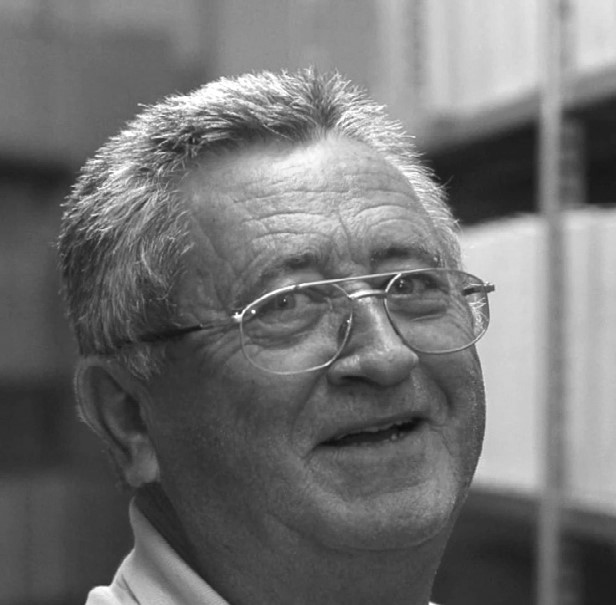 Nem tudom, mûÀsok hogyan vannak ezzel, de az ûˋletemet nûˋhûÀny, egy kûˋzen megszûÀ- molhatû°, olyan ember kûÙsûˋri, akikkel annak idejûˋn, nagyon rûˋgen, megismerkedûˋsû¥nk pillanatûÀban azonnal megtalûÀltuk azt a kûÑzûÑs hangot, ami mintha mûÀr azt megelézéen korûÀbban is meglett volna, csak nem tudtunk rû°la, s barûÀtsûÀggûÀ nemesedve meg is maradt ûˋvtizedeken ûÀt. Eléfordulhat, hogy ûˋvekig nem talûÀlkozunk, de mihelyt ez meg- valû°sul, ugyanû¤gy, ugyanott tudjukô folytatni, akûÀr egyô kûÑzûÑsen ûÀtborozott ûˋjszaka emlûˋkfeszegeté mûÀsnapjûÀn. Vûˋgh LûÀszlû°, de maradjunk csak a Vûˋgh LacinûÀl, vûˋglaci- nûÀl, szûÀmomra ebbe a maroknyi embercsoportba tartozik. Ezûˋrt is jelen kûÑszûÑnté inkûÀbb szemûˋlyes, mint szakmai lesz. Nota bene: honnan is vennûˋm a bûÀtorsûÀgot, hogy egy szociolû°gust, akûÀr dicsûˋrve is, minésûÙtsek, mikûÑzben elsésorban talûÀn nem is, de semmikûˋppen nem kizûÀrû°lagosan szociolû°gussal van dolgunk. De akkor kivel?
Nem tudom, mûÀsok hogyan vannak ezzel, de az ûˋletemet nûˋhûÀny, egy kûˋzen megszûÀ- molhatû°, olyan ember kûÙsûˋri, akikkel annak idejûˋn, nagyon rûˋgen, megismerkedûˋsû¥nk pillanatûÀban azonnal megtalûÀltuk azt a kûÑzûÑs hangot, ami mintha mûÀr azt megelézéen korûÀbban is meglett volna, csak nem tudtunk rû°la, s barûÀtsûÀggûÀ nemesedve meg is maradt ûˋvtizedeken ûÀt. Eléfordulhat, hogy ûˋvekig nem talûÀlkozunk, de mihelyt ez meg- valû°sul, ugyanû¤gy, ugyanott tudjukô folytatni, akûÀr egyô kûÑzûÑsen ûÀtborozott ûˋjszaka emlûˋkfeszegeté mûÀsnapjûÀn. Vûˋgh LûÀszlû°, de maradjunk csak a Vûˋgh LacinûÀl, vûˋglaci- nûÀl, szûÀmomra ebbe a maroknyi embercsoportba tartozik. Ezûˋrt is jelen kûÑszûÑnté inkûÀbb szemûˋlyes, mint szakmai lesz. Nota bene: honnan is vennûˋm a bûÀtorsûÀgot, hogy egy szociolû°gust, akûÀr dicsûˋrve is, minésûÙtsek, mikûÑzben elsésorban talûÀn nem is, de semmikûˋppen nem kizûÀrû°lagosan szociolû°gussal van dolgunk. De akkor kivel?
Annak idejûˋn, 2009-ben, amikor megkapta a MûÀrai AlapûÙtvûÀny Nyitott Eurû°pûÀûˋrt DûÙjûÀt, laudûÀciû°mban azt fejtegettem, hogy vannak egykûÑnyves ûˋs vannak sokkûÑnyves szerzék. HozzûÀtehetjû¥k, jelentettem ki akkor: vannak kûÑnyvtelen szerzék is ã ûˋs Vûˋgh Laci, ha akarom, ezek kûÑzûˋ tartozik. Nem volt (lett) teljesen igazam, hiszen van nûˋhûÀny, ûÀltala jegyzett kûÑtet, ûÀm ezek sû¤lya ahhoz az irdatlan tudûÀs- ûˋs ismeretanyaghoz kûˋpest, ami a fejûˋben van, szinte elhanyagolhatû°. Akkor û¤gy oldottam fûÑl a dilemmûÀt, hogy ha akarom, akûÀr sokkûÑnyves szerzének is titulûÀlhatom. Nûˋzzû¥k diû°hûˋjban pûÀlyûÀja alakulûÀsûÀt, s abbû°l ezek az ûÀllûÙtûÀsaim is megmagyarûÀzhatû°ak.
SûÀrosfûÀn szû¥letett, hogy pontosan mikor, azt kissûˋ szereti homûÀlyba burkolni, talûÀn a szû¥letûˋse idejûˋn vastag hû°takarû°ba burkolt Felsé-Csallû°kûÑz mintûÀjûÀra. Mondjuk ûÙgy, hogy tûˋnylegesen valamikor 1948 decembere vûˋgûˋn lûÀtta meg a napvilûÀgot, anyakûÑny- vezve viszont 1949. januûÀr elejûˋn lett. Mert tûˋnyleg ãnagy hû° volt akkorã, s a legkûÑze- lebbi anyakûÑnyvezûˋsi lehetésûˋg, ahovûÀ ûˋdesapjûÀnak el kellett gyalogolnia, meg NagyszarvûÀn. Kû¥lûÑnben sûÀrosfai szû¥letûˋsûˋre nagyon bû¥szke, s ezt a bû¥szkesûˋgûˋt utû°lag indokolni is tudja Fûˋnyes Elek rûÑvid, ûÀm gyû¥mûÑlcsûÑzé helyi tûˋnykedûˋsûˋre hivatkozva. A somorjai ûˋrettsûˋgi (1967) utûÀn a pozsonyi Comenius Egyetem politolû°giaãszociolû°gia szakûÀn 1972-ben szerzett diplomûÀt, majd nem sokkal utûÀna doktori cûÙmet. A pozsonyi Kultû¤rakutatû° Intûˋzet tudomûÀnyos munkatûÀrsakûˋnt az 1970-es ûˋvekben rûˋszt vett a szlovûÀkiai magyarok méÝvelédûˋsszociolû°giai vizsgûÀlatûÀban, aminek magyarul ûˋs szlovûÀ- kul megjelent tanulmûÀnyai a lenyomatai. 1981ã1990 kûÑzûÑtt a SzlovûÀk KûÑztûÀrsasûÀg KormûÀnyhivatalûÀnak nemzetisûˋgi û¥gyekben illetûˋkes féeléadû°ja, majd 1990-tél 1992- ig (a szintûˋn sûÀrosfai szû¥letûˋséÝ) A. Nagy LûÀszlû°nak, a SzlovûÀk Nemzeti TanûÀcs alelnûÑkûˋ- nek szaktanûÀcsadû°ja. 1993ã1995 kûÑzûÑtt a Csemadok OrszûÀgos VûÀlasztmûÀnyûÀnak fétitkûÀra. ûletûˋnek bûÀrmelyik szakaszûÀt nûˋzzû¥k, azt lûÀtjuk, hogy a szlovûÀkiai magyarsûÀg ûˋletûˋnek sokoldalû¤ megismerûˋsûˋn ûˋs dokumentûÀlûÀsûÀn munkûÀlkodott konok kûÑvetkeze- tessûˋggel. Nem vûˋletlen tehûÀt, hogy a rendszervûÀltûÀs utûÀn a Bibliotheca Hungarica AlapûÙtvûÀny alapûÙtû°ja ûˋs kuratû°riumi tagja (1991). Az alapûÙtvûÀny megszéÝnte û°ta (1997) a Fû°rum Kisebbsûˋgkutatû° Intûˋzet munkatûÀrsa, 2016-ig az intûˋzet kûÑnyvtûÀrakûˋnt méÝkûÑdé Bibliotheca Hungarica, majd a SzlovûÀkiai Magyar LevûˋltûÀr igazgatû°ja. 2006-tû°l az MTA kû¥lsés kûÑztestû¥leti tagja.
Vûˋlemûˋnyem szerint a kûÑzponti magyar kûÑnyv- ûˋs levûˋltûÀr, tehûÀt a somorjai Bib- liotheca Hungarica ûˋs az ehhez kapcsolû°dû° SzlovûÀkiai Magyar LevûˋltûÀr kiûˋpûÙtûˋse, profi mû°don valû° felfejlesztûˋse a fé ûˋrdeme. Mirél is van szû° konkrûˋtan? A szlovûÀkiai magyar ûˋrtelmisûˋg mûÀr a kûˋt vilûÀghûÀborû¤ kûÑzûÑtti idéktél gyakorlatilag folyamatosan arrû°l beszûˋl, hogy az egûˋszsûˋges szellemi (ezen belû¥l tudomûÀnyos) ûˋlet fellendûÙtûˋse ûˋrdekûˋ- ben szû¥ksûˋge van egy kûÑzponti magyar kûÑnyvtûÀrra. 1990-ben nûˋhûÀny lelkes somorjai atyafi (Zalabai Zsigmond, Presinszky Lajos ûˋs nem utolsû°sorban Vûˋgh LûÀszlû°) elhatûÀ- rozta, hogy ûÑnerébél lûˋtrehozza ezt a kûÑnyvtûÀrat. AdomûÀnyokbû°l kezdtûˋk kiûˋpûÙteni ûˋs tartottûÀk fenn az elsé ûˋvekben amolyan méÝkedveléi szinten (ne ûˋrtsûˋk fûˋlre, ez a jelzé nem lebecsû¥lûˋst jelent, hanem csupûÀn a méÝkûÑdûˋsi/méÝkûÑdtetûˋsi formûÀra vonatkozik). Valû°szûÙnéÝleg a sors is û¤gy akarta, hogy Vûˋgh LûÀszlû° ne a Csemadok fétitkûÀrkûˋnt mor- zsolgassa egûˋsz nyugdûÙjba vonulûÀsûÀig napjait, ezûˋrt kûˋt vûˋgûˋrél ûˋgette mûÀr ebben a tisztsûˋgûˋben is a gyertyûÀt. Ennek az lett a kûÑvetkezmûˋnye, hogy egûˋszsûˋgû¥gyi okokbû°l meg kellett vûÀlnia a Csemadoktû°l, ûÀm szinte azonnal belevetette magûÀt a szlovûÀkiai magyar nemzeti(sûˋgi) kûÑnyvtûÀr, a Bibliotheca Hungarica komoly kiûˋpûÙtûˋsûˋbe. MikûÑzben azt a bizonyos gyertyûÀt tovûÀbbra is kûˋt vûˋgûˋrél ûˋgette, gyakorlatilag a Bibliotheca Hun- garicûÀnak ûˋs a Bibliotheca HungaricûÀban ûˋl(t). Csû¤csidében nem volt szû¥ksûˋg szûÀmûÀra kûÑnyvkatalû°gusra: a nem kis ûÀllomûÀny minden egyes darabjûÀt fejben tartotta szûÀmon, szerzét, kûÑnyvcûÙmet kellett neki mondani, s azonnal megindult a polcok kûÑzûÑtt, hogy perceken belû¥l elékerû¥ljûÑn a keresett publikûÀciû°val. Tudatosan, tervezetten, a fejlesz- tûˋst is szem elétt tartva szortûÙrozta a kûÑnyveket. Mûˋg harminc centi kûÑnyvet ûÙrhatsz, mondta nekem sok-sok ûˋvvel ezelétt, s kezûˋvel is mutatta a mûˋretet, amennyi mûˋg û¥re- sen maradt a polcon az Li betéÝkombinûÀciû°nûÀl. MûÀra alighanem betûÑltûÑttem kû¥ldetûˋsemet. Az intûˋzmûˋny pedig valû°ban megkerû¥lhetetlen kutatûÀsi helye lett a szlovûÀkiai magyar tûÑrtûˋnûˋsek irûÀnt ûˋrdeklédé kutatû°knak. A (Cseh)SzlovûÀkiûÀban megjelent magyar nyelvéÝ kûÑnyvek zûÑme birtokûÀban van, de ami a kutatûÀs szûÀmûÀra ennûˋl jû°val fontosabb: egy csomû° irattûÀr (a Csemadok, a magyar pûÀrtok levûˋltûÀra, magûÀnszemûˋ- lyek levelezûˋsei, kûˋziratai stb.), hûÙrlap- ûˋs folyû°irat-, fûˋnykûˋp- ûˋs hangszalaggyéÝjtemûˋny ûÀll a kutatû°k rendelkezûˋsûˋre. A zûÑkkenémentes kutatûÀst megfelelé infrastruktû¤ra, szo- lid kûˋzikûÑnyvtûÀr is segûÙti. Nem tû¤lzok, ha ûÀllûÙtom, az, hogy a Bibliotheca Hungarica ma û¤gy nûˋz ki, ahogy kinûˋz, egyedû¥l Vûˋgh LûÀszlû°nak kûÑszûÑnheté. Ami nem azt jelenti, hogy a szû° szoros ûˋrtelmûˋben egyedû¥l vûˋgzett volna mindent, hanem azt, ami talûÀn mûˋg fon- tosabb az alapûÙtûÀsnûÀl, hogy keresett ûˋs talûÀlt (!) lelkes munkatûÀrsakat, a vezetûˋsben utû°dot, s az ûÀltala pûÀlyûÀra ûÀllûÙtott intûˋzmûˋny méÝkûÑdik, fejlédik.
ûs hûÀt mindezekbél adû°dik, hogy bizony ennyi szervezémunka kûÑzepette igazi sajûÀt méÝvek megûÙrûÀsûÀra ideje bizony csak nagy ritkûÀn akadt. Fontos tanulmûÀnyai jelen- tek meg szaklapokban, gyéÝjtemûˋnyes kûÑtetekben, ûÑsszeûÀllûÙtott, szerkesztett, de igazi ûÑnûÀllû° kûÑtete (tudomûÀsom szerint) a mai napig nincs. Ezûˋrt lehet igaz, hogy Vûˋgh LûÀszlû° kûÑnyvtelen szerzé. Viszont az is igaz, hogy sokkûÑnyves szerzé, hiszen mûÀr a Bibliotheca Hungarica-ûˋra elétt is szûÀmtalan kutatû°t segûÙtett tanûÀcsaival, majd a somorjai kûÑzponti kûÑnyvtûÀr kiûˋpû¥lûˋsûˋvel a tanûÀcsok mellett konkrûˋt adatokkal, kutatûÀsi lehetésûˋgekkel, ûÑtletekkel is. Ily mû°don egy csomû°, mûÀs szerzék ûÀltal jegyzett kûÑnyvûÑn valahol ott van az é keze nyoma is. ûs ez bizonyos szempontbû°l jû°val fontosabb, mint a nûˋvvel jegyzett ûÑnûÀllû° kûÑtetek. Mindamellett kell az ûÑnûÀllû° méÝ is! A szûˋtszû°rtan megjelent tanulmûÀnyai, az ûÀltala adott interjû¤k vaskos kûÑtetet eredmûˋnyeznûˋnek, meg kell ezt csinûÀlni. Ez Neked is, Laci, meg nekû¥nk is feladtunk!
Szemûˋlyisûˋgûˋnek kûÑszûÑnhetéen, hiszen az az embertûÙpus, aki nem tud senkivelô ãrosszban lenniã, mindenkivel megtalûÀlja a hangot, szû°val integratûÙv szemûˋlyisûˋgûˋnek kûÑszûÑnhetéen a somorjai bibliotûˋka rengeteg szlovûÀkiai magyar ûˋrtelmisûˋgi talûÀlkozû°- helye is lett ûˋvtizedeken ûÀt. TudomûÀnyos, méÝvelédûˋsszervezûˋsi ûÑtletek tûÑmkelege szû¥- letett, valû°sult meg Laci szemûˋlyisûˋginek hatû°sugarûÀban. EgyûÀltalûÀn nem tû¤lzok tehûÀt, ha az utû°bbi ûˋvtizedek egyik legjelentésebb szlovûÀkiai magyar kulturûÀlis IntegrûÀtorûÀt lûÀtom benne. Igen, affûˋle szû¥rke eminenciûÀskûˋnt fontos dûÑntûˋsek hûÀtterûˋben volt jelen, azok kidolgozûÀsûÀban oroszlûÀnrûˋszt vûÀllalt, eltûˋré ûÀllûÀspontokat kûÑzelûÙtett, bûˋkûÙtett meg egymûÀssal. KisugûÀrzûÀsa olyan, hogy bûÀrmit megmondhat, bûÀrmilyen kritikai megjegy- zûˋst, azt olyan utûÀnozhatatlan barûÀtsûÀggal, sajûÀtos humorral teszi, hogy egyszeréÝen nem lehet miatta megsûˋrtédni, haragudni rûÀ. Szû°ba hozhatnûˋk most itt sok mindent, amit csak Laci mondhat ki, hiszen mindenki, de tûˋnyleg mindenki tudja, hogy nincs mûÑgûÑtte bûÀntû° szûÀndûˋk. Ahogy kûÑnyvtûÀrigazgatû°kûˋnt hangoztatott hûÙres bonmot-ja (ami persze vûÀndormotûÙvum*), miszerint kûˋt dolgot utûÀl tiszta szûÙvbél: a kûÑnyveket ûˋs a kutatû°kat (olvasû°kat). Ez a mondat leûÙrva enyhûˋn szû°lva is meghûÑkkentének, sét botrûÀnyos- nak téÝnik, de ahogy Laci ezt kimondja, minden ûˋlûˋt elveszûÙti. PlûÀne mivel, aki ismeri, tudja, mi mindent tett, tesz, megtenne a KûÑnyvtûÀrûˋrt, a kûÑnyvekûˋrt. Vendûˋgsûˋgben, bûÀr- hol, bûÀrmikor kûÑnyvespolcot lûÀtva a jelenlûˋvékre fittyet hûÀnyva azonnal elmerû¥l a gerin- cek vizslatûÀsûÀban, majd nonchalance kûÑzvetlensûˋggel kûÑzûÑli a hûÀzigazdûÀval, hogy ezekrél majd az ûÑzvegyeddel fogok tûÀrgyalni. S hogy az olvasû°kûˋrt, kutatû°kûˋrt (egyete- mistûÀktû°l kezdve az akadûˋmikusokig) mi mindent megtett, megtesz, arrû°l ûˋppen ék tud- nûÀnak a legtûÑbbet mesûˋlniãÎ
Meg ûˋn is, de terem vûˋges, itt ûˋs most legyen elûˋg ennyi. Isten ûˋltessen sokûÀig, kedves Laci, erében, egûˋszsûˋgben, hogy sokûÀig legyûˋl mûˋg a Fû°rumban ûˋs azon kûÙvû¥l is igazodûÀsi pontunk. S most fûÑlûÀllok, kinyitok egy û¥veg szûÀraz, kûÑbûÑlkû¤ti fehûˋr bort, alighanem rajnai rizlinget, HalûÀsz Robi pincûˋszetûˋbél, s megiszok egy pohûÀrral az egûˋszsûˋgedreãÎ
Liszka Jû°zsef
* VûÑ. a szûÙnûˋsz a szûÙnhûÀzat ûˋs a kûÑzûÑnsûˋget, a pedagû°gus az iskolûÀt ûˋs a gyerekeket stb. utûÀlja.
Durst JuditãNyûÙré ZsannaãBeremûˋnyi ûbel (szerk.): A tûÀrsadalmi mobilitûÀs ûÀra. Elsé generûÀciû°s diplomûÀsok ûˋs az osztûÀlyvûÀltûÀs kûÑvetkezmûˋnyei. Budapest, Gondolat Kiadû°ãTûÀrsaô˜dalomtudomûÀnyi Kutatû°kûÑzpont, 2022, 454 p.
Izgalmas, sokrûˋtéÝ kûÑtet jelent meg 2023-ban a Gondolat Kiadû° ûˋs a TûÀrsadalomtudomûÀnyi Kutatû°kûÑzpont gondozûÀsûÀban, amely a tûÀrsadalmi mobilitûÀs ûÀrûÀval foglalkozik, ûˋs amely egy hûÀromûˋves kutatûÀsi projekt ûÑsszegzûˋsekûˋnt ûˋrtelmezendé. A tûˋma tudomûÀnyos kibeszûˋletlensûˋgûˋt ûˋs aktualitûÀsûÀt talûÀn az is szemlûˋlteti, hogy a budapesti HûÀrom Hollû°ban 2023. szeptember 25-ûˋn szervezett kûÑnyvbemutatû°n a lûˋpcsén is û¥ltek az emberek, a szervezék ûˋs a megszû°lalû°k pedig hangot is adtak meglepettsûˋgû¥knek, amit a nagy ûˋrdeklédûˋs vûÀltott ki belélû¥k. Maga a kûÑtet nem hibûÀtlan, szûÀmos kûˋrdûˋst ûˋs problûˋmafelvetûˋst hagy maga utûÀn, hiszen az ilyen kutatûÀsok soha nem egy tûˋma lezûÀrûÀsakûˋnt, sokkal inkûÀbb vitaindûÙtû°kûˋnt ûˋs tovûÀbbi kutatûÀsok motivûÀciû°jakûˋnt is ûˋrtelmezhetéek. A tanulmûÀnyokban felvetett tûˋmûÀk, a bevezetett nyelvhasznûÀlat mindenkûˋppen hiûÀnypû°tlû°ak a magyar nyelvéÝ tûÀrsadalomtudomûÀnyos kûÑzegben, ûˋs fontos lûˋpûˋseket jelentenek az elsé generûÀciû°s ûˋrtelmisûˋgiekkel, a tûÀrsadalmi mobilitûÀssal ûˋs tûÀrsadalmi reprodukciû°val kapcsolatos kutatûÀsokban.
A kûÑtet cûÙme ûˋs alcûÙme sem utal etnikai meghatûÀrozottsûÀgra, azaz nincs explicit utalûÀs arra nûˋzve, hogy a kutatûÀs elsésorban az elsé generûÀciû°s roma ûˋrtelmisûˋgiek, tehûÀt egy, a tûÑbbsûˋgi tûÀrsadalom ûÀltal rasszizûÀlt kisebbsûˋg tagjainak mobilitûÀstûÑrtûˋneteivel foglalkozott volna. A kutatûÀsban valû°ban rûˋszt vettek a tûÑbbsûˋgi tûÀrsadalom ûˋs magukat romakûˋnt identifikûÀlû°k tagjai is, ehhez kûˋpest a kûÑtet tanulmûÀnyai jelentés rûˋszben a romakûˋnt megûˋlt mobilitûÀssal foglalkoznak. Felmerû¥lhet a kûˋrdûˋs, hogy a kutatûÀst ûˋs a rû°la szû°lû° kûÑnyvet miûˋrt nem kategorizûÀltûÀk mûÀskûˋppen, azaz miûˋrt nincs nyûÙlt utalûÀs arra, hogy ez egy romûÀkkal kapcsolatos vizsgûÀlat volt? A vûÀlasz ott keresendé, hogy a kutatû°k ûÀltal alkalmazott hû°labda mû°dszer, a kûÑzûÑssûˋgi mûˋdiûÀban terjesztett felhûÙvûÀsok ûˋs online kûˋrdéûÙvek vûˋletlenszeréÝen talûÀltûÀk meg a tûÑbbsûˋgi tûÀrsadalom tagjait ûˋs a romûÀkat, ûˋs az, hogy tûÑbb volt a roma vûÀlaszadû° ûˋs interjû¤alany, minden bizonnyal azt jelenti, hogy tûÑbbsûˋgûˋben éket ûˋrinti az elsé generûÀciû°s ûˋrtelmisûˋgi ûˋletû¤t megûˋlûˋse (illetve vûˋlhetéen rûÀjuk jellemzébb a vûÀlaszadûÀsi hajlandû°sûÀg).
A kûÑnyv szûÀmos ponton kiemeli, hogy a kutatûÀs nem volt reprezentatûÙv: nem a szûÀmbeli reprezentativitûÀsra, inkûÀbb a kvalitatûÙv megûˋrtûˋsre tûÑrekedtek. A kvalitatûÙv ûˋrtelemadûÀsnak azonban gûÀtat szabnak pûˋldûÀul az olyan tûˋnyezék, mint hogy a kûÑzûˋposztûÀlybeli integrûÀciû° vûˋgett a roma identitûÀsukat teljesen hûÀtrahagyû°k (azaz pont azok, akik az identitûÀs ûˋs a magûÀnûˋlet szempontjûÀbû°l biztosan magas ûÀrat fizettek a mobilitûÀsukûˋrt) jellemzéen nem jelentkeztek ezekre a felhûÙvûÀsokra. A szûÑvegek ezt a hiûÀnyt û¤gy igyekeznek pû°tolni, hogy felhûÙvjûÀk az olvasû° figyelmûˋt az esetleges hiûÀnyossûÀgokra.
A kutatûÀs tehûÀt nem a szûÀmmal mûˋrheté tûÀrsadalmi mobilitûÀs mûˋrtûˋkûˋnek bemutatûÀsûÀra tûÑrekedett, hanem arra, hogy kvalitatûÙv mû°dszertannal, esettanulmûÀny jelleggel mutassa meg a mobilitûÀstûÑrtûˋnetek szemûˋlyes megûˋlûˋsûˋt, ûˋs hogy a 165 narratûÙv, fûˋlig strukturûÀlt mûˋlyinterjû¤ ûˋrzûˋkeny elemzûˋsûˋvel megtalûÀlja (vagy inkûÀbb: birtokba ûˋs hasznûÀlatba vegye) azt a tûÀrsadalomtudomûÀnyos nyelvezetet, amely segûÙtsûˋgûˋvel az elsé generûÀciû°sok tapasztalata elbeszûˋlhetévûˋ vûÀlik. A kûÑtet tanulmûÀnyai iskolapûˋldûÀi annak, hogy a kvalitatûÙv kutatûÀsok mikûˋnt egûˋszûÙthetik ki a kvantitatûÙv szemlûˋletéÝeket: a tûÀrsadalmi mobilitûÀs pusztûÀn szûÀmokkal bemutatott mûˋrtûˋke, amint ez a kûÑtet budapesti bemutatû°jûÀn tûÑbbszûÑr elhangzott, egyfajta ãkegyetlen optimizmustã sugall, amely vak marad azokra az ûˋrzelmi-mentûÀlis terhekre, ûˋletû¤t- ûˋs identitûÀsdilemmûÀkra, amelyeket a tûÀrsadalmi mobilitûÀs ûÀrakûˋnt kûÑnyvelhetû¥nk el. Hogy ezt az ûÀrat nem mindenki egyformûÀn fizeti meg, a projektben rûˋszt vevé kutatû°k is tudatosûÙtottûÀk: a kûÑteten vûˋgigvonul a szemlûˋlet, mely szerint az etnikai elkû¥lûÑnû¥lûˋs lûÀthatû° antropolû°giai jegyeit magukon viselé, a tûÑbbsûˋgi tûÀrsadalom ûÀltal rasszizûÀlt kisebbsûˋgek ã esetû¥nkben a romûÀk ã hatalmas ûÀrat kûˋnytelenek fizetni egyrûˋszt a sajûÀt felfelûˋ mobilitûÀsukûˋrt, mûÀsrûˋszt az û¤j ûˋletkûÑrû¥lmûˋnyeik fenntartûÀsûÀûˋrt. A mobilitûÀs ûÀrûÀt ugyanis jelentésen nûÑveli, hogy az elsé generûÀciû°s romûÀk nemcsak osztûÀlyt ugranak, hanem jellemzéen etnikai kûÑzeget is vûÀltanak: az ûˋrtelmisûˋgi mezébe valû° belûˋpûˋs ugyanis a fehûˋr kûÑzûˋposztûÀly vilûÀgûÀba, szokûÀsrendszereibe valû° integrûÀciû° kûÑvetelmûˋnyûˋt jelenti.
A kûÑtet sok fontos megûÀllapûÙtûÀsa ennek az integrûÀciû°nak a folyamatûÀval ûˋs buktatû°ival/seôÙgûÙtéivel foglalkozik. A szûÑvegek olvasûÀsa egy tûÑbbgenerûÀciû°s ûˋrtelmisûˋgi esetûˋben egy szûÀmûÀra valû°szûÙnéÝleg ismeretlen vilûÀgba ûˋs ûˋrzûˋsvilûÀgba enged betekintûˋst, mûÙg az elsé generûÀciû°sok szûÀmûÀra, etnicitûÀstû°l fû¥ggetlenû¥l revelûÀciû° ûˋrtûˋkéÝ lehet: segûÙthet felismerni azokat a folyamatosan û¤jratermelédé struktû¤rûÀkat, amelyek meghatûÀrozzûÀk az elsé generûÀciû°sok tapasztalatait. Azaz bemutatjûÀk az egyûˋni tûÑrtûˋnetek rendszerszintéÝ beûÀgyazottsûÀgûÀt, az ismûˋtlédé motûÙvumokat, ezzel pedig sokszorosan szûÀmolnak le a meritokrûÀcia mûÙtoszûÀval, tehûÀt azzal a tûˋvhittel, mely szerint a neoliberûÀlis demokrûÀcia keretei kûÑzûÑtt minden esetben az egyûˋni ûˋrdemek (szorgalom, kitartûÀs, motivûÀciû°) hatûÀrozzûÀk meg az elérejutûÀst, tehûÀt a tûÀrsadalmi mobilitûÀs mûˋrtûˋkûˋt, tempû°jûÀt, minésûˋgûˋt. Az interjû¤k elemzûˋse sorûÀn a szerzék ûˋrzûˋkenyen hûÙvjûÀk fel a figyelmet azokra a pontokra, amikor az interjû¤alany kizûÀrû°lag sajûÀt ûˋrdemeinek tudja be az elébbrejutûÀsûÀt (ezzel kûÑnnyûÙtve azt a terhet, amit a ãvisszaadûÀs terhekûˋntã fogalmaztak meg a kutatû°k), azonban ezekben a tûÑrtûˋnetekben is minden esetben ott vannak az oktatûÀsi tûÀmogatû° programok, a kû¥lûÑnbûÑzé ûÑsztûÑndûÙjak, tûÀmogatû° csalûÀdtagok, pedagû°gusok ûˋs mecûˋnûÀsok, akik hozzûÀjûÀrultak az egyûˋn elébbrejutûÀsûÀhoz. Ehhez a megûÀllapûÙtûÀshoz kapcsolû°dik a kutatûÀs egyik legfontosabb kûÑvetkeztetûˋse is, nevezetesen, hogy a tûÀrsadalmi mobilitûÀs elsésorban azoknak vûÀlik elûˋrhetévûˋ, akik a fenti tûÀmogatû° hûÀlû° nûˋhûÀny elemûˋvel talûÀlkoznak a kritikus ûˋletszakaszokban. Ezek hiûÀnya mellett a tûÀrsadalmi mobilitûÀs hozzûÀfûˋrhetetlen marad, tehûÀt ûˋpp azokat nem ûˋri el, akiknek a legnagyobb szû¥ksûˋge lenne rûÀ (azaz a szegregûÀlt kûÑrû¥lmûˋnyek kûÑzûÑtt ûˋléket, a csalûÀdi tûÀmogatûÀst mellézéeket).
A 454 oldalas kûÑtet hosszû¤ felvezetével indul. A Bevezeté elétt egy szerkesztéi elészû° ûˋs egy, a kûÑtet nyelvhasznûÀlatûÀrû°l szû°lû° rûÑvid szûÑveg vezeti be a kûÑnyv ûˋs a mûÑgûÑtte ûÀllû° kutatûÀsok legfontosabb szemlûˋlet- ûˋs fogalomhasznûÀlatbeli sajûÀtossûÀgait. A szerkesztéi elészû° vegyesen elevenûÙt fel meghatûÀrozû°, a tûˋmûÀba vûÀgû° irodalmi vonatkozûÀsû¤ szûÑvegeket (Borbûˋly SzilûÀrd sokszor idûˋzett ûˋs megrûÀzû°, Az elveszett nyelv cûÙméÝ, 2013-as szûÑvegûˋt, amelyet az elészû° tûˋvesen KulturûÀlis migrûÀns cûÙméÝ cikkûˋnt jegyez; valamint Milbacher Rû°bert 2020-as, A kulturûÀlis migrûÀns cûÙméÝ cikkûˋt), Bourdieu-nek a testiesû¥lt kulturûÀlis tékûˋrél szû°lû° elmûˋletûˋvel, amelynek lûˋnyege, hogy a kulturûÀlis téke bizonyos formûÀi tulajdonkûˋppen elsajûÀtûÙthatatlanok, ûˋs azok kivûÀltsûÀgai maradnak, akik beleszû¥letnek egy olyan kûÑrnyezetbe, amely eleve birtokolja ezeket a tékûˋket.
A kutatûÀs eredmûˋnyeinek fûˋnyûˋben a kutatû°k a tûÀrsadalmi mobilitûÀssal jûÀrû° osztûÀlyvûÀltûÀst egy sajûÀtos problûˋmahalmazkûˋnt ûˋrtelmezik, melynek egyebek kûÑzûÑtt rûˋsze a tûÀrsadalmilag mobil egyûˋneket jellemzé kisebbsûˋgi ûˋrzûˋs, imposztorszindrû°ma, megfelelûˋsi ûˋs tû¤lteljesûÙtûˋsi kûˋnyszer, tû¤lzott szorgalmassûÀg, ûˋs az igyekezet, hogy elsajûÀtûÙtsanak egy olyan viselkedûˋsi kû°drendszert, amely a tûÑbbgenerûÀciû°s ûˋrtelmisûˋgi csalûÀdban szocializûÀlû°dû°k szûÀmûÀra magûÀtû°l ûˋrtetédé. Szintûˋn a kutatûÀsbû°l leszéÝrt kûÑvetkeztetûˋs, hogy ez a fajta szorongûÀs ûˋs megkû¥zdûˋs elsésorban a tûÀrsadalomtudomûÀnyi ûˋs a kulturûÀlis/bûÑlcsûˋsz ûˋrtelmisûˋgre jellemzé, amely rûÀadûÀsul folyamatosan reflektûÀl ãsajûÀt kulturûÀlis otthontalansûÀgûÀraã ã szemben pûˋldûÀul a gazdasûÀgi vagy méÝszaki elsé generûÀciû°s elittel, amely lûÀthatû°an sokkal jobban boldogul û¤j kûÑzegûˋben (9. p.).
A kutatûÀs, ahogy a kûÑtet cûÙme ezt ki is jelûÑli, elsésorban a tûÀrsadalmi mobilitûÀs kû¥lûÑnbûÑzé tûÙpusû¤ ûÀraival foglalkozik, azonban az elészû° figyelmeztet, hogy a tûÀrsadalmi mobilitûÀsnak nem csak ûÀra, hanem û¥vegplafonja is van, ami azt jelenti, hogy egy sikeresnek mondhatû° mobilitûÀsi pûÀlya sem jelent automatikus belûˋpét bizonyos elit ûÀllûÀsokba. Bizonyos pozûÙciû°k a tûÑbbgenerûÀciû°s elitek kivûÀltsûÀgai maradnak, ûˋs nagyon alacsony azok szûÀma, akik ide kûÙvû¥lrél be tudnak lûˋpni, vagy akik a megszerzett pozûÙciû°ban meg is tudnak maradni (10. p.). A kûÑtet tanulmûÀnyaiban idûˋzett interjû¤rûˋszletek illusztrûÀljûÀk is ezen elmûˋleti ûÀllûÙtûÀsokat: pûˋldûÀul a tûÑbbsûˋgi tûÀrsadalomhoz tartozû° né, aki a PhD megszerzûˋse utûÀn otthagyta egyetemi adjunktusi munkûÀjûÀt, mert û¤gy ûˋrezte, hogy tû¤l nagyot lûˋpett elére, ûˋs az akadûˋmiai kûÑzeg struktû¤rûÀja ûˋs viselkedûˋsi rendszere tû¤l sok szorongûÀst okozott neki (120. p.).
Amint az elészû° kiemeli, a kûÑtet fészûÑvegei a fentiekhez hasonlû° osztûÀlyvûÀltû°k mobilitûÀsi û¤tjainak szisztematikus elemzûˋsûˋt téÝztûˋk ki cûˋlul, mindezt egy nemzetkûÑzi elmûˋleti ûˋs empirikus keretbe ûÀgyazva, amely megkûÑzelûÙtûˋs sok ponton nyû¤jt ûˋrdekes ûˋszrevûˋteleket a hasonlû°sûÀgok ûˋs kû¥lûÑnbsûˋgek ûˋrzûˋkeltetûˋsûˋvel (10. p.). Az elészû° ãegymûÀsra reflektûÀlû°, egymûÀst kiegûˋszûÙtéã tanulmûÀnykûˋnt hivatkozik a kûÑtet szûÑvegeire, ami nagyrûˋszt igaz, meg kell azonban jegyezni, hogy bizonyos szûÑvegrûˋszek nûˋha szinte szû° szerint ismûˋtlédnek szûÑveghelyrél szûÑveghelyre; elsésorban azokra a szûÑvegrûˋszekre kell gondolni, amelyek a kivûÀlasztott elmûˋleti ûˋs fogalmi keretet ismertetik. ûgy tûÑbbszûÑr is leûÙrûÀsra kerû¥lt a meritokrûÀcia mûÙtosza ûˋs annak jelentûˋse, a rasszizûÀlt û¥vegplafon ûˋs a rasszizûÀlt kisebbsûˋg fogalmai, az interszekcionalitûÀs elmûˋlete, amely egyûˋbkûˋnt az egyes kutatûÀsoknak valû°ban meghatûÀrozû° eleme. Az interszekcionûÀlis szemlûˋletmû°d alapjûÀn a tûÀrsadalmi mobilitûÀst nemcsak a tûÀrsadalmi osztûÀlyvûÀltûÀs felél kûÑzelûÙtik meg a kutatû°k, hasonlû°an figyelnek az etnicitûÀs ûˋs a tûÀrsadalmi nem dimenziû°ira is ã azaz, hogy e tûˋnyezék hogyan jelennek meg, hogyan dinamizûÀljûÀk egymûÀst, ûˋs milyen hatûÀssal vannak az egyes mobilitûÀstûÑrtûˋnetekre, ûˋs milyen strukturûÀlis sajûÀtossûÀgokrû°l, jellemzéen strukturûÀlis egyenlétlensûˋgekrél beszûˋlnek.
Az, hogy a fent emlûÙtett szûÑveghelyek tûÑbbszûÑr megismûˋtlédnek a kûÑtetben, zavarja a folyamatos olvasûÀst, bûÀr nûˋmileg indokolhatû° olyan szempontbû°l, hogy ûÙgy az egyes szûÑvegek ûÑnmagukban is megûÀlljûÀk a helyû¥ket, tehûÀt ha egy olvasû° csak egy-egy szûÑveget szeretne elolvasni, akkor is maradûˋktalanul kûˋpbe kerû¥lhet a kutatûÀst meghatûÀrozû° elmûˋleti alapûÀllûÀsokkal. MûÀskû¥lûÑnben a szûÑvegek tartalma, az interjû¤k elemzûˋseire ûˋpû¥lé, sajûÀt nûˋzépontû¤ tanulmûÀnyok valû°ban kiegûˋszûÙtik egymûÀst ûˋs egymûÀsra ûˋpû¥lnek.
RûÑvid, de meghatûÀrozû° a kûÑtet nyelvhasznûÀlatûÀrû°l szû°lû° ûÙrûÀs, amely a romûÀkat ûˋrinté tûÀrsadalomtudomûÀnyi nyelvkûˋszletrél szû°l. Amint a szûÑveg (nem megnevezett) szerzéje ûÙrja, a tûÀrsadalomtudomûÀnyi nyelvhasznûÀlatban rejtett struktû¤rûÀk, az elnyomûÀs rendszerei ûÑlthetnek alakot, ezek reflektûÀlatlan hasznûÀlata pedig û¤jratermeli az egyenlétlensûˋgeket, a mûÀr meghaladott nûˋzépontokat. A korûÀbbi magyarorszûÀgi demogrûÀfiai ûˋs szociolû°giai nyelvhasznûÀlat a romûÀkat nemzetisûˋgkûˋnt vagy etnikumkûˋnt kategorizûÀlta (erre kûÑnnyen rezonûÀlhat a szlovûÀkiai magyar kategorizûÀciû° tûÑrtûˋnetisûˋgûˋt ismeré kutatû°, ha arra gondolunk, hogy a szocialista CsehszlovûÀkiûÀban milyen jelentûˋse volt a magyar kisebbsûˋg nemzetisûˋgkûˋnt valû° megnevezûˋsûˋnek, ûˋs a kisebbsûˋg szû° tiltûÀsûÀnak ã ennek lûˋnyege az volt, hogy a csehszlovûÀkiai kisebbsûˋg ne politikai kûÑzûÑssûˋgkûˋnt kategorizûÀlja magûÀt, hanem kizûÀrû°lag kulturûÀlis kûÑzûÑssûˋgkûˋnt gondoljon magûÀra).
A kutatû°k a roma interjû¤alanyokkal kapcsolatos elemzûˋseikben a rasszizûÀlt kisebbsûˋg fogalmûÀt tartjûÀk ideûÀlisnak, ugyanis û¤gy vûˋlik, hogy ez a fogalom magûÀba foglalja azokat az elnyomû° gazdasûÀgi, politikai, tûÀrsadalmi struktû¤rûÀkat, amely a romûÀkat vûˋlt szûÀrmazûÀsuk vagy bérszûÙnû¥k alapjûÀn diszkriminûÀlja ûˋs stigmatizûÀlja. Hasonlû°kûˋppen a rasszizûÀlt û¥vegplafon azokat a rejtett strukturûÀlis akadûÀlyokat hivatott nyelvileg megjelenûÙteni, amelyekkel a rasszizûÀlt kisebbsûˋg tagjai talûÀlkoznak mobilitûÀsi pûÀlyûÀjuk sorûÀn (14. p.).
A kûÑtet elsé tanulmûÀnya (Durst JuditãNyûÙré ZsannaãBeremûˋnyi ûbel: Bevezeté. Egyûˋni siker, kollektûÙv kudarc: elsé generûÀciû°s diplomûÀsok ûˋs a tûÀrsadalmi mobilitûÀs kegyetlen optimizmusa) lûˋnyegûˋben folytatja a kutatûÀs hûÀtterûˋt adû° elmûˋleti ûˋs nûˋzépontbeli hûÀlû° felvûÀzolûÀsûÀt. A kutatûÀsok az oktatûÀson keresztû¥l megvalû°sulû° mobilitûÀssal foglalkoztak, e szûÑveg pedig vilûÀgosan kifejti a tûÀrsadalmi mobilitûÀs oktatûÀsba vetett hitûˋnek hamissûÀgûÀt, azaz azt a tûˋvhitet, hogy az oktatûÀs ûÀltali elébbre jutûÀs feloldja a tûÀrsadalmi egyenlétlensûˋgek bonyolult rendszerûˋt. A szûÑveg ezen pontjûÀn kissûˋ esetlenû¥l ûber MûÀrk ûron ûˋs Rû°bert Pûˋter 2022-es, az Intersections folyû°irat TûÀrsadalmi mobilitûÀs cûÙméÝ lapszûÀmûÀnak bemutatû°jûÀn elhangzott szû°beli hozzûÀszû°lûÀsûÀra hivatkozik, amikor azt ûÙrja, hogy a fenti szemlûˋletmû°d (azaz az oktatûÀs ûÀltali mobilitûÀs nem valû°di mobilitûÀskûˋnt valû° ûˋrtelmezûˋse) szerint a tûÀrsadalmi mobilitûÀs ûÀrûÀnak kutatûÀsa lûˋnyegûˋben ãnem mûÀs, mint a tûÀrsadalmi egyenlétlensûˋgek û¤jratermelédûˋse, azaz a tûÀrsadalmi reprodukciû° vizsgûÀlatûÀnak egyik vûÀltozataã (18. p.). ûrdekes, hogy a szûÑveg nem idûˋzi ûbernek a tûˋmûÀban ûÙrt szûÑvegeit, elsésorban a 2020-ban megjelent, A csepp. A fûˋlperifûˋriûÀs magyar tûÀrsadalom osztûÀlyszerkezete cûÙméÝ kûÑnyvûˋt.
A szû°beli hozzûÀszû°lûÀs hivatkozûÀsa utûÀn a kûÑtetben egyetlen szûÑveg kivûˋtelûˋvel lûˋnyegûˋben reflektûÀlatlanul hasznûÀljûÀk a kûÑzûˋposztûÀly fogalmûÀt, illetve a kûÑzûˋposztûÀlyba valû° belûˋpûˋs jelensûˋgûˋt, bûÀr tûˋny, hogy tûÑbbszûÑr emlûÙtik, hogy az oktatûÀs ûÀltal elûˋrt mobilitûÀs ûˋs az ûˋrtelmisûˋgi munkakûÑr betûÑltûˋse nem minden esetben jûÀr egyû¥tt a kûÑzûˋposztûÀllyal azonosûÙtott jûÑvedelmi helyzettel, a megtakarûÙtûÀsok meglûˋtûˋvel ûˋs egyûÀltalûÀn, a kûÑzûˋposztûÀlyi ûˋletmû°ddal. Ezt a hiûÀnyt Dûˋs Fanni ãNagyon nehûˋz a rendszert hibûÀztatni, amikor ott van elétted egy ember, aki ugyanannak a rendszernek a termûˋke, de szemben ûÀlltok egymûÀssalã. A tûÀrsadalmi mobilitûÀs kûÑltsûˋgei a pûÀrkapcsolatok kontextusûÀban cûÙméÝ szûÑvege pû°tolja, amelyben idûˋzi ûber ûˋs HuszûÀrãBerger azon megûÀllapûÙtûÀsait, miszerint ãMagyarorszûÀgon ã az orszûÀgnak a regionûÀlis ûˋs a globûÀlis gazdasûÀgban elfoglalt fûˋlperifûˋriûÀs helyzetûˋbél adû°dû°an ã nem lûˋtezik olyan jû°l kûÑrû¥lûÙrhatû° kûÑzûˋposztûÀly, mint a centrumorszûÀgokban, ahol megvan a gazdasûÀgi bûÀzis egy szûˋles kûÑzûˋprûˋteg szûÀmûÀraã. ûber elemzûˋseiben a helyi kûÑzûˋposztûÀlyt ezûˋrt nevezi inkûÀbb ãkûÑzvetûÙté osztûÀlynakã, amely fogalom kifejezi, hogy egy, az alsû° ûˋs a felsé osztûÀly kûÑzûÑtt elhelyezkedé rûˋtegrél van szû°, amely azonban mûˋgsem azonosûÙthatû° a kûÑzûˋposztûÀllyal (313. p.).
A bevezeté tovûÀbbûÀ hangsû¤lyozza, hogy a tûÀrsadalmi mobilitûÀs kvalitatûÙv megkûÑzelûÙtûˋséÝ kutatûÀsa Bourdieu analitikai ûˋs mû°dszertani eszkûÑztûÀrûÀt alkalmazza, a habitussal kapcsolatos elmûˋletek ugyanis ûÑsszekûÑtik az egyûˋni ûˋs strukturûÀlis szinteket, ûˋrzûˋkenyek az idébelisûˋgre, ûˋs figyelembe veszik a vûÀltozatos tékefelhalmozûÀsokat ûˋs azok hatûÀsûÀt (27. p.).
Mivel a kutatûÀsok az oktatûÀson keresztû¥l megvalû°sulû° mobilitûÀssal foglalkoztak, ezûˋrt fontos rûˋsze a kûÑtetnek Zolnay JûÀnosnak a magyar kûÑzoktatûÀs tûÑrtûˋnetûˋt ûÑsszefoglalû°, a kûÑnyvben olvashatû° mobilitûÀsi tûÑrtûˋnetek hûÀtterûˋt adû° tanulmûÀnya (Esûˋlyteremtûˋs ûˋs kirekesztûˋs. A kûÑzoktatûÀs-politikai vûÀltozûÀsok mint a tûÀrsadalmi mobilitûÀs keretrendszere). A fejezet korszakolû°s lebontûÀsban kûÑveti vûˋgig a magyarorszûÀgi kûÑzoktatûÀs-politika elmû¤lt ûˋvtizedeinek tûÑrtûˋnetûˋt, arra fû°kuszûÀlva, hogy az egyes tûÑrvûˋnyek ûˋs intûˋzkedûˋsek milyen mobilitûÀsi ûˋs integrûÀciû°s esûˋlyeket teremtettek az alsû°bb osztûÀlybû°l szûÀrmazû° hallgatû°knak, hangsû¤lyosan a roma diûÀkoknak. Az elemzûˋs megmutatja, hogy a szocializmus alatt ûˋs a rendszervûÀltûÀst kûÑveté ûˋvtizedekben is voltak kirekeszté, ugyanakkor esûˋlyteremté intûˋzkedûˋsek is, ezekhez kûˋpest pedig jelentés vûÀltozûÀst mutat a 2011-es oktatûÀspolitikai fordulat, amely ûÀtjûÀrhatatlannûÀ teszi a tûÀrsadalmi osztûÀlyokat, esetlegessûˋ tûˋve a legszegûˋnyebbek mobilitûÀsi pûÀlyûÀit.
1985 ûˋs 1993 kûÑzûÑtt a magyarorszûÀgi iskolarendszer a fejlett vilûÀg egyik leginkûÀbb szelektûÙvebb ûˋs egyenlétlenebb szisztûˋmûÀja volt, Zolnay ugyanakkor felhûÙvja a figyelmet, hogy a korszakban szintûˋn jellemzé kûÑzûˋpiskolai ûˋs féiskolai expanziû°, valamint a tankûÑtelezettsûˋgi korhatûÀr felemelûˋse nagyon jelentés pû°tlû°lagos esûˋlyeket teremtett a legrosszabb helyzetéÝ csalûÀdok szûÀmûÀra (54. p.). Jelentés fordulû°pontnak tekintheté az elsé PISA-jelentûˋs 2000-bél, amely a korszakban na!gy megdûÑbbenûˋst keltett ûˋs felhûÙvta a figyelmet a szûˋlsésûˋges szelektivitûÀs ûˋs az esûˋlyteremtûˋs kettéssûˋgûˋre, a ketté kûÑzûÑtti feszû¥ltsûˋgekre (75. p.). A felmûˋrûˋs egyik fontos eredmûˋnye kimutatta, hogy hatalmas a diûÀkok teljesûÙtmûˋnye kûÑzûÑtti eltûˋrûˋs: a jû°l teljesûÙték a skandinûÀv orszûÀgok diûÀkjaival azonos eredmûˋnyeket ûˋrnek el, a rosszul teljesûÙték pedig a harmadik vilûÀgbeli orszûÀgok ûÀtlagûÀhoz hasonlû° eredmûˋnyt hoztak (76. p.). A PISA-felmûˋrûˋs utûÀn oktatûÀspolitikai korrekciû° kûÑvetkezett, amelynek kûÑvetkeztûˋben az etnikai szegregûÀciû° 2006 ûˋs 2008 kûÑzûÑtt csûÑkkent, majd ûˋvekig stagnûÀlt (80. p.).
Zolnay a 2011-es oktatûÀspolitikai fordulatot drasztikus kirekeszté fordulatnak nevezi, megmutatva fontos elemeit: azaz a kûÑzponti kûÑzûˋpfokû¤ keretszûÀm-gazdûÀlkodûÀs 1990 elétti rendszerûˋnek visszaûÀllûÙtûÀsûÀt, a gimnûÀziumokba valû° bejutûÀs megnehezûÙtûˋsûˋt, a tankûÑtelezettsûˋgi korhatûÀr csûÑkkentûˋsûˋt 16 ûˋvre, a nûˋgyûˋves szakiskolai kûˋpzûˋs hûÀromûˋvesre redukûÀlûÀsûÀt ûˋs kedvezétlen ûÀtalakûÙtûÀsûÀt. A vûÀltozûÀsokat a szerzé û¤gy ûˋrtelmezi, mint az esûˋlykiegyenlûÙté rendszerkorrekciû°s kûÙsûˋrlettel valû° szakûÙtûÀst, a vilûÀgnûˋzeti egyûÑntetéÝsûˋgre valû° tûÑrekvûˋst (elsésorban a tanszabadsûÀg ûˋs a korûÀbbi tankûÑnyvpiac felszûÀmolûÀsa ûÀltal), a tûÀrsadalmi problûˋmûÀk etnicizûÀlû° elbeszûˋlûˋsûˋre valû° hajlam û¤jbû°li megjelenûˋsûˋt, az iskolai szegregûÀciû° tûÑbbûˋ-kevûˋsbûˋ nyûÙlt tûÀmogatûÀsûÀt. Zolnay megûÀllapûÙtja, hogy a fentiek kûÑvetkeztûˋben kimutathatû°an ismûˋt nûÑvekedûˋsnek indult a korai iskolaelhagyû°k szûÀma (81ã82. p.).
A kûÑtet kûÑvetkezé fejezetûˋt (RasszizûÀlûÀs mindenek felett. Az oktatûÀsi mobilitûÀs hatûÀsa a habitusra) NyûÙré Zsanna ûˋs Durst Judit jegyzik. A tanulmûÀny azt prû°bûÀlja megragadni, hogy a tûÀrsadalmi vilûÀgok kûÑzûÑtti mozgûÀs mikûˋnt befolyûÀsolja az egyûˋn habitusûÀt, ûˋs milyen tûˋnyezék vezethetnek az egyûˋn habitusûÀnak destabilizûÀciû°jûÀhoz, azaz az û¤gynevezett hasadt habitushoz. A kutatû°k a kûÑvetkezé faktorok hatûÀsait vizsgûÀltûÀk az egyûˋnek szubjektûÙv mobilitûÀsi tûÑrtûˋnetûˋben: az egyûˋn rasszizûÀlt kisebbsûˋgi csoporthoz valû° tartozûÀsûÀt; a tûÀrsadalmi mobilitûÀs terjedelmûˋt; a szûÀrmazûÀsi csalûÀd aspirûÀciû°s tékûˋjûˋt; a mobilitûÀs sebessûˋgûˋt; ûˋs a mobilitûÀs ûˋrkezûˋsi ûÀllomûÀsûÀt. A kutatûÀs sorûÀn megûÀllapûÙtottûÀk, hogy e tûˋnyezék a habitus ûÀtalakulûÀsûÀhoz vezethetnek, ûˋs hogy a hasadt habitus jelensûˋge kifejezetten gyakoribb tapasztalat a roma interjû¤alanyok kûÑrûˋben (105. p.): ãMûÙg a tûÑbbsûˋgi tûÀrsadalom tagjai csupûÀn az osztûÀlyuôÙkat hagyjûÀk maguk mûÑgûÑtt, addig roma interjû¤alanyainknak az osztûÀlyvûÀltûÀs mellett az identitûÀs ûˋs a rasszizûÀlt kisebbsûˋgi helyzet, etnikai alapû¤ hovatartozûÀs kûˋrdûˋsûˋvel is foglalkozniuk kellã (108. p.). A szerzék kifejtik tovûÀbbûÀ, hogy a csalûÀdi kûÑzegtél valû° eltûÀvolodûÀs ûˋs az ûˋrkezûˋsi osztûÀlyhoz valû° alkalmazkodûÀs (mûÀskûˋppen: akkulturûÀciû°) gyakran vezet sajûÀtos belsé konfliktusokhoz, valamint konfliktushoz a szûÀrmazûÀsi csalûÀddal, kûÑzûÑssûˋggel (109. p.). MindôÙezek ellenûˋre a legtûÑbb vûÀlaszadû°nûÀl erés roma identitûÀs volt beazonosûÙthatû°, ûˋs a roma kûÑzûÑssûˋg irûÀnt ûˋrzett szolidaritûÀs (110. p.).
A kûÑvetkezé fejezet (Durst JuditãNyûÙré ZsannaãDûˋs FanniãBoros Julianna: RasszizûÀlt û¥vegplafon. Rejtett akadûÀlyok ûˋs az elsé generûÀciû°s roma ûˋrtelmisûˋgiek szegmentûÀlt munkaerépiaci helyzete MagyarorszûÀgon) egyebek kûÑzûÑtt az olyan szociolû°giai adatok mûÑgûÑtt meghû¤zû°dû° okokat keresi, mint hogy az elsé generûÀciû°s diplomûÀs romûÀk kûÑzû¥l sokan a romûÀkat ûˋrinté û¥gyekkel kapcsolatos segûÙté szakmûÀkban helyezkednek el. A szûÑveg nagyban ûˋpûÙt Friedman ûˋs Laurison 2020-as The Class Ceiling cûÙméÝ kûÑnyvûˋre, amelyben a szerzék megûÀllapûÙtottûÀk, hogy azok, akiknek szû¥leik alacsony tûÀrsadalmi osztûÀlyba tartoznak, gyakran nem ûˋrik el azt a szintet a munkaerépiaci lûˋtrûÀn, amelyet kûˋpessûˋgeik ûˋs vûˋgzettsûˋgû¥k folytûÀn megûˋrdemelnûˋnek (147. p.). A fejezet mûÑgûÑtt ûÀllû° kutatûÀs sorûÀn egyebek kûÑzûÑtt az derû¥lt ki, hogy a megkûˋrdezettek munkaerépiaci szegmentûÀlû°dûÀsûÀt nem kizûÀrû°lag a (rasszizûÀlt) û¥vegplafon, hanem ûÑnkorlûÀtozû° szemûˋlyes dûÑntûˋsek (azaz az ûˋnhatûˋkonysûÀg hiûÀnya, mely, mint arra a szerzék rûÀmutatnak, szintûˋn a strukturûÀlis diszkriminûÀciû°bû°l fakad) ûˋs a szûÀrmazûÀsi kûÑzûÑssûˋg irûÀnt ûˋrzett feleléssûˋg is jelentésen meghatûÀrozzûÀk (172. p.). A kutatûÀsi eredmûˋnyek ûÑsszessûˋgûˋben arra vilûÀgûÙtanak rûÀ, hogy az elûˋrt mobilitûÀsok valû°jûÀban nagyon is tûÑrûˋkenyek (174. p.).
Durst Judit ûˋs Beremûˋnyi ûbel ãûgy ûˋreztem, hazaûˋrkeztemã. A mobilitûÀs kisebbsûˋgi û¤tja elsé generûÀciû°s roma diplomûÀsoknûÀl cûÙméÝ szûÑvege egy û¤jabb fontos fogalmat, a kisebbsûˋgi mobilitûÀsi pûÀlyûÀt vezeti be, amelyet a kûÑvetkezé elemek meglûˋtûˋvel azonosûÙt: a roma kûÑzûˋposztûÀlybeli identitûÀs kialakûÙtûÀsa, amely egy bû¥szke roma identitûÀst jelent, szembemenve a rasszizûÀlt sztereotûÙpiûÀkkal; sajûÀt roma civil szervezetek, tûÀmogatû° programok lûˋtrehozûÀsa; a tûÀrsadalmi mobilitûÀs sorûÀn szerzett elényûÑknek a sajûÀt kûÑzûÑssûˋgbe valû° visszaforgatûÀsa (190. p.). A kutatûÀs meghatûÀrozû° kûÑvetkeztetûˋse, hogy a fenti elemek nem a mobil egyûˋn gazdasûÀgi mobilitûÀsûÀt segûÙtettûˋk elé, hanem a tûÀrsadalmi mobilitûÀs ûÀrûÀnak, ûˋrzelmi terhelûˋsûˋnek csûÑkkentûˋsûˋt segûÙtettûˋk (p. 190). TovûÀbbûÀ hogy az û¤n. etnikai téke, mûÀs nûˋven kûÑzûÑssûˋgi kulturûÀlis vagyon mozgû°sûÙtûÀsa egyrûˋszt megkûÑnnyûÙtette az elsé generûÀciû°s romûÀk mobilitûÀsûÀt, mûÀsrûˋszt szintûˋn csûÑkkentette a mobilitûÀs ûˋrzelmi ûÀrûÀt (221. p.).
A kûÑtet kûÑvetkezé rûˋsze (Boros JuliannaãBogdûÀn PûˋterãDurst Judit: Roma kulturûÀlis téke. Elsé generûÀciû°s diplomûÀsok ûˋs a tehetsûˋggondozû° oktatûÀsi programok szerepe a tûÀrsadalmi mobilitûÀs ûÀrûÀnak csûÑkkentûˋsûˋben MagyarorôÙszûÀgon) azokat a segûÙté programokat elemzi, amelyeket az elézé fejezet a tûÀrsadalmi mobilitûÀs ûÀra csûÑkkentûˋsûˋnek szempontjûÀbû°l jelentésnek ûÙtûˋlt meg. Ezek a programok ãetnikailag cûˋlzott, komplex megkûÑzelûÙtûˋst alkalmaznak, [ûˋs] kû¥lûÑnbûÑzé tûÙpusû¤ tékûˋkkel ruhûÀzhatjûÀk fel kedvezmûˋnyezettjeiketã (231. p.). Naudet-re hivatkozva a szerzék leûÙrjûÀk, hogy a tûÀrsadalmi mobilitûÀs ûˋrzelmi kûÑltsûˋge jellemzéen abbû°l fakad, hogy a mobil egyûˋnek kûˋtfajta mobilizûÀciû°s utat jûÀrnak be (egyet a csalûÀdi, egyet az oktatûÀsi kontextusban), ûˋs a ketté kûÑzûÑtt feszû¥ltsûˋg keletkezik, ha a kûˋt û¤t egymûÀsnak ellentmondû° méÝkûÑdûˋsi elveket kûÑvet. Mindennek erkûÑlcsi vonzata is van, amennyiben a tûÀrsadalmilag mobil egyûˋn magûÀûˋvûÀ teszi a dominûÀns kûÑzûˋposztûÀlybeli normûÀkat ûˋs ûˋrtûˋkeket. E kûˋrdûˋs minden mobil egyûˋntél ûÀllûÀsfoglalûÀst kûÑvetel, ûˋs a mobilitûÀsi pûÀlya gyakran vûÀltja ki a szûÀrmazûÀsi kûÑzûÑssûˋg felél ûˋrkezé elmarasztalûÀst (pûˋldûÀul azûˋrt, mert az illeté roma ãelmagyarosodottã; 237. p.). A tanulmûÀny megismerteti az olvasû°t azon magyarorszûÀgi segûÙté programok tipolû°giûÀjûÀval, amelyek a kutatûÀs sorûÀn felvett interjû¤kban is megjelentek ûˋs amelyek sikeresen enyhûÙtettûˋk a megkûˋrdezettek ûˋrzelmi terheit ûˋs identitûÀsvûÀlsûÀgait.
A kûÑtetben tovûÀbbûÀ helyet kapott kûˋt, a tûÀrsadalmi nem dimenziû°it kiemelten figyelembe vevé tanulmûÀny (Beremûˋnyi ûbelãDurst Judit: JelentûˋsalkotûÀs mint tûÀrsadalmi navigûÀciû° reziliens diplomûÀs roma néknûˋl SpanyolôÙorszûÀgban ûˋs MagyarorszûÀgon; Dûˋs Fanni: ãNagyon nehûˋz a rendszert hibûÀztatni, amikor ott van elétted egy ember, aki ugyanannak a rendszernek a termûˋkeã. A tûÀrsadalmi mobilitûÀs kûÑltsûˋgei a pûÀrkapcsolatok kontextusûÀban); KûÀllai Ernének az olyan, elsé generûÀciû°s roma ûˋrtelmisûˋgieket elemzé szûÑvege, akik nem a hagyomûÀnyos, romûÀkhoz kûÑtheté pûÀlyûÀkon helyezkedtek el (Rendhagyû° foglalkozûÀsû¤ roma ûˋrtelmisûˋgiek), ûˋs amely szûÑveg egy ûˋrtûˋkes tûÑrtûˋnelmi kitekintével indul; valamint Kalla ûva ûÙrû°nak a kutatûÀs eredmûˋnyeire adott, szubjektûÙv meglûÀtûÀsokkal ûˋs ûˋlmûˋnyekkel teli reflexiû°ja (ûtok ûˋs ûÀldûÀs. Az elsé generûÀciû°s roma ûˋrtelmisûˋg identitûÀskû¥zdelmei).
A kûÑnyv utolsû° fejezete (Papp Z. AttilaãZsigmond Csilla: Szabadon lebegve? KisebbôÙsûˋgi magyar elsé ûˋs tûÑbbgenerûÀciû°s fiatal ûˋrtelmisûˋgiek) jelentésen kilû°g a tûÑbbi szûÑveg sorûÀbû°l, mind a nyelvhasznûÀlatûÀt, mind a mû°dszertanûÀt illetéen. A kûÑtet elejûˋn felvezetett, majd tûÑbbszûÑrûÑsen kûÑrû¥lûÙrt szû°kincs egûˋszen mûÀs szavakkal ûˋs szempontokkal helyettesûÙtédik (pûˋldûÀul a tûÀrsadalmi mobilitûÀs ûÀrûÀnak lelki terhei itt ãpatologikus hatûÀskûˋntã vannak emlûÙtve), a kvalitatûÙv mû°dszertan helyûˋt ûÀtveszi a pusztûÀn kvantitatûÙv megkûÑzelûÙtûˋs. MûÙg a kûÑtet korûÀbbi szûÑvegei kûÑvetkezetesen û¥gyeltek arra, hogy minden felmerû¥lé fogalmat megfeleléen kûÑrû¥lûÙrjanak, ez a szûÑveg sokkal belterjesebb tudomûÀnyos attitéÝdûÑt kûˋpvisel: felmerû¥l pûˋldûÀul az intergenerûÀciû°s ûˋs intragenerûÀciû°s tûÀrsadalmi mobilitûÀs, a ketté kûÑzti kû¥lûÑnbsûˋg azonban nem kerû¥l kifejtûˋsre; mûÀs szûÑveghelyen az ãoktatûÀs purifikûÀlû° hatûÀsûÀraã nem kapunk magyarûÀzatot. Mindez azûˋrt szembetéÝné, mert nagyon mûÀs szerzéi pozûÙciû°t feltûˋtelez, mint amit a kûÑnyv korûÀbbi fejezeteiben megszokhatott az olvasû°, ûˋs amelyek sokkal inkûÀbb hozzûÀfûˋrhetévûˋ tettûˋk a kutatûÀs eredmûˋnyeit a tudomûÀnyos kûÑzeg hatûÀrain kûÙvû¥l is.
A szûÑvegben a tûÀrsadalmi mobilitûÀs ûÀrûÀnak bemutatûÀsa helyett inkûÀbb annak kûÑvetkezmûˋnyeire ûˋs feltûˋteleire helyezédik a hangsû¤ly, illetve az elsé generûÀciû°s ûˋs tûÑbbgenerûÀciû°s ûˋrtelmisûˋgiek kûÑzûÑtt kimutathatû° kû¥lûÑnbsûˋgekre. A kutatûÀsbû°l hiûÀnyzik a kûÑtet egûˋszûˋre jellemzé interszekcionûÀlis szemlûˋletmû°d: az adatok, amelyekkel dolgozik, kevûˋs hangsû¤lyt fektetnek az osztûÀly ûÀltal meghatûÀrozott tûˋnyezékre (lakhatûÀsi kûÑrû¥lmûˋnyek, szû¥lék aspirûÀciû°s tékûˋje stb.), ûˋs tulajdonkûˋppen teljesen vakok a rasszizûÀlhatû° kû¥lûÑnbsûˋgekre, azaz a hatûÀron tû¤li kisebbsûˋgi magyar csoportok esetûˋben nem talûÀljûÀk relevûÀnsnak a rasszizûÀlt kû¥lûÑnbsûˋgtûˋtelt (ezzel a kutatûÀs szûÀmûÀra lûÀthatatlannûÀ tûˋve a romûÀniai, szerbiai, ukrajnai, szlovûÀkiai romûÀkat, akik roma identitûÀsuk mellett magyar identitûÀssal is rendelkeznek). A szûÑveg ilyenfajta kû¥lûÑnutassûÀga onnan ered, hogy az alapjûÀul szolgûÀlû° kutatûÀs nem a fent ismertetett kutatûÀsokkal ûÑsszhangban, hanem egy korûÀbbi, nagymûˋretéÝ reprezentatûÙv adatfelvûˋtel elemzûˋsûˋbél szû¥letett, nevezetesen a GeneZYs 2015 cûÙméÝ, az MTA KisebbôÙsûˋgkutatû° Intûˋzete ûˋs a Mathias Corvinus Collegium kûÑzûÑs kutatûÀsûÀbû°l, amely sorûÀn 400 ezer fé adatait vettûˋk fel a 15ã29 ûˋves korosztûÀlyban.
A szerzék kiemelik, hogy a GeneZYs 2015 kutatûÀs tervezûˋsekor az elsé ûˋs tûÑbbgenerûÀciû°sok cûˋlzott vizsgûÀlata nem szerepelt a cûˋlok kûÑzûÑtt, a rendelkezûˋsre ûÀllû° adatokbû°l azonban lehetsûˋges kûÑvetkeztetûˋseket levonni a kûˋt csoportra vonatkozû°an. A kisebbsûˋgi magyar ûˋrtelmisûˋgi fiatalok tûÑbb mint fele elsé generûÀciû°s, ezen belû¥l is a szlovûÀkiai magyar fiatal ûˋrtelmisûˋgieknek a tûÑbb mint kûˋtharmadûÀt teszik ki az elsé generûÀciû°sok (432. p.). A nûˋgy vizsgûÀlt rûˋgiû°ban a KûÀrpûÀtaljûÀra a legkevûˋsbûˋ jellemzé az intergenerûÀciû°s mobilitûÀs, ezzel az adattal ûÑsszevetve a szlovûÀkiai magyar intergenerûÀciû°s mobilitûÀsûˋ nyolcszoros esûˋlyt mutat. A kutatû°k kûÑvetkeztetûˋse szerint ez azt jelenti, hogy a vizsgûÀlt csoportok kûÑzû¥l a szlovûÀkiai magyar tûÀrsadalom téÝnik a leginkûÀbb nyitottnak (434. p.).
A kutatûÀs tovûÀbbi kûÑvetkeztetûˋse, hogy az elsé generûÀciû°s ûˋrtelmisûˋgiek nagyobb esûˋllyel szûÀrmaznak falusi kûÑrnyezetbél ã ûÀm ha a kutatûÀsi modellt kiegûˋszûÙtik a kulturûÀlis reprodukciû° vûÀltozû°ival, a telepû¥lûˋstûÙpus hatûÀsa elveszûÙti jelentésûˋgûˋt, ûˋs a kulturûÀlis téke vûÀltozû°i veszik ûÀt ezt a hatûÀst (435. p.). A minûˋl magasabb szintéÝ nyelvismeret (az angol ûˋs az ûÀllamnyelv ismerete) jobban jellemzi a tûÑbbgenerûÀciû°s ûˋrtelmisûˋgi habitust, hasonlû°an a magûÀnû°rûÀk igûˋnybevûˋtelûˋhez, ami a szû¥lék tudatos iskolûÀztatûÀsi stratûˋgiûÀjûÀnak rûˋszekûˋnt ûˋrtelmezheté (435. p.). A civil szervezeti kûÑtédûˋs hiûÀnya az elsé generûÀciû°sokra jellemzé, mûÙg a liberalizmus ûˋs a tûÑbbsûˋgi nemzettel szembeni tolerancia ûˋs a civil szervezeti aktivitûÀs inkûÀbb a tûÑbbgenerûÀciû°s ûˋrtelmisûˋgi fiatalokra jellemzé. A tûÀrsadalmi mobilitûÀs ûÀra szempontjûÀbû°l lûˋnyeges adat, hogy az ûˋlettel valû° elûˋgedettsûˋg ûˋs a boldogsûÀg mûˋrtûˋkûˋben nincs ûˋrtelmezheté kû¥lûÑnbsûˋg az elsé ûˋs tûÑbbgenerûÀciû°s ûˋrtelmisûˋgi fiatalok kûÑzûÑtt ã a kutatû°k azonnal hozzûÀ is teszik, hogy ez az adat az ûˋletkorbû°l adû°dû°an nem meglepé, hiszen a vûÀlaszadû°k mûˋg ûˋletû¥k elejûˋn tartanak; ezt a vûˋlekedûˋst a kûÑtet tûÑbbi tanulmûÀnyûÀban szereplé interjû¤rûˋszletek visszaigazoljûÀk, amikor egyes interjû¤alanyok felidûˋzik, hogy a hasadt habitussal valû° szembesû¥lûˋs csak kûˋsébb, az egyetem befejezûˋse ûˋs a munkaerépiacon valû° elhelyezkedûˋs utûÀn tûÑrtûˋnt meg, pûˋldûÀul az û¥vegplafon jelensûˋgûˋvel valû° talûÀlkozûÀs sorûÀn (441. p.).
A szerzék kû¥lûÑn vizsgûÀljûÀk a tûÀrsadalmi mobilitûÀs identitûÀspolitikai vetû¥leteit, ûˋs megûÀllapûÙtjûÀk, hogy az identitûÀspolitikai vûÀltozû°k nagyon meghatûÀrozû°ak: a hazafelfogûÀsnak szignifikûÀns hatûÀsa van. MegûÀllapûÙtanak egy nagyon fontos habituûÀlis elemet, e szerint az elsé generûÀciû°sok sokkal lokûÀlpatriû°tûÀbbak, mint a tûÑbbgenerûÀciû°sok (443. p.).
Papp Z. Attila ûˋs Zsigmond Csilla szûÑvege azzal a mondattal indul, hogy a kisebbsûˋgi magyar elsé generûÀciû°s ûˋrtelmisûˋgiek tûˋmakûÑre meglehetésen alulkutatott (416. p.). Adatgazdag tanulmûÀnyuk szûÀmos tudûÀst ad ûÀt ezekrél a csoportokrû°l, de a kûÑtet olvasûÀsa utûÀn indokoltnak téÝnik a hiûÀnyûˋrzet, amit a kvalitatûÙv megismerûˋs hiûÀnya hagy maga utûÀn. TovûÀbbûÀ fontos, a kûÑtet tûÑbbi tanulmûÀnyûÀbû°l eredé megûÀllapûÙtûÀs lehet, hogy a kisebbsûˋgi magyar tûÀrsadalmi mobilitûÀsvizsgûÀlatoknak is figyelembe kellene venniû¥k a roma szûÀrmazûÀsû¤ vûÀlaszadû°kat, hiszen az é eseteik tovûÀbbi rûˋtegekkel gazdagûÙthatjûÀk a tûÀrsadalmi mobilitûÀs ûˋs reprodukciû° folyamatainak megûˋrtûˋsûˋt a kisebbsûˋgi magyar kontextusokban. Mindez ûˋrdekes tanulsûÀg, hiszen a hatûÀron tû¤li magyar kûÑzûÑssûˋgekkel kapcsolatos kutatûÀsok ûÀltalûÀban vakok a ãsajûÀt kisebbsûˋgeikreã, azaz a magyar-roma identitûÀsû¤ emberek tapasztalataira.
A TûÀrsadalmi mobilitûÀs ûÀra cûÙméÝ kûÑtet tehûÀt valû°ban sokszûÙnéÝ, sok szempontbû°l hiûÀnypû°tlû° kûÑtet, amely egyebek kûÑzûÑtt felveti a tûÀrsadalmi reprodukciû°val ûˋs a fûˋlperifûˋriûÀs tûÀrsadalmak kûÑzûˋposztûÀlyûÀval kapcsolatos ûˋgeté kûˋrdûˋseket: pûˋldûÀul adja magûÀt a kûˋrdûˋs, hogy mûÀsfajta tûÀrsadalmi szerkezetben is ilyen magas ûÀra volna a tûÀrsadalmi mobilitûÀsnak, a kûÑzûˋposztûÀlyba valû° integrûÀciû°nak, mint amilyenrél a kûÑtet szûÀmtalan interjû¤rûˋszlete ûˋs elemzûˋse beszûÀmol?
A kûÑnyv egyik felrû°hatû° hibûÀja a szerkesztûˋs olykor tapasztalhatû° kûÑvetkezetlensûˋge, azaz a mûÀr emlûÙtett ismûˋtlûˋsek vagy jegyzetelûˋsi kûÑvetkezetlensûˋgek; s mûˋg egy tovûÀbbi kûˋrdûˋsfelvetûˋs: bûÀr a szerzék vilûÀgosan elutasûÙtjûÀk az û¤gynevezett kulturizûÀlû° megkûÑzelûÙtûˋst (34. p.), azaz a tûˋvhitet, mely szerint a rasszizûÀlt kisebbsûˋgre jellemzé tûÀrsadalmi sajûÀtossûÀgok a kisebbsûˋg kultû¤rûÀjûÀbû°l, nem pedig a tûÀrsadalom szerkezetûˋbél, a mûˋlyen gyûÑkerezé strukturûÀlis egyenlétlensûˋgekbél erednek. A kûÑnyv borûÙtû°jûÀn egy vûˋlhetéen roma gyermeket ûÀbrûÀzolû° festmûˋny szerepel egy roma szûÀrmazûÀsû¤ festétél, KûÀllai AndrûÀstû°l, a kûÑtet szerzéi kûÑzûÑtt szûˋpûÙrû°t is talûÀlunk, a budapesti kûÑnyvbemutatû°n pedig a Fû¥ggetlen SzûÙnhûÀz performanszûÀt is lûÀthattuk. A kûÑtet tanulsûÀgakûˋnt vilûÀgossûÀ vûÀlt, hogy a roma kulturûÀlis téke mozgû°sûÙtûÀsa enyhûÙti a roma egyûˋnek tûÀrsadalmi mobilitûÀsûÀnak lelki ûÀrûÀt, kûˋrdûˋs marad azonban, hogy a roma kulturûÀlis tékûˋt beveté tudomûÀnyos pozûÙciû° valû°ban segûÙti-e a kulturizûÀlû° megkûÑzelûÙtûˋs elhagyûÀsûÀt.
Nagy Zsû°fia
Kiss Anita: KûÀrpûÀtaljai magyar egyetemi ûˋs féiskolai hallgatû°k nyelvhasznûÀlathoz ûˋs nyelvi vûÀltozatossûÀghoz kapcsolû°dû° attitéÝdjei. NyûÙregyhûÀza, IMI Print Kft., 2022, 162 p.
A beszûˋlék nyelvekhez, nyelvvûÀltozatokhoz kapcsolû°dû° attitéÝdjûˋnek nyelvhasznûÀlatot befolyûÀsolû° szerepe vitathatatlan. Mind a magyarorszûÀgi, mind a hatûÀron tû¤li magyar kûÑzûÑssûˋgek kapcsûÀn szû¥lettek erre vonatkozû° vizsgûÀlatok az elmû¤lt ûˋvtizedekben. A felséoktatûÀsban tanulû° kûÀrpûÀtaljai magyar fiatalok kûÑrûˋben viszont ûÀtfogû°, nagyszabûÀsû¤ felmûˋrûˋs mûˋg nem tûÑrtûˋnt.
Kiss Anita KûÀrpûÀtaljai magyar egyetemi ûˋs féiskolai hallgatû°k nyelvhasznûÀlathoz ûˋs nyelvi vûÀltozatossûÀghoz kapcsolû°dû° attitéÝdjei cûÙméÝ monogrûÀfiûÀja ezt a hiûÀnyt kûÙvûÀnja pû°tolni. A szerzé KûÀrpûÀtaljûÀrû°l szûÀrmazik, BeregôÙszûÀszban, a II. RûÀkû°czi Ferenc KûÀrpûÀtaljai Magyar FéiskolûÀn szerzett alapfokû¤ diplomûÀt, majd a Debreceni Egyetemen folytatta tovûÀbb tanulmûÀnyait. NyilvûÀnvalû°an szemûˋlyes ûˋrintettsûˋge, sajûÀt tapasztalatai ûÑsztûÑnûÑztûˋk arra, hogy doktori tanulmûÀnyai sorûÀn a kûÀrpûÀtaljai felséoktatûÀsban s az onnan tanulmûÀnyi cûˋllal Debrecenbe kûÑltûÑzûÑtt fiatalok nyelvi attitéÝdjeit ûˋs az ezek kûÑzûÑtt felfedezheté esetleges kû¥lûÑnbsûˋgeket vizsgûÀlja. A most bemutatott kûÑtet 2022-ben sikeresen megvûˋdett doktori ûˋrtekezûˋsûˋnek anyagûÀt tartalmazza. Ahogy bevezetéjûˋben megfogalmazza, kutatûÀsi eredmûˋnyei egyebek kûÑzûÑtt ãrûÀvilûÀgûÙtanak a kûˋtnyelvéÝ hatûÀsok kûÑvetkeztûˋben lûˋtrejûÑvé kontaktushatûÀsokkal ûˋs kû¥lûÑnbûÑzé nyelvi vûÀltozatokkal kapcsolatos ûˋrtûˋkûÙtûˋletekre, fûˋnyt derûÙthetnek arra is, hogy a mobilitûÀs, illetve a kû¥lûÑnbûÑzé nyelvi kûÑrnyezetben ûˋlé kûÑzûÑssûˋgekkel valû° kapcsolattartûÀs milyen befolyûÀssal lehet a nyelvhasznûÀlatra, a nyelvi attitéÝdûÑk alakulûÀsûÀra, ûˋs mindezek milyen nyelvi viselkedûˋst eredmûˋnyeznekã (11. p.). A kûÑtet kilenc nagyobb fejezete utûÀn a felhasznûÀlt szakirodalom jegyzûˋke, mellûˋklet s rûÑvid angol nyelvéÝ ûÑsszefoglalû° segûÙti az ûˋrdeklédék tovûÀbbi tûÀjûˋkozû°dûÀsûÀt. A kiadvûÀny ûÀbrûÀi ûˋs tûÀblûÀzatai kûÑzûÑtti kûÑnnyebb tûÀjûˋkozû°dûÀst azok jû°l szerkesztett jegyzûˋke biztosûÙtja.
A nyelvi attitéÝd cûÙméÝ fejezetben Kiss Anita a nemzetkûÑzi ûˋs a magyar vonatkozû° szakirodalom alapjûÀn ismerteti az attitéÝd, a nyelvi attitéÝd fogalmûÀt, valamint vûÀzolja azokat a mû°dszereket, melyekkel eredmûˋnyesen kutathatû° ez a terû¥let. A tovûÀbbi alfejezetekben rûˋszletesen ismerteti azoknak a felmûˋrûˋseknek az eredmûˋnyeit, melyeket MagyarôÙorszûÀgon ûˋs a kisebbsûˋgi magyar nyelvterû¥leteken vûˋgeztek a korûÀbbi ûˋvekben. Ezek alapjûÀn megûÀllapûÙtja a szerzé, hogy ãtûÑbbnyire jelen vannak a nyelvjûÀrûÀsokkal szembeni sztereotûÙpiûÀk, ugyanakkor a sajûÀt nyelvvûÀltozatûÀrû°l minden kûÑzûÑssûˋg pozitûÙvan vûˋlekedik, ûˋs az erés csoportkohûˋziû° is jellemzéã (21. p.).
A harmadik fejezetben a kutatûÀs elmûˋleti hûÀtterûˋt ismerteti Kiss Anita. Kitûˋr a nyelvvûÀltozatok hagyomûÀnyos ûˋs tûÀrsasnyelvûˋszeti szempontû¤ megkûÑzelûÙtûˋseire, a tûÀrsas kapcsolathûÀlû°zatok nyelvhasznûÀlatot befolyûÀsolû° szerepûˋre, s meghatûÀrozza azokat az alapfogalmakat, melyeket munkûÀjûÀban a nyelvvûÀltozatokhoz kapcsolû°dû°an hasznûÀl. A negyedik fejezetben azt kûÙvûÀnja bemutatni, hogy ãkisebbsûˋgi kûˋtnyelvéÝ magyar nyelvterû¥leten milyen tûˋnyezék befolyûÀsoljûÀk a nyelvek, nyelvvûÀltozatok megûÙtûˋlûˋsûˋtã (30. p.). A fejezet nagyobb rûˋszûˋben a kûˋtnyelvéÝsûˋghez kapcsolû°dû° alapfogalmakat tûÀrgyalja, majd rûÑviden vûÀzolja a kûÀrpûÀtaljai magyarsûÀg demogrûÀfiai, nyelvi helyzetûˋt, a nyelvhasznûÀlatukat vizsgûÀlû° kutatûÀsok eredmûˋnyeit. A TûÀrsadalmi, politikai, oktatûÀspolitikai folyamatok mint nyelvi attitéÝdûÑt befolyûÀsolû° tûˋnyezék cûÙméÝ alfejezetben nûˋhûÀny olyan ukrajnai ûˋs magyarorszûÀgi rendeletet, tûÑrvûˋnyt emel ki, melyek ãkedvezétlenû¥l hatnak a magyar nyelvhasznûÀlatra, ûˋs befolyûÀsoljûÀk a magyar nyelv presztûÙzsûˋt, illetve a MagyarorszûÀg felûˋ tûÑrtûˋné elvûÀndorlûÀst isã (42. p.).
Az ûÑtûÑdik fejezetben a vonatkozû° szakirodalom alapjûÀn 7 pontban fogalmazza meg hipotûˋziseit, majd bemutatja a vizsgûÀlat sorûÀn hasznûÀlt kûˋrdéûÙv ûˋs az adatkûÑzlékkel kûˋszûÙtett interjû¤k szerkezetûˋt. A vizsgûÀlat adatkûÑzléi cûÙmmel rûˋszletesen megismerkedhetû¥nk az adatkûÑzlék csoportjaival. A kûˋrdéûÙves felmûˋrûˋsben 2017 ûˋs 2019 kûÑzûÑtt ûÑsszesen 488 adatkûÑzlé vett rûˋszt: 158 olyan kûÀrpûÀtaljai fiatal, aki a kûÑzûˋpiskola utûÀn a Debreceni Egyetemen folytatta tanulmûÀnyait, 166 hallgatû° a II. RûÀkû°czi Ferenc KûÀrpûÀtaljai Magyar FéiskolûÀrû°l, 164 magyarorszûÀgi magyar diûÀk a Debreceni Egyetemrél. A kûˋrdéûÙvvel gyéÝjtûÑtt adatokat 67 interjû¤val is kiegûˋszûÙtette a szerzé: olyan kûÀrpûÀtaljai magyar fiatalokkal beszûˋlgetett, akik mûÀr tûÑbb ûˋve ûˋltek ûˋs tanultak MagyarorszûÀgon, ãezûˋrt nagyobb tapasztalattal ûˋs hatûÀrozottabb vûˋlemûˋnnyel rendelkeznek a kûÀrpûÀtaljai magyar ûˋs a magyarorszûÀgi nyelvhasznûÀlat sajûÀtossûÀgairû°lã (50. p.).
Az anyanyelv ûˋs a mûÀsodnyelv szerepe a tanulmûÀnyi cûˋlû¤ mobilitûÀsban cûÙméÝ fejezetben az adatkûÑzlékkel kûˋszûÙtett interjû¤k eredmûˋnyeit ismerteti a szerzé. MegûÀllapûÙtja, hogy a magyarorszûÀgi tovûÀbbtanulûÀst nagyban befolyûÀsolja a fiatalok nyelvtudûÀsa, nyelvi attitéÝdjei. Adatokat kapunk arrû°l is, hogy milyenek a megkûˋrdezett fiatalok jûÑvébeni tervei: hol szeretnûˋnek ûˋlni, hol szeretnûˋnek munkûÀt vûÀllalni. A szerzé megûÀllapûÙtja, hogy a vizsgûÀlat idejûˋn a KûÀrpûÀtaljûÀn ûˋlé fiatalok szû¥léfûÑldjû¥kûÑn kûˋpzelik el jûÑvéjû¥ket, mûÙg a Debrecenben tanulû° hallgatû°k szûÙvesebben ûˋlnûˋnek MagyarorszûÀgon.
A hetedik fejezet rûˋszletesen elemzi, bemutatja azt, hogy a vizsgûÀlt csoportok sajûÀt bevallûÀsuk szerint mennyire ismerik a magyar, az ukrûÀn ûˋs az orosz nyelvet. Legnagyobb arûÀnyban a KûÀrpûÀtaljûÀn ûˋlé hallgatû°k ismerik jû°l az ukrûÀn nyelvet, viszont mindkûˋt csoportrû°l elmondhatû°, hogy ãgyenge ukrûÀn nyelvi kompetenciûÀjuk ellenûˋre tûÑrekednek arra, hogy a kommunikûÀciû° sorûÀn, tudûÀsukhoz mûˋrten, alkalmazkodjanak az ukrûÀn anyanyelvéÝekhezã (70. p.). A kû°dvûÀltûÀs gyakori okai kûÑzûÑtt szerepel a megszokûÀs, a humor, az identitûÀs kifejezûˋse. Arrû°l is kûˋpet kapunk, hogy mennyire hatnak a vizsgûÀlatban rûˋszt vevé kûÑzûÑssûˋgek szû°beli ûˋs internetes nyelvhasznûÀlatûÀra mûÀs nyelvek. A beregszûÀszi hallgatû°k digitûÀlis kommunikûÀciû°ja sorûÀn gyakoribbak a szlûÀv kûÑlcsûÑnszavak, mûÙg a Debrecenben tanulû° kûÀrpûÀtaljai fiatalok esetûˋben tûÑbbszûÑr fordulnak elé angol ûÀtvûˋtelek, szleng kifejezûˋsek csakû¤gy, mint a magyarorszûÀgi fiatalok esetûˋben.
A KûÀrpûÀtaljai magyar egyetemi ûˋs féiskolai hallgatû°k nyelvi attitéÝdjei cûÙm alatt tûÑbb felmûˋrûˋs eredmûˋnyeit mutatja be a szerzé. Ezek alapjûÀn megûÀllapûÙtja, hogy a KûÀrpûÀtaljûÀn tanulû° fiatalok pozitûÙvan viszonyulnak anyanyelvvûÀltozatukhoz, nem tartjûÀk kevûˋsbûˋ szûˋpnek, mint a magyarorszûÀgi magyar beszûˋdet. TûÑbbû¥knek volt mûÀr rûˋsze kellemetlen ûˋlmûˋnyben magyarsûÀga vagy magyar beszûˋde miatt. Ugyanakkor a MagyarorszûÀgon tanulû° fiatalok nagyobb arûÀnyban szûÀmoltak be ilyen tûÑrtûˋnûˋsekrél, ûÙgy ék pozitûÙvabbnak ûÙtûˋlik a magyarorszûÀgiak vûˋlekedûˋsûˋt a kûÀrpûÀtaljai magyarokrû°l. A kû°dvûÀltûÀshoz kapcsolû°dû° attitéÝdjeik kapcsûÀn nem fedezheté fel jelentés kû¥lûÑnbsûˋg a kûˋt csoport kûÑzûÑtt: tûÑbbnyire eléûÙtûˋletektél mentesen nyilatkoznak errél mind a szû°beli, mind az internetes kommunikûÀciû° kapcsûÀn, termûˋszetes jelensûˋgkûˋnt tekintenek rûÀ. Viszont azt is megûÀllapûÙtja Kiss Anita, hogy a beregszûÀszi hallgatû°k ããÎszûÀmûÀra a kû°dvûÀltûÀs nem csak egy megszokott ûˋs termûˋszetes jelensûˋg, hanem az identitûÀs ûˋs a kûÑzûÑssûˋgi ûÑsszetartozûÀs kifejezéeszkûÑze isã (130. p.). Ugyanez az erésebb ûˋrzelmi kûÑtédûˋs fedezheté fel a nyelvjûÀrûÀsi jelensûˋgekhez kapcsolû°dû° attitéÝdûÑk elemzûˋsûˋnûˋl: ãA KMF csoport hallgatû°i elismertûˋk, hogy ék is szoktak nyelvjûÀrûÀsi jelensûˋgeket hasznûÀlni az online û¥zeneteikben, jûÀtûˋkossûÀgbû°lã (141. p.). A debreceni intûˋzmûˋny kûÀrpûÀtaljai ûˋs magyarorszûÀgi hallgatû°inak vûˋlemûˋnye ezzel szemben megegyezett abban, hogy ãsajûÀt internetes nyelvhasznûÀlatukban nem tartjûÀk jellemzének a nyelvjûÀrûÀsi jelensûˋgek eléfordulûÀsûÀt, de mûÀsok online kommunikûÀciû°jûÀban megfigyelhetékã (141. p.).
KûÑvetkeztetûˋskûˋnt megûÀllapûÙtja a szerzé, hogy a vizsgûÀlat eredmûˋnyei is alûÀtûÀmasztjûÀk: a dialektolû°giai, szociolingvisztikai ismeretek ûÀtadûÀsûÀnak fontos szerepe lehet a felséoktatûÀsban, hiszen ãelésegûÙtenûˋ az egyes nyelvvûÀltozatokkal kapcsolatos negatûÙv attitéÝdûÑk eloszlatûÀsûÀtã (146. p.).
A monogrûÀfiûÀt haszonnal forgathatjûÀk nyelvûˋszek, diûÀkok, pedagû°gusok, de az ûˋrdeklédé laikus olvasû°k is. Hiszen a statisztikai adatok mellett szûÀmtalan szemûˋlyes tûÑrtûˋnet, nyelvhasznûÀlattal kapcsolatos pozitûÙv vagy kellemetlen ûˋlmûˋny enged bepillantûÀst a lakhelyet vûÀltoztatû° fiatalok nyelvi tudatûÀba az interjû¤rûˋszletek, kifejtett vûÀlaszaik ûÀltal.
Dudics Lakatos Katalin, BûÀrûÀny Erzsûˋbet
Pusztai-Varga Ildikû°: Mûˋzescsû°k, dûÑgcûˋdula, szauna. A finn kûÑltûˋszet fordûÙtûÀsûÀnak kulturûÀlis dimenziû°i. Budapest, HTSARTãûMK, 2022, 227 p.
Az utû°bbi ûˋvtizedekben a kultû¤ratudomûÀnyi fordulat hatûÀsûÀra megvûÀltoztak a fordûÙtûÀsrû°l valû° gondolkodûÀs alapstruktû¤rûÀi mind irodalmi, mind nyelvûˋszeti kontextusban, elétûˋrbe kerû¥lt a fordûÙtûÀsok kulturûÀlis kûÑtûÑttsûˋgûˋnek vizsgûÀlata. Ebbe az ûÀramlatba kapcsolû°dik be Pusztai-Varga Ildikû° nagy erudûÙciû°val megûÙrt monogrûÀfiûÀja is, mely egy ûˋveken ûÀt tartû° kutatû°munka eredmûˋnyeit adja kûÑzre.
Pusztai-Varga Ildikû°, aki maga is aktûÙv méÝfordûÙtû°, fordûÙtûÀskutatû°kûˋnt egy meghatûÀrozott szempontok szerint lûˋtrehozott finnãmagyarãangol verskorpuszt vizsgûÀl. A korpuszba 160 olyan kortûÀrs finn verset vûÀlogatott be (a ãkortûÀrsã kategû°riûÀt tûÀgan ûˋrtelmezve, 1950 utûÀn ûÙrû°dott verseket ûˋrtve alatta), amelyeknek mind angol, mind magyar fordûÙtûÀsuk van. Hogy a forrûÀskultû¤rûÀhoz valû° viszony egyûˋrtelméÝbben vizsgûÀlhatû° legyen, kizûÀrta a nyersfordûÙtûÀsbû°l, kûÑzvetûÙté segûÙtsûˋgûˋvel lûˋtrejûÑtt fordûÙtûÀsokat, tehûÀt csak olyan fordûÙtû°k méÝveivel dolgozott, akik kûÑzvetlen kapcsolatba kerû¥ltek a finn forrûÀsszûÑveggel. Az elemzûˋs sorûÀn kivûÀlasztotta a finn szûÑvegekben azokat a kifejezûˋseket, amelyeket kulturûÀlisan kûÑtûÑtt kifejezûˋsekkûˋnt hatûÀrozott meg, majd ezekhez hozzûÀrendelte magyar ûˋs angol megfeleléiket, az egyes fordûÙtû°i megoldûÀsokat megfigyelte, ûˋrtelmezte ûˋs tipologizûÀlta. Ezzel a deduktûÙv mû°dszerrel a fordûÙtû°i megoldûÀsok tûÙz tûÙpusûÀt kû¥lûÑnbûÑztette meg, ennek a tipolû°giûÀnak jellegzetes pûˋldûÀkkal dokumentûÀlt bemutatûÀsa alkotja a monogrûÀfia gerincûˋt.
A kûÑtet az elmûˋleti kiindulû°pontok precûÙz ûˋs kûÑrû¥ltekinté felvûÀzolûÀsûÀval indul. A Bevezetûˋs a kutatûÀsi cûˋlok kitéÝzûˋsûˋt ûˋs a kutatû°i motivûÀciû°k ûÑsszefoglalûÀsûÀt tartalmazza. A mûÀsodik fejezet azt a problûˋmakûÑrt jûÀrja kûÑrû¥l, milyen szerepe lehet a nyelvûˋszeti mû°dszerekkel dolgozû° fordûÙtûÀstudomûÀnyban a versfordûÙtûÀsok kutatûÀsûÀnak. A szerzé rûÀmutat arra, hogy a fordûÙtûÀstudomûÀny ugyan a méÝfordûÙtûÀs irodalmi megkûÑzelûÙtûˋsûˋtél elszakadva, a nyelvûˋszeti terminolû°giûÀt hasznûÀlva vûÀlt ûÑnûÀllû° tudomûÀnnyûÀ, ûÀm a fordûÙtûÀskutatûÀst megtermûˋkenyûÙté alapszûÑvegek (pl. Gideon Toury tanulmûÀnyai) az irodalmi fordûÙtûÀsokbû°l kiindulva ûˋpûÙtettûˋk fel elmûˋleti rendszereiket. Pusztai-Varga Ildikû° a szakszûÑvegek elemzûˋse sorûÀn alkalmazott kutatûÀsi mû°dszereket a verses szûÑvegekre is alkalmazhatû°nak tartja, hangsû¤lyozva, hogy ãa versek nem lûˋgû¥res tûˋrben szû¥letnekã, ãa versolvasû°k tûÀbora kûÑzûÑsen oszt méÝfaji elvûÀrûÀsokatã, ezûˋrt joggal vizsgûÀlhatû°k a versekben eléfordulû°, kulturûÀlisan kûÑtûÑtt kifejezûˋsek, ãamelyekhez a forrûÀskultû¤ra tagjai kûÑzûÑsen osztott tûÑbblettartalmakat tûÀrsûÙtanakã (27. p.). A versekre vonatkozû°, a szakirodalombû°l idûˋzett definûÙciû°k kûÑzû¥l talûÀn a legrelevûÀnsabb az a versszûÑvegeket tûÀgan ûˋrtelmezé finn szakirodalmi meghatûÀrozûÀs, mely szerint ãvers az, ami egy nyomtatott verseskûÑtetben szûÑvegkûˋnt megjelenik, ûˋs verskûˋnt ûˋrtelmezédik az olvasû°k szûÀmûÀraã (23. p.).
A harmadik fejezet a kulturûÀlisan kûÑtûÑtt nyelvi elemek fordûÙtûÀsûÀnak elmûˋletûˋt foglalja ûÑssze, tisztûÀzva a fordûÙtûÀs ûˋs kultû¤ra viszonyûÀt, valamint felvûÀzolva a kulturûÀlisan kûÑtûÑtt kifejezûˋsek kutatûÀsûÀnak legfontosabb eredmûˋnyeit. Utal rûÀ, hogy az irodalmi fordûÙtûÀselmûˋletek a szûÑvegeket korûÀbban is kultû¤rûÀhoz valû° kûÑtûÑttsûˋgû¥kben vizsgûÀltûÀk, kûˋsébb a kulturûÀlis fordulat hatûÀsûÀra a nyelvûˋszeti alapû¤ fordûÙtûÀstudomûÀnyban is elmozdulûÀs tûÑrtûˋnt ez irûÀnyba. A kulturûÀlisan kûÑtûÑtt kifejezûˋseket a szakirodalom tûÑbbfûˋle kifejezûˋssel illeti (pl. kultû¤raspecifikus szavak, reûÀliûÀk), kû¥lûÑnbûÑzék a definûÙciû°ik ûˋs a tipologizûÀlûÀsuk is. Ha a jelensûˋget kûˋt kultû¤ra viszonylatûÀban vizsgûÀljuk, a kultû¤ôÙrûÀhoz kûÑtûÑttsûˋget jelezheti, hogy az adott kifejezûˋsnek nincs a mûÀsik nyelvben megfeleléje, tûÀgabb ûˋrtelemben azonban kultû¤raspecifikusnak tekintheté minden olyan nyelvi elem, ãamelyben kifejezédik egy adott kultû¤rkûÑzûÑssûˋg sajûÀtos ûˋlmûˋny- ûˋs ismeretanyagaã (43. p.). A definûÙciû°k hangsû¤lyozzûÀk az asszociatûÙv ûˋs ûˋrzelmi tûÑltet fontossûÀgûÀt is, a monogrûÀfus egyetûˋrtéleg idûˋzi pl. Drahota-Szabû° Erzsûˋbet meghatûÀrozûÀsûÀt, aki szerint reûÀliûÀnak olyan nyelvi jelek vagy jelkapcsolatok tekintheték, amelyek ãaz adott csoport tagjaiban messzemenéen azonos, vagy legalûÀbbis hasonlû° asszociûÀciû°k sorûÀtã kûˋpesek elindûÙtani (44. p.).
Pusztai-Varga Ildikû° az elemzûˋs sorûÀn arra tûÑrekszik, hogy elvûÀlassza az egyûˋni, asszociatûÙv elemeket a versfordûÙtûÀsokban is ûˋrvûˋnyesû¥lé, a kulturûÀlisan kûÑtûÑtt kifejezûˋsekhez kûÑtédé ûÀltalûÀnos tendenciûÀktû°l. Kiindulû° hipotûˋzise szerint (mely a konkrûˋt szûÑvegelemek vizsgûÀlata sorûÀn be is igazolû°dik) kû¥lûÑnbûÑzé a fordûÙtû°k hozzûÀûÀllûÀsa, ha egy kevûˋsbûˋ ismert irodalom szûÑvegeit fordûÙtjûÀk egy dominûÀns kultû¤ra nyelvûˋre (finnãangol fordûÙtûÀs), illetve ha a fordûÙtûÀs kûˋt kevûˋsbûˋ dominûÀns, kisebb irodalom kûÑzûÑtti kulturûÀlis kapcsolat rûˋszekûˋnt szû¥letik meg (finnãmagyar fordûÙtûÀs). MûÙg a finn versek angol fordûÙtûÀsai sokszor finn megrendelûˋsre szû¥letnek, a finn kultû¤ra globûÀlis megismertetûˋsûˋnek szûÀndûˋkûÀval, a magyar fordûÙtûÀsok lûˋtrejûÑttûˋben nagyobb szerepû¥k van a fordûÙtû°k egyûˋni preferenciûÀinak, s ez a fordûÙtû°i megoldûÀsok szintjûˋn is tû¥krûÑzédik.
A monogrûÀfus nem vizsgûÀlja a harmadik kultû¤rûÀbû°l (pl. a gûÑrûÑgãlatin mitolû°giûÀbû°l) szûÀrmazû° elemeket, az û¤n. transzkulturûÀlis kifejezûˋseket, melyek mind a cûˋl-, mind a forrûÀskultû¤ra tagjai szûÀmûÀra ismertek lehetnek, ezeket csak abban az esetben veszi be a vizsgûÀlt elemek kûÑzûˋ, amennyiben azokhoz ãa forrûÀskultû¤ra tagjai kûÑzûÑsen osztott ûˋrzelmi-asszociûÀciû°s jelentûˋseket tûÀrsûÙtanakã (48. p.), ilyenek pl. egyes, az orosz kultû¤rûÀhoz kûÑtédé elemek, melyek a tûÑrtûˋnelmi tapasztalatok rûˋvûˋn a finnekben hasonlû° asszociûÀciû°kat keltenek.
A kulturûÀlisan kûÑtûÑtt elemek kûÑzûˋ sorolû°dnak egyebek kûÑzûÑtt a monogrûÀfia cûÙmûˋbe emelt szavak, kûÑztû¥k a dûÑgcûˋdula finn megfeleléje, a tuntolevy kifejezûˋs, mely a katonûÀk nyakûÀban hordott, azonosûÙtûÀsra szolgûÀlû° fûˋmlemez. Az indoklûÀs szerint azûˋrt tartja ezt a kifejezûˋst kulturûÀlisan kûÑtûÑttnek, ãmert a finn kultû¤rûÀban a kûÑtelezé katonai szolgûÀlat nagyon pozitûÙv konnotûÀciû°jû¤ ûÀllampolgûÀri kûÑtelessûˋgã, s az OroszorszûÀggal hatûÀros vidûˋkeken a finn fûˋrfiak egy rûˋsze ma is egyfajta kûˋszenlûˋti ûÀllapotban ûˋl, a ãdûÑgcûˋdulûÀtã mintôÙegy ûˋkszerkûˋnt hordva a nyakûÀban (94. p.). Az mûÀr egy tovûÀbbi, stilisztikai elemzûˋs rûˋsze lehetne, mennyire mûÀs asszociûÀciû°kat kelt a Szopori Nagy Lajos fordûÙtûÀsûÀban hasznûÀlt magyar dûÑgcûˋdula kifejezûˋs, mely a holttestnek egy durva megnevezûˋsûˋt (dûÑg) is magûÀban foglalja, mint a finn tuntolevy (szemûˋlyi igazolû°jegy: a finn szû°ûÑsszetûˋtel elemei a tunto ãazonossûÀgtudatã ûˋs a levy ãlemezã szavak). A szû°hasznûÀlatbeli kû¥lûÑnbsûˋg nyilvûÀn a katonai szolgûÀlathoz kûÑtédé kû¥lûÑnbûÑzé kulturûÀlis konnotûÀciû°kbû°l is fakad. A Sirkka Turkka versûˋben szereplé tuntolevy fordûÙtûÀsainak elemzûˋse Pusztai-Vargai Ildikû° monogrûÀfiûÀjûÀnak egyik emlûˋkezetes eleme. A monogrûÀfus kimutatja, hogy az angol fordûÙtû°, bûÀr finn anyanyelvéÝ, fûˋlreûˋrtelmezte a forrûÀsnyelvi elemet, a magyar fordûÙtû°val ellentûˋtben nem ismerte fel, hogy egy katonai kifejezûˋsrél van szû°.
A szerzé munkamû°dszere sorûÀn a finn verskorpuszban kijelûÑli azokat a kifejezûˋseket, melyeket kulturûÀlisan kûÑtûÑtteknek tart, majd megvizsgûÀlja, hogy milyen fordûÙtû°i eljûÀrûÀst, stratûˋgiûÀt vûÀlasztottak a magyar, s milyet az angol fordûÙtû°k az adott elem lefordûÙtûÀsakor. A pûˋldûÀk alapjûÀn kû¥lûÑnbûÑztet meg tûÙz fordûÙtûÀstûÙpust, ezeknek az elnevezûˋseit, definûÙciû°jûÀt a szakirodalomban talûÀlt hasonlû° klasszifikûÀciû°k meghatûÀrozûÀsaival is pûÀrhuzamba vonja. Utal rûÀ, hogy az ûÀtvûÀltûÀsi méÝveletek szûÀma ûˋs tipolû°giûÀja a vizsgûÀlt szûÑvegkorpusz jellegûˋtél is fû¥gg. Vallû° Zsuzsa pûˋldûÀul angol drûÀmûÀk magyar fordûÙtûÀsainak elemzûˋsekor hûˋtfûˋle fordûÙtû°i stratûˋgiûÀt kû¥lûÑnbûÑztetett meg (ûÀtvûˋtel, behelyettesûÙtûˋs, rûˋszleges megfeleltetûˋs, kivûÀltûÀs, magyarûÀzû° fordûÙtûÀs, rûˋszleges elhagyûÀs, teljes elhagyûÀs), Vermes Albert EsterhûÀzy Pûˋter regûˋnyeinek angol fordûÙtûÀsûÀt elemezve nûˋgy kategû°riûÀba sorolta a fordûÙtûÀsi méÝveleteket (ûÀtvitel ã transfer, szorosabb ûˋrtelemben vett fordûÙtûÀs ã translation, behelyettesûÙtûˋs ã substitution, mû°dosûÙtûÀs ã modification).
Az elemzûˋs lûˋpûˋseirél a kutatûÀs mû°dszertanûÀt bemutatû° negyedik fejezet ad szûÀmot. Hangsû¤lyozza, hogy a kultû¤rakutatû° maga is csak egy, a vilûÀgot ûˋrtelmezé hang, nem a ãvûˋgsé igazsûÀg birtokosaã (59. p.). MikûÑzben objektivitûÀsra tûÑrekszik, a finn irodalom fordûÙtû°jakûˋnt, a finn kultû¤ra jû° ismeréjekûˋnt szemûˋlyes tapasztalatai is kûÑzrejûÀtszanak a kritûˋriumok kivûÀlasztûÀsûÀban, az adatok ûˋrtûˋkelûˋsûˋben. Szemûˋlyes fordûÙtû°i tapasztalataibû°l is adû°dik az az elézetes megfigyelûˋs, ãmiszerint finn versek magyar fordûÙtûÀsai kreatûÙvabb ûˋs a cûˋlnyelvi olvasû°kûÑzûÑnsûˋghez jobban kûÑzelûÙté fordûÙtûÀsi megoldûÀsokat hûÙvnak elé, mint ugyanezen forrûÀsversek angol fordûÙtûÀsaiã (76. p.).
A monogrûÀfia kulcsfejezete az ûÑtûÑdik, mely a fordûÙtû°i megoldûÀsok korpuszalapû¤ tipolû°giûÀjûÀt adja, tûÙz alfejezetben mutatva be a finnãmagyarãangol verskorpusz alapjûÀn meghatûÀrozott tûÙpusokat: ûÀtvûˋtel, rûˋszleges ûÀtvûˋtel, megfeleltetûˋs, betoldûÀs, ûÀltalûÀnosûÙtû° fordûÙtûÀs (generalizûÀlûÀs), konkretizûÀlûÀs, kihagyûÀs, kulturûÀlis adaptûÀlûÀs, kulturûÀlis kifejtûˋs, szû° szerinti fordûÙtûÀs. Ehhez jûÀrul a tematikus csoportok szerinti rendszerezûˋs, valamint a fordûÙtû°i megoldûÀsok szûÀmszerinti megoszlûÀsûÀnak tûÀblûÀzatos ûˋs grafikonos szemlûˋltetûˋse.
Az ûÀtvûˋtel mû°dszerûˋvel kerû¥lhetnek bele pûˋldûÀul a magyar fordûÙtûÀsokba a finn versek svûˋd nyelvéÝ betûˋtelemei. Az elemzé hangsû¤lyozza a finnorszûÀgi svûˋdek sajûÀtos kulturûÀlis pozûÙciû°jûÀt, mely ezek mûÑgûÑtt a finn nyelvéÝ versekbe kerû¥lt svûˋd elemek mûÑgûÑtt van; rûÀmutat arra, hogy a hatûÀron tû¤li magyarokkal ellentûˋtben a finnorszûÀgi svûˋdek nem tekintik anyaorszûÀgnak SvûˋdorszûÀgot, oda csak a kûÑzûÑs nyelv kûÑti éket, a hazûÀjuknak azonban egyûˋrtelméÝen FinnorszûÀgot tartjûÀk. Ebbél fakadû°an bûÙr a finn olvasû° szûÀmûÀra tûÑbbletjelentûˋssel egy-egy finn versbe kerû¥lt svûˋd nyelvéÝ elem, az ûÀtvûˋtelt alkalmazû° magyar fordûÙtûÀsok azonban ezt a tûÑbblettartalmat nem hozzûÀk ûÀt, az idegenszeréÝsûˋget emelik ki, illetve fokozzûÀk.
Rûˋszleges ûÀtvûˋtelrél Pusztai-Varga Ildikû° olyan esetekben beszûˋl, amikor egy forrûÀsnyelvi kifejezûˋs egyik eleme vûÀltozatlanul ûÀtkerû¥l a fordûÙtûÀsba, a mûÀsik elemûˋt azonban a fordûÙtû° szû° szerint lefordûÙtja, pl. a finn Kymijoki az angol fordûÙtûÀsban Kymi River. A megfeleltetûˋs sorûÀn a fordûÙtû° a forrûÀsnyelvi kifejezûˋsnek a cûˋlnyelvben megszokott megfeleléjûˋt hasznûÀlja, pl. nûÑvûˋny- vagy ûÀllatfajok megnevezûˋse esetûˋben. BetoldûÀs sorûÀn a fordûÙtû° plusz informûÀciû°t is kûÑzûÑl az olvasû°val. JûÀvorszky Bûˋla pûˋldûÀul egy Paavo Haavikko-vers fordûÙtûÀsûÀban a Musta Rykmentti (fekete sereg, fekete regiment) fordûÙtûÀsûÀhoz zûÀrû°jeles magyarûÀzatot is féÝz: ãhûˋtszer gyéÝjtûÑttûˋk a Fekete Regimentet (sovûÀny hadat) a fekete zûÀszlû°k alûÀã (100. p.). A fordûÙtû° ezzel a betoldûÀssal elûˋri, hogy a magyar olvasû° ne MûÀtyûÀs fekete seregûˋre, hanem egy lerongyolû°dott hadseregre gondoljon (arrû°l a seregrél van ugyanis szû°, melyet XI. KûÀroly KarûˋliûÀbû°l toborozott a dûÀnok elleni harchoz).
ûltalûÀnosûÙtû° fordûÙtûÀs sorûÀn a fordûÙtû° az adott kifejezûˋst egy fûÑlûˋrendelt fogalommal û¥lteti ûÀt (fajfogalom helyett a nemfogalommal), pûˋldûÀul nûÑvûˋny- vagy ûÀllatnevek esetûˋben, konkretizûÀlûÀs esetûˋben viszont egy széÝkebb ûˋrtelméÝ kifejezûˋs kerû¥l a cûˋlnyelvi kifejezûˋs helyûˋre (a nemfogalom helyett a fordûÙtû° a fajfogalmat adja meg). A monogrûÀfus a kihagyûÀsra a vizsgûÀlt korpuszban kevûˋs pûˋldûÀt talûÀlt, az angol fordûÙtûÀsokban jû°val kevesebbet, mint a magyar fordûÙtûÀsokban.
Kû¥lûÑnûÑsen ûˋrdekes a kulturûÀlis adaptûÀlûÀs mû°dszere, mely Klaudy Kinga tipolû°giûÀjûÀban a teljes ûÀtalakûÙtûÀsnak felel meg, Pedersen ugyanezt kulturûÀlis helyettesûÙtûˋsnek (cultural substitution) nevezi. A Pusztai-Varga Ildikû° ûÀltal feldolgozott pûˋldûÀk kûÑzû¥l ilyen a monoôÙgrûÀfia cûÙmûˋbe emelt mûˋzescsû°k esete. Szopori Nagy Lajos Saarikoski-fordûÙtûÀsûÀban a finn piparkakku megfeleléjekûˋnt szerepel a mûˋzescsû°k, bûÀr kûˋt kû¥lûÑnbûÑzé sû¥temûˋnyrél van szû°: a finn piparkakku gyûÑmbûˋrrel ûˋs kardamommal ûÙzesûÙtett, kekszszeréÝ ûˋdessûˋg, mely a karûÀcsonyi û¥nnepkûÑrhûÑz kûÑtédik, a magyar mûˋzescsû°k ûÙzesûÙtûˋse mûÀs, s nem kifejezetten karûÀcsonyi sû¥temûˋnyrél van szû°. Az angol fordûÙtû° a piparkakku helyett a gingerbread szû°t hasznûÀlja, ez esetben is kulturûÀlis adaptûÀciû°rû°l van szû°. Az adaptûÀciû° mint stratûˋgia kûÑzelebb hozza az olvasû°hoz az adott szûÑveget, ugyanakkor kulturûÀlisan el is bizonytalanûÙthatja, hiszen nem egyûˋrtelméÝ, hogy melyik kultû¤ôÙrûÀhoz kûÑtédé szûÑveget olvas.
A kulturûÀlis kifejtûˋs (explicitûÀciû°) a forrûÀsnyelvi elem tûÑbblettartalmûÀnak kifejtûˋse (hasonlûÙthat a betoldûÀsra, de ekûÑzben a morfolû°giai egysûˋgek szûÀma nem kell, hogy nûÑvekedjen). A tizedik vizsgûÀlt eljûÀrûÀs, a szû° szerinti fordûÙtûÀs a vizsgûÀlt korpuszban azûˋrt is nagy szûÀmban fordult elé, mert Pusztai-Varga Ildikû° a kulturûÀlisan kûÑtûÑtt kifejezûˋsek kûÑzûÑtt olyan kifejezûˋseket is megjelûÑlt, amelyekhez mûÀs kulturûÀlis konnotûÀciû°k, ûˋrzelmi-asszociûÀciû°s terek kûÑtédnek a finnben, ãa finn emberek szûÀmûÀra kûÑzûÑsen osztott tûÑbbletjelentûˋseket hordoznakã (141. p.), van azonban egyûˋrtelméÝ szû°tûÀri megfeleléjû¥k a magyarban ûˋs az angolban (pl. metsûÊ ã erdé/forest, jûÊrvi ã tû°/lake). A monogrûÀfus megûÀllapûÙtja ûˋs szûÀmszeréÝsûÙtett adatokkal bizonyûÙtja, hogy a magyar fordûÙtû°k ritkûÀbban ûˋlnek a szû° szerinti fordûÙtûÀs mû°dszerûˋvel, mint az angolok. A magyar korpuszban jû°val tûÑbb pûˋldûÀt talûÀl a kulturûÀlis kifejtûˋs stratûˋgiûÀjûÀra, mint az angolban, azzal magyarûÀzva ezt, hogy ãa magyarra fordûÙtû°k bûÀtran merik mozgû°sûÙtani kulturûÀlis tudûÀsukat, a finn kultû¤rûÀrû°l szerzett tapasztalataikat, ûˋs egyû¤ttal el mernek szakadni a finn vers szikûÀrsûÀgûÀtû°lã (159. p.).
A vizsgûÀlat fontos tanulsûÀga, hogy ûÀltalûÀban vûˋve a magyar fordûÙtû°k gyakrabban ûˋlnek olyan stratûˋgiûÀkkal, melyek jobban elszakadnak a forrûÀsnyelvi szûÑvegtél, mint az angolok, s kûÑzelebb viszik fordûÙtûÀsukat a cûˋlnyelvi olvasû°hoz. A kutatûÀs perspektûÙvûÀit felvûÀzolû° zûÀrû°fejezet utal arra, hogy a kialakûÙtott ûˋs hasznûÀlt finnãmagyarãangol verskorpusz alkalmas lenne tovûÀbbi jelensûˋgek vizsgûÀlatûÀra, pûˋldûÀul stûÙluskû¥lûÑnbsûˋgek ûÑsszevetûˋsûˋre, s felmerû¥l egy, a cûˋlnyelvi olvasû°kûÑzûÑnsûˋg kûÑrûˋben elvûˋgezheté percepciû°s vizsgûÀlata terve is.
PolgûÀr Anikû°
LadûÀnyi IstvûÀn: Megû¤julû° befejezetlensûˋg. Az ûj Symposion folyû°irat arculata, szerkesztûˋsi gyakorlatai ûˋs méÝfajai. Budapest, Gonô˜dolat Kiadû°, 2022, 332 p.
Az ûj Symposion kivûˋteles helyet tûÑlt be a magyar lapkultû¤rûÀban. A kisebbsûˋgi kereteken tû¤lmutatû° kû¥ldetûˋses narratûÙvûÀt esztûˋtikai alapokra helyezve nyitott utat a pûÀrbeszûˋd kultû¤ôÙrûÀja felûˋ. A tûÑbbkûÑzpontû¤sûÀgot hirdette, mely a klasszikus, Budapest-centrikus magyar kultû¤ôÙrafelfogûÀst kibillenté kulturûÀlis modellt vûÀltotta fel, s ezzel mintegy û¤j kisebbsûˋgi lûˋtesztûˋtikûÀt teremtett. Ez a policentrizmus termûˋszetszeréÝleg jûÀrt egyû¥tt a folyamatos interakciû°bû°l tûÀplûÀlkozû° energiûÀk esztûˋtikûÀvûÀ transzformûÀlhatû°sûÀgûÀnak gyakorlati lehetésûˋgeivel. A kisebbsûˋgi helyzet nem bûÑrtûÑn vagy kiszolgûÀltatottsûÀg, hanem a méÝvûˋszi tûÑbbvegyûˋrtûˋkéÝsûˋg lehetésûˋge. Ez a pûÀrbeszûˋdhelyzet rokonûÙtja a folyû°iratot a Kalligram tevûˋkenysûˋgûˋvel. LadûÀnyi IstvûÀnt elsésorban az ûˋrtelmisûˋgi magatartûÀsmintûÀk foglalkoztatjûÀk, s a tûÑrtûˋneti folyamatrekonstrukciû°k helyett nagy elészeretettel helyezi a hangsû¤lyt arra a felismerûˋsre, hogy egy-egy lapszûÀm ûÑnmagûÀban is kezelheté méÝtûÀrgykûˋnt, ûˋs hogy a hatûÀrok tûÀgûÙtûÀsûÀt jelenté lapdinamika az egyû¥ttgondolkodûÀs alapja.
A szerkeszték ûˋs alkotû° egyûˋnisûˋgek koncepciû°it erételjesen determinûÀlta az ûÀtpolitizûÀlt lûˋgkûÑr is, mely rûˋszint kûÑzûÑssûˋgi feladatokat kûÑvetelt meg, valamifûˋle felelés ûˋrtelmisûˋgivûˋ nevelûˋsi stratûˋgiûÀk kidolgozûÀsûÀt rû°tta a folyû°iratra, rûˋszint hatalmi ûˋrdekek û¥tkûÑzéterûˋvûˋ vûÀlt, mint pûˋldûÀul a Sziveri JûÀnos vezette harmadik nemzedûˋk levûÀltûÀsûÀt kûÑveté idészakban, amikor egyes szerzék egyenesen bojkottûÀltûÀk az û¤j lapot. LadûÀnyi mûˋg ebben a krûÙzisidészakban ûˋs tûÑrûˋsszakaszban is inkûÀbb az alkotû° energiûÀk dinamikus ûÀramlûÀsûÀra figyel.
LadûÀnyi bizonyos ûˋrtelemben szerencsûˋs helyzetben van, hiszen az ûj Symposionrû°l vagy az azt ûˋrinté ûˋrtelmisûˋgi, méÝvûˋszeti mozgûÀsokrû°l mûÀr tûÑbb kûÑnyv is lûˋtezik, pûˋldûÀul BosnyûÀk IstvûÀn Politikai symposion a Dûˋlvidûˋken, SzerbhorvûÀth GyûÑrgy VajdasûÀgi lakoma cûÙméÝ, a KalligramnûÀl kiadott munkûÀja, vagy Losoncz AlpûÀr A hatalom(nûˋlkû¥lisûˋg) horizontja cûÙméÝ kûÑnyve. Bizonyos aspektusok ûÀtlûÀtûÀsûÀnak pozitûÙvuma mellett azonban LadûÀnyinak tûÑbb olyan mozzanattal is szembe kellett nûˋznie, melyek ûˋpphogy megnehezûÙtettûˋk a munkûÀjûÀt, s ha irodalomtûÑrtûˋnûˋszkûˋnt nem ennyire figyelmes, jû° esûˋllyel akadûÀlyozhattûÀk volna meg a higgadt ûˋs kiegyensû¤lyozott ûˋrtekezéi nyelv megtalûÀlûÀsûÀt. Ezek a munkûÀk ugyanis eltûˋré karakteréÝek, méÝfajû¤ak, szempontû¤ak. BosnyûÀk IstvûÀnûˋ az ellenzûˋkisûˋg apoteû°zisa, SzerbhorvûÀth GyûÑrgy viszont egyenesen legendarombolû° rûˋszletessûˋggel mutatja be a hatalmi jûÀtszmûÀk ûˋs az emberi, szerkesztéi taktikûÀk mintûÀzatait. Losoncz AlpûÀr a harmadik nemzedûˋk tagjakûˋnt a jugoszlûÀv problûˋmakûÑrrel ûÑtvûÑzi a jelensûˋg kontextuûÀlis vizsgûÀlatûÀt, de az egyes nemzedûˋkek habitusa, az eszmei tûÑrûˋspontok feltûÀrûÀsa is szerephez jut. LadûÀnyi a legendakûˋpzûˋs ûˋs a legendûÀtlanûÙtûÀs dinamikus gyakorlatait is elemzi, kû¥lûÑn bevezeté fejezetet szentel a Symposion-interjû¤knak, a kûÑzûÑssûˋgalakûÙtû° mozgalommûÀ terebûˋlyesedé publikûÀciû°s fû°rum mûÀsok szûÑvegeiben megkûˋpzédé arculatainak. ûvatossûÀga ûˋs kûÑrû¥ltekinté ûˋrzûˋkenysûˋge alighanem a leginkûÀbb Tolnai Ottû°ûˋval rokonûÙthatû°, s alighanem Tolnai a legmeghatûÀrozû°bb viszonypont is a Symposion-narratûÙvûÀban, noha LadûÀnyi a sok szûÀlon futû° pûÀrhuzamosan ãigazã narratûÙvûÀk hûÙvekûˋnt rajzol meg egy szûÙnes kûˋpet, termûˋszetesen nem a kûÑlté, hanem a filolû°gus, irodalomtûÑrtûˋnûˋsz kûÑvetkezetessûˋgûˋvel.
A Tolnai Ottû° szavaival ûˋlve ãcsodakûˋntã megkûˋpzédé nemzedûˋki egyû¥ttûÀllûÀsnak kûÑszûÑnheté, hogy az Ifjû¤sûÀg hetilap mellûˋkletekûˋnt elindulhatott egy ûÑnfejleszté nemzedûˋki fû°rum is, a Symposium. Az Ifjû¤sûÀg irodalmi rovatûÀban kezd el publikûÀlni pûˋldûÀul a tizenhat ûˋves Tolnai Ottû°, de felbukkan Ladik Katalin vagy Domonkos IstvûÀn is. Az elsé mellûˋklet 1961. december 21-ûˋn jelent meg ûÑt szerkesztével, akik mûÑgûÑtt mûÀr irodalmi teljesûÙtmûˋnyek ûÀlltak. A HûÙd, az ûjvidûˋki Magyar Tanszûˋk vagy az ûjvidûˋki RûÀdiû° kulturûÀlis egyû¥tthatûÀsûÀrû°l sem lehet megfeledkezni. Figyelemre mûˋltû°, hogy mûÀr a kezdet kezdetûˋn a kortûÀrs, modern horvûÀt ûˋs szerb folyû°iratok irodalomfelfogûÀsa felûˋ is kinyûÙlt a nemzedûˋk horizontja. 1961 ûˋs 1964 kûÑzûÑtt hetvennyolc Symposium-mellûˋklet jelent meg, s olyan fiatalok munkûÀit kûÑzûÑlte, mint pûˋldûÀul BûÀnyai JûÀnos, Brasnyû° IstvûÀn, Domonkos IstvûÀn, Gion NûÀndor, Ladik Katalin, Tolnai Ottû° vagy Vûˋgel LûÀszlû°. LadûÀnyi behatû°an elemzi a mellûˋklet szerkesztûˋsi elveit, kivûÀlt az esszûˋ méÝfajûÀra helyezve a hangsû¤lyt, de kitûˋr azokra a vilûÀgirodalmi ûˋs regionûÀlis kultû¤rkontextusokra is, melyek a nyitottsûÀg a korban meglepé vûÀltozatait hozzûÀk jûÀtûˋkba, hiszen a vilûÀgirodalmi tûÀjûˋkozû°dûÀs mellett megjelenik pûˋldûÀul a kortûÀrs zene (pl. KarlôÙheinz Stockhausen méÝvûˋszete) vagy ûˋppen a film (Truffaut). Az esztûˋtikai ãforradalomã, a kompromisszumok nûˋlkû¥li kûÑltûˋszet ûˋs méÝvûˋszet generûÀlta vitûÀk feldolgozûÀsa ugyancsak e fejezet ûˋrdeme. A Symposion-kûÑnyvek ãharsûÀnyã poûˋtikai û¤jûÙtûÀsai a magyar irodalom kûˋt jelentés ûˋletméÝvûˋnek, nevezetesen Tolnai Ottû° ûˋs Domonkos IstvûÀn kûÑltûˋszetûˋnek forrûÀsvidûˋkeire vezetnek vissza bennû¥nket.
A megû¤julûÀs napi gyakorlatai cûÙméÝ fejezet mûÀr a cûÙmûˋben hordozza a neoavantgûÀrd poûˋtika egyik ismûˋrvûˋt: a nyitottsûÀg permanens gerjesztûˋse egyû¤ttal û¤j tartomûÀnyok meghû°dûÙtûÀsûÀt is jelenti. Az elsé ûÑnûÀllû° lapszûÀm BosnyûÀk IstvûÀn szervezémunkûÀjûÀnak kûÑszûÑnhetéen 1965. januûÀr 15-ei keltezûˋssel ûj Symposion cûÙmmel jelent meg, alcûÙme szerint méÝvûˋszeti-kritikai folyû°iratkûˋnt. LadûÀnyi pontosan dokumentûÀlja a lapban zajlû° szerkesztésûˋgi munka vûÀltozûÀsait, dinamikûÀjûÀt. A kritika ûˋs az esszûˋ vezeté méÝfajkûˋnt tovûÀbbra is erételjes, a tûÀrsadalomtudomûÀnyi termûˋs is megûˋlûˋnkû¥l. A dûˋlszlûÀv tûˋrsûˋg irodalmûÀnak pûÀsztûÀzûÀsa mellett olyan jelentés vilûÀgirodalmi esszûˋk is megjelennek a lapban, mint pûˋldûÀul T. S. Eliot Ezra Poundrû°l ûÙrt klasszikussûÀ vûÀlt esszûˋje, de a protest song, a beat tematika is hangsû¤lyossûÀ vûÀlik, az esszûˋtél egûˋszen a dalszûÑvegfordûÙtûÀsokig. Az 1968-as csehszlovûÀkiai esemûˋnyek gazdag reflektûÀltsûÀga ugyancsak kivûˋteles: fotû°k jelennek meg a bevonulûÀsrû°l, szlovûÀk ûˋs cseh szerzék munkûÀival ismerkedhet az olvasû°, de publicisztikai ûÀllûÀsfoglalûÀsokat is kûÑzûÑltek. Ugyanez a fejezet tûÀrgyalja a folyû°irat korszakait: az egyik jelentés tûÑrûˋspont 1983, Sziveri JûÀnos botrûÀnyos levûÀltûÀsa, amikor szolidaritûÀsbû°l a fészerkesztével egyû¥tt a teljes szerkesztésûˋg tûÀvozott. NûˋhûÀny szûÀm kihagyûÀsûÀval 1984 januûÀrjûÀrû°l indul û¤jra a lap Purger Tibor fészerkesztûˋsûˋvel. Ekkor kerû¥l a szerkesztésûˋgbe Szombathy BûÀlint kûˋpzéméÝvûˋsz is, aki megindûÙtja a folyû°irat neoavantgûÀrd ûÀtalakulûÀsûÀnak tûÑrtûˋnetûˋt (ebben jûÀtszik majd nagy szerepet Lantos LûÀszlû° ûˋs Bada Dada, azaz Bada Tibor is). Az irodalom szempontjûÀbû°l kifejezetten markûÀns szerzégûÀrda azonban csak 1988-ban jelentkezik, rûÀadûÀsul a szerkesztésûˋgi dinamika ismûˋt nagyobb eréssûˋgre kapcsol, hiszen Sziveri rehabilitûÀciû°ja utûÀn Beszûˋdes IstvûÀn ãkompromisszumos megoldûÀskûˋntã tûÑbb nemzedûˋkbél toboroz û¤j szerkesztésûˋget, mely eklektikus, szervetlen alakulatkûˋnt mûÀr nem kûˋpes egysûˋges lendû¥lettel fellûˋpni. A Sziveri-ellenes politikai fellûˋpûˋshez valû° viszony traumatizûÀlû° energiûÀkat szabadûÙtott fel, de az 1989 utûÀni û¤jraszervezédûˋs is vûˋgjûÀtûˋk jellegéÝvûˋ vûÀlt, ugyanis a dûˋlszlûÀv hûÀborû¤ ellehetetlenûÙtette az ûˋrdemi kûÑzûÑs munkûÀt, 1992-ben pedig az ûj SymôÙposion megszéÝnt. Folytatû°kkûˋnt tekinthetû¥nk rûˋszint az 1992-ben Veszprûˋmben indûÙtott Ex Symposionra ûˋs az 1993-ban indulû° szabadkai Symposion folyû°iratra.
LadûÀnyi kû¥lûÑn fejezetet szentel a modern ûˋs avantgûÀrd ûÑnmeghatûÀrozûÀsoknak az ûˋrtelmisûˋgi ûˋs alkotû° ûÑnreprezentûÀciû° szemszûÑgûˋbél, mely a hagyomûÀny ûˋs modernizmus û¥tkûÑzéterûˋnek jellemzûˋse utûÀn az autonû°m méÝvûˋszet szabadsûÀgûÀnak aspektusai felûˋ veszi az irûÀnyt. A dûˋlszlûÀv ûˋs a vilûÀgirodalmi tûÀjûˋkozû°dûÀs rûˋtegzettsûˋgûˋt egy mai irodalmi folyû°irat is megirigyelnûˋ. A tematikus ûÑsszeûÀllûÙtûÀsok kûÑrû¥ltekinté gazdagsûÀga ugyancsak cizellûÀlja az ûˋrtelmezûˋsi kontextusok mintûÀzatait. A decentrûÀltsûÀg, a lokûÀlishoz valû° viszony, a deterritorializûÀciû° elsésorban abbû°l a szempontbû°l ûˋrdekes, hogy a kisebbsûˋgfelfogûÀs û¤j modelljûˋt teremti meg: a méÝvûˋszet nem kûˋnyszerûÙtheté ãzsugorûÙtott kisebbsûˋgi programraã, a sajûÀt tûˋr igenis lehet a szabadsûÀg tûÀg tere, a kulturûÀlis identitûÀs pedig az ûÀtjûÀrûÀs, az ûÑsszenyitûÀs koordinûÀta-rendszereiben bontakozik ki. A vizualitûÀs ûˋs a szûÑveghez valû° viszony innovatûÙv alakvûÀltozatai mûÀr a kûÑnyv illusztrûÀciû°s anyagûÀbû°l is kitetszenek.
Az ûj Symposion méÝfajai cûÙméÝ fejezet az esszûˋ dialogicitûÀsûÀnak hangsû¤lyozûÀsûÀval indul. Az esszûˋ tudûÀs- ûˋs tudatpanorûÀmûÀt kûÙnûÀl, LadûÀnyi valû°ban elkûˋpeszté tûÀrhûÀzûÀt tekinti ûÀt ennek az univerzumnak. A kritika méÝfajûÀnak szokûÀsos kisebbsûˋgi dilemmûÀi is eléjûÑnnek: esztûˋtikai alapozûÀsû¤ ûÙzlûˋsformûÀlûÀs, szakmaisûÀg ûˋs pedagû°giai kritikaeszmûˋnyek csapnak ûÑssze, de ennûˋl sokkal fontosabb, hogy a dûˋlszlûÀv ûˋs a nemzetkûÑzi irodalomtudomûÀnyi ûˋs méÝvûˋszetelmûˋleti diskurzus markûÀns hatûÀsa is lecsapû°dik a kritikusi figyelem kû¥lûÑnfûˋle alméÝfajaiban. A Magyar Tanszûˋk kritikusneveldûˋje egy olyan erételjes impulzusokkal ûÀtitatott ûˋrtelmezéi kûÑzûÑssûˋgbe szocializûÀlû°dik, mely pulzûÀlû° vitapozûÙciû°i ellenûˋre, illetve azok rûˋvûˋn folytonosan kûˋpes energiûÀkkal feltûÑlteni a legkû¥lûÑnfûˋlûˋbb méÝvûˋszeti ûÀgak irûÀnti ûˋrdeklédûˋst tû¥krûÑzé kritikusi kûÙvûÀncsisûÀgot. A tudomûÀnyossûÀg elsésorban a dûˋlszlûÀv ûˋs a nyugat-eurû°pai baloldali szûÙnezetéÝ tûÀrsadalomkutatûÀsok kûÑzvetûÙtûˋsûˋt jelentette. IrodaôÙlomôÙtudomûÀnyi ûˋs irodalomtûÑrtûˋneti szempontbû°l megkerû¥lhetetlen BûÀnyai JûÀnos vagy Bori Imre tevûˋkenysûˋge, de felbukkan az û¤j kritika, a strukturalizmus, a kulturûÀlis antropolû°gia ûˋrtelmezûˋsi stratûˋgiûÀinak ismertetûˋse, vagy az avantgûÀrd û¤jrapozicionûÀlûÀsûÀnak lehetésûˋge is. A Tel Quel folyû°irat irûÀnti ûˋrdeklédûˋs ûˋlûˋnken rajzolja ki a kulturûÀlis irûÀnyulûÀsokat egy szûÑvegkûÑzpontû¤ irodalomtudomûÀnyi gondolkodûÀs felûˋ. Az elmûˋleti kontextualizûÀlûÀs fokozatosan szinte szûÀmonkûˋnt vûÀlik fontossûÀ. TûÀrsadaôÙlomtudomûÀnyi vonatkozûÀsban erételjes a nonkonformizmus, a fogyasztû°i kultû¤ra, a nyelvpolitika, a nemzetisûˋgi iskolarendszer ûˋs jûÑvékûˋpalkotûÀs kûˋrdûˋseinek jelenlûˋte, de a folyû°irat egûˋszen konkrûˋt szociolû°giai elemzûˋseknek is helyt adott.
A szabad vers kultusza cûÙméÝ fejezet kitûˋr arra, hogy a vers az arculatformûÀlû° méÝfajok kûÑzûˋ tartozott, rûÀadûÀsul esszûˋ ûˋs vers a speciûÀlis spontaneitûÀs szubjektivitûÀsûÀban talûÀlkozott. A szabad vers tûˋrhû°dûÙtûÀsa Tolnai Ottû° ûˋs Domonkos IstvûÀn poûˋtikûÀjûÀnak szerencsûˋs recepciû°jûÀval fû¥gg ûÑssze, de ezek a tendenciûÀk elvûÀlaszthatatlanok a mûÀr emlûÙtett elmûˋleti tûÀjûˋkozû°dûÀstû°l ûˋs a magyarorszûÀgi neoavantgûÀrd kiszorûÙtott alkotû°inak befogadûÀsûÀtû°l. Az avantgûÀrd hagyomûÀnyok felûˋrtûˋkelédûˋsûˋnek irodalomtûÑrtûˋneti hûÀttûˋrrevûÙziû°jûÀt Bori Imre kutatûÀsai ûˋs publikûÀciû°i teremtettûˋk meg: a magyar futurizmus vagy expresszionizmus mint ûˋles irodalomtûÑrtûˋneti kategû°riûÀk jelennek meg.
Kû¥lûÑn alfejezetet kap a folytatûÀsos regûˋny méÝfaja: a lap tûÑbbek kûÑzt Tolnai ûrzelmes tolvajok ûˋs Vûˋgel Egy makrû° emlûˋkiratai cûÙméÝ méÝveit kûÑzûÑlte folytatûÀsokban. LadûÀnyi remek ûˋrzûˋkkel mutatja meg, mikûˋnt hatottak egymûÀsra az egymûÀs mellûˋ kerû¥lé szûÑvegek, mikûˋnt keletkeztek kû¥lûÑnfûˋle egymûÀst tûÀmogatû° hipernarratûÙvûÀk, illetve azt is, hogy mikûˋnt formûÀlû°dik a vûˋgleges vûÀltozat, mikûˋnt indul be a vendûˋgszûÑvegek ûˋs intertextusok jûÀtûˋka (erre jû° pûˋldûÀt nyû¤jtanak EsterhûÀzy Pûˋter Fû¥ggéjûˋnek Vûˋgel-vendûˋgszûÑvegei). Az utolsû° vizsgûÀlt méÝfaji kategû°riûÀt a vitaméÝfajok csoportja jelenti. A reagûÀlûÀs méÝfajai az aktûÙv vitakultû¤ra kialakulûÀsa szempontjûÀbû°l elengedhetetlenek: a CentrifugûÀlis sarok, majd a CentripetûÀlis farok cûÙméÝ rovatok kifejezetten a vitacikkeknek adtak helyet. A vitûÀk tûÀrgya meglehetésen sokfûˋle lehetett, az ûˋrtelmisûˋgi szerepek û¤jrafogalmazûÀsûÀtû°l kezdve egy-egy megbûÙrûÀlt szerzé vûÀlaszcikkein ûÀt az ideolû°giai elkûÑtelezédûˋsekig. De vita zajlott arrû°l is, hogy egy olasz nyelvéÝ jugoszlûÀv irodalmat bemutatû° antolû°giûÀban helyû¥k van-e a kisebbsûˋgi nyelveken alkotû°knak. KûˋtnyelvéÝn zajlott le pl. Gerold LûÀszlû° ûˋs Danilo KiéÀ vitûÀja Gerold egy fordûÙtûÀskritikûÀjûÀrû°l, mely KiéÀ Ady-fordûÙtûÀsainak problematikussûÀgûÀra hûÙvta fel a figyelmet.
Az utolsû° egysûˋg a HatûÀsok, utû°ûˋlet, befejezûˋs cûÙmet viseli. Ez a fejezet megkûÙsûˋrli megrajzolni a szerkesztéi nemzedûˋkek mentalitûÀstûˋrkûˋpûˋt, az egyû¥ttgondolkodûÀs mintûÀzatait, ûÑsszegezni a konfrontûÀciû°s narratûÙvûÀk poûˋtikai hozadûˋkûÀt. Kû¥lûÑn ûˋrdekessûˋg a folyû°irat regionûÀlis kûÀnonban betûÑltûÑtt szerepûˋnek vizsgûÀlata a tankûÑnyvi jelenlûˋt ûÀltal.
Az ûj Symposion tûÑrtûˋnete messze nem csak egy folyû°irat tûÑrtûˋnete, hanem egy ûÑnelvéÝ kultû¤rateremté igyekezet szabadsûÀgvûÀgyûÀnak tûÑrtûˋnete is, melyet LadûÀnyi IstvûÀn monogrûÀfiûÀja sokrûˋtéÝen, nagy filolû°giai alapossûÀggal, ugyanakkor ûˋrdekfeszûÙtéen tûÀr elûˋnk. A recenzens û°haja talûÀn nem is lehet mûÀs, mint hogy egyszer hasonlû° munka kûˋszû¥ljûÑn a szlovûÀkiai magyar kultû¤ra hasonlû° ãnagy tûÑrtûˋnetûˋrélã, a Kalligramrû°l is.
Csehy ZoltûÀn



